Lesson 14.1: Form and Function
Lesson Objectives
Define taxonomy, and understand why scientists classify organisms.
Describe Linnaean taxonomy and binomial nomenclature.
Introduction
Billions of years of evolution on Earth have resulted in a huge variety of different types of organisms. For more than two thousand years, humans have been trying to organize this great diversity of life. The classification system introduced by the Swedish botanist Carolus Linnaeus in the early 1700s has been the most widely used classification for almost 300 years.
Taxonomy
Scientific classification is a method by which biologists organize living things into groups. It is also called taxonomy. Groups of organisms in taxonomy are called taxa (singular, taxon). You may already be familiar with commonly used taxa, such as the kingdom and species. A kingdom is a major grouping of organisms, such as plants or animals. A species includes only organisms of the same type, such as humans (Homo sapiens) or lions (Panthera leo). The modern biological definition of a species is a group of organisms that are similar enough to mate and produce fertile offspring together. In a classification system, kingdoms, species, and other taxa are typically arranged in a hierarchy of higher and lower levels. Higher levels include taxa such as kingdoms, which are more inclusive. Lower levels include taxa such as species, which are less inclusive.
675 www.ck12.org
This type of hierarchical classification can be demonstrated by classifying familiar objects. For example, a classification of cars is shown in Figure 14.1. The highest level of the classification system includes all cars. The next highest level groups cars on the basis of size. Then, within each of the size categories, cars are grouped according to first one and then another trait. Higher taxa (for example, compact cars) include many different cars. Lower taxa (for example, compact cars that are blue and have two doors and cloth seats) contain far fewer cars. The cars in lower taxa are also much more similar to one another.

Figure 14.1: Cars can be classified, or grouped, on the basis of various traits. In this classification, the most inclusive groups are the size categories, such as all compact cars or all mid-size cars. The most exclusive groups in this classification share several additional traits, including color, number of doors, and type of seats. Note that just one group for each trait is further divided as an example. (19)
Why do biologists classify organisms? The major reason is to make sense of the incredible diversity of life on Earth. Scientists have identified millions of different species of organisms. Among animals, the most diverse group of organisms is the insects. More than one million different species of insects have already been described. An estimated nine million insect
www.ck12.org 676
species have yet to be identified. A tiny fraction of insect species is shown in the beetle collection in Figure 14.2.

Figure 14.2: Only a few of the more than one million known species of insects are represented in this beetle collection. Beetles are a major subgroup of insects. They make up about 40 percent of all insect species and about 25 percent of all known species of organisms. (4)
As diverse as insects are, there may be even more species of bacteria, another major group of organisms. Clearly, there is a need to organize the tremendous diversity of life. Classification allows scientists to organize and better understand the basic similarities and differences among organisms. This knowledge is necessary to understand the present diversity and the past evolutionary history of life on Earth.
Early Classification Systems
One of the first known systems for classifying organisms was developed by Aristotle. Aristotle was a Greek philosopher who lived more than 2,000 years ago. He created a classification system called the “Great Chain of Being” (See Figure 14.3). Aristotle arranged organisms in levels based on how complex, or “advanced,” he believed them to be. There were a total of eleven different levels in his system. At the lower levels, he placed organisms that he believed were less complex, such as plants. At higher levels, he placed organisms that he believed were more complex. Aristotle considered humans to be the most complex organisms in the natural world. Therefore, he placed them near the top of his great chain, just below angels and other supernatural beings.
Aristotle also introduced two very important concepts that are still used in taxonomy today:
677 www.ck12.org

Figure 14.3: The Great Chain of Being was Aristotle’s way of classifying organisms. The basis of Aristotle’s classification was the presumed complexity of organisms. On that basis, Aristotle placed plants near the bottom of the classification and humans near the top. (16)
www.ck12.org 678
genus and species. Aristotle used these two concepts in ways that are similar to, but not as precise as, their current meanings. He used the term species to refer to a particular type of organism. He thought each species was unique and unchanging. He used the term genus (plural, genera) to refer to a more general grouping of organisms that share certain traits. For example, he grouped together in the same genera animal species with similar reproductive structures.
As early naturalists learned more about the diversity of organisms, they developed different systems for classifying them. All these early classification systems, like Aristotle’s, were based on obvious physical traits of form or function. For example, in one classification system, animals were grouped together on the basis of similarities in movement. In this system, bats and birds were grouped together as flying animals, and fishes and whales were grouped together as swimming animals.
Linnaean System of Classification
The most influential early classification system was developed by Carolus Linnaeus. In fact, all modern classification systems have their roots in Linnaeus’ system. Linnaeus was a Swedish botanist who lived during the 1700s. He is known as the ”father of taxonomy.” Linnaeus tried to describe and classify the entire known natural world. In 1735, he published his classification system in a work called Systema Naturae (”System of Nature”).
Linnaean taxonomy divides all of nature into three kingdoms: animal, vegetable (or plant), and mineral. (The mineral kingdom does not include living organisms, so it is not discussed further here.) Both plant and animal kingdoms are subdivided into smaller and smaller categories of organisms. An updated version of Linnaean taxonomy is shown in Figure 14.4.
Linnaean Classification System (Revised)
The classification in Figure 14.4 includes a few more taxa than Linnaeus identified. However, it follows the same general plan as Linnaeus’ original taxonomy. The taxa are below:
Kingdom—This is the highest taxon in Linnaean taxonomy, representing major divi- sions of organisms. Kingdoms of organisms include the plant and animal kingdoms.
Phylum (plural, phyla)—This taxon is a division of a kingdom. Phyla in the animal kingdom include chordates (animals with an internal skeleton) and arthropods (animals with an external skeleton).
Class—This taxon is a division of a phylum. Classes in the chordate phylum include mammals and birds.
Order—This taxon is a division of a class. Orders in the mammal class include rodents and primates.
Family—This taxon is a division of an order. Families in the primate order include hominids (apes and humans) and hylobatids (gibbons).
679 www.ck12.org

Figure 14.4: This is an updated version of Linnaeus’ original classification system. In this classification system, organisms are classified into a hierarchy of taxa. First, all organisms are divided into kingdoms. Further subdivisions place organisms in smaller, more exclusive taxa, all the way down to the level of the species. (7)
www.ck12.org 680
Genus—This taxon is a division of a family. Genera in the hominid family include
Homo (humans) and Pan (chimpanzees).
Species—This taxon is below the genus and the lowest taxon in Linnaeus’ system. Species in the Pan genus include Pan troglodytes (common chimpanzees) and Pan paniscus (pygmy chimpanzees).
To remember the order of the taxa in Linnaean taxonomy, it may help to learn a mneumonic, a sentence to help remember a list, in which the words begin with the same letters as the taxa: k, p, c, o, f, g, and s. One sentence you could use is: King Philip came over for green sugar. Can you think of others?
Table 14.1 shows the classification of the human species. The table also lists some of the physical traits that are the basis of the classification. For example, humans are members of the animal kingdom. Animals are organisms capable of independent movement. Within the animal kingdom, humans belong to the mammal class. Mammals are animals that have fur or hair and milk glands. At each lower taxon, additional physical traits further narrow the group to which humans belong. The final grouping, the species sapiens (as in Homo sapiens), includes only organisms that have all of the traits listed in the table.
Table 14.1:

Taxon Name Traits1

Kingdom Animal Organisms capable of mov- ing on their own.
Phylum Chordate Animals with a notochord (flexible rod that supports the body).
Class Mammal Chordates with fur or hair and milk glands.
Order Primate Mammals with collar bones, grasping hands with fingers.
Family Hominid Primates with three- dimensional vision, rela- tively flat face.
Genus Homo Hominids with upright pos-
ture, large brain.
Species sapiens Members of the genus Homo with a high forehead, thin skull bones.

1 Only one or two traits per taxon are listed in the table as examples. Additional traits
681 www.ck12.org
may be needed to properly classify species. (Source : http://en.wikipedia.org/wiki/ Linnaean_taxonomy)
Although Linnaeus grouped organisms according to their physical similarities, he made no claims about relationships between similar species. Linnaeus lived a century before Charles Darwin, so the theory of evolution had not yet been developed. Darwin explained how evolution, or changes in species over time, can explain the diversity of organisms (see the Evolutionary Theory chapter). In contrast, Linnaeus (like Aristotle before him) thought of each species as an unchanging ”ideal type.” Individual organisms that differed from the species’ ideal type were considered deviant and imperfect.
Binomial Nomenclature
The single greatest contribution that Linnaeus made to science is his method of naming species. This method, called binomial nomenclature, gives each species a unique, two- word name (also called a scientific or Latin name). Just like we have a first and last name, organisms have a distinguishable two word name as well. The two words in the name are the genus name and the species name. For example, the human species is uniquely identified by its genus and species names as Homo sapiens. No other species has this name.
Both words in a scientific name are Latin words or words that have been given Latin endings. The genus name is always written first and starts with an upper-case letter. The species name is always written second and starts with a lower-case letter. Both names are written in italics.
As another example, consider the group of organisms called Panthera. This is a genus in the cat family. It consists of all large cats that are able to roar. Within the genus Panthera, there are four different species that differ from one another in several ways. One obvious way they differ is in the markings on their fur as shown in Figure 14.5, Panthera leo (lion species) has solid-colored fur, Panthera tigris (tiger species) has striped fur, and the other two Panthera species have fur with different types of spots. As this example shows, the genus name Panthera narrows a given cat’s classification to big cats that roar. Adding the species name limits it to a single species of cat within this genus.
Why is Linnaeus’ method of naming organisms so important? Before Linnaeus introduced his method, naming practices were not standardized. Some names were used to refer to more than one species. Conversely, the same species often had more than one name. In addition, a name could be very long, consisting of a string of descriptive words. For example, at one time, common wild roses were named Rosa sylvestris alba cum rubore folio glabro. Names such as this were obviously cumbersome to use and hard to remember.
For all these reasons, there was seldom a simple, fixed name by which a species could always be identified. This led to a great deal of confusion and misunderstanding, especially as more and more species were discovered. Linnaeus changed all that by giving each species a unique
www.ck12.org 682

Figure 14.5: Species in the Genus Panthera. All four species in the Panthera genus are similar, but each is a unique type of organism, clearly identified by its combined genus and species name. (6)
and unchanging two-word name. Linnaeus’s method of naming organisms was soon widely accepted and is still used today.
Changes in the Linnaean System
Linnaean taxonomy has been revised considerably since it was introduced in 1735. One reason revisions have been needed is that many new organisms have been discovered since Linnaeus’ time. Another reason is that scientists started classifying organisms on the basis of evolutionary relationships rather than solely on the basis of similarities in physical traits.
Scientists have had to add several new taxa to the original Linnaean taxonomy in order to accommodate new knowledge of organisms and their evolutionary relationships. Examples of added taxa include the subphylum, superfamily, and domain.
A subphylum is a division of a phylum that is higher than the class. An example of a subphylum is Vertebrates (animals with a backbone). It is a subphylum of the Chordate phylum (animals with a notochord).
A superfamily is a taxon that groups together related families but is lower than the order. An example of a superfamily is Hominoids (apes). This superfamily consists of the Hominid family (gorillas, chimps, and humans) and the Hylobatid family (gibbons). Figure 14.6 shows species from both of these families of the Hominoid superfamily.
683 www.ck12.org
A domain is a taxon higher than the kingdom. An example of a domain is Eukarya, which includes both plant and animal kingdoms. You can read more about domains in Lesson 14.3.

Figure 14.6: The Hominoid superfamily includes the Hominid and Hylobatid families. Mem- bers of the Hominid family are chimpanzees (Pan troglodytes, left), gorillas, orangutans, and humans. Members of the Hylobatid are all gibbons (Nomaskus concolor, right). (5)
Lesson Summary
Taxonomy is the scientific classification of organisms. Scientists classify organisms in order to make sense of the tremendous diversity of life on Earth.
Linnaean taxonomy groups organisms in a hierarchy of taxa, based on similarities in physical traits. Linnaeus’ binomial nomenclature gives each species a unique two-word name.
Review Questions
Define taxonomy.
What contributions did Carolus Linnaeus make to taxonomy?
List the order of taxa in Linnaean taxonomy, from most to least inclusive.
What is binomial nomenclature?
Create a hierarchical taxonomy to classify writing implements, such as pens and pencils. Use a diagram to show your taxonomy.
Assume that a new organism has been discovered. It has a notochord, fur, forward- facing eyes, and grasping hands with fingers. In which taxa should the new organism be placed? Justify your answer.
www.ck12.org 684
Explain why biologists need to classify organisms.
Why was Linnaeus’ naming system such an important contribution to biology?
Further Reading / Supplemental Links
Wilfrid Blunt, Linnaeus: The Compleat Naturalist. Princeton University Press, 2002.
Paul Lawrence Farber, Finding Order in Nature. Johns Hopkins University Press, 2000.
Judith Winston, Describing Species. Columbia University Press, 1999.
Vocabulary
binomial nomenclature Linnaeus’ method of naming species using a unique two-word name made up of the genus and species names.
class Taxon that is a division of a phylum. family Taxon that is a division of an order. genus Taxon that is a division of a family.
kingdom Major grouping of organisms, such as plants or animals.
Linnaeus Swedish botanist who lived during the 1700s and is known as the “father of taxonomy.”
order Taxon that is a division of a class.
phylum Taxon that is a division of a kingdom.
species Group of organisms that are similar enough to mate and produce offspring together.
taxa Categories of organisms in a taxonomy.
taxonomy Method of organizing living things into groups.
685 www.ck12.org
Points to Consider
Linnaeus grouped together organisms on the basis of similarities in physical traits.
Can you think of other similarities that could be used to group organisms?
What other types of traits might related organisms share?
What about similarities in molecules, such as DNA, among related organisms?
Lesson 14.2: Phylogenetic Classification
Lesson Objectives
Understand the concept of phylogenetic classification.
Outline how cladistics generates cladograms and identifies clades.
Compare phylogenetic and Linnaean classification systems.
Explain how nucleic acid base sequences are used in phylogenetic classification.
Introduction
In the century after Linnaeus published his system of classification, ideas about classifying organisms began to change. In 1859, Darwin published his major work on evolution, On the Origin of Species by Natural Selection. After that, there was more and more interest in clas- sifying organisms, incorporating the evolutionary history, including the genetic relationships, of the organisms.
Phylogeny
The evolutionary history of a group of genetically related organisms is called a phylogeny. It includes ancestor species and descendant species. A phylogeny is usually represented by a tree diagram called a phylogenetic tree. An early example of a phylogenetic tree is Darwin’s “Tree of Life” (see Figure 14.7). In this diagram, Darwin was trying to show how he thought evolution had occurred. The tree shows how species evolved through time, from the bottom of the tree to the top. As species evolved, they formed new branches on the tree of life. Some of these species eventually branched into additional descendant species. Others died out, or went extinct, without leaving any descendants.
Modern biologists still use phylogenetic trees to represent evolutionary histories. A simple phylogenetic tree is shown in Figure 14.8. The tips of the branches represent genetically related species. The branching points represent common ancestors. A common ancestor is the last ancestor species that two descendant species shared before they took different
www.ck12.org 686

Figure 14.7: Darwin’s Tree of Life. This branching diagram represents the evolutionary histories of different species. It is the only diagram that originally appeared in Darwin’s famous 1859 book, On the Origin of Species by Natural Selection. (2)
evolutionary paths. In the tree in Figure 14.8, species 1 and 2 shared a more recent common ancestor with each other than with species 3. Therefore, species 1 and 2 are more closely related to one another than to species 3.

Figure 14.8: Phylogenetic Tree. This phylogenetic tree shows how hypothetical species 1, 2, and 3 are related to one another through common ancestors. (17)
Ancestor species are like your own ancestors. Your most recent common ancestor with any siblings you may have is a shared parent. Your most recent common ancestor with a first cousin is a shared grandparent. Your most recent common ancestor with a second cousin is a shared great-grandparent. In general, the more distant the relationship between you and relatives in your own generation, the farther in the past you shared a common ancestor. The same holds true for related species. The more distant the relationship between two related species, the farther back in time they shared a common ancestor.
The most common method of incorporating information into phylogenetic trees is called cladistics. Cladistics depicts hypotheses about how organisms are related, based on traits of ancestor and descendent species. Cladistics was developed in the 1950s by a scientist
687 www.ck12.org
named Willi Hennig. Over the next several decades, it became very popular, and is still widely used today.
The term cladistics comes from the word clade. A clade is a group of organisms that includes an ancestor species and all of its descendants. A diagram showing evolutionary relationships within one or more clades is called a cladogram. A clade is a relative concept. How you define a clade depends on which species you are interested in classifying. Small clades can includes as few as two species and their common ancestor. The larger clades can include many more species and their common ancestors.
As another example, consider the cladogram of insect phylogeny shown in Figure 14.9. According to this cladogram, beetles first branched off from their common ancestor with other insects. Then, the group that includes wasps, bees, and ants branched off. Finally, flies branched off from their common ancestor with butterflies and moths. All insects can be considered a clade because they have a common ancestor. Butterflies, moths, and flies can also be considered a clade for the same reason. Can you identify other clades in Figure 14.9? For example, can you find the clade of all nonbeetle insects?

Figure 14.9: Cladogram of Insect Phylogeny. Based on this cladogram, flies shared a more recent common ancestor with butterflies and moths than either group shared with other insects. What other evolutionary relationships does the cladogram reveal? (18)
Generating Cladograms
How do scientists construct cladograms like the one in Figure 14.10? The starting point is a set of data on traits of a group of related species. The traits could be physical traits, genetic traits, or both (see Evidence for Evolutionary Relationships below). The next step is deciding which traits were inherited from the common ancestor and which traits evolved only in a descendant species after splitting off from the common ancestor. Traits inherited from a common ancestor are called ancestral traits. Traits that evolved since two groups shared a common ancestor are called derived traits and both types of traits are illustrated in Figure 14.10.
Ancestral and Derived Traits in Cladistic Analysis
www.ck12.org 688

Figure 14.10: In this cladogram, the ancestor species has traits A, B, and C, so these are ancestral traits. During the process of evolution, trait A evolves to trait a and trait B evolves to trait b. These new traits (a and b) are derived traits. Organisms can be classified into separate groups (species #1 or species #2) on the basis of these derived traits. (8)
Consider birds as an example. A derived trait in birds is feathers. The trait is present only in birds and was not inherited from a common ancestor of birds and other organisms. An example of an ancestral trait in birds is the presence of eyes. Eyes are present not only in birds but also in many other groups of animals that share a common ancestor with birds. Therefore, the presence of feathers can identify an organism as a bird, but the presence of eyes cannot. In cladistics, the sharing of derived traits is the most important evidence for evolutionary relationships. Organisms with the same derived traits (such as feathers) are grouped in the same clade.
A derived trait is not necessarily an entirely new trait. More often it is a modified form of an ancestral trait. For example, birds evolved feathers from the scales that were already present in their reptile an- cestor. Similarly, mammals evolved fur from the scales of their reptile ancestor.
More than one possible cladogram usually can be created from the same set of data. In fact, the number of possible cladograms increases exponentially with the number of species included in the analysis. Only one cladogram is possible with two species. More than 100 cladograms are possible with five species. With nine species, more than two million cladograms are possible! Figure 14.11 shows just six of the many possible cladograms that can be generated for five species.
689 www.ck12.org
Six Possible Cladograms for Five Hypothetical Species

Figure 14.11: The same set of data on five related species may generate over 100 possible cladograms. Just six are shown here. In cladogram 1 (top, left), D and E share a more recent common ancestor than either shares with C. In cladogram 2 (top, middle), C and D share a more recent common ancestor than either shares with E. Compare how each of the remaining cladograms differs from the others. (9)
How do scientists know which of many possible cladograms is the “right” one? There is no right or wrong cladogram. However, some cladograms fit the facts better than others. Statistical methods can be used to determine which cladogram best fits a particular data set. An important deciding factor is parsimony. Parsimony means choosing the simplest explanation from among all possible explanations. In cladistics, parsimony usually means choosing the cladogram with the fewest branching points.
A cladogram shows just one of many possible phylogenies for a group of organisms. It can provide insights about how evolution occurred. However, a cladogram should not be considered a model of actual evolutionary events. It does not necessarily show what really happened. It just shows what could have happened.
Phylogenetic Classification
A cladogram shows how species may be related by descent from a common ancestor. A classification of organisms on the basis of such relationships is called a phylogenetic clas- sification. A phylogenetic classification involves placing organisms in a clade with their common ancestor. Consider the cladogram in Figure 14.12. It groups birds in the same clade as reptiles, because a variety of evidence suggests that birds evolved from a reptile ancestor. The cladogram places mammals in a separate clade, because evidence suggests that mammals evolved from a different ancestor.
Figure 14.13 shows the phylogenetic classification of reptiles, birds, and mammals based on the cladogram in Figure 14.12. Birds are grouped with reptiles in one clade, called the
www.ck12.org 690

Figure 14.12: Cladogram of Reptiles, Birds, and Mammals. This cladogram represents the evolutionary history of reptiles, birds, and mammals. The reptile clade includes birds. Mammals are in a separate clade. (11)
Sauropsids. Mammals and their reptile-like ancestor are grouped in a separate clade, called the Synapsids. Compare this phylogenetic classification with the Linnaean classification, also shown in Figure 14.13. In the Linnaean classification, reptiles, birds, and mammals are all placed in separate classes based on differences in physical traits. This classification artificially separates both birds and mammals from their reptilian ancestors. It also illustrates the difficulty of showing evolutionary relationships with Linnaean taxonomy.
Phylogenetic and Linnaean Classifications of Reptiles, Birds, and Mammals
Both phylogenetic and Linnaean classification systems have advantages and drawbacks (see the point by point comparison in the two lists, below). As an overall approach, most biologists think that phylogenetic classification is preferable to Linnaean classification. This is because it is based on evolutionary relationships and not just similarities in physical traits that may or may not have evolutionary significance. However, both approaches have a place in the classification of organisms. Linnaean binomial names are still needed to identify species, because phylogenetics does not include a method for naming species. In addition, many higher taxa in the Linnaean system, such as birds and mammals, remain useful in phylogenetic classifications. This is because they are also clades.
691 www.ck12.org

Figure 14.13: The cladistic classification on the right assumes that mammals and birds evolved from different reptile ancestors. Mammals are placed in one clade, and birds are placed in another clade (with modern reptiles). Compare this classification with the Linnaean classification on the left. Why are birds and reptiles placed in separate classes in the Linnean taxonomy (14)
Phylogenetic Classification
Treats all levels of a cladogram as equivalent.
Places no limit on the number of levels in a ladogram.
Primary goal is to show the process of evolution.
It is limited to organisms that are related by ancestry.
Does not include a method for naming species.
Linnaean Classification
Treats each taxa uniquely and has a special name or each (e.g., genus, species).
Has fixed numbers and types of taxa.
Primary goal is to group species based on similarities in physical traits.
Can include any organisms without regard to ancestry.
Has a method for giving unique names to species.
Phenetics is an older method to classify organisms. Phenetics is based on overall similarity, usually in morphology or other observable traits, regardless of their evolutionary relation. Phenetics has largely been re- placed by cladistics for research into evolutionary relationships among
www.ck12.org 692
species. Phenetic techniques include various forms of clustering and ordination of traits. These are sophisticated ways of reducing the vari- ation displayed by organisms to a manageable level. Phenetic analyses do not distinguish between traits that are inherited from an ancestor and traits that evolved anew in one or several lineages. Consequently, phenetic analyses can be misled by convergent evolution and adaptive radiation.
Evidence for Evolutionary Relationships
Traditionally, evidence for evolutionary relationships included similarities in physical traits of form or function. For example, in Linnaean taxonomy, homeothermy (warm-bloodedness) is one of the traits used to separate both birds and mammals from other animals (see Fig- ure 14.13). However, this trait is not suitable for showing evolutionary relationships be- tween birds and mammals. This is because birds and mammals did not inherit the trait of homeothermy from a common ancestor. Both groups independently evolved the trait. The presence of homeothermy in both birds and mammals is an example of convergent evolution (see the History of Life chapter). In general, convergent evolution may make two groups seem to be more closely related than they really are. Using such traits for phylogenetic analysis can lead to misleading phylogenetic classifications.
Similarities among nucleic acid base sequences provide some of the most direct evidence of evolutionary relationships (see the Evolutionary Theory chapter). Nucleic acids directly control genetic traits and copies of nucleic acids are actually passed from parents to offspring. Therefore, similarities in these traits are likely to reflect shared ancestry. By the 1960s, scientists had found ways to sequence the bases in nucleic acids. This coincided with the growing popularity of cladistics. In cladistic analysis, similar nucleic acid base sequences are assumed to indicate descent from a common ancestor. The more similar the sequences, the more recently two groups are assumed to have shared a common ancestor.
Many base sequence comparisons have confirmed genetic relationships that were assumed on the basis of similarities in physical traits. For example, 96 percent of the DNA in humans and chimpanzees is the same. This agrees, in general, with the Linnaean classification of chimpanzees as close human relatives (see Lesson 14.1).
Most biologists interested in taxonomy now use nucleic acid sequences or other related molec- ular data to classify organisms. However, using nucleic acid base sequences for phylogenetic analysis is not without its drawbacks. Two of the drawbacks are:
Data on nucleic acids can rarely be obtained for extinct species. This is true even for species represented by fossils. Fossil DNA and RNA generally are not sufficient in quantity or quality to be useful for such analyses.
Base sequence data may be influenced by horizontal gene transfer. This occurs when an organism passes DNA to an unrelated organism. First discovered in bacteria in 1959,
693 www.ck12.org
it is now known to be common in bacteria and some other microorganisms. Horizontal gene transfer can make species seem more closely related than they really are.
Because of horizontal gene transfer, some biologists have started to question whether phy- logenetic trees are the best way to show evolutionary relationships. This is especially true for those biologists that are interested in classifying bacteria. An entirely new process of determining evolutionary relationships may be needed in order to include horizontal gene transfer.
Lesson Summary
Phylogeny is the evolutionary history of a group of genetically related organisms. It is usually represented by a diagram called a phylogenetic tree.
Cladistics is the most widely used method of generating phylogenetic trees. It is based on evolutionary ancestry and generates trees called cladograms. Cladistics also identifies clades, which are groups of organisms that include an ancestor species and its descendants.
Classifying organisms on the basis of descent from a common ancestor is called phylo- genetic classification. Phylogenetic classification may or may not agree with Linnaean taxonomy, which is based on similarities in physical traits regardless of ancestry.
The most direct evidence for evolutionary relationships is similarity in base sequences of the nucleic acids DNA and RNA. The more similar the base sequences of two species, the more closely related the species are assumed to be.
Review Questions
What is a phylogeny?
Define cladistics.
What does phylogenetic classification involve?
Why are nucleic acid base sequences directly related to evolution?
In cladogram 6 of Figure 14.11, explain how the five species are related to one.
Identify an ancestral trait and a derived trait in mammals. Explain your answer.
Explain why a cladogram represents only one hypothesis about how evolution occurred.
Compare the advantages of Linnaean and phylogenetic classification systems.
Further Reading / Supplemental Links
http://evolution.berkeley.edu/evolibrary/article/0_0_0/phylogenetics_01
D.Graham Burnett, Trying Leviathan: The Nineteenth-Century Court Case that Put the Whale on Trial and Challenged the Order of Nature. Princeton University Press, 2007.
www.ck12.org 694
Jan Sapp (ed.) http://evolution.berkeley.edu/evolibrary/article/0_0_0/phylogenetics_ 01 Jan Sapp (ed.)
Microbial Phylogeny and Evolution: Concepts and Controversies. Oxford University Press, 2005.
N. R. Scott-Ram http://evolution.berkeley.edu/evolibrary/article/0_0_0/phylogenetics_ 01 N. R. Scott-Ram
Transformed Cladistics, Taxonomy, and Evolution. Cambridge University Press, 2009.
http://evolution.berkeley.edu/evolibrary/article/0_0_0/phylogenetics_01-08
http://mansfield.osu.edu/~sabedon/biol3005.htm
http://news.nationalgeographic.com/news/2005/08/0831_050831_chimp_genes. html
http://users.rcn.com/jkimball.ma.ultranet/BiologyPages/T/Taxonomy.html
http://www.genome.gov/12514316
http://www.palaeos.com/Systematics/Cladistics/incompatable.html
Vocabulary
ancestral traits Traits inherited from a common ancestor.
clade Group of organisms that includes an ancestor species and all of its descendants.
cladistics Method of making evolutionary trees based on comparisons of traits of ancestor and descendant species.
cladogram Diagram showing evolutionary relationships within one or more clades.
common ancestor Last ancestral species that two descendant species shared before they took different evolutionary paths.
derived traits Traits that evolved since two groups shared a common ancestor. parsimony Choosing the simplest explanation from among all possible explanations. phylogenetic classification Classification of organisms on the basis of evolutionary rela-
tionships.
phylogenetic tree Diagram representing a phylogeny.
phylogeny Evolutionary history of a group of genetically related organisms.
695 www.ck12.org
Points to Consider
When Linnaeus developed his classification system in the early 1700s, he knew almost nothing about microorganisms (microscopic organisms). Therefore, he did not include microorgan- isms in his taxonomy.
How do you think microorganisms should be classified?
Where do you think microorganisms should be placed in Linnaean taxonomy?
Do you think a new taxon might be needed for microorganisms?
Lesson 14.3: Modern Classification Systems
Lesson Objectives
Identify the four new kingdoms that were added to the original Linnaean taxonomy.
Describe the three domains of the three-domain system of classification.
Explain why the three-domain system may need revision in the future.
Introduction
Linnaeus established two kingdoms of organisms in his classification system: Plantae (the plant kingdom) and Animalia (the animal kingdom). Since then, scientists have repeatedly revised the Linnaean system. They have added several new kingdoms and other taxa. These changes were necessary as scientists learned more about life on Earth.
New Kingdoms
Between 1866 and 1977, a total of four new kingdoms were added to the original plant and animal kingdoms identified by Linnaeus. The new kingdoms include Protista (protists), Fungi, Monera (eubacteria), and Archaea (archaebacteria). Table 14.2 identifies the scien- tists who introduced the kingdoms and the dates the kingdoms were introduced. The table starts with the two-kingdom system introduced by Linnaeus in 1735.
Number of Two | Three | Four | Five | Six |
Scientist Linnaeus | Haeckel | Copeland | Whittaker | Woese |
Date 1735 | 1866 | 1956 | 1969 | 1977 |
Table 14.2: Kingdoms in the Classification of Organisms
Kingdoms
www.ck12.org 696
Number of Kingdoms

Names of
Table 14.2: (continued)

Two Three Four Five Six
Kingdoms Plantae Animalia
Plantae Animalia Protista
Plantae Animalia Protista Monera
Plantae Animalia Protista Fungi Monera
Plantae Animalia Protista Fungi Monera Archaea

(Source: http://en.wikipedia.org/wiki/Kingdom_%28biology%29, License: GNU Free Documentation)
The Protist Kingdom
When Linnaeus created his taxonomy, microorganisms were almost unknown. As scientists began studying single-celled organisms under the microscope, they generally classified them as either plants and or animals. For example, bacteria are single-celled organisms, some of which make their own food. They were classified as plants, which also make their own food. Protozoa are single-celled organisms that can move on their own. They were classified as animals, which are organisms that have independent movement.
As more single-celled organisms were identified, many didn’t seem to fit in either the plant or the animal kingdom. As a result, scientists could not agree on how to classify them. To address this problem, in 1866, biologist Ernst Haeckel created a third kingdom for all single-celled organisms. He called this kingdom Protista. Figure 14.14 shows drawings that Haeckel made of several different types of protists as they looked under a microscope. The drawings show some of the diversity of microorganisms.
The Bacteria Kingdom
Haeckel’s protist kingdom represented all known single-celled organisms, including both bac- teria and protozoa. In the early 1900s, scientists discovered that bacterial cells are very different not only from plant and animal cells but also from the cells of protists, such as protozoa. Figure 14.15 shows a bacterial cell, a protozoan cell, and an animal cell. When you compare the three cells, what differences do you see? The major difference is that, unlike the protozoan and animal cells, the bacterial cell does not contain a nucleus surrounded by
697 www.ck12.org

Figure 14.14: Diversity of Protists. Biologist Ernst Haeckel made these drawings of various types of single-celled organisms as viewed under a microscope. Based on his extensive knowledge of the diversity of microorganisms, Haeckel introduced a new kingdom just for single-celled life forms, called the protist kingdom. This was the first major change in the original Linnaean taxonomy. (12)
www.ck12.org 698
a nuclear membrane. Instead, its DNA is found in the cytoplasm of the cell. Organelles in the bacterial cell also lack surrounding membranes.
In the 1920s, microbiologist Edouard Chatton gave bacteria the name prokaryotes. He defined prokaryote as an organism whose cells lack nuclei. He gave the name eukaryotes to all other organisms. He defined eukaryote as an organism whose cells have nuclei (see the Cell Structure and Function chapter). Chatton proposed placing prokaryotes and eukaryotes in a new taxon above the kingdom, called the superkingdom. However, this idea did not catch on, and most biologists continued to place bacteria in the protist kingdom.
Over the next several decades, scientists learned more about the tremendous number and diversity of bacteria. They started to see a need for a separate bacteria kingdom. By 1956, biologist Herbert Copeland proposed placing bacteria in a new kingdom called Monera. With the addition of the Monera kingdom, Linnaean taxonomy became a four-kingdom system (See Table 14.2).
Bacteria are the most numerous organisms on Earth. In a single gram of soil, there are typically 40 million bacterial cells. The human body also contains 10 times as many bacterial cells as human cells. Most of these bacteria are on the skin or in the digestive tract.
The Fungi Kingdom
In the late 1960s, ecologist Robert Whittaker proposed adding a fifth kingdom to Linnaean taxonomy to represent fungi. Fungi are eukaryote organisms such as mushrooms and molds. Up until then, fungi had been classified in the plant kingdom. Whittaker separated fungi from plants on the basis of differences in metabolism. Plants make their own food in the process of photosynthesis, whereas fungi obtain nutrients by breaking down dead organisms (see the Fungi chapter). Separating fungi from plants resulted in five kingdoms, which are illustrated in Figure 14.16. The five-kingdom system soon became widely accepted.
Two Bacterial Kingdoms
By the 1970s, scientists had started to classify organisms in ways that reflected evolutionary relationships. They had also started using nucleic acid base sequences to identify these relationships (see Lesson 14.2). Nucleic acid sequence data are especially useful for studying bacteria. These organisms are so small that they have few physical traits.
Studies have bacterial nucleic acid sequences have yielded some surprising results. For exam- ple, in their research on ribosomal RNA base sequences, microbiologist Carl Woese and his colleagues discovered that bacteria actually include two very different groups of organisms. They called the two groups Eubacteria and Archaebacteria. Examples of organisms from each group are shown in Figure 14.17. Although the two types of organisms are similar
699 www.ck12.org

Figure 14.15: Prokaryote and Eukaryote Cells. Prokaryote and eukaryote cells differ significantly in their structure. Unlike prokaryote cells (upper figure), eukaryote cells (middle figure, protist cell; lower figure, animal cell) have a nucleus, which is separated by membranes from the cytoplasm of the cell. Their organelles also have membranes. Herbert Copeland thought that these and other differences were significant enough to place prokaryote and eukaryote organisms in different superkingdoms. (15)
www.ck12.org 700

Figure 14.16: This five-kingdom system of classification was proposed by ecologist Robert Whittaker in the late 1960s. Whittaker added the Fungi kingdom to the earlier four-kingdom classification system. (3)
701 www.ck12.org
in appearance, their ribosomal RNA sequences are very different. In 1977, Woese and his colleagues suggested that the original bacteria kingdom should be divided into two new king- doms, called Eubacteria and Archaebacteria. This resulted in a six-kingdom taxonomy that has been widely accepted for many years.

Figure 14.17: Left, Eubacteria (now called Bacteria), Right, Archaebacteria (now called Archaea). Appearances can be deceiving! These two microorganisms are very different from one another, despite their outward similarities. Both organisms used to be classified in the bacteria kingdom. Woese suggested placing them in different kingdoms, called the eubacteria and archaebacteria kingdoms. (10)
Domains
Woese wasn’t completely happy with the six-kingdom system. It didn’t show that all four eukaryote kingdoms are more closely related to each other than to the two bacteria kingdoms. It also didn’t show that the two bacteria kingdoms are as different from each other as they are from the eukaryote kingdoms. To show these similarities and differences, Woese introduced a new taxon called the domain. He defined domain as a taxon higher than the kingdom.
The Three-Domain System
In 1990, Woese and his colleagues proposed a new classification system containing three do- mains: Bacteria, Archaea, and Eukarya. As shown in Figure 14.18, the Bacteria domain was formerly the Eubacteria kingdom, and the Archaea domain was formerly the Archaebac- teria kingdom. The Eukarya domain includes all four eukaryote kingdoms: plants, animals, protists, and fungi. The three-domain system emphasizes the similarities among eukaryotes and the differences among eukaryotes, bacteria, and archaea. By using domains, Woese was able to show these relationships without replacing the popular six-kingdom system.
Archaea were first found in extreme environments. For example, they were found in the hot water geysers in Yellowstone National park. Archaea have since been found in all of
www.ck12.org 702

Figure 14.18: This diagram shows how the three-domain system of classification is related to the six-kingdom system. Both Eubacteria and Archaebacteria kingdoms are raised to the level of domains (Bacteria and Archaea domains, respectively) in the three-domain system. The other four kingdoms make up the third domain (Eukarya domain). (1)
Earth’s habitats. They are now known to be present everywhere in high numbers. They may contribute as much as 20 percent to Earth’s total biomass.
Woese’s three-domain system was quickly adopted by many other biologists. There were some critics, however, who argued that the system put too much emphasis on the unique- ness of Archaea. Later studies confirmed how different Archaea are from other organisms. For example, organisms belogning to Archaea were found to differ from both Eukarya and Bacteria in the composition of their cell membranes and the system they use for DNA repli- cation. These differences convinced most critics that the three-domain system was justified. After its introduction in 1990, the three-domain system became increasingly popular. Within a decade of its introduction, it had largely replaced earlier classifications.
How Are the Three Domains Related?
Comparing ribosomal RNA base sequences, Woese and his colleagues also showed that organ- isms belonging to Eukarya are more similar to Archaea than they are to Bacteria. Figure
is a phylogenetic tree based on their analysis. This tree places Archaea and Eukarya in the same clade (see Lesson 2). It represents the hypothesis that Archaea and Eukarya shared a more recent common ancestor with each other than with Bacteria.
The results of a study published in 2007 seem to conflict with this hypothesis. Comparing DNA base sequences, the 2007 study suggested that the domain Archaea may be older than either Bacteria or Eukarya. That would make Archaea the most ancient group of organisms on Earth. It is not yet known, which, if either, hypothesis is correct. Scientists need to learn more about Archaea and their relationships with other organisms to resolve these questions.
703 www.ck12.org

Figure 14.19: This phylogenetic tree is based on comparisons of ribosomal RNA base se- quences among living organisms. The tree divides all organisms into three domains: Bac- teria, Archaea, and Eukarya. Humans and other animals belong to the Eukarya domain. From this tree, organisms that make up the domain Eukarya appear to have shared a more recent common ancestor with Archaea than Bacteria. (13)
The Future of Classification
The three-domain system is unlikely to be the final word on classification. The system is based on the current state of knowledge. As knowledge increases, the three-domain system may need revision. For example, the number of domains may change as scientists learn more about those life forms we currently know least about.
A recent discovery illustrates this point. In 2003, scientists identified a new virus called mimivirus. It resembles bacteria in size and number of genes. However, the virus cannot respond to stimuli or grow by cell division, both of which are traits of bacteria and other living organisms. Mimivirus’ unique combination of traits seems to place it at the boundary between living and nonliving things. Some scientists think mimivirus might represent a new domain of life.
Lesson Summary
By 1977, four new kingdoms had been added to the plant and animal kingdoms of the original Linnaean taxonomy: Protista, Fungi, Eubacteria, and Archaebacteria.
In 1990, the three-domain system was introduced and is now the most widely used classification system. The three domains are Bacteria, Archaea, and Eukarya.
As knowledge of organisms increases in the future, the three-domain system may need revision. For example, new domains may need to be added.
www.ck12.org 704
Review Questions
Name four new kingdoms that were added to the original Linnaean taxonomy.
How do prokaryotes and eukaryotes differ?
Why were fungi placed in a separate kingdom from plants?
What is a domain?
Describe the relationship between the original bacteria kingdom called monera and the domain called bacteria.
Explain in which domain you would classify an organism that consists of a single cell with a nucleus.
Compare and contrast bacteria, Archaea, and Eukarya.
What problem with the six-kingdom classification system was addressed by the three- domain classification system? How did it address the problem?
Further Reading / Supplemental Links
Olaf Breidbach, Visions of Nature: The Art and Science of Ernst Haeckel. Prestel Publishing, 2006.
John L. Howland, The Surprising Archaea: Discovering Another Domain of Life. Oxford University Press, 2000.
Oladele Ogunseitan, Microbial Diversity: Form and Function in Prokaryotes. Wiley- Blackwell, 2004.
Vocabulary
archaea Domain that was formerly the Archaebacteria kingdom. bacteria Domain that was formerly the Eubacteria kingdom. domain Taxon higher than the kingdom.
eukarya Domain that includes all four eukaryote kingdoms: plants, animals, protists, and fungi.
eukaryote Organisms whose cells have nuclei.
fungi Kingdom of eukaryote organisms such as mushrooms and molds.
monera Original name of the kingdom that included all bacteria.
705 www.ck12.org
prokaryote Organism whose cells lack nuclei.
protista Kingdom of single-celled, eukaryote organisms such as protozoa, often called “pro- tists.”
Points to Consider
Robert Whittaker separated the fungi from the plant kingdom on the basis of their different ways of obtaining energy. You might expect Whittaker to focus on this type of difference because he was an ecologist.
What do you think ecology is?
What do you think ecologists study?
In addition to ways of obtaining energy, what traits of organisms do you think ecologists are likely to be most interested in?
Image Sources
(1) .
http://en.wikipedia.org/wiki/Image:Darwins_tree_of_life_1859.gif. Public Domain.
http://upload.wikimedia.org/wikipedia/en/a/a4/5kingdoms.png. Commons.
http://en.wikipedia.org/wiki/Image:Beetle_collection.jpg. GNU-FDL.
http://en.wikipedia.org/wiki/Image:South_Djoum_Chimp.jpg. GNU-FDL.
CK-12 Foundation. . CC-BY-SA.
http://en.wikipedia.org/wiki/Image: Biological_classification_L_Pengo.svg. CC-BY-SA.
Wilkin. .
http://evolution/berkeley.edu/evolibrary/article/0_0_0/phylogenetics_03. CC-BY-SA.
http://en.wikipedia.org/wiki/Image:Halobacteria.jpg. Public Domain, Public Domain.
http://en.wikipedia.org/wiki/Image:Phylogenetic-Groups.svg. Public Domain.
www.ck12.org 706
http://en.wikipedia.org/wiki/Image:Protist_collage.jpg. Public Domain.
http://en.wikipedia.org/wiki/Image:Phylogenetic_tree.svg. Commons.
http://www.palaeos.com/Systematics/linn-phyl.htm. CC-BY-SA.
http://water.me.vccs.edu/courses/ENV108/lesson6b.htm http://en.wikipedia.org/wiki/Image:Animal_cell_structure.svg. Public Domain, CC-BY-SA, Public Domain.
http://commons.wikimedia.org/wiki/Image:Great_Chain_of_Being_2.png. Public Domain.
http://evolution.berkeley.edu/evolibrary/article/0_0_0/phylogenetics_02. CC-BY-SA.
http://en.wikipedia.org/wiki/File:Cladogram-example1.svg. Commons.
(19) .
707 www.ck12.org
www.ck12.org 708
Lesson 15.1: The Science of Ecology
Lesson Objectives
State what ecologists study, and identify levels of organization in ecology.
Define ecosystem, niche, and habitat, and explain how the concepts are related.
Describe methods of ecology, such as field studies, sampling, statistical analysis, and modeling.
Introduction
Ecology is the scientific study of the interactions of living things with each other and their relationships with the environment. Ecology is usually considered to be a major branch of biology. However, ecology has a more broad scope, because it includes both organisms and their environments. Examining the interactions between organisms and the environment can provide a basic understanding of the richness of life on earth and can help us understand how to protect that richness, which is increasingly threatened by human activity. Regardless of the challenges associated with conducting research in natural environments, ecologists often carry out field experiments to test their hypotheses.
Organisms and the Environment
Ecology is guided by a number of basic principles. One principle is that each living organism has a continual relationship with every other element in its environment. In this context, the environment includes both living and nonliving components.
709 www.ck12.org
Organisms
An organism is a life form consisting of one or more cells. All organisms have properties of life, including the ability to grow and reproduce. These properties of life require energy and materials from the environment. Therefore, an organism is not a closed system. Individual organisms depend on and are influenced by the environment.
The Environment
To the ecologist, the environment of an organism includes both physical aspects and other organisms. These two components of the environment are called abiotic and biotic compo- nents, respectively.
Abiotic components, or abiotic factors, are the non-living physical aspects of the environment. Examples include sunlight, soil, temperature, wind, water, and air.
Biotic components, or biotic factors, are the living organisms in the environment. They include organisms of the same and different species.
Biotic components can be very important environmental influences on organisms. For ex- ample, the first photosynthetic life forms on Earth produced oxygen, which led to the de- velopment of an oxygen-rich atmosphere (see the History of Life Chapter). This change in Earth’s atmosphere, in turn, caused the extinction of many life forms for which oxygen was toxic and the evolution of many other life forms for which oxygen was necessary.
Levels of Organization
Ecologists study organisms and their environments at different levels. The most inclusive level is the biosphere. The biosphere consists of all the organisms on planet Earth and the areas where they live. It occurs in a very thin layer of the planet, extending from about 11,000 meters below sea level to 15,000 meters above sea level. An image of the biosphere is shown in Figure 15.1. Different colors on the map indicate the numbers of food-producing organisms in different parts of the biosphere. Ecological issues that might be investigated at the biosphere level include ocean pollution, air pollution, and global climate change.
Ecologists also study organisms and their environments at the population level. A popula- tion consists of organisms of the same species that live in the same area and interact with one another. You will read more about populations in the Populations chapter. Important ecological issues at the population level include:
rapid growth of the human population, which has led to overpopulation and environ- mental damage;
www.ck12.org 710

Figure 15.1: This image of Earth’s surface shows the density of the chief life forms that produce food for other organisms in the biosphere. Plants are the chief food producers on land, and phytoplankton are the chief food producers in the ocean. The map shows the density of plants with a measure called the normalized difference vegetation index and the density of phytoplankton with the chlorophyll concentration. (14)
711 www.ck12.org
rapid decline in populations of many nonhuman species, which has led to the extinction of numerous species.
Another level at which ecologists study organisms and their environments is the community level. A community consists of populations of different species that live in the same area and interact with one another. For example, populations of coyotes and rabbits might interact in a grassland community. Coyotes hunt down and eat rabbits for food, so the two species have a predator-prey relationship. Ecological issues at the community level include how changes in the size of one population affect other populations. The Populations chapter discusses population interactions in communities in detail.
Ecosystem
A community can also be defined as the biotic component of an ecosystem. An ecosystem is a natural unit consisting of all the living organisms in an area functioning together with all the nonliving physical factors of the environment. The concept of an ecosystem can apply to units of different sizes. For example, a large body of fresh water could be considered an ecosystem, and so could a small piece of dead wood. Both contain a community of species that interact with one another and with the abiotic components of their environment. Another example of an ecosystem is a desert, like the one shown in Figure 15.2.
Like most natural systems, ecosystems are not closed, at least not in terms of energy. Ecosys- tems depend on continuous inputs of energy from outside the system. Most ecosystems ob- tain energy from sunlight. Some obtain energy from chemical compounds. In Lesson 2, you will read how energy is transferred in ecosystems. In contrast to energy, matter is recycled in ecosystems. Elements such as carbon and nitrogen, which are needed by living organisms, are used over and over again. You will read how elements and water are recycled through ecosystems in Lesson 3.
Niche
One of the most important ideas associated with ecosystems is the niche concept. A niche refers to the role of a species in its ecosystem. It includes all the ways species’ members interact with the abiotic and biotic components of the ecosystem.
Two important aspects of a species’ niche include the food it eats and how it obtains the food. Figure 15.3 shows pictures of birds that occupy different niches. The various species eat different types of food and obtain the food in different ways. Notice how each species has evolved a beak that suits it for these aspects of its niche.
www.ck12.org 712

Figure 15.2: This desert ecosystem in southern California has fewer species than most other types of ecosystems, but it is still home to a community of interacting species (such as the cacti and grasses shown here) and potent environmental factors such as extreme heat and dryness. (12)
Habitat
Another aspect of a species’ niche is its habitat. A species’ habitat is the physical environ- ment to which it has become adapted and in which it can survive. A habitat is generally described in terms of abiotic factors, such as the average amount of sunlight received each day, the range of annual temperatures, and average yearly rainfall. These and other factors in a habitat determine many of the traits of the organisms that can survive there.
Consider a habitat with very low temperatures. Mammals that live in the habitat must have insulation to help them stay warm. Otherwise, their body temperature will drop to a level that is too low for survival. Species that live in these habitats have evolved fur, blubber, and other traits that provide insulation in order for them to survive in the cold.
Human destruction of habitats is the major factor causing other species to decrease and become endangered or go extinct. Small habitats can support only small populations of organisms. Small populations are more susceptible to being wiped out by catastrophic events from which a large population could bounce back. Habitat destruction caused the extinction of the dusky seaside sparrow shown in Figure 15.4. Many other bird species are currently declining worldwide. More than 1,200 species face extinction during the next century due mostly to habitat loss and climate change.
713 www.ck12.org

Figure 15.3: Each of these 11 species of birds has a distinctive beak that suits it for its particular niche. For example, the long slender beak of the Nectarivore allows it to sip nectar from flowers, and the short sturdy beak of the Granivore allows it to crush hard, tough grains. (1)
www.ck12.org 714

Figure 15.4: The dusky seaside sparrow, which used to live in marshy areas of southern Florida, was declared extinct in 1990. (16)
715 www.ck12.org
Competitive Exclusion Principle
A given habitat may contain many different species, each occupying a different niche. How- ever, two different species cannot occupy the same niche in the same geographic area for very long. This is known as the competitive exclusion principle. It is another basic principle of ecology. If two species were to occupy the same niche, they would compete with one another for the same food and other resources in the environment. Eventually, one species would outcompete and replace the other.
Humans often introduce new species into areas where their niches are already occupied by native species. This may occur intentionally or by accident. Consider the example of kudzu. Kudzu is a Japanese vine that was introduced intentionally to the southeastern United States in the 1870s to help control soil erosion. The southeastern United States turned out to be a perfect habitat for kudzu, because it has no natural enemies there. As a result, kudzu was able to outcompete native species of vines and take over their niches. The extent to which kudzu has invaded some habitats in the southeastern United States is shown in Figure 15.5.

Figure 15.5: Kudzu covers the trees in this habitat near Atlanta, Georgia, in the southeastern United States. Native species of vines cannot compete with kudzu’s thriving growth and lack of natural enemies. (15)
Methods of Ecology
Ecology is more holistic, or all-encompassing, than some other fields of biology. Ecologists study both biotic and abiotic factors and how they interact. Therefore, ecologists often use methods and data from other areas of science, such as geology, geography, climatology, chemistry, and physics. In addition, researchers in ecology are more likely than researchers in some other sciences to use field studies to collect data.
www.ck12.org 716
Field Studies
Ecological research often includes field studies because ecologists generally are interested in the natural world. Field studies involve the collection of data in real-world settings, rather than in controlled laboratory settings. The general aim of field studies is to collect observations in wild populations without impacting the environment or its organisms in any way.
Ecologists commonly undertake field studies to determine the numbers of organisms of par- ticular species in a given geographic area. Such studies are useful for a variety of purposes. For example, the data might help an ecologist decide whether a given species is in danger of extinction.
Sampling
In field studies, it usually is not possible to investigate all the organisms in an area. Therefore, some type of sampling scheme is generally necessary. For example, assume an ecologist wants to find the number of insects of a particular species in a given area. There may be thousands of members of the species in the area. So, for practical reasons, the ecologist might count only a sample of the insects. In order to select the sample, the ecologist could divide the entire area into a grid of one-meter-square test plots. Then the ecologist might systematically select every tenth (or other numbered) test plot and count all the insects in the plot.
Statistical Analysis
Like other scientists, ecologists may use two different types of statistical analysis to interpret the data they collect: descriptive statistics and inferential statistics. Descriptive statistics are used to describe data. For example, the ecologist studying insects might calculate the mean number of insects per test plot and find that it is 24. This descriptive statistic summa- rizes the counts from all the test plots in a single number. Other descriptive statistics, such as the range, describe variation in data. The range is the difference between the highest and lowest values in a sample. In the same example, if the numbers of insects per test plot ranged from 2 to 102, the range would be 100.
Scientists often want to make inferences about a population based on data from a sample. For example, the ecologist counting insects might want to estimate the number of insects in the entire area based on data for the test plots sampled. Drawing inferences about a population from a sample requires the use of inferential statistics. Inferential statistics can be used to determine the chances that a sample truly represents the population from which it was drawn. It tells the investigator how much confidence can be placed in inferences about the population that are based on the sample.
717 www.ck12.org
Modeling
Ecologists, like other scientists, often use models to help understand complex phenomena. Ecological systems are often modeled using computer simulations. Computer simulations can incorporate many different variables and their interactions. This is one reason they are useful for modeling ecological systems. Computer simulations are also working models, so they can show what may happen in a system over time. Simulations can be used to refine models, test hypotheses, and make predictions. For example, simulations of global warming have been used to make predictions about future climates.
Lesson Summary
Ecology is the scientific study of living things and their relationships with the environ- ment. Levels of organization in ecology include the biosphere, population, community, and ecosystem.
An ecosystem is a natural unit consisting of all the living organisms in an area function- ing together with all the non-living physical factors of the environment. Each species has a unique role in an ecosystem, called its niche. The physical environment where a species lives is its habitat.
Ecologists use field studies and sampling schemes to gather data in natural environ- ments. Like other scientists, ecologists use statistics to describe and make inferences from data. They also use computer simulations to model complex phenomena.
Review Questions
Define abiotic and biotic components of the environment.
What does the biosphere consist of?
How do ecologists define an ecosystem?
What does the competitive exclusion principle state?
Assume an ecologist is studying interactions among different species in an ecosystem. What level of organization should the ecologist study? Why?
Why are field studies and computer simulations important methods of investigation in ecology?
Compare and contrast the ecosystem concepts of niche and habitat.
Further Reading / Supplemental Links
Desonie, Dana, Biosphere: Ecosystems and Biodiversity Loss. Chelsea House Publica- tions, 2007.
Novacek, Michael, Terra: Our 100-Million-Year-Old Ecosystem and the Threats That Now Put It at Risk. Farrar, Straus, and Giroux, 2007.
www.ck12.org 718
http://estrellamountain.edu/faculty/farabee/biobk/BioBookcommecosys.html
http://estrellamountain.edu/faculty/farabee/biobk/BioBookpopecol.html
http://green.nationalgeographic.com/environment/global-warming/gw-overview. html
http://www.science.doe.gov/ober/CCRD/model.html
http://interactive2.usgs.gov/learningweb/explorer/topic_eco.htm
http://www.dmoz.org/Science/Biology/Ecology/
http://www.enviroliteracy.org/category.php/3.html
http://www.sciencedaily.com/news/earth_climate/ecosystems/
http://www.soinc.org/events/ecology/index.htm
http://www.topix.net/science/ecology
http://en.wikipedia.org
Vocabulary
abiotic components The non-living physical aspects of the environment; includes sun- light, soil, temperature, wind, water, and air; also known as abiotic factors.
biosphere The areas of Earth where all organisms live; extends from about 11,000 meters below sea level to 15,000 meters above sea level.
biotic components The living organisms in the environment; also known as biotic factors.
community Populations of different species that live in the same area and interact with one another.
competitive exclusion principle States that two different species cannot occupy the same niche in the same geographic area for very long.
descriptive statistics Statistical analysis used to describe data.
ecology The scientific study of the interactions of living things with each other and their relationships with the environment.
ecosystem A natural unit consisting of all the living organisms in an area functioning together with all the nonliving physical factors of the environment.
field studies Studies that involve the collection of data in real-world settings, rather than in controlled laboratory settings; allows observations of wild populations without im- pacting the environment or its organisms in any way.
719 www.ck12.org
habitat The physical environment to which an organism has become adapted and in which it can survive.
inferential statistics Statistical analysis that draws inferences about a population from a sample; used to determine the chances that a sample truly represents the population from which it was drawn.
niche The role of a species in its ecosystem; includes all the ways species’ members interact with the abiotic and biotic components of the ecosystem.
organism A life form consisting of one or more cells.
population Organisms of the same species that live in the same area and interact with one another.
range Statistic used to describe the difference between the highest and lowest values in a sample.
Points to Consider
An ecosystem needs continuous inputs of energy in order for its organisms to survive. In most ecosystems, this energy comes from sunlight.
Which organisms in an ecosystem capture the energy from sunlight? How do they transform the energy so that other organisms in the ecosystem can use it? Why is the energy that enters an ecosystem eventually used up?
Lesson 15.2: Flow of Energy
Lesson Objectives
Describe how autotrophs use energy to produce organic molecules.
Identify different types of consumers, and give examples of each type.
Explain how decomposers resupply elements to producers.
Describe food chains and food webs, and explain how energy is transferred between their trophic levels.
www.ck12.org 720
Introduction
Energy enters most ecosystems from sunlight. However, some ecosystems, such as hydrother- mal vent ecosystems at the bottom of the ocean, receive no sunlight and obtain energy instead from chemical compounds. Energy is used by some organisms in the ecosystem to make food. These organisms are called primary producers, or autotrophs, which include small plants, algae, photosynthetic prokaryotes and chemosynthetic prokaryotes. From primary produc- ers, energy eventually is transferred to all the other organisms in the ecosystem through consumers or decomposers known as heterotrophs.
Producers
Producers are organisms that produce organic compounds from energy and simple inorganic molecules. Producers are also called autotrophs, which literally means “self nutrition.” This is because producers synthesize food for themselves. They take energy and materials from the abiotic environment and use them to make organic molecules. Autotrophs are a vital part of all ecosystems. The stability of the producers is vital to the survival of every ecosystem; without this stability an ecosystem may not thrive; in fact, the ecosystem may collapse. The organic molecules the producers make are needed by all the organisms in the ecosystem. There are two basic types of autotrophs: photoautotrophs and chemoautotrophs. They differ in the type of energy they use to synthesize food.
Photoautotrophs
Photoautotrophs are organisms that use energy from sunlight to make food by photosyn- thesis. As you may recall from the Photosynthesis Chapter, photosynthesis is the process by which carbon dioxide and water are converted to glucose and oxygen, using sunlight for energy. Glucose, a carbohydrate, is an organic compound that can be used by autotrophs and other organisms for energy. As shown in Figure 15.6, photoautotrophs include plants, algae, and certain bacteria.
Plants are the most important photoautotrophs in land-based, or terrestrial, ecosystems. There is great variation in the plant kingdom. Plants include organisms as different as trees, grasses, mosses, and ferns. Nonetheless, all plants are eukaryotes that contain chloroplasts, the cellular “machinery” needed for photosynthesis.
Algae are photoautotrophs found in most ecosystems, but they generally are more impor- tant in water-based, or aquatic, ecosystems. Like plants, algae are eukaryotes that contain chloroplasts for photosynthesis. Algae include single-celled eukaryotes, such as diatoms, as well as multicellular eukaryotes, such as seaweed.
Photoautotrophic bacteria, called cyanobacteria, are also important producers in aquatic ecosystems. Cyanobacteria were formerly called blue-green algae, but they are now classified
721 www.ck12.org

Figure 15.6: Different types of photoautotrophs are important in different types of ecosys- tems. Each type of photoautotroph pictured here is an important producer in some ecosys- tem. (3)
www.ck12.org 722
as bacteria. Other photosynthetic bacteria, including purple photosynthetic bacteria, are producers in terrestrial as well as aquatic ecosystems.
Both cyanobacteria and algae make up phytoplankton. Phytoplankton refers to all the tiny photoautotrophs found on or near the surface of a body of water. Phytoplankton usually is the primary producer in aquatic ecosystems.
Chemoautotrophs
In some places where life is found on Earth, there is not enough light to provide energy for photosynthesis. In these places, producers called chemoautotrophs use the energy stored in chemical compounds to make organic molecules by chemosynthesis. Chemosynthesis is the process by which carbon dioxide and water are converted to carbohydrates. Instead of using energy from sunlight, chemoautotrophs use energy from the oxidation of inorganic com- pounds, such as hydrogen sulfide (H2S). Oxidation is an energy-releasing chemical reaction in which a molecule, atom, or ion loses electrons.
Chemoautotrophs include bacteria called nitrifying bacteria, which you will read more about in Lesson 3. Nitrifying bacteria live underground in soil. They oxidize nitrogen-containing compounds and change them to a form that plants can use.
Chemoautotrophs also include archaea. Archaea are a domain of microorganisms that re- semble bacteria. Most archaea live in extreme environments, such as around hydrothermal vents in the deep ocean. Hot water containing hydrogen sulfide and other toxic substances es- capes from the ocean floor at these vents, creating a hostile environment for most organisms. Near the vents, archaea cover the sea floor or live in or on the bodies of other organisms, such as tube worms. In these ecosystems, archaea use the toxic chemicals released from the vents to produce organic compounds. The organic compounds can then be used by other organisms, including tube worms. Archaea are able to sustain thriving communities, like the one shown in Figure 15.7, even in these hostile environments.
Consumers
Consumers are organisms that depend on producers or other types of organisms for food. They are also called heterotrophs, which literally means “other nutrition.” Heterotrophs are unable to make organic compounds from inorganic molecules and energy. Instead, they take in organic molecules by consuming other organisms. All animals and fungi and many bacteria are heterotrophs. A few insect-eating plants are also heterotrophic. Heterotrophs can be classified on the basis of the types of organisms they consume. They include herbivores, omnivores, and carnivores.
723 www.ck12.org

Figure 15.7: Red tube worms, each containing millions of archaea microorganisms, grow in a cluster around a hydrothermal vent in the deep ocean floor. Archaea produce food for themselves (and for the tube worms) by chemosynthesis. (9)
www.ck12.org 724
Herbivores
Herbivores are organisms that consume only producers such as plants or algae. In most ecosystems, herbivores form a necessary link between producers and other consumers. Her- bivores transform the energy stored in producers to compounds that can be used by other organisms.
In terrestrial ecosystems, many animals and fungi and some bacteria are herbivores. Herbiv- orous animals include deer, rabbits, and mice. Herbivores may specialize in particular types of plants, such as grasses, or specific plant parts, such as leaves, nectar, or roots. Examples of herbivores are shown in Figure 15.8.
In aquatic ecosystems, the main herbivores are the heterotrophic organisms that make up zooplankton. Zooplankton refers to all the small organisms that feed on phytoplankton. These organisms include both single-celled organisms such as protozoa and multicellular organisms such as jellyfish. Phytoplankton and zooplankton together make up large com- munities of producers and herbivores called plankton.
Carnivores
Carnivores are organisms that eat a diet consisting mainly of herbivores or other carnivores. Carnivores include lions, wolves, polar bears, hawks, frogs, fish, and spiders. Animals that eat only meat are called obligate carnivores. They generally have a relatively short diges- tive system that cannot break down the tough cellulose found in plants. Other carnivores, including dogs, can digest plant foods but do not commonly eat them. Certain carnivores, called scavengers, mainly eat the carcasses of dead animals. Scavengers include vultures, raccoons, and blowflies.
A tiny minority of plants—including Venus flytraps and pitcher plants—are also carnivorous. These plants trap and digest insects. Some fungi are carnivorous as well. Carnivorous fungi capture and digest microscopic protozoan organisms such as amoebas.
Omnivores
Omnivores are organisms that eat both plants and animals as primary food sources. Hu- mans are an example of an omnivorous species. Although some humans eat foods derived only from plants or only from animals, the majority of humans eat foods from both sources. Other examples of omnivorous animals are pigs, brown bears, gulls, and crows. Aquatic omnivores include some species of fish, such as piranhas.
725 www.ck12.org

Figure 15.8: Deer browse on leaves. A hummingbird sips nectar from a flower. A bee gathers pollen from a flower. Many bats, including this one, primarily eat fruit. Some birds mainly eat seeds. A rabbit eats grasses. Beetle larvae like this one eat plant roots. (13)
www.ck12.org 726
Decomposers
When a plant or animal dies, it leaves behind energy and matter in the form of the organic compounds that make up its remains. Decomposers are organisms that consume dead organisms and other organic waste. They recycle materials from the dead organisms and waste back into the ecosystem. These recycled materials are used by the producers to remake organic compounds. Therefore, decomposers, like producers, are an essential part of every ecosystem, and their stability is essential to the survival of each ecosystem. In essence, this process completes and restarts the ”circle of life.” As stated above, scavengers consume the carcasses of dead animals. The remains of dead plants are consumed by organisms called detritivores.
Detritivores
When plants drop leaves or die, they contribute to detritus. Detritus consists of dead leaves and other plant remains that accumulate on the ground or at the bottom of a body of water. Detritus may also include animal feces and other organic debris. Heterotrophic organisms called detritivores feed on detritus. Earthworms, millipedes, and woodlice are detritivores that consume rotting leaves and other dead plant material in or on soil. Dung beetles, like the one shown in Figure 4, consume feces. In aquatic ecosystems, detritivores include “bottom feeders,” such as sea cucumbers and catfish.

Figure 15.9: Dung beetle rolling a ball of feces to its nest to feed its offspring. (10)
727 www.ck12.org
Saprotrophs
After scavengers and detritivores feed on dead organic matter, some unused energy and organic compounds still remain. For example, scavengers cannot consume bones, feathers, and fur of dead animals, and detritivores cannot consume wood and other indigestible plant material. Organisms called saprotrophs complete the breakdown of any remaining organic matter. The main saprotrophs that decompose dead animal matter are bacteria. The main saprotrophs that decompose dead plant matter are fungi. Fungi are also the only organisms that can decompose dead wood. Single-celled protozoa are common saprotrophs in aquatic ecosystems as well as in soil.
Saprotrophs convert dead organic material into carbon dioxide and compounds containing nitrogen or other elements needed by living organisms. The elements are then available to be used again by producers for the synthesis of organic compounds.
Food Chains and Food Webs
Food chains and food webs represent the feeding relationships in ecosystems. They show who eats whom. Therefore, they model the flow of energy and materials through ecosystems.
Food Chains
A food chain represents a simple linear pathway through which energy and materials are transferred from one species to another in an ecosystem. In general, food chains show how energy and materials flow from producers to consumers. Energy and materials also flow from producers and consumers to decomposers, but this step usually is not included in food chains. Two examples of food chains are shown in Figure 15.10.
Food Webs
Food chains tend to be overly simplistic representations of what really happens in nature. Most organisms consume multiple species and are, in turn, consumed by multiple other species. A food web represents these more complex interactions. A food web is a diagram of feeding relationships that includes multiple intersecting food chains. An example of a food web is shown in Figure 15.11.
In the food web in Figure 15.11, phytoplankton is the producer, and zooplankton is the pri- mary consumer. Secondary consumers, which eat zooplankton, include salmon, cephalopods, sand lances, and auklets. Puffins, kittiwakes, and gulls are tertiary consumers. Foxes, rats, and gulls are quaternary consumers. Two possible food chains within this food web are:
Fox → Puffin → Cephalopod → Zooplankton → Phytoplankton; www.ck12.org 728
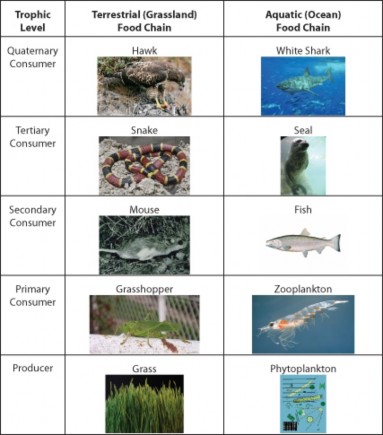
Figure 15.10: In the terrestrial food chain on the left, grasses are the producers. Grasses, in turn, are consumed by grasshoppers. Because grasshoppers directly consume producers, they are called primary consumers. At the next level of the food chain, grasshoppers are consumed by mice, which are called secondary consumers. Mice are consumed by snakes (called tertiary consumers), and snakes are consumed by hawks (called quaternary consumers). In the aquatic food chain on the right, phytoplankton is the producer. Phytoplankton is eaten by zooplankton, which is the primary consumer. Zooplankton, in turn, is eaten by fish (secondary consumers). Fish are eaten by seals (tertiary consumers), and seals are eaten by white sharks (quaternary consumers). (11)
729 www.ck12.org

Figure 15.11: This aquatic food web consists of several intersecting food chains. Which organisms are producers in all the food chains included in the food web? (2)
www.ck12.org 730
Rat → Kittiwake → Sand lance → Zooplankton → Phytoplankton. Can you identify other food chains in this food web?
Trophic Levels and Energy Transfer
The different feeding positions in a food chain or web are called trophic levels. The first trophic level consists of producers, the second of primary consumers, the third of secondary consumers, and so on. There usually are no more than four or five trophic levels in a food chain or web. Humans may fall into second, third, and fourth trophic levels of food chains or webs. They eat producers such as grain, primary consumers such as cows, and tertiary consumers such as salmon.
Energy is passed up the food chain from one trophic level to the next. However, only about 10 percent of the total energy stored in organisms at one trophic level is actually transferred to organisms at the next trophic level. The rest of the energy is used for metabolic processes or lost to the environment as heat. As a result, less energy is available to organisms at each successive trophic level. This explains why there are rarely more than four or five trophic levels. The amount of energy at different trophic levels can be represented by an energy pyramid like the one in Figure 15.12.
Pyramid of Energy

Figure 15.12: This pyramid shows the total energy stored in organisms at each trophic level in an ecosystem. Starting with primary consumers, each trophic level in the food chain has only 10 percent of the energy of the level below it. The pyramid makes it clear why there can be only a limited number of trophic levels in a food chain or web. (5)
Because there is less energy at higher trophic levels, there are usually fewer organisms as well. Organisms tend to be larger in size at higher trophic levels, but their smaller numbers still result in less biomass. Biomass is the total mass of organisms in a trophic level (or other grouping of organisms). The biomass pyramid in Figure 15.13 shows how biomass of organisms changes from first to higher trophic levels in a food chain.
Pyramid of Biomass
731 www.ck12.org

Figure 15.13: This pyramid shows the total biomass, or mass of organisms, at each trophic level in an ecosystem. How does this pyramid relate to the energy pyramid in Figure 15.12? (6)
The materials in dead organisms and wastes at all trophic levels are broken down by de- composers. Organisms such as detritivores and saprotrophs return needed elements to the ecosystem and use up most remaining energy. Because of the reduction in energy at each trophic level, virtually no energy remains. Therefore, energy must be continuously added to ecosystems by producers.
Lesson Summary
Producers in ecosystems are autotrophs. They use energy from sunlight or chemi- cal compounds to synthesize organic molecules from carbon dioxide and other simple inorganic molecules.
Consumers in ecosystems are heterotrophs, or organisms that consume other organisms for food. Consumers include herbivores such as deer, carnivores such as lions, and omnivores such as humans.
Decomposers break down dead organisms and other organic wastes in ecosystems. They resupply producers with the elements they need to synthesize organic compounds.
Food chains and food webs model feeding relationships in ecosystems. They show how energy and materials are transferred between trophic level when consumers eat producers or other organisms.
Review Questions
How do autotrophs use energy to produce organic molecules?
Define three different types of consumers, and name an example of each.
How do decomposers resupply elements to producers? www.ck12.org 732
How is energy transferred between trophic levels in a food chain?
In Figure 6, identify two food chains containing gulls: one in which gulls are tertiary consumers, and one in which gulls are quaternary consumers.
If one million kilocalories of energy are stored in producers in an ecosystem, how many kilocalories can be transferred to tertiary consumers in the ecosystem? Show the calculations that support your answer.
Draw a terrestrial food chain that includes four trophic levels.
All organisms consist of carbon compounds. Infer how the amount of carbon stored in organisms changes from one trophic level to the next. Explain your answer.
Further Reading / Supplemental Links
Beebe, Alan and Brennan, Anne-Maria, First Ecology (3rd revised edition). Oxford University Press, 2007.
Biello, David, Humans Gobble One Quarter of Food Chain’s Foundation. Scientific American, July, 2007.
Parramon Studios (editor), Essential Atlas of Ecology. Barron’s Educational Series, 2005.
http://estrellamountain.edu/faculty/farabee/biobk/BioBookcycles.html
http://www.pmel.noaa.gov/vents/nemo/explorer/concepts/chemosynthesis.html
http://www.sciam.com/article.cfm?articleID=88D6F188-E7F2-99DF-33EF7C83A99DCD04
http://science-class.net/Ecology/energy_transfer.htm
http://users.rcn.com/jkimball.ma.ultranet/BiologyPages/F/FoodChains.html
http://www.arcytech.org/java/population/facts_foodchain.html
http://en.wikipedia.org
Vocabulary
Archaea A prokaryotic domain of microorganisms that resemble bacteria; most archaea live in extreme environments, such as around hydrothermal vents in the deep ocean and are chemoautotrophs.
autotrophs Organisms that produce organic compounds from energy and simple inorganic molecules; also known as producers.
carnivores Organisms that eat a diet consisting mainly of herbivores or other carnivores.
chemoautotrophs Organisms that use the energy stored in chemical compounds to make organic molecules by chemosynthesis.
chemosynthesis The process by which carbon dioxide and water are converted to carbo- hydrates; uses energy from the oxidation of inorganic compounds.
733 www.ck12.org
consumers Organisms that depend on producers or other types of organisms for food. decomposers Organisms that consume dead organisms and other organic waste. detritivores Organisms that consume the remains of dead plants (detritus).
detritus Dead leaves and other plant remains that accumulate on the ground or at the bottom of a body of water.
food chain A simple linear pathway through which energy and materials are transferred from one species to another in an ecosystem.
food web A diagram of feeding relationships that includes multiple intersecting food chains.
herbivores Organisms that consume only producers such as plants or algae; form a nec- essary link between producers and other consumers.
heterotrophs Organisms that depend on producers or other types of organisms for food; also called consumers.
omnivores Organisms that eat both plants and animals as primary food sources.
oxidation An energy-releasing chemical reaction in which a molecule, atom, or ion loses electrons.
photoautotrophs Organisms that use energy from sunlight to make food by photosyn- thesis; includes plants, algae, and certain bacteria.
photosynthesis The process by which carbon dioxide and water are converted to glucose and oxygen, using sunlight for energy.
phytoplankton All the tiny photoautotrophs found on or near the surface of a body of wa- ter; usually is the primary producer in aquatic ecosystems; includes both cyanobacteria and algae.
plankton Large communities of producers and herbivores; made up of phytoplankton and zooplankton.
www.ck12.org 734
producers Organisms that produce organic compounds from energy and simple inorganic molecules.
saprotrophs Organisms that complete the breakdown of any remaining organic matter, such as bones, feathers, and fur of dead animals, and wood and other indigestible plant material.
scavengers Carnivores that mainly eat the carcasses of dead animals.
trophic levels The different feeding positions in a food chain or web.
zooplankton All the small organisms that feed on phytoplankton; includes both single- celled organisms such as protozoa and multicellular organisms such as jellyfish.
Points to Consider
Matter recycles through the biotic components of ecosystems as producers synthesize organic compounds and other organisms consume the compounds.
Do you think abiotic components of ecosystems also play roles in recycling matter?
What abiotic components do you think might be involved? For example, what abiotic components do you think might be involved in the cycling of water?
Lesson 15.3: Recycling Matter
Lesson Objectives
Define and give examples of biogeochemical cycles that recycle matter.
Describe the water cycle and the processes by which water changes state.
Summarize the organic and geological pathways of the carbon cycle.
Outline the nitrogen cycle and state the roles of bacteria in the cycle.
Introduction
Unlike energy, elements are not lost and replaced as they pass through ecosystems. Instead, they are recycled repeatedly. All chemical elements that are needed by living things are re- cycled in ecosystems, including carbon, nitrogen, hydrogen, oxygen, phosphorus, and sulfur. Water is also recycled.
735 www.ck12.org
Biogeochemical Cycles
A biogeochemical cycle is a closed loop through which a chemical element or water moves through ecosystems. In the term biogeochemical, bio- refers to biotic components and geo- to geological and other abiotic components. Chemicals cycle through both biotic and abiotic components of ecosystems. For example, an element might move from the atmosphere to ocean water, from ocean water to ocean organisms, and then back to the atmosphere to repeat the cycle.
Elements or water may be held for various lengths of time by different components of a biogeochemical cycle. Components that hold elements or water for a relatively short period of time are called exchange pools. For example, the atmosphere is an exchange pool for water. It holds water for several days at the longest. This is a very short time compared with the thousands of years the deep ocean can hold water. The ocean is an example of a reservoir for water. Reservoirs are components of a geochemical cycle that hold elements or water for a relatively long period of time.
Water Cycle
Earth’s water is constantly in motion. Although the water on Earth is billions of years old, individual water molecules are always moving through the water cycle. The water cycle describes the continuous movement of water molecules on, above, and below Earth’s surface. It is shown in Figure 15.14. Like other biogeochemical cycles, there is no beginning or end to the water cycle. It just keeps repeating. During the cycle, water occurs in its three different states: gas (water vapor), liquid (water), and solid (ice). Processes involved in changes of state in the water cycle include evaporation, sublimation, and transpiration.
Evaporation, Sublimation, and Transpiration
The sun is the driving force behind the water cycle. It heats oceans, lakes, and other bodies of water, causing water to evaporate from the surface and enter the atmosphere as water vapor. Water in soil also evaporates easily. In addition, the sun heats ice and snow, causing it to turn directly into water vapor in the process of sublimation. Water also evaporates from the above-ground parts of plants. Transpiration is another process by which plants lose water. Transpiration occurs when stomata in leaves open to take in carbon dioxide for photosynthesis and lose water to the atmosphere in the process.
The water cycle plays an important role in climate. For molecules of liquid water to change to water vapor, kinetic energy is required, or the energy of movement. As faster-moving molecules evaporate, the remaining molecules have lower average kinetic energy, and the tem- perature of ocean water thus decreases. The primary way that oceans slow global warming is by heat uptake which warms ocean water and removes some energy from the atmosphere.
www.ck12.org 736
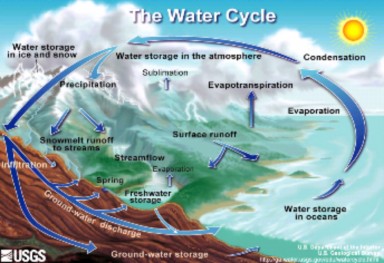
Figure 15.14: This diagram of the water cycle shows where water is stored and the pro- cesses by which water moves through the cycle, including evaporation, condensation, and precipitation. (7)
Condensation and Precipitation
Rising air currents carry water vapor from all these sources into the atmosphere. As the water vapor rises higher into the atmosphere or is carried toward the poles by winds, the air becomes cooler. Cooler air cannot hold as much water vapor, so the water vapor condenses into tiny water droplets around particles in the air. The tiny water droplets form clouds.
Air currents cause the tiny water droplets in clouds to collide and merge into larger droplets. When water droplets in clouds become large enough to fall, they become precipitation. Most precipitation falls back into the ocean. Precipitation that falls at high altitudes or near the poles can accumulate as ice caps and glaciers. These masses of ice can store frozen water for hundreds of years or longer.
Infiltration and Runoff
Rain that falls on land may either soak into the ground, which is called infiltration, or flow over the land as runoff. Snow that falls on land eventually melts, with the exception of snow that accumulates at high altitudes or near the poles. Like rain water, snowmelt can either infiltrate the ground or run off.
Water that infiltrates the ground is called groundwater. Groundwater close to the surface can be taken up by plants. Alternatively, it may flow out of the ground as a spring or slowly seep from the ground into bodies of water such as ponds, lakes, or the ocean. Groundwater can also flow deeper underground. It may eventually reach an aquifer. An aquifer is an
737 www.ck12.org
underground layer of water-bearing, permeable rock. Groundwater may be stored in an aquifer for thousands of years. Wells drilled into an aquifer can tap this underground water and pump it to the surface for human use.
Runoff water from rain or snowmelt eventually flows into streams and rivers. The water is then carried to ponds, lakes, or the ocean. From these bodies of water, water molecules can evaporate to form water vapor and continue the cycle.
Carbon Cycle
Runoff, streams, and rivers can gradually dissolve carbon in rocks and carry it to the ocean. The ocean is a major reservoir for stored carbon. It is just one of four major reservoirs. The other three are the atmosphere, the biosphere, and organic sediments such as fossil fuels. Fossil fuels, including petroleum and coal, form from the remains of dead organisms. All of these reservoirs of carbon are interconnected by pathways of exchange in the carbon cycle, which is shown in Figure 15.15.
Carbon occurs in a various forms in different parts of the carbon cycle. Some of the different forms in which carbon appears are described in Table 15.1. Refer to the table as you read how carbon moves between reservoirs of the cycle.
Table 15.1: Forms of Carbon in the Carbon Cycle: Carbon Dioxide, Gas, Calcium Carbonate, Solids
Form of Carbon | Chemical Formula | State | Main Reservoir |
Carbon Dioxide | CO2 | Gas | Atmosphere |
Carbonic Acid H2CO3 Liquid Ocean
Bicarbonate Ion HCO3− Liquid(dissolvedion) Ocean
Organic Compounds Examples: Glucose,
C6H12O6 Methane, CH4
Solid Gas Biosphere Organic Sediments (Fossil Fuels)
Other Carbon Com- pounds
Examples: Calcium Carbonate, CaCO3 Calcium Magne-
sium Carbonate, CaMg(CO3)2
Solid Solid Sedimentary Rock, Shells Sedimentary Rock

KEY: C = Carbon, O = Oxygen, H = Hydrogen www.ck12.org 738
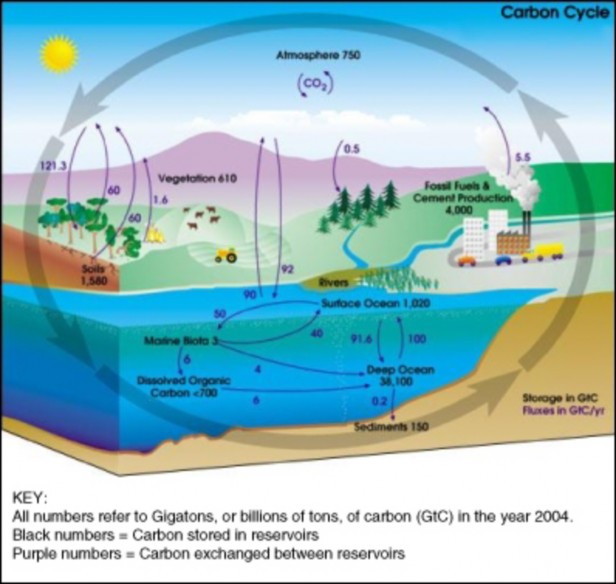
Figure 15.15: This drawing of the carbon cycle shows the amounts of carbon stored in and exchanged between carbon reservoirs on land and in water. Another 70 million GtC of carbon may be stored in sedimentary rock. If this is true, it would make sedimentary rock the greatest reservoir of carbon on Earth. (8)
739 www.ck12.org
Carbon in the Atmosphere
In the atmosphere, carbon exists primarily as carbon dioxide (CO2). Carbon dioxide enters the atmosphere from several different sources, including those listed below. Most of the sources are also represented in Figure 2, and some are described in detail later in the lesson.
Living organisms release carbon dioxide as a byproduct of cellular respiration.
Carbon dioxide is given off when dead organisms and other organic materials decom- pose.
Burning organic material, such as fossil fuels, releases carbon dioxide.
When volcanoes erupt, they give off carbon dioxide that is stored in the mantle.
Carbon dioxide is released when limestone is heated during the production of cement.
Ocean water releases dissolved carbon dioxide into the atmosphere when water tem- perature rises.
A much smaller amount of carbon in the atmosphere is present as methane gas (CH4). Methane is released into the atmosphere when dead organisms and other organic matter decay in the absence of oxygen. It is produced by landfills, the mining of fossil fuels, and some types of agriculture.
There are also several different ways that carbon leaves the atmosphere. Carbon dioxide is removed from the atmosphere when plants and other autotrophs take in carbon dioxide to make organic compounds during photosynthesis or chemosynthesis. Carbon dioxide is also removed when ocean water cools and dissolves more carbon dioxide from the air. These processes are also represented in Figure 15.15.
Because of human activities, there is more carbon dioxide in the atmosphere today than in the past hundreds of thousands of years. Burning fossil fuels and producing concrete has released great quantities of carbon dioxide into the atmosphere. Cutting forests and clearing land has also increased carbon dioxide into the atmosphere because these activities reduce the number of autotrophic organisms that use up carbon dioxide in photosynthesis. In addition, clearing often involves burning, which releases carbon dioxide that was previously stored in autotrophs.
Carbon in Ocean Water
Most carbon enters the ocean when carbon dioxide in the atmosphere dissolves in ocean water. When carbon dioxide dissolves in water (H2O), it forms an acid called carbonic acid (H2CO3). The reaction is given by the equation:
CO2 + H2O H2CO3.
www.ck12.org 740
The double-headed arrow indicates that the reaction can occur in either direction, depending on the conditions and the amount of carbon dioxide present. For example, the reaction occurs more readily in the left-to-right direction in cold water. As a result, near the poles, where ocean water is cooler, more carbon dioxide is dissolved and there is more carbonic acid in the water. Although carbonic acid is a weak acid, it is an important regulator of the acid-base (pH) balance of ocean water.
Carbonic acid, in turn, readily separates into hydrogen ions (H+) and bicarbonate ions (HCO3−). This occurs in the following reaction:
H2CO3 H+ + HCO3−.
Due to these two reactions, most dissolved carbon dioxide in the ocean is in the form of bicarbonate ions. Another source of bicarbonate ions in ocean water is runoff. Flowing water erodes rocks containing carbon compounds such as calcium carbonate. This forms bicarbonate ions, which the runoff carries to streams, rivers, and eventually the ocean. Many of the bicarbonate ions in ocean water are moved by ocean currents into the deep ocean. Carbon can be held in this deep ocean reservoir as bicarbonate ions for thousands of years or more.
Carbon in the Biosphere
Bicarbonate ions near the surface of the ocean may be taken up by photosynthetic algae and bacteria that live near the surface. These and other autotrophic organisms use bicarbonate ions or other forms of carbon to synthesize organic compounds. Carbon is essential for life because it is the main ingredient of every type of organic compound. Organic compounds make up the cells and tissues of all organisms and keep organisms alive and functioning. Carbon enters all ecosystems, both terrestrial and aquatic, through autotrophs such as plants or algae. Autotrophs use carbon dioxide from the air, or bicarbonate ions from the water, to make organic compounds such as glucose. Heterotrophs consume the organic molecules and pass the carbon through food chains and webs.
How does carbon cycle back to the atmosphere or ocean? All organisms release carbon dioxide as a byproduct of cellular respiration. Recall from the Cellular Respiration chapter that cellular respiration is the process by which cells oxidize glucose and produce carbon dioxide, water, and energy. Decomposers also release carbon dioxide when they break down dead organisms and other organic waste.
In a balanced ecosystem, the amount of carbon used in photosynthesis and passed through the ecosystem is about the same as the amount given off in respiration and decomposition. This cycling of carbon between the atmosphere and organisms forms an organic pathway in the carbon cycle. Carbon can cycle quickly through this organic pathway, especially in aquatic ecosystems. In fact, during a given period of time, much more carbon is recycled through the organic pathway than through the geological pathway you will read about next.
741 www.ck12.org
Carbon in Rocks and Sediments
The geological pathway of the carbon cycle takes much longer than the organic pathway described above. In fact, it usually takes millions of years for carbon to cycle through the geological pathway. It involves processes such as rock formation, subduction, and volcanism.
As stated previously, most carbon in ocean water is in the form of bicarbonate ions. Bicar- bonate ions may bind with other ions, such as calcium ions (Ca+) or magnesium ions (Mg+), and form insoluble compounds. Because the compounds are insoluble, they precipitate out of water and gradually form sedimentary rock, such as limestone (calcium carbonate, CaCO3) or dolomite [calcium magnesium carbonate CaMg(CO3)2.
Dead organisms also settle to the bottom of the ocean. Many of them have shells con- taining calcium carbonate. Over millions of years, the pressure of additional layers of sed- iments gradually changes their calcium carbonate and other remaining organic compounds to carbon-containing sedimentary rock.
During some periods in Earth’s history, very rich organic sediments were deposited. These deposits formed pockets of hydrocarbons. Hydrocarbons are organic compounds that contain only carbon and hydrogen. The hydrocarbons found in sediments are fossil fuels such as natural gas. The hydrocarbon methane is the chief component of natural gas.
Carbon-containing rocks and sediments on the ocean floor gradually move toward the edges of the ocean due to a process called seafloor spreading. The rocks eventually reach cracks in the crust, where they are pulled down into the mantle. This process, called subduction, occurs at subduction zones. In the mantle, the rocks melt and their carbon is stored. When volcanoes erupt, they return some of the stored carbon in the mantle to the atmosphere in the form of carbon dioxide, a process known as volcanism. This brings the geological pathway of the carbon cycle full circle.
Nitrogen Cycle
The atmosphere is the largest reservoir of nitrogen on Earth. It consists of 78 percent nitro- gen gas (N2). The nitrogen cycle moves nitrogen through abiotic and biotic components of ecosystems. Figure 15.16 shows how nitrogen cycles through a terrestrial ecosystem. Nitro- gen passes from the atmosphere into soil. Then it moves through several different organisms before returning to the atmosphere to complete the cycle. In aquatic ecosystems, nitrogen passes through a similar cycle.
Absorption of Nitrogen
Plants and other producers use nitrogen to synthesize nitrogen-containing organic com- pounds. These include chlorophyll, proteins, and nucleic acids. Other organisms that
www.ck12.org 742

Figure 15.16: In a terrestrial ecosystem, the nitrogen cycle may include plants and consumers as well as several types of bacteria. (4)
consume producers make use of the nitrogen in these organic compounds. Plants absorb substances such as nitrogen from the soil through their root hairs. However, they cannot ab- sorb nitrogen gas directly. They can absorb nitrogen only in the form of nitrogen-containing ions, such as nitrate ions (NO3−).
Nitrogen Fixation
The process of converting nitrogen gas to nitrate ions that plants can absorb is called nitro- gen fixation. It is carried out mainly by nitrogen-fixing bacteria, which secrete enzymes needed for the process. Some nitrogen-fixing bacteria live in soil. Others live in the root nodules of legumes such as peas and beans. In aquatic ecosystems, some cyanobacteria are nitrogen fixing. They convert nitrogen gas to nitrate ions that algae and other aquatic producers can use.
Nitrogen gas in the atmosphere can be converted to nitrates by several other means. One way is by the energy in lightning. Nitrogen is also converted to nitrates as a result of certain human activities. These include the production of fertilizers and explosives and the burning of fossil fuels. These human activities also create the gas nitrous oxide (N2O). The concentration of this gas in the atmosphere has tripled over the past hundred years as a result. Nitrous oxide is a greenhouse gas that contributes to global warming and other environmental problems.
743 www.ck12.org
Ammonification and Nitrification
After being used by plants and animals, nitrogen is released back into the environment. When decomposers break down organic remains and wastes, they release nitrogen in the form of ammonium ions (NH4−). This is called ammonification. It occurs in both terrestrial and aquatic ecosystems. In terrestrial ecosystems, some nitrogen-fixing bacteria in soil and root nodules also convert nitrogen gas directly into ammonium ions.
Although some plants can absorb nitrogen in the form of ammonium ions, others cannot. In fact, ammonium ions may be toxic to some plants and other organisms. Certain soil bacte- ria, called nitrifying bacteria, convert ammonium ions to nitrites (NO2−). Other nitrifying bacteria convert the nitrites to nitrates, which plants can absorb. The process of converting ammonium ions to nitrites or nitrates is called nitrification.
Denitrification and the Anammox Reaction
Still other bacteria, called denitrifying bacteria, convert some of the nitrates in soil back into nitrogen gas in a process called denitrification. The process is the opposite of nitrogen fixation. Denitrification returns nitrogen gas back to the atmosphere, where it can continue the nitrogen cycle.
In the ocean, another reaction occurs to cycle nitrogen back to nitrogen gas in the atmo- sphere. The reaction, called the anammox reaction, is enabled by certain bacteria in the water. In the reaction, ammonium and nitrite ions combine to form water and nitrogen gas. This is shown by the equation:
NH4+ + NO2- → N2 + 2H2O.
The anammox reaction may contribute up to half of the nitrogen gas released into the atmosphere by the ocean. The reaction may also significantly limit production in ocean ecosystems by removing nitrogen compounds that are needed by aquatic producers and other organisms.
Lesson Summary
Biogeochemical cycles are closed loops through which chemical elements or water move through ecosystems. Examples of biogeochemical cycles include the water cycle, carbon cycle, and nitrogen cycle.
The water cycle recycles water through ecosystems. Processes by which water changes state in the water cycle include evaporation, sublimation, transpiration, and conden- sation.
The organic pathway of the carbon cycle moves carbon from the atmosphere, through producers and other organisms in ecosystems, and back to the atmosphere. The geo-
www.ck12.org 744
logical pathway moves carbon from the atmosphere, through the ocean to rocks and the mantle, and back to the atmosphere.
The nitrogen cycle moves nitrogen gas from the atmosphere into soil or water, where nitrogen-fixing bacteria convert it to a form that producers can use. Nitrifying bacteria help nitrogen cycle through ecosystems. Denitrifying bacteria return nitrogen gas back to the atmosphere. The anammox reaction returns nitrogen back to the atmosphere from ocean water.
Review Questions
What is a biogeochemical cycle? Name one example.
Identify and define two processes by which water changes state in the water cycle.
State three ways that carbon dioxide enters Earth’s atmosphere.
How do bacteria convert nitrogen gas to a form that producers can use?
Describe all the ways that a single tree might be involved in the carbon cycle.
Explain why growing a crop of legumes can improve the ability of the soil to support the growth of other plants.
Compare and contrast organic and geological pathways in the carbon cycle.
Identify an exchange pool and a reservoir in the water cycle. Explain your choices.
Further Reading / Supplemental Links
Appenzeller, Tim, The Case of the Missing Carbon. National Geographic Magazine, Feb., 2004.
Miller, G. Tyler, Essentials of Ecology (4th edition). Brooks Cole, 2006.
http://earthobservatory.nasa.gov/Library/CarbonCycle/
http://estrellamountain.edu/faculty/farabee/biobk/BioBookcycles.html
http://estrellamountain.edu/faculty/farabee/biobk/BioBookcommecosys.html
http://estrellamountain.edu/faculty/farabee/biobk/BioBookpopecol.html http:
//estrellamountain.edu/faculty/farabee/biobk/BioBookpopecol.html]
http://earthobservatory.nasa.gov/Library/CarbonCycle/
http://ide.ucsd.edu/earthguide/diagrams/watercycle/
http://observe.arc.nasa.gov/nasa/earth/hydrocycle/hydro1.html
http://www.enviroliteracy.org/article.php/479.html
http://en.wikipedia.org
Vocabulary
ammonification The release of nitrogen in the form of ammonium ions (NH4−) due to the break down of organic remains and wastes by decomposers.
745 www.ck12.org
anammox reaction Reaction in which ammonium and nitrite ions combine to form water and nitrogen gas; enabled by certain bacteria in the water.
aquifer An underground layer of water-bearing, permeable rock.
biogeochemical cycle A closed loop through which a chemical element or water moves through ecosystems.
carbon cycle Pathways of exchange that interconnect the four major reservoirs of carbon: the ocean, the atmosphere, the biosphere and organic sediments, such as fossil fuels.
cellular respiration The process by which cells oxidize glucose and produce carbon diox- ide, water, and energy.
denitrification The conversion of some of the nitrates in soil back into nitrogen gas; done by denitrifying bacteria; returns nitrogen gas back to the atmosphere, where it can continue the nitrogen cycle.
groundwater Water that infiltrates the ground.
infiltration Rain that falls on land and soaks into the ground.
nitrification The process of converting ammonium ions to nitrites or nitrates.
nitrogen cycle The cycle that moves nitrogen through abiotic and biotic components of ecosystems.
nitrogen fixation The process of converting nitrogen gas to nitrate ions that plants can absorb; carried out mainly by nitrogen-fixing bacteria.
precipitation Forms when water droplets in clouds become large enough to fall.
runoff Rain that falls on land and flows over the land.
subduction A process where carbon containing rocks and sediments on the ocean floor are pulled down into the mantle; due to seafloor spreading.
sublimation The transformation of snow and ice directly into water vapor; occurs as the snow and ice are heated by the sun.
www.ck12.org 746
transpiration A process by which plants lose water; occurs when stomata in leaves open to take in carbon dioxide for photosynthesis and lose water to the atmosphere in the process.
volcanism The process of returning some of the stored carbon in the mantle to the atmo- sphere in the form of carbon dioxide; occurs when volcanoes erupt.
water cycle Describes the continuous movement of water molecules on, above, and below Earth’s surface.
Points to Consider
Matter is recycled through abiotic and biotic components of all ecosystems. However, ecosys- tems vary in the amount of matter they recycle. For example, forests recycle more matter than deserts.
What factors do you think might cause ecosystems to differ in this way?
What abiotic components of the environment do you think might be important?
What about the amount of sunlight or precipitation that ecosystems receive?
What roles do you think these abiotic components play in cycles of matter?
Image Sources
http://en.wikipedia.org/wiki/Image:BirdBeaksA.svg. Creative Commons.
http://www.absc.usgs.gov/research/seabird_foragefish/marinehabitat/ images/Food_Web3.gif. Public Domain.
http://en.wikipedia.org/wiki/Image:TallWildGrass.jpg http://en.wikipedia.org/wiki/Image:Diatoms_through_the_microscope.jpg http://en.wikipedia.org/wiki/Image:Codiumfragile.jpg http://en.wikibooks.org/wiki/File:Anabaena_sperica1.jpg www.chm.bris.ac.uk/motm/oec/images/PhotoGrps.jpg . Public Domain, GNU-FDL, CC-BY-SA.
http://en.wikipedia.org/wiki/Image:Nitrogen_Cycle.jpg. Public Domain.
(5) .
(6) .
747 www.ck12.org
http://upload.wikimedia.org/wikipedia/commons/9/94/Water_cycle.png. Creative Commons.
http://upload.wikimedia.org/wikipedia/en/5/5b/Carbon_cycle_diagram.jpg. Creative Commons.
http://en.wikipedia.org/wiki/Image:Nur04512.jpg. Creative Commons.
http://en.wikipedia.org/wiki/Image:Dungbeetle.jpg. Creative Commons.
http://commons.wikimedia.org/wiki/Image:White_shark.jpg http://en.wikipedia.org/wiki/Image:Micrurus_tener.jpg http://en.wikipedia.org/wiki/Image:Europ%C3%A4ischer_Seehund.jpg http://en.wikipedia.org/wiki/Image:ONYCHOMYS_LEUCOGASTER.jpg http://en.wikipedia.org/wiki/Image:Oncorhynchus_keta.jpeg http://en.wikipedia.org/wiki/Image:Grasshopper_front-side_view.JPG http://en.wikipedia.org/wiki/Image:Meganyctiphanes_norvegica2.jpg. Creative Commons.
http://en.wikipedia.org/wiki/Image:Baja_California_Desert.jpg. Creative Commons.
http://en.wikipedia.org/wiki/Image:Humming_flowers.jpg http:
//en.wikipedia.org/wiki/Image:Bees_Collecting_Pollen_2004-08-14.jpg http://upload.wikimedia.org/wikipedia/commons/thumb/5/58/Mariana_ Fruit_Bat.jpg/372px-Mariana_Fruit_Bat.jpg http://commons.wikimedia.org/wiki/Image:Sitta_europaea_wildlife_3.jpg http://en.wikipedia.org/wiki/Image:MyxoRabbit.JPG http://en.wikipedia.org/wiki/Image:Jblarva.jpg. Creative Commons.
http://earthobservatory.nasa.gov/Library/CarbonCycle/Images/seawifs_ global_biosphere.jpg. Creative Commons.
http://en.wikipedia.org/wiki/Image: Kudzu_on_trees_in_Atlanta%2C_Georgia.jpg. Creative Commons.
http://en.wikipedia.org/wiki/Image:Dusky_Seaside_Sparrow.jpg. Creative Commons.
www.ck12.org 748
Biomes, Ecosystems, and Communities
Lesson 16.1: Biomes
Lesson Objectives
Define biome and climate, and explain how biomes are related to climate.
Outline how climate determines growing conditions for plants and affects the number and biodiversity of plants in a biome.
Explain how climate is related to biodiversity of biomes and adaptations of organisms.
Introduction
If you look at the two pictures in Figure 1 below, you will see very few similarities. The picture on the left shows a desert in Africa. The picture on the right shows a rainforest in Australia. What is the most obvious difference between the two places? It could be that the desert does not have any visible plants, whereas the rainforest is densely packed with trees. What causes these two places to be so different? The main reason is climate.
Biomes and Climate
The two pictures above represent two different types of biomes: deserts and rainforests. A biome is a group of similar ecosystems that cover a broad area. Biomes are major subdivisions of the biosphere. They can be classified into two major types:
Terrestrial biomes: biomes on land
Aquatic biomes: biomes in water
749 www.ck12.org

Figure 16.1: Sahara Desert in northern Africa (left). Rainforest in northeastern Australia (right). (8)
You will read about terrestrial biomes in Lesson 16.2 and aquatic biomes in Lesson 16.3. First, however, it is important to understand how climate influences biomes. Climate is the most important abiotic (non-living) factor affecting the distribution of terrestrial biomes of different types. Climate determines the growing conditions in an area, so it also determines what plants can grow there. Animals depend directly or indirectly on plants, so the type of animals that live in an area also depends on climate.
What Is Climate?
Climate is the average weather in an area over a long period of time, whereas weather is a day to day explanation. Weather and climate are described in terms of factors such as temperature and precipitation. The climate of a particular location depends, in turn, on its latitude (distance from the equator) and altitude (distance above sea level). Other factors that affect an area’s climate include its location relative to the ocean or mountain ranges. Temperature and moisture are the two climatic factors that most affect terrestrial biomes.
Temperature
In general, temperature on Earth’s surface falls from the equator to the poles. Based on temperature, climates can be classified as tropical, temperate, or arctic, as shown in Figure
Temperature also falls from lower to higher altitudes, for example, from the base of a
mountain to its peak. This explains why the tops of high mountains in tropical climates may be snow-capped year-round.
The ocean may also play an important role in the temperature of an area. Coastal areas may have milder climates than areas farther inland at the same latitude. This is because the temperature of the ocean changes relatively little from season to season, and this affects the temperature on nearby coasts. As a result, many coastal areas have both warmer winters and cooler summers than inland areas.
www.ck12.org 750
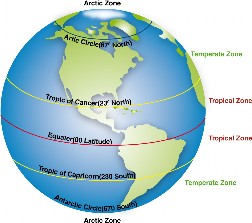
Figure 16.2: Major climate zones based on temperature include tropical, temperate, and arctic zones. The tropical zone extends from the Tropic of Capricorn to the Tropic of Cancer. The two temperate zones extend from the tropical zone to the arctic or antarctic circle. The two arctic zones extend from the arctic or antarctic circle to the north or south pole. (22)
751 www.ck12.org
Moisture
Based on the amount of water available to plants, climates can be classified as arid (dry), semi-arid, semi-humid, or humid (wet). The moisture of a biome is determined by both precipitation and evaporation. Evaporation, in turn, depends on heat from the sun. World- wide precipitation patterns result from global movements of air masses and winds, which are shown in Figure 3. For example, warm, humid air masses rise over the equator and are moved north and south by global air currents. The air masses cool and cannot hold as much water. As a result, they drop their moisture as precipitation. This explains why many tropical areas receive more precipitation than other areas of the world.

Figure 16.3: This model of Earth shows the direction in which air masses typically move and winds usually blow at different latitudes. These movements explain why some latitudes receive more precipitation than others. (9)
When the same air masses descend at about 30° north or south latitude (see Figure 3), they are much drier. This explains why dry climates are found at these latitudes. These latitudes are also warm and sunny, which increases evaporation and dryness. Dry climates are found near the poles, as well. Extremely cold air can hold very little moisture, so precipitation is low in arctic zones. However, these climates also have little evaporation because of the extreme cold. As a result, cold climates with low precipitation may not be as dry as warm climates with the same amount of precipitation.
Distance from the ocean and mountain ranges also influences precipitation. For example, www.ck12.org 752
one side of a mountain range near the ocean may receive a lot of precipitation because warm, moist air masses regularly move in from the water. As air masses begin to rise up over the mountain range, they cool and drop their moisture as precipitation. This is illustrated in Figure 4.
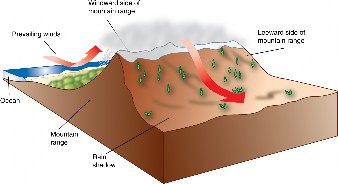
Figure 16.4: The windward side of this mountain range has a humid climate, whereas the leeward side has an arid climate. On the windward side, warm moist air comes in from the ocean, rises and cools, and drops its moisture as rain or snow. On the leeward side, the cool dry air falls, warms, and picks up moisture from the land. How has this affected plant growth on the two sides of the mountain range? (6)
By the time the air masses reach the other side of the mountain range, they no longer contain moisture. As a result, land on this side of the mountain range receives little precipitation. This land is in the rain shadow of the mountain range. Many inland areas far away from the ocean or mountain ranges are also dry. Air masses that have passed over a wide expanse of land to reach the interior of a continent usually no longer carry much moisture.
Climate and Plant Growth
Plants are the major producers in terrestrial biomes. Almost all other terrestrial organisms depend on them either directly or indirectly for food. Plants need air, warmth, sunlight, water, and nutrients to grow. Climate is the major factor affecting the number and diversity of plants that can grow in a terrestrial biome. Climate determines the average temperature and precipitation, the length of the growing season, and the quality of the soil, including levels of soil nutrients.
753 www.ck12.org
Growing Season
The growing season is the period of time each year when it is warm enough for plants to grow. The timing and length of the growing season determine what types of plants can grow in an area. For example, near the poles the growing season is very short. The temperature may rise above freezing for only a couple of months each year. Because of the cold temperatures and short growing season, trees and other slow-growing plants are unable to survive. The growing season gets longer from the poles to the equator. Near the equator, plants can grow year-round if they have enough moisture. A huge diversity of plants can grow in hot, wet climates.
The timing of precipitation also affects the growing season. In some areas, most of the precipitation falls during a single wet season (such as in California), rather than throughout the year (such as in New England). In these areas, the growing season lasts only as long as there is enough moisture for plants to grow.
Soil
Plants need soil that contains adequate nutrients and organic matter. Nutrients and organic matter are added to soil when plant litter and dead organisms decompose. In cold climates, decomposition occurs very slowly. As a result, soil in cold climates is thin and poor in nutrients. Soil is also thin and poor in hot, wet climates because the heat and humidity cause such rapid decomposition that little organic matter accumulates in the soil. The frequent rains also leach nutrients from the soil. Thin, poor soil is shown in the left drawing of Figure 5. The right drawing shows thick, rich soil. This type of soil is generally found in temperate climates and is best for most plants.
Biome Biodiversity and Adaptations
Because plants are the most important producers in terrestrial biomes, anything that affects their growth also influences the number and variety of other organisms that can be supported in a biome. Therefore, climate has a major impact on the biodiversity of biomes.
Biodiversity
Biodiversity refers to the number of different species of organisms in a biome (or ecosystem or other ecological unit). Biodiversity is usually greater in warmer biomes. Therefore, biodiversity generally decreases from the equator to the poles. Biodiversity is usually greater in wetter biomes, as well. Remember the desert and rainforest pictured in Figure 1? The biodiversity of these two biomes is vastly different. Both biomes have warm climates, but the desert is very dry, and the rainforest is very wet. The desert has very few organisms, so
www.ck12.org 754

Figure 16.5: The soil on the left has a thin layer of topsoil, the part of soil where most plant roots obtain moisture and nutrients. The topsoil is light in color, which means that it is poor in nutrients and organic matter. The soil on the right has a thicker layer of topsoil. Its dark color indicates that the topsoil is rich in nutrients and organic matter. (7)
755 www.ck12.org
it has low biodiversity. Some parts of the desert may have no organisms, and therefore zero biodiversity. In contrast, the rainforest has the highest biodiversity of any biome on Earth.
Adaptations
Plants, animals, and other organisms evolve adaptations to suit them to the abiotic factors in their biome. Abiotic factors to which they adapt include temperature, moisture, growing season, and soil. This is why the same type of biome in different parts of the world has organisms with similar adaptations. For example, biomes with dry climates worldwide have plants with similar adaptations to aridity, such as special tissues for storing water (see Figure 6).
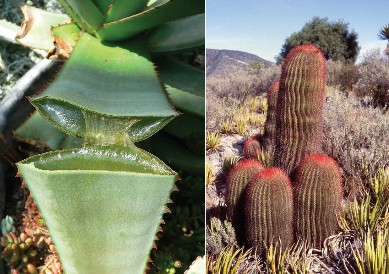
Figure 16.6: (left) The large hollow leaves of an African aloe plant store water and help the plant survive in its arid biome. (right) Cacti like these are found in arid biomes of North America. They store water in their thick, barrel-like stems. (18)
In biomes with a severe cold or dry season, plants may become dormant during that season of the year. In dormant plants, cellular activities temporarily slow down, so the plants need less sunlight and water. For example, many trees shed their leaves and become dormant during very cold or dry seasons. Animals in very cold or dry biomes also must adapt to these abiotic factors. For example, adaptations to cold include fur or fat, which insulates the body and helps retain body heat.
Lesson Summary
A biome is a group of similar ecosystems that cover a broad area. Climate is the average weather in an area over a long period of time. Climate is the most important
www.ck12.org 756
abiotic factor affecting the distribution of terrestrial biomes.
Climate includes temperature and precipitation, and it determines growing season and soil quality. It is the major factor affecting the number and diversity of plants in terrestrial biomes.
By affecting plants, which are the main producers, climate affects the biodiversity of terrestrial biomes. Plants and other organisms also evolve adaptations to climatic factors in their biomes, including adaptations to extreme cold and dryness.
Review Questions
Name three factors that help determine the climate of an ecosystem.
What is a rain shadow?
List some important factors related to climate that plants need in order to grow?
Compare the data for Seattle and Denver in the table below. What factors might explain why Seattle is warmer in the winter than Denver, even though Seattle is farther north?:
Table 16.1:

City Latitude Altitude Location Temperature1

Seattle, Wash- ington
Denver, Col- orado
48°N 429 ft Coastal 33°F
41°N 5,183 ft Interior 15°F

5.
6. 1
Average low temperature in January
Explain how the quality of soil in an area is influenced by climate.
Why is biodiversity higher at the equator than it is near the poles?
Further Reading / Supplemental Links
Harm J.de Blij, Peter O. Muller,and Richard S. Williams, Physical Geography: The Global Environment (3rd edition). Oxford University Press, 2004.
Ross E. Koning,Climate and Biomes, Plant Physiology Information Website.
Susan L. Woodward, Biomes of Earth: Terrestrial, Aquatic, and Human-Dominated. Greenwood Press, 2003.
http://estrellamountain.edu/faculty/farabee/biobk/BioBookcommecosys.html
http://ridge.icu.ac.jp/gen-ed/biomes.html
http://users.rcn.com/jkimball.ma.ultranet/BiologyPages/B/Biomes.html
757 www.ck12.org
Vocabulary
aquatic biome Biome in water.
biodiversity Number of different species of organisms in a biome (or ecosystem or other unit).
biome Group of similar ecosystems that cover a broad area.
climate Average weather in an area over a long period of time.
growing season Period of time each year when it is warm enough for plants to grow.
rain shadow Land on the leeward side of a mountain range that receives very little pre- cipitation.
terrestrial biome Biome on land.
Points to Consider
Plants and the other organisms in terrestrial biomes are greatly influenced by climate.
What is the climate like where you live?
How hot or cold does it get, and how much precipitation usually falls?
Discuss with your class the climate in your area and how it seems to affect plant growth.
What plants and animals are naturally found in your part of the country?
Lesson 16.2: Terrestrial Biomes
Lesson Objectives
State how terrestrial biomes are classified and distributed around the globe.
Outline abiotic and biotic factors in tundra and boreal forest biomes.
Describe climatic factors and organisms of temperate zone biomes.
List abiotic factors in deserts and adaptations of desert organisms.
Identify abiotic factors and organisms in tropical biomes. www.ck12.org 758
Introduction
Terrestrial biomes include all land areas on Earth where organisms live. The major biomes cover large regions and are found on more than one continent. They are generally classified on the basis of climatic factors and the types of plants that are the primary producers.
Classification of Terrestrial Biomes
Scientists have created several different systems for classifying terrestrial biomes. Biomes in most classification systems include tundra, boreal forest, temperate forest, temperate grass- land, chaparral, tropical forest, tropical grassland, and desert. The worldwide distribution of these biomes is shown in Figure 1.
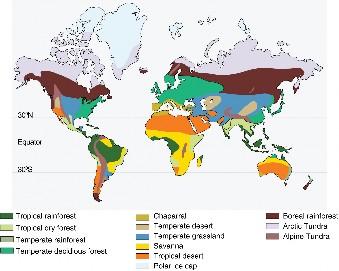
Figure 16.7: Distribution of Earth’s major terrestrial biomes. (12)
The distribution of biomes shown in Figure 1 reflects global patterns of temperature and moisture. It also reflects conditions in earlier times. Many areas have been disturbed by human actions, some more so than others. For example, most tundra biomes have been changed very little by human actions, but many forests have been completely cleared. Some biomes, including tropical rainforests, cannot be replaced once they have been destroyed. Figure 2 summarizes important features of most of the biomes shown in Figure 1. Refer to both figures as you read about these terrestrial biomes throughout this lesson.
759 www.ck12.org
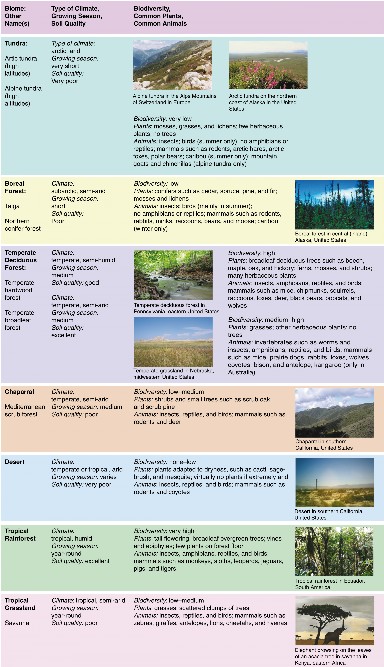
Figure 16.8: These biomes are described more fully in the text. Refer to Figure 1 to see where each biome is found. (23)
www.ck12.org 760
Arctic and Subarctic Biomes
Artic and subarctic biomes are found near the north and south poles or at high altitudes in other climate zones. The biomes include tundra and boreal forests. Both have cold, dry climates and poor soil. They can support only limited plant growth and have low biodiversity.
Tundra
Tundra is an arctic biome where it is too cold for trees to grow. Outside of the polar ice caps, tundra has the coldest temperatures on Earth. There are two types of tundra: arctic tundra, which is also found in Antarctica, and alpine tundra, which is found only at high altitudes.
Arctic tundra occurs north of the arctic circle and south of the antarctic circle. It covers much of Alaska and vast areas of northern Canada and Russia. It is also found along the northern coast of Antarctica.
Alpine tundra occurs in mountains around the world at any latitude, but only above the tree line. The tree line is the edge of the zone at which trees are able to survive. Alpine tundra is found in the Rocky Mountains in the United States and in several other mountain ranges around the world.
Both types of tundra receive very low precipitation, but little of it evaporates because of the cold. Arctic tundra has permafrost, which is soil that is frozen year-round. The top layer of soil thaws in the summer, but deeper layers do not. As a result, water cannot soak into the ground. This leaves the soil soggy and creates many bogs, lakes, and streams. Alpine tundra does not have permafrost, except at very high altitudes. Therefore, alpine tundra soil tends to be dry rather than soggy.
Global warming poses a serious threat to Arctic tundra biomes because it is causing the permafrost to melt. When permafrost melts, it not only changes the tundra. It also releases large amounts of methane and carbon dioxide into the atmosphere. Both are greenhouse gases, which contribute to greater global warming.
The most common vegetation in tundra is mosses and lichens. They can grow in very little soil and become dormant during the winter. Tundra is too cold for amphibians or reptiles, which cannot regulate their own body heat. Insects such as mosquitoes can survive the winter as pupae and are very numerous in summer. In addition, many species of birds and large herds of caribou migrate to arctic tundra each summer. However, few birds and mammals live there year-round. Those that remain have adapted to the extreme cold. Polar bears are an example. They have very thick fur to insulate them from the cold. In alpine tundra, animals must adapt to rugged terrain as well as to cold. Alpine animals include mountain goats, which not only have wool to keep them warm but are also sure-footed and agile.
761 www.ck12.org
Boreal Forests
A boreal forest is a subarctic biome covered with conifers. Conifers are cone-bearing, needle-leaved evergreen trees such as spruces. Boreal forests are found only in the northern hemisphere. They occur just south of the arctic circle in Alaska, Canada, northern Europe, and Russia (where they are called taiga). They also occur in extreme northern regions of Minnesota, New York State, New Hampshire, and Maine.
Boreal forests have harsh continental climates, with very cold winters and relatively warm summers. The growing season is also short. Precipitation is quite low, but there is little evaporation. Most of the precipitation falls in the summer when plants are growing, so there is enough moisture for dense plant growth. A thick carpet of evergreen needles on the forest floor causes the soil to be too acidic for most other plants.
Conifers have adapted to the difficult conditions in several ways. They have shallow roots that suit them for the thin soil. They have needles instead of leaves, which reduce water loss during the long, dry winters. The needles are also very dark green in color, which maximizes absorption of sunlight for photosynthesis. Although boreal forests are dense with conifers, there are only a few different species of trees. Vegetation on the forest floor consists mostly of mosses and lichens. Animals found in boreal forests include insects, birds, and mammals such as rabbits, foxes, and brown bears. Caribou also spend their winters there. Like tundra, the boreal forest is too cold for amphibians or reptiles.
Temperate Biomes
Temperate biomes cover most of the continental United States and Europe. They also cover large parts of Asia. Types of temperate biomes include forests, grasslands, and chaparral.
Temperate Forests
There are two types of temperate forests: temperate deciduous forests and temperate rain- forests. Both types have a temperate climate and good soil. A temperate climate is a moderate climate that is neither extremely hot nor extremely cold. A temperate climate can be either continental or coastal. Continental temperate climates are found inland, and they tend to have cold winters, hot summers, and moderate precipitation. Coastal temperate climates are found near the ocean, and they tend to have mild winters, cool summers, and high precipitation.
Temperate deciduous forests are found in areas with continental temperate cli- mates, such as the eastern United States and Canada and throughout much of Europe. These forests consist mainly of deciduous trees, such as maples and oaks, which lose their leaves in the fall. There are many other species of plants as well. Animals include
www.ck12.org 762
insects, amphibians, reptiles, and birds. Mammals are also common, including rabbits and wolves.
Temperate rainforests are found in areas with coastal temperate climates, such as
the northwestern coast of North America and certain coastal regions of other con- tinents. These forests consist mainly of evergreen trees, such as hemlocks and firs. Mosses, lichens, and ferns grow on the forest floor. There are also many epiphytic plants. Animals include insects, amphibians, reptiles, and birds. There are also many mammals, such as squirrels and deer.
Epiphytes are plants that grow on other plants. They use the other plants for support, not nutrients, and generally do not harm the plants they grow on. They grow high in the branches of trees where there is more sunlight available for photosynthesis.
Temperate Grasslands
Temperate grasslands are temperate biomes that consist mainly of grasses. They are found in the midwestern region of North America and in inland areas of most other conti- nents. The climate is continental, and precipitation is relatively low. However, the majority of the precipitation falls during the growing season when plants need it the most.
Biomes are often referred to by local names. For example, a temperate grassland biome is known as prairie in North America, outback in Australia, pampa in South America, and steppe in central Asia. Can you find each of these temperate grasslands on the map in Figure 1?
The soil of temperate grasslands is the richest, deepest soil on Earth. It is densely covered with thick grasses that decompose to add large amounts of organic matter and nutrients to the soil. Grasses also have thick mats of roots that hold the soil in place and prevent erosion. The low rainfall does not leach many nutrients from the soil, but it does lead to frequent fires. The fires help prevent woody vegetation from moving in if a grassland is disturbed. This is because grasses can grow back after a fire, whereas most woody plants cannot.
The rich, deep soil supports high productivity. This is why the temperate grassland of the US midwest is known as the Breadbasket of America. Grass plants are closely spaced and can support many herbivore consumers. These range from grasshoppers to deer. Many worms and other invertebrates (animals without a backbone) consume organic matter in the soil. Grassland animals also include carnivores such as foxes and coyotes.
Chaparral
Chaparral is a shrub forest biome dominated by densely-growing evergreen shrubs or small trees, such as scrub oak. There are few other species of plants. Chaparral is found mainly in central and southern California and around the Mediterranean Sea. The climate, called
763 www.ck12.org
a Mediterranean climate, has mild wet winters and hot dry summers. Fires are frequent because of the summer dryness, and the soil is relatively poor.
The majority of chaparral trees and plants are adapted to the dry summers. For example:
Trees are short, which reduces their need for water.
Many plants are dormant during the dry season, which also reduces water needs.
The leaves of some plants have waxy coatings, which reduce water loss.
Most chaparral plants are adapted to frequent fires, as well. For example:
Many plants can grow back quickly from the roots after burning to the ground.
Some plants produce seeds that need fire in order to germinate.
Many plants have thick underground stems that can survive fires.
The densely growing trees make it difficult for very large animals to penetrate the chaparral, so most chaparral animals are small. They include insects, birds, reptiles, and rodents. The largest animals are deer, which browse on the leaves of chaparral trees.
Deserts
A desert is a biome that receives no more than 25 centimeters (10 inches) of precipitation per year. Deserts are found in both temperate and tropical areas. The largest deserts are found at about 30° north or south latitude due to the dry air masses over these latitudes. Deserts also occur in rain shadows. A rain shadow is a dry region on the leeward side of a mountain range (see Lesson 16.1). Examples of rain shadow deserts include Death Valley and the Mojave Desert, both partly in California. The dry air in deserts leads to extreme temperature variations from day to night. Without water vapor in the air, there are no clouds to block sunlight during the day or hold in heat at night.
Desert soil is usually very poor. They tend to be sandy or rocky and lack organic content. Because of the low precipitation, minerals are not leached out and may become too concen- trated for plants to tolerate. Plant cover is very sparse, so most of the soil is exposed and easily eroded by wind. The occasional rain tends to be brief but heavy, causing runoff and more erosion.
Most desert plants have evolved adaptations to the extreme dryness. For example:
Many plants have special water-storing tissues in leaves, stems, or roots.
Some plants have very long taproots that can reach down to the water table.
Some plants have wide-spreading roots that can absorb water over a large area.
Plants may have small, spiny leaves that help reduce water loss. www.ck12.org 764
Most desert animals have adaptations to the extreme heat and bright sunlight. For example:
Many small animals stay underground in burrows during the day and come out only at night.
Most animals that are active in daytime spend as much time as possible in the shade of rocks or plants.
Some animals have very large ears or other appendages, which help them lose heat to the environment, keeping them cooler.
Many animals are light in color, which helps them reflect sunlight and stay cooler.
Tropical Biomes
Tropical biomes receive more sunlight than any other biomes on Earth. They also have high temperatures year-round. In addition to deserts, tropical biomes include forests and grasslands.
Tropical Forests
There are two types of tropical forests: tropical rainforests and tropical dry forests. Both occur near the equator, so they have plenty of sunlight and warmth year-round. However, they differ in the amount and timing of the precipitation they receive.
Tropical rainforests receive more precipitation than any other biome. They are found near the equator in Central and South America and Africa. The soil is thin and poor, partly because the lush plant growth uses up nutrients before they can accumulate in the soil. Biodiversity of animals as well as plants is greater than in all other biomes combined. Most plants are tall, broadleaf evergreen trees. They form a dense canopy over the forest, so little sunlight reaches the forest floor. The many vines and epiphytes reach sunlight by growing on trees. Numerous animal species also live in trees, including monkeys, sloths, and leopards.
Tropical dry forests occur in tropical areas where most of the precipitation falls
during a single wet season. As a result, there is a pronounced dry season. Tropical dry forests are found in parts of Central and South America, Africa, and India. Trees and other plants are widely spaced because there is not enough water for denser growth. The plants also have adaptations to help them cope with seasonal drought. For ex- ample, many go dormant during the dry season, which reduces their need for water. Animals that live in tropical dry forests include arboreal animals such as monkeys and ground-dwelling animals such as rodents.
765 www.ck12.org
Tropical Grasslands
Tropical grasslands are tropical biomes with relatively low rainfall where the primary producers are grasses. Tropical grasslands are found mainly in Africa, where they are called savannas. They have high temperatures year-round, but relatively low precipitation. More- over, most of the precipitation falls during a single wet season, leaving the rest of the year very dry. The soil is also poor.
In addition to grasses, there are scattered clumps of trees in most tropical grasslands. The trees are drought-adapted species such as acacia, which have narrow leaves that reduce water loss. Acacia trees also have thorns that discourage browsing by herbivores. Africa savannas are well known for their huge herds of herbivores, including zebra, giraffe, and wildebeest. They are also well known for their large carnivores—such as lions, cheetahs, and hyenas—that prey on the herbivores.
Lesson Summary
The concept map below shows how the terrestrial biomes described in this lesson are related.
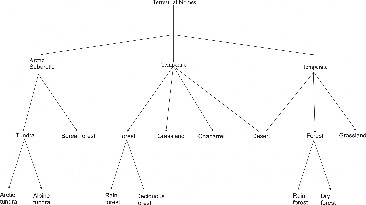
Figure 16.9: (14)
Review Questions
Identify the two types of tundra and where they are found.
Name two temperate biomes and the main type of plant found in each biome.
In which biome are you most likely to find grasses, zebras, and lions?
Assume a new species of lizard has been discovered in the northern hemisphere. It lives in an area of dense evergreen forest, where mosses and lichens grow on the forest floor. Identify the biome in which the lizard was found and explain your answer.
www.ck12.org 766
If you were to design a well-adapted desert animal, what traits would you give it to help it survive in its desert environment?
Compare and contrast two types of temperate forests.
If the tropics receive more sunlight year-round than any other biome, why are some plants in tropical rainforests adapted to low levels of sunlight?
Further Reading / Supplemental Links
Michael Allaby, Grasslands. Chelsea House Publications, 2006.
Michael Allaby, Temperate Forests. Chelsea House Publications, 2006.
Michael Allaby, Tropical Rain Forests. Chelsea House Publications, 2006.
Trevor Day, Taiga. Chelsea House Publications, 2006.
Peter D. Moore, Tundra. Chelsea House Publications, 2006.
Susan L. Woodward, Biomes of Earth: Terrestrial, Aquatic, and Human-Dominated. Greenwood Press, 2003.
http://ag.arizona.edu/OALS/watershed/highlands/chaparral/chsoils.html
http://environment.newscientist.com/article/mg18725124.500.html
http://estrellamountain.edu/faculty/farabee/biobk/BioBookcommecosys.html
http://ridge.icu.ac.jp/gen-ed/biomes.html
http://users.rcn.com/jkimball.ma.ultranet/BiologyPages/B/Biomes.htmll
http://www.nationalgeographic.com/wildworld/profiles/terrestrial/nt/nt0115. html
http://earthobservatory.nasa.gov/Laboratory/Biome/
http://www.thewildclassroom.com/biomes/index.html
http://users.rcn.com/jkimball.ma.ultranet/BiologyPages/B/Biomes.html
Vocabulary
alpine tundra Tundra biome that occurs in mountains around the world at any latitude, but only above the tree line.
arctic tundra Tundra biome that occurs north of the arctic circle and south of the antarc- tic circle.
boreal forest Subarctic biome covered with conifers.
chaparral Temperate biome with a Mediterranean climate that consists mainly of densely- growing evergreen shrubs such as scrub oak.
desert Temperate or tropical biome that receives no more than 25 centimeters of precipi- tation per year.
767 www.ck12.org
epiphyte Type of plant that grows on other plants for support.
permafrost Frozen soil year-round.
temperate deciduous forest Temperate biome that receives moderate rainfall and con- sists mainly of deciduous trees such as maples.
temperate grassland Temperate biome that receives relatively low precipitation and con- sists mainly of grasses.
temperate rainforest Temperate biome that receives heavy rainfall and consists mainly of evergreen trees such as hemlocks.
tree line Edge of the zone at which trees are able to survive.
tropical dry forest Tropical biome that receives relatively low rainfall, has a dry season, and consists mainly of widely spaced, drought-adapted trees.
tropical grassland Tropical biome that receives relatively low rainfall, has a dry season, and consists mainly of grasses.
tropical rainforest Tropical biome that receives heavy rainfall and consists mainly of tall, broadleaf evergreen trees.
tundra Arctic biome where it is too cold for trees to grow.
Points to Consider
The land areas where terrestrial biomes are found cover only 30 percent of Earth’s surface. The rest of the surface is covered by water.
What types of biomes do you think occur in water?
How do you think water biomes might be classified?
What do you think are some of the organisms that live in water biomes?
Lesson 16.3: Aquatic Biomes
Lesson Objectives
Describe how aquatic biomes are divided into zones, and list types of aquatic organisms.
Identify marine biomes, and state which biomes have the highest biodiversity.
Name types of freshwater biomes, and describe how they differ from one another. www.ck12.org 768
Introduction
Terrestrial organisms are generally limited by temperature and moisture. Therefore, terres- trial biomes are defined in terms of these abiotic factors. In contrast, most organisms that live in the water do not have to deal with extremes of temperature or moisture. Instead, their main limiting factors are the availability of sunlight and the concentration of dissolved nutrients in the water.
What Are Aquatic Biomes?
Aquatic biomes are biomes found in water. Water covers 70 percent of Earth’s surface, so aquatic biomes are a major component of the biosphere. However, they have less total biomass than terrestrial biomes. Aquatic biomes can occur in either salt water or freshwater. About 98 percent of Earth’s water is salty, and only 2 percent is fresh. The primary saltwater biome is the ocean. Major freshwater biomes include lakes and rivers.
Aquatic Zones
In large bodies of standing water (including the ocean and lakes), the water can be divided into zones based on the amount of sunlight it receives. There is enough sunlight for photo- synthesis only in - at most - the top 200 meters of water. Water down to this depth is called the photic zone. Deeper water, where too little sunlight penetrates for photosynthesis, is called the aphotic zone.
Surface water dissolves oxygen from the air, so there is generally plenty of oxygen in the photic zone to support organisms. Water near shore usually contains more dissolved nutrients than water farther from the shore. This is because most dissolved nutrients enter a body of water from land, carried by runoff or rivers that empty into the body of water. When aquatic organisms die, they sink to the bottom, where decomposers release the nutrients they contain. As a result, deep water may contain more nutrients than surface water.
Deep ocean water may be forced to the surface by currents in a process called '''upwelling.''' When this happens, dissolved nutrients are brought to the surface from the deep ocean. The nutrients can support large populations of producers and consumers, including many species of fish. As a result, areas of upwelling are important for commercial fishing.With these variations in sunlight, oxygen, and nutrients, different parts of the ocean or a lake have different types and numbers of organisms. Therefore, life in a lake or the ocean is generally divided into zones. The zones correlate mainly with the amount of sunlight and nutrients available to producers. Figure 1 shows ocean zones. Lakes have similar zones.
The littoral zone is the shallow water near the shore. In the ocean, the littoral zone is also called the intertidal zone.
769 www.ck12.org

Figure 16.10: The ocean is divided into many different zones, depending on distance from shore and depth of water. The pelagic zone is divided into neritic and oceanic zones based on distance from shore. Into what additional zones is the pelagic zone divided on the basis of water depth? What additional zones make up the benthic zone? (17)
The pelagic zone is the main body of open water farther out from shore. It is divided into additional zones based on water depth. In the ocean, the part of the pelagic zone over the continental shelf is called the neritic zone, and the rest of the pelagic zone is called the oceanic zone.
The benthic zone is the bottom surface of a body of water. In the ocean, the benthic
zone is divided into additional zones based on depth below sea level.
Aquatic Organisms
Aquatic organisms are classified into three basic categories: plankton, nekton, and benthos. Organisms in these three categories vary in where they live and how they move.
Plankton are aquatic organisms that live in the water itself and cannot propel them- selves through water. They include both phytoplankton and zooplankton. Phyto- plankton are bacteria and algae that use sunlight to make food by photosynthesis. Zooplankton are tiny animals that feed on phytoplankton.
Nekton are aquatic animals that live in the water and can propel themselves by swimming or other means. Nekton include invertebrates such as shrimp and vertebrates such as fish.
Benthos are aquatic organisms that live on the surface below a body of water. They
www.ck12.org 770
live in or on the sediments at the bottom. Benthos include sponges, clams, and sea stars (see Figure 2).
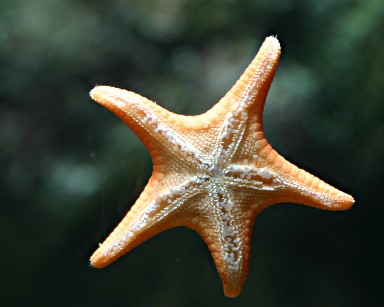
Figure 16.11: This sea star, or starfish, is an example of a benthic organism. The tiny white projections on the bottom surface of the sea star allow it anchor to, or slowly crawl over, the bottom surface of the ocean. (16)
Marine Biomes
Marine biomes are aquatic biomes found in the salt water of the ocean. Major marine biomes are neritic, oceanic, and benthic biomes. Other marine biomes include intertidal zones, estuaries, and coral reefs.
Neritic Biomes
Neritic biomes occur in ocean water over the continental shelf (see Figure 1). They extend from the low-tide water line to the edge of the continental shelf. The water here is shallow, so there is enough sunlight for photosynthesis. The water is also rich in nutrients, which are washed into the water from the nearby land. Because of these favorable conditions, large populations of phytoplankton live in neritic biomes. They produce enough food to support many other organisms, including both zooplankton and nekton. As a result, neritic biomes have relatively great biomass and biodiversity. They are occupied by many species of invertebrates and fish. In fact, most of the world’s major saltwater fishing areas are in neritic biomes.
771 www.ck12.org
Oceanic Biomes
Oceanic biomes occur in the open ocean beyond the continental shelf. There are lower concentrations of dissolved nutrients away from shore, so the oceanic zone has a lower density of organisms than the neritic zone. The oceanic zone is divided into additional zones based on water depth (see Figure 1).
The epipelagic zone is the top 200 meters of water, or the depth to which enough sunlight can penetrate for photosynthesis. Most open ocean organisms are concentrated in this zone, including both plankton and nekton.
The mesopelagic zone is between 200 and 1,000 meters below sea level. Some sun- light penetrates to this depth but not enough for photosynthesis. Organisms in this zone consume food drifting down from the epipelagic zone, or they prey upon other organisms in their own zone. Some organisms are detrivores, which consume dead organisms and organic debris that also drift down through the water.
The bathypelagic zone is between 1,000 and 4,000 meters below sea level. No sunlight penetrates below 1,000 meters, so this zone is completely dark. Most organisms in this zone either consume dead organisms drifting down from above or prey upon other animals in their own zone. There are fewer organisms and less biomass here than in higher zones. Some animals are bioluminescent, which means they can give off light (see Figure 3). This is an adaptation to the total darkness.
The abyssopelagic zone is between 4,000 and 6,000 meters below sea level. The hadopelagic zone is found in the water of deep ocean trenches below 6,000 meters. Both of these zones are similar to the bathypelagic zone in being completely dark. They have even lower biomass and species diversity.
Benthic Biomes
Benthic biomes occur on the bottom of the ocean where benthos live. Some benthos, including sponges, are sessile, or unable to move, and live attached to the ocean floor. Other benthos, including clams, burrow into sediments on the ocean floor. The benthic zone can be divided into additional zones based on how far below sea level the ocean floor is (see Figure 1).
The sublittoral zone is the part of the ocean floor that makes up the continental shelf near the shoreline. The water is shallow enough for sunlight to penetrate down to the ocean floor. Therefore, photosynthetic producers such as seaweed can grow on the ocean floor in this zone. The littoral zone is rich in marine life.
The bathyal zone is the part of the ocean floor that makes up the continental slope. It ranges from about 1,000 to 4,000 meters below sea level. The bathyal zone contains no producers because it is too far below the surface for sunlight to penetrate. Although
www.ck12.org 772
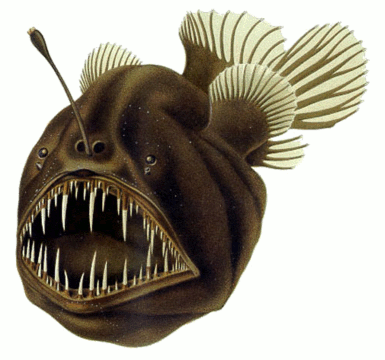
Figure 16.12: The anglerfish lives in the bathypelagic zone. The rod-like structure protruding from the anglerfish’s face is tipped with bioluminescent microorganisms. The structure wiggles like a worm to attract prey. Only the ”worm” is visible to prey in the total darkness of this zone. (26)
773 www.ck12.org
consumers and decomposers live in this zone, there are fewer organisms here than in the sublittoral zone.
The abyssal zone is the part of the ocean floor in the deep open ocean. It varies from
about 4,000 to 6,000 meters below sea level. Organisms that live on the ocean floor in this zone must be able to withstand extreme water pressure, continuous cold, and scarcity of nutrients. Many of the organisms sift through sediments on the ocean floor for food or dead organisms.
The hadal zone is the ocean floor below 6,000 meters in deep ocean trenches. The only
places where organisms are known to live in this zone are at hydrothermal vents, where invertebrates such as tubeworms and clams are found. They depend on microscopic archaea organisms for food. These tiny chemosynthetic producers obtain energy from chemicals leaving the vents (see the Principles of Ecology chapter).
Intertidal Zone
The intertidal zone is a narrow strip along the coastline that falls between high- and low- tide water lines. It is also called the littoral zone (see Figure 1). A dominant feature of this zone is the regular movement of the tides in and out. In most areas, this occurs twice a day. Due to the tides, this zone alternates between being under water at high tide and being exposed to the air at low tide. An intertidal zone is pictured in Figure 4.

Figure 16.13: These pictures show the Bay of Fundy off the northeastern coast of Maine in North America. The picture on the left shows the bay at high tide, and the picture on the right shows the bay at low tide. The area covered by water at high tide and exposed to air at low tide is the intertidal zone. (24)
www.ck12.org 774
The high tide repeatedly brings in coastal water with its rich load of dissolved nutrients. There is also plenty of sunlight for photosynthesis. In addition, the shallow water keeps large predators, such as whales and big fish, out of the intertidal zone. As a result, the intertidal zone has a high density of living things. Seaweeds and algae are numerous, and they support many consumer species, either directly or indirectly, including barnacles, sea stars, and crabs.
Other conditions in the intertidal zone are less favorable. For example, there are frequent shifts from a water to an air environment. There are also repeated changes in temperature and salinity (salt concentration). These changing conditions pose serious challenges to marine organisms. The moving water poses yet another challenge. Organisms must have some way to prevent being washed out to sea with the tides. Barnacles, like those in Figure 5, cement themselves to rocks. Seaweeds have rootlike structures, called holdfasts, which anchor them to rocks. Crabs burrow underground to avoid being washed out with the tides.
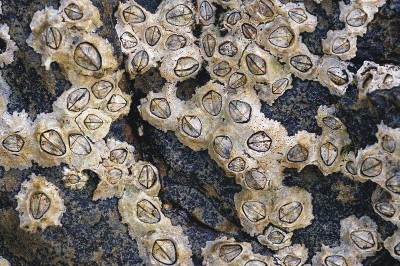
Figure 16.14: Barnacles secrete a cement-like substance that anchors them to rocks. (5)
Other Marine Biomes
The intertidal zone has high biodiversity. However, it is not the marine biome with the highest biodiversity. That distinction goes to estuaries and coral reefs. They have the highest biodiversity of all marine biomes.
An estuary is a bay where a river empties into the ocean. It is usually semi-enclosed, making it a protected environment. The water is rich in dissolved nutrients from the river and shallow enough for sunlight to penetrate for photosynthesis. As a result, estuaries are full of marine life. Figure 6 shows an estuary on the California coast near San Francisco.
775 www.ck12.org
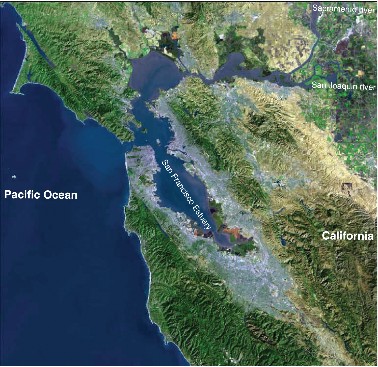
Figure 16.15: This satellite photo shows the San Francisco Estuary on the California coast. This is the largest estuary on the lower west coast of North America. Two rivers, the Sacramento and the San Joaquin, flow into the estuary (upper right corner of photo). The estuary is almost completely enclosed by land but still connected to the ocean. (4)
www.ck12.org 776
A coral reef is an underwater limestone structure produced by tiny invertebrate ani- mals called corals. Coral reefs are found only in shallow, tropical ocean water. Corals secrete calcium carbonate (limestone) to form an external skeleton. Corals live in colonies, and the skeletal material gradually accumulates to form a reef. Coral reefs are rich with marine organisms, including more than 4,000 species of tropical fish. Figure 7 shows a coral reef in the Hawaiian Islands.
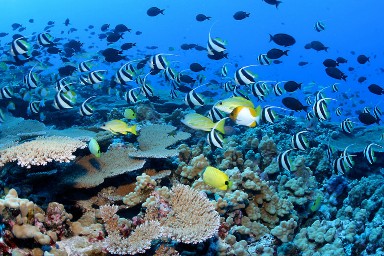
Figure 16.16: Colorful fish swim in warm, shallow ocean water near a coral reef off the Hawaiian Islands. (2)
Freshwater Biomes
Freshwater biomes occur in water that contains little or no salt. Freshwater biomes include standing water and running water biomes.
Standing Freshwater Biomes
Standing freshwater biomes include ponds and lakes. Ponds are generally smaller than lakes and shallow enough for sunlight to reach all the way to the bottom. In lakes, at least some of the water is too deep for sunlight to penetrate. As a result, like the ocean, lakes can be divided into zones based on availability of sunlight for producers.
The littoral zone is the water closest to shore. The water in the littoral zone is generally shallow enough for sunlight to penetrate, allowing photosynthesis. Producers in this zone include both phytoplankton and plants that float in the water. They provide
777 www.ck12.org
food, oxygen, and habitat to other aquatic organisms. The littoral zone generally has high productivity and high biodiversity.
The limnetic zone is the top layer of lake water away from shore. This zone covers
much of the lake’s surface, but it is only as deep as sunlight can penetrate. This is a maximum of 200 meters. If the water is muddy or cloudy, sunlight cannot penetrate as deeply. Photosynthesis occurs in this zone, and the primary producers are phyto- plankton, which float suspended in the water. Zooplankton and nekton are also found in this zone. The limnetic zone is generally lower in productivity and biodiversity than the littoral zone.
The profundal zone is the deep water near the bottom of a lake where no sunlight
penetrates. Photosynthesis cannot take place, so there are no producers in this zone. Consumers eat food that drifts down from above, or they eat other organisms in the profundal zone. Decomposers break down dead organisms that drift down through the water. This zone has low biodiversity.
The benthic zone is the bottom of a lake. Near the shore, where water is shallow, the bottom of the lake receives sunlight, and plants can grow in sediments there. Organisms such as crayfish, snails, and insects also live in and around the plants near shore. The plants provide shelter from predatory fish as well as food and oxygen. In deeper water, where the bottom of the lake is completely dark, there are no producers. Most organisms that live here are decomposers.
The surface water of a lake is heated by sunlight and becomes warmer than water near the bottom. Because warm water is less dense that cold water, it remains on the surface. When dead organisms sink to the bottom of a lake, they are broken down by decomposers that release the nutrients from the dead organism. As a result, nutrients accumulate at the lake’s bottom. In spring and fall in temperate climates, the surface water of a lake reaches the same temperature as the deeper water. This gives the different water layers the same density, allowing them to intermix. This process, called turnover, brings nutrients from the bottom of the lake to the surface, where producers can use them.
Lakes can be categorized on the basis of their overall nutrient levels, as shown in Table 1. Oligotrophic lakes have low nutrient levels, so they also have low productivity. With few producers (or other aquatic organisms), the water remains clear and little oxygen is used up to support life. Biodiversity is low.
Table 16.2: Trophic Classification of Freshwater Lakes
Type of Lake | Nutrient Level | Productivity | Clarity of Water | Oxygen Level |
Oligotrophic | Low | Low | High | High |
Mesotrophic | Medium | Medium | Medium | Medium |
Eutrophic | High | High | Low | Low |
Hypertrophic | Very high | Very high | Very low | Very low |
www.ck12.org 778
Acid rain is another cause of low productivity in lakes. Acid rain falling into a lake causes the lake water to become too acidic for many species to tolerate. This results in a decline in the number and diversity of lake organisms. This has happened to many lakes throughout the northeastern United States. The water in the lakes is very clear because it is virtually devoid of life.Lakes with high nutrient levels have higher productivity, cloudier water, lower oxygen levels, and higher biomass and biodiversity. Very high nutrient levels in lakes are generally caused by contamination with fertilizer or sewage. The high concentration of nutrients may cause a massive increase in phytoplankton, called a phytoplankton bloom (see Figure 8). The bloom blocks sunlight from submerged plants and other producers and negatively impacts most organisms in the lake.

Figure 16.17: The phytoplankton bloom on this lake blocks most sunlight from penetrating below the surface, creating a condition detrimental to many other aquatic organisms. (28)
779 www.ck12.org
Running Freshwater Biomes
Running freshwater biomes include streams and rivers. Streams are generally smaller than rivers. Streams may start with surface runoff, snowmelt from a glacier, or water seeping out of the ground from a spring. If the land is not flat, the water runs downhill. The water joins other streams and then rivers as it flows over the land. Eventually, the water empties into a pond, lake, or the ocean.
Some species living in rivers that empty into the ocean may live in freshwater during some stages of their life cycle and in salt water during other stages. For example, salmon are born and develop in freshwater rivers and then move downstream to the ocean, where they live as adults. In contrast, some eels are born and develop in the ocean and then move into freshwater rivers to live as adults.Compared with standing water, running water is better able to dissolve oxygen needed by producers and other aquatic organisms. When a river rushes over a waterfall, like the one in Figure 9, most of the water is exposed to the air, allowing it to dissolve a great deal of oxygen. Flowing water also provides a continuous supply of nutrients. Some nutrients come from the decomposition of dead aquatic organisms. Other nutrients come from the decomposition of dead terrestrial organisms, and other organic debris such as leaves, that fall into the water.
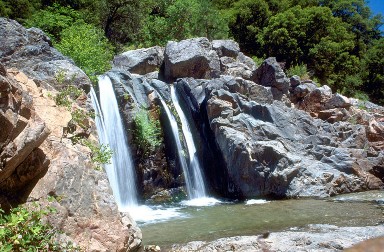
Figure 16.18: Flowing water forms a waterfall on the South Yuba River in Nevada County, California. As the water falls through the air, it dissolves oxygen needed by aquatic organ- isms. (3)
Algae are the main producers in running freshwater biomes. If water flows slowly, algae can float suspended in the water, and huge populations may form, like the phytoplankton bloom in Figure 8 above. If water flows rapidly, algae must attach themselves to rocks or plants to avoid being washed away and generally cannot form very large populations.
www.ck12.org 780
Plants are also important producers in most running water biomes. Some plants, such as mosses, cling to rocks. Other plants, such as duckweed, float in the water. If nutrient levels are high, floating plants may form a thick mat on the surface of the water, like the one shown in Figure 10 (left photo). Still other plants grow in sediments on the bottoms of streams and rivers. Many of these plants—like the cattails in Figure 10 (right photo)—have long narrow leaves that offer little resistance to the current. In addition to serving as a food source, plants in running water provide aquatic animals with protection from the current and places to hide from predators.

Figure 16.19: The picture on the left shows a thick mat of duckweed floating on a river. The picture on the right shows cattails growing in sediments at the edge of a stream bed. Notice the cattails’ long, slender leaves, which reduce water resistance. (21)
Consumers in running water include both invertebrate and vertebrate animals. The most common invertebrates are insects. Others include snails, clams, and crayfish. Some inverte- brates live on the water surface, others float suspended in the water, and still others cling to rocks on the bottom. All rely on the current to bring them food and dissolved oxygen. The invertebrates are important consumers as well as prey to the many vertebrates in running water. Vertebrate species include fish, amphibians, reptiles, birds, and mammals. However, only fish live in the water all the time. Other vertebrates spend part of their time on land.
The movement of running water poses a challenge to aquatic organisms, which have adapted in various ways. Some organisms have hooks or threadlike filaments to anchor themselves to rocks or plants in the water. Other organisms, including fish, have fins and streamlined bodies that allow them to swim against the current.The interface between running freshwater and land is called a ri- parian zone. It includes the vegetation that grows along the edge of a river and the animals that consume or take shelter in the vegetation. Riparian zones are very important natural areas for several reasons:
They filter pollution from surface runoff before it enters a river.
They help keep river water clear by trapping sediments.
They protect river banks from erosion by running water.
They help regulate the temperature of river water by providing shade.
781 www.ck12.org
Wetlands
A wetland is an area that is saturated or covered by water for at least one season of the year. Freshwater wetlands are also called swamps, marshes, or bogs. Saltwater wetlands include estuaries, which are described earlier in this lesson. Wetland vegetation must be adapted to water-logged soil, which contains little oxygen. Freshwater wetland plants include duckweed and cattails (see Figure 10, above). Some wetlands also have trees. Their roots may be partly above ground to allow gas exchange with the air. Wetlands are extremely important biomes for several reasons.
They store excess water from floods and runoff.
They absorb some of the energy of running water and help prevent erosion.
They remove excess nutrients from runoff before it empties into rivers or lakes.
They provide a unique habitat that certain communities of plants need to survive.
They provide a safe, lush habitat for many species of animals.
Lesson Summary
Aquatic biomes are divided into zones based on factors such as water depth and amount of sunlight available for photosynthesis. Aquatic organisms include plankton, nekton, and benthos.
Marine biomes include neritic, oceanic, and benthic biomes. Intertidal zones, estuaries, and coral reefs are marine biomes with the highest biodiversity.
Freshwater biomes may be standing water biomes, such as lakes, or running water biomes, such as rivers. Wetlands are biomes in which the ground is saturated or covered by water for at least part of the year.
Review Questions
In a large body of standing water, what is the photic zone?
State why the oceanic zone has a lower concentration of nutrients than the neritic zone.
Why is moving water a major challenge for organisms in the littoral zone of the ocean?
Why does the profundal zone of a lake have no producers?
A new species of bioluminescent fish has been discovered in the ocean. Which oceanic zone is most likely the home of this fish? Explain your answer.
A developer plans to extend a golf course into a riparian biome. Outline environmental arguments you could make against this plan.
Compare and contrast plankton, nekton, and benthos.
In the deep ocean far from shore, why might you find more dissolved nutrients at the bottom than at the surface?
www.ck12.org 782
Further Reading / Supplemental Links
Trevor Day, Lakes and Rivers. Chelsea House Publications, 2006.
Trevor Day, Oceans. Chelsea House Publications, 2006.
Stephen Hutchinson and Lawrence E. Hawkins, Oceans: A Visual Guide. Firefly Books, 2005.
Peter D. Moore, Wetlands. Chelsea House Publications, 2006.
David Sanger and John Hart, San Francisco Bay: Portrait of an Estuary. University of California Press, 2003
Susan L. Woodward, Biomes of Earth: Terrestrial, Aquatic, and Human-Dominated. Greenwood Press, 2003.
http://ridge.icu.ac.jp/gen-ed/biomes.html
http://estrellamountain.edu/faculty/farabee/biobk/BioBookcommecosys.html
http://ridge.icu.ac.jp/gen-ed/biomes.html
http://sfbay.wr.usgs.gov/
http://users.rcn.com/jkimball.ma.ultranet/BiologyPages/B/Biomes.html
http://www.davidsanger.com/san-francisco-bay-book/
http://www.oceanexplorer.noaa.gov/edu/curriculum/section5.pdf
http://www.waterencyclopedia.com/La-Mi/Life-in-Water.html
Vocabulary
abyssal zone Part of the ocean floor that is under the deep ocean.
abyssopelagic zone Water between 4,000 and 6,000 meters below sea level in the oceanic zone.
aphotic zone Deep water in a lake or the ocean where too little sunlight penetrates for photosynthesis to occur.
bathyal zone Part of the ocean floor that makes up the continental slope.
bathypelagic zone Water between 1,000 and 4,000 meters below sea level in the oceanic zone.
benthic biome Marine biome that occurs on the bottom of the ocean where benthos live.
benthic zone Bottom surface of the ocean or a lake.
benthos Aquatic organisms that live on the surface below a body of water.
783 www.ck12.org
coral reef Underwater limestone structure formed by tiny invertebrate animals called corals.
epipelagic zone Top 200 meters of water in the oceanic zone.
estuary Bay where a river empties into the ocean.
freshwater biome Biome such as a lake or river that has water with little or no salt.
hadal zone Part of the ocean floor that is in deep ocean trenches.
hadopelagic zone Water of deep ocean trenches below 6,000 meters in the oceanic zone.
intertidal zone Narrow strip along the coastline of the ocean that falls between high- and low-tide water lines.
limnetic zone Top layer of deep water in a lake, down to the depth that sunlight pene- trates.
littoral zone Shallow water near the shore of a lake or the ocean.
marine biome Aquatic biome found in the salt water of the ocean.
mesopelagic zone Water between 200 and 1,000 meters below sea level in the oceanic zone.
nekton Aquatic animals that live in the water itself and can propel themselves by swim- ming or other means.
neritic biome Marine biome that occurs in ocean water over the continental shelf.
neritic zone Part of the pelagic zone over the continental shelf.
oceanic biome Marine biome that occurs in ocean water beyond the continental shelf.
oceanic zone Part of the pelagic zone beyond the continental shelf.
pelagic zone Main body of open water away from shore in a lake or the ocean. www.ck12.org 784
photic zone Depth of water in a lake or the ocean to which sunlight can penetrate and photosynthesis can occur.
plankton Aquatic organisms that live in the water itself and cannot propel themselves through water.
profundal zone Deep water in a lake near the bottom where no sunlight penetrates.
riparian zone Interface between running freshwater and land.
sublittoral zone Part of the ocean floor that makes up the continental shelf.
turnover Process in which different layers of lake water intermix and bring nutrients from the bottom to the surface.
upwelling Process in which deep ocean water is forced to the surface by currents, bringing dissolved nutrients from the bottom to the surface.
wetland Area that is saturated or covered by water for at least one season of the year.
Points to Consider
Next we discuss community interactions. Abiotic factors such as water depth affect organisms in aquatic biomes. Organisms in all biomes are also affected by biotic factors, which include their interactions with other species.
How do you think different species interact?
What types of relationships do you think different species might have with eachother?
How could these relationships affect the evolution of the species involved?
Lesson 16.4: Community Interactions
Lesson Objectives
State the significance of the community in ecology, and list types of community inter- actions.
Define predation, and explain how it affects population growth and evolution.
Describe competition, and outline how it can lead to extinction or specialization of species.
Define symbiosis, and identify major types of symbiotic relationships.
Describe ecological succession, and explain how it relates to the concept of a climax community.
785 www.ck12.org
Introduction
Biomes as different as grasslands and estuaries share something extremely important. They have populations of interacting species. Moreover, species interact in the same basic ways in all biomes. For example, all biomes have some species that prey on other species for food. Species interactions are important biotic factors in ecological systems. The focus of study of species interactions is the community.
What Is a Community?
In ecology, a community is the biotic component of an ecosystem. It consists of populations of different species that live in the same area and interact with one another. Like abiotic factors, such as climate or water depth, species interactions in communities are important biotic factors in natural selection. The interactions help shape the evolution of the interact- ing species. Three major types of community interactions are predation, competition, and symbiosis.
Predation
Predation is a relationship in which members of one species (the predator) consume mem- bers of other species (the prey). The lions and cape buffalo in Figure 1 are classic examples of predators and prey. In addition to the lions, there is another predator in this figure. Can you find it? The other predator is the cape buffalo. Like the lion, it consumes prey species, in this case species of grasses. Predator-prey relationships account for most energy transfers in food chains and webs (see the Principles of Ecology chapter).
Types of Predators
The lions in Figure 1 are true predators. In true predation, the predator kills its prey. Some true predators, like lions, catch large prey and then dismember and chew the prey before eating it. Other true predators catch small prey and swallow it whole. For example, snakes swallow mice whole.
Some predators are not true predators because they do not kill their prey. Instead, they graze on their prey. In grazing, a predator eats part of its prey but rarely kills it. For example, deer graze on plants but do not usually kill them. Animals may also be “grazed” upon. For example, female mosquitoes suck tiny amounts of blood from animals but do not harm them, although they can transmit disease.
www.ck12.org 786
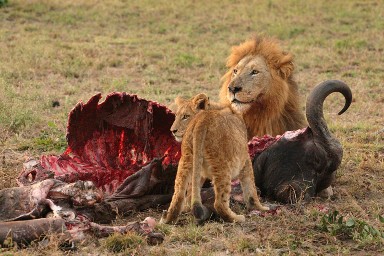
Figure 16.20: An adult male lion and a lion cub feed on the carcass of a South African cape buffalo. (19)
Predation and Populations
True predators help control the size of prey populations. This is especially true when a predator preys on just one species. Generally, the predator-prey relationship keeps the population size of both species in balance. This is shown in Figure 2. Every change in population size of one species is followed by a corresponding change in the population size of the other species. Generally, predator-prey populations keep fluctuating in this way as long as there is no outside interference.
Some predator species are known as keystone species, because they play such an impor- tant role in their community. Introduction or removal of a keystone species has a drastic effect on its prey population. This, in turn, affects populations of many other species in the community. For example, some sea star species are keystone species in coral reef communi- ties. The sea stars prey on mussels and sea urchins, which have no other natural predators. If sea stars are removed from a coral reef community, mussel and sea urchin populations would have explosive growth, which in turn would drive out most other species and destroy the reef community.
Sometimes humans deliberately introduce predators into an area to control pests. This is called biological pest control. One of the earliest pests controlled in this way was a type of insect, called a scale insect. The scale insect was accidentally introduced into California from Australia in the late 1800s. It had no natural predators in California and was destroying the state’s citrus trees. Then, its natural predator in Australia, a type of beetle, was introduced into California in an effort to control the scale insect. Within a few years, the insect was completely controlled by the predator. Unfortunately, biological pest control does not always work this well. Pest populations often rebound after a period of decline.
787 www.ck12.org
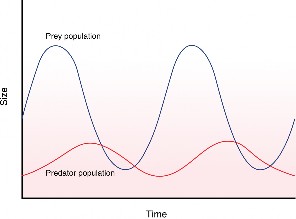
Figure 16.21: As the prey population increases, the predator population starts to rise. With more predators, the prey population starts to decrease, which, in turn, causes the predator population to decline. This pattern keeps repeating. There is always a slight lag between changes in one population and changes in the other population. (20)
www.ck12.org 788
Adaptations to Predation
Both predators and prey have adaptations to predation. Predator adaptations help them capture prey. Prey adaptations help them avoid predators. A common adaptation in both predator and prey species is camouflage, or disguise. One way of using camouflage is to blend in with the background. Several examples are shown in Figure 3.

Figure 16.22: Can you see the crab in the photo on the left? It is camouflaged with algae. The preying mantis in the middle photo looks just like the dead leaves in the background. The stripes on the zebras in the right photo blend the animals together, making it hard to see where one zebra ends and another begins. (13)
Another way of using camouflage is to look like a different, more dangerous animal. Using appearance to “mimic” another animal is called mimicry. Figure 4 shows an example of mimicry. The moth in the figure has markings on its wings that look like the eyes of an owl. When a predator comes near, the moth suddenly displays the markings. This startles the predator and gives the moth time to fly away.

Figure 16.23: The moth on the left mimics the owl on the right. This “disguise” helps protect the moth from predators. (25)
Some prey species have adaptations that are the opposite of camouflage. They have bright colors or other highly noticeable traits that serve as a warning for their predators to stay away. For example, some of the most colorful butterflies are poisonous to birds, so birds have learned to avoid eating them. By being so colorful, the butterflies are more likely to be noticed—and avoided—by their predators.
789 www.ck12.org
Predation, Natural Selection, and Co-evolution
Adaptations to predation come about through natural selection (see the Evolution in Popula- tions chapter). When a prey organism avoids a predator, it has higher fitness than members of the same species that were killed by the predator. The organism survives longer and may produce more offspring. As a result, traits that helped the prey organism avoid the predator gradually become more common in the prey population.
Evolution of traits in the prey species leads to evolution of corresponding traits in the predator species. This is called co-evolution. In co-evolution, each species is an important factor in the natural selection of the other species. Predator-prey co-evolution is illustrated by rough-skinned newts and common garter snakes, both shown in Figure 5. Through natural selection, newts evolved the ability to produce a strong toxin. In response, garter snakes evolved the ability to resist the toxin, so they could still safely prey upon newts. Then, newts evolved the ability to produce higher levels of toxin. This was followed by garter snakes evolving resistance to the higher levels. In short, the predator-prey relationship led to an evolutionary “arms race,” resulting in extremely high levels of toxin in newts.

Figure 16.24: The rough-skinned newt on the left is highly toxic to other organisms. Common garter snakes, like the one on the right, have evolved resistance to the toxin. (15)
Competition
Competition is a relationship between organisms that strive for the same limited resources. The resources might be food, nesting sites, or territory. Two different types of competition are intraspecific and interspecific competition.
Intraspecific competition occurs between members of the same species. For exam- ple, two male birds of the same species might compete for mates in the same territory. Intraspecific competition is a necessary factor in natural selection. It leads to adaptive changes in a species through time (see the Evolution in Populations chapter).
Interspecific competition occurs between members of different species. For example,
two predator species might compete for the same prey. Interspecific competition takes place in communities of interacting species. It is the type of competition referred to in the rest of this section.
www.ck12.org 790
Interspecific Competition and Extinction
When populations of different species in a community depend on the same resources, there may not be enough resources to go around. If one species has a disadvantage, such as more predators, it may get fewer of the necessary resources. As a result, members of that species are less likely to survive, and the species will have a higher death rate than the other species. Fewer offspring will be produced and the species may eventually die out in the area.
In nature, interspecific competition has often led to the extinction of species. Many other extinctions have occurred when humans introduced new species into areas where they had no predators. For example, rabbits were introduced into Australia in the mid-1800s for sport hunting. Rabbits had no predators in Australia and quickly spread throughout the continent. Many species of Australian mammals could not successfully compete with rabbits and went extinct.
Interspecific Competition and Specialization
Another possible outcome of interspecific competition is the evolution of traits that create distinct differences among the competing species. Through natural selection, competing species can become more specialized. This allows them to live together without competing for the same resources. An example is the anolis lizard. Many species of anolis live and prey on insects in tropical rainforests. Competition among the different species led to the evolution of specializations. Some anolis evolved specializations to prey on insects in leaf litter on the forest floor. Others evolved specializations to prey on insects on the branches of trees. This allowed the different species of anolis to co-exist without competing.
Symbiotic Relationships
Symbiosis is a close association between two species in which at least one species benefits. For the other species, the outcome of the association may be positive, negative, or neu- tral. There are three basic types of symbiotic relationships: mutualism, commensalism, and parasitism.
Mutualism
Mutualism is a symbiotic relationship in which both species benefit. Lichen is a good example. A lichen is not a single organism but a fungus and an alga. The fungus absorbs water from air and minerals from rock or soil. The alga uses the water and minerals to make food for itself and the fungus. Another example involves goby fish and shrimp (see Figure 6). The nearly blind shrimp and the fish spend most of their time together. The shrimp maintains a burrow in the sand in which both the goby and the shrimp live. When a
791 www.ck12.org
predator comes near, the fish touches the shrimp with its tail as a warning. Then, both fish and shrimp retreat to the burrow until the predator is gone. Each gains from this mutualistic relationship: the shrimp gets a warning of approaching danger, and the fish gets a safe home and a place to lay its eggs.
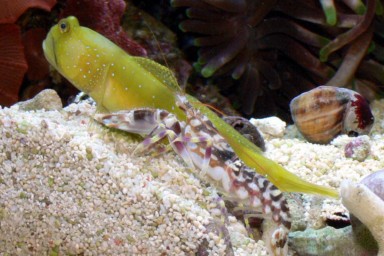
Figure 16.25: The multicolored shrimp in the front and the green goby fish behind it have a mutualistic relationship. The shrimp shares its burrow with the fish, and the fish warns the shrimp when predators are near. Both species benefit from the relationship. (11)
Co-evolution often occurs in species involved in mutualistic relationships. Many examples are provided by flowering plants and the species that pollinate them. Plants have evolved flowers with traits that promote pollination by particular species. Pollinator species, in turn, have evolved traits that help them obtain pollen or nectar from certain species of flowers. For example, the plant with tube-shaped flowers shown in Figure 7 co-evolved with hummingbirds. The birds evolved long, narrow beaks that allowed them to sip nectar from the tubular blooms.
Commensalism
Commensalism is a symbiotic relationship in which one species benefits while the other species is not affected. In commensalism, one animal typically uses another for a purpose other than food. For example, mites attach themselves to larger flying insects to get a “free ride,” and hermit crabs use the shells of dead snails for shelter.
Co-evolution explains some commensal relationships. An example is the human species and some of the species of bacteria that live inside humans. Through natural selection, many species of bacteria have evolved the ability to live inside the human body without harming it.
www.ck12.org 792
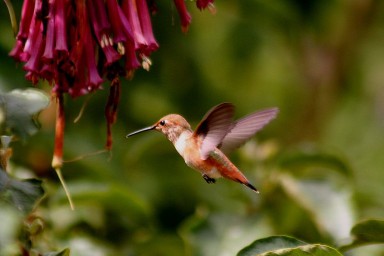
Figure 16.26: This hummingbird’s long slender beak and the large tubular flowers of the plant are a good match, which resulted from a long period of co-evolution. Their relationship is an example of mutualism. The hummingbird uses nectar from the flowers for food and pollinates the flowers in the process. (10)
Parasitism
Parasitism is a symbiotic relationship in which one species (the parasite) benefits while the other species (the host) is harmed. Some parasites live on the surface of their host. Others live inside their host, entering through a break in the skin or in food or water. For example, roundworms are parasites of the human intestine. The worms produce huge numbers of eggs, which are passed in the host’s feces to the environment. Other humans may be infected by swallowing the eggs in contaminated food or water. This usually happens only in places with poor sanitation.
Some parasites eventually kill their host. However, most parasites do not. Parasitism in which the host is not killed is a successful way of life and very common in nature. About half of all animal species are parasitic in at least one stage of their lifecycle. Many plants and fungi are parasitic during some stages, as well. Not surprisingly, most animals are hosts to one or more parasites.
Species in parastic relationships are likely to undergo co-evolution. Host species evolve defenses against parasites, and parasites evolve ways to evade host defenses. For example, many plants have evolved toxins that poison plant parasites such as fungi and bacteria. The microscopic parasite that causes malaria in humans has evolved a way to evade the human immune system. It hides out in the host’s blood cells or liver where the immune system cannot find it.
793 www.ck12.org
Ecological Succession
Ecological succession is the process by which a whole community of populations changes through time. It occurs following a disturbance that creates unoccupied areas for coloniza- tion. The first colonizer species are called pioneer species. They change the environment and pave the way for other species to move into the area. Succession occurs in two different ways, depending on the starting conditions: primary succession and secondary succession.
Primary Succession
Primary succession occurs in an area that has never been colonized before. Generally, the area is nothing but bare rock. This type of environment can come about in a number of ways, including:
Lava can flow from a volcano and harden into rock.
A glacier can retreat and leave behind bare rock.
A landslide can uncover a large area of bare rock.
After the disturbance, pioneer species move in first. They include bacteria and lichens that can live on bare rock. Along with wind and water, these pioneer species help to weather the rock and form soil. Once soil begins to form, other plants can move in. At first, the plants include grasses and other species that can grow in thin, poor soil. As more plants grow and die, organic matter is added to the soil. This improves the soil and helps it hold water. The improved soil allows shrubs and trees to move into the area. An example of primary succession is shown in Figure 8.
Secondary Succession
Secondary succession occurs in a formerly inhabited area that was disturbed. The dis- turbance could be a fire, flood, or human action such as logging or farming. Secondary succession can occur faster than primary succession because the soil is already in place. In secondary succession, the pioneer species are plants that are adapted to exploit disturbances rather than bare rock. They typically include plants such as grasses, birch trees, and fire- weed. Organic matter from the pioneer species improves the soil so other trees and plants can move into the area. An example of secondary succession is shown in Figure 9.
Climax Communities
Many early ecologists thought that a community always went through a predictable series of stages during succession. They also thought that the end result of succession was a final
www.ck12.org 794

Figure 16.27: On an island near New Zealand, bare rocks from a volcanic eruption are slowly being colonized by pioneer species. (27)
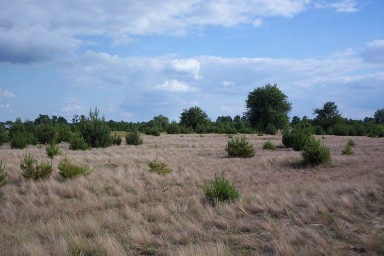
Figure 16.28: This formerly cultivated farm field in Poland is reverting to deciduous forest in the process of secondary succession. (1)
795 www.ck12.org
stage called a climax community. The type of climax community was believed to be determined mainly by climate. For example, in mild, wet temperate climates, evergreen rainforests were thought to be the predictable end result of succession. Climax communities were also thought to be very biodiverse. This characteristic, in turn, was believed to make them stable, or resistant to change.
Today, most ecologists think that change, rather than stability, is more characteristic of ecological systems. They argue that most communities are disturbed too often to reach a climax community stage. They also argue that high biodiversity does not always make a community stable. Some communities that have low biodiversity, such as salt marshes, are very resistant to change. On the other hand, some communities that have high biodiversity, such as coral reefs, are easily affected by disturbances. High biodiversity may increase species interactions. This, in turn, may make species more interdependent and communities more likely to change when they are disturbed.
Lesson Summary
A community is the biotic component of an ecosystem. It consists of populations of interacting species. Types of community interactions are predation, competition, and symbiosis.
Predation is a relationship in which members of one species consume members of other species. Predation influences population sizes and co-evolution of predator and prey species.
Competition is a relationship between organisms that strive for the same limited re- sources. Interspecific competition often leads to extinction of one species. However, it may lead to greater specialization of the species, allowing them to co-exist without competing.
Symbiosis is a close association between species in which at least one species benefits. Types of symbiotic relationships include mutualism, commensalism, and parasitism.
Ecological succession is the process by which a whole community changes through time. It occurs following a disturbance. A stable climax community may or may not be the predictable end result of succession.
Review Questions
In ecology, what is a community?
Define predation and give an example of a predator and its prey.
What are two possible outcomes of interspecific competition?
List three basic types of symbiotic relationships.
What is ecological succession and when does it occur?
Assume that a destructive beetle was accidentally introduced to California from Eu- rope. The beetle has no natural predators in California and is becoming a major pest.
www.ck12.org 796
Describe how biological pest control might be used to control this beetle.
A forest was recently disturbed, and several pioneer species have moved in. Which type of ecological succession is taking place? How do you know?
Why do species interactions often lead to co-evolution of the species involved? Give an example to illustrate your answer.
Summarize how ideas about ecological succession and climax communities have changed.
Further Reading / Supplemental Links
Robert Poulin and Serge Morand, Parasite Biodiversity. Smithsonian, 2005.
Mark Ross and David Reesor, Predator: Life and Death in the African Bush. Harry
N. Abrams, Inc., 2007.
Bernhard Stadler and Tony Dixon, Mutualism: Ants and Their Insect Partners. Cam- bridge University Press, 2008.
Marlene Zuk, Riddled with Life: Friendly Worms, Ladybug Sex, and the Parasites that Make Us Who We Are. Harcourt, 2007.
http://www.sciencemag.org/cgi/content/abstract/292/5519/1115
Vocabulary
biological pest control Deliberate introduction of a predator species into an area in order to control a pest species.
camouflage Common adaptation in predator and prey species that involves disguise.
climax community Final stage of ecological succession.
co-evolution Evolution of interacting species in which each species is an important factor in the natural selection of the other species.
commensalism Symbiotic relationship in which one species benefits while the other species is not affected.
community Biotic component of an ecosystem.
competition Relationship between organisms that strive for the same limited resources.
ecological succession Process by which a whole community changes through time follow- ing a disturbance.
797 www.ck12.org
grazing Type of predation in which the predator eats part of its prey but rarely kills it. intraspecific competition Competition between members of the same species. interspecific competition Competition between members of different species.
keystone species Predator species that plays an important role in the community by controlling the prey population and, indirectly, the populations of many other species in the community.
mimicry Using appearance to “mimic” another animal.
mutualism Symbiotic relationship in which both species benefit.
parasitism Symbiotic relationship in which one species (the parasite) benefits while the other species (the host) is harmed.
pioneer species First colonizer species in an area undergoing ecological succession.
predation Relationship in which members of one species (the predator) consume members of other species (the prey).
primary succession Ecological succession that occurs in an area that has never been colonized before.
secondary succession Ecological succession that occurs in a formerly inhabited area that was disturbed.
symbiosis Close association between two species in which at least one species benefits.
true predation Type of predation in which the predator kills its prey.
Points to Consider
The size and growth of populations in a community is influenced by species interactions. For example, predator-prey relationships control the population growth of both predator and prey species.
How would populations grow without these influences?
What other factors do you think might affect population growth?
What factors do you think may have affected the growth of the human population? www.ck12.org 798
Image Sources
http://en.wikipedia.org/wiki/Image:Secondary_succesion_cm02.jpg. Commons.
http://en.wikipedia.org/wiki/Image:
Nwhi_-_French_Frigate_Shoals_reef_-_many_fish.jpg. Commons.
http://commons.wikimedia.org/wiki/Image:South_Yuba_River_waterfall.jpg. Commons.
http://en.wikipedia.org/wiki/Image:BayareaUSGS.jpg. Commons.
http://commons.wikimedia.org/wiki/File:Chthamalus_stellatus.jpg. CC-BY-SA 3.0.
Purves et al., Life: The Science of Biology, 4th Edition, Sinauer Associates and WH Freeman. http:
//www.estrellamountain.edu/faculty/farabee/biobk/BioBookcommecosys.html. CC-BY-SA.
http://www.dpi.vic.gov.au/CA25677D007DC87D/LUbyDesc/AG1060a/\protect\ char"0024\relaxFile/AG1060a.gif. Public Domain.
http://commons.wikimedia.org/wiki/File:DSC00686Cairns.JPG. CC-BY-SA 2.0, CC-BY-SA.
http://plantphys.info/Plant_Biology/climate.html. CC-BY-SA.
http://en.wikipedia.org/wiki/Image:Humming_ggp.jpg. Commons.
http://commons.wikimedia.org/wiki/File:Gobie_and_Shrimp.JPG. CC-BY-SA.
Purves et al., Life: The Science of Biology (4th Edition), Sinauer Associates (www.sinauer.com) and WH Freeman (www.whfreeman.com). http:
//www.estrellamountain.edu/faculty/farabee/biobk/BioBookcommecosys.html. CC-BY-SA.
http://en.wikipedia.org/wiki/Image: Bristol.zoo.dead.leaf.mantis.arp.jpg http://en.wikipedia.org/wiki/Image:Zebra_Botswana_edit02.jpg. CC-BY-SA, Public Domain, CC-BY-SA.
(14) .
http://en.wikipedia.org/wiki/Image:Garter_Snake_01.jpg. Commons.
799 www.ck12.org
http://commons.wikimedia.org/wiki/File:Starfish.jpg. Public Domain.
http://en.wikipedia.org/wiki/Image:Oceanic_divisions.svg. Commons.
http://commons.wikimedia.org/wiki/File:Ferocactus1.jpg. CC-BY-SA, CC-BY-SA.
http://commons.wikimedia.org/wiki/File: Male_Lion_and_Cub_Chitwa_South_Africa_Luca_Galuzzi_2004.JPG. CC-BY-SA 2.5.
http://www.tiem.utk.edu/~gross/bioed/bealsmodules/predator-prey.html. CC-BY-SA.
http://en.wikipedia.org/wiki/Image:Typha_latifolia_02_bgiu.jpg. Commons, Commons.
CK-12 Foundation. . CC-BY-SA.
(23) .
http://commons.wikimedia.org/wiki/File:Bay_of_Fundy.jpg. CC-BY-SA 3.0.
http://commons.wikimedia.org/wiki/File:Eagle_Owl_IMG_9203.JPG. CC-BY-SA.
http://en.wikipedia.org/wiki/Image:Humpback_anglerfish.png. Commons.
http://en.wikipedia.org/wiki/Image:Rangitotolavapath.jpg. Commons.
http://en.wikipedia.org/wiki/Image:River_algae_Sichuan.jpg. Commons.
www.ck12.org 800
Lesson 17.1: Characteristics of Populations
Lesson Objectives
Recognize that human concern about overpopulation dates to ancient Greek times.
Explain that Cornucopians believe that technology will solve population problems.
Connect the study of the biology of natural populations to better understand human population issues.
Define a biological population.
Give reasons why biologists study populations.
Compare the importance of population size to that of population density.
Explain how conservation biologists use Minimum Viable Population (MVP) and Pop- ulation Viability Analysis (PVA).
Explain how patchy habitats influence the distribution of individuals within a popula- tion.
Define and explain the reasons for three patterns of dispersion within populations.
Describe how population pyramids show the age and sex structures of populations.
Interpret population pyramids to indicate populations’ birth and death rates and life expectancy.
Analyze the effect of age at maturity on population size.
Explain the structure and meaning of a generalized survivorship curve.
Compare and contrast the three basic types of survivorship curves.
801 www.ck12.org
Introduction
“Solving the population problem is not going to solve the problems of racism… of sexism… of religious intolerance… of war… of gross economic inequality—But if you don’t solve the population problem, you’re not going to solve any of those problems. Whatever problem you’re interested in, you’re not going to solve it unless you also solve the population problem. Whatever your cause, it’s a lost cause without population control.” –Paul Ehrlich, 1996
(From Paul Ehrlich and the Population Bomb, PBS video produced by Canadian biologist Dr. David Suzuki, April 26, 1996.)
What exactly is the population problem? How can it be solved?
Humans have shown concern for overpopulation since the Ancient Greeks built outposts for their expanding citizenship and delayed age of marriage for men to 30. In 1798, Thomas Malthus predicted that the human population would outgrow its food supply by the middle of the 19th century. That time arrived without a Malthusian crisis, but Charles Darwin nevertheless embraced Malthus’ ideas and made them the foundation of his own theory of evolution by natural selection. In a 1968 essay, The Tragedy of the Commons, Garrett Hardin exhorted humans to “relinquish their freedom to breed,” arguing in the journal, Science, that “the population problem has no technical solution,” but “requires a fundamental extension in morality.” In 1979, the government of China instituted a “birth planning” policy, charging fines or “economic compensation fees” for families with more than one child. Others have opposing views, however. Julian Simon, professor of Business Administration and Senior Fellow at the Cato Institute, argued that The Ultimate Resource is population, because people and markets find solutions to any problems presented by overpopulation. A group known as cornucopians continues to promote the view that more is better.
Would you support a law forbidding you to marry until a certain age? Do you know how such a law would affect population growth? Would you limit the size of all families to one child (Figure 17.1)? Do you believe families should welcome as many children as possible? Should these decisions be regulated by law, or by individual choice? Clearly, the “population problem” reaches beyond biology to economics, law, morality, and religion. Although the latter subjects are beyond the scope of this text, the study of population biology can shed some light on human population issues. Let’s look at what biologists have learned about natural populations. Later, we will look more closely at human populations, and compare them to populations in nature.
Measuring Populations
In biology, a population is a group of organisms of a single species living within a certain area. Ecologists study populations because they directly share a common gene pool. Unlike the species as a whole, members of a population form an interbreeding unit. Natural selection
www.ck12.org 802

Figure 17.1: The Chinese government mandates population control by charging “economic compensation fees” for families with more than one child. (22)
803 www.ck12.org
acts on individuals within populations, so the gene pool reflects the interaction between a population and its environment.
Biologists study populations to determine their health or stability, asking questions such as:
Is a certain population of endangered grizzly bears growing, stable, or declining?
Is an introduced species such as the zebra mussel or purple loosestrife growing in numbers?
Are native populations declining because of an introduced species?
What factors affect the growth, stability, or decline of a threatened population?
The first step in characterizing the health of a population is measuring its size. If you are studying the population of purple loosestrife plants on your block , you can probably count each individual to obtain an accurate measure of the population’s size. However, measuring the population of loosestrife plants in your county would require sampling techniques, such as counting the plants in several randomly chosen small plots and then multiplying the average by the total area of your county. For secretive, highly mobile, or rare species, traps, motion- detecting cameras, or signs such as nests, burrows, tracks, or droppings allow estimates of population size.
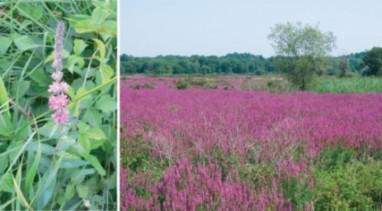
Figure 17.2: Purple loosestrife plant populations show patchiness due to uneven distribution of their wetland habitats, and clumped dispersion, due to local variation in soils. (29)
Two problems with absolute size lead ecologists to describe populations in other terms. First, because your county may not be the same size as others, the total number of individuals is less meaningful than the population density of individuals – the number of individuals per unit area or volume. Ecologists use population densities more often for comparisons over space or time, although total number is still important for threatened or endangered species.
Concern about threatened and endangered species has led conservationists to attempt to define minimal viable population size for some species. A species’ MVP is the smallest
www.ck12.org 804
number of individuals which can exist without extinction due to random catastrophic vari- ations in environmental (temperature, rainfall), reproduction (birth rates or age-sex struc- ture), or genetic diversity. In 1978, Mark Shaffer incorporated an estimate for grizzly bear MPV into the first Population Viability Analysis (PVA), a model of interaction be- tween a species and the resources on which it depends. PVAs are species-specific, and require a great deal of field data for accurate computer modeling of population dynamics. PVAs can predict the probability of extinction, focus conservation efforts, and guide plans for sustainable management.
Patterns in Populations I: in Space (or Patterns in Space)
A second problem in measuring population size relates to the distribution of individuals within the population’s boundaries. If your county has extensive wetlands in the southern half, but very few in the north, a countywide population density estimate of purple looses- trife, which grows primarily in shallow freshwater pond edges, marshes, and fens, would be misleading (Figure 17.2). Patchy habitat – scattered suitable areas within population boundaries – inevitably leads to a patchy distribution of individuals within a population. On a smaller scale, plants within even a single wetland area may be clumped or clustered (grouped), due to soil conditions or gathering for reproduction. The characteristic pattern of spacing of individuals within a population is dispersion (Figure 17.3). Clumped dispersion is most common, but species that compete intensely, such as cactus for water in a desert, show uniform, or evenly spaced, dispersion.
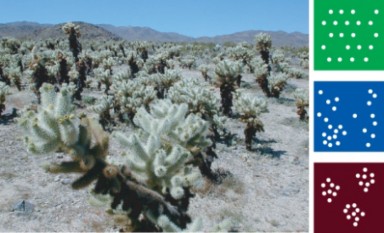
Figure 17.3: Populations of cacti in the desert, such as this group of cholla, show uniform, or even, dispersion due to fierce competition for water. The diagrams to the right show nearly uniform (top), random (middle), and clumped (bottom) dispersion patterns. (31)
Other species, whose individuals do not interact strongly, show a random, or unpredictable, distribution. Useful measures of population density must take into account both patchiness
805 www.ck12.org
of habitat and dispersion of individual organisms within the population’s boundaries.
Age-Sex Structure of a Population
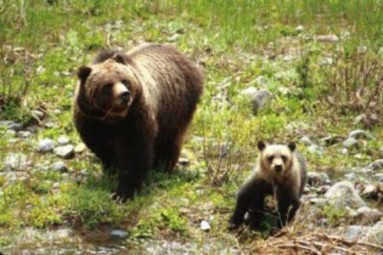
Figure 17.4: Grizzly bear populations include adults up to 25 or 30 years old, capable of reproducing, and young immature bears under 6 years old. Healthy populations include roughly equal proportions of each age group. (6)
Density and dispersion describe a population’s size, but size is not everything. Consider three populations of endangered grizzly bears, each containing one individual per 20 km2, and a total of 100 individuals in 2,000 km2. These populations are “equal” with respect to size. One population, however, has 50 immature (non-reproducing young) bears and 50 adult bears able to reproduce. A second population has the same number of immature and adult bears, but of the 50 adults, 45 are male. The third population has 30 immature bears and 70 bears of reproductive age. Which population is healthiest (Figure 17.4)?
The answer is not simple, but age and sex differences between populations are significant indicators of health. Biologists concerned about a population’s future study age and sex within the population and then graph the results to show the age-sex structure as a population pyramid, although the result does not always resemble a pyramid. The X-axis in this double bar graph indicates percentage of the population, with males to the left and females to the right. The Y-axis indicates age groups from birth to old age.
The population in the generalized example (Figure 17.5) contains a large proportion of young individuals, suggesting a relatively high birth rate (number of births per individ- ual within the population per unit time). The bars narrow at each age interval, showing that a significant number of individuals die at every age. This relatively high death rate (number of deaths per individual within the population per unit time) indicates a short life
www.ck12.org 806
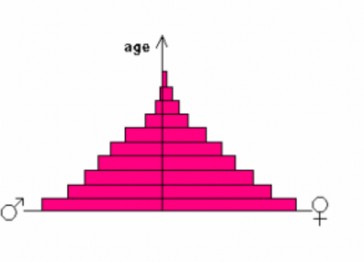
Figure 17.5: A generalized age-sex structure or population pyramid shows the proportion of males and females (X-axis) at each age level (Y-axis). This example shows a slightly higher proportion of females compared to males, and a much higher proportion of young individuals compared to old. (36)
expectancy, or average survival time for an individual. Note the slightly greater propor- tion of females compared to males at each age level. Careful study could determine whether the cause for this imbalance is the ratio of female to male births, or higher death rates for males throughout a shorter lifespan. You will learn in a later lesson that this pattern is characteristic of human populations in less developed countries.
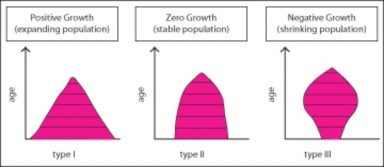
Figure 17.6: Age structures can reveal a population’s health. Type I, with most individuals below reproductive age, often indicates a growing population. Type II, with roughly equal proportions of the population at each age level, indicates a stable population. Type III, with more individuals at (or above!) reproductive age than young, describes a declining population. (38)
A population’s age structure may reveal its health (Figure 17.6). A growing population
807 www.ck12.org
(Type I) usually has more young individuals than adults at beyond reproductive age. A stable population (Type II) often has roughly equal numbers of young members and adults. A declining population shows more adults and fewer young (Type III). Sex structure may also affect the health of a population. Sex determination in sea turtles, for example, is temperature-dependent; lower egg incubation temperatures produce males, while tempera- tures as little as 1-2oC higher produce females (Figure 17.7). Some biologists predict that climate change may result in sea turtle sex structure shifts toward females, which could further endanger already threatened species. Continued monitoring of age-sex structures among sea turtles might be able to detect such changes before they become irreversible.
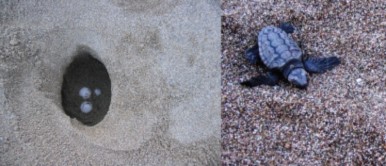
Figure 17.7: The sex of a sea turtle is determined by the temperature at which it develops – males in cooler temperatures, and females in temperatures as little as 1-2oC warmer. Climate change may threaten natural sex ratios. Such changes would be reflected in changing age-sex structure pyramids. (5)
Although it is not shown in population pyramids, an important factor affecting population size is the age at which individuals become able to reproduce (Table 17.1). Recall that age at maturity (when reproduction becomes possible) was the factor that even ancient Greeks recognized could affect population growth, when they prohibited marriage for males under the age of 30. We will return to this relationship in a later lesson, but for now, try to grasp it intuitively: if a person delays reproduction until age 30 and then has one child each year for two years, his or her fertility is 2. A person who has two children, one each year, beginning at age 20 also has a fertility of 2. Assume that these four children are born in the same two-year period, and that each offspring reproduces two children at the same age as his/her parent did. Sixty years after the initial four childbirths, the “delayed reproduction” individual will have 2 X 2 X 2 = 8 descendants. However, the early reproducing family will have 2 X 2 X 2 X 2 = 16 offspring – double the population increase of the first family. Do you think this could this be one way to slow human population growth?
www.ck12.org 808
Table 17.1: Number of Offspring Produced Over Time

Age at First Reproduc- tion
Initial Re- production
20 years later
30 years later
40 years later
60 years later

20 years Generation
1: 2 off- spring
30 years Generation
1: 2 off- spring
Generation 2: 4 off- spring
Generation 2: 4 off- spring
Generation 3: 8 off- spring
Generation 4: 16
Generation 3: 8

Patterns in Populations Through Time
The characteristics of populations introduced above – birth rate, death rate, and life ex- pectancy – interact to form several basic strategies for survival. Insurance companies began investigations into life expectancies for various groups of people – males vs. females, for example – and compiled the data in life tables. Biologists plot these patterns through time in survivorship curves, which graph the number of all individuals still living (in powers of ten, on the Y-axis) for each age (on the X-axis). The three basic types of survivorship curves are illustrated in Figure 17.8.
Species showing a Type I pattern have the highest survival rates, with most individuals living to old age. Many large animals, including humans, show this “late loss” pattern of survivorship; few offspring, high levels of parental care, and low “infant” death rates characterize Type I species. As we will see in a later lesson, human populations in rich countries fit this pattern more closely than do those in undeveloped countries.
Species with Type III survivorship patterns experience high death rates among offspring; relatively few survive to old age. Most plants and invertebrates and many fish show this “early loss” pattern. Parents invest most of the reproductive energy in high numbers of offspring to offset the high death rates, and little or no energy remains for parental care.
Species showing intermediate, Type II survivorship curves experience uniform death rates throughout their lives. Some birds and many asexual species show this “constant loss” pattern.
We’ll look at these strategies more closely in the next lesson as we study how populations grow and change: population dynamics.
809 www.ck12.org
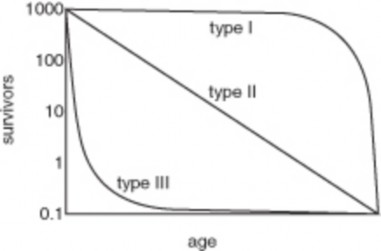
Figure 17.8: Survivorship curves correlate with strategies species use to adapt to various environments. Large organisms in relatively stable environments have few offspring but high levels of parental care; most individuals survive to old age (Type I). Smaller organisms in less stable environments produce many offspring but provide little parental care, and few survive to old age (Type III). Type II species show intermediate characteristics in response to a death rate which remains constant throughout life. (33)
Lesson Summary
Historic concern with overpopulation includes ancient Greek delay of marriage, Malthus’ predictions of a resource crisis, and Darwin’s use of exponential growth in his theory of natural selection.
A group lead by Julian Simon, cornucopians, believes that more people are better, because technology and innovation will solve population problems.
The study of the biology of natural populations can shed light on human population issues.
In biology, a population is a group of organisms of a single species living within a certain area.
Population size, the total number of individuals, is important for understanding endan- gered or threatened species, but population density is often more useful for comparing populations across time or space.
Minimum Viable Population (MVP) and Population Viability Analysis (PVA) use extensive field data to predict best management practices for a particular species in conservation biology.
Double bar graph population pyramids show proportions of males and females within age groups.
www.ck12.org 810
Population pyramids which have wide bases indicate high birth rates and probable population growth, and decreases from one age group to the next indicate death rates and (overall) life expectancy. Populations with narrow bases indicate low birth rates and shrinking populations, and those with bases roughly equal to peaks indicate stable populations and/or low death rates.
Delaying reproduction or increasing age to sexual maturity can decrease population growth rate, even if fertility levels remain the same.
Patchy habitat distribution results in patchy distribution of a population throughout its boundaries.
Dispersion of a population within its boundaries depends on intraspecies competition or cooperation.
Clumped distribution indicates social relationships or recent reproduction without dis- persal.
Uniform distribution reveals competition among individuals for a limited resource.
Random distribution suggests little interaction among individuals.
Survivorship curves show the number of individuals which survive (on a power-of-ten scale) at each age level.
Large animals, which provide few offspring with high levels of parental care, experience low death rates and long average life expectancy – a Type I pattern. This pattern is typical for humans in rich/developed countries.
Among plants and many invertebrates which have many offspring but little or no parental care, offspring have high death rates and relatively low average life expectancy
– a Type III pattern.
Some birds and many asexually reproducing species have constant death rates through- out life and intermediate average life expectancy – a Type II pattern.
Review Questions
Compare the cornucopian perspective on human population growth to the Malthus’ (sometimes called the Neo-Malthusian) view.
(If false, restate to make true.) Human concern about overpopulation is a recent phenomenon.
Define a biological population.
Define and compare the importance of population size vs. population density.
Explain how conservation biologists use Minimum Viable Population (MVP) and Pop- ulation Viability Analysis (PVA).
How does patchy distribution differ from dispersion?
811 www.ck12.org
What types of information do population pyramids show? What kinds of inferences can you make using variations in population pyramid shape?
How does delaying reproduction affect population size, even if fertility remains con- stant?
Describe the three types of survivorship curves and the reproductive strategies they illustrate.
Apply what you have learned so far about population biology to your current under- standing of human populations. Note: we will explore human populations in detail in a future lesson, so accept that your current understanding may be incomplete!
Further Reading / Supplemental Links
http://www.estrellamountain.edu/faculty/farabee/biobk/BioBookpopecol.html
http://www.geography.learnontheinternet.co.uk/topics/popn1.html
http://www.census.gov/ipc/www/idb/faq.html
http://www.biologicaldiversity.org/swcbd/species/orca/pva.pdf
http://nationalzoo.si.edu/ConservationAndScience/EndangeredSpecies/PopViability/ default.cfm
Vocabulary
age at maturity The age at which individuals (sometimes considered only for females) become able to reproduce.
age-sex structure A graphical depiction of proportions of males and females across all age groups within a population; also depicted as a population pyramid.
birth rate (b) The number of births within a population or subgroup per unit time; in human demography, the number of childbirths per 1000 people per year.
cornucopian A person who believes that people and markets will find solutions to any problems presented by overpopulation.
death rate (d) The number of deaths within a population or subgroup per unit time; in human demography, the number of deaths per 1000 people per year.
dispersion The pattern of spacing among individuals within a population – clumped (clus- tered or grouped), uniform (evenly spaced), or random (no discernible pattern).
life expectancy Average survival time for individuals within a population. www.ck12.org 812
minimum viable population The smallest number of individuals which can exist with- out extinction due to chance variations in reproduction, genetics, or environment.
overpopulation A condition in which the number of individuals in a population exceeds the carrying capacity of their environment.
population A group of organisms of a single species living within a certain area.
population density The number of organisms per unit area or volume.
population viability analysis A model of interaction between a species and the resources on which it depends used in conservation biology.
survivorship curve Graph which shows the number of all individuals still living (in pow- ers of 10, on the Y-axis) at each age (on the X-axis).
Points to Consider
Do you think Earth’s human population has a patchy distribution? Why or why not?
Do people show clumped, uniform, or random dispersion? Why?
How do you think birth rates compare with death rates in the human population? Predict the shape of a population pyramid for humans.
At this point in your study of population biology, do you consider yourself a Malthusian, following the ideas of Thomas Malthus, or a cornucopian?
Lesson 17.2: Population Dynamics
Lesson Objectives
Define population dynamics.
Describe exponential (J-curve) growth, and explain the conditions under which it oc- curs.
Explain Malthus’ ideas about human population growth and their significance to evo- lutionary theory.
Births and deaths: Balancing costs of reproduction and survival.
Clarify the relationship between population growth rate, birth rate, and death rate.
Compare trade-offs between survival and reproduction for altricial species to those of
precocial and nest parasite species.
Describe the relationship between age at maturity and growth rate.
813 www.ck12.org
Analyze the equation for population growth rate.
Describe several means of dispersal, and its importance to population density.
Define migration and explain possible effects on population density and growth.
Compare nomadism, irruption, range expansion, and colonization in terms of their effects on population density.
Give examples of population growth patterns in nature.
Describe logistic (S-curve) growth, and explain the conditions under which it occurs.
Analyze the concept of carrying capacity in terms of population growth and resource availability.
Compare and contrast density-dependent and density-independent limiting factors.
Relate predator-prey cycles to density-dependent population control.
Compare and contrast the adaptations and environmental characteristic of r-selected species to those of K-selected species.
Introduction
Imagine a huge bowl of your favorite potato salad, ready for a picnic on a beautiful, hot, midsummer day. The cook was careful to prepare it under strictly sanitary conditions, using fresh eggs, clean organic vegetables, and new jars of mayonnaise and mustard. Familiar with food poisoning warnings, s/he was so thorough that only a single bacterium made it into that vast amount of food. While such a scenario is highly unrealistic without authentic canning, it will serve as an example as we begin our investigation of how populations change, or population dynamics. Because potato salad provides an ideal environment for bacterial growth, just as your mother may have warned, we can use this single bacterial cell in the potato salad to ask:
How Do Populations Grow Under Ideal Conditions?
Given food, warm temperatures, moisture, and oxygen, a single aerobic bacterial cell can grow and divide by binary fission to become two cells in about 20 minutes. The two new cells, still under those ideal conditions, can each repeat this performance, so that after 20 more minutes, four cells constitute the population. Given this modest doubling, how many bacteria do you predict will be happily feeding on potato salad after five hours at the picnic? After you’ve thought about this, compare your prediction with the “data” in Table ??.
Table 17.2: Like many populations under ideal conditions, bacteria show exponential or geometric growth. Each bacterium can undergo binary fission every 20 minutes. After 5 hours, a single bacterium can produce a population of 32,768 descendants.
www.ck12.org 814
Table 17.2:
Time (Hours and Minutes) | Population Size (Number of Bacteria) |
0 | 1 |
20 minutes | 2 |
40 minutes | 4 |
1 hour | 8 |
1 hour 20 minutes | 16 |
1 hour 40 minutes | 32 |
2 hours | 64 |
2 hours 20 minutes | 128 |
2 hours 40 minutes | 256 |
3 hours | 512 |
3 hours 20 minutes | 1024 |
3 hours 40 minutes | 2048 |
4 hours | 4096 |
4 hours 20 minutes | 8192 |
4 hours 40 minutes | 16,384 |
5 hours | 32,768 |
(Source: CK-12 Foundation, License: CC-BY-SA)
Are you surprised? This phenomenal capacity for growth of living populations was first described by Thomas Robert Malthus in his 1798 Essay on the Principle of Population. Al- though Malthus focused on human populations, biologists have found that many populations are capable of this explosive reproduction, if provided with ideal conditions. This pattern of growth is exponential, or geometric growth: as the population grows larger, the rate of growth increases. If you have worked compound interest problems in math or played with numbers for estimating the interest in your savings account, you can compare the growth of a population under ideal conditions to the growth of a savings account under a constant rate of compound interest. The graph in Figure 17.9, using potato salad bacterial “data,” shows the pattern of exponential growth: the population grows very slowly at first, but more and more rapidly as time passes.
Of course, if bacterial populations always grew exponentially, they would long ago have covered the Earth many times over. While Thomas Malthus emphasized the importance of exponential growth on population, he also stated that ideal conditions do not often exist in nature. A basic limit for all life is energy. Growth, survival, and reproduction require energy. Because energy supplies are limited, organisms must “spend” them wisely. We will end this lesson with a much more realistic model of population growth and the implications of its limits, but first, let’s look more carefully at the characteristics of populations which allow them to grow.
815 www.ck12.org

Figure 17.9: Exponential or geometric growth is very slow at first, but accelerates as the population grows. Because rate of growth depends on population size, growth rate increases as population increases. Most populations have the ability to grow exponentially, but such growth usually occurs only under ideal conditions that are not found in nature. Note the “J” shape of the curve. (26)
www.ck12.org 816
Births and Deaths: Balancing Costs of Reproduction and Survival
The growth rate of a population is the change in population size per member of the population per unit of time. The symbol r denotes growth rate. Growth rate clearly depends on birth rate b, the number of births per individual within the population per unit of time, as well a death rate d, the number of deaths per individual per unit of time. The following equation calculates growth rate, according to our preliminary understanding:
r = b – d
growth rate = birth rate – death rate
If birth rate exceeds death rate, r is positive and the population grows. If death rate exceeds birth rate, r is negative and the population declines. And if birth rate and death rate are in equilibrium, growth rate is zero, and the population remains stable. In a stable population, each individual, on the average, produces one offspring which survives long enough to reproduce itself. Mere survival is not success in the game of life; natural selection requires that survivors reproduce. As Malthus realized, nearly all species have the potential to grow – to reproduce many more than just a single replacement offspring. However, species vary in the strategies they use to achieve reproductive success, making trade-offs between the energy and time “costs” of survival and those of reproduction. Age at first reproduction, frequency of reproduction, number of offspring, parental care, reproductive lifespan, and offspring death rate are some of the traits which build strategies for successful reproduction.
Analyzing extreme examples can help you understand the trade-offs species must make between survival and reproductive success. Let’s compare two groups of birds. Somewhat like precocious children who mature early, precocial birds run around to find their own food soon after hatching. Geese, ducks, and chickens use this strategy for raising their young (Figure 17.10). Often living and nesting on the ground, precocial species are subject to high predation rates, so few survive long enough to reproduce. Therefore, those who do reproduce lay many eggs at once, and these eggs are large. The young emerge well-developed, ready to feed and escape predators soon after hatching. Precocial species invest a great deal of energy in a large number of offspring but do not spend much energy on parental care, because even though some offspring are likely to die, others will survive long enough to reproduce.
Contrast this precocial strategy with the opposite, altricial strategy used by robins and hummingbirds (Figure 17.11). These birds hatch helpless and naked, completely unprepared for independent life. Parents invest little energy in just a few, small eggs; hummingbirds’ eggs are the smallest in the bird world, and average two per nest. However, survival of these offspring matters a great deal, because there are so few. So, parents build elaborate nests safely hidden in trees and invest a great deal of energy hunting for food around-the-clock until the young have developed enough to fledge and find food on their own.
Precocial and altricial birds play by the rules of costs and benefits, each group using a
817 www.ck12.org

Figure 17.10: Geese and ducks use a precocial strategy to ensure reproductive success. They invest a great deal of energy in a large number of large eggs, so that young are born well- developed and ready to fend for themselves almost immediately after hatching. Predation on goslings and ducklings is high, but this death rate is offset by a high birthrate. Overall, the population remains stable. (8)

Figure 17.11: Hummingbirds illustrate an altricial reproductive strategy. Very little energy is spent to produce two tiny eggs, but they are enclosed in a secluded nest, usually hidden in a tree. Survival of the offspring is critical because there are only two, so parents invest tremendous amounts of energy finding food for themselves and their young for nearly three weeks. This energy investment allows the offspring to develop to nearly adult size before they fledge into the world of predators and competition. (15)
www.ck12.org 818
different strategy. Cowbirds, however, make up their own rules, earning them the title of “parasites” in the bird world. How can a bird be a parasite? Cowbirds are altricial, but they parasitize by laying their eggs in other birds’ nests, thereby escaping the high costs of parental care (Figure 17.12). Cowbird eggs are usually slightly larger and hatch a little sooner than the host eggs affording cowbird parents a bit of extra energy. “Early bird” hatchlings do indeed “get the worm,” easily out-competing their smaller host siblings for parental food deliveries. Sometimes, they are strong enough to ungratefully oust their “sibs” from the nest. On the other hand, host parents occasionally recognize and eject the foreign egg before it hatches. Yellow warblers simply block off the offending egg (along with their own eggs) by building a new nest bottom. They then lay a new clutch of their own eggs (The eggs are not their primary energy investment). A five-“story” nest holds the record for yellow warbler (and cowbird?) determination!
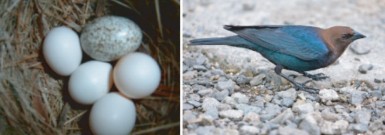
Figure 17.12: A brown-headed cowbird egg in a phoebe’s nest illustrates yet another strategy for reproductive success: invest all of your energy in a single egg, just large enough to out- compete your altricial host’s eggs, and let the host parents feed your offspring! The right photo shows a male individual of this parasitic species. (23)
Many species fall in between the extremes of precocial and altricial strategies, but all must make trade-offs between the costs of reproduction and those of surviving predation, competi- tion, and disease, in order to ensure that at least one offspring per adult survives long enough to reproduce. It’s worth reprising the survivorship curves introduced in the previous lesson to illustrate these trade-offs (Figure 17.13). Which curve illustrates the precocial strategy used by ducks, chickens, and grouse? Which curve demonstrates the altricial strategy of robins and hummingbirds? What shape do you think a cowbird’s survivorship curve might take?
One more strategy, introduced in the last lesson, involves variation of age at maturity. All other factors being equal (number and size of offspring, survival rates, and more), delayed reproduction lowers population growth rate. Bald eagles require five years of growth before they are able to reproduce. If they were to lay the same number of eggs during their first year, those first-year offspring and several generations of their offspring, as well as the parents, would be able to reproduce during that time, tremendously increasing the overall population. By delaying reproduction, bald eagles not only ensure good energy supplies for reproduction at maturity, but also limit population density to suit their large bodied, long-lived life history.
819 www.ck12.org

Figure 17.13: Survivorship curves show the various strategies for achieving population growth by adjustments in birth rate and death rate. Recall that r = b – d. Hummingbirds have low birth rates (b), but through time and energy spent on parental care and feeding, ensure high survival rates for their altricial offspring (low d). Geese, however, invest energy in many large eggs (high b) to offset high death rates from predation (d) among their precocial offspring. (4)
Migration and Other Movements Affect Population Densi- ties
Populations change not only through births and deaths, but also via immigration, move- ment of individuals into a population from other areas, and emigration, movement of individuals out of a population. If we add per capita rates of immigration and emigration into our equation for population growth rate, it becomes:
r = (b + i) – (d + e)
growth rate = (birth rate + immigration rate) – (death rate + emigration rate)
Many kinds of movement adaptations regularly add to or subtract from population density.
Most species have some means of dispersal – movement of offspring away from the parents. This “behavior” reduces competition within the population, promotes colo- nization of suitable habitat, and improves reproductive success. Some dispersal mech- anisms take advantage of natural energy in the environment. For example, dandelion seeds grow “parachutes” which allow wind to carry them far from their parents – and sometimes entirely out of a population (Figure 17.14). For the same reason, immobile animals such as corals often produce motile larva. Mobile animals often evolve behav- iors which ensure dispersal. A lone gray wolf which leaves its birth pack must find a mate and an unoccupied territory in order to reproduce; within the pack, usually
www.ck12.org 820
only the alpha male and female have offspring. Dispersal behaviors are common in the living world; have you - as a teenage high school student, begun to feel stirrings of the wish to leave home?

Figure 17.14: Wind carries dandelion seeds away from their parent plants. The parachute adaptation allows for dispersal, reducing competition within the population and promoting colonization of suitable habitat. (14)
Migration, the direct, often seasonal movement of a species, is a predictable change for some animal populations. Many northern hemisphere birds, such as Swainson’s Hawks (Figure 17.15), migrate thousands of miles southward in the fall and return north to nest in the spring in order to follow summer’s long days which provide extra hunting time and a greater abundance of food.
Apparently, energy benefits outweigh costs for this annual long-distance commute. Elk migrate vertically – up the mountains in spring as snow recedes and down the mountains in fall as winter advances. Monarch butterflies migrate in “shifts”; somewhat like a relay team, successive generations divide the task of moving from Mexican wintering grounds to northern summer habitats. Such migrations do not add to or subtract from populations as much as they move entire populations from one set of boundaries and environmental conditions to another. Some species, such as Peregrine Falcons, have both migratory and non-migratory forms, so their populations may grow or decline with migration. Gray Whales migrate 12,500 miles from Alaska to Mexico for calving, but at least one population limits its northward journey to the Oregon coast (Figure 17.16). Seasonal densities of migratory species vary
821 www.ck12.org

822
Figure 17.15: Entire populations of Swainson’s Hawks migrate annually from North America wtowSwo.uctkh12A.omrgerica and back. Migration can affect all four factors of the growth rate equation: rates of birth, death, immigration, and emigration. (3)

Figure 17.16: Gray Whales migrate up to 12,500 miles – further than any other mammal. At least one population stops its northward journey in Oregon; this behavior probably results in immigration and/or emigration, changing intraspecific interactions as populations merge and separate. (27)
considerably, but resources and environmental benefits vary as well. Migration can affect all four factors of the growth rate equation.
Other types of movement are less predictable, but still may affect population growth.
Nomadism, regular, wide-ranging wandering behavior, allows some species to com- pensate for fluctuating food sources. Normally arctic species, Snowy Owls occasionally venture as far south as Texas, southern Russia, and northern China (Figure 17.17). Bohemian waxwings are notoriously nomadic, feeding on highly variable berry supplies.
Irruptions or invasions are irregular movements, often caused by food source failures. Owls such as Great Grays and Boreals occasionally invade northern US states from their Canadian homes when rodent populations decline. Some may remain to nest following such an irruption.
Range expansion involves the gradual extension of a population beyond its original boundaries. Recent examples in the US include Cardinals, now common in northern areas where they were originally absent. The Swainson’s Thrush follows an indirect and unnecessarily long migration path - retracing, scientists believe, a range expansion from 10,000 years ago. Intentional introductions of non-native species such as the House Sparrow and reintroductions of extirpated species such as Peregrine Falcons throughout the Eastern US are human-initiated colonizations, which are often followed by range expansions.
Closely related to range expansion is colonization, but the latter often involves newly created, or at least newly found, habitats. Illustrating both range expansion and
823 www.ck12.org

Figure 17.17: Normally arctic species, Snowy Owls occasionally wander as far south as Texas, southern Russia, and northern China. This nomadic behavior allows them to feed on prey which have unpredictable fluctuations in population density. (21)
colonization, the small red-eyed dragonfly spread throughout Europe in the late 20th century and colonized Britain in 1999 (Figure 17.18).
How Do Populations Grow in Nature?
You learned above that populations can grow exponentially if conditions are ideal. While exponential growth occurs when populations move into new or unfilled environments or rebound after catastrophes, most organisms do not live in ideal conditions very long, if at all. Let’s look at some data for populations growing under more realistic conditions.
Biologist Georgyi Gause studied the population growth of two species of Paramecium in laboratory cultures. Both species grew exponentially at first, as Malthus predicted. However, as each population increased, rates of growth slowed and eventually leveled off. Each species reached a different maximum, due to differences in size of individuals and space and nutrient needs, but both showed the same, S-shaped growth pattern. Figures 17.19, 17.20, and 17.21 show this growth pattern graphically as an S-shaped curve.
Perhaps even more realistic is the growth of a sheep population, observed after the introduc- tion of fourteen sheep to the island of Tasmania in 1800. Like the lab Paramecia, the sheep population at first grew exponentially. However, over the next 20 years, the population sharply declined by 1/3. Finally, the number of sheep increased slowly to a plateau. The general shape of the growth curve matched the S-shape of Paramecium growth, except that the sheep “overshot” their plateau at first.
www.ck12.org 824
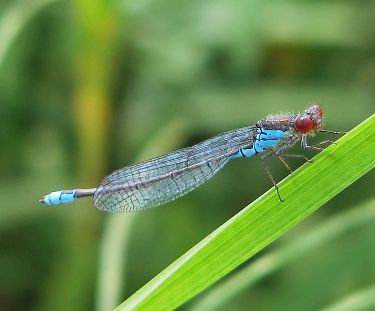
Figure 17.18: Small red-eyed dragonflies expanded their range throughout northwest Europe in the late 20th century and colonized Britain in 1999. (35)
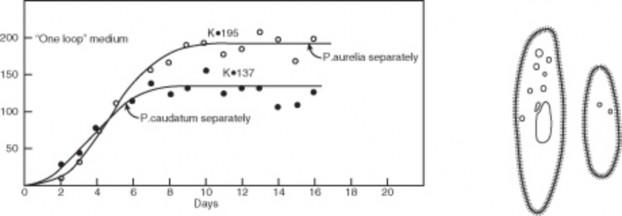
Figure 17.19: Two species of Paramecium illustrate logistic growth, with different plateaus due to differences in size and space and nutrient requirements. The growth pattern resembles and is often called an S-curve. Slow but exponential growth at low densities is followed by faster growth and then leveling. (17)
825 www.ck12.org
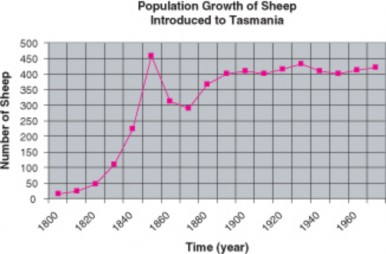
Figure 17.20: Sheep introduced to Tasmania show logistic growth, except that they overshoot their carrying capacity before stabilizing. (16)
As Malthus realized, no population can maintain exponential growth indefinitely. Inevitably, limiting factors such as reduced food supply or space lower birth rates, increase death rates, or lead to emigration, and lower the population growth rate. After reading Malthus’ work in 1938, Pierre Verhulst derived a mathematical model of population growth which closely matches the S-curves observed under realistic conditions. In this logistic (S-curve) model, growth rate is proportional to the size of the population but also to the amount of available resources. At higher population densities, limited resources lead to competition and lower growth rates. Eventually, the growth rate declines to zero and the population becomes stable.
The logistic model describes population growth for many populations in nature. Some, like the sheep in Tasmania, “overshoot” the plateau before stabilizing, and some fluctuate wildly above and below a plateau average. A few may crash and disappear. However, the plateau itself has become a foundational concept in population biology known as carrying capacity (K). Carrying capacity is the maximum population size that a particular environment can support without habitat degradation. Limiting factors determine carrying capacity, and often these interact. In the next section, we will explore in more detail the kinds of factors which restrict populations to specific carrying capacities and some adaptations that limit growth.
Limits to Population Growth
A limiting factor is a property of a population’s environment – living or nonliving – which controls the process of population growth. Biologists have identified two major types of limiting factors: Density-dependent factors and Density-independent factors.
www.ck12.org 826

Figure 17.21: Growth of populations according to Malthus’ exponential model (A) and Verhulst’s logistic model (B). Both models assume that population growth is proportional to population size, but the logistic model also assumes that growth depends on available resources. A models growth under ideal conditions and shows that all populations have a capacity to grow infinitely large. B limits exponential growth to low densities; at higher densities, competition for resources or other limiting factors inevitably cause growth rate to slow to zero. At that point, the population reaches a stable plateau, the carrying capacity (K). (13)
827 www.ck12.org
Density-dependent factors promote intraspecific competition – competition be- tween members of the same population for the same resource – as the population grows and becomes more crowded. Density-dependent limiting factors have the potential to control population size. Consider food supply as an example. When population den- sity is low, amount of food per individual is high, and birth rates are high. As density increases, food supply per individual decline and birth rates drop, causing growth rate to decline. Eventually, food shortages may lead to increased death rates and a neg- ative growth rate, lowering population size. Lower population size means more food per individual, and the population begins to grow again, reaching or temporarily over- shooting the carrying capacity. Food supply in this instance is a regulatory limiting factor, because it keeps the population at equilibrium. Density-dependent limiting factors may include:
Light
Water, nutrients/minerals, or oxygen
Waste, or the ability of an ecosystem to recycle nutrients and/or waste
Predation by predators which feed preferentially on more abundant prey
Disease and/or parasites
Space, with or without territorial behaviors, or nesting sites
Temperature
Aggressive behaviors, often combined with stress and effects on immune systems
Let’s look at two examples in detail, to emphasize the importance of density-dependent reg- ulation of growth. First, waste products build up with increasing population density. Most environments have some capacity for recycling of wastes, but sometimes rapid population growth means that natural environmental systems can’t keep up. An interesting - if not completely natural - example is the growth of yeast populations through fermentation in the making of wine. Alcohol is a waste product for the yeast, even though it is the point of the process as far as we’re concerned. As the yeast population grows, alcohol builds up; but alcohol is toxic – to yeast as well as to humans – and after the concentration reaches 13%, increased death rates doom the yeast population. Therefore, no naturally fermented wine contains more than 13% alcohol.
A second density-dependent limiting factor is predation. Predators kill and eat their prey, of course, so predation increases prey death rate and can cause negative growth rates – population decline. If predators have multiple types of prey, and switch their feeding to specific prey only when they are abundant, predators may regulate prey population size. However, especially in northern climates, predators often specialize on a single prey species. Goshawks, for example, feed primarily on ruffed grouse, and Canada Lynx depend on snowshoe hares (Figure 17.22). If predation causes a significant decline in the prey population, starving predators may experience their own (delayed) decrease in population as a result of lower birth rates or increased death rates. The result is a predator-prey cycle; both populations rise and fall, with predator populations trailing prey (Figure 17.23).
www.ck12.org 828
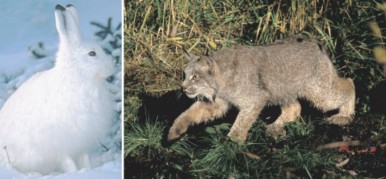
Figure 17.22: Populations of snowshoe hare (left) and their Canada Lynx predator (right) show repeating cycles, with predator population changes trailing those of their prey. (11)

Figure 17.23: Repeating cycles of growth and decline characterize population dynamic in- teractions between some pairs of predator and prey species. (32)
Goshawks play the game with a little twist; when ruffed grouse populations in their Canadian conifer forest homes decline, they migrate southward. Grouse populations show ten-year cycles; note that the goshawk counts from Hawk Ridge in Duluth, Minnesota show ten-year “invasions” which correspond to prey population lows in Canada (Figure 17.24).
All of these factors have the potential to lower birth rates or increase death/emigration rates via increased intraspecific competition at higher population densities. Many natural populations are kept at or below carrying capacity by one or a complex interaction among several of the above limiting factors.
829 www.ck12.org
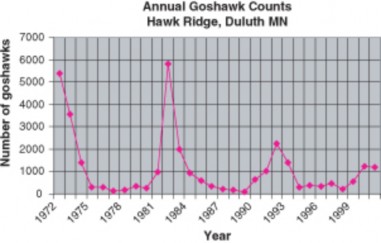
Figure 17.24: The pattern of migration of goshawks observed at Hawk Ridge in Duluth, Minnesota, shows irruptions which correspond to low points in cycles of their Canadian prey populations (ruffed grouse). Such cycles are the result of density-dependent interactions between predator and prey. Predators cause increased death rates in prey populations, especially at high prey densities. When prey populations crash as a result of predation, predators are stressed and some (such as lynx) decline. Others, such as the goshawk, irrupt southward in search of higher-density populations. (19)
Density-independent factors can also limit populations, but they seldom regulate populations because they act irregularly, regardless of the population’s density. Popu- lations limited by density-independent factors seldom reach carrying capacity. Weather is a good example. Agaves (Century Plants) reproduce once at the end of a long lifes- pan (Figure 17.25). The average lifespan is about 25 years rather than a full century, but an individual’s lifespan depends at least in part on erratic rainfall. Agaves will reproduce only after rainfall allows sufficient growth – however long that takes. Even- tually, a wet season will bring about a single episode of flowering and the production of a huge number of seeds. Their growth and eventual reproduction will, in turn, depend on erratic rainfall. The density-independent factor rainfall limits birth rate, which in turn limits growth rate, but because of its unpredictability, it cannot regulate Agave populations.
Other density-independent limiting factors include human activities:
Pesticides and herbicides: For example, DDT thinned the eggshells of Peregrine Fal- cons, reducing their birthrates and leading to their extirpation from the eastern half of North America.
Habitat destruction: Conversion of prairies and grasslands worldwide drastically re- duced populations of Burrowing Owls in North America and Giant Pandas in China.
www.ck12.org 830
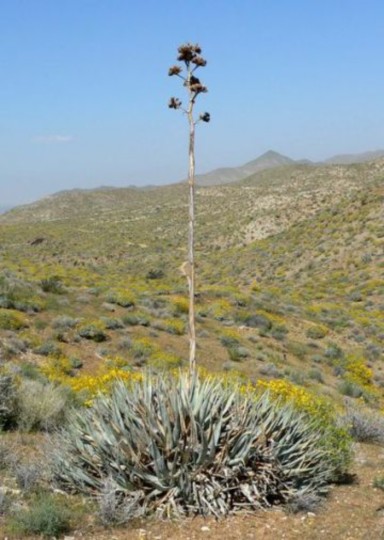
Figure 17.25: Each Century Plant reproduces only once during its long lifespan. This strat- egy allows it to gather sufficient water over a number of years in an environment where rainfall is scarce and unpredictable. Then, during an especially wet season, the plant pro- duces a huge number of seeds and dies. Does the Century Plant’s pattern remind you of the salmon’s life cycle? (10)
831 www.ck12.org
To conclude our discussion of population dynamics, let’s look at two sets of adaptations related to the logistic growth curve which describe the growth of most populations. These should remind you of the survival patterns we discussed earlier in this lesson. Recall that for logistic growth, r is the growth rate of the population, and K is the carrying capacity.
Scientists have found that species adapted to unstable or unpredictable environments are usually limited by density-independent factors to population densities considerably lower than carrying capacity. Such environments favor adaptations which maximize growth rates: early maturity, small size, high numbers of small offspring, single episodes of reproduction, short life expectancy, and the ability to disperse widely. Because pop- ulations are usually far below carrying capacity, crowding is minimal, so these species invest little energy in competitive adaptations. Survivorship curves (Figure 17.13) are Type III, with high early death rates. Such species are said to be r-selected – that is, selected for rapid growth. Weed species are often r-selected for colonization and rapid population of disturbed or newly created habitats such as roadsides, abandoned fields, mudslides, or lava flows. Jack pine trees are r-selected species which “pioneer” clear areas immediately after forest fires. They grow quickly in hot, dry soils and release seeds from cones which are opened only by fire – reproducing and dispersing seeds at just the right, if unpredictable, time (Figure 17.26).
Whereas density-independent factors limit r-selected species in unpredictable envi- ronments, K-selected species are adapted to stable environments and regulated by density-dependent factors. Stable environments support K-selected populations at or near carrying capacity, at which point crowding leads to significant intraspecific com- petition. Such environments favor adaptations for efficient resource utilization which confer competitive ability. K-selected individuals often grow slowly to large size, live long, and delay but repeat reproduction of fewer offspring. They may provide exten- sive parental care because they can count on environmental stability and survival of these relatively few offspring. Survivorship curves resemble the Type I pattern: long life expectancy and relatively low death rates in the stable environment. Maple trees are K-selected “climax” species which grow slowly in their own shade and reproduce relatively large seeds over a number of years throughout their relatively long lifespan (Figure 17.27).
Characteristics of r-selected and K-selected species are compared in Table 17.3.
Table 17.3:

r- Selected Species K-Selected Species

Environment Unstable Stable
Type of Regulating Fac- tors
Density-independent Density-dependent
www.ck12.org 832
Table 17.3: (continued)

r- Selected Species K-Selected Species

Organism Size Small Large
Maturity Early Late
Number of Offspring Many Few
Energy used to make each Individual
Low High
Average Life Expectancy Short Long
Number of Reproductive Events per Individual
Once Many times
Survivorship Type III: only a few individ-
uals live long lives
Type I or II: most individu- als live long lives

In conclusion, all populations eventually reach limits, at or below carrying capacities for the ecosystems in which they live. Some have adaptations for rapid growth, but the unpredictable environments in which they live inflict high death rates. Others live in stable environments where death rates are relatively low, but their populations are high, so individuals must spend energy on costly competitive strategies in order to gather scarce sunlight, nutrients, or water - or fight disease or predation. Many species live between these extremes, but all populations have limits.
Lesson Summary
The ways in which populations change are called population dynamics.
Populations have the potential to grow exponentially, at least under ideal conditions.
Exponential growth begins with slow growth, but as population increases, growth rate increases.
J-curves depict the pattern of exponential population growth.
Malthus first described exponential growth for the human population and predicted that humans would outgrow their food resources, leading to widespread famine or war.
If birth rate (plus immigration) exceeds death rate (plus emigration), a population grows. If death rate exceeds birth rate, the population declines. And if birth rate and death rate are in equilibrium, growth rate is zero and the population remains stable.
In a stable population, each individual (on the average) produces one offspring which survives long enough to reproduce itself.
Altricial species have a few undeveloped offspring but invest a great deal of energy in parental care. Precocial species invest energy in a large number of well-developed offspring, but little in parental care.
833 www.ck12.org
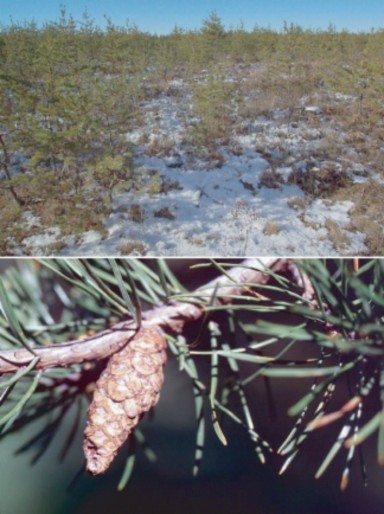
Figure 17.26: Jack pines show r-selected adaptations to an unpredictable (density- independent) limiting factor: fire. Cones (bottom image) open to release many tiny seeds only at high temperatures. The trees (top image) grow quickly in the open, bare areas left by forest fires, so are often called “pioneer” species. (37)
www.ck12.org 834
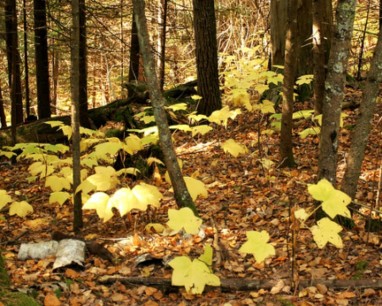
Figure 17.27: Maple trees show K-selected adaptations to a predictable shade environment they help to create. Maples release relatively large seeds annually, and offspring grow slowly but steadily in the shaded, rich soil of their parents. Maples experience significant intraspe- cific competition, and their populations tend to be limited by density-dependent factors. Because maple forests tend to persist for long periods because they can grow in their own shade, they are often called “climax” species. (1)
835 www.ck12.org
The earlier species begin to reproduce, the faster their population grows, with all other factors being equal.
Dispersal moves offspring away from parents, reducing intraspecific competition.
Migration, seasonal movement of populations, can affect all four components of popu- lation growth rate.
Regular wandering behavior (nomadism) adapts specific populations to fluctuating food supplies.
Irruption, range expansion, and colonization have irregular, unpredictable effects on population growth.
Few populations in nature grow exponentially. No population can continue such growth indefinitely.
The logistic (S-curve) model best describes the growth of many populations in nature.
In the logistic model, growth rate depends on both population size and availability of resources. Growth is slow at first, but as size increases, growth accelerates. At higher densities, limited resources cause growth rate to decline, and populations stabilize at carrying capacity.
A limiting factor is a property of a population’s environment which restricts population growth.
Density-dependent limiting factors lower birth rates or increase death/emigration rates via increased intraspecific competition at higher population densities.
Many natural populations are kept at or below carrying capacity by one or a complex interaction among several density-dependent limiting factors, such as competition, pre- dation, or disease.
Density-independent factors, such as rainfall, drought, or pollution, can also limit pop- ulations, but they seldom regulate populations because they act irregularly, regardless of the population’s density.
Cycles of growth and decline limit some predator and prey populations.
Density-independent factors limit r-selected species in unpredictable environments, while K-selected species are adapted to stable environments and regulated by density- dependent factors.
Review Questions
Explain Malthus’ ideas about population growth and their significance to evolutionary theory.
Compare exponential(J-curve)growth to logistic(S-curve)growth, and explain the con- ditions under which each occurs in nature.
Summarize the equation for population growth rate, and explain each factor. www.ck12.org 836
Compare survival and reproduction in altricial species to the same factors for precocial
species.
How might delaying age of childbirth prevent the need to limit family size, as China has done?
Give examples of dispersal and migration, and how they affect populations.
Define carrying capacity and explain its importance to population growth.
Compare and contrast density-dependent and density-independent limiting factors.
Relate predator-prey cycles to density-dependent population control.
Compare and contrast the adaptations and environmental characteristics typical of r-selected species to those of K-selected species.
Further Reading / Supplemental Links
http://www.estrellamountain.edu/faculty/farabee/biobk/BioBookpopecol.html
http://www.geography.learnontheinternet.co.uk/topics/popn1.html
http://curriculum.calstatela.edu/courses/builders/lessons/less/biomes/breeding. html
http://www.bestfootforward.com/
http://www.footprintnetwork.org/gfn_sub.php?content=footprint_overview
http://www.panda.org/news_facts/publications/living_planet_report/index. cfm
http://www.worldchanging.com/archives/006904.html
http://lca.jrc.ec.europa.eu/lcainfohub/introduction.vm
http://www.ilea.org/leaf/richard2002.html
Vocabulary
altricial Refers to a pattern of growth and development in organisms which are incapable of moving around on their own soon after hatching or being born.
birth rate (b) Number of births within a population or subgroup per unit time; in human demography, the number of childbirths per 1000 people per year.
carrying capacity (k) The maximum population size that a particular environment can support without habitat degradation.
colonization Movement of a population into a newly created or newly found area.
death rate (d) Number of deaths within a population or subgroup per unit time; in human demography, the number of deaths per 1000 people per year.
837 www.ck12.org
density-dependent factor Factor which has the potential to control population size be- cause its effects are proportional to population density.
density-independent factor Factor which may affect population size or density but can- not control it.
dispersal Movement of offspring away from parents, resulting in reduced competition within the population and more effective colonization of suitable habitat.
emigration (e) Movement of individuals out of a population’s range.
exponential model (geometric or J-curve) A model of population growth which as- sumes that growth rate increases as population size increases.
immigration (i) Movement of individuals into a population’s range from other areas.
intraspecific competition Competition between members of the same population for the same resource.
irruption (invasion) Irregular movements, often caused by food source failures.
K-selected species A species which has adaptations which maximize efficient utilization of resources, conferring competitive strength near or at carrying capacity.
limiting factor A property of a population’s environment – living or nonliving – which controls the process of population growth.
logistic (S-curve) A model of population growth which assumes that the rate of growth is proportional to both population size and availability of resources.
migration The direct, often seasonal movement of a species or population.
nomadism Regular, wide-ranging wandering behavior, which allows some species to com- pensate for fluctuating food supplies.
population A group of organisms of a single species living within a certain area.
population dynamics Changes in population size and structure. www.ck12.org 838
population growth rate (r) The change in population size per member of the population per unit time.
precocial Refers to species in which the young are relatively mature and mobile from the moment of birth or hatching.
predator-prey cycle Regular, repeating increases and decreases in a prey population fol- lowed by corresponding changes in its predator’s population.
elected species Species which has adaptations which maximize growth rate, r.
range expansion The gradual extension of a population beyond its original boundaries.
Points to Consider
Why do you think Malthus’ predictions of widespread famine and war have not (yet?) been realized? Do you think his ideas make sense for the future?
Are humans altricial or precocial? Why?
In your opinion, could delaying age of first childbirth help solve human population problems?
How important do you think dispersal, range expansion, or immigration are for human populations?
Do you think humans have more r-selected adaptations, or K-selected adaptations?
Do you think Earth has a carrying capacity for humans? If so, what kinds of limiting factors determine that carrying capacity?
Lesson 17.3: Human Population Growth: Dooms- day, Cornucopia, or Somewhere in Between?
Lesson Objectives
Contrast the Neo-Malthusian or “limits to growth” and cornucopian or “technological fix” views of human population growth.
Compare the overall pattern of human population growth to the J-curve (exponential) and S-curve (logistic) models.
Analyze the factors which have influenced human population growth from our begin- nings 200,000 years ago to 1804, when we first reached the one billion mark.
Describe the four stages of human population growth as outlined by the demographic transition model.
839 www.ck12.org
Evaluate the demographic transition model as it applies to European population growth in the late 18th and 19th centuries.
Evaluate the demographic transition model as it applies to less developed countries.
Apply the demographic transition model to recent changes in developed countries.
Using age-sex structures, contrast population growth in developed countries to growth in undeveloped countries.
Explain the concept of replacement fertility rate.
Discuss the implications of Stage 5 population dynamics.
Know and understand predictions for future worldwide human population growth.
Analyze limiting factors and technological advances which may contribute to a carrying capacity of Earth for the human population.
Explore the concept of sustainability as a goal for economic, social, and environmental decision-making.
Explain the tool of ecological footprint analysis as a means of evaluating the sustain- ability of lifestyles for individuals, countries and the world.
Calculate your ecological footprint and compare it to averages for your country and the world.
Recognize our human potential to make decisions which could direct future population growth.
Explore some options for social, political and cultural change, and environmental con- servation which could help to balance population dynamics and resource utilization.
Introduction
Hundreds of stone figures measuring up to 10 meters tall and weighing up to 87 tons overlook a low-diversity grassland on Easter Island in the Pacific Ocean (Figure 17.28). The food sources, woody trees, and rope-yielding plants which helped to build and transport these statues over five hundred years ago are gone.
Pollen analyses suggest that the island was totally forested at least until 1200 CE, but that by 1650 the forests had entirely disappeared. Middens (waste dump sites) show a sudden disappearance of sea bird and fish bones, suggesting that wood for canoes was no longer available. Sediments reveal that half of native plant species had become extinct. Later fire pits indicate the possibility of cannibalism.
Jared Diamond, in his book Collapse: How Societies Choose to Fail or Succeed, examines this bleak scene and other past societies and concludes that doomed civilizations share eight traits which contribute to their collapse. Seven of the eight traits are rooted in overpop- ulation relative to environmental carrying capacity. Diamond considers Easter Island to be “Earth writ small” – a warning that this island’s environmental devastation could fore- shadow a similar fate for our planet. He encourages humans to learn from earlier collapses to conserve the forest, soil, water, animal, fish, photosynthetic, atmospheric, and energy resources upon which our human lives depend. A large group of people sometimes known
www.ck12.org 840
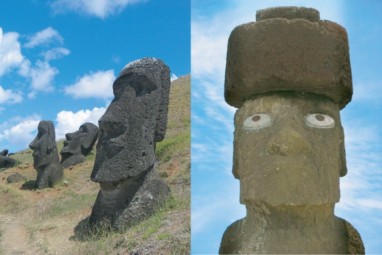
Figure 17.28: Easter Island today is a low-diversity grassland nearly devoid of the food sources, woody trees, and rope-yielding plants which helped to build and transport these 10-meter stone statues. Jared Diamond suggests that overpopulation and overexploitation of resources led to the collapse of a once-thriving Easter Island society, and that Easter Island is “Earth writ small” – a warning to the world. (12)
as “Neo-Malthusians” join Diamond in his belief that human population growth cannot continue without dire consequences.
Julian Simon and a group dubbed “cornucopians” see the human condition differently. Named for the mythical Greek ”horn of plenty” which supplied endless food and drink mag- ically, cornucopians believe that the Earth can provide an almost limitless abundance of natural resources, that few natural limits to growth exist, and that technology can solve or overcome population-induced resource scarcity and environmental degradation. Larger hu- man population (within an appropriate political environment) is the answer to the problems of population growth, according to Simon.
Are you, like Diamond and Malthus before him, a “doomster”? Or do you join Simon as a “boomster”? Most “doomsters” and “boomsters” share the belief that we are responsible for managing problems related to population growth. Let’s use our understanding of popula- tion biology to study the human population. Our goal will be to shed light on the decisions we – the only species able to consider and alter our rates of birth and death – make about future population growth.
The past two lessons have shown how populations in nature grow. You have learned that all populations have the potential to grow exponentially (J-curve pattern of growth), but that exponential growth is limited to ideal conditions, which are rare in nature. In nature, com- petition for limited resources or unpredictable, density-independent limiting factors restrict populations to densities at or below carrying capacities (S-curve growth pattern). Some
841 www.ck12.org
populations grow smoothly to a stable carrying capacity, but others overshoot that density and may crash before rebuilding to a relatively stable level. A few crash to extinction. In unstable environments, some populations establish cycles of population growth and decline. Unstable environments favor adaptations for rapid growth (r-selected species), and stable environments favor adaptations for efficient use of resources (K-selected species).
Where do humans fit? Are we built for growth – or conditioned for efficient use of resources? Does our growth pattern resemble a J, or an S? Are we in danger of extinction? What exactly is our “population problem,” and what can we do to solve it?
Early Human Population Growth
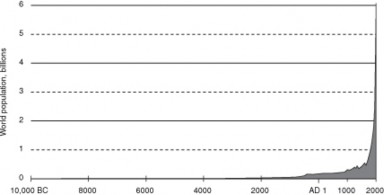
Figure 17.29: The growth of the world’s human population (using estimates by scholars in the field for the time before census data) shows a classic J shape on this 12,000-year scale. Can you distinguish the decline due to “black death” in the early middle ages? (24)
Let’s begin by looking at the data. Worldwide human population from 10,000 BCE through today is graphed in Figure 17.29. The theoretical J (exponential) and S (logistic) growth curves are reviewed in Figure 17.30. Overall, our growth resembles exponential growth (the J curve), increasing very slowly at first, but later growing at accelerating rates which show no sign of nearing carrying capacity. We appear to be r-selected for rapid growth; indeed, some have described humans as the most successful “weed species” Earth has ever seen as we are fast growing, rapidly dispersing, and colonize habitats from pole to pole. If Earth has a carrying capacity for humans, it is not yet visible in our growth curve – at least on this scale.
However, closer study of human population dynamics reveals more complexity. Different countries show different patterns of population growth today, and history shows varying patterns of growth across time. The history of human population growth can be divided into four stages. Today’s countries show snapshot views of these stages. In this section, we will look at early human population growth.
www.ck12.org 842
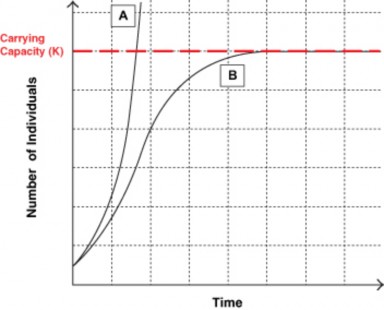
Figure 17.30: Growth of populations according to Malthus’ exponential model (A) and Ver- hulst’s logistic model (B). Both models assume that population growth is proportional to population size, but the logistic model also assumes that growth depends on available re- sources. A model’s growth under ideal conditions shows that all populations have a capacity to grow infinitely large. B limits exponential growth to low densities; at higher densities, competition for resources or other limiting factors inevitably cause growth rate to slow to zero. At that point, the population reaches a stable plateau, or the carrying capacity. (25)
843 www.ck12.org
As scientists currently understand human history, Homo sapiens arose about 200,000 years ago in Africa. Living as nomadic hunter-gatherers, we migrated to Eurasia and Australia about 40,000 years ago and into the Americas 30,000 years later. Throughout this period, both birth rates and death rates were probably high – as much as 5%. Our human popula- tion grew slowly as we spread throughout the world, out-competing other hominid species with our apparently superior reproductive and competitive adaptations. Ice ages, warming periods, and volcanic eruptions were density-independent factors which severely limited our population growth. For example, a “supervolcanic” eruption at Toba in Sumatra 74,000 years ago covered India and Pakistan with more than 5 feet of ash, causing 6 years of nu- clear winter, a thousand-year ice age, and the death of up to 99% of the humans living at the time!
With the invention of agriculture 10,000 years ago, we began to develop settled civilizations and trade. Disease associated with animal domestication and city living increased death rates, but reliable food supplies, shared childcare, and division of labor increased birth rates. These effects may have offset each other; slow and uneven growth probably continued. However, the development of agriculture, like many advances in technology, almost certainly raised carrying capacity.
Beginning about 6000 years ago, political states evolved, cooperated or competed, and some- times waged war. Empires formed, connecting previously independent populations. In the Middle Ages, technology advanced, and the 17th century brought the Scientific Revolution. Throughout this long period of human history, death rates and birth rates continued to be high. Density-independent factors such as drought and the “little ice age” combined with density-dependent factors such as disease to keep death rates high and variable. The “black death” of the mid-fourteenth century killed as many as 75 million people world- wide and the disease is one of the very few events whose effects are visible in any graph of human population growth (Figures 17.29, 17.31). Birth rates continued at a high level throughout early human history. Carrying capacity rose with major advances in technology, as humans modified the environment by irrigating land, building cities, and transporting animals, plants, and products. The overall result was slow growth and a young population. By 1804 CE, the world’s human population had reached 1 billion.
Demographic Transition
Major changes in human population growth began during the 18th century, but they affected different regions at different times. We will first consider Europe, and later compare Europe to other regions of the world. In 18th century Europe, seed planters, improved ploughs, threshing machines, crop rotation, and selective breeding of animals led to major growth in food supplies, so death rates due to starvation declined. With increasing understanding of the causes of disease, people improved water supplies, sewers, and personal hygiene – and lowered death rates even more. The Industrial Revolution of the 19th century developed new sources of energy, such as coal and electricity. These further increased the efficiency of new
www.ck12.org 844

Figure 17.31: Early human populations showed slow, uneven growth. At this scale, the negative effect of increased death rate due to the “black plague” during the mid-fourteenth century is clear. (34)
845 www.ck12.org
agricultural machines and promoted the development of new forms of transportation, mainly railroads, which improved distribution of food. Death rates fell – particularly for those 5 to 10 years of age, allowing many more children to survive to reproduce. The pattern of human survivorship shifted toward a Type III curve.
Although death rates fell, birth rates remained at earlier levels. The gap between birth and death rates increased, and population growth began to accelerate (remember that r = b – d). Although this change did not happen uniformly throughout the world, it was soon reflected in world population levels: it took 200,000 years for the human population to grow to 1 billion, but only 123 years to grow to 2 billion!
Demographic transition theory holds that human populations pass through four stages of growth (Figure 17.32).

Figure 17.32: Demographic transition theory proposes that human populations pass through four or five predictable stages of population growth. The 1st and 4th stages are relatively stable, in the first stage because b and d are both high, and in the last because b and d are both low. The key to the theory (disputed by some) is this: once death rates fall due to industrialization and technology, birth rates will follow (the Transition, Stages 2 and 3). Because the theory is based on observations of developed countries, some people dispute its universality. (18)
Early human history, with its slow, uneven growth maintained by high rates of birth and death, illustrates Stage 1 (Figure 17.31, but compare to section “1” of Figure 17.32).
Stage 2, just discussed for Europe, involves a significant drop in death rate not matched
www.ck12.org 846
by an increase in birth rate, resulting in an increasingly rapid rise in population – exponential growth.
In Stage 3, according to the theory, changes in technology and society lead to a decline in birth rate:
The decline in child mortality and improvement in agriculture leads rural families to realize they no longer need to have as many children.
Agricultural improvements shift more people to urban areas and reduce the need for children.
Compulsory education removes children from the work force but adds to the cost of raising them.
Increasing education and employment of women reduces their time for and interest in having children.
Birth control methods expand.
Later marriage and delayed childbearing further lower birth rate.
Eventually, according to demographic transition theory, falling birth rates approach already- diminished death rates, and population growth begins to level off.
In Stage 4, birth rates equal death rates, r = zero, and populations become stable.
This somewhat idealistic theory suggests that societies pass through predictable changes which lead to population growth patterns resembling the logistic or S curve. As we have seen (Figure 1), world population growth does not (yet?) show Stages 3 or 4. However, individual countries appear to be at different stages along the continuum; some have reached Stage 4 and a few even require the addition of a 5th stage.
Recent Population Growth
Death rates have fallen throughout the world, so that no country today is considered to remain in Stage 1. Countries appear to vary with respect to the timing of Stages 2 and 3. Many less developed countries remain in Stage 2, including Yemen, Afghanistan, Bhutan, Laos, and part of Sub-Saharan Africa.
Angola’s age structure (Figure 17.33) reveals accelerating Stage 2 growth. Widest at its base, the structure indicates many youths who will survive to reproduce at their parents’ high fertility rates because death rates are declining. Some countries, particularly those in regions of Africa which have been devastated by AIDS, appear stalled in Stage 2 due to disease and stagnant development. The demographic transition model may not prove to fit population growth in developing countries. Poor, low-income people in undeveloped countries have the highest birth rates. If demographic transition requires wealth and edu- cation, the world’s unequal distribution of development and resources may mean that these
847 www.ck12.org
high birth rates will merely maintain exponential growth, rather than precipitate the social change associated with industrialization.
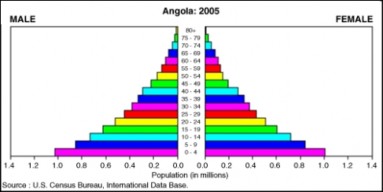
Figure 17.33: Angola’s population pyramid reflects Stage 2 growth: The wide bars at its base show the many youths who will survive to reproduce at their parent’s high fertility rates because death rates (small steps moving up the pyramid) are declining. (20)
However, many countries appear to have begun the shift to Stage 3. Fertility rates have dropped 40% throughout much of South America, the Middle East, and the Pacific Islands. Countries such as India, Bangladesh, and Zimbabwe have lowered birth rates between 25- 40%, and others such as Pakistan, Saudi Arabia, and Haiti have reduced fertility to 10-25% of earlier rates. Populations in most of these countries are beginning to level off, although resistance to change in the social factors which reduce birthrate may delay or prevent this response. Ecologist Garrett Hardin has pointed out that voluntary birth control selects against people who use it; by itself, voluntary control is unlikely to limit population growth.
High levels of industrialization and development have led to replacement (or lower) fer- tility rates in most of Europe, the United States, Canada, Australia, Brazil, China, and Thailand. China, Brazil, and Thailand passed through demographic transition extremely rapidly due to rapid economic and social changes. Replacement fertility includes 2 children to replace parents and a fraction of a child to make up for early mortality and at-birth sex ratio differences. Because mortality rates vary, replacement fertility rate ranges from 2.5 to
3.3 in poor countries, but averages 2.1 in developed countries. Globally, replacement fertility is 2.33 children per woman. In Stage 3 countries, populations will eventually stabilize if re- placement fertility continues. However, many - including the US – continue to grow rapidly due to the “youth bulges” of exponential Stage 2 growth. The age structures of China and the US (Figure 17.34) show demographic transition, but also youth bulges which will mean continuing growth for some time.
Some countries have lowered birthrates below death rates so that r is actually negative. Japan, Germany, Italy, Spain, Portugal, and Greece are not producing enough children to replace their parents; populations in some of the southern European countries have already begun to decline. Top-heavy age structures for Spain and Japan are shown in Figure
www.ck12.org 848

Figure 17.34: Population pyramids for China (above) and the U.S. (below) show decreased birth rates which suggest they have reached Stage 3 of the demographic transition model. Both countries show a population bulge remaining from Stage 2 exponential growth, so populations will continue to grow for a number of years. Eventually, if birth rates remain at replacement levels, populations will stabilize in Stage 4. (30)
849 www.ck12.org
In countries such as Russia, negative growth emerged suddenly from economic and political crises which caused emigration, declining fertility, and increased male mortality, rather than from development and wealth as the transition model predicts. Negative growth rates pose economic threats: growth-dependent industries decline, and the burden of a large aging, economically dependent population falls on a smaller group of young workers. These shrinking population conditions are sometimes referred to as Stage 5 of the demographic transition.

Figure 17.35: The top-heavy age structures for Spain and Japan show declining populations due to birth rates which have fallen below already-low death rates. Unless significant im- migration occurs, these countries may suffer negative economic effects, such as decline in growth-dependent industries. The burden of a large aging, economically dependent popula- tion may fall on a smaller group of young workers. (7)
Future Population Growth: Does Earth Have a Carrying Capacity for Humans?
As of September 2007, the world’s human population stood at about 6.7 billion, growing by 211,090 people each day. Historically, we didn’t hit the one-billion mark until 1804 (having begun 200,000 years earlier), but we needed just 12 years to grow by our last billion. Pro- jections by the United Nations and the U.S. Census Bureau predict that by 2050, Earth will host 9.4 billion people; other estimates project that the earth will host 10 to 11 billion peo- ple by 2050. See http://www.youtube.com/watch?v=4BbkQiQyaYc or click on the following World Population video .
Cornucopians welcome such growth, believing more people are better for technology and innovation. The demographic transition model predicts that when all nations are industrial- ized, the human population will eventually reach a stable level – a carrying capacity of sorts. However, many scientists believe that humans have already overshot the carrying capacity of Earth for our unique levels of resource exploitation and habitat alteration. They and other Neo-Malthusians predict that resource depletion and environmental degradation will eventually lead to famine, epidemics, or war – a Malthusian crisis.
www.ck12.org 850

Figure 17.36: A graphic description of world population growth from 1 A.D. World Popula- tion (Millenium Edition) was produced and copyrighted by Population Connection (formerly Zero Population Growth, Inc.) in 2000. Population Connection is a nonprofit, 501(c)(3) or- ganization. www.popconnect.org http://www.youtube.com/watch?v=4BbkQiQyaYc& feature=youtube_gdata
Does Earth have a carrying capacity for humans? Recall that carrying capacity is the maxi- mum population size that a particular environment can support without habitat degradation. Ideally, carrying capacity matches population size to resource availability. Although the hu- man population is clearly continuing to grow, many scientists believe that we over-consume resources and exceed the environment’s capacity to cycle nutrients and process waste. They believe that multiple factors will contribute to a crisis in which disease, starvation, or global conflict will cause a population crash or even extinction:
Our current agricultural system, globally transformed by the Green Revolution of the mid-20th century, depends heavily on nonrenewable fossil fuels for fertilizers, pesticides, and irrigation. Ecologist and agriculturalist David Pimentel predicts that to avert disaster, the U.S. must reduce its population to a maximum of 200 million (we are now above 300 million – see the “pop clock” Figure 17.37), and the world population must drop to 1/3 its current level. Distribution of food has long been a problem and today has some rather ironic consequences: A 2006 MSNBC report claimed, ”There are an estimated 800 million undernourished people and more than a billion considered overweight worldwide.”
Both developing and developed countries depend almost entirely on petroleum to fuel industrialization and transportation, as well as agriculture. In 1956, geophysicist Mar- ion Hubbert predicted that world oil production would peak about half a century into the future and then decline, initiating a global crisis. Predictions about the conse- quences of Peak Oil range from successful development of alternative fuels, to collapse of the global industrialized economy, to intense nationalism and war. Some analysts, such as energy banker Matthew Simmons, believe that the Peak has already occurred
851 www.ck12.org

Figure 17.37: The U.S. population passed 300 million on October 17, 2006. Agricul- turalist David Pimentel believes the U.S. must lower its population by 1/3 to prevent a crisis caused by inability to continue our fossil fuel-dependent agricultural practices.
U.S. and World Population Clocks are maintained by the U.S. Census Bureau online at:
http://www.census.gov/main/www/popclock.html. (9)
(Figure 17.38). Others, like energy industry consultants Wood McKenzie, believe we will not reach the peak for another ten years. The difference does not seem signif- icant, but ten years would allow more time for development of alternative fuels and institution of conservation measures.
Fresh water supplies are declining due to pollution and overuse. According to the United Nations, 2.6 billion people lack water for sanitation, and 1.1 billion have inad- equate supplies of safe drinking water. Irrigation and overuse have seriously reduced groundwater supplies, and water pollution threatens biodiversity as well as human sources. Waterborne diseases and lack of water for sanitation cause up to 80% of human illness. Growing populations, of course, will worsen this water crisis.
Habitat destruction due to agriculture, urban sprawl, and mining is the number one cause of extinction today, precipitating a biodiversity crisis. The World Resources Institute estimates that agriculture has displaced 1/3 of all temperate and tropical forests and ¼ of all grasslands; in the U.S., less than 2% of native prairie ecosystems remain. Stephen Hawking calculates that continuation of the last 200 years’ rate of population growth would have us all standing shoulder-to-shoulder, literally.
Burning fossil fuels has brought about atmospheric change. www.ck12.org 852
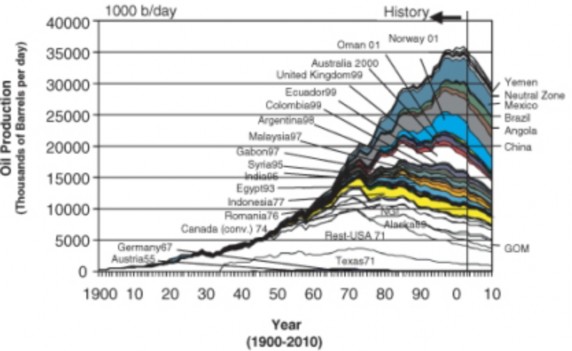
Figure 17.38: Oil production outside OPEC and former Soviet Union countries has already peaked, according to oil industry data bases for 2003 and 2004. (28)
853 www.ck12.org
Sulfur and nitrogen emissions cause acid rain, which destroys fish, lakes, forests, and lime- stone structures. CO2 emissions lead to global warming. Earth’s surface air temperatures have risen 0.74°C (1.33°F) during the last 100 years, and will continue to rise by 1.1 to 6.4
°C (2.0 to 11.5 °F) by 2100, according to the Intergovernmental Panel on Climate Change (IPCC).
Food, oil, water, land, and air crises support the idea that our human population has al- ready grown beyond carrying capacity with respect to environmental degradation. As world population continues to grow, what can we do to avert famine, disease, or war? How can we prevent a crash? What should be our goal?
Fortunately, individuals, organizations, and governments are beginning to address these problems. The concept of sustainability as a goal for human activities may hold promise for economic, social, and environmental decision-making. Although the term is recent, the concept is clearly expressed in the Great Law of the Iroquois Confederacy:
”In our every deliberation we must consider the impact of our decisions on the next seven generations.” http://en.wikiquote.org/wiki/Native_American_proverbs
A sustainable activity or state can be maintained indefinitely, without compromising re- sources for the future. Sustainability of products and services considers complete life cycles
raw materials, manufacturing, transportation/distribution, use and re-use, maintenance, recycling and ultimate disposal. All phases must address conservation of natural and human resources and also biodiversity. Many people believe current population and lifestyles are not sustainable. Unequal distribution of resources suggests that developing countries may accelerate pressure on resources in order to improve their own lifestyles.
A preliminary tool for estimating sustainability is an ecological footprint analysis. Your ecological footprint is the amount of land area you would need to sustain your current lifestyle. Footprint analysis considers the resources you consume and the pollution you gen- erate, and then calculates the amount of land which would be needed to produce equivalent renewable resources and process associated with waste. Air, land, water, food, and energy resources are all incorporated into the model. You can estimate your own footprint online (see Links at the end of the lesson) and compare it to that of countries throughout the world (Figure 17.39). Note that the average U.S. footprint is 12 times that of India, 24 times that of Somalia, and 4.4 times the world average. The last figure is worth expressing in another way: to provide everyone alive today with our western lifestyle, we’d need 4 or 5 backup planets.
To date, there is no overall agreement on a carrying capacity of Earth for humans, but many people are concerned about population growth, resource depletion and environmental degradation. Joel E. Cohen, in his book How many people can the earth support? summarizes three potential responses to the “population problem” identified at the beginning of the chapter. All three can contribute to the ultimate solution.
“Make a bigger pie.” Use technology and innovation to create, conserve, and distribute www.ck12.org 854
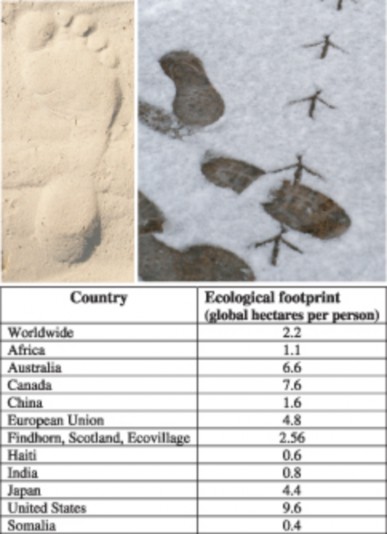
Figure 17.39: Ecological footprints measure the amount of land area required to sustain (produce replacement resources and assimilate waste) particular lifestyles. Note the 24-fold difference between citizens of Somalia and those of the US. One U.S. acre is equal to 0.405 hectares. (2)
855 www.ck12.org
resources.
“Put fewer forks on the table.” Through birth control and cultural change, reduce both population size and lifestyle expectations.
“Teach better manners.” Transform political and social structures toward the goal of social justice.
The human population, like all populations, has the capacity to reproduce exponentially and yet must live within a finite world. Unique among animals, however, we can utilize technology, cultural planning, and values in decisions which influence our future welfare. Which tools would you choose? What decisions will you help to make?
Lesson Summary
According to Neo-Malthusians, the worldwide human population may have already passed Earth’s carrying capacity in terms of environmental degradation, resource de- pletion, and unbalanced distribution of food, wealth, and development. More people will increase the danger of famine or war.
According to the cornucopians, technology and innovation can solve any problems which arise due to human population growth. The more people, the better.
The demographic transition model suggests that human populations pass through four stages of population growth:
Stage 1: Growth is slow and uneven, because high death rate offsets high birth rate.
Stage 2: Development and sanitation reduce death rates, so populations grow exponen- tially.
Stage 3: With industrialization, urbanization and contraception, births fall, and growth begins to decline.
Stage 4: Eventually, birth rate equals death rate, growth rate is zero, and the population stabilizes.
Because this model uses late 18th and 19th century European data, it correlates closely with demographic transitions throughout developed nations into the 20th century, but may not fit undeveloped countries.
No country remains in Stage 1.
A number of poor, undeveloped countries remain in stage 2; age pyramids show large youth populations.
Many countries have entered Stage 3, with some lowering fertility rates by as much as 40%, but pyramid “youth bulges” mean they continue to grow.
Replacement fertility varies from country to country because death rates vary. www.ck12.org 856
A few countries have reduced fertility rates below replacement and are shrinking in population.
Shrinking countries may for a time experience economic difficulties related to an aging population.
In September 2007, world population stood at about 6.7 billion, growing by 211,090 people each day.
The last billion-person increase took only 12 years.
Despite recent declines in birthrate in some developed countries, the human population will continue to increase at least until a peak in 2050 of 9.4 billion people or more.
Many scientists believe that we humans have already overshot the carrying capacity of Earth if resource exploitation and habitat alteration are considered.
Five factors which many believe already limit sustainable human population size are:
Agricultural dependence on nonrenewable fossil fuels for fertilizers, pesticides, and irrigation.
Dependence of industry and transportation on a finite fossil fuel supply, which has already peaked.
Decline in freshwater resources due to pollution and overuse.
Habitat destruction due to urban sprawl and agriculture, and a consequent biodiversity crisis.
Atmospheric changes such as acid rain and global warming – both consequences of increased fossil fuel burning.
The concept of sustainability may hold promise for economic, social, and environmental decisions.
Sustainability of products and services considers complete life cycles from raw materials to disposal.
A tool for estimating sustainability is the ecological footprint.
The average U.S. footprint is 12 times India’s, 24 times Somalia’s, and 4.4 times the world average.
Were all people to adopt a U.S. lifestyle, we would need 4 or 5 planets to supply resources and dispose of waste sustainably.
Potential solutions to the problems of population growth are summarized by Joel E. Cohen:
Create new and conserve existing resources – the technological “fix.”
Lower population size and lifestyle expectations – cultural change.
Distribute resources equitably – social justice.
857 www.ck12.org
Review Questions
Describe the overall pattern of human population growth, beginning with our origins 200,000 years ago and compare it to the exponential and logistic models.
Compare the factors that influenced human population growth up to the first 1 billion mark to those which controlled growth of the last billion.
Summarize the 5 stages of the demographic transition model in terms of b, d, and r.
Explain the problems with the original, four-stage demographic transition model of human population growth. Give examples of each.
Explain why replacement fertility must exceed 2 children per female.
Use the “pop clock” links at the end of the chapter to look up the current US and world populations. Compare these to predictions for 2050 made by the UN and U.S. Census Bureau. Why do many people consider these numbers to be above Earth’s carrying capacity?
Summarize 5 environmental effects of human activity which may act as limiting factors for population growth. How many of these relate to our use of fossil fuels, and why is this a problem?
Explain how ecological footprints measure sustainability, and compare them for devel- oped and undeveloped nations.
Explain what Joel E. Cohen meant by suggesting that “a bigger pie,” “fewer forks,” and “manners” are needed to address the problems of overpopulation.
Consider what you know about resource limitations, population distribution, levels of consumption, technology, poverty, economics, political realities, religious views, and different human perspectives on the earth. Choose and describe 3 changes you believe would be most successful in solving the problems of worldwide population growth – and 3 changes you believe would be least successful. Support each change with reasons why you think it would be more or less effective.
Further Reading / Supplemental Links
Joel E. Cohen, How Many People Can the Earth Support? Norton, 532 pp, 1995.
http://www.bradshawfoundation.com/journey
http://desip.igc.org/mapanim.html
http://www.eoearth.org/article/Human_population_explosion
http://www.globalchange.umich.edu/globalchange2/current/lectures/human_pop/ human_pop.html
http://www.census.gov/main/www/popclock.html
http://www.bestfootforward.com/
http://www.footprintnetwork.org/gfn_sub.php?content=footprint_overview
http://www.panda.org/news_facts/publications/living_planet_report/index. cfm
http://www.worldchanging.com/archives/006904.html
www.ck12.org 858
http://lca.jrc.ec.europa.eu/lcainfohub/introduction.vm
http://www.ilea.org/leaf/richard2002.html
Vocabulary
carrying capacity The maximum population size that a particular environment can sup- port without habitat degradation.
cornucopian A person who believes that people and markets will find solutions to any problems presented by overpopulation.
demographic transition theory Theory that proposes that human populations pass through 4 or 5 predictable stages of population growth.
density-dependent factor Factor which has the potential to control population size be- cause its effects are proportional to population density.
density-independent factor Factor which may affect population size or density but can- not control it.
ecological footprint The amount of land area needed to sustain a particular lifestyle, matching its resource consumption and pollution to necessary renewable resource pro- duction and waste assimilation.
exponential model (geometric or J-curve) A model of population growth which as- sumes that growth rate increases as population size increases.
k-selected species Species which have adaptations which maximize efficient utilization of resources, conferring competitive strength near or at carrying capacity.
logistic (S-curve) A model of population growth which assumes that the rate of growth is proportional to both population size and availability of resources.
Neo-Malthusians Individuals who believe that human population growth cannot continue without dire consequences.
population A group of organisms of a single species living within a certain area.
elected species Species which have adaptations which maximize growth rate, r.
replacement fertility The number of births per female required to maintain current pop- ulation levels; includes 2 children to replace the parents and a fraction of a child extra to make up for early mortality and sex ratio differences at birth.
859 www.ck12.org
Points to Consider
Now that you have studied some of the data on human population growth, return to the questions in the introduction to this lesson and consider whether or not your answers have changed.
Are we built for growth – or for efficient use of resources?
Does our growth pattern resemble a J, or an S? Why?
Do you think Earth has a carrying capacity for humans?
Do you think we are we in danger of extinction?
What exactly is our “population problem,” and what do you think we should do to solve it?
Jared Diamond, reflecting on the fates of past societies facing problems of sustainability, in Collapse: How Societies Choose to Fail or Succeed (2005), p. 522, says: ”Two types of choices seem to me to have been crucial in tipping … outcomes towards success or failure: long-term planning, and willingness to reconsider core values. On reflection, we can also recognize the crucial role of these same two choices for the outcomes of our individual lives.” Do you think the worldwide human population will be able to make these choices wisely?
Image Sources
Randen Pederson. http://www.flickr.com/photos/chefranden/80343473/. CC-BY-SA.
http://www.flickr.com/photos/steelmore/260956919/ http://www.flickr.com/photos/mattfoster/385873034/. CC-BY, CC-BY, CC-BY.
data from USGS. http://commons.wikimedia.org/wiki/Image: Swainson%27s_hawk_migration_route.jpg. Public Domain.
Barbara Akre for CK12 Foundation. http://commons.wikimedia.org/wiki/Image:Anatidae-goose_and_chicks.jpg. CC-BY-SA, CC-BY, CC-BY 2.0.
http://www.flickr.com/photos/fpalazzi/1313508508/. (b)CC-BY-SA.
USDA Forest Service. http://commons.wikimedia.org/wiki/Image: Grizzly_Bear_sow_and_cub_in_Shoshone_National_Forest.jpg. Public Domain.
www.ck12.org 860
http://commons.wikimedia.org/wiki/File:Pyramide_Japon.PNG. Public Domain, CC-BY-SA.
http://commons.wikimedia.org/wiki/Image:Anatidae-goose_and_chicks.jpg http://commons.wikimedia.org/wiki/File:Mother_and_baby_ducks.JPG.
CC-BY, Public Domain, CC-BY-SA.
A. Belani. http://www.flickr.com/photos/amitbelani/272175413/. CC-BY-SA.
Stan Shebs.
http://commons.wikimedia.org/wiki/Image:Agave_deserti_form.jpg. CC-BY-SA-2.5.
http://commons.wikimedia.org/wiki/Image:Lynx-canadensis.jpg. Public Domain.
http://commons.wikimedia.org/wiki/Image:Ahu_Tahai.jpg.
HB. http://commons.wikimedia.org/wiki/Image:Verhulst-Malthus.png. CC-BY-SA-2.5, 2.0, 1.0.
Piccolo Namek. http://commons.wikimedia.org/wiki/Image: Photos-photos_1088103921_Floating.jpg. GNU-FDL.
http://www.flickr.com/photos/awfulshot/107840108/ http://www.flickr.com/photos/spengler/38793138/. CC-BY, CC-BY, CC-BY.
Original data from the Royal Society of South Australia. . Creative Commons.
by Georgyi Frantsevitch Gause. http://www.ggause.com/gfg05.htm. Public Domain.
http://en.wikipedia.org/wiki/Image:Stage5.jpg. Public Domain.
Hawk Ridge Nature Reserve 2002 Annual Report. BGA and Excel. Public Domain.
US Census Bureau. http://commons.wikimedia.org/wiki/Image: Angola_population_pyramid_2005.png. Public Domain.
from the Government of Quebec. http://commons.wikimedia.org/wiki/Image:Harfang_en_vol_2.jpg. Creative Commons.
Joshua Wickerham. http://www.flickr.com/photos/kafka4prez/34684172/. CC-BY-SA.
http://commons.wikimedia.org/wiki/Image:Brown-Headed_Cowbird.jpg. Public Domain, CC-BY-3.0.
861 www.ck12.org
ELT. http://commons.wikimedia.org/wiki/Image:Population_curve.svg. Public Domain.
HB. http://commons.wikimedia.org/wiki/Image:Verhulst-Malthus.png. CC-BY-SA-2.5, 2.0, 1.0.
CK-12 Foundation. . CC-BY-SA.
Marine Mammal Commission.
http://commons.wikimedia.org/wiki/Image:Graywhale_MMC.jpg. Public Domain.
Werner Zittel and Jorg Schlinder.
http://en.wikipedia.org/wiki/Image:Hubbert_world_2004.png. Public Domain.
http://www.flickr.com/photos/pkeleher/987516260/.
http://commons.wikimedia.org/wiki/Image:Pyramide_Etats-Unis.PNG. Public Domain, CC-BY-2.5.
Dawn Endico. http://www.flickr.com/photos/candiedwomanire/9075292. CC-BY-SA.
Cutlery.
http://commons.wikimedia.org/wiki/Image:Volterra_lotka_dynamics.PNG. GNU-FDL.
CK12 Foundation. . CC-BY-SA.
Compiled from multiple authors.
http://en.wikipedia.org/wiki/World_population_estimates. GNU-FDL.
Darkone. http://commons.wikimedia.org/wiki/Image: Kleines_Granatauge_%28Erythromma_viridulum%29_male.jpg. CC-BY-SA-2.5.
http://commons.wikimedia.org/wiki/File: Population_pyramid_1_(triangle).PNG. GNU-FDL.
http://commons.wikimedia.org/wiki/Image:Pinus_banksiana_cone1.jpg.
CK-12 Foundation. . CC-BY-SA.
www.ck12.org 862
Ecology and Human Actions
Lesson 18.1: The Biodiversity Crisis
Lesson Objectives
Compare humans to other species in terms of resource needs and use, and ecosystem service benefits and effects.
Define the concept of biodiversity.
Quantify Earth’s species diversity, according to scientists’ current understanding.
Describe patterns of biodiversity in space.
Trace changes in biodiversity throughout Earth’s history.
Examine the evidence for the Sixth Extinction.
Compare the Sixth Extinction to major extinctions before humans.
Discuss the direct economic benefits of biodiversity.
Evaluate ecosystem services provided by biodiversity.
List the intangible (cultural, spiritual, religious) benefits of biodiversity.
Relate biodiversity to social and political stability.
Consider that biodiversity has intrinsic value apart from benefits to humans.
Assess the potential for early human activities to contribute to Ice Age extinctions of large animals.
Identify habitat loss as the primary cause of the Sixth Extinction.
Relate the introduction of exotic species to loss of biodiversity.
Explain the extent to which over exploitation has affected all levels of biodiversity.
Connect energy use to extinction.
Describe the effects of population growth and unequal distribution of resources on biodiversity.
Recognize that pollution of water, land, and air contributes to the loss of species.
Acknowledge that your daily activities and decisions can significantly help to protect
863 www.ck12.org
biodiversity.
Evaluate your consumption – of food, clothing, furniture, and cleaning products.
Appreciate the importance of water resources and know how to use them wisely.
Evaluate your choice and use of energy sources.
Assess the importance of minimizing waste, and of using best practices for waste dis- posal.
Know how to avoid transporting and releasing exotic species.
Realize that you can practice sustainable management of your own land, from small yards to local, state, and federal lands which also belong to you.
Describe sustainability and its role in decision-making.
Explain how learning and active citizenship can contribute to protecting biodiversity.
Introduction
Humans, like all species, depend on certain natural resources for survival. We depend on land and soils to grow crops, which transform solar energy into food. We use the Earth’s freshwater lakes, rivers, and groundwater for drinking. We rely on the atmosphere to provide us with oxygen and to shield us from radiation. We rely on Earth’s biodiversity for food, clothing, and medicines. We utilize all of the “basic four” (biodiversity, land, water, air) for recycling of nutrients and disposal of waste. Natural ecosystems, as Odum suggests, provide services for all species: they maintain soil, renew the atmosphere, replenish freshwater supplies, dispose of wastes, and recycle nutrients. In our dependence on these services, we are like all other species.
Yet in many ways, we do not behave like other species. We supplement food and animal energy with fossil fuel energy. We harvest natural resources to exhaustion, and produce waste beyond levels that the Earth can process. We alter biodiversity, land, water, air and fossil fuels beyond nature’s ability to repair. As you learned in your study of population biology, our population has grown beyond Earth’s carrying capacity, compounding problems of resource use and waste disposal. Only recently have we learned to appreciate the full value of these resources – and the potential for harm from our own activities. Our economics have not caught up to our relatively new understanding: we do not yet pay the costs of maintaining all of “nature’s services.”
This lesson will explore biodiversity – the “millions of organisms and hundreds of processes
- operating to maintain a livable environment.” The topic is timely, critical, and colorful: you will encounter warnings of a Biodiversity Crisis and the Sixth Extinction, and species identified as “an Elvis taxon” or “a Lazarus taxon.” More importantly, by the end of your study, you will have some tools you can use in your daily life to help protect the great diversity of Earth’s life.
www.ck12.org 864
What is Biodiversity?
“The first rule of intelligent tinkering is to save all the pieces.” –attributed to Aldo Leopold, but probably a shortened version of: ”To save every cog and wheel is the first precaution of intelligent tinkering.” - Aldo Leopold, Round River: from the Journals of Aldo Leopold, 1953
What are the “cogs” and “wheels” of life?
Although the concept of biodiversity did not become a vital component of biology and political science until nearly 40 years after Aldo Leopold’s death in 1948, Leopold – often considered the father of modern ecology - would have likely found the term an appropri- ate description of his “cogs and wheels.” Literally, biodiversity is the many different kinds (diversity) of life (bio-). Biologists, however, always alert to levels of organization, have identified three measures of life’s variation. Species diversity best fits the literal trans- lation: the number of different species (see the chapter on Evolution of Populations ) in a particular ecosystem or on Earth (Figure 18.1). A second measure recognizes variation within a species: differences among individuals or populations make up genetic diversity. Finally, as Leopold clearly understood, the “cogs and wheels” include not only life but also the land (and sea and air) which supports life. Ecosystem diversity describes the many types of functional units formed by living communities interacting with their environments.
Although all three levels of diversity are important, the term biodiversity usually refers to species diversity. How many species do you think exist on Earth? What groups of species do you think are most abundant? Consider your own experience, and your study of biology up to this point. Think carefully, and write down your answer or exchange ideas with a classmate before you read further.
What is the Species Diversity of Earth?
There are three good answers to this question. As a member of one of Earth’s most intriguing species, you should know them all!
Scientists have identified about 1.8 million species. (Figure 18.2)
The relative numbers of species in each of the six kingdoms of life is shown in Figure A
18.2. The Animal Kingdom (dominated by the Insects, as shown in Figure B 18.2) includes the great majority of known species, and Archaebacteria, by far the fewest. Most scientists agree that Eubacteria and Archaebacteria are seriously underrepresented, due to their small size and chemistry-based diversity. This leads to a second, and perhaps better answer to our question:
No One Knows How Many Species Currently Live on Earth!
Does this lack of knowledge surprise you? Scientists are still discovering new species - not only microorganisms but also plants, animals, and fungi. At least 5 new species of marsupials,
865 www.ck12.org
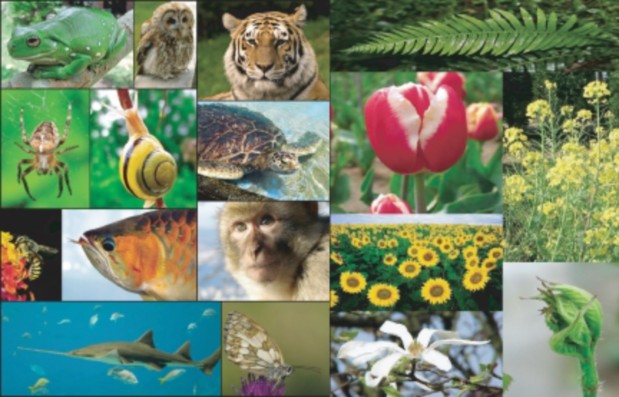
Figure 18.1: The most accessible definition of biodiversity is species diversity. How many species exist on Earth? (30)

Figure 18.2: Among 1.8 million identified species (A), 1,315,378 are Animals (B), 287,655 are Plants (C), and only 259 are Archaebacteria. The Animal Kingdom is dominated by the Class Insecta, and the Plant Kingdom is dominated by flowering plants. (19)
www.ck12.org 866
25 primates, 3 rabbits, 22 rodents, 30 bats, 4 whales or dolphins, a leopard, and a sloth were identified between 2000 and 2007 – and these include only mammals! The vast majority of Eubacteria, Archaebacteria, Protist, and even Insect species may be yet unknown because their small size, remote habitats, and the chemical distinctions between species make them so difficult to detect. These challenges, however, have not prevented scientists from estimating Earth’s biodiversity – bringing us to the third answer to our question:
Scientists Estimate that Between 5 and 30 Million Species Inhabit the Earth.
Estimates vary widely – from 2 million to 117.7 million, underlining our lack of knowledge. Most estimates fall between 5 and 30 million. Much remains to be learned about the diversity of microorganisms. For example, scientists have recently discovered that Archaebacteria – originally considered limited to extreme environments - may constitute as much as 40% of the ocean’s microbial biomass. Few species have been identified. Estimates of global diversity of the better-studied Eubacteria vary from millions to billions, with orders of magnitude of error. As for multicellular organisms, the most “species-dense” terrestrial ecosystems, such as coral reefs and tropical rain forests, harbor most of the undiscovered species (Figure 18.3). Ironically, these ecosystems are also disappearing quickly. In summary, our estimates of biodiversity remain crude. However, the following conclusion is clear: given the current rapid loss of species, we will never know many of the species we are losing.
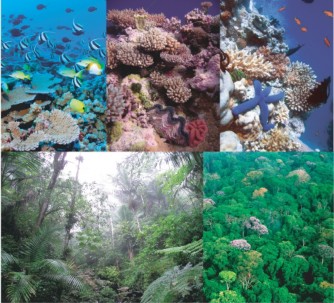
Figure 18.3: Coral reefs (above) and tropical rain forests (below) have the greatest biodiver- sity of the many ecosystems on earth. They are also among the most threatened habitats. Because our knowledge of their species is incomplete, we are clearly losing species we do not (and never will) know. (31)
867 www.ck12.org
Biodiversity Patterns in Space
Are Earth’s 1.8 million known species evenly distributed across its surface? You may already be aware that the answer is a resounding “No!” We will compare two regions with relatively high diversity to begin our analysis.
Minnesota has relatively high ecosystem diversity, because three of the Earth’s six major terrestrial biomes converge in this state (Prairie, Deciduous Forest, and Coniferous Forest). By contrast, Costa Rica comprises almost entirely of Tropical Rain Forest, and has only one quarter of the land area of Minnesota (Figure 18.4).
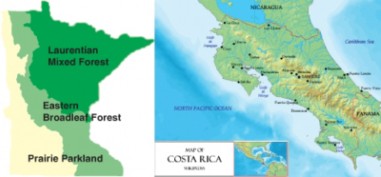
Figure 18.4: The state of Minnesota (left) includes three major biomes and four times the land area of the country of Costa Rica (right), which is predominately a tropical rainforest. Figure 18.5 compares the biodiversity of Minnesota to that of Costa Rica. (8)
You might expect, then, that Minnesota would have a higher species diversity. Several groups of organisms are compared in the Figure 18.5. Note that a column is included for you to research your own state or region!
Clearly, biodiversity is much higher in Costa Rica than in Minnesota. Collecting leaves for your biology class in Costa Rica, you would need to study 2,500 different trees in order to identify the species! And you’d need to look carefully to distinguish tree leaves from those of the many epiphytes (plants which grow on top of others), vines, and strangler figs which climb the trunks and branches, “cheating” their way to the sunlight at the top of the canopy. In Minnesota, keys to native trees include just 42 species of conifers and deciduous broadleaved species. There, vines are relatively rare, and epiphytes are limited to colorful lichens.
The differences in biodiversity between Minnesota and Costa Rica are part of a general worldwide pattern: biodiversity is richest at the equators, but decreases toward the poles. Temperature is undoubtedly a major factor, with warmer, equatorial regions allowing year- round growth in contrast to seasonal limitations nearer the poles.
Generally, the more species, the more niches – so diversity begets diversity. www.ck12.org 868
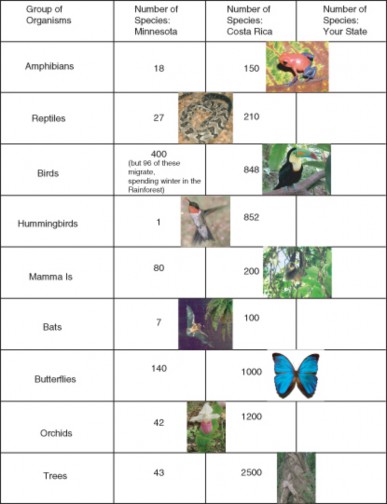
Figure 18.5: A comparison of species diversity within categories supports the increase in diversity from the poles to the equators. Costa Rica’s increased diversity is due in part to greatly increased niches: diversity begets diversity! For example, poison dart frogs mature in tiny epiphyte pools, and strangler figs climb existing trees and “starve” their hosts of sunlight. Does your state or region support this overall spatial pattern of biodiversity? (36)
869 www.ck12.org
Does your country, state or region fit the general pattern of decreasing biodiversity from equator to poles?
Biodiversity Patterns in Time
How has Earth’s biodiversity changed across time? The fossil record is our window into this pattern, although the window has limitations. Microorganisms are poorly preserved and distinguished only with difficulty; gene sequence studies of living bacteria have begun to fill in some missing data. For all organisms, recent rock layers are more accessible and better preserved than ancient ones.
Despite these drawbacks, fossils and gene studies show a distinct pattern of increasing bio- diversity through time. As discussed in the chapter on the History of Life, the origin of life is not clearly understood; evidence suggests that life did not appear on Earth until perhaps 4 billion years ago. For several billion years, unicellular organisms were the only form of life. During that time, biodiversity clearly increased, as Eubacteria and Archaebacteria emerged from a common ancestor some 3 billion years ago, and Eukaryotes emerged by endosymbio- sis about 2 billion years ago. However, we have not accurately measured the diversity of even today’s microorganisms, so we have little understanding of changes in the diversity of microorganisms beyond these major events.
The emergence of multicellular life about 1 billion years ago certainly increased biodiversity, although we have little way of knowing whether it might have negatively affected the diversity of microorganisms. Fossils remain relatively rare until the famed Cambrian explosion 542 million years ago. Since then, a much more detailed fossil record (Figure 18.6) shows a pattern of increasing biodiversity marked by major extinctions.
The dramatic increase indicated for the last 200 million years is somewhat disputed. Some scientists believe it is a real increase in diversity due to expanding numbers of niches – diversity begets diversity, again. Others believe it is a product of sampling bias, due to better preservation of more recent fossils and rock layers. Most scientists accept the general pattern of increasing diversity through time, interpreting the magnificent biodiversity of life on Earth today as the result of billions of years of evolution.
Most scientists also accept at least the five major mass extinctions shown in Figure 18.6, and some hold that regular cycles govern extinction. Causes for these extinctions (more com- pletely discussed in the History of Life chapter) remain incompletely understood; hypotheses include global climate change, major volcanic and continental drift events, dramatic oceanic change, and/or extraterrestrial impact or supernova events.
Increasingly accepted is a current Sixth or Holocene Extinction event. According to a 1998 survey by the American Museum of Natural History, more than 70% of biologists consider the present era to be a sixth mass extinction event - perhaps one of the fastest ever. We will explore the Sixth, or Holocene, Extinction in the next section of this lesson.
www.ck12.org 870
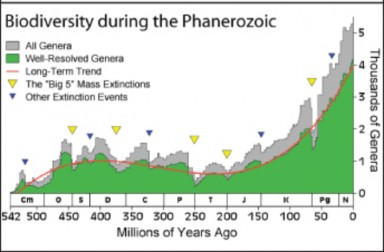
Figure 18.6: The fossil record for marine species over the past 542 million years shows a gradual increase in biodiversity interrupted by five major extinctions. Some scientists view the recent rapid rise in diversity as a result of better preservation of more recent rock layers and fossils. (5)
The Current Loss of Biodiversity
“For one species to mourn the death of another is a new thing under the sun.”
-Aldo Leopold A Sand County Almanac, 1949
Over 99% of all species that have ever lived on Earth are extinct. During the 5 major ex- tinctions recorded in the Phanerozoic fossil record (Figure 18.6), more than 50% of animals disappeared. Evidently, extinction is natural. However, current extinctions may differ sig- nificantly in rate and cause. The IUCN (International Union of Concerned Scientists) has documented 758 extinctions since 1500 CE; for example, 6 species of giant, flightless Moa (Figure A 18.7) disappeared from New Zealand shortly after the arrival of Polynesians. Estimates of extinctions for the last century range from 20,000 to 2,000,000 species; as for diversity, we simply do not know the true figure.
Many scientists begin the Sixth Extinction with the Ice Age loss of large mammals and birds
part of a continuum of extinctions between 13,000 years ago and now. During that time, 33 of 45 genera of large mammals became extinct in North America, 46 of 58 in South America, and 15 of 16 in Australia. Climate change and/or human “overkill” are hypothetical causes. Supporting the significance of the “sudden” arrival of humans are the low numbers in Europe and South Africa, where humans had coevolved with large animals. The woolly mammoth (Figure B 18.7) is one of the many examples of large mammal extinctions from this period.
The first species to become extinct during recorded human history was the Dodo (Figure C 18.7), a flightless bird which had evolved without predators on an island in the Indian
871 www.ck12.org
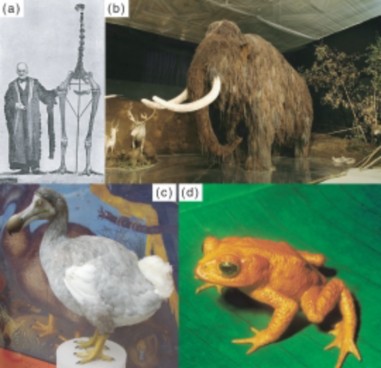
Figure 18.7: A gallery of species which have succumbed to the Sixth Extinction: A: one of six species of Moa birds which disappeared after Polynesians first arrived and began to hunt and clear forests in New Zealand about 1500 CE. B: reconstruction of a woolly mammoth, one of many large mammals which became extinct at the end of the last Ice Age, due to human hunting, disease, and/or climate change. C: a reconstruction of the meter-tall flightless Dodo, which disappeared within a hundred years of its discovery, probably due to forest destruction and introduced predators. D: the Golden Toad recently discovered in 1966, has been officially extinct since 1989. Amphibians as a group have declined sharply throughout the world during the past three decades. (7)
www.ck12.org 872
Ocean. Described in 1581, the fearless Dodo experienced hunting, forest habitat destruction, and introduced predators, and became extinct before 1700 – a story repeated for many more species over the following three centuries. Unfortunately, the story extends back in time, as well; over the past 1100 years, human activity has led to the extinction of as many as 20% of all bird species… a tragic loss of biodiversity.
Harvard Biologist E.O. Wilson estimated in 1993 that the planet was losing 30,000 species per year - around three species per hour. In 2002, he predicted that if current rates continue, 50% of today’s plant and animal species will be extinct within the current century – compared to hundreds of thousands or even millions of years for pre-human mass extinctions. A dramatic global decline in amphibian populations in less than 30 years headlines the recent rise in extinction. Herpetologists report that as many as 170 species have become extinct within that time, and at least one-third of remaining species are threatened. Costa Rica’s Golden Toad (Figure D 18.7), first described in 1966, was last seen in 1989 and has become a poster species for amphibian declines.
Why is Biodiversity Important? What are We Losing?
Why should humans care if biodiversity declines? Does it matter that we have 170 fewer amphibians, or that we are losing thousands of species each year, when the Earth holds millions of other species, and life has been through extinction before? The answer is a definitive yes! It matters to us even if we consider only the economic and spiritual benefits to humans. It matters to us because we do not even understand the myraid of indirect benefits – now recognized as ecosystem services- that we reap from other species. And, of course, it matters to other species as well.
Direct Economic Benefits of Biodiversity
Food Supply: Monocultures (large-scale cultivation of single varieties of single species) are extremely vulnerable to disease. A water mold caused the infamous Irish potato famine where potatoes had been bred from a single Incan variety. As recently as 1970, blight swept the corn belt where 80% of maize grown in the U.S. was a single type. According to the Food and Agricultural Organization of the United Nations, humans currently cultivate only 150 plant species, and just four provide over half of the food we eat. Just 15 animal species make up over 90% of our livestock.
Potential for hybridization requires a diverse “bank” of wild, native species. Contemporary breeders increase genetic diversity by hybridizing crop species with wild species adapted to local climate and disease (Figure 18.8).
Clothing, Shelter, and Other Products: As many as 40,000 species of plants, animals, and fungi provide us with many varied types of clothing, shelter and other
873 www.ck12.org

Figure 18.8: Wild varieties of domesticated crops, such as this unusually shaped Latin American maize, hold the potential to enhance productivity, nutritional value, adaptation to local climates, and resistance to local diseases through hybridization. Loss of biodiversity limits our ability to increase the genetic diversity of crops. (38)
products. These include timber, skins and furs, fibers, fragrances, papers, silks, dyes, poisons, adhesives, rubber, resins, rubber, and more.
Energy: In addition to these raw materials for industry, we use animals for energy and transportation, and biomass for heat and other fuels. Moreover, hydroelectric power depends on ecosystem structure: Chinese scientists calculated that the economic benefits of maintaining forest vegetation in the Yangtze River watershed “produced” more than twice the economic value of timber (had it been harvested) in annual power output.
Medicine and Medical Models: Since the first microorganisms competed for food, evolution has been producing chemicals for “warfare” and “defense” in bacteria, fungi, plants, and animals; Figure 18.9 shows several used by humans. According the Amer- ican Museum of Natural History Center for Biodiversity Conservation (AMNH-CBC), 57% of the most important prescription drugs come from nature, yet only a fraction of species with medicinal potential have been studied.
Unique features of certain species have opened windows into how life works. For example, the Atlantic squid’s giant axon revealed the basics of neurophysiology, and the horseshoe crab’s (Figure D 18.11) optic nerve and photoreceptors taught us how vision works. Other animals serve as disease models; as far as we know, other than humans, only armadillos suffer from leprosy, and only sea squirts form kidney stones.
www.ck12.org 874
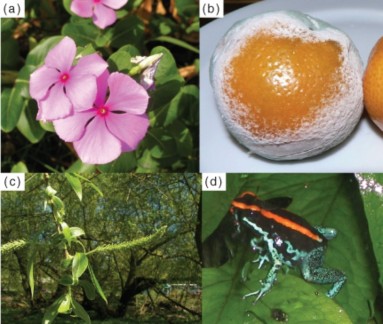
Figure 18.9: A pharmacopoeia of the living world: The Rosy Periwinkle (A) is the source of two chemotherapy drugs effective against leukemias. The mold Penicillium (B) produces the antibiotic penicillin to defend its territory (in this case, a mandarin orange) from competing microorganisms. Aspirin originates in the bark of the White Willow (C). And several species of tropical frogs in the genus Phyllobates (D) produce poisons used by South American tribes for hunting with darts. (46)
875 www.ck12.org
Efficient Designs: Inspiration for Technology: Biomimicry, also known as biomimetics or bionics, uses organisms for engineering inspiration and human inno- vation. Rattlesnake heat-sensing pits, for example, suggested infrared sensors. Zim- babwe’s Eastgate Centre Figure 18.10 incorporates air-conditioning principles from termite mounds. The 2006 Mercedes-Benz Bionic employs the body shape of the yel- low box fish to combine high internal volume and efficient aerodynamics. Biomimetics professor Julian Vincent estimates that only 10% of current technology employs the highly efficient biological designs crafted by evolution and natural selection. Loss of biodiversity can be viewed as the loss of millions of years of evolutionary wisdom.
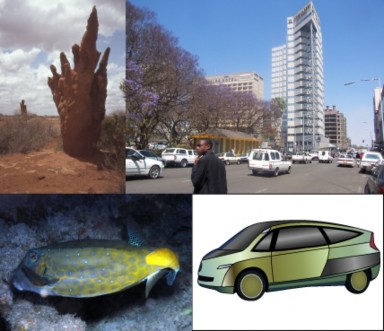
Figure 18.10: Bionics, or biomimicry, engineers structures based on biological designs made efficient by millions of years of evolution and natural selection. Above: The air-conditioning efficiency of a termite mound (left) inspired the design of the Eastgate Centre in Zimbabwe (right), which requires just 10% of the energy needed for conventional building of the same size. Below: The rigid exoskeleton and low-drag body shape of the tropical yellow box-fish (left) inspired the 2006 Mercedes-Benz Bionic (right), which combines large internal volume with optimal aerodynamics. (37)
Warnings of Toxins and Other Ecosystem Disruptions: If you know how miners use canaries to detect poisonous gases underground, you will understand how widespread extirpation of peregrine falcons (Figure E 18.11) warned us about the dangers of the pesticide DDT and food chain concentration of toxins.
www.ck12.org 876
Indirect Benefits of Biodiversity: Ecosystem Services
Increasing Ecosystem Productivity: Ecologist David Tilman compared grassland plots to show that increasing species diversity increased overall productivity (yield). Different plants utilize different resources, so a variety of plants may more completely use resources within an area. As noted above, diversity also reduces system vulnera- bility to pests and disease.
Increasing Ecosystem Stability: Tilman observed his grassland plots through several cycles of drought and documented a similar relationship between biodiversity and stability. Plots which were more diverse were more resistant to drought and later recovered more completely. Reducing ecosystem vulnerability to pests and disease may also be a factor in the relationship between diversity and stability. As you have learned before, diversity among individuals within a species increases the chance that at least some will survive environmental change; similarly, diversity among species within an ecosystem increases the chance that at least some species will survive environmental change.
Maintaining the Atmosphere: As you learned in the chapters on photosynthesis and respiration, plants and algae produce the O2 which makes up 20% of the atmo- sphere essential to aerobic organisms, and remove CO2 produced by respiration and burning fossil fuels. As Joseph Priestley expressed this service, plants “restore the air” which has been “injured by the burning of candles” or “infested with animal respira- tion.” O2 is also critical to life because it helps to maintain the ozone shield, protecting life from dangerous Ultra-Violet radiation.
Maintaining Soils: Soil microorganisms maintain nutrients in complex but critical chemical pathways. Vegetation and litter prevent erosion of soils which require thou- sands of years to form. Estimates suggest that erosion destroys as many as 3 million hectares of cropland annually, and that as much as one-fifth of the world’s cropland is “desertified” through salination, acidification, or compacting.
Maintaining Water Quality: Water treatment plants rely in large part on microor- ganisms for water purification, and natural systems do the same. In nature, wetland, waterway, and watershed root systems combine with soil adsorption and filtration to accomplish water purification. When New York City decided to restore the Catskill wa- tershed, their $1-1.5 billion investment in “natural capital” contrasted favorably with the $6-8 billion initial cost and $300 million annual operating cost of a new treatment plant.
“Fixing” Nitrogen: One of the most amazing aspects of biological systems on earth is their absolute need for nitrogen – to build the proteins and nucleic acids upon
877 www.ck12.org
which life depends – and their nearly universal dependence on microorganisms to “fix” atmospheric N2 gas and recycle the nitrogen of waste and death. Only after the bacterial “service” of processing nitrogen is it available in usable chemical form to plants, and through them, to animals (Figure A 18.11).
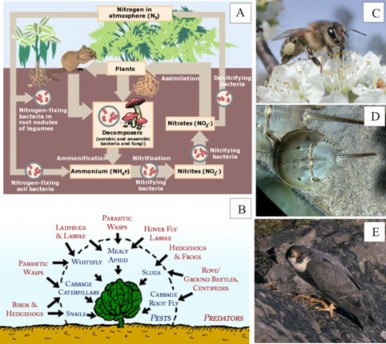
Figure 18.11: Ecosystem services which depend on biodiversity include nitrogen fixation (A), pest control (B), pollination (C), medical models such as the horseshoe crab optic nerve and photoreceptors (D), and early warning about toxins, e.g. the peregrine falcon’s extirpation by the pesticide DDT (E). (39)
Nutrient Recycling and Waste Disposal: Bacteria and nitrogen are not the only contributors to the waste management services of ecosystems. Fungi, protists, and scavengers help to decompose waste and dead organisms so that new life can reuse the available nutrients.
Pollination: The list of biotic pollinators, essential for sexual reproduction in many plants, is long including not only insects such as wasps, bees, ants, beetles, moths, butterflies, and flies, but also fruit bats and birds such as hummingbirds, sunbirds, spiderhunters, and honeyeaters. Although U.S. crops have relied on commercial hon- eybees (which are “migrated” to keep pace with maturing crops!), native pollinators in nearby forests or wild grasslands have been shown to improve the productivity of ap- ples or almonds by 20%. The American Institute of Biological Sciences estimates that
www.ck12.org 878
native insect pollination is worth $3.1 billion annually. Current alarm over honeybee colony collapse highlights the importance of biodiversity to the ecosystem service of pollination.
Pest and Disease Control: According to the AMNH-CBC, farmers spend $25 billion annually on pesticides, while predators in natural ecosystems (Figure B 18.11) contribute 5 to 10 times that value in pest control. Costs associated with the use of chemical pesticides (such as water pollution) add to the value of natural pest control. Natural enemies are adapted to local environments and local pests, and do not threaten each other’s survival (or ours!) as do broad-spectrum chemical pesticides. Preservation of natural enemies is associated with preservation of plant diversity, as well. Disrupted ecosystems can lead to increasing problems with disease. In Africa, deforestation has led to erosion and flooding, with consequent increases in mosquitoes and malaria.
Aesthetic Benefits of Biodiversity
Cultural, Intellectual, and Spiritual Inspiration: Music, art, poetry, dance, mythology, and cuisine all reflect and depend on the living species with whom we share the Earth. Our cultures reflect local and regional variations, and as such, biodi- versity underlies our very identities. The beauty and tranquility of living ecosystems have inspired environmentalists (Rachel Carson, Aldo Leopold), spiritualists (Thomas Berry), and writers such as (Barry Lopez) throughout history. Recently, the increasing distance of human society from the natural world has raised concerns about our psy- chological and emotional health; E.O. Wilson has proposed that biophilia (love of the living world) is an increasingly ignored part of our human psyche, and Richard Louv believes that too many of our children suffer from “nature deficit disorder” caused by our increasing alienation from nature.
Recreational Experiences: Many people choose to use vacation and recreation time to explore natural ecosystems. Outdoor recreational activities – many of which are in- creasing in popularity - include hunting, fishing, hiking, camping, bird-, butterfly- and whale- watching, gardening, diving, and photography. Indoor hobbies such as aquari- ums also celebrate biodiversity. For Costa Rica, Ecuador, Nepal, Kenya, Madagascar, and Antarctica, ecotourism makes up a significant percentage of the gross national product. Ideally, ecotourism involves minimal environmental impact, conservation of bio- and cultural diversity, and employment of indigenous peoples.
Political and Social Benefits of Biodiversity
Some analysts relate biodiversity to political and social stability. Unequal access to food, clothing, water, and shelter provided by diverse ecosystems threatens social equity and sta- bility. Land ownership and land use practices which threaten biodiversity often marginalize
879 www.ck12.org
poorer people, forcing them into more ecologically sensitive areas and occupations. Poverty, famine, displacement, and migrations are problems related to loss of biodiversity which have already led to billions of dollars in relief costs and significant local armed conflict.
Intrinsic Value of Biodiversity
Many people value biodiversity for its inherent worth, believing that the existence of such a variety of genes, species, and ecosystems is reason enough for our respect. Intrinsic value goes beyond economic, aesthetic, environmental, and political benefits. For many people, intrinsic value alone imposes great responsibility on us to monitor our actions in order to avoid destroying the diversity of life.
Why is biodiversity important? It supplies us with essential resources, raw materials, and designs which have direct economic value. It enhances the stability and productivity of ecosystems which in turn provide essential, under-appreciated services. These services, too, have great economic value, although we are only beginning to recognize their importance as we experience their loss. Biodiversity is critical for cultural identity, spiritual and intellectual inspiration, and our own re-creation. Biodiversity goes hand-in-hand with social and political stability. And for many people, biodiversity has inherent worth apart from its many benefits for us and our environment.
Biodiversity is critically important for us and for the Earth, and it is declining at an un- precedented rate. What is causing current extinctions? What can we – what can YOU – do to help?
Causes of the Sixth Extinction: Human Actions and the Environment
What are the causes of the Sixth Extinction? There is nearly universal agreement that most result from human activities (Table 18.1 and Figure 18.12). Although our activities have changed, we remain the single species most able to alter the Earth’s genetic, species, and ecosystem biodiversity.
Table 18.1:

Continent/Island Human Settlement (Years Before Present)
Extinctions Which Followed

Africa, Eurasia Humans evolve here relatively few extinctions
Indonesia 50,000 50% of large mammal species
Australia 40,000 55 species large mammals, reptiles, and birds
www.ck12.org 880
Table 18.1: (continued)

Continent/Island Human Settlement (Years Before Present)
Extinctions Which Followed

North and South Amer- ica
10,000 - 12,500 70-80% of large mammals (at least 135 species) within 1000 years
Mediterranean Islands 10,000 large mammals and reptiles
West Indies 7,000 Mammals, birds, reptiles all 5 endemic mammals of Puerto Rico
Madagascar 2,000 virtually all large endemic land mammals, reptiles, and birds within 1500 years
Hawaiian Islands 1,500 (Polynesians) 250 (Eu-
ropeans)
2/3 of native vertebrate species, 90% of bird species after European arrival, 20 more bird species
New Zealand 1,300 No mammals originally Frogs, lizards, and over 1/3 (40 species) of birds

Convincing evidence for human responsibility for Ice Age extinctions is outlined in Figure
Comparing Ice Age to pre-human extinctions provides more evidence:
Ice Age extinctions affected large animals disproportionately; pre-human extinctions affected all body sizes.
Ice Age extinctions occurred at different times in different regions; pre-human extinc- tions were global and simultaneous.
Recent extinctions follow human migration with regularity.
The “syncopated” pattern does not fit climate change, and earlier interglacial periods did not see similar extinctions.
Although the data above has led to considerable agreement about human responsibility for the early Holocene extinctions, scientists still debate exactly how human activities caused extinctions. Hypotheses include:
Overkill: Animals outside Africa and Eurasia evolved in the absence of humans. Many
881 www.ck12.org
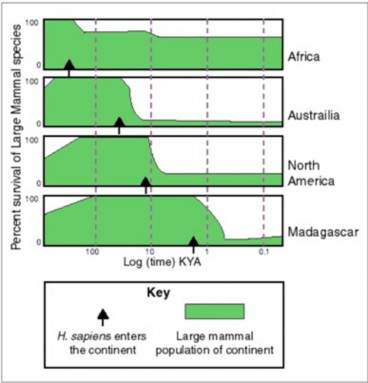
Figure 18.12: Large animal extinctions followed the arrival of humans in many regions of the world, suggesting that human activities caused the extinctions. (1)
www.ck12.org 882
did not fear humans and would have been easily killed, explaining the disproportionate numbers of large species affected.
Cascade effects: Extinctions of very large animals could have had major effects on
ecosystems, including secondary extinctions. Loss of predators could have led to over- population and starvation of prey species. Loss of large herbivores would have affected their predators. Removal of even a single keystone species could have destabilized complex ecosystem interactions, leading to multiple extinctions.
Disease: Humans often brought along rats, birds, and other animals as they migrated to new regions. Animals in those new regions, however, would not have evolved re- sistance to the diseases they carried. Avian malaria, for example, is still spreading through Hawaii, having already caused the extinctions of many bird species.
Predation by exotic animals: The rats, birds, and other animals accompanying humans brought not only disease but also new appetites to regions where animals had evolved without predators. Like humans, these animals found the “naïve” prey easy to capture.
Habitat destruction: Deforestation and agriculture accompanied humans, and the loss of habitat inevitably resulted in loss of species.
These effects of early human habitation foreshadow today’s even greater threats to biodiver- sity. Overpopulation, industrialization, technology, cultural differences, and socioeconomic disparities compound the six major causes of today’s Biodiversity Crisis. Most experts agree on the primary cause of extinction today:
Causes of Extinction #1: Habitat Loss
Habitat loss, degradation and fragmentation is universally accepted as the primary threat to biodiversity. Agriculture, forestry, mining, and urbanization have disturbed over half of Earth’s vegetated land. Inevitably, species disappear and biodiversity declines.
Conversion for agriculture is a major reason for habitat loss. Within the past 100 years, the area of land cultivated worldwide has increased 74%; grazing land increased 113%. Agri- culture has cost the United States 50% of its wetlands and 99% of its tallgrass prairies. Native prairie ecosystems (Figure 18.13) - which comprise of thick, fertile soils, deep-rooted grasses, a colorful diversity of flowers, burrowing prairie dogs, owls and badgers, herds of bison and pronghorns, and booming prairie chickens, - are virtually extinct.
The largest cause of deforestation today is slash-and-burn agriculture (Figure 18.14), used by over 200 million people in tropical forests throughout the world. Depletion of the surprisingly thin and nutrient-poor soil often results in abandonment within a few years, and subsequent erosion can lead to desertification. Half of Earth’s mature tropical forests are gone; one-fifth of tropical rain forests disappeared between 1960 and 1990. At current rates of deforestation, all tropical forests will be gone by 2090.
883 www.ck12.org

Figure 18.13: Habitat loss is the #1 cause of extinction today. In the U.S., over 99% of tallgrass prairies have been eliminated in favor of agriculture. Big bluestem grasses as tall as a human (center) and (clockwise from top) prairie chickens, prairie dogs, burrowing owls, yellow and purple coneflowers, blue grama grass, and bison make up part of the prairie community. (32)
www.ck12.org 884

Figure 18.14: Slash-and-burn agriculture is practiced by over 200 million people throughout the world; this photo was taken in Panama. Because of thin, nutrient-poor soils, plots are abandoned within just a few years. Experts predict that if current rates continue, all tropical forests will be gone by 2090. (52)
Poverty, inequitable land distribution, and overpopulation combine in third world coun- tries to add pressure to already stressed habitats. Use of firewood, charcoal, crop waste, and manure for cooking and other energy needs further degrade environments, threatening biodiversity through habitat loss.
Causes of Extinction #2: Exotic (Alien or Invasive) Species
Technology has made the human species the most mobile species of any which has ever lived. Both intentionally and inadvertently, humans have extended their mobility to a great number of other species, as well. Ships from Polynesian times (as long ago as 3500 BP) to the present have transported crop species and domesticated animals as well as stowaway rats and snakes. Recently, cargo ships have transported Zebra Mussels, Spiny Waterfleas, and Ruffe deep into the Great Lakes via ballast water. Europeans brought Purple Loosestrife and European Buckthorn to North America to beautify their gardens. Shakespeare enthusiast Eugene Schieffelin imported the now-ubiquitous European Starling to Central Park in the 1890s because he thought Americans should experience every bird mentioned in the works of Shakespeare. Australians imported the Cane Toad in an attempt to control the Cane Beetle, a native pest of sugar cane fields. The Brown Tree Snake (Figure 18.15) may have hitchhiked in the wheel-wells of military aircraft to Guam - and subsequently extirpated most of the island’s “naïve” vertebrate species.
885 www.ck12.org
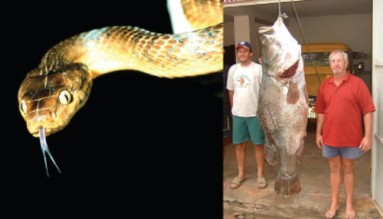
Figure 18.15: Many scientists consider exotic species to be the #2 cause of loss of biodiversity. One of the most infamous, the Brown Tree Snake (left), hitch-hiked on aircraft to Pacific Islands and caused the extinctions of many bird and mammal species which had evolved in the absence of predators. The Nile Perch (right) was intentionally introduced to Lake Victoria to compensate for overfishing of native species. The Perch itself overfished smaller species, resulting in the extinction of perhaps 200 species of cichlids. (3)
Many of these exotic (non-native) species, away from the predation or competition of their native habitats, have unexpected and negative effects in new ecosystems. Freed from natural controls, introduced species can disrupt food chains, carry disease, out-compete natives for limited resources, or prey on native species directly - and lead to extinctions. Some hybridize with native species carefully tuned to local climate, predation, competition, and disease, resulting in genetic pollution which weakens natural adaptations. Others change the very nature of the habitats they invade; Zebra Mussels, for example, colonize most manmade and natural surfaces (including native mussels), filter-feeding so intensely that they increase water clarity and enrich bottom habitats with their waste.
Globalization and tourism are increasing the number of exotics which threaten biodiversity throughout the world, breaking down geographic barriers and threatening the wisdom of millions of years of evolution and natural selection. If current trends continue, our increas- ingly interconnected world will eventually be dominated by just a few fast-growing, highly adaptable, keenly competitive “super-species” rather than the rich diversity we have today. Some biologists, noting that invasive exotics closely resemble what we consider to be “weed” species, have concluded that the world’s #1 weed species is – did you guess it? – none other than Homo sapiens.
www.ck12.org 886
Causes of Extinction #3: Overexploitation
The modern equivalent to overkill, overexploitation threatens fisheries, tropical rain forests, whales, rhinos, large carnivores and many other species. Practices such as clear-cutting old growth forests, strip mining, and driftnet fishing go beyond harvesting of single species or resources to degrade entire ecosystems. Technology-aided over-harvesting has reduced one of the richest fisheries in the world - the Grand Banks off the coast of Newfoundland – to an estimated 1% of what they were in 1977 (Figure 18.16). In 2003 in the journal Nature, Canadian biologists published an analysis of data showing that “industrialized” fishing has reduced large predatory fish worldwide by 90%. Some species’ stocks are so depleted that less desirable species are illegally sold under the names of more expensive ones; in 2004, University of North Carolina graduate students tested DNA from fish sold as “red snapper” from eight states and found that different species made up 77% of the fish tested! Overex- ploitation happens on the level of genes and ecosystems as well as individual species. Forest plantations, fish hatcheries and farms, and intensive agriculture reduce both species diversity and genetic diversity within species.

Figure 18.16: Overexploitation of Atlantic cod threatens one of the world’s most productive fisheries: the Grand Banks off the coast of Newfoundland. (34)
Causes of Extinction #4: Global Climate Change
Our increasing reliance on fossil fuels is altering the Earth’s atmosphere and climate. The effects include acid rain, breaks in the ozone layer shielding us from ultraviolet radiation, and greenhouse gases which raise the Earth’s air and ocean temperatures and sea levels. Burning tropical rain forests compounds the effect, releasing carbon as CO2 and eliminating the forest’s ability to sequester carbon – remove carbon as CO2 from the atmosphere
887 www.ck12.org
via photosynthesis. Inevitably, changing air and water temperatures, rainfall patterns, and salinity threaten species adapted to pre-warming conditions, and biodiversity declines globally. This concern is the topic of the Climate Change Lesson .
Causes of Extinction #5: Overpopulation
In 1960, Earth’s human population stood at 3 billion. By 1999, we had grown to 6 billion. This unprecedented growth, together with developments in technology, has added immense pressure to resource and land use. Overpopulation compounds all of the aforementioned threats to biodiversity, and unequal distribution of resources extends the consequences to social and political instability. Human population growth continues (see the chapter on Bi- ology of Populations). Growth rates vary – ominously, from a biodiversity perspective: the highest rates are in third world tropical countries where diversity is also highest. We have al- ready seen how slash-and-burn agriculture and Lake Victoria fisheries connect socioeconomic changes to loss of biodiversity.
Causes of Extinction #6: Pollution
Pollution adds chemicals, noise, heat or even light beyond the capacity of the environment to absorb them without harmful effects on life. To a certain extent, pollution has not kept pace with population growth, at least in Europe and the US. Startling events such as the oil- and-debris-covered and lifeless Cuyahoga River catching fire in 1969 finally provoked the U.S. to stop viewing air and waterways as convenient dumping grounds for waste. Environmental legislation, including the establishment of the Environmental Protection Agency (EPA) has improved both water and air quality. Heeding the warning provided by the extirpation of the Peregrine Falcon from the Eastern U.S., scientists discovered that many synthetic chemicals concentrate as they move through the food chain (biological magnification), so that toxic effects are multiplied. DDT – the cause of the Peregrine’s decline – was banned in the U.S., and regulation of pesticides was transferred from the Department of Agriculture to the EPA.
And yet, pollution continues to contribute to habitat degradation worldwide, especially in developing countries.
Air Pollution: Knows no boundaries and growing concern about its effects on climate earn this topic two lessons later in this chapter. Acid rain, ozone depletion, and global warming each affect diversity.
Water Pollution: Especially from threatens vital freshwater and marine resources in the US and throughout the world. Industrial and agricultural chemicals, waste, acid rain, and global warming threaten waters which are essential for all ecosystems. Threats to water resources are discussed in Lesson 2.
Soil Contamination: Toxic industrial and municipal wastes, salts from irrigation, and pesticides from agriculture all degrade soils - the foundations of terrestrial ecosys-
www.ck12.org 888
tems and their biodiversity. These and other threats to soils are discussed in Lesson 2, Natural Resources.
Outside the developed world, pollution controls lag behind those of the U.S. and Europe, and developing nations such as China are rapidly increasing levels of pollution. Many pollution problems remain in industrialized countries, as well: industry and technology add nuclear waste disposal, oil spills, thermal pollution from wastewater, light pollution of the night skies, acid rain, and more to the challenges facing Earth’s biodiversity. Many will be discussed in the following lesson on Natural Resources, and you can certainly research more about those which interest or concern you. Our next task will be to switch from the doomsday report of problems and causes to a discussion of what WE – ordinary citizens – can do to help protect Earth’s biodiversity.
Protecting Biodiversity
Consider the following facts from the American Museum of Natural History’s Center for Biodiversity and Conservation (AMNH-CBC) and the Environmental Protection Agency (EPA):
Every year, Americans:
Throw away at least 2 billion disposable razors
Discard enough paper and wood to heat 5 million homes for 200 years
Drink more than two billion gallons of bottled water, costing 900 times more money than tap water – not counting the energy and toxics involved in packaging and shipping
Retire up to 130 million cell phones, containing toxic metals such as arsenic, cadmium, and lead
Generate about 3 million tons of toxic electronics waste (e-waste), and recycle only about 11%
Do any of these everyday experiences apply to you? You may be surprised to learn there is quite a lot you can do to help. Read carefully through the suggestions below, noting those that appeal to you strongly and those which seem most feasible. Many involve little more than awareness in decisions you already or will soon make.
Consume Thoughtfully and Wisely: Reduce Your Consumption Where Possible. Re-use, and Recycle. Make Durability and Effi- ciency Your Criteria for Product Purchases.
In general, when you buy:
889 www.ck12.org
Buy locally whenever possible to reduce transportation costs for you and for the envi- ronment.
Be aware of the natural resources used to make and transport any product you buy.
Substitute other materials for plastics - which are made from petroleum and produce toxic waste.
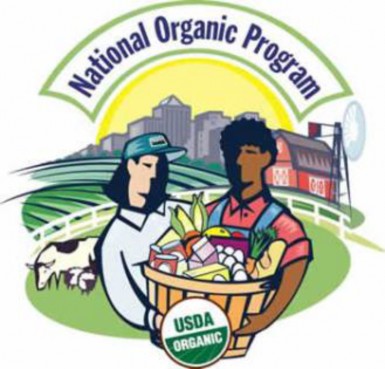
Figure 18.17: Eat with the environment and your health in mind! In the United States, the Department of Agriculture (USDA) sets standards for organic products and certification. The green-and-white seal identifies products which have at least 95% organic ingredients. The program is helpful to consumers, but not without controversy (read Barbara Kingsolver’s Animal, Vegetable, Miracle, and/or Michael Pollan’s Omnivore’s Dilemma). (48)
When you buy food plan your diet for your own health and that of the environment.
Eat low on the food chain. Top carnivores get the least energy and the most poison.
Buy local produce in season – to reduce transportation costs and the need for pesticides.
Buy at farmers’ markets or a Community Supported Agriculture (CSA) programs to support local farmers and reduce demand for energy-consuming and polluting large- scale agriculture and marketing.
Choose organic produce - for your own health and to protect the environment from excessive nutrients and pesticides (Figure 18.17).
www.ck12.org 890
When you buy fish for food or for your aquarium
Check to be sure that commercial species are not from overharvested areas,
Verify that tropical saltwater fish were not collected using cyanide.
When you need paper products, be sure they are made of recycled fiber.
Or consider alternative materials such as hemp, kenaf, cornstarch, or old money or maps.
Replace paper napkins and paper towels with cloth.
Reuse envelopes and boxes. Wrap gifts in the comics or reusable cloth gift bags.
When you buy products for cleaning,painting,or washing your car,check the ingredients to be sure you are not exposing yourself and the environment to unnecessary toxins. Vinegar and baking soda work wonders!
When you buy wood or wood products be sure harvesting followed sustainable forest management – practices which ensure future productivity, biodiversity, and ecosystem health.
Look for SmartWood, FSC (Forest Stewardship Council) or similar labels.
Consider recycled or salvaged wood.
When You Use Water, Remember Its Importance To All Life
Check for water leaks and repair drips with new washers (Figure 18.18).
Use low-flush toilets and low-flow faucets and shower heads.
Have your tap water tested; use filters or refillable delivery if needed, rather than bottled water.
When You Must Use Energy, Consider Consequences and Choose Your Source Carefully
Unplug electronic equipment such as fax machines, power tools, and anything con- nected to a remote control.
Turn off power sources and lights when not in use.
Use your bicycle, and support bike-friendly cities and roads.
Walk! It’s good for you, as well as the environment.
Use public transportation, and support its expansion.
Make energy-efficiency your #1 priority when you purchase appliances.
Make fuel-efficiency your #1 priority if you purchase a car.
Turn down your thermostat, especially at night. Just 2oF saves 500 pounds of greenhouse- inducing CO2!
891 www.ck12.org
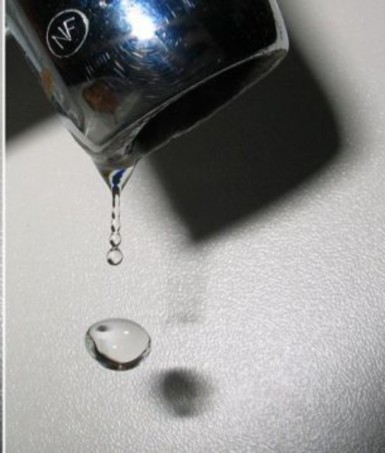
Figure 18.18: One drop per second from a dripping faucet wastes 2,700 gallons of water per year and adds to sewer and/or septic costs, as well. (27)
www.ck12.org 892
Weatherstrip and caulk doors and windows.
Replace incandescent with fluorescent light bulbs, which are four times as efficient and last far longer.
The EPA Energy Star Logo helps consumers to identify energy-efficient products. The less fossil fuel energy we use, the fewer greenhouse gases we release, reducing the threat of climate change.
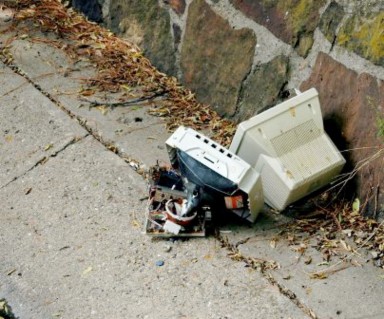
Figure 18.19: Computer equipment becomes obsolete quickly and contains toxins such as lead and mercury. Consider donating your obsolete equipment, and if you must discard it, be sure you follow specific guidelines for recycling and hazardous waste disposal. (20)
When You Must Dispose of Waste, Learn the Best Practice for Its Disposal
Reduce or eliminate your use of plastic bags, sandwich bags, and six-pack plastic rings (and don’t release balloons!) so that endangered sea turtles do not mistake these for their favorite food - jellyfish.
Minimize and compost food waste.
Recycle motor oil and unused paint.
Use appropriate local hazardous waste facilities for recommended chemicals and medicines.
Donate obsolete computers and other electronic equipment – or if you cannot, recycle such “e-waste” properly (Figure 18.19).
893 www.ck12.org
Don’t Contribute to the Burgeoning Problem of Exotic Species
(The following points reference Figure 18.20.)
Don’t release aquarium fish, turtles, birds, or other pets into the wild.
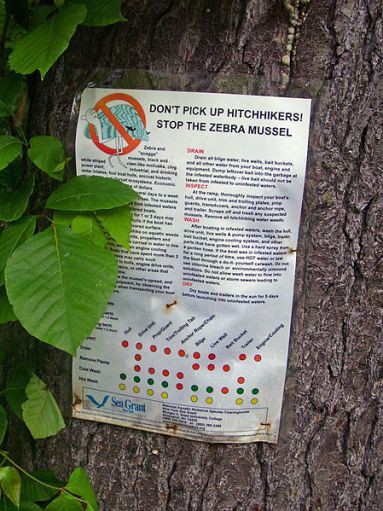
Figure 18.20: Exotic (invasive or alien) species are often considered the #2 cause of extinc- tion. Learn how to avoid transporting them! (26)
Clean your boat thoroughly after use, and avoid traveling with wild plants and animals.
Your pet is also considered to be an exotic species. Don’t let your pets hunt birds or wild animals.
www.ck12.org 894
Practice Sustainable Management on Your Own Land, Even If it is “Only” a Small Yard
Minimize nonpoint source pollution by using organic or natural pesticides and fertiliz- ers.
Plant shade trees for air-conditioning and to absorb CO2.
Water plants and lawns in the evening.
Better yet, use native and/or drought-tolerant plants for landscaping.
Remember that City, County, State, and Federal lands are your lands, too. Get involved in local zoning and land use planning to ensure that development follows sustainable guidelines.
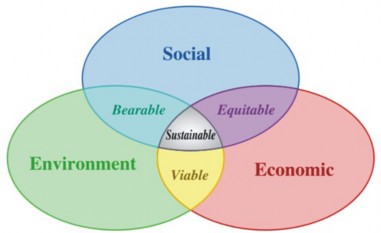
Figure 18.21: Sustainability as a goal in decision-making seeks the intersection of three sets of values. The environmental component includes maintaining ecosystem quality indefinitely. (58)
Adopt and Spread Sustainable Perspectives and Philosophy
Focus on diversity as a whole – genes, communities and ecosystems – rather than single “poster” species.
Support the inclusion of ecosystems services in economic valuations.
Encourage protection of areas large enough to accommodate migration, flooding, buffer zones, pollution from nearby development, and people and their activities.
Realize that inequitable distribution of population, land, resources, education, and wealth threatens biodiversity.
895 www.ck12.org
Promote the concept of sustainability as a guide for conservation decisions (Figure 18.21).
Join philosophers and religious and community groups to explore environmental ethics.
Help everyone understand basic ecology and the wealth of biodiversity shaped by bil- lions of years of evolution.
Learn More!
About the species with which you share the Earth.
About local, national, and international threats to biodiversity
About more solutions as they develop
Jump in! Join local groups which monitor ecosystem health: Frog Watch, River Watch, or Bird Counts.
Educate yourself about complex issues such as government subsidies and new tech- nologies.
Find out about local protected lands and volunteer your time and energy to restore native ecosystems.
Activate!
Exercise your citizenship to protect biodiversity. Vote, communicate your views, and push for stronger environmental protection laws.
Support organizations which promote national reserves, international treaties, and re- source conservation.
Support efforts by zoos, arboretums, museums and seed banks to help maintain genetic diversity through research, breeding, educational, and fundraising programs.
Lesson Summary
Like all species, humans depend on land, water, air, and living resources for food, energy, clothing, and ecosystem services such as nutrient recycling, waste disposal, and renewal of soil, freshwater, and clean air.
Unlike other species, human technology supplements “natural” energy resources with fossil fuels and exploits both biotic and abiotic resources and produces wastes beyond the biosphere’s capacity for renewal.
Biodiversity encompasses all variation in living systems, including genetic, species, and ecosystem diversity.
Scientists do not know how many species currently inhabit the Earth; the vast majority of Bacteria and Archaea, Protists and Insects, are probably unknown. We discover new species of animals, plants, and fungi each year.
www.ck12.org 896
About 1.8 million species have been identified, and most estimates of Earth’s overall species biodiversity fall between 5 and 30 million.
In general, biodiversity is highest near the equator, and decreases toward the poles.
Biodiversity “hotspots” such as the California Floristic Province and unique habitats such as bogs occasionally disrupt the overall pattern.
The fossil record and DNA analysis reveal a gradual increase in Earth’s biodiversity after the first prokaryotes appeared roughly 4 billion years ago.
Within the past 600 million years, a more detailed fossil record shows increasing bio- diversity interrupted by five major extinctions in which at least 50% of species disap- peared.
According to a 1998 survey by the American Museum of Natural History, more than 70% of biologists consider the present era to be a sixth mass extinction event.
Many scientists regard the Ice Age extinctions of large birds and mammals as the beginning of a continuum of extinctions caused by human activity which extends to the present.
Dramatic losses of large mammal species follow a pattern of human dispersal across the globe from tens of thousands of years ago in Indonesia to just over 1,000 years ago in New Zealand, and over 20% of all bird species have become extinct within the past 1,100 years.
Rates of extinction have accelerated in the past 50 years; current estimates include 3 species per hour and as many as 140,000 per year.
In 2002, Harvard biologist E.O. Wilson predicted that if current rates of extinction continue, 50% of plant and animal species will be lost within the next 100 years – com- pared to hundreds of thousands or even millions of years for previous mass extinctions.
Direct economic benefits include the potential to diversify our food supply, resources for clothing,shelter, energy, and medicines, a wealth of efficient designs which could inspire new technologies, models for medical research, and an early warning system for toxicity.
Ecosystem services provided by biodiversity include ecosystem stability and produc- tivity; maintaining and renewing soils, water supplies, and the atmosphere; nitrogen fixation and nutrient recycling; pollination, pest and disease control, and waste dis- posal.
Less tangible but equally important are the cultural, aesthetic, and spiritual values and the importance of biodiversity to many modes of recreation.
Finally, many people believe that biodiversity has intrinsic value, inherent in its exis- tence.
Human hunting, secondary effects on other species, disease carried and predation by exotic animals, and habitat destruction contributed to Ice Age extinctions.
Habitat loss, including degradation and fragmentation, is the primary cause of extinc- tion today; agriculture and deforestation continue to claim vegetated land and pollute both fresh and salt water seas.
Slash-and-burn agriculture is destroying tropical forest at rates which could result in
897 www.ck12.org
total loss by 2090.
In the U.S., agriculture has eliminated 50% of wetlands and 99% of tallgrass prairies.
Logging and development have destroyed more than 90% of Temperate Rainforest in the U.S.
Exotic species disrupt food chains and entire ecosystems to contribute to extinction.
The modern equivalent to overkill, overexploitation of economically important species and ecosystems, threatens fisheries, tropical rain forests, whales, rhinos, large carni- vores and many other species.
Global climate change caused by the burning of fossil fuels disrupts weather patterns and, as it has throughout Earth’s history, holds the potential to force the extinction of carefully adapted species.
Pollution of land, air, and water poisons life and destroys ecosystems.
Between 1960 and 1999, the Earth’s human population increased from 3 billion to 6 billion people. Overpopulation combined with unequal distribution of resources dra- matically intensifies pressures on biodiversity.
Our daily activities and decisions can significantly help to protect biodiversity.
After reducing consumption and reusing and recycling, careful consumption can help to conserve ecosystems.
Local, seasonal products save energy costs for transportation.
Durable and efficient products reduce long-term resource consumption.
Wise use of water resources helps to prevent desertification of ecosystems.
Energy alternatives to fossil fuels reduce greenhouse gases, although nuclear energy has its own dangers.
After minimizing waste, best practices for waste disposal ensure less pollution of ecosys- tems.
The threats to biodiversity posed by exotic species mean that everyone should learn to avoid transporting them.
Sustainable management of land, from small yards to local, state, and federal lands, conserves ecosystems.
Sustainability as a guide for decision-making balances social, economic, and environ- mental values to structure human activities such that they can continue indefinitely.
Learning about biodiversity and ecology is an important part of valuing and protecting the diversity of life.
Voting, membership in conservation organizations, and working toward protective leg- islation can contribute to genetic, species, and ecosystem diversity.
www.ck12.org 898
Review Questions
Compare humans to other species in terms of resource needs and use and ecosystem service benefits and effects.
Define biodiversity and explain its three major components.
Give the three quantitative values for Earth’s species diversity, and compare biodiver- sity across the Earth’s surface and throughout the history of life.
Construct a chart showing why you consider biodiversity important. Your chart should include four categories (of the five presented in the chapter, or of your own choosing) and the 2-3 examples from each chapter that you consider most critical).
Analyze humans’ role in extinctions by comparing the causes we think contributed to the Ice Age extinctions to the causes important to extinction today.
How might Tallgrass Prairies, the Brown Tree Snake, the Atlantic Cod, and the Pere- grine Falcon serve as “poster species” to explain and highlight some of the causes of extinction?
“Reduce, Re-use, and Recycle” is so familiar to many people that it has lost much of its meaning. Yet it remains an efficient summary of the best conservation principles. Explain. Choose one new idea to add to these workhorses.
What two (or three) ecological principles can govern your food choices to help protect your health, biodiversity, and even global stability?
How does the concept of sustainable use differ from “reduce, re-use, and re-cycle”? How is it similar?
According to Barry Commoner, there are Four Laws of Ecology:
Everything is connected to everything else.
Everything must go somewhere.
Nature knows best.
There is no such thing as a free lunch.
Explain how his laws govern the way nature does – and humans should – use energy and material resources in order to protect biodiversity.
Further Reading / Supplemental Links
Aldo Leopold, Round River: from the Journals of Aldo Leopold. Ed: Luna B. Leopold, 1953, Oxford University Press, New York.
Aldo Leopold, Thinking Like a Mountain.
Center for Biodiversity and Conservation, Living With Biodiversity: What You Can Really Do For the Environment. American Museum of Natural History, 2007. Available online at:
http://research.amnh.org/biodiversity/center/living/intro/index.html
Biodiversity and Your Food at:
http://research.amnh.org/biodiversity/center/living/Food/index.html
899 www.ck12.org
Biodiversity and Your Water Supply at:
http://research.amnh.org/biodiversity/center/living/Water/index.html
Biodiversity and Your Energy Use at:
http://research.amnh.org/biodiversity/center/living/Energy/index.html
Biodiversity and What You Buy at:
http://research.amnh.org/biodiversity/center/living/Buy/index.html
Joan Chevalier, Joel Cracraft, Francesca Grifo, and Curt Meine. Biodiversity, Science, and the Human Prospect. Center for Biodiversity and Conservation of the American Museum of Natural History, 1997. Available online at:
http://cbc.amnh.org/center/pubs/pubscbc.html
Curt Meine, Humans and other Catastrophes: Perspectives on Extinction. Center for Biodiversity and Conservation of the AMNH, editors Marc Lecard, Valeda Slade, 1999. Available online at
Francesca Grifo and Joshua Rosenthal, editors, Biodiversity and Human Health: A guide for policymakers. Center for Biodiversity and Conservation of the AMNH, 1997. Available online at:
http://www.amnh.org/education/resources/card_frame.php?rid=1282& rurlid=1197
Melanie Stiassny, It Takes All Kinds to Make A World (Marine Biodiversity). AMNH
Center for Biodiversity and Conservation Resources for Learning. Available online at:
http://www.ology.amnh.org/marinebiology/ittakesallkinds/index.html
The World Conservation Union (IUCN), 100 of the World’s Worst Invasive Alien Species: A Selection from the Global Invasive Species Database. Invasive Species Spe- cialist Group (ISSG), Auckland, New Zealand, nd. Available online at:
http://www.iucn.org/places/medoffice/invasive_species/docs/invasive_species_ booklet.pdf
Daniel P. Faith, Biodiversity. Stanford Encyclopedia of Philosophy, Metaphysics Re-
search Lab, CSLI, Stanford University, 2003. Available online at:
http://plato.stanford.edu/entries/biodiversity/
Cox, Tony, Dead zone is price gulf coast pays as farms cash in on ethanol. Bloomberg.com, 23 July 2007. Available online at:
http://www.bloomberg.com/apps/news?pid=20601109&sid=a4Tb2AFv6CRk&# 38;amp;refer=home
The Grand Banks and the Flemish Cap, in Overfishing and International Ocean Fish-
eries Governance, Government of Canada, 23 January 2007. Available online at
http://www.dfo-mpo.gc.ca/overfishing-surpeche/media/bk_grandbanks_e.htm
Chensheng Lu, Kathryn Toepel, Rene Irish, Richard A. Fenske, Dana B. Barr, and Roberto Bravo, Organic Diets Significantly Lower Children’s Dietary Exposure to Organophosphorus Pesticides. Environmental Health Perspectives Online, 1 Septem- ber 2005. Available online at
http://www.ehponline.org/members/2005/8418/8418.pdf
J. Emmett Duffy, Biodiversity. Encyclopedia of the Earth, last updated 30 October
www.ck12.org 900
2007. Available online at:
http://www.eoearth.org/article/Biodiversity
What Percent of Municipal Solid Waste (MSW) is Electronics? eCycling, US Environ- mental Protection Agency, last updated 6 November 2007. Available online at:
http://www.epa.gov/epaoswer/hazwaste/recycle/ecycling/faq.htm#cell
Crop Genetic Diversity and Domestic Animal Diversity Biological Diversity in Food and Agriculture, Food and Agriculture Organization of the United Nations, nd. Available online at:
http://www.fao.org/biodiversity/
David Tilman and John A. Downing, Biodiversity and stability in grasslands. Nature
367, 363 - 365 (27 January 1994). Available online at:
http://www.nature.com/nature/journal/v367/n6461/abs/367363a0.html
David Tilman, David Wedin & Johannes Knops, Productivity and sustainability in- fluenced by biodiversity in grassland ecosystems. Nature 379, 718 - 720 (22 February 1996). Available online at:
http://www.nature.com/nature/journal/v379/n6567/abs/379718a0.html
Ransom A. Myers and Boris Worm, Rapid worldwide depletion of predatory fish com- munities. Nature 423, 280-283 (15 May 2003). Available online at:
http://www.nature.com/nature/journal/v423/n6937/abs/nature01610.html
Facts about Coral Reefs, Coral Reefs of the Tropics. The Nature Conservancy, 2007. Available online at:
http://www.nature.org/joinanddonate/rescuereef/explore/facts.html
Joseph Priestley, Experiments and Observations on Different Kinds of Air. Book IX, Experiments and Observations related to Vegetation and Respiration, 1790. Available online at:
http://www.spaceship-earth.org/OrigLit/JP3-911.htm
Nitrogen Pollution and Agriculture WikiStrategy, Nitrogen Wiki, Nitrogen Pollution and Agriculture: A Collaborative Strategy Forum hosted by the David and Lucile Packard Foundation. Available online at:
https://nitrogen.packard.org/Nitrogen%20Wiki/Home.aspx
Ian Harrison, Melina Laverty, Eleanor Sterling, Species Diversity. Connexions, last edited 29 July 2004. Available online at:
http://cnx.org/content/m12174/latest/
James Gibbs, The Importance of Biodiversity: An Exercise. Connexions, last edited 14 July 2004. Available online at:
http://cnx.org/content/m12175/latest/
http://www.amnh.org/education/resources/card_frame.php?rid=1121& rurlid=1066
http://www.gbif.org/
http://www.eol.org/home.html
http://www.sp2000.org/index.php?option=com_content&task=view& amp;id=76&Itemid=73
901 www.ck12.org
http://www.itis.gov/
http://www.actionbioscience.org/newfrontiers/eldredge2.html
http://www.sciam.com/askexpert_question.cfm?articleID=000B012D-7016-1C72-9EB7809EC5 38;amp;catID=3&topicID=3
http://www.environment.gov.au/biodiversity/publications/series/paper1/index.
html#1.1
http://stort.unep-wcmc.org/imaps/gb2002/book/viewer.htm
http://www.greenfacts.org/en/biodiversity/biodiversity-greenfacts-level2. pdf
http://www.biodiversityproject.org/biodiversity.htm
http://ology.amnh.org/biodiversity/
http://www.biodiversity911.org/
http://www.motherjones.com/commentary/columns/2007/03/iwaste.html
http://www.eco-action.org/dt/thinking.html
http://en.wikipedia.org
Vocabulary
air pollution Alteration of the Earth’s atmosphere by chemical, particulate, or biological materials.
biodiversity hotspot A biogeographic region which has lost at least 70% of its original habitat, yet contains at least 1500 endemic species of vascular plants.
biodiversity Variation in life – at all levels of organization: genes, species, and ecosystems.
biological magnification (food chain concentration) The process in which synthetic chemicals concentrate as they move through the food chain, so that toxic effects are multiplied.
bionics Engineering which uses biological organisms’ design principles to develop efficient products.
carbon sequestration Process which removes CO2 from the atmosphere. desertification Degradation of formerly productive land (usually at least semi-arid). ecosystem diversity The variety of ecosystems on Earth.
ecosystem services Indirect benefits provided by ecosystem processes, such as nutrient cycling and waste disposal.
www.ck12.org 902
ecosystem A functional unit comprised of living things interacting with their nonliving environment.
endemic A unique species found only within a certain area and nowhere else.
epiphyte Plant which grows on top of another plant.
exotic (alien) species A species introduced either intentionally or unintentionally to a completely new ecosystem – a non-native species.
extirpation Elimination of a species from a particular region of its range.
genetic diversity Variation among individuals and populations within a species.
genetic pollution Hybridization or mixing of genes of a wild population with a domestic or feral population.
global warming The recent increase in the Earth’s average near-surface and ocean tem- peratures.
greenhouse effect The trapping by the atmosphere of heat energy radiated from the Earth’s surface.
keystone species Species having a functional importance to ecosystem diversity and sta- bility which far outweighs its numerical or mass importance.
monoculture Large-scale cultivation of single varieties of single species.
natural resource Something supplied by nature which supports life, including sources.
pollution Release into the environment of chemicals, noise, heat or even light beyond the capacity of the environment to absorb them without harmful effects on life.
salination Increase in salt levels in soils.
species diversity The number of different species in an ecosystem or on Earth.
sustainable forest management Forest management which ensures that the goods and services yielded from a forest remain at a level that does not degrade the environment or the potential for similar levels of goods and services in the future.
sustainable use Use of resources at a rate which meets the needs of the present without impairing the ability of future generations to meet their needs.
903 www.ck12.org
Points to Consider
Most of this lesson considered species and ecosystem diversity. Why is genetic diversity also very important?
How does biodiversity in your area compare to the general global pattern of biodiver- sity? Give some reasons why it may or may not follow general trends.
Choose one other area in which you are interested, and make the same comparison.
Do you find the extinction statistics presented in this lesson alarming? Why do you think we don’t hear more about the Sixth Extinction and the predicted loss of biodi- versity?
Which values of biodiversity do you feel are most compelling?
Which solutions will you adopt in your daily life?
Lesson 18.2: Natural Resources
Lesson Objectives
Distinguish between renewable and non-renewable resources.
List the major energy and material resources upon which humans depend.
Discuss the stresses increasing human consumption places on resource renewal.
Sequence the events which lead to the formation of fossil fuels.
Assess levels of depletion of non-renewable energy resources.
Analyze the ways in which technology and consumption result in overharvesting, pol- lution, atmospheric changes, and habitat loss.
Evaluate the effects of population growth on resource use and environmental pollution.
Relate inequalities in resource distribution to global political stability.
Compare the concept of sustainable use to that of renewable vs. nonrenewable re- sources.
Describe the nature and uses of soil resources.
Describe how human activities including technology affect ecosystem services such as
Soil generation
Waste disposal
Nutrient cycling
Recycling dead organic materials
Fertility of the land
Discuss effects of population growth, technology, and consumption on land and soil resources.
Relate soil erosion, pollution, and land development to ecosystem stability.
Connect soil erosion, pollution, and land development to global stability. www.ck12.org 904
Evaluate the effects of changes in these services for humans.
Review conflicts between agricultural technology, environment, and society.
Recognize tradeoffs required by nuclear power plants: reduced emissions vs. radioactive fuels and waste.
Analyze the ways in which humans have altered soil and land resources for other species.
Identify the extent of terrestrial ecosystem loss, and its effects on biodiversity.
Interpret the effects of soil pollution on biodiversity.
Describe how human activities including technology affect ecosystem services such as:
The hydrologic cycle
Waste disposal
Nutrient cycling
Evaluate the effects of changes in these services for humans.
Discuss the effects of population growth, technology, and consumption on water re- sources.
Explain the effects of overdrafting, pollution, and atmospheric changes on ecosystem stability.
Relate overdrafting and pollution to global stability.
Analyze the ways in which humans have altered water resources for other species.
Identify the extent of wetland loss, and its effects on biodiversity.
Interpret the effects of water pollution on biodiversity.
Introduction
Defining natural resources raises important philosophical questions.
“Resources” are useful or valuable. But are resources useful for and valuable to humans – or all life? If we “use” them, do we necessarily “consume” them? Is value limited to economics? Are resources limited to materials, or can they include processes, systems, and living things?
Definitions of “natural” go straight to the heart of our views about ourselves. Most definitions include a tension or conflict between the human and the non-human parts of the Earth: Anything that is natural is “not altered or disguised,” “not produced or changed artificially,” or, rather unhelpfully, “found in nature.” We often define nature as separate from humans: “the world of living things and the outdoors” or with elements of inner conflict (“a primitive state of existence, untouched and uninfluenced by civilization or artificiality”) or even religion (“humankind’s natural state as distinguished from the state of grace”).
It is not an idle exercise to think carefully about your own definition of natural resources, because such thinking can clarify your relationship and responsibilities to the Earth. Do natural resources exist only for humans to use (or “exploit” – a term repeated in many
905 www.ck12.org
definitions)? Are we apart from nature, or a part of nature? In what ways are we similar to other species? How are we different? How do those similarities and differences help us to define our responsibilities to “nature” – to other species and our physical environment?
Historically, the concept of natural resources was intended as a measure of respect and appreciation for the materials Earth provided, and the supplies humans used and modified to develop the civilization in which they lived. Economic value was primary, and a list of natural resources would include energy sources such as coal or oil and raw materials such as iron or copper. Living things could be, but often were not added: fibers from plants, and skins from animals.
As use became exploitation and later depletion, we began to better appreciate our depen- dence on natural resources, as well as our power over them. Economist E.F. Schumacher, in a 1973 series of essays titled Small is Beautiful, suggested that our economy is unsustainable because natural resources (especially energy) can be depleted. He made the case that natural resources should be considered capital, rather than expendable – conserved, rather than sim- ply used. He also argued that nature’s capacity to resist pollution is limited, pointing to the value of whole ecosystems and ecosystem services. During the 1990s, ecological economist Robert Constanza calculated that “nature’s services” were worth $33 trillion per year – more than the $25 trillion total of the inter-human economy at that time. Although awareness of resource depletion and ecosystem services is increasing, their values remain inadequately recognized by our economy, and sustainability remains a goal for the future.
What definition for natural resources shall we use? On the Department of Energy’s “Ask a Scientist” website, Bob Hartwell defines a natural resource as “something supplied by nature which supports life on this planet.” This concise description includes most of the ideas we’ve discussed above, and views human use with an ecological perspective appropriate for the study of biology. Humankind is a part of nature, one species in an interdependent web which includes the Earth and all life. Without question, we are a unique species: we have the power to change that interdependent web in ways no other species can, we have the ability to learn about and understand the patterns and processes which maintain the web, and we have the responsibility to use our natural resources together with that understanding in ways which sustain the web – for our ourselves and for all life.
Most biologists today would probably classify ecosystems, their processes and “services,” and their species as natural resources, together with energy sources and materials from the environment. Biodiversity (which includes both species and ecosystems) is certainly a natural resource, according to this definition. In this sense, this entire chapter explores natural resources. The first lesson dealt with biodiversity as well as some of the ecosystem services which depend on biodiversity. This lesson will focus on energy, land and soil, and water resources. Because several unique problems (acid rain and ozone depletion, for example) apply to atmospheric resources, we will focus on the atmosphere in a third lesson. A final lesson will combine our concerns about the closely related issues of energy use and atmospheric change to focus on climate change. These lessons will by no means address all natural resources, but they should give you an overview of the complexities of and need
www.ck12.org 906
for sustainable use, and provide you with some detailed insight into several major problems.
Renewable and Nonrenewable Resources: Energy and Sus- tainable Use
Applied to natural resources, renewable or non-renewable are relative rather than pre- cise terms. Not surprisingly, we use human parameters to classify resources into these two categories.
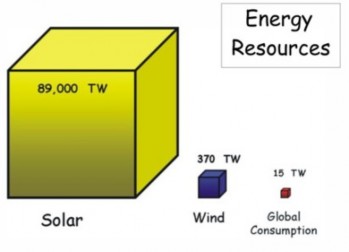
Figure 18.22: Solar radiation and wind energy are considered renewable resources because their availability far exceeds our rates of consumption. Here, availability is shown as volume equal to the annual flux in terawatts (1 TW = 1012 watts). Eighty-nine thousand TW represents the amount of sunlight that falls on the Earth’s surface, 370 TW depicts all the energy in the wind, and 15 TW was the global rate of energy consumption in 2004. (61)
A resource replenished by natural processes at a rate roughly equal to the rate at which humans consume it is a renewable resource. Sunlight and wind, for example, are in no danger of being used in excess of their longterm availability (Figures 18.22, 18.23). Hydropower is renewed by the Earth’s hydrologic cycle. Water has also been considered renewable, but overpumping of groundwater is depleting aquifers, and pollution threatens the use of many water resources, showing that the consequences of resource use are not always simple depletion. Soils are often considered renewable, but erosion and depletion of minerals proves otherwise. Living things (forests and fish, for example) are considered renewable because they can reproduce to replace individuals lost to human consumption. This is true only up to a point, however; overexploitation can lead to extinction, and overharvesting can remove nutrients so that soil fertility does not allow forest renewal. Energy resources derived from living things, such as ethanol, plant oils, and methane, are considered renewable, although their costs to the environment are not always adequately considered. Renewable
907 www.ck12.org
materials would include sustainably harvested wood, cork, and bamboo as well as sustainably harvested crops. Metals and other minerals are sometimes considered renewable because they are not destroyed when they are used, and can be recycled.

Figure 18.23: Wind power is considered a renewable resource because the rate of supply far exceeds the rate of use (Figure 18.22). Although current use supplies less than 1% of the world’s energy needs, growth in harvesting wind energy is rapid, with recent annual increases of more than 30 percent. (53)
A non-renewable resource is not regenerated or restored on a time scale comparative to its consumption. Non-renewable resources exist in fixed amounts (at least relative to our time frame), and can be used up. The classic examples are fossil fuels such as petroleum, coal, and natural gas. Fossil fuels have formed from remains of plants (for coal) and phyto- and zoo-plankton (for oil) over periods from 50 to 350 million years. Ecologist Jeff Dukes estimates that 20 metric tons of phytoplankton produce 1 liter of gasoline! We have been consuming fossil fuels for less than 200 years, yet even the most optimistic estimates suggest that remaining reserves can supply our needs for
Oil: 45 years
Gas: 72 years
Coal: 252 years.
Nuclear power is considered a non-renewable resource because uranium fuel supplies are finite. Some estimates suggest that known economically feasible supplies could last 70 years at current rates of use - although known, and probably unknown reserves are much larger, and new technologies could make some reserves more useful.
Recall that the Second Law of Thermodynamics (which states that the entropy of an isolated system which is not in equilibrium will tend to increase over time) reinforces this view
www.ck12.org 908

Figure 18.24: Global energy use includes mostly non-renewable (oil, coal, gas, and nuclear) but increasing amounts of renewable (biomass, hydro, solar, wind, geothermal, biofuels, and solar photovoltaic) resources. (11)
of “renewable” and “non-renewable” resources: Energy flows downhill – gets used up, is transformed into heat; only materials that can be recycled are “renewable.” It is only our time scale which makes any form of energy renewable. Eventually, the sun will burn out, as well.
Population growth, industrialization of developing countries, and advances in technology are placing increasing pressures on our rates of consumption of natural resources. Pollution and overexploitation foreshadow resource depletion, habitat loss, and atmospheric change. Unequal distribution of wealth, technology, and energy use (Figure 18.25) suggest that developing nations will further increase demands on natural resources. With these increases in demand, current levels of resource use cannot be maintained into the future, and social and political instability may increase. Improvements in technology could mitigate these problems to some extent.
The concept of renewable vs. non-renewable resources clearly depends on rates of human use (Figure 18.24); less clearly, its usefulness depends on the effects of use on other natural resources, such as pollution. Of course, we could change our rates of consumption. Indeed, if we increase our rate of consumption, renewable resources may need to be reclassified as non- renewable. This is the foundation of the concept of sustainable use – use of resources at a rate which meets the needs of the present without impairing the ability of future generations to meet their needs. Notice that this concept continues to focus on human needs; however, a solid understanding of ecology recognizes that human needs depend on entire ecosystems,
909 www.ck12.org

Figure 18.25: Per capita energy consumption illustrates the unequal distribution of wealth and natural resource use which threatens long-term resource supplies as developing nations demand higher standards of living. These inequalities threaten not only resource supplies but also global political stability. (28)
which in turn depend on all species. Sustainable use could also apply to ecosystem services, which can be overwhelmed by overuse even though their “use” does not involve consumption. Perhaps we should shift our natural resource focus from rate of consumption (renewable vs. non-renewable) to sustainable use!
Soil and Land Resources
What negative connotations we give to soil resources in our daily conversation! Hands are “dirty;” clothing is “soiled.” Yet the formation of soils require thousands and even millions of years of physical, geological, chemical, and biological processes. Soil’s complex mixture of eroded rock, minerals, ions, partially decomposed organic material, water, air, roots, fungi, animals, and microorganisms supports the growth of plants, which are the foundation of terrestrial ecosystems (Figure 18.26). Soil is a balanced intersection of air, water, and land resources, sensitive to changes in any one element. We use soils for agriculture, gardening, landscaping, earth sheltered buildings, and to absorb waste from composting and septic drain fields. Peat, an accumulation of partially decayed plant material, can be burned for energy.
Soils can assimilate and remove low levels of contamination, thus it is useful for waste treat- ment. Not surprisingly, high levels of contamination can kill soil microorganisms, which help to accomplish this service. Toxics from industry, underground storage tanks, pesticide use, and leaching from landfills and septic tanks contaminate soils across the globe. Contami- nated soils endanger human and ecosystem health.
www.ck12.org 910
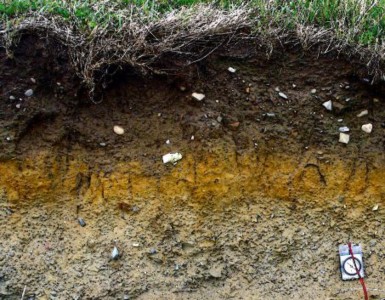
Figure 18.26: Soil resources are a complex mixture of eroded rock, minerals, ions, partially decomposed organic material, water, air, roots, fungi, animals, and microorganisms, formed over thousands or even millions of years. (42)
In 1980, after several years of health concerns and protests, the U.S. Government relocated and reimbursed 800 families from the Love Canal housing development built atop a landfill which had “disposed of” 22,000 tons of toxic waste from Hooker Chemical and Plastics Corporation. Increased awareness of the problems of abandoned toxic waste sites led to the passage later that year of Superfund legislation, which holds polluters accountable for effects of toxic waste, and taxes chemical and petroleum industries to pay for cleanup of sites where responsible parties cannot be identified. As of early 2007, the EPA listed 1,245 Superfund sites; 324 are delisted, and 66 new sites are proposed. In general, developing countries lag behind in identification, cleanup, and prevention.
Agriculture, as one of the largest land uses, has altered soils in a number of ways. When we harvest crops repeatedly from soil, we remove basic ions such as Calcium, Magnesium, Potassium, and Sodium. One result is acidification, which lowers soil fertility and produc- tivity. Acid rain and the use of nitrogen fertilizers accelerate acidification, and acid rain can increase soil contamination.
Irrigation can degrade soils through salination – the accumulation of salts. High concen- trations of salt make it difficult for plants to absorb water by osmosis, so salination reduces plant growth and productivity, and can lead to desertification (degradation of formerly productive land – usually at least semi-arid) and soil erosion.
Agriculture, deforestation, overgrazing, and development can remove vegetation to cause unnatural levels of erosion by wind and water. In the U.S., erosion forced its way into public
911 www.ck12.org
awareness during the 1930s after drought compounded exposed soils. The famous Dust Bowl (Figure 18.27) resulted in the loss of at least 5 inches of topsoil from nearly 10 million acres of land and the migration of 2.5 million people out of the Great Plains. Today in the U.S., contour plowing, cover crops, terracing, strip farming, no-till farming, reforestation, and better construction practices prevent some soil erosion (Figure 18.28), but the USDA reports that 1.6 billion metric tons of topsoil were lost annually between 1997 and 2001. Since Great Plains agriculture began some 200 years ago, the U.S. has lost one-third of its topsoil. Alarming rates of slash-and-burn agriculture in tropical forests expose thin soils to erosion, and development in China sends 1.6 billion tons of sediment annually into the Yellow River.

Figure 18.27: Soil erosion in the U.S. peaked during the Dust Bowl years of 1933-1939. Intense dust storms (left) shifted vast quantities of unprotected rich prairie soil (right) – much of it all the way into the Atlantic Ocean. (16)
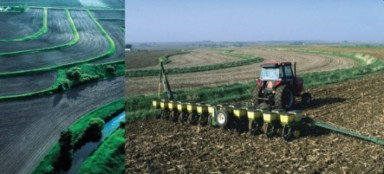
Figure 18.28: Conservation practices such as terracing, contour plowing and conservation buffers (left) and conservation tillage (right) prevent soil erosion and improve water quality. (9)
With – or sometimes without – its soil, land resources are used by humans for agriculture, forestry, mining, industry, waste disposal, and cities. Modification of land for these uses inevitably alters ecosystems, and in many cases, the resulting urban sprawl, pollution, sali- nation, erosion, and/or desertification lead to the loss of species, as well. As you learned in the lesson on biodiversity, habitat loss is the primary cause of extinction. Within the past
www.ck12.org 912
100 years, the area of land cultivated worldwide has increased 74%; grazing land increased 113%. Agriculture has cost the United States 50% of its wetlands and 99% of its tallgrass prairies. Land changes also result in fragmentation, yet another threat to biodiversity. Pres- sures from population growth cause the loss of land for human use, as well: ecologist David Pimental reports that erosion and salination destroy more than 2 million acres of prime agricultural land each year, and urban growth, transportation systems, and industry remove a million additional acres from production. Global increases in cropland and pasture from 1700 to 1990 are shown in Figure 18.29.
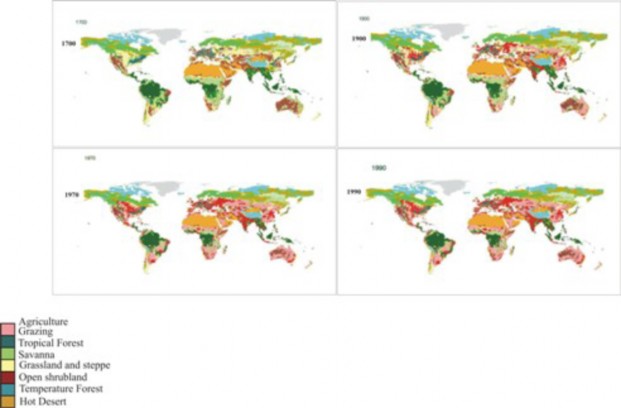
Figure 18.29: Changes in land use from 1700 to 1990 show the conversion of forests, grass- lands, steppes, shrubland, and savannas to cropland (red) and grazing (pink). (47)
Land use changes affect global processes as well as the ecosystems they directly involve. Deforestation – even if it is replaced by agriculture – reduces photosynthesis, which means that less CO2 is removed from the atmosphere. The result is that CO2 builds up – and as you will see in the fourth lesson of this chapter, an increase in CO2 means an increase in the greenhouse effect and global warming. The International Panel on Climate Change (IPCC) estimates that land use change contributes 1.6 gigatons of carbon (as CO2) per year to the atmosphere. This is highly significant when compared to the better-known fossil fuel-burning carbon contributions of 6.3 gigatons.
913 www.ck12.org
Urbanization and industry contribute to yet another land use issue that affects water re- sources and the atmosphere. Increasingly, impervious surfaces such as parking lots, building roofs, streets and roadways are covering land areas. Impervious surfaces prevent water infil- tration and groundwater recharge, increasing runoff and altering waterways. They deprive tree roots of aeration and water, decreasing productivity and increasing CO2. Far more than vegetated surfaces, they absorb solar radiation and convert it to heat, increasing runoff, which eventually degrades streams. In the U.S., impervious surfaces cover an area almost as large as the state of Ohio. Solutions to this harmful impact include the development of porous pavements and green roofs (Figure 18.30).
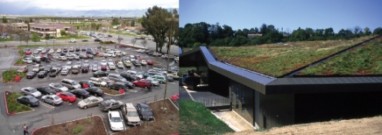
Figure 18.30: Impervious surfaces (left) fragment habitats, increase runoff, degrade water sources, reduce photosynthesis, and effectively increase CO2 in the atmosphere. In the U.S., they cover an area of land almost the size of Ohio. Permeable pavements and green roofs (right) are beginning to reverse their effects. (14)
Water Resources
At the intersection of land and water resources are wetlands: swamps, marshes and bogs whose soil is saturated (Figure 18.31). Historically, humans have viewed wetlands as wasted land; the U.S. has lost as much of 50% of its wetlands to agriculture, development, and flood control. Recently, wetland loss and the loss wetland species has taught us the importance of this ecosystem. Ecosystem services provided by wetlands include:
water storage and replenishment of aquifers
protection of coastlands from tides and storms
flood control
water purification I: slowing of water flow allows sedimentation to remove particulates
water purification II: denitrification of excess nutrients
rich habitat for wildlife
rich habitat for plants (30% of U.S. plant diversity)
recreation: hunting, fishing, ecotourism (e.g., The Everglades)
In the U.S., at least, recognition of the economic value and biodiversity of wetlands has led to restoration efforts and requirements for replacement of those lost through development.
www.ck12.org 914
The Ramsar “Convention on Wetlands of International Importance, especially as Waterfowl Habitat,” signed by 18 nations in 1971, works to conserve wetlands throughout the world for their ecological services and their economic, scientific, cultural, and recreational values. Signatories today number 157, and they meet every 3 years.
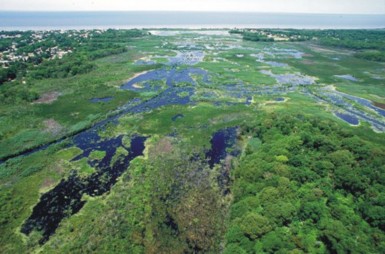
Figure 18.31: Wetlands such as this area in Cape May, New Jersey, filter water both physi- cally and chemically, protect coastal lands from storms and floods, and harbor an exceptional diversity of plants and animals. (57)
Water is the quintessential resource of life; its unique physical, chemical and biological prop- erties make it difficult for us to imagine life on any planet which lacks liquid water. For human use, however, water must be fresh. About 97% of Earth’s water is found in the oceans. Of the 3% which is fresh water, over 2/3 is locked in ice. The 1% which is fresh liquid water is mostly below ground, leaving just 0.3% as surface water in lakes and rivers (Figure 18.32). The atmosphere contains just .001%.
As industry, agriculture, development, and a growing world population use more water, fresh water supplies are shrinking due to over-drafting of groundwater and pollution of surface and groundwater. Over-drafting has lowered water tables in Texas, California, and India, leaving many wells dry. New Orleans is below sea level, and San Jose, California dropped 13 feet, because over-pumping caused the land to subside. The UN and others have labeled the current state of water resources throughout the world a Water Crisis (Figure 18.33). You might wonder why we don’t tap the oceans; the answer is that desalination is extremely costly in terms of energy and economics. The UN estimates that 1.1 billion people worldwide are without adequate fresh water, and that 2.6 billion lack enough water for sanitation to protect from disease. Water conflicts in the Middle East, Eastern Europe, and Korea have threatened regional political stability.
Water pollution, especially from nonpoint sources or runoff, threatens vital freshwater and marine resources in the U.S. and throughout the world. A single example dramatically
915 www.ck12.org
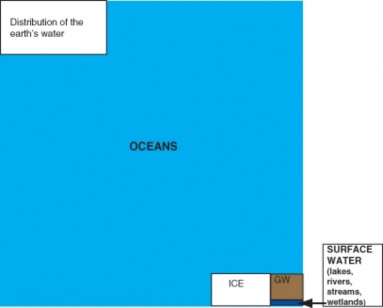
Figure 18.32: Earth is a watery planet, but only 3% is fresh water, and 2/3 of that is locked in ice. A little less than 1/3 is groundwater (GW), leaving 0.3% in surface water – the bright blue in the diagram above. (17)
illustrates the potential for disruption of natural cycles and loss of biodiversity. Runoff of fertilizers applied to vast expanses of agricultural land and other sources such as wastewater have led to what ecologists say is a doubling of the amount of nitrogen available to plants and animals, and that amount could increase by another 60% by 2050. At first glance this may seem like a benefit to life, but it is not. Especially in aquatic ecosystems, excessive nutrients lead to overgrowth of algae, creating algal blooms. Some species are toxic in themselves, but more often, this eutrophication - literally, “feeding too well” - leads to such high levels of respiration (recall that photosynthesizers must respirate – especially at night!) that dissolved oxygen levels plummet, resulting in the death of fish and other species. Death results in decomposition and further nutrient input – compounding the problem. Eutrophication threatens one of the most diverse habitats on earth – coral reefs, which cover just 1% of the earth’s surface yet harbor 25% (over 4000) - of marine fish species. Adapted to low-nutrient environments and characterized by tight nutrient cycles, reefs in the pathway of excess nutrient runoff from agriculture and development become overgrown with algae, which block light from coral polyps. The Nature Conservancy predicts that 70% of Earth’s coral reefs will have disappeared by 2050 if current rates of destruction continue.
Among the most devastating consequences of eutrophication are at least 146 dead zones, where low oxygen levels caused by eutrophication have extinguished all ocean life. The most notorious extends into the Gulf of Mexico at the mouth of the Mississippi River, which brings fertilizer runoff from the U.S. corn belt (Figure 18.34). In July of 2007, this dead zone
www.ck12.org 916

Figure 18.33: International Water Management Institute predicts expanding water shortages by 2025. The UN suggests a worldwide Water Crisis already exists. This map may oversim- plify water problems; in the US, at least, drought and overdraft already threaten municipal and agricultural water supplies. (12)
917 www.ck12.org
covered an area of ocean the size of New Jersey and affected shrimp and fishing industries as well as countless species of marine organisms. Interestingly, a similar zone in the Black Sea disappeared between 1991 and 2001, after political changes in the Soviet Union and Eastern Europe made fertilizers too expensive to use for most agriculture. Unfortunately, most are growing, and the nitrogen cycle disruption affects many bodies of freshwater throughout the world, as well.
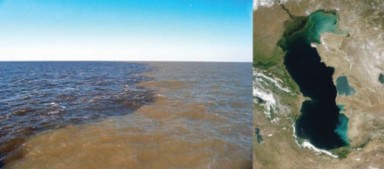
Figure 18.34: Eutrophication destroys marine and freshwater habitats and threatens biodi- versity. Left: Nutrients and sediment flow from the Mississippi River watershed - into the Gulf of Mexico, creating a dead zone literally devoid of life. Right: A satellite photo of the Caspian Sea shows overgrowth of algae in the northern region where the Volga River brings excess nutrients from agricultural fertilizer runoff. Respiration by the algae and their bacterial decomposers lowers levels of dissolved oxygen so that most aquatic life dies. (43)
Conserving Water and Other Natural Resources
Can you imagine what the expression “virtual water” could mean? It is an important concept in the conservation of water resources.
Virtual water is the water used in the production of a good or service. Although it is no longer contained in the product, its use is a part of the cost of production, and as such should be factored into the product’s value. Here are some estimates of virtual water “contained” in various products, from the United Nations Education, Scientific, and Cultural Organization (UNESCO) Institute for Water Education:
The more water we use, the more likely we are to draw down wells and rivers beyond the hydrologic cycle’s power to recharge them. The more water we use, the more we are likely to pollute the 1% of Earth’s waters which are fresh (as well as the oceans). Protecting soils and
www.ck12.org 918
lands (especially wetlands and watersheds) is a critical part of protecting water resources, because the hydrologic cycle integrates terrestrial and aquatic ecosystems.
Thus, as for all conservation (wise use) or sustainable use (meeting needs of the present without impairing those of future generations), the first step is to reduce our use of water. This and other strategies to protect our water resources are summarized below. Don’t forget the list of what you can do as an individual, at the end of the lesson on biodiversity!
Reduce the use of water, and the abuse of soil, land, and wetlands.
Landscape with native, drought-resistant vegetation.
Use low-flow toilets, faucets, and showerheads. Check out possible local government subsidies for installing these water saving mechanisms.
Purchase foods from water-efficient crops which do not require irrigation.
Reuse water where appropriate.
Gray water, which has been used for laundry or washing, can be used to water gardens or flush toilets.
On a municipal level, sewage water can be used for fountains, watering public parks or golf courses, fire fighting, and irrigating crops that will be boiled or peeled before consumption.
Catch runoff, which will also slow non-point source pollution and erosion.
Support legislation that reduces pollution.
For example in the U.S., the 1977 Clean Water Act, through the EPA, regulates in- dustrial discharge of contaminants and sets standards for water quality.
Work locally, nationally and internationally to make clean fresh water available.
The United Nations Depart of Economic and Social Affairs has initiated a second Decade for Water for Life, 2005-2015 to increase awareness of water shortages and work toward sustainable use of freshwater resources.
The World Water Council unites 300 member organizations from 60 countries to work to “build political commitment and trigger action on critical water issues at all lev- els... to facilitate the efficient management and use of water …on an environmentally sustainable basis.”
919 www.ck12.org
Lesson Summary
One’s definition of natural resources clarifies human relationships and responsibilities to the Earth.
Robert Hartwell’s definition defines natural resources as: “something supplied by na- ture which supports life on this planet.” This definition includes ecosystems, ecosystem services, biodiversity, energy sources and raw materials.
Renewable resources are replenished by natural processes as fast as, or faster than humans consume them.
A non-renewable resource is not regenerated or restored on a time scale comparative to its consumption. Fossil fuels are a classic example of nonrenewable resources.
In practice, pressure from growing populations and increasing industrialization can lead to overconsumption and/or degradation, changing a renewable resource into a non-renewable resource.
According to the Laws of Energy, energy resources are not renewable because they get used up, but materials or matter is constant because it can theoretically be recycled.
The concept of sustainable use – the use of resources at a rate which meets the needs of the present without impairing the ability of future generations to meet their needs
– may be more helpful in decision making.
The world’s current energy use is unsustainable, especially if increases in developing countries are considered.
Soils are complex mixtures which evolved over thousands of years to support terrestrial ecosystems.
Humans use soils for agriculture, forestry, and waste disposal.
Although soils have been considered renewable resources, human activities have changed them through:
Contamination with heavy metals and toxins
Acidification
Erosion
Salination
Conversion to cropland, cattle production, forestry, and urban centers
Despite soil conservation practices, the U.S. continues to lose topsoil to erosion, and developing countries are losing even more.
Land resources are used for agriculture, forestry, industry, mining, waste disposal, and urban areas.
In the process of converting land resources, the U.S. has lost:
99% of tallgrass prairies
at least 50% of wetlands
an area the size of Ohio to impervious surfaces www.ck12.org 920
Worldwide, conversion of forests to other uses, especially by slash-and-burn, adds CO2 to the atmosphere and reduces the potential for absorption of CO2 by photosynthesis, adding to greenhouse gases.
Wetlands, greatly reduced because of earlier views that they were wasted land, provide many ecosystem services, including flood control, water purification, aquifer recharge, plant and wildlife habitat, and recreation.
Liquid fresh water, the primary water resource for human use, comprises less than 1% of all water on Earth; most of this is groundwater.
As industry, agriculture, development, and a growing world population use more water, fresh water supplies are shrinking due to over-drafting of groundwater and pollution of surface and groundwater.
According to the United Nations, the current Water Crisis involves 1.1 billion people without adequate water supplies and 2.6 billion people who lack adequate water for sanitation.
Agricultural fertilizer runoff and waste water add excess nutrients to surface waters, leading to algal blooms and eutrophication.
Dead zones in coastal areas such as the Gulf of Mexico result from agricultural runoff from large areas of land. The dead zone at the mouth of the Mississippi River was the size of New Jersey in the summer of 2007.
Virtual water is the water used in the production of a good or service.
The more water we use, the more likely we are to overdraft aquifers and pollute water supplies.
Concepts similar to virtual water highlight the importance of REDUCING USE as a first principle in conservation or sustainable use.
A second principle is to REUSE resources. For water conservation, this can mean re-using gray water from laundry or showers for gardens or flush toilets.
Legislation can set standards for water quality and limits on pollution.
Local, national, and international organizations can work to promote awareness and encourage action.
Review Questions
Distinguish between renewable and nonrenewable resources, and relate these concepts to the Laws of Energy.
Classify the following resources as renewable or nonrenewable: coal, copper, iron, nat- ural gas, nuclear power, oxygen, sunlight, water, wood, wool. Briefly explain your reasoning for each resource.
Describe the formation of soil, and classify it as a renewable or nonrenewable resource.
Compare and contrast land which has undergone desertification to ecosystems which harbor natural deserts. How can the apparently life-promoting act of irrigation even- tually have the opposite effect?
We no longer experience the obvious tragedies associated with the Dust Bowl of the
921 www.ck12.org
1930s. Does this mean that soil erosion is no longer a significant problem?
Connect land use changes (e.g. forest to agriculture) to global warming. How important is this relationship?
List the ecosystem services of wetlands, and describe the extent of their loss.
Earth is the “water planet.” Why are we threatened with a Water Crisis?
Explain why eutrophication – “too much a good thing” results in problems for aquatic life.
Analyze the disappearance of the Black Sea “dead zone” for its potential to help solve water pollution problems.
Further Reading / Supplemental Links
Schumacher, E. F., ”Small Is Beautiful: Economics As If People Mattered : 25 Years Later...With Commentaries,” 1999. Hartley & Marks Publishers.
Hari Eswaran, Paul Reich, and Fred Beinroth, “Global Desertification Tension Zones.” US Department of Agriculture Natural Resources Conservation Services, 1998. Avail- able online at:
http://soils.usda.gov/use/worldsoils/papers/tensionzone-paper.html.Jeff
Dukes, “Burning Buried Sunshine,” CBC Radio One Quirks and Quarks Online, 1 November 2003.
Available online at:
http://www.cbc.ca/quirks/archives/03-04/nov01.html
Bob Hartwell, “Natural Resource Definition.” US Department of Energy NEWTON Ask A Scientist, 4 February 2005. Available online at:
http://www.newton.dep.anl.gov/askasci/gen01/gen01773.htm
United States Geological Survey, “Earth’s Water Distribution.” USGS Water Science for Schools, US Department of the Interior, last modified August 2006. Available online at:
http://ga.water.usgs.gov/edu/waterdistribution.html
World Water Council, “World Water Council: An International Multi-Stakeholder Platform for a Water Secure World.” Last updated 21 November 2007. Available online at:
http://www.worldwatercouncil.org/
Krishna Ramanujan and Brad Bohlander, “Landcover changes may rival greenhouse gases as cause of climate change.” NASA Goddard Space Flight Center, 1 October 2002. Available online at:
http://www.gsfc.nasa.gov/topstory/20020926landcover.html
“Is the dust bowl returning?” US Government Information Oklahoma Department of Libraries, 2004. Available online at:
http://www.odl.state.ok.us/usinfo/maps/dustbowl/index.htm
http://www.usgs.gov/themes/resource.html
http://www.wri.org/
www.ck12.org 922
http://www.energy.gov/energysources/index.htm
http://www.greeningschools.org/resources/view_cat_teacher.cfm?id=192
http://www.eia.doe.gov/kids/
http://www.priweb.org/ed/pgws/systems/systems_home.html
http://www.nrcs.usda.gov/FEATURE/education/squirm/skQ13.html
http://www.biodiversity911.org/soil/soil_main.html
http://forces.si.edu/soils/
http://www.nrcs.usda.gov/feature/backyard/watercon.html
http://water.usgs.gov/education.html
http://www.epa.gov/water/
http://www.lifewater.org/
http://www.amnh.org/exhibitions/water/
http://www.smm.org/deadzone/
http://www.sevengenerationsahead.org/about_us.html
http://www.iisd.org/natres/
http://en.wikipedia.org
Vocabulary
acid rain Precipitation in any form which has an unusually low pH.
algal bloom A rapid increase in the growth of algae, often due to a similar increase in nutrients.
anthropogenic sources Sources of pollution related to human activities.
biodiversity Variation in life – at all levels of organization: genes, species, and ecosystems.
biological magnification (food chain concentration) The process in which synthetic chemicals concentrate as they move through the food chain, so that toxic effects are multiplied.
dead zone Region of the ocean in which nutrient runoff and consequent eutrophication lower oxygen levels to the point at which life can no longer survive; less often applies to similar conditions in freshwater lakes.
desertification Degradation of formerly productive land (usually at least semi-arid).
ecosystem A functional unit comprised of living things interacting with their nonliving environment.
923 www.ck12.org
eutrophication An increase in nutrient levels in a body of water, often followed by an increase in plant or algae production.
global warming The recent increase in the Earth’s average near-surface and ocean tem- peratures.
greenhouse effect The trapping by the atmosphere of heat energy radiated from the Earth’s surface.
natural resource Something supplied by nature which supports life, including sources of energy and materials, ecosystems, and ecosystem services.
nonpoint source pollution Runoff of nutrients, toxins, or wastes from agricultural, min- ing, construction, or developed lands.
nonrenewable resource A resource which is not regenerated or restored on a time scale comparative to its consumption.
ozone depletion Reduction in the stratospheric concentration of ozone molecules, which shield life from damaging ultraviolet radiation.
point source pollution Single site sources of nutrients, toxins, or waste, such as industrial or municipal effluent or sewer overflow.
pollution Release into the environment of chemicals, noise, heat or even light beyond the capacity of the environment to absorb them without harmful effects on life.
primary pollutants Substances released directly into the air by processes such as fire or combustion of fossil fuel.
renewable energy sources Sources of energy which are regenerated by natural sources within relatively short time periods, e.g. solar, wind, and geothermal, as opposed to fossil fuels.
renewable resource A resource which is replenished by natural processes at a rate roughly equal to the rate at which humans consume it.
salination Addition of salts to soils, often by irrigation. www.ck12.org 924
secondary pollutants Substances formed when primary pollutants interact with sunlight, air, or each other.
soil erosion Removal of soil by wind and water in excess of normal processes.
sustainable use Use of resources at a rate which meets the needs of the present without impairing the ability of future generations to meet their needs.
virtual water The water used in the production of a good or service.
wetland Swamps, marshes and bogs whose soil is saturated.
Points to Consider
What is your own concept of natural resources? What relationship between humans and the Earth does it contain?
Aldo Leopold wrote:“There are two spiritual dangers in not owning a farm. One is the danger of supposing that breakfast comes from the grocery, and the other that heat comes from the furnace.” (http://en.wikiquote.org/wiki/Aldo_Leopold) Is your life close enough to “the farm” to recognize and fully appreciate the values of soil and of energy resources?
Were you surprised by the virtual water data for beef or jeans? What other “virtual resources” are part of the products we consume?
What kinds of legislation help to incorporate this level of water use in prices? What types of legislation prevent water use from being included in costs?
Compare this statement from The Great Law of the Iroquois Confederacy to the con- temporary concept of sustainable use: ”In every deliberation we must consider the impact on the seventh generation... even if it requires having skin as thick as the bark of a pine.” (http://en.wikipedia.org/wiki/Seven_generation_sustainability)
Lesson 18.3: Natural Resources II: The Atmo- sphere
Lesson Objectives
Recognize that the Earth’s atmosphere provides conditions and raw materials essential for life.
Review the changes in the atmosphere over the history of the Earth.
Describe the dynamic equilibrium which characterizes the natural atmosphere.
925 www.ck12.org
Analyze the ways in which population growth, fossil fuel use, industrialization, tech- nology, and consumption result in atmospheric changes.
Explain the effects of these changes on ecosystems.
Relate these effects to current global stability.
Describe how human activities including technology affect ecosystem services such as:
nutrient cycling
hydrologic cycle
waste disposal
Evaluate the effects of changes in these services for humans.
Identify the ways in which humans have altered the air for other species.
Relate air pollution to ecosystem loss.
Interpret the effects of air pollution on biodiversity.
Define acid rain.
List the natural and anthropogenic causes of acid rain.
Identify the effects of acid rain.
Discuss solutions specific to the problem of acid rain.
Locate and describe the origin of the ozone layer.
Distinguish between ozone depletion and the ozone hole.
Explain the role of ozone in absorbing ultraviolet radiation.
Indicate the ways in which the ozone layer varies naturally.
Discuss the relationship between recent changes in the ozone layer and human activities.
Describe the measures taken to restore the ozone layer and evaluate their effectiveness.
Introduction
Air: so easy to take for granted. In its pristine state, we cannot see it, smell it, taste it, feel it, or hear it, except when the wind blows or clouds form. Yet its complex and dynamic mix of gases is essential for life. Nitrogen (78%) provides atoms which build proteins and nucleic acids via the nitrogen cycle. Oxygen (21%) permits the production of the ATP through cellular respiration, to power life. Carbon dioxide (.04%) provides the carbon for carbohydrate fuels and carbon skeletons to build life’s bodies. Water (1-4% near the Earth’s surface) has so many unique properties (adhesion, surface tension, cohesion, capillary action, high heat capacity, high heat of vaporization…and more) that it is difficult for us to imagine any form of life on any planet which does not depend on it. As a major component of the hydrologic cycle, the atmosphere cleans and replenishes Earth’s fresh water supply, and refills the lakes, rivers, and oceans habitats for life (Figure 18.35). The Earth’s atmosphere thins but reaches away from its surface for 100 kilometers toward space; between about 15 and 35 km lies the Ozone Layer – just a few parts per million which shields life from the sun’s damaging Ultra-Violet radiation. Earth’s atmosphere appears ideal for life, and indeed, as far as we know it is the only planetary atmosphere which supports life.
www.ck12.org 926
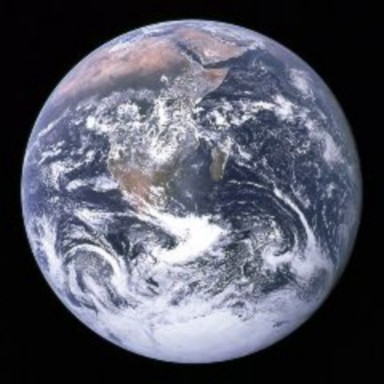
Figure 18.35: A composite photo of satellite images shows Earth and its life-supporting waters and atmosphere. (40)
927 www.ck12.org
As we noted in the History of Life chapter, the Earth’s atmosphere has not always been this hospitable for life. Life itself is probably responsible for many dramatic changes, including the addition of oxygen by photosynthesis, and the subsequent production of ozone from accumulated oxygen. Changes in CO2 levels, climate, and sea level have significantly altered conditions for life, even since the addition of oxygen some 2 billion years ago. On a daily time scale, dramatic changes take place:
most organisms remove O2 and add CO2 through cellular respiration
most autotrophs remove CO2 and add O2 through photosynthesis
plants transpire vast quantities of water into the air
precipitation returns it, through gentle rains or violent storms, to the Earth’s surface
On a human time scale, the daily dynamics balance, and the atmosphere remains at equi- librium – an equilibrium upon which most life depends.
Upsetting the Equilibrium of the Atmosphere: Air Pollution
Despite the atmosphere’s apparent vastness, human activities have significantly altered its equilibrium in ways which threaten its services for life. Chemical substances, particulate matter, and even biological materials cause air pollution if they modify the natural char- acteristics of the atmosphere. Primary pollutants are directly added to the atmosphere by processes such as fires or combustion of fossil fuels (Figure 18.36). Secondary pollu- tants, formed when primary pollutants interact with sunlight, air, or each other, can be equally damaging. The chlorine and bromine which threaten the Ozone Layer are sec- ondary pollutants, formed when refrigerants and aerosols (primary pollutants) decompose in the stratosphere (Figure 18.37).
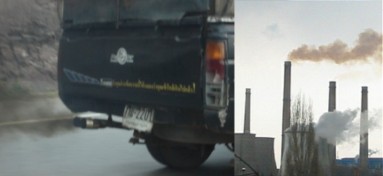
Figure 18.36: Burning fossil fuels – by factories, power plants, home furnaces, and motor vehicles – is a major source of air pollution. (33)
www.ck12.org 928
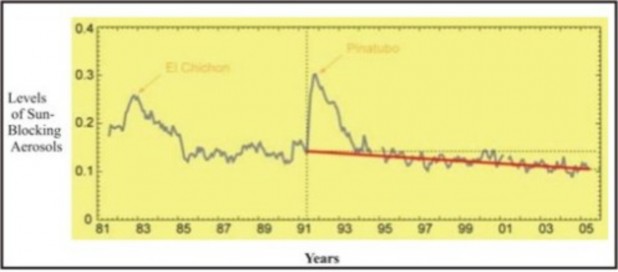
Figure 18.37: Levels of sun-blocking aerosols declined from 1990 to the present. A corre- sponding return to pre-1960 levels of radiation suggests that pollution control measures in developed countries have counteracted Global Dimming. However, particulates are still a problem in developing countries, and could affect the entire global community again in the future. Aerosol increases in 1982 and 1991 are the result of eruptions of two volcanoes, El Chichon and Pinatubo. (21)
929 www.ck12.org
The majority of air pollutants can be traced to the burning of fossil fuels. We burn fuels in power plants to generate electricity, in factories to power machinery, in stoves and furnaces for heat, in airplanes, ships, trains, and motor vehicles for transportation, and in waste facilities to incinerate waste. Since long before fossil fuels powered the Industrial Revolution, we have burned wood for heat, fireplaces, and campfires and vegetation for agriculture and land management. The resulting primary and secondary pollutants and the problems to which they contribute are included in Table 18.2.
Table 18.2:

Pollutant Example/Major Source Problem

Sulfur oxides (SOx) Coal-fired power plants Acid Rain Nitrogen oxides (NOx) Motor vehicle exhaust Acid Rain Carbon monoxide (CO) Motor vehicle exhaust Poisoning Carbon dioxide (CO2) All fossil fuel burning Global Warming
Particulate matter (smoke, dust)
Wood and coal burning Respiratory disease, Global
Dimming
Mercury Coal-fired power plants, medical waste
Neurotoxicity
Smog Coal burning Respiratory problems; eye irritation
Ground-level ozone Motor vehicle exhaust Respiratory problems; eye
irritation

Beyond the burning of fossil fuels, other anthropogenic (human-caused) sources of air pollution are shown in Table 18.3.
Table 18.3:

Activity Pollutant Problem

Agriculture: Cattle Ranch- ing
Fertilizers
Herbicides and Pesticides Erosion
Methane (CH4)
Ammonia (NH3), Volatile Organic Chemi- cals(VOCs)
Persistent Organic Pollu- tants(POP): DDT, PCBs, PAHs*
Dust
Global Warming
Toxicity, Global Warming Cancer
Global Dimming
www.ck12.org 930
Table 18.3: (continued)

Activity Pollutant Problem

VOCs, POPs CFCs Cancer, Global Warming
Industry (solvents, plas- tics)
Refrigerants, Aerosols
Ozone Depletion
Nuclear power and defense Radioactive waste Cancer
Landfills Methane (CH4) Global Warming
Mining Asbestos Respiratory problems Biological Warfare Microorganisms Infectious Disease
Indoor Living CO, VOCs, asbestos, dust, mites, molds, particulates
Indoor air pollution

DDT = an organic pesticide; PCB = poly-chlorinated biphenyls, used as coolants and insulators; DDT and most PCBs are now banned at least in the U.S., but persist in the environment; PAHs = polycyclic aromatic hydrocarbons – products of burning fossil fuels, many linked to health problems
Many pollutants travel indoors in building materials, furniture, carpeting, paints and var- nishes, contributing to indoor air pollution. In 2002, the World Health Organization esti- mated that 2.4 million people die each year as a consequence of air pollution – more than are killed in automobile accidents. Respiratory and cardiovascular problems are the most common health effects of air pollution, but accidents which release airborne poisons (the nuclear power plant at Chernobyl, the Union Carbide explosion in Bhopal, and the “Great Smog of 1952” over London) have killed many people – and undoubtedly other animals – with acute exposure to radiation or toxic chemicals.
If you study the problems caused by air pollution (third column in the tables, above), you will note that beyond human health, air pollution affects entire ecosystems, worldwide. Acid Rain, Ozone Depletion, and Global Warming are widespread and well-recognized global concerns, so we will explore them in detail in independent sections of this lesson, – and an entire lesson on Global Warming. Effects of toxins, which poison wildlife and plants as well as humans, were addressed in discussions of soil and water pollution in the last chapter. Before we move on to the “Big Three,” let’s take a brief look at the problems caused by particulates and aerosols, since these are unique pollutants of air, rather than soil or water.
“Global dimming” refers to a reduction in the amount of radiation reaching the Earth’s surface. Scientists observed a drop of roughly 4% between 1960 and 1990, and attributed it to particulates and aerosols (in terms of air pollution, aerosols are airborne solid particles or liquid droplets). These pollutants absorb solar energy and reflect sunlight back into space. The consequences for life are many:
931 www.ck12.org
Less sunlight means less photosynthesis.
Less photosynthesis means less food for all trophic levels.
Less sunlight means less energy to drive evaporation and the hydrologic cycle.
Less sunlight means cooler ocean temperatures, which may lead to changes in rainfall, drought and famine.
Less sunlight may have cooled the planet, masking the effects of Global Warming.
Recent measurements of sunlight-absorbing particulates show a decline since 1990, which corresponds to a return to normal levels of radiation (Figure 18.37). These data suggest that Clean Air legislation enacted by developed nations may have improved air quality and prevented most of the above effects, at least for now. Two caveats remain:
If “Global Dimming” did indeed mask Global Warming for 30 years, predictions about future climate change may be too conservative. Keep this in mind when we address Global Warming in the next lesson.
Population growth and industrialization of developing countries continues to increase levels of pollution.
Massive waves of pollution from Asian industry have blown across the Pacific by prevailing winds (Figure 18.38). On some days, atmospheric physicists at the Scripps Institution of Oceanography have traced nearly one-third of the air over Los Angeles and San Francisco directly to Asian sources. The waves are made of dust from Asian deserts combined with pollution from increasing industrialization, making the level of particulates and aerosols in Beijing, for example, reach levels 7 times World Health Organization standards. Scientists estimate that the clouds may be blocking 10% of the sunlight over the Pacific. By seeding clouds, the aerosols and particulates may be intensifying storms. In addition to direct effects on the global atmosphere (such waves can circle the Earth in three weeks), these pollution clouds can, as we stated above, mask Global Warming.
One additional topic relates to atmospheric change. Light pollution (Figure 18.39) results from humans’ production of light in amounts which are annoying, wasteful, or harmful. Light is essential for safety and culture in industrial societies, but reduction in wasteful excess could mitigate its own harmful effects, as well as the amounts of fossil fuel used to generate it. Astronomers – both amateur and professional – find light interferes with their observations of the night skies. Some studies show that artificial spectra and excessive light exposure has harmful effects on human health. Life evolved in response to natural cycles and natural spectra of light and dark, so it is not surprising that our changes in both of those might affect us and other forms of life. Light pollution can affect animal navigation and migration and predator/prey interactions. Because many birds migrate by night, Toronto, Canada has initiated a program to turn out lights at night during spring and fall migration seasons. Light may interfere with sea turtle egg-laying and hatching, because both happen on coasts at nighttime. The behavior of nocturnal animals from owls to moths can be changed by light,
www.ck12.org 932
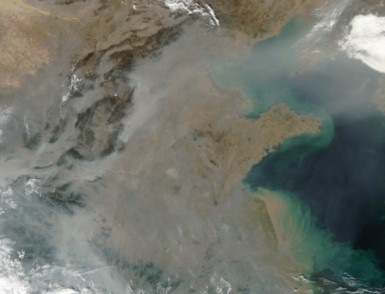
Figure 18.38: A cloud of smoke and haze covers this region of China from Beijing (top center) to the Yangtze River (bottom right). At the top right, pollution is blowing eastward toward Korea and the Pacific Ocean. Aerosol pollution with large amounts of soot (carbon particles) is changing precipitation and temperatures over China. Some scientists believe that these changes help to explain increasing floods and droughts. (23)
933 www.ck12.org
and night-blooming flowers can be affected directly or through disruption of pollination. Zooplankton normally show daily vertical migration, and some data suggests that changes in this behavior can lead to algal blooms.

Figure 18.39: When light produced by humans becomes annoying, wasteful, or harmful, it is considered light pollution. This composite satellite image of Earth at night shows that light is concentrated in urban – but not necessarily population – centers. The U.S. interstate highway system, the Trans-Siberian railroad, and the Nile River are visible at higher magnifications. (15)
Solutions to problems caused by light pollution include
reducing use
changing fixtures to direct light more efficiently and less harmfully
changing the spectra of light released
changing patterns of lighting to increase efficiency and reduce harmful effects
Many cities, especially those near observatories, are switching to low-pressure sodium lamps, because their light is relatively easy to filter.
Acid Rain
Do you remember the pH scale? Its range is 0-14, and 7 is neutral – the pH of pure water. You’ve probably measured the pH of various liquids such as vinegar and lemon juice, but do you know how important even very small changes in pH are for life? Your body maintains the pH of your blood between 7.35 and 7.45, and death results if blood pH falls below 6.8 or rises above 8.0. All life relies on relatively narrow ranges of pH, because protein structure and function is extremely sensitive to changes in concentrations of hydrogen ions. An important pollution problem which affects the pH of Earth’s environments is Acid Rain (Figure 18.40).
www.ck12.org 934
Rain, snow, fog, dew, and even dry particles which have an unusually low pH are commonly considered together as Acid Rain, although more accurate terms would be acid precipitation or acid deposition. You will remember that a pH below 7 is acidic, and the range between 7 and 14 is basic. Natural precipitation has a slightly acidic pH, usually about 5, mostly because CO2, which forms 0.04% of the atmosphere, reacts with water to form carbonic acid:
Table 18.4:
CO2 | + H2O | H2CO3 | HCO3- | + H+ |
carbon dioxide | water | carbonic Acid | bicarbonate | hydrogen ion |
This natural chemical reaction is actually quite similar to the formation of acid rain, except that levels of the gases which replace carbon dioxide are not normally significant in the atmosphere. The most common acid-forming pollutant gases are oxides of nitrogen and sulfur released by the burning of fossil fuels. Because burning may result in several different oxides, the gases are often referred to as “NOx and SOx.” This may sound rather affectionate, but it’s more accurate to think of it as obNOXious! Whereas the carbonic acid formed by carbon dioxide is a relatively weak acid, the nitric and sulfuric acids formed by NOx and SOx are strong acids, which ionize much more readily and therefore cause more damage. The reactions given below slightly simplify the chemistry (in part because NOx and SOx are complex mixtures of gases), but should help you see the acidic results of an atmospheric mixture of water and these gases.
Table 18.5:

NO2 + OH- → HNO3 NO3- + H+

nitrogen diox- ide
hydroxide ion (from water)
nitric Acid nitrate hydrogen ion

Table 18.6:

SO3 + H2O → H2SO4 SO4-2 + 2H+

sulfur trioxide water sulfuric acid sulfate hydrogen ions

Nitrogen and sulfur oxides have always been produced in nature by volcanoes and wildfires and by biological processes in wetlands, oceans, and even on land. However, these natural levels are either limited in time or amount; they account for the slightly acidic pH of “normal” rain. Levels of these gases have risen dramatically since the Industrial Revolution began; scientists have reported pH levels lower than 2.4 in precipitation in industrialized areas.
935 www.ck12.org
Generation of electricity by burning coal, industry, and automobile exhaust are the primary sources of NOx an SOx. Coal is the primary source of sulfur oxides, and automobile exhaust is a major source of nitrogen oxides.

Figure 18.40: Acid rain formation begins when nitrogen and sulfur oxides (here NOx and SO2) and volatile organic compounds (VOC) from burning fossil fuels escape into the at- mosphere. When these gases or particulates combine with water – either in the atmosphere or after reaching the ground – they become acid deposition. The term acid rain commonly refers to all forms of acid deposition. (18)
Because most life requires relatively narrow pH ranges near neutral, the effects of acid rain can be devastating. In soils, lowered pH levels can kill microorganisms directly, altering decomposition rates, nutrient cycles, and soil fertility. A secondary effect of increased acidity is the leaching of nutrients, minerals, and toxic metals such as aluminum and lead from soils and bedrock. Depletion of nutrients and mobilization of toxins weakens trees and other plants, especially at higher altitudes where higher precipitation and acid fog damage leaves and needles, as well (Figure 18.41).
The flow of acid rain through watersheds increases acidity, nutrients, and toxins in aquatic ecosystems. Fish and insects are sensitive to changes in pH, although different species can tolerate different levels of acidity (Figure 18.42). Food chain disruption can compound even slight changes in pH; for example, acid-sensitive mayflies provide food for less-sensitive frogs. Additional nitrates in aquatic systems can lead to eutrophication and algal blooms, discussed in the last lesson.
The sensitivity of lakes, streams, and soils to damage from acid rain depends on the nature of the soils and bedrocks. Watersheds containing limestone, which can buffer (partially neutralize) the acid, are less severely affected. In addition, northern regions with long winters suffer “acid shock” when spring thaws dump months of accumulated acid precipitation into
www.ck12.org 936
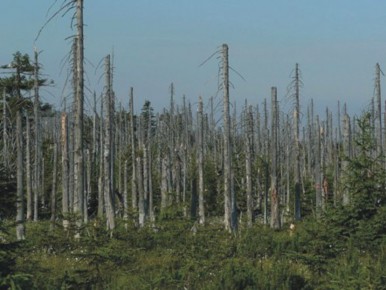
Figure 18.41: A mountain forest in the Czech Republic shows effects attributed to acid rain. At higher altitudes, effects on soils combine with direct effects on foliage of increased precipitation and fog. (44)
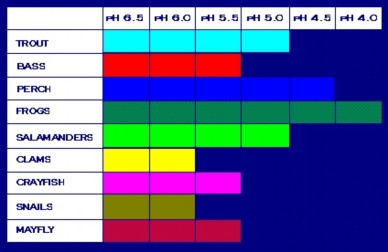
Figure 18.42: Aquatic species show varying sensitivity to pH levels. Colored bars show survival ranges. Trout are more sensitive to increasing acidity than frogs, but mayflies, which frogs consume, are even more sensitive. Consequently, changes in a lake’s acidity may affect ecosystems more severely than simple species sensitivity charts would indicate. (60)
937 www.ck12.org
streams and rivers. In the US, lakes and streams in the Appalachians, northern Minnesota and upper New York, and Western mountains have been more severely impacted by acid rain. According to the EPA, the pH of Little Echo Pond in New York state, 4.2, is one of the lowest in the U.S.
Another class of victims of acid rain is entirely within the realm of human culture and history. Acid’s ability to corrode metal, paints, limestone, and marble has accelerated erosion of buildings, bridges, statues, monuments, tombstones, and automobiles (Figure 18.43).

Figure 18.43: Acid rain accelerates erosion of statues, monuments, buildings, tombstones, bridges, and motor vehicles. (25)
Attempts to solve the problem of acid rain began with building taller smokestacks. These only sent the polluting gases higher into the atmosphere, relieving local problems temporarily, but sending the damage to areas far from their industrial sources. Today in the U.S. and other western nations, smokestacks increasingly use “scrubbers” which remove as much as 95% of SOx from exhausts; the resulting sulfates “scrubbed” from the smokestacks can sometimes be sold as gypsum (used in drywall, plaster, fertilizer and more), but may also be landfilled. Catalytic converters and other emission control technologies remove NOx from motor vehicle exhaust. However, population growth and development throughout the world is increasing pressures to use more fossil fuels and high-sulfur coal, often without these expensive technologies.
Ozone Depletion
Many people confuse the “hole in the ozone” with “global warming.” Although the two are related in part, they are separate problems with separate effects and only partially overlapping causes, so they require separate solutions.
www.ck12.org 938
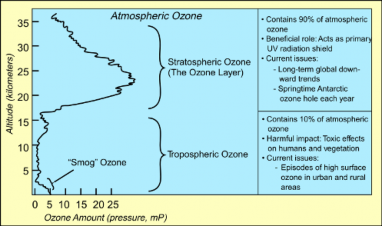
Figure 18.44: At altitudes less than 5 kilometers, respiratory irritant “smog” ozone forms when sunlight reacts with pollutants. The Ozone Layer, at altitudes between 15 and 35 kilometers, forms when UV radiation interacts with oxygen, and shields life on Earth from 97-99% of the Sun’s damaging UV radiation. (2)
Ozone is both a threat and a gift (Figure 18.45). As a ground-level product of the interaction between sunlight and pollutants, it is considered a pollutant which is toxic to animals’ respiratory systems. However, as a component of the upper atmosphere, it has shielded us and all life from as much as 97-99% of the sun’s lethal UV radiation for as long as 2 billion years. The “hole” in the ozone develops in this thin upper Ozone Layer. How long will that protection continue? Let’s explore the problem of ozone depletion.
The Ozone (O3) Layer forms when UV radiation strikes oxygen molecules (O2) in the strato- sphere, between 15 and 35 kilometers above the Earth’s surface. Even the highest concentra- tions of ozone are only about 8 parts per million, but ever since photosynthesis oxygenated the Earth’s atmosphere, allowing ozone-forming chemical reactions, this thin Ozone Layer has shielded life from the mutagenic effects of ultraviolet radiation – especially the more damaging UV-B and UV-C wavelengths (Figure 18.44).
The thickness of the Ozone Layer varies seasonally and across the Earth – thicker in Spring than in Autumn, and at the Poles compared to near the Equator. Ozone depletion de- scribes two related declines in stratispheric ozone. One is loss in the total amount of ozone in the Earth’s stratosphere – about 4% per year from 1980 to 2001 (Figure 18.47). The sec- ond, much larger loss refers to the ozone hole – a seasonal decline over Antarctica (Figures
and 14), which has now lost as much as 70% of pre-1975 ozone levels. A much smaller “dimple” overt the North Pole has also shown a 30% decline. The Antarctic ozone hole occasionally affects nearby Australia and New Zealand after annual breakup. A secondary effect is the decline in stratosphere temperatures, because when ozone absorbs UV radiation, it is transformed into heat energy.
The causes of ozone depletion are gases which unbalance the ozone cycle (Figure 18.46)
939 www.ck12.org
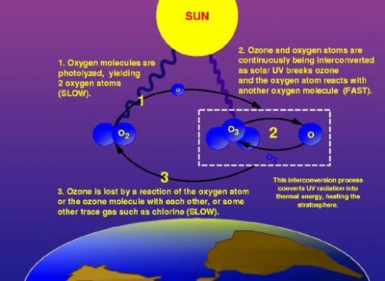
Figure 18.45: The ozone cycle involves the conversion of oxygen molecules to ozone (1 and 2) a slower reconversion of ozone molecules to oxygen (3). Interactions among ozone molecules or the presence of other reactive gases trigger the loss of ozone. (54)
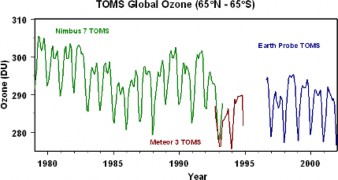
Figure 18.46: Total global monthly ozone levels measured by three successive spectrometers (TOMS) show both seasonal variations and a general decline. (49)
www.ck12.org 940
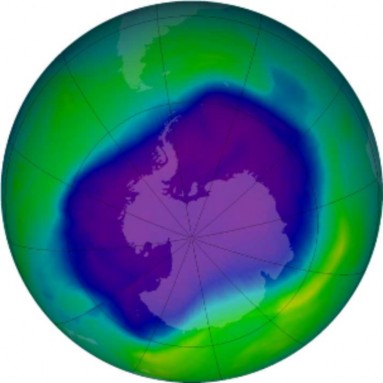
Figure 18.47: On September 24, 2006 the seasonal ozone hole over the Antarctic covered a record daily area (29.5 million square kilometres or 11.4 million square miles). Blue and purple areas show the lowest ozone levels, and green, yellow, and red indicate successively higher levels. (35)
941 www.ck12.org
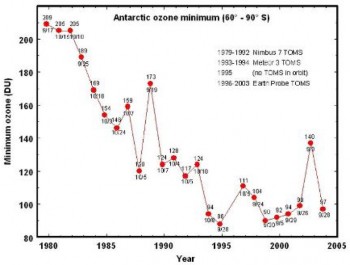
Figure 18.48: Lowest annual values of ozone in the ozone hole decreased dramatically between 1980 and 1995. Before 1980, values less than 200 Dobson units were rare, but in recent years, values near 100 units are common. Unusually high temperatures in the Antarctic stratosphere may have caused the high reading in 2002. (10)
toward the breakdown of ozone. Chlorine and bromine gases have increased due to the use of chlorfluorocarbons (CFCs) for aerosol sprays, refrigerants (Freon), cleaning solvents, and fire extinguishers. These ozone-depleting substances (ODS) escape into the stratosphere, and when UV radiation frees chlorine and bromine atoms, these unstable atoms break down ozone. Scientists estimate that CFCs take 15 years to reach the stratosphere, and can remain active for 100 years. Each chlorine atom can catalyze thousands of ozone breakdown reactions.
Ozone depletion and the resulting increase in levels of UV radiation reaching earth could have some or all of the following consequences:
effects on human health
increase in skin cancers, including melanomas
increased incidence of cataracts
decreased levels of vitamin A
possible increase in levels of vitamin D produced by the skin
reduced abundance of UV-sensitive nitrogen-fixing bacteria
loss of crops dependent on these bacteria
disruption of nitrogen cycles
loss of plankton (supported by a supernova-related extinction event 2 million years ago)
www.ck12.org 942
disruption of ocean food chains
Most of these effects are based on the ability of UV radiation to alter DNA sequences. It is this potential which has made the Ozone Layer such a gift to life ever since photosynthesis provided the oxygen to fuel its production. Its total loss would undoubtedly be devastating to nearly all life.
In 1987, 43 nations agreed in the Montreal Protocol to freeze and gradually reduce production and use of CFCs. In 1990, the protocol was strengthened to seek elimination of CFCs for all but a few essential uses. Today, Hydrochlorofluorocarbons (HCFCs – similar compounds which replace one chlorine with a hydrogen) have replaced CFCs, with only 10% of their ozone-depleting activity levels. Unfortunately, HCFCs are greenhouse gases (see next lesson), so their role as alternatives is a mixed blessing. HFCs (hydrofluorocarbons) are another substitute; because these contain no chlorine, they have no ozone-depleting activity, and their greenhouse effect is less than HCFCs (though still significant). One HFC is currently used in automobile air conditioners in the U.S.
If ozone-depleting substances have been virtually eliminated, is ozone depletion no longer a problem?
Unfortunately, we have not yet reached that point. Levels of CFCs in the atmosphere are beginning to decline, and ozone levels appear to be stabilizing (Figures 18.47 and 14) for years after 2000). Scientists predict that ozone levels could recover by the second half of this century; the delay is due to the long half-life of CFCs in the stratosphere. However, recovery could be limited or delayed by two unknowns:
Developing countries outside the Montreal Protocol could increase their use of CFCs.
According to scientists, global warming would cool the stratosphere and increase ozone depletion because cooler temperatures favor ozone decomposition.
Preventing Air Pollution
Throughout this lesson, we have discussed solutions to specific problems for our atmosphere. A quick recap of ways to maintain our atmosphere and its ecosystem services from this chapter includes:
Reducing use of fossil fuels
Switching to cleaner fuels, such as nuclear power
Switching to renewable energy sources
Increasing fuel efficiencies
Supporting legislation for fuel efficiencies
Supporting national and international agreements to limit emissions
943 www.ck12.org
Utilizing pollution control technologies: e.g., scrubbers on smokestacks and catalytic converters for motor vehicles
Creating and supporting urban planning strategies
As always, costs are high and tradeoffs must be considered. The classic example is nuclear power, whose effects on the atmosphere are less than those of fossil fuels. Unfortunately, it has high potential for health damage and high costs – both economic and environmental – for storage and transport of nuclear waste.
Because fossil fuel use is the cause of so many atmospheric as well as water and soil pollutants, the solutions mentioned in the last two lessons apply here, as well. The final lesson on Climate Change relates directly to both fossil fuel combustion and atmospheric change, so more pollution solutions, specific to climate change, will be presented. You should also review the individual responses at the end of the lesson on biodiversity, because that list focuses on ways you can change your own life to help protect the environment.
Lesson Summary
Earth’s atmosphere, as we understand it today, provides ideal conditions and essential raw materials for life.
Throughout Earth’s history, the atmosphere has changed dramatically, and life caused some of the changes.
Within human history, the atmosphere had been in a dynamic equilibrium: balancing photosynthesis, respiration, evaporation, and precipitation.
Primary pollutants are directly added to the atmosphere by processes such as fires or combustion of fossil fuels. Secondary pollutants are formed when primary pollutants interact with sunlight, air, or each other.
The majority of air pollutants can be traced to the burning of fossil fuels for heat, electricity, industry, transportation, and waste disposal.
Worldwide, air pollution causes as many as 2.4 million deaths each year.
Aerosols (particulates and liquid droplets) cab cause global dimming, or reduction in sunlight reaching the Earth.
Light pollution can interfere with bird migrations, sea turtle reproduction, nocturnal animal behavior, and human activity.
Rain, snow, fog, dew, and even dry particles which have an unusually low pH are commonly considered together as Acid Rain.
Normal rain has a pH of about 5, due in part to formation of a weak (carbonic) acid from CO2.
Burning fossil fuels adds NOx and SOx gases to the atmosphere; these form strong
acids (nitric and sulfuric) and change the pH of rain to as low as 2.4.
Acid rain leaches nutrients and toxins from soils, weakening forests and killing aquatic animals.
www.ck12.org 944
Limestone in bedrock or watersheds buffers the effects of acid rain for certain lakes.
The development of taller smokestacks only sent pollution elsewhere, but scrubbers in smokestacks and catalytic converters in motor vehicles help to reduce emissions.
The Ozone Layer in the stratosphere – formed from O2 – protects Earth’s life from
mutagenic UV radiation.
Ground-level ozone – formed from automobile exhaust and industry – is a component of smog, which irritates eyes and respiratory membranes.
Ozone depletion is a global reduction in the thickness of the ozone layer, caused by chlorine and bromine atoms which reach the stratosphere.
The ozone hole is a seasonal thinning of ozone above the Antarctic.
CFCs in aerosol sprays, refrigerants (Freon), cleaning solvents, and fire extinguishers are the primary ozone-depleting substances (ODSs).
The 1987 Montreal Protocol has reduced the use of CFCs and ozone depletion.
Chemical substitutes, though less harmful, still cause damage, and countries outside the Protocol may still add ODS to the atmosphere.
Global warming would cool the stratosphere and increase ozone depletion, because cooler temperatures favor ozone decomposition.
Because fossil fuels are the source of many air pollutants, reducing their use is the key to solving air pollution problems.
Technology can help by developing alternative energy sources, increasing fuel efficien- cies, and improving pollution control.
Governments can help by legislating fuel efficiencies and pollution control, urban plan- ning, and forging agreements with other governments.
Review Questions
Summarize the importance of the gaseous “life support system” which Earth’s atmo- sphere provides, and the dynamic equilibrium which characterizes the natural atmo- sphere.
Describe the ecosystem services provided by Earth’s atmosphere.
Distinguish between primary and secondary pollutants, and give an example of each.
Define acid rain and trace the steps in its formation.
Why is rain with a pH of 5 not considered acid rain?
Analyze the effects of acid rain on soils, water resources, vegetation, animals, and humans.
Define ozone depletion and explain its causes.
Explain the consequences of ozone depletion.
Chart the air pollution problems discussed in this chapter together with a primary cause and an important prevention practice for each.
945 www.ck12.org
Table 18.7:


Problem Major Cause Major Prevention Practice Global Dimming Dust from erosion Contour plowing, conserva-
tion tillage, cover crops
Light Pollution Urbanization, artificial lights
Alteration of spectra and de- sign of lights
Smog Automobile exhaust Catalytic converters, emis- sions control
Acid Rain Generation of electricity from coal
Reduce use, scrubbers
Ozone Depletion CFC emission Eliminate use, find substi-
tutes

Why are international treaties, such as the Montreal Protocol and the Kyoto Treaty, so important in solving air pollution problems?
Further Reading / Supplemental Links
US Environmental Protection Agency, Effects of Acid Rain - Surface Waters and Aquatic Animals, ACID RAIN, US EPA website, last updated 8 June 2007. Available online at:
http://www.epa.gov/acidrain/effects/surface_water.html
http://www.epa.gov/highschool/air.htm
http://www.anr.state.vt.us/site/html/reflect/April5.htm
http://www.epa.gov/acidrain/
http://www.atm.ch.cam.ac.uk/tour/
http://www.epa.gov/ozone/
http://www.pbs.org/wgbh/nova/sun/
http://www.documentary-film.net/search/sample.php
http://www.skyandtelescope.com/resources/darksky
http://www.wellesley.edu/Biology/Faculty/Mmoore/Content/Moore_2000.pdf
http://en.wikipedia.org
Vocabulary
acid rain Precipitation in any form which has an unusually low pH.
aerosols Airborne solid particles or liquid droplets. www.ck12.org 946
air pollution Alteration of the Earth’s atmosphere by chemical, particulate, or biological materials.
algal bloom A rapid increase in the growth of algae, often due to a similar increase in nutrients.
anthropogenic sources Sources of pollution related to human activities.
biodiversity Variation in life – at all levels of organization: genes, species, and ecosystems.
ecosystem A functional unit comprised of living things interacting with their nonliving environment.
eutrophication An increase in nutrient levels in a body of water, often followed by an increase in plant or algae production.
global dimming A reduction in the amount of radiation reaching the Earth’s surface.
global warming The recent increase in the Earth’s average near-surface and ocean tem- peratures.
greenhouse effect The trapping by the atmosphere of heat energy radiated from the Earth’s surface.
light pollution Production of light by humans in amounts which are annoying, wasteful, or harmful.
nonpoint source pollution Runoff of nutrients, toxins, or wastes from agricultural, min- ing, construction, or developed lands.
ozone depletion Reduction in the stratospheric concentration of ozone molecules, which shield life from damaging ultraviolet radiation.
ozone hole A seasonal reduction in ozone levels over Antarctica.
ozone layer A concentration of ozone molecules located between 15 and 35 kilometers above Earth’s surface in the stratosphere.
947 www.ck12.org
point source pollution Single site sources of nutrients, toxins, or waste, such as industrial or municipal effluent or sewer overflow.
pollution Release into the environment of chemicals, noise, heat or even light beyond the capacity of the environment to absorb them without harmful effects on life.
primary pollutants Substances released directly into the air by processes such as fire or combustion of fossil fuel.
secondary pollutants Substances formed when primary pollutants interact with sunlight, air, or each other.
sustainable use Use of resources at a rate which meets the needs of the present without impairing the ability of future generations to meet their needs.
Points to Consider
What are the major ecosystem services provided by our atmosphere?
Could you now explain to a friend or family member the difference between the “hole in the ozone” and “global warming”?
In what ways have we already begun to add the costs of atmospheric changes to our economic system?
Can you think of additional ways in which we could build in these costs?
How can we gain support for adding environmental costs to economic costs?
Lesson 18.4: Climate Change
Lesson Objectives
Explain the mechanism of the greenhouse effect.
Recognize that the greenhouse effect maintains an equilibrium.
Compare greenhouse conditions on Earth to those on Mars and Venus.
Explain the extent of current increases in the Earth’s temperature.
Review past changes in the Earth’s temperatures.
Summarize the evidence and support for greenhouse gases as the cause of recent global warming.
Discuss the significance of global warming for Earth’s ecosystems.
Relate global warming to current global stability.
List the atmospheric gases that absorb the Earth’s thermal radiation, and their sources. www.ck12.org 948
Evaluate possible solutions to the problem of global climate change.
Recognize the tradeoffs required by nuclear power plants: reduced emissions vs. ra- dioactive fuels and waste
Introduction
On December 10, 2007, the Intergovernmental Panel on Climate Change (IPCC) and former US Vice President Al Gore received the Nobel Peace Prize “for their efforts to build up and disseminate greater knowledge about man-made climate change, and to lay the foundations for the measures that are needed to counteract such change.” The Peace Prize is designated “to the person who shall have done the most or the best work for fraternity between the nations, for the abolition or reduction of standing armies and for the holding and promotion of peace congresses.” A high honor, the award also announced to the world that climate change (Figure 18.49) is a critical issues for the future of the Earth and its people. What is climate change? What are its causes? How do its effects relate to world peace? What are “the foundations for the measures that are needed to counteract such change”? Can individuals like us help? These are the questions we will explore in this last lesson about human ecology.
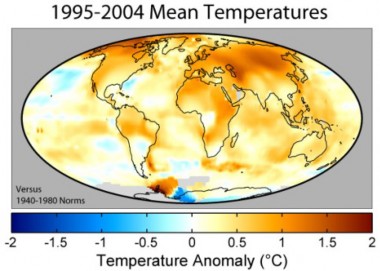
Figure 18.49: Temperature variations from 1940-1980 averages show that most of the Earth warmed significantly in just a single decade. The average temperature change across the en- tire globe for this period is 0.42oC (0.76 oF). Over the past 100 years, surface air temperatures have risen 0.74 ± 0.18 °C (1.33 ± 0.32 °F). (29)
949 www.ck12.org
What is the Greenhouse Effect?
The Greenhouse Effect is a natural feature of Earth’s atmosphere – yet another ecosystem service. Without the Greenhouse Effect, Earth’s surface temperature would average -18oC (0oF) – a temperature far too cold to support life as we know it. With the Greenhouse Effect, Earth’s surface temperature averages 15oC (59oF), and it is this temperature range to which today’s diversity of life has adapted.
How does this ecosystem service work? The Greenhouse Effect is summarized in Figure
18.50. Of the solar radiation which reaches the Earth’s surface, as much as 30% is reflected back into space. About 70% is absorbed as heat, warming the land, waters, and atmosphere (you may recall that only about 1% is converted to chemical energy by photosynthesis). If there were no atmosphere, most of the heat would radiate back out into space as infrared
radiation. Earth’s atmosphere, however, contains molecules of water (H2O), carbon dioxide (CO2), methane (CH4), and ozone (O3), which absorb some of the infrared radiation. Some of this absorbed radiation further warms the atmosphere, and some is emitted, radiating
back down to the Earth’s surface or out into space. A balance between the heat which is absorbed and the heat which is radiated out into space results in an equilibrium which maintains a constant average temperature for the Earth and its life.

Figure 18.50: Without greenhouse gases, most of the sun’s energy (transformed to heat) would be radiated back out into space. Greenhouse gases in the atmosphere absorb and reflect back to the surface much of the heat which would otherwise be radiated. (6)
If we compare Earth’s atmosphere to the atmospheres which surround Mars and Venus www.ck12.org 950
(Figure 18.51), we can better understand the precision and value of Earth’s thermal equi- librium. Mars’ atmosphere is very thin, exerting less than 1% of the surface pressure of our own. As you might expect, the thin atmosphere cannot hold heat from the sun, and the average surface temperature is -55oC (-67oF) – even though that atmosphere is 95% CO2 and contains a great deal of dust. Daily variations in temperature are extreme, because the atmosphere cannot hold heat.

Figure 18.51: The thickness of a planet’s atmosphere strongly influences its temperature through the Greenhouse Effect. Mars (left) has an extremely thin atmosphere, and an average temperature near -55oC. Venus (right) has a far more dense atmosphere than Earth, and surface temperatures reach 500oC. (4)
In contrast, Venus’ atmosphere is much thicker than Earth’s, exerting 92 times the surface pressure of our own. Moreover, 96% of the atmosphere is CO2, so a strong Greenhouse Effect heats the surface temperature of Venus as high as 500oC, hottest of any planet in our solar system. The thick atmosphere prevents heat from escaping at night, so daily variations are minimal. Venus’ atmosphere has many layers which vary in composition, and scientists have identified a layer about 50 km from the surface which could harbor liquid water and perhaps even life; some scientists propose that this would be a reasonable location for a space station. Near this altitude, pressure is similar to the Earth’s sea level pressure, and temperatures range from 20oC to 37oC. Nitrogen, though only 3.5% of Venus’ atmosphere, is present in the same overall amounts as on Earth (because the density on Venus is so much greater); oxygen, however, is absent, and sulfuric acid would present challenges.
Considering the extremes of Greenhouse Effects on Mars and Venus, we can better appreciate the precise balance which allows our own atmosphere to provide temperatures hospitable to liquid water and life. Inevitably, we must also ask this chapter’s repeating query: how have human activities affected this equilibrium? This leads us back to the 2007 Nobel Peace Prize, and an evolving consensus that our species is responsible for significant global warming.
951 www.ck12.org
Global Warming
Global warming refers to the recent increase in the Earth’s average near-surface and ocean temperatures (Figure 18.52). During the past 100 years, surface air temperatures have risen
± 0.18 °C (1.33 ± 0.32 °F). Multiple sources agree that the two warmest years since the introduction of reliable instrumentation in the 1800s were 1998 and 2005.

Figure 18.52: Global warming refers to the increase in Earth’s average near-surface temper- atures over the past 100 years. “Anomalies” measure deviation from 1961-1990 averages. (50)
This recent increase contrasts with relatively stable temperatures shown by scientific data for the previous two millennia. Multiple sets of temperature data inferred from tree rings, coral growth, and ice core samples are compiled in Figure 18.53. Warmly debated exceptions to the stability include a warm period during the Middle Ages and a “Little Ice Age,” attributed to decreased solar activity and increased volcanism.
According to paleoclimatologists, on a scale of millions of years Earth’s temperatures have varied almost regularly (over time intervals of roughly 140 million years) from those which support global tropics to continental glaciations (Figure 18.54). Scientists estimate the global average temperature difference between an entirely glaciated Earth and an ice-free Earth to be 10oC.
The causes of Ice Ages are not completely understood, but greenhouse gases, especially CO2 levels, often correlate with temperature changes (Figure 18.55). Rapid buildup of green- house gases in the Jurassic Period 180 million years ago correlates with a rise in temperature of 5oC (9oF). Similar changes have been hypothesized as causes for the dramatic Permian Extinction 250 million years ago and the Paleocene-Eocene Thermal Maximum (one of the
www.ck12.org 952
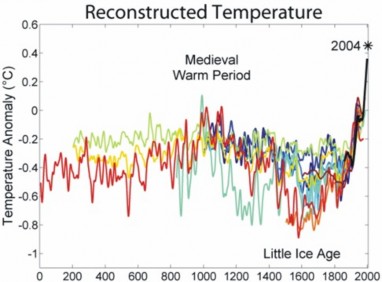
Figure 18.53: Global temperatures compiled from tree ring, coral growth, ice core analysis, and historical records, show relative stability over the last 2,000 years before about 1850, interrupted by a debatable Medieval warming and a more recent cooling termed the “Little Ice Age.” Colored lines indicate different published data sources. For more detail on the increase since 1850, refer to Figure 3. (55)

Figure 18.54: Paleoclimatological measures of global temperatures show dramatic fluctua- tions in temperature. Graphs should be read from right (past) to left (present). Ice core data for temperature is recorded in oxygen isotope units rather than oC. (22)
953 www.ck12.org
most rapid and extreme global warming events recorded in geologic history) 55 million years ago. Paleoclimatologist William Ruddiman proposes that human activities began to affect global CO2 levels as long ago as 8,000 years, when agriculture and deforestation began. Ruddiman argues that without this early contribution to greenhouse gases, cycles indicate the Earth would already have entered another Ice Age.

Figure 18.55: Over the past 450,000 years, temperature changes (blue) correlate closely with changes in atmospheric CO2 (green) and dust levels (red). (51)
Others dispute Ruddiman’s “overdue-glaciation” theory, but most scientists today agree that recent global warming since 1850 is caused by an unprecedented rise in atmospheric CO2 (Figure 18.56) which resulted from human activities – primarily burning of fossil fuels, but also continuing deforestation and changes in land use. Fossil fuels burn organic compounds in the same way your cells burn glucose to make ATP: a product of both reactions is CO2. Deforestation and other land use changes contributes to the CO2 levels from the opposite direction – a decrease in photosynthesis, which would have removed CO2 from the atmosphere. Slash-and-burn destruction of tropical forests combines the worst of both worlds; burning adds CO2 to the atmosphere, and the loss of layers of vegetation decreases CO2 use.
Two additional greenhouse gases having anthropogenic (human activity) sources are methane (CH4) and nitrous oxide (NO). Agriculture adds both of these to the atmosphere; cattle production is responsible for much of the methane, a powerful greenhouse gas. Land use changes, waste processing, and fossil fuel production, which we’ve already implicated in CO2 increases, are other anthropogenic (human-caused) sources. A last but important contributing factor is secondary to these primary causes; triggers of “runaway greenhouse effects” will be discussed below.
www.ck12.org 954
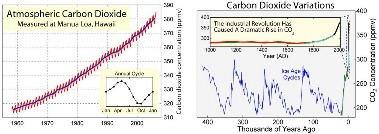
Figure 18.56: Since the Industrial Revolution began, the burning of fossil fuels has dramat- ically increased atmospheric concentrations of CO2 to levels unprecedented in the last 400 thousand years. The graph on the right integrates recent measurements with paleoclimato- logic data. (41)
Although the causal connections between fossil fuel combustion, deforestation, greenhouse gases, the greenhouse effect, and global warming have been strongly debated in the past, the majority of the world’s scientific organizations now support these relationships, and many use the term “consensus.” (See “Scientific Opinion about Climate Change” in Further Reading.) The awarding of the Nobel Peace Prize to the organization which focuses most directly on climate change, the IPCC, highlights this consensus. Alternative hypotheses include variation in solar activity; several references are included in Further Reading. The IPCC projects future temperature increases ranging from 1.1 °C to 6.4 °C (2.0 °F to 11.5
°F) between 1990 and 2100. Predictions from multiple models which incorporate connections between greenhouse emissions and global warming are summarized in Figure 18.57; all show significant rises in temperature by 2100.
Once again, then, we “have met the enemy” and “he is us.” What have we done? What are the environmental and socioeconomic consequences of this human disruption in atmospheric equilibrium?
A partial list of effects of climate change includes:
Direct Physical Effects
Melting of glaciers and a consequent rise in sea level, already documented (Figure 18.58)
Sea level rise of 18-59 cm predicted by 2100
River flooding followed by drought
Coastal flooding and shoreline erosion
Melting permafrost, leading to release of bog methane (CH4) increasing warming via positive feedback*
955 www.ck12.org

Figure 18.57: Various models of climate change which include “business-as-usual” increases in greenhouse gas emissions predict continuing increases in global temperature; this graph compares the projected increases to temperatures during the year 2000. (45)

Figure 18.58: Glacial melting (left) and a rise in sea level (right) are two consequences of global warming. The left image shows the Larsen Ice Shelf B, which broke up during February of 2002 after bordering Antarctica for as long as 12,000 years. Excluding polar ice caps, 50% of glacial areas have disappeared since the turn of the century. Although sea levels have risen since the end of the last Ice Age, rates increased by a factor of 10 beginning about 1900. (56)
www.ck12.org 956
Changing patterns of precipitation
Regional drought
Regional flooding
Ocean warming, leading to increased evaporation
Increasing rainfall
Increasing erosion, deforestation, and desertification
Release of sedimentary deposits of methane (CH4) hydrates – positive feedback*
Ocean acidification: 0.1 pH unit drop already documented; 0.5 more predicted by 2100
Loss of corals
Loss of plankton and fish
Temperature extremes
Increasing severity of storms such as tropical cyclones, already documented (Figure 18.59)
Further reductions in the Ozone Layer (due to cooling of the stratosphere)
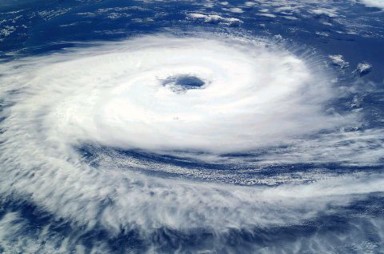
Figure 18.59: The proportion of hurricanes reaching category 4 or 5 increased from 20% in the 1970s to 35% in the 1990s. The EPA and the World Meteorological Organization connect this increase to global warming, and NOAA scientists predict a continuing increase in frequency of category 5 storms as greenhouse gases rise. (13)
Ecosystem Effects
Contributions to the Sixth Extinction reaching as much as 35% of existing plant and animal species
Decline in cold-adapted species such as polar bears and trout
Increase in forest pests and fires
Change in seasonal species, already documented
957 www.ck12.org
Potential increase in photosynthesis, and consequent changes in plant species
Loss of carbon to the atmosphere due to
Increasing fires, which together with deforestation lead to positive feedback
Increasing decomposition of organic matter in soils and litter
Socioeconomic Threats Result From Some of the Above Changes
These include:
Crop losses due to climate and pest changes and desertification
Increasing ranges for disease vectors (e.g., mosquitoes – malaria and dengue fever)
Losses of buildings and development in coastal areas due to flooding
Interactions between drought, desertification, and overpopulation leading to increasing conflicts (Figure 18.60)
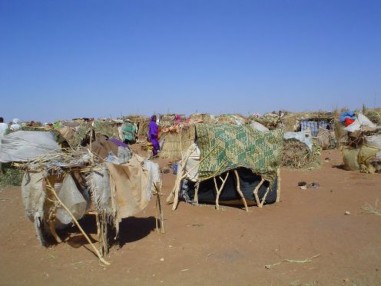
Figure 18.60: A camp in Sudan houses refugees from the far western province of Darfur, who fled from genocide intensified by severe drought. The Darfur conflict echoes predictions that global warming may increase drought and desertification in overpopulated regions and result in more such tragedies. (59)
Costs to the insurance industry as weather-related disasters increase
Increased costs of maintaining transportation infrastructure
Interference with economic development in poorer nations
Water scarcity, including pollution of groundwater
Heat-related health problems www.ck12.org 958
Threats to Political Stability
Migrations due to poverty, starvation, and coastal flooding
Competition for resources
Note that at least three(*) of the direct physical effects – melting permafrost, ocean warming, and forest fires/deforestation - can potentially accelerate global warming, because tempera- ture increases result in release of more greenhouse gases, which increase temperatures, which result in more greenhouse gases – a positive feedback system aptly termed a “runaway greenhouse effect.” Here’s how it could work: rising temperatures are warming the oceans and thawing permafrost. Both oceans and permafrost currently trap huge quantities of methane – beneath sediments and surface – which would undergo massive releases if tem- peratures reach a critical point. Recall that methane is one of the most powerful greenhouse gases, so the next step would be further increase in temperatures. Warmer oceans and more thawed permafrost would release more quantities of methane – and so on. These compound- ing effects are perhaps the most convincing arguments to take action to reduce greenhouse gas emission and global warming.
What measures have been considered?
Preventing Climate Change
Basically, greenhouse gases are products of fossil fuel combustion; according to the EPA, more than 90% of U.S. greenhouse gas emissions come from burning oil, coal, and natural gas. Therefore, energy use is the primary target for attempts to reduce future global warming. In Figure 18.61 you can see the sources of emission for three major greenhouse gases in 2000, when CO2 was 72% of the total, CH4 18%, and NO 9%. Chlorofluorocarbons (CFCs, HCFCs, and HFCs) are also greenhouse gases; refer to the lesson on The Atmosphere for more information about them.
Knowing the causes of climate change allows us to develop potential solutions. Direct causes include combustion of fossil fuels, deforestation and other land use changes, cattle production, agriculture, and use of chlorofluorocarbons. Runaway effects can result from temperature- dependent release of methane from permafrost and ocean sediments, and forest fires or intentional burning. Unfortunately, the best way to avoid runaway effects is to prevent temperature increases. Prevention, then, should address as many of these causes as possible. A partial list of solutions being considered and adopted follows.
Reduce energy use.
Switch to cleaner “alternative” energy sources, such as hydrogen, solar, wind, geother- mal, waste methane, and/or biomass.
Increase fuel efficiencies of vehicles, buildings, power plants, and more.
Increase carbon (CO2) sinks, which absorb CO2 - e.g., by planting forests.
959 www.ck12.org
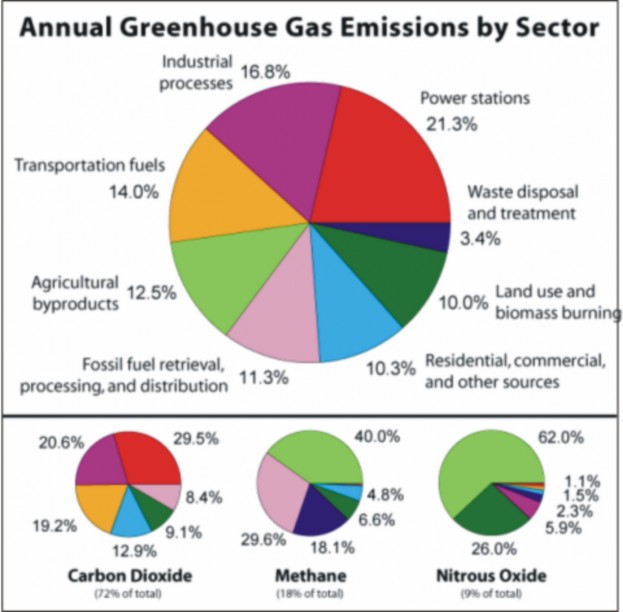
Figure 18.61: Global greenhouse emissions during 2002 show sources for each of the three ma- jor greenhouse gases. Knowing the causes makes finding solutions clear, but not necessarily easy! (24)
www.ck12.org 960
Cap emissions release, through national and/or international legislation, alone or in combination with carbon offset options (see below).
Sell or trade carbon offsets or carbon credits. Credits or offsets exchange reduc- tions in CO2 or greenhouse emissions (tree-planting, investment in alternative energy sources, methane capture technologies) for rights to increase CO2 (personally, as for air travel, or industry-wide).
Key urban planning to energy use, e.g., efficient public transportation.
Develop planetary engineering: radical changes in technology (such as building solar shades of dust, sulfates, or microballoons in the stratosphere), culture (population con- trol), or the biosphere (e.g. iron-seeding of the oceans to produce more phytoplankton to absorb more CO2).
Legislate Action: International agreements such as the 2005 Kyoto Protocol (which the US has not yet ratified), or national carbon taxes or caps on emissions. Interestingly, in the U.S., some States and groups of States are taking the lead here.
Set goals of carbon neutrality: in 2007, the Vatican announced plans to become the first carbon-neutral state.
Support developing nations in their efforts to industrialize and increase standards of living without adding to greenhouse gas production.
Every potential solution has costs and benefits which must be carefully considered. Human health, cultural diversity, socioeconomics, and political impacts must be considered and kept in balance. For example, nuclear power involves fewer greenhouse gas emissions, but adds the new problems of longterm radioactive waste transport and storage, danger of radiation exposure to humans and the environment, centralization of power production, and limited supplies of “clean” uranium fuels. Studies of costs and benefits can result in solutions which make effective tradeoffs and therefore progress toward the goal of lowering greenhouse gases and minimizing future global warming.
We have reached the point where we understand how and the extent to which our activities have destabilized the Earth’s atmosphere and reduced and threatened its ecosystem services. Now we need to move one step further, and put our knowledge to work in the form of action.
What will you do to help?
Lesson Summary
The awarding of the 2007 Nobel Peace Prize to the Intergovernmental Panel on Climate Change (IPCC) and former US Vice President Al Gore recognizes the potential impact of global warming on the economic, social, and political welfare of the world.
The greenhouse effect is an ecosystem service which warms the Earth to temperatures which support life.
961 www.ck12.org
The greenhouse effect involves water, carbon dioxide, methane, and ozone, which ab- sorb heat that would otherwise be radiated out into space.
Earth’s atmosphere maintains an equilibrium between heat added by sunlight and heat lost by radiation.
The atmosphere of Mars is too thin to hold heat, and that of Venus is so thick that temperatures reach 500oC.
In 2000, the major greenhouse gases were CO2, CH4, and NO; CFCs and H2O con- tribute, as well.
Global warming refers to an increase in the Earth’s temperature of 0.74°C (1.33°F) within the past 100 years.
Paleoclimatologists document changes in the Earth’s temperature over millions of years which cycle between tropical and ice age extremes – a variation of 10oC.
Greenhouse gases, especially CO2 levels, often correlate with temperature changes.
Deforestation and agriculture – by reducing levels of CO2 uptake – may have initiated warming 8,000 years ago.
Most scientists today agree that fossil fuel combustion, deforestation, and agriculture contribute to greenhouse gases and the greenhouse effect.
Global warming can cause physical changes for the Earth: melting of glaciers and permafrost, changes in precipitation patterns, temperature extremes, warming and acidification of the oceans, and ozone depletion.
Melting of oceans and permafrost can release methane, resulting in a “runaway green- house effect.”
Ecological effects may include loss of biodiversity and addition of still more CO2 to the
atmosphere.
Socioeconomic threats include crop losses, increased disease, water scarcity, and coastal flooding.
Population growth and socioeconomic factors (especially interference with third world development) can combine to produce political instability and conflict.
Most greenhouse gases are products of fossil fuel combustion, so reduced use, increased efficiency, and alternative fuel development are primary means of prevention of climate change.
CO2 uptake can be increased by eliminating deforestation, reforestation, and green
roofs technology.
Legislation from local to international levels can cap emissions and develop carbon offset trading.
Careful urban planning can increase the efficiency of transportation and energy use.
Planetary engineering could enact radical changes in technology, culture, or the bio- sphere.
Support of third world efforts to develop without adding greenhouse gases could im- prove global stability.
www.ck12.org 962
Every potential solution has costs and benefits which must be carefully considered; tradeoffs are necessary.
Review Questions
Explain the mechanism of the greenhouse effect.
Compare the effects of the greenhouse effect on Mars and Venus to that on Earth.
Define and quantify global warming.
Describe paleoclimatic changes over the course of Earth’s history. How are these data collected, when no one was around to measure temperatures?
Summarize the evidence for greenhouse gases as the cause of recent global warming.
Discuss the significance of global warming for Earth’s ecosystems.
Relate global warming to current global stability.
Connect the atmospheric gases that absorb the Earth’s thermal radiation to their sources.
Combustion of fossil fuels is a common denominator for many problems related to Atmospheric and Water Resources. Clarify the connections for as many problems as you are able.
Distinguish between and describe the importance to global warming prevention of carbon sequestration, carbon sinks, carbon offsets, emission caps, emissions trading, and carbon neutrality.
Further Reading / Supplemental Links
Robert Lee Hotz, Huge Dust Plume from China Cause Changes in Climate. Wall Street Journal Online, 20 July, 2007;
http://online.wsj.com/public/article/SB118470650996069354-buQPf_FL_nKirvopk_
_GzCmNOq8_20070818.html?mod=tff_main_tff_top.
NASA, The Greenhouse Effect. NASA Facts Online, NASA Goddard Space Flight Center, NF-182 June 1993;
http://www.gsfc.nasa.gov/gsfc/service/gallery/fact_sheets/earthsci/green. htm.
http://www.ifm-geomar.de/fileadmin/personal/fb1/p-oz/mfrank/Bard_and_Frank_ 2006.pdf
http://www.dsri.dk/~hsv/prlresup2.pdf
http://ipcc-wg1.ucar.edu/wg1/Report/AR4WG1_Print_Ch02.pdf;
http://en.wikipedia.org/wiki/
http://www.panda.org/about_wwf/what_we_do/climate_change/index.cfm
http://www.epa.gov/climatechange/index.html
http://www.crest.org/
http://www.eere.energy.gov/
963 www.ck12.org
Vocabulary
anthropogenic sources Sources of pollution related to human activities.
carbon (CO2) sink A reservoir which increases absorption of CO2 – e.g. a forest planta- tion.
carbon offsetting Mitigating or reducing greenhouse gas emissions, often as a trade-off from one location to another.
carbon sequestration Process which removes CO2 from the atmosphere.
carbon-neutral Describes an individual, activity, industry, or a political unit which bal- ances CO2 release with activities which sequester carbon.
emissions cap Upper limit on CO2 (or other pollutant) release; may be tradable or sell- able.
emissions trading Reducing greenhouse emissions by purchasing or exchanging means of reducing CO2 in exchange for rights to release CO2 .
global warming The recent increase in the Earth’s average near-surface and ocean tem- peratures.
greenhouse effect The trapping by the atmosphere of heat energy radiated from the Earth’s surface.
greenhouse gas Atmospheric substance which transmits solar radiation but absorbs in- frared radiation: CO2, CH4 and NO, for example.
planetary engineering Radical, often global changes in technology, culture, or the bio- sphere management.
runaway greenhouse effect A positive feedback loop in which increasing temperature triggers the release of more greenhouse gases, which further increase temperature, which releases more gases.
www.ck12.org 964
Points to Consider
Do you think global warming is a good example of an “ecosystem service” – or perhaps a “ biosphere service?” Explain your reasoning.
How is the Greenhouse Effect both positive and negative?
Which of the suggestions for preventing climate change do you think are most realistic for you?
How might you, as an individual, contribute to national and international solutions to climate change?
How might we do a better job of building the costs of global warming into the economics of fossil fuel use, deforestation, agriculture, and cattle production?
Image Sources
Elin Whitney Smith. http://en.wikipedia.org/wiki/File: Extinctions_Africa_Austrailia_NAmerica_Madagascar.gif. Public Domain.
NASA. http://commons.wikimedia.org/wiki/Image:Atmospheric_ozone.svg. Public Domain NASA.
http://www.flickr.com/photos/smudger888/118152020/. (a)Public Domain (b)CC-BY.
http://commons.wikimedia.org/wiki/Image:Venuspioneeruv.jpg.
CK-12 Foundation. http://commons.wikimedia.org/wiki/File:Phanerozoic_Biodiversity.png. CC-BY-SA-2.5, 2.0, 1.0.
US EPA. http://www.sbcapcd.org/sbc/climatechange.htm. Public Domain.
http://commons.wikimedia.org/wiki/Image:Lovci_mamutu_mammoth.jpg http://commons.wikimedia.org/wiki/File:Dodo_1.JPG http://commons.wikimedia.org/wiki/Image:Bufo_periglenes1.jpg. (a) Public Domain (b) CC-BY-SA-2.5 (c) GNU-FDL (d) Public Domain.
Zakuragi. http://commons.wikimedia.org/wiki/Image:Costaricamap.png. GNU-FDL.
http://en.wikipedia.org/wiki/Image:No_till_farming_USDA.jpg. Public Domain, Public Domain.
NASA. http://commons.wikimedia.org/wiki/Image:Min_ozone.jpg. Public Domain-US Government-NASA.
965 www.ck12.org
User Omegatron. http://commons.wikimedia.org/wiki/Image: World_energy_usage_width_chart.svg. CC-BY-SA-3.0, 2.5, 2.0, 1.0.
http://en.wikipedia.org/wiki/Image:Iwimi.jpg. Public Domain.
Earth Observations Laboratory, Johnson Space Center. http://commons.wikimedia.org/wiki/File: Cyclone_Catarina_from_the_ISS_on_March_26_2004.JPG. Public Domain.
http://commons.wikimedia.org/wiki/Image: Green_Roof_at_Vend%C3%A9e_Historial%2C_les_Lucs.jpg. (a) CC-BY-SA-2.5,2.0,1.0 (b) Public Domain.
Craig Mayhew and Robert Simmon, NASA GSFC. http://commons.wikimedia.org/wiki/Image:Earthlights_dmsp.jpg. Public Domain NASA.
http://commons.wikimedia.org/wiki/Image:
Dust_Bowl_-_Dallas%2C_South_Dakota_1936.jpg. (a)Public Domain (b)Public Domain.
http://ga.water.usgs.gov/edu/waterdistribution.html. Public Domain.
Environmental Protection Agency (EPA).
http://en.wikipedia.org/wiki/Image:Origins.gif. Public Domain.
Barbara Akre. http://en.wikipedia.org/wiki/Biodiversity.
Rich Anderson. http://commons.wikimedia.org/wiki/Image:Monitor_in_gutter.jpg. CC-BY-SA-2.0.
NASA. http:
//www.nasa.gov/centers/goddard/news/topstory/2007/aerosol_dimming.html. Public Domain US Gov NASA.
Robert A. Rohde. http://en.wikipedia.org/wiki/Image:Phanerozoic_Climate_Change.png. GFDL.
NASA.
http://commons.wikimedia.org/wiki/Image:Pollution_over_east_China.jpg. Public Domain US Government, NASA.
Robert A. Rohde. http://commons.wikimedia.org/wiki/Image:Greenhouse_Gas_by_Sector.png. GNU-FDL.
www.ck12.org 966
Nino Barbieri. http://commons.wikimedia.org/wiki/Image: Pollution_-_Damaged_by_acid_rain.jpg. GFDL.
Daniel Case. http://commons.wikimedia.org/wiki/Image:Zebra_mussel_warning_sign.jpg. GFDL.
Roger McLassus.
http://commons.wikimedia.org/wiki/Image:2006-01-21_Detaching_drop.jpg. GFDL.
SG. http://commons.wikimedia.org/wiki/Image:
Energy-consumption-per-capita-2003.png. GFDL, CC-BY-SA-2.5.
Robert A. Rohde. http://commons.wikimedia.org/wiki/Image:Global_Warming_Map.jpg. GNU-FDL.
http://commons.wikimedia.org/wiki/Image:Plants_diversity.jpg. CC-BY-SA-3.0, CC-BY-SA-3.0, 2.5, 2.0, 1.0.
http://commons.wikimedia.org/wiki/Image:Coral_Garden.jpg http://commons.wikimedia.org/wiki/File:Blue_Linckia_Starfish.JPG http://commons.wikimedia.org/wiki/Image: Rain_Forest_of_El_Yunque%2C_Puerto_Rico.jpg http://commons.wikimedia.org/wiki/Image:Forest_on_Barro_Colorado.png. (a)Public Domain (b)CC-BY-SA-2.0 (c)CC-BY-SA(d)Public Domain (e) CC-BY-2.5.
http://commons.wikimedia.org/wiki/Image:Kissing_Prairie_dog_edit_3.jpg http://commons.wikimedia.org/wiki/Image:Andropogon_gerardii.jpg http://commons.wikimedia.org/wiki/Image: Yellow_Coneflower_Echinacea_paradoxa_Twisted_Pair_DoF_2000px.jpg http://commons.wikimedia.org/wiki/Image: Monarch_Butterfly_Danaus_plexippus_Purple_Coneflower_3008.jpg http://commons.wikimedia.org/wiki/Image:Bouteloua_gracilis.jpg http://en.wikipedia.org/wiki/Image: Tallgrass_Prairie_Nature_Preserve_in_Osage_County.jpg. (a)Public Domain (b)CC-BY-SA-2.5, 2.0, 1.0 (d)Public Domain (e)GNU-FDL (f)GNU-FDL (g)Public
Domain (h)Public Domain.
http://commons.wikimedia.org/wiki/Image:Pollution_de_l%27air.jpg. (a) Public Domain-User (b) Public Domain-Self.
967 www.ck12.org
User Arnejohs. http://en.wikipedia.org/wiki/Image:Atlantic_cod_capture_1950_2005.png. Public Domain.
NASA.
http://commons.wikimedia.org/wiki/Image:160658main2_OZONE_large_350.png. Public Domain US-Government-NASA.
Barbara Gavin Akre, using data from Carrol Henderson, “Minnesota to Costa Rica: The Rain Forest Connection.” Minnesota Volunteer, April 1988. Published by the Minnesota Department of Natural Resource. http:
//commons.wikimedia.org/wiki/Image:Timber_Rattlesnake_Image_004.jpg http://commons.wikimedia.org/wiki/Image:
Keel-billed_toucan%2C_costa_rica.jpg http://commons.wikimedia.org/wiki/Image:Rubythroathummer65.jpg http://commons.wikimedia.org/wiki/Image:Two-toed_sloth_Costa_Rica.jpg http://commons.wikimedia.org/wiki/Image:Bat_flying_at_night.png http://commons.wikimedia.org/wiki/Image:Blue_morpho_butterfly.jpg http://commons.wikimedia.org/wiki/Image:Cypripedium_reginae.jpg http://commons.wikimedia.org/wiki/Image:Strangler_fig_kerala.jpg. (a)Public Domain (b)Public Domain (c)CC-BY-3.0, 2.5, 2.0, 1.0 (d)Public Domain (e)CC-BY-2.5 (f)CC-BY-2.5 (g)GFDL (h)GFDL (i)CC-BY-2.5.
CK-12 Foundation. http://commons.wikimedia.org/wiki/Image:Harare_secondst.jpg http://commons.wikimedia.org/wiki/Image:Ostracion_cubicus.jpg. CC-BY-SA (a)CC-BY-2.5 (b) CC-BY-SA-2.5,2.0,1.0 (c) CC-BY-2.5.
Keith Weller of Agricultural Research Service.
http://commons.wikimedia.org/wiki/Image:GEM_corn.jpg. Public Domain.
http://commons.wikimedia.org/wiki/Image:Plumpollen0060.jpg http://commons.wikimedia.org/wiki/Image:Animal_marinho1813.JPG http://commons.wikimedia.org/wiki/Image:CabbagepestsRetouched.png http://commons.wikimedia.org/wiki/Image: Falco_peregrinus_nest_USFWS_free.jpg. (a)Public Domain (b)GNU-FDL (c)GNU-FDL (d)CC-BY-SA-2.5 (e)Public Domain.
N. Reto Stöckli. http://commons.wikimedia.org/wiki/Image:Earth_Western_Hemisphere.jpg. Public Domain US Government, NASA.
http://commons.wikimedia.org/wiki/File:Carbon_Dioxide_400kyr.png. (a)GNU-FDL (b)GNU-FDL.
www.ck12.org 968
Holger K. http://commons.wikimedia.org/wiki/File:Stagnogley.JPG. Public Domain.
http://commons.wikimedia.org/wiki/Image:Caspian_Sea_from_orbit.jpg. (a)Public Domain (b)Public Domain.
http://commons.wikimedia.org/wiki/Image:Acid_rain_woods1.jpg. Public Domain.
Robert A. Rohde. http://commons.wikimedia.org/wiki/Image:Global_Warming_Predictions.png. GNU-FDL.
(46) . (a) CC-BY-SA-2.5 (b) GFDL (c) CC-BY-SA-2.5 (d) CC-BY-SA-2.5, 2.0, 1.0.
http://www.gsfc.nasa.gov/topstory/20020926landcover.html. Public Domain.
United States Department of Agriculture. http://commons.wikimedia.org/wiki/Image:National_Organic_Program.jpg. Public Domain.
NASA.
http://commons.wikimedia.org/wiki/Image:TOMS_Global_Ozone_65N-65S.png. Public Domain-US Government-NASA.
Robert A. Rohde. http://commons.wikimedia.org/wiki/Image: Instrumental_Temperature_Record.png. GNU-FDL.
http://commons.wikimedia.org/wiki/Image:Vostok-ice-core-petit.png. GFDL.
http://commons.wikimedia.org/wiki/File:Lacanja_burn.JPG. Public Domain.
Wagner Christian. http://commons.wikimedia.org/wiki/Image:Windenergy.jpg. CC-BY-SA-2.5.
NASA. http://commons.wikimedia.org/wiki/Image:Ozone_cycle.jpg. Public Domain-US Government-NASA.
Robert A. Rohde. http://commons.wikimedia.org/wiki/Image: Instrumental_Temperature_Record.png. GNU-FDL.
http://commons.wikimedia.org/wiki/Image:Recent_Sea_Level_Rise.png. (a)GNU-FDL (b)GNU-FDL.
Anthony Bley, U.S. Army Corps of Engineers. http://commons.wikimedia.org/wiki/File:Wetlands_Cape_May_New_Jersey.jpg. Public Domain US Army USACE.
969 www.ck12.org
Johann Dréo. http://commons.wikimedia.org/wiki/Image:Sustainable_development.svg. CC-BY-SA-2.0.
http://commons.wikimedia.org/wiki/Image:Darfur_IDPs_1_camp.jpg. Public Domain.
http://en.wikipedia.org/wiki/Image:Waterspecies.gif. Public Domain-US Government-EPA.
Frank van Mierlo.
http://en.wikipedia.org/wiki/Image:Available_Energy-2.jpg. GNU-FDL, CC-BY-2.5.
www.ck12.org 970
The Human Body
Lesson 19.1: Organization of the Human Body
Lesson Objectives
Describe the levels of organization of the human body.
Outline the role of a specialized cell.
Identify the properties that make body cells and stem cells different from each other.
List three types of stem cells.
Identify the four tissue types found in the human body.
Summarize how tissues and organs relate to each other.
Name two body systems that work together for a common purpose.
Introduction
In most multicellular organisms, not all cells are alike. For example, the cells that make up your skin are different from cells that make up your liver, your blood, or your eyes. Yet, all these specialized cells develop from one single fertilized egg which means all of your cells have the same DNA. But liver, blood, and eye cells are very different from each other in form and function. While these cells are specialized for a specific job, there are other cells in the body that remain unspecialized. These cells multiply continuously to replace the millions of different body cells that die and need to be replaced every day.
Cells
Cells are the most basic units of life in your body. Each specialized cell has a specific function in the body. For example, nerve cells transmit electrical messages around the body,
971 www.ck12.org
and white blood cells patrol the body and attack invading bacteria. Other cells include specialized cells in the kidney (such as kidney glomerulus parietal cell), brain cells (such as astrocytes), stomach cells (such as parietal cells), and muscle cells (such as red and white skeletal muscle fibers). Cells group together in tissues to carry out a specific function, and different tissues work together to form organs. This grouping of cells and tissues is referred to as levels of organization. Complex multicellular organisms, which include flatworms and humans, have different levels of organization.
Differentiation
Every cell in the body originated from a single fertilized egg, which is called a zygote. The zygote divides many times to produce an embryo. These embryonic cells differentiate into many different cell types which in time give rise to all the cells types present in the body of all humans (and other mammals), from a new-born baby to an elderly adult. Differentiation is the process by which an unspecialized cell (such as a fertilized egg cell), divides many times to produce specialized cells that work together and make up the body. During differentiation, certain genes are turned on, or become activated, while other genes are switched off, or inactivated. This process is regulated by the cell. A differentiated cell will develop specific structures and perform certain functions.
A cell that is able to differentiate into all cell types within a body is called totipotent. They have “total potential” to differentiate into any cell type. In mammals, only the zygote and early embryonic cells are totipotent. A cell that is able to differentiate into many cell types, but not all, is called pluripotent. Such cells have “plural potential,” (but not “total potential”) to differentiate into most but not all cell types.
Stem Cells
An unspecialized cell that can divide many times and give rise to different, specialized cells is called a stem cell, as shown in Figure 19.1. Zygotes and embryonic cells are both types of stem cells. The stem cells found in embryos can divide indefinitely, can specialize into any cell type and are called embryonic stem cells. Embryonic stem cells are totipotent. Undifferentiated cells that are found within the body and that divide to replace dying cells and damaged tissues are called adult stem cells. Adult stem cells can divide indefinitely, and generate all the cell types of the organ from which they originate. They can potentially re-grow the entire organ from just a few cells. A third type of stem cell is found in blood from the umbilical cord of a new-born baby, and the placenta. These ”cord blood stem cells” are considered to be adult stem cells because they cannot generate all body cell types, just different types of blood cells. Therefore, adult stem cells and cord blood stem cells are pluripotent.
www.ck12.org 972
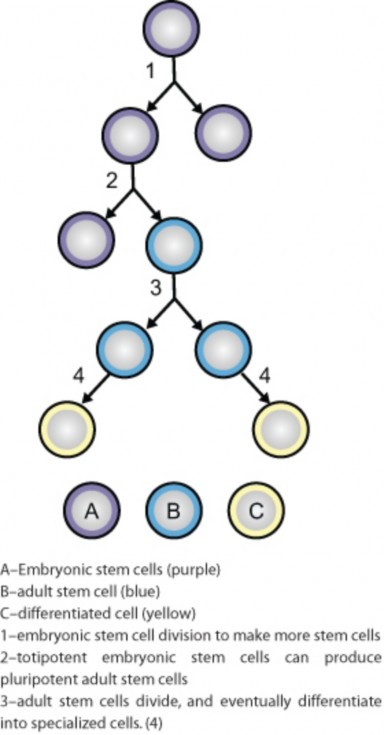
Figure 19.1: Division and differentiation of stem cells into specialized cells. (5)
973 www.ck12.org
Stem Cells in Medicine
Stem cells are of great interest to researchers because of their ability to divide indefinitely, and to differentiate into many cell types. Stem cells have many existing or potential therapeutic applications. Such therapies include treatments for cancer, blood disorders, brain or spinal cord injuries, and blindness.
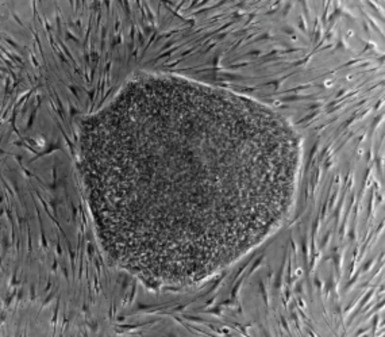
Figure 19.2: Human embryonic stem cell colony, which was grown in a laboratory on a feeder layer of mouse cells. Embryonic stem cells are totipotent. A video of human embryonic stem cell and their uses is available at http://www.sumanasinc.com/webcontent/animations/ content/stemcells_scnt.html. An animation of stem cell procedures is available at http:
//www.pbs.org/newshour/health/stem_cells.swf. (3)
Embryonic stem cells, as shown in Figure 19.2, are taken from eggs that were fertilized in the laboratory and donated to research. They may have the greatest potential because they are totipotent, and thus have the most potential medical applications. However, embryonic stem cells harvested from a donated embryo differ from a potential patient’s tissue type. Therefore, just as in organ transplantation, there is a risk of a patient’s body rejecting transplanted embryonic stem cells. Some individuals and groups have objections to the harvesting of embryonic stem cells, because harvesting the stem cells involves the destruction of the embryo. Some researchers are looking into methods to extract embryonic stem cells without destroying the actual embryo. Other researchers have claimed success in harvesting embryonic stem cells from the embryonic fluid that surrounds a growing fetus.
Adult stem cells, including cord blood stem cells, have already been used to treat diseases www.ck12.org 974
of the blood such as sickle-cell anemia and certain types of cancer. Unlike embryonic stem cells, the use of adult stem cells in research and therapy is not controversial because the production of adult stem cells does not require the destruction of an embryo. Adult stem cells can be isolated from a tissue sample, such as bone marrow, from a person. Scientists have recently discovered more sources of adult stem cells in the body. Adult stem cells have been found in body fat, the inside lining of the nose, and in the brain. Some researchers are investigating ways to revert adult stem cells back to a totipotent stage.
Tissues
A tissue is a group of connected cells that have a similar function within an organism. The simplest living multicellular organisms, sponges, are made of many specialized types of cells that work together for a common goal. Such cell types include digestive cells, tubular pore cells, and epidermal cells. Though the different cell types create a large organized, multicellular structure—the visible sponge—they are not organized into true tissues. If a sponge is broken up by passing it through a sieve, the sponge will reform on the other side.
More complex organisms such as jellyfish, coral, and sea anemones have a tissue level of organization. For example, jellyfish have tissues that have separate protective, digestive, and sensory functions. There are four basic types of tissue in the body of all animals, including the human body. These make up all the organs, structures and other contents of the body. Figure 19.3 shows an example of each tissue type.
The four basic types of tissue are:
Epithelial tissue is made up of layers of tightly packed cells that line the surfaces of the body for protection, secretion, and absorption. Examples of epithelial tissue include the skin, the lining of the mouth and nose, and the lining of the digestive system.
Muscle tissue is made up of cells contain contractile filaments that move past each other and change the size of the cell. There are three types of muscle tissue: smooth muscle which is found in the inner linings of organs; skeletal muscle, which is attached to bone and moves the body; and cardiac muscle which is found only in the heart.
Nervous tissue is made up of the nerve cells (neurons) that together form the nervous system, including the brain and spinal cord.
Connective tissue is made up of many different types of cells that are all involved in structure and support of the body. Bone, blood, fat, and cartilage are all connective tissues. Connective tissue can be densely packed together, as bone cells are, or loosely packed, as adipose tissue (fat cells) are.
975 www.ck12.org

Figure 19.3: (a) Scanning electron micrograph (SEM) image of lung trachea epithelial tis- sue, (b) Transmission electron micrograph (TEM) image of skeletal muscle tissue, (c) Light microscope image of neurons of nervous tissue, (d) red blood cells, a connective tissue. (9)
Organs and Organ Systems
Organs are the next level of organization in the body. An organ is a structure made of two or more tissues that work together for a common purpose. Skin, the largest organ in the body, is shown in Figure 21.41. Organs can be as primitive as the brain of a flatworm (a group of nerve cells), as large as the stem of a sequoia (up to 90 meters in height (300 feet)), or as complex as a human liver. The human body has many different organs, such as the heart, the kidneys, the pancreas, and the skin. Two or all of the tissue types can be found in an organ. Organs inside the body are called internal organs. The internal organs collectively are often called viscera.
The most complex organisms have organ systems. An organ system is a group of organs that act together to carry out complex interrelated functions, with each organ focusing on a part of the task. An example of an organ system is the human digestive system in which the mouth and esophagus ingests food, the stomach crushes and liquefies it, the pancreas and gall bladder make and release digestive enzymes, and the intestines absorb nutrients into the blood. An organ can be part of more than one organ system. For example the ovaries produce hormones which make them a part of the endocrine system. The ovaries also make eggs which makes them part of the reproductive system. One of the most important functions of organ systems is to provide cells with oxygen and nutrients and removes toxic waste products such as carbon dioxide. A number of organ systems, including the cardiovascular and respiratory systems, work together to do this.
The different organ systems of the body are shown in Table 19.1. Sometimes the cardiovas- cular system and the lymphatic system are grouped together into one single system called the circulatory system.
www.ck12.org 976
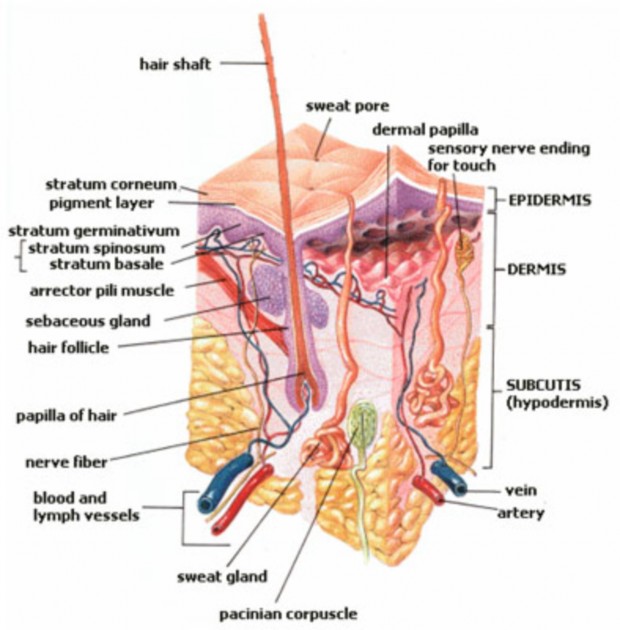
Figure 19.4: Your skin is the largest organ in your body. In this cross section image of skin, the four different tissue types (epithelial, connective, nervous, and muscle tissues) can be seen working together. (10)
977 www.ck12.org
Table 19.1: Major Organ Systems of the Human Body

Organ System Function Organs, Tissues, and Struc- tures Involved

Cardiovascular Transporting oxygen, nutri- ents and other substances to the body cells, and wastes, carbon dioxide, and other substances away from cells; it can also help stabilize body temperature and pH
Lymphatic Defense against infection and disease, transfer of lymph between tissues and the blood stream
Digestive Processing of foods and ab- sorption of nutrients, miner- als, vitamins, and water
Endocrine Communication within the body with hormones; di- recting long-term change over other organ systems to maintain homeostasis
Integumentary Protection from injury and fluid loss; physical defense against infection by microor- ganisms; temperature con- trol
Muscular Movement, support, heat production
Nervous Collecting, transferring and processing information; di- recting short-term change over other organ systems in order to maintain homeosta- sis
Reproductive Production of gametes (sex cells) and sex hormones; production of offspring
www.ck12.org 978
Heart, blood, blood vessels
Lymph, lymph nodes, lymph vessels
Salivary glands, esophagus, stomach, liver, gallbladder, pancreas, small intestine, large intestine
Among many, the pituitary gland, pineal gland, thyroid, parathyroid gland, adrenal glands, testes, and ovaries
Skin, hair, and nails
Skeletal, cardiac, and smooth muscles, tendons Brain, spinal cord, nerves, and sense organs (eyes, ears, tongue, skin, nose)
Fallopian tubes, uterus, vagina, ovaries, mammary glands, testes, vas deferens, seminal vesicles, prostate, and penis
Table 19.1: (continued)

Organ System Function Organs, Tissues, and Struc- tures Involved

Respiratory Delivery of air to sites where gas exchange can occur be- tween the blood and cells (around body) or blood and air (lungs)
Skeletal Support and protection of soft tissues of body; move- ment at joints; production of blood cells; mineral storage
Urinary Removal of excess water, salts, and waste products from blood and body; con- trol of pH
Immune Defending against microbial pathogens (disease-causing agents) and other diseases
Mouth, nose, pharynx, lar- ynx, trachea, bronchi, lungs, and diaphragm
Bones, cartilage, ligaments
Kidneys, ureters, urinary bladder, and urethra
Leukocytes, tonsils, ade- noids, thymus, and spleen

Lesson Summary
Not all cells are alike in a multicellular organism, but all of the cells in a multicellular organism have the same DNA.
Each specialized cell has a specific function in the body. Specialized cells group together to carry out a specific function.
Every cell in the body originated from a single zygote. The unspecialized zygote differentiates to produce specialized cells that work together and make up the body.
A cell that is able to differentiate into all cell types within a body is totipotent. Em- bryonic stem cells are totipotent.
A cell that is able to differentiate into many cell types, but not all types, is pluripotent. Adult stem cells and cord blood stem cells are pluripotent.
A tissue is a group of connected cells that have a similar function within an organism. There are four basic types of tissue in the body of all animals: connective, muscle, nervous, and epithelial.
An organ is a structure made of two or more different types of tissue that work together for a common purpose.
An organ system is a group of organs that act together to carry out complex related functions, with each organ focusing on a part of the task.
979 www.ck12.org
Review Questions
Give three examples of specialized cells.
Contrast specialized cells and stem cells.
Name three sources of stem cells.
List the four tissue types that are found in the human body, and give an example of each type.
These cells form the lining of the trachea. Identify the cells and the type of tissue of which the ciliated cells in Figure 19.5 are a part.
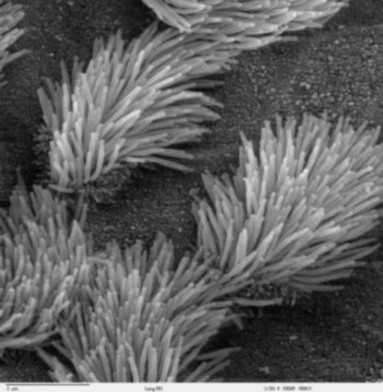
Figure 19.5: (4)
Summarize the relationship between tissues and organs.
Identify an organ that is part of two body systems.
A classmate says that the lymphatic system should not be an organ system in its own right, and is a part of the cardiovascular system. Do you agree or disagree with your classmate? Explain your answer by using your knowledge of organ systems.
www.ck12.org 980
Further Reading / Supplemental Links
Human Anatomy ©2003 by Fredric H. Martini, Inc. and Michael J.Timmons. Pub- lished by Pearson Education, Inc.
http://web.jjay.cuny.edu/~acarpi/NSC/14-anatomy.htm
http://en.wikipedia.org
Vocabulary
adult stem cells Undifferentiated cells that are found within the body and that divide to replace dying cells and damaged tissues.
cell The most basic unit of life; basic unit of structure and function in living organisms.
differentiation The process by which an unspecialized cell (such as a fertilized egg cell), divides many times to produce specialized cells that work together and make up the body.
embryonic stem cells Stem cells found in embryos that can divide indefinitely, and spe- cialize into any cell type.
organ A structure made of two or more tissues that work together for a common purpose.
organ system A group of organs that act together to carry out complex interrelated func- tions, with each organ focusing on a part of the task.
pluripotent A term that describes a cell that is able to differentiate into many cell types, but not all, within a body.
stem cell An unspecialized cell that can divide many times and give rise to different, specialized cells is called a stem cell.
tissue A group of connected cells that have a similar function within an organism.
totipotent A term that describes a cell that is able to differentiate into all cell types within a body.
981 www.ck12.org
Points to Consider
The smallest unit capable of carrying out life processes in your body is a single cell. Cells organize into tissues, which organize into organs. Groups of organs work together as organ systems. Consider how the last meal you consumed is interacting with each level of organization in your body.
Think about the advantages and disadvantages of having a body composed of many small cells as opposed to a single large cell.
Lesson 19.2: Homeostasis and Regulation
Lesson Objectives
Identify the process by which body systems are kept within certain limits.
Explain the role of feedback mechanisms in homeostasis.
Distinguish negative feedback from positive feedback.
Identify and example of two organ systems working together to maintain homeostasis.
Summarize the role of the endocrine system in homeostasis.
Outline the result of a disturbance in homeostasis of a body system.
Introduction
The human body is made up of trillions of cells that all work together for the maintenance of the entire organism. While cells, tissues, and organs may perform very different functions, all the cells in the body are similar in their metabolic needs. Maintaining a constant internal environment by providing the cells with what they need to survive (oxygen, nutrients, and removal of waste) is necessary for the well-being of individual cells and of the entire body. The many processes by which the body controls its internal environment are collectively called homeostasis. The complementary activity of major body systems maintains homeostasis.
Homeostasis
Homeostasis refers to stability, balance, or equilibrium within a cell or the body. It is an organism’s ability to keep a constant internal environment. Homeostasis is an important characteristic of living things. Keeping a stable internal environment requires constant ad- justments as conditions change inside and outside the cell. The adjusting of systems within a cell is called homeostatic regulation. Because the internal and external environments of a cell are constantly changing, adjustments must be made continuously to stay at or near the set point (the normal level or range). Homeostasis can be thought of as a dynamic equilibrium rather than a constant, unchanging state.
www.ck12.org 982
Feedback Regulation Loops
The endocrine system plays an important role in homeostasis because hormones regulate the activity of body cells. The release of hormones into the blood is controlled by a stimulus. For example, the stimulus either causes an increase or a decrease in the amount of hormone secreted. Then, the response to a stimulus changes the internal conditions and may itself become a new stimulus. This self-adjusting mechanism is called feedback regulation.
Feedback regulation occurs when the response to a stimulus has an effect of some kind on the original stimulus. The type of response determines what the feedback is called. Negative feedback occurs when the response to a stimulus reduces the original stimulus. Positive feedback occurs when the response to a stimulus increases the original stimulus.
Thermoregulation: A Negative Feedback Loop
Negative feedback is the most common feedback loop in biological systems. The system acts to reverse the direction of change. Since this tends to keep things constant, it allows the maintenance of homeostatic balance. For instance, when the concentration of carbon dioxide in the human body increases, the lungs are signaled to increase their activity and exhale more carbon dioxide, (your breathing rate increases). Thermoregulation is another example of negative feedback. When body temperature rises, receptors in the skin and the hypothalamus sense the temperature change. The temperature change (stimulus) triggers a command from the brain. This command, causes a response (the skin makes sweat and blood vessels near the skin surface dilate), which helps decrease body temperature. Figure
shows how the response to a stimulus reduces the original stimulus in another of the body’s negative feedback mechanisms.
Positive feedback is less common in biological systems. Positive feedback acts to speed up the direction of change. An example of positive feedback is lactation (milk production). As the baby suckles, nerve messages from the mammary glands cause the hormone prolactin, to be secreted by the pituitary gland. The more the baby suckles, the more prolactin is released, which stimulates further milk production.
Not many feedback mechanisms in the body are based on positive feedback. Positive feedback speeds up the direction of change, which leads to increasing hormone concentration, a state that moves further away from homeostasis.
System Interactions
Each body system contributes to the homeostasis of other systems and of the entire organism. No system of the body works in isolation and the well-being of the person depends upon the well-being of all the interacting body systems. A disruption within one system generally has consequences for several additional body systems. Most of these organ systems are controlled
983 www.ck12.org
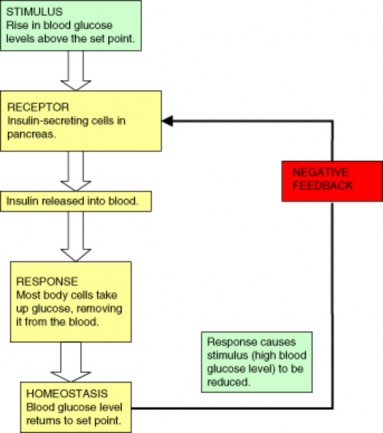
Figure 19.6: Control of blood glucose level is an example of negative feedback. Blood glucose concentration rises after a meal (the stimulus). The hormone insulin is released by the pancreas, and it speeds up the transport of glucose from the blood and into selected tissues (the response). Blood glucose concentrations then decrease, which then decreases the original stimulus. The secretion of insulin into the blood is then decreased. (2)
www.ck12.org 984
by hormones secreted from the pituitary gland, a part of the endocrine system. Table 19.2 summarizes how various body systems work together to maintain homeostasis.
Main examples of homeostasis in mammals are as follows:
The regulation of the amounts of water and minerals in the body. This is known as osmoregulation. This happens primarily in the kidneys.
The removal of metabolic waste. This is known as excretion. This is done by the excretory organs such as the kidneys and lungs.
The regulation of body temperature. This is mainly done by the skin.
The regulation of blood glucose level. This is mainly done by the liver and the insulin and glucagon secreted by the pancreas in the body.
Table 19.2: Types of Homeostatic Regulation in the Body

Osmoregulation (also called excre- tion)
Homeostatic Pro- cesses

Excess water, salts, and urea expelled from body
Hormones and Other Messengers
Antidiuretic hor- mone (ADH), aldosterone, an- giotensin II, carbon dioxide
Tissues, Organs and Organ Systems In- volved
Kidneys, urinary
bladder, ureters,
urethra (urinary system), pituitary gland (endocrine system), lungs (respiratory system)
Thermoregulation Sweating, shivering,
dilation/constriction of blood vessels at skin surface, insu- lation by adipose tissue, breakdown of adipose tissue to produce heat
Nerve impulses Skeletal muscle
(muscular system), nerves (nervous system), blood vessels (cardiovas- cular system), skin and adipose tissue (integumentary sys- tem), hypothalamus (endocrine system)
985 www.ck12.org
Table 19.2: (continued)

Chemical Regu- lation (including glucoregulation)
Homeostatic Pro- cesses

Release of insulin and glucagon into the blood in re- sponse to rising and falling blood glucose levels, respectively; increase in breathing rate in response to increases carbon dioxide levels in the blood, and release of carbon dioxide into exhaled air from lungs, secretion of erythropoietin by kidneys to stimulate formation of red blood cells
Hormones and Other Messengers
Insulin, glucagon, cortisol, carbon
dioxide, nerve impulses, erythro- poietin (EPO)
Tissues, Organs and Organ Systems In- volved
Pancreas (endocrine system), liver (di- gestive system); adrenal glands (en- docrine system) lungs (respiratory system), brain (nervous system), kidneys (urinary system)

Endocrine System
The endocrine system, shown in Figure 20.39, includes glands which secrete hormones into the bloodstream. Hormones are chemical messenger molecules that are made by cells in one part of the body and cause changes in cells in another part of the body. The endocrine system regulates the metabolism and development of most body cells and body systems through feedback mechanisms. For example, Thyrotropin-Releasing Hormone (TRH) and Thyroid Stimulating Hormone (TSH) are controlled by a number of negative feedback mechanisms. The endocrine glands also release hormones that affect skin and hair color, appetite, and secondary sex characteristics of males and females.
The endocrine system has a regulatory effect on other organ systems in the human body. In the muscular system, hormones adjust muscle metabolism, energy production, and growth. In the nervous system, hormones affect neural metabolism, regulate fluid and ion concentra- tion and help with reproductive hormones that influence brain development.
www.ck12.org 986

Figure 19.7: The endocrine system controls almost every other body system through feedback mechanisms. Most of the mechanisms of the endocrine system are negative feedback. (6)
987 www.ck12.org
Urinary System
Toxic wastes build up in the blood as proteins and nucleic acids are broken down and used by the body. The urinary system rids the body of these wastes. The urinary system is also directly involved in maintaining proper blood volume. The kidneys also play an important role in maintaining the correct salt and water content of the body. External changes, such as a warm weather, that lead to excess fluid loss trigger feedback mechanisms that act to maintain the body’s fluid content by inhibiting fluid loss. The kidneys also produce a hormone called erythropoietin, also known as EPO, which stimulates red blood cell production.
Reproductive System
The reproductive system does little for the homeostasis of the organism. The reproductive system relates instead to the maintenance of the species. However, sex hormones do have an effect on other body systems, and an imbalance in sex hormones can lead to various disorders. For example, a woman whose ovaries are removed early in life is at higher risk of developing osteoporosis, a disorder in which bones are thin and break easily. The hormone estrogen, produced by the ovaries, is important for bone growth. Therefore, a woman who does not produce estrogen will have impaired bone development.
Disruption of Homeostasis
Many homeostatic mechanisms keep the internal environment within certain limits (or set points). When the cells in your body do not work correctly, homeostatic balance is disrupted. Homeostatic imbalance may lead to a state of disease. Disease and cellular malfunction can be caused in two basic ways: by deficiency (cells not getting all they need) or toxicity (cells being poisoned by things they do not need). When homeostasis is interrupted, your body can correct or worsen the problem, based on certain influences. In addition to inherited (genetic) influences, there are external influences that are based on lifestyle choices and environmental exposure. These factors together influence the body’s ability to maintain homeostatic bal- ance. The endocrine system of a person with diabetes has difficulty maintaining the correct blood glucose level. A diabetic needs to check their blood glucose levels many times during the day, as shown in Figure 19.8, and monitor daily sugar intake.
Internal Influences: Heredity
Genetics: Genes are sometimes turned off or on due to external factors which we have some control over. Other times, little can be done to prevent the development of certain genetic diseases and disorders. In such cases, medicines can help a person’s body regain homeostasis. An example is the metabolic disorder Type 1 diabetes, which is a disorder where the pancreas is no longer producing adequate amounts of insulin to respond to changes in a person’s blood
www.ck12.org 988

Figure 19.8: A person with diabetes has to monitor their blood glucose carefully. This glucose meter analyses only a small drop of blood. For an animation of diabetes Diabetes Cause and Effect, see (http://video.google.com/videoplay?docid=6553371894741533041&# 38;ei=Q4k6SoTVJIGEqAOK0fj_Aw&q=diabetes&hl=en&client=safari). (1)
glucose level. Insulin replacement therapy, in conjunction with carbohydrate counting and careful monitoring of blood glucose concentration, is a way to bring the body’s handling of glucose back into balance. Cancer can be genetically inherited or be due to a mutation caused by exposure to toxin such as radiation or harmful drugs. A person may also inherit a predisposition to develop a disease such as heart disease. Such diseases can be delayed or prevented if the person eats nutritious food, has regular physical activity, and does not smoke.
External Influences: Lifestyle
Nutrition: If your diet lacks certain vitamins or minerals your cells will function poorly, and you may be at risk to develop a disease. For example, a menstruating woman with inadequate dietary intake of iron will become anemic. Hemoglobin, the molecule that enables red blood cells to transport oxygen, requires iron. Therefore, the blood of an anemic woman will have reduced oxygen-carrying capacity. In mild cases symptoms may be vague (e.g. fatigue), but if the anemia is severe the body will try to compensate by increasing cardiac output, leading to weakness, irregular heartbeats and in serious cases, heart failure.
Physical Activity: Physical activity is essential for proper functioning of our cells and bodies. Adequate rest and regular physical activity are examples of activities that influence homeostasis. Lack of sleep is related to a number of health problems such as irregular
989 www.ck12.org
heartbeat, fatigue, anxiety, and headaches. Being overweight and obesity, two conditions that are related to poor nutrition and lack of physical activity greatly affect many organ systems and their homeostatic mechanisms. Being overweight or obese increases a person’s risk of developing heart disease, Type 2 diabetes, and certain forms of cancer. Staying fit by regularly taking part in aerobic activities such as walking, shown in Figure 19.9, has been shown to help prevent many of these diseases.

Figure 19.9: Adding physical activity to your routine can be as simple as walking for a total of 60 minutes a day, five times a week. (7)
Mental Health: Your physical health and mental health are inseparable. Our emotions cause chemical changes in our bodies that have various effects on our thoughts and feelings. Negative stress (also called distress) can negatively affect mental health. Regular physical activity has been shown to improve mental and physical wellbeing, and helps people to cope with distress. Among other things, regular physical activity increases the ability of the cardiovascular system to deliver oxygen to body cells, including the brain cells. Medications that may help balance the amount of certain mood-altering chemicals within the brain are often prescribed to people who have mental and mood disorders. This is an example of medical help in stabilizing a disruption in homeostasis.
Environmental Exposure
Any substance that interferes with cellular function and causes cellular malfunction is a cellular toxin. There are many different sources of toxins, for example, natural or synthetic drugs, plants, and animal bites. Air pollution, another form of environmental exposure to toxins is shown in Figure 19.10. A commonly seen example of an exposure to cellular toxins is by a drug overdose. When a person takes too much of a drug that affects the central
www.ck12.org 990
nervous system, basic life functions such as breathing and heartbeat are disrupted. Such disruptions can results in coma, brain damage, and even death.
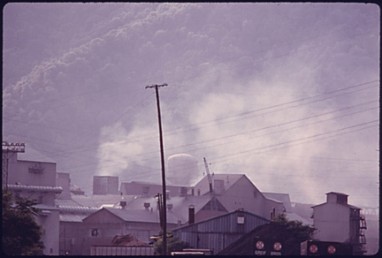
Figure 19.10: Air pollution can cause environmental exposure to cellular toxins such as mercury. (8)
The six factors described above have their effects at the cellular level. A deficiency or lack of beneficial pathways, whether caused by an internal or external influence, will almost always result in a harmful change in homeostasis. Too much toxicity also causes homeostatic imbalance, resulting in cellular malfunction. By removing negative health influences and providing adequate positive health influences, your body is better able to self-regulate and self-repair, which maintains homeostasis.
Lesson Summary
Homeostasis is an organism’s ability to maintain a stable internal environment. Home- ostasis is an important characteristic of living things. Keeping a stable internal en- vironment requires constant adjustments as conditions change inside and outside the cell.
Feedback regulation mechanisms are important to homeostasis. Feedback regulation occurs when the response to a stimulus has an effect of some kind on the original stimulus. The type of response (increase or decrease in the stimulus) determines what the feedback is called.
Negative feedback occurs when the response to a stimulus reduces the original stimulus. Positive feedback occurs when the response to a stimulus increases the original stimulus.
No system of the body works in isolation, and the well-being of a person depends upon the well-being of all the interacting body systems. A disruption within one system generally has consequences for several additional body systems.
991 www.ck12.org
The homeostatic balance of most organs and organ systems is controlled by hormones secreted from the pituitary gland, a part of the endocrine system.
When the cells in your body do not work correctly, homeostatic balance is disrupted. Homeostatic imbalance may lead to a state of disease. Type 2 diabetes is a disease in which homeostasis of the blood glucose level is disturbed, leading to an imbalance that affect many other body systems, including the cardiovascular system.
Review Questions
Outline the importance of homeostasis to an organism.
How do feedback mechanisms help maintain homeostasis?
What is the difference between negative and positive feedback?
Identify and give an example of two organ systems working together to maintain home- ostasis.
Summarize the role of the endocrine system in homeostasis.
Name two diseases that can result from an imbalance in body homeostasis.
Why is positive feedback not an effective way of controlling hormone levels?
Further Reading / Supplemental Links
Ostrom, K.M., Department of Nutritional Sciences, University of Connecticut, Storrs.
A review of the hormone prolactin during lactation.Prog Food Nutr Sci. 1990; 14(1):1- 43.
Anatomy and Physiology © 2002 by Elaine N. Marieb. Published by Benjamin Cum- mings.
http://www.medscape.com/medline/abstract/2092340
http://www.cotc.edu/ebrisker/PDF%20files/49%206%20endocrine%20LECTURE.pdf
http://en.wikibooks.org/wiki/Human_Physiology
http://www.ncbi.nlm.nih.gov/About/primer/genetics_cell.html
http://www.health.gov/dietaryguidelines/
http://en.wikipedia.org
Vocabulary
homeostasis Stability, balance, or equilibrium within the cell or a body; an organism’s ability to keep a constant internal environment.
negative feedback Occurs when the response to a stimulus reduces the original stimulus.
positive feedback Occurs when the response to a stimulus increases the original stimulus. www.ck12.org 992
Points to Consider
Negative feedback is most common feedback loop in biological systems. The system acts to reverse the direction of change. Positive feedback is less common in biological systems. The system acts to speed up the direction of change. Consider how your social interactions with teachers, parents and other students may be classified as either positive or negative feedback.
When homeostasis is interrupted, your body can correct or worsen the problem, based on certain influences. In addition to genetic influences, there are external influences that are based on lifestyle choices and environmental exposures. Describe how your lifestyle may positively or negatively affect your body’s ability to maintain homeostasis
Image Sources
http://commons.wikimedia.org/wiki/File:Glucose_test.JPG. CC-BY-SA.
Niamh Gray-Wilson. . CC-BY-CA.
http://en.wikipedia.org/wiki/Image: Human_embryonic_stem_cell_colony_phase.jpg. Public Domain.
http://remf.dartmouth.edu/images/mammalianLungSEM/source/9.html. Public Domain.
http://en.wikipedia.org/wiki/Image: Stem_cell_division_and_differentiation.svg. Public Domain.
USFG. http://commons.wikimedia.org/wiki/File:Illu_endocrine_system.png. Public Domain.
Jame. http://www.flickr.com/photos/jamehealy/461578738/. CC-SA-BY 2.0.
http://www.flickr.com/photos/pingnews/450243814/. Public Domain.
Drs. Noguchi, Rodgers, and Schechter of NIDDK. http://remf.dartmouth.edu/images/humanMuscleTEM/source/2.html http://commons.wikimedia.org/wiki/Image:Redbloodcells.jpg. (a) Public Domain (b) Public Domain (d) Public Domain.
http://upload.wikimedia.org/wikipedia/commons/3/34/Skin.jpg. Public Domain.
993 www.ck12.org
www.ck12.org 994
Nervous and Endocrine Systems
Lesson 20.1: The Nervous System
Lesson Objectives
Identify the type of cells that make up nervous tissue.
Describe the structure of a neuron.
Relate membrane potential to action potential.
Outline the role of neurotransmitters in neuron communication.
Distinguish between the sensory and motor divisions of the peripheral nervous system.
Describe the structure of the eye and identify the roles of rods and cones in vision.
Describe the structure of the ear and identify the structures that are important to hearing and balance.
Distinguish between the receptors for pain, pressure, and temperature.
Identify the main effect of psychoactive drugs on the CNS.
Summarize the mechanism of addiction.
Introduction
Your body has two systems that help you maintain homeostasis: the nervous system and the endocrine system. The nervous system is a complex network of nervous tissue that sends electrical and chemical signals. The nervous system includes the central nervous system (CNS) and the peripheral nervous system (PNS) together. The central nervous system is made up of the brain and spinal cord, and the peripheral nervous system is made up of the nervous tissue that lies outside the CNS, such as the nerves in the legs, arms, hands, feet and organs of the body. The nervous system mediates communication between different parts of the body as well as the body’s interactions with the environment.
995 www.ck12.org
The endocrine system is a system of glands around the body that release chemical signal molecules into the bloodstream. The electrical signals of the nervous system move very rapidly along nervous tissue, while the chemical signals of the endocrine system act slowly in comparison and over a longer period of time. Working together, the nervous and endocrine systems allow your body to respond to short or long term changes in your environment, such as a pedestrian suddenly stepping out in front of your bike, or your body adapting to cycling in a warm, humid summer evening, as shown in Figure 20.1.
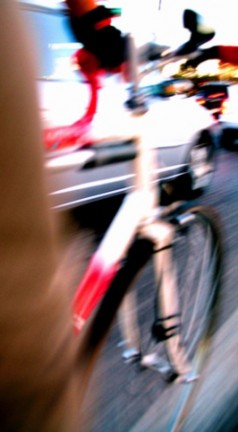
Figure 20.1: Cycling home in rush-hour traffic demands a lot of your nervous and endocrine systems. Your nervous system—mostly through your eyes and ears—constantly monitors your surroundings, alerting you instantly at any sign of change or danger. Your endocrine system gears up your muscles and cardiovascular system for the ride, by flooding your body with metabolism-boosting hormones. (35)
Nerve Cells
Although the nervous system is very complex, there are only two main types of nerve cells in nervous tissue. All parts of the nervous system are made of nervous tissue. The neuron
www.ck12.org 996
is the ”conducting” cell that transmits electrical signals, and it is the structural unit of the nervous system. The other type of cell is a glial cell. Glial cells provide a support system for the neurons, and recent research has discovered they are involved in synapse formation. A type of glial cell in the brain, called astrocytes, is important for the maturation of neurons and may be involved in repairing damaged nervous tissue. Neurons and glial cells make up most of the brain, the spinal cord and the nerves that branch out to every part of the body. Both neurons and glial cells are sometimes referred to as nerve cells.
Structure of a Neuron
The special shape of a neuron allows it to pass an electrical signal to another neuron, and to other cells. Electrical signals move rapidly along neurons so that they can quickly pass “messages” from one part of the body to another. These electrical signals are called nerve impulses.
Neurons are typically made up of a cell body (or soma), dendrites, and an axon, as shown in Figure 20.2. The cell body contains the nucleus and other organelles similar to other body cells. The dendrites extend from the cell body and receive a nerve impulse from another cell. The cell body collects information from the dendrites and passes it along to the axon. The axon is a long, membrane-bound extension of the cell body that passes the nerve impulse onto the next cell. The end of the axon is called the axon terminal. The axon terminal is the point at which the neuron communicates with the next cell. You can say the dendrites of the neuron receive the information, the cell body gathers it, and the axons pass the information onto another cell.
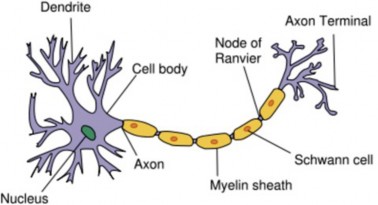
Figure 20.2: The general structure of a neuron. Neurons come in many different shapes and sizes, but they all have a cell body, dendrites, and an axon. The cell body contains a nucleus and other organelles. However, not all neurons have a myelin sheath. (31)
The axons of many neurons are covered with an electrically insulating phospholipid layer called a myelin sheath. The myelin speeds up the transmission of a nerve impulse along
997 www.ck12.org
the axon. It acts like a layer of insulation, like the plastic you would see around an electrical cord.
The myelin is an outgrowth of glial cells. Schwann cells which are shown wrapped around the neuron in Figure 20.2, are a type of glial cell. Schwann cells are flat and thin, and like other cells, contain a nucleus and other organelles. Schwann cells supply the myelin for neurons that are not part of the brain or spinal cord, while another type of glial cell, called oligodendrocytes, supply myelin to those of the brain and spinal cord. Myelinated neurons are white in appearance, and they are what makes up the ”white matter” of the brain. A cross section of a myelinated neuron is shown in Figure 20.3. Myelin is not continuous along the axon. The regularly spaced gaps between the myelin are called Nodes of Ranvier. The nodes are the only points at which ions can move across the axon membrane, through ion channels. In this way the nodes act to strengthen the nerve impulse by concentrating the flow of ions at the nodes of Ranvier along the axon.
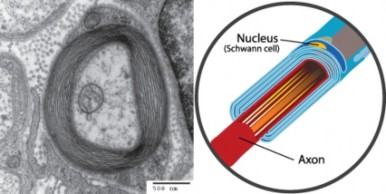
Figure 20.3: A transmission electron microscope (TEM), image of a cross section of a myeli- nated axon. The “rings” around the axon are made up of Schwann cell membrane, which is wrapped many times around the axon. (56)
Neurons are specialized for the passing of cell signals. Given the many functions carried out by neurons in different parts of the nervous system, there are many different of shapes and sizes of neurons. For example, the cell body of a neuron can vary from 4 to 100 micrometers in diameter. Some neurons can have over 1,000 dendrite branches, which make connections with tens of thousands of other cells. Other neurons have only 1 or 2 dendrites, each of which has thousands of synapses. A synapse is a specialized junction at which neurons communicate with each other, and is shown in Figure 20.4. Also, a neuron may have 1 or many axons. The longest axon of a human motor neuron can be over a meter long, reaching from the base of the spine to the toes. Sensory neurons have axons that run from the toes to the spinal cord, over 1.5 meters in adults. Giraffes have single axons several meters in length running along the entire length of their necks.
www.ck12.org 998
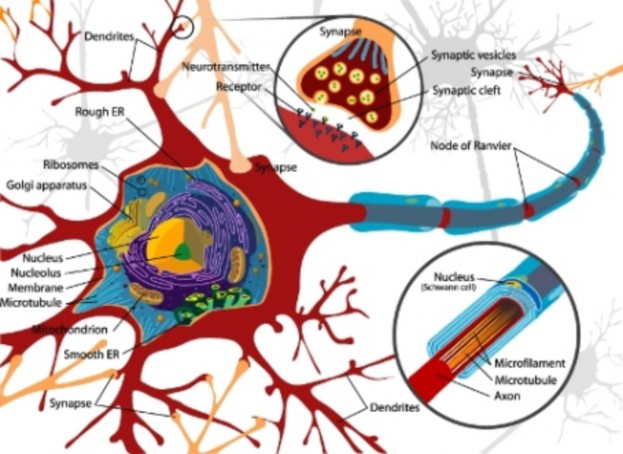
Figure 20.4: The location of synapses. Synapses are found at the end of the axons (called axon terminals) and help connect a single neuron to thousands of other neurons. Chemical messages called neurotransmitters are released at the synapse and pass the “message” onto the next neuron or other type of cell. (27)
999 www.ck12.org
Nerve Impulses
In the late 18th century, the Italian doctor and physicist Luigi Galvani first recorded the action of electricity on the muscle tissue of frogs. He noted that an electrical charge applied to a nerve in the legs of a dead frog made the legs move. Galvani attributed the movement of the frog’s muscles to an electrical current that was carried by the nerves. Galvani coined the term ”animal electricity” to describe this vital force for life.
Galvani believed that animal electricity came from the muscle and was unique to living creatures. However, his fellow Italian, and physicist, Alessandro Volta disagreed with him and reasoned that animal electricity was a physical phenomenon, that occurred between metals. Volta disproved Galvani’s claim by building the first battery, which showed that a current could flow outside an organism’s body. Since then scientists have learned much about electrical charges in living systems.
Ion Channels and Nerve Impulses
Ion transport proteins have a special role in the nervous systems because voltage-gated ion channels and ion pumps are essential for forming a nerve impulse. Ion channels use energy to build and maintain a concentration gradient of ions between the extracellular fluid and the cell’s cytosol, as shown in Figure 20.5. This concentration gradient results in a net negative charge on the inside of the membrane and a positive charge on the outside. Ion channels and ion pumps are very specific; they allow only certain ions through the cell membrane. For example, potassium channels will allow only potassium ions through, and the sodium-potassium pump acts only on sodium and potassium ions.
All cells have an electrical charge which is due to the concentration gradient of ions that exists across the membrane. The number of positively charged ions outside the cell membrane is greater than the number of positively charged ions in the cytosol. This difference causes a voltage difference across the membrane. Voltage is electrical potential energy that is caused by a separation of opposite charges, in this case across the membrane. The voltage across a membrane is called membrane potential. Membrane potential is the basis for the conduction of nerve impulses along the cell membrane of neurons. Ions that are important in the formation of a nerve impulse include sodium (Na+) and potassium (K+).
Resting Potential
When a neuron is not conducting a nerve impulse, it is said to be at rest. The resting potential is the resting state of the neuron, during which the neuron has an overall negative charge. In neurons the resting potential is approximately -70 milliVolts (mV). The negative sign indicates the negative charge inside the cell relative to the outside.
The reasons for the overall negative charge of the cell include: www.ck12.org 1000

Figure 20.5: Channel proteins in the plasma membrane. Membrane channel proteins (or channel proteins), allow the movement of specific ions across the cell membrane, in this case the hypothetical “X” ion. The concentration gradient results in electrical potential energy building up across the membrane, the basis for the conduction of a nerve impulse. (39)
The sodium-potassium pump removes Na+ ions from the cell by active transport. A net negative charge inside the cell is due to the higher concentration of Na+ ions outside the cell than inside the cell.
Most cells have potassium-selective ion channel proteins that remain open all the time. The K+ ions move down the concentration gradient (passively) through these potassium channels and out of the cell, which results in a build-up of excess positive charge outside of the cell.
There are a number of large, negatively charged molecules, such as proteins, inside the cell.
Action Potential
An action potential is an electrical charge that travels along the membrane of a neuron. It can be generated when a neuron’s membrane potential is changed by chemical signals from a nearby cell. In an action potential, the cell membrane potential changes quickly from negative to positive as sodium ions flow into and potassium ions flow out of the cell through ion channels, as shown in Figure 20.6.
The change in membrane potential results in the cell becoming depolarized. An action potential works on an all-or-nothing basis. That is, the membrane potential has to reach a certain level of depolarization, called the threshold, otherwise an action potential will not start. This threshold potential varies, but is generally about 15 millivolts (mV) more positive than the cell’s resting membrane potential. If a membrane depolarization does not reach the threshold level, an action potential will not happen. You can see in Figure 20.7 how two depolarizations did not reach the threshold level of -55mV. The first channels to open are the sodium ion-channels, which allow sodium ions to enter the cell. The resulting increase in
1001 www.ck12.org
positive charge inside the cell (up to about +40 mV) starts the action potential. Potassium ion-channels then open up, allowing potassium ions out of the cell, which ends the action potential. Both of the ion channels then close, and the sodium-potassium pump restores the resting potential of -70 mV. The action potential will move down the axon toward the synapse like a wave would move along the surface of water.
In myelinated neurons, ion flows occur only at the nodes of Ranvier. As a result, the action potential signal ”jumps” along the axon membrane, from node to node, rather than spreading smoothly along the membrane, as they do in axons that do not have a myelin sheath. This is due to clustering of Na+ and K+ ion channels at the Nodes of Ranvier. Unmyelinated axons do not have Nodes of Ranvier; and ion channels in these axons are spread over the entire membrane surface.
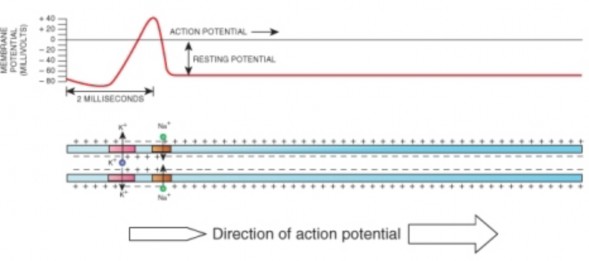
Figure 20.6: The movement of an action potential down an axon. A chemical message from another nerve causes the sodium ion channels at one point in the axon to open. Sodium ions rush across the membrane and cause the interior of the axon to become positively charged (depolarized) because the cell now contains more positive charges. Potassium ion channels then open and potassium ions flow out of the cell, which end the action potential. The action potential then moves down the axon membrane toward the synapse. (38)
Types of Neurons
Neurons are highly specialized for the processing and transmission of cellular signals and can be classified by their structure or function. Structural classification is based on the number
www.ck12.org 1002

Figure 20.7: The changes in membrane potential during an action potential. Note the failed initiations that did not start an action potential. These depolarizations did not reach the threshold level (of about -55mV), so they did not start an action potential. (52)
of dendrites and axons that a cell has. Functional classification groups neurons according to the direction in which the nerve impulse is moving in relation to the CNS.
We will discuss the three functional groups of nerves:
Sensory neurons carry signals from tissues and organs to the central nervous system and are sometimes also called afferent neurons. Sensory neurons typically have a long dendrite and short axon. Sensory neurons are found in reflex arcs and are involved in several forms of involuntary behavior, including pain avoidance.
Motor neurons carry signals from the central nervous system to muscles and glands and are sometimes called efferent neurons. Motor neurons have a long axon and short dendrites.
Interneurons connect sensory and motor neurons in neural pathways that go through the central nervous system. Interneurons are also called association or relay neurons. Interneurons are found only in the central nervous system where they connect neuron to neuron.
Communication Between Neurons
Neurons communicate with each other at specialized junctions called synapses. Synapses are also found at junctions between neurons and other cells, such as muscle cells like the one shown in Figure 20.8. To see a synapse between two neurons, refer to Figure 20.4.
1003 www.ck12.org
There are two types of synapses:
chemical synapses use chemical signaling molecules as messengers
electrical synapses use ions as messengers
We will primarily discuss chemical synapses in this chapter. The axon terminal of one neuron usually does not touch the other cell at a chemical synapse. Between the axon terminal and the receiving cell is a gap called a synaptic cleft. The transmitting cell is called the presynaptic neuron, and the receiving cell is called the postsynaptic cell or if it is another neuron, a postsynaptic neuron.
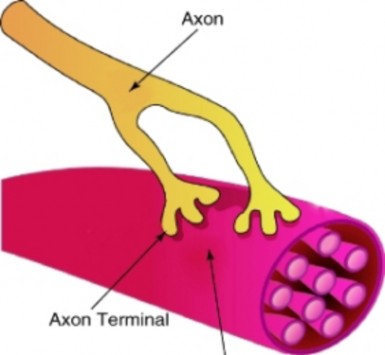
Figure 20.8: A synapse between a neuron and a muscle cell. The connection between a neuron and a muscle cell, called a neuromuscular junction. The finger-like projections of the axon are the axon terminals. An action potential moves down to the axon terminals where it causes a chemical message called a neurotransmitter to be released into the synaptic cleft. The neurotransmitter then causes an action potential to start on the membrane of the muscle cell. (29)
Your brain has a huge number of synapses. Each of your 1012 (one trillion) neurons—including glial cells—has on average 7,000 synaptic connections to other neurons. It has been esti- mated that the brain of a three-year-old child has about 1016 synapses (10 quadrillion). This number declines with age, and levels off by adulthood. An adult has between 1015 and 5 x 1015 synapses (1 to 5 quadrillion).
www.ck12.org 1004
Neurotransmitter Release
When an action potential reaches the axon terminal, it causes the neurotransmitter vesicles to fuse with the terminal membrane, and the neurotransmitter is released into the synaptic cleft. A neurotransmitter is a chemical message that is used to relay electrical signals between a neuron and another cell. Neurotransmitter molecules are made inside the presynaptic neuron and stored in vesicles at the axon terminal. Some neurons make only one type of neurotransmitter, but most neurons make two or more types of neurotransmitters.
When an action potential reaches the axon terminal, it causes the neurotransmitter vesicles to fuse with the terminal membrane. Neurotransmitter is released into the synaptic cleft. The neurotransmitters then diffuse across the synaptic cleft and bind to receptor proteins on the membrane of the postsynaptic cell, as shown in Figure 20.9.
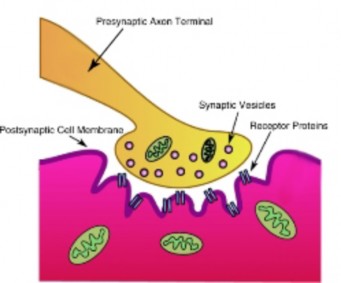
Figure 20.9: The synaptic cleft. Neurotransmitter that is released into the synaptic cleft diffuses across the synaptic membrane and binds to its receptor protein on the post synaptic cell. (47)
Neurotransmitter Action
Many types of neurotransmitters exist, a few of which are listed in Table 20.1. Neurotrans- mitters can have an excitatory or inhibitory effect on the postsynaptic cell. An excitatory neurotransmitter initiates an action potential and an inhibitory neurotransmitter prevents
1005 www.ck12.org
one from starting. Glutamate is the most common excitatory transmitter in the body while GABA and glycine are inhibitory neurotransmitters. The release of acetylcholine, an exci- tatory neurotransmitter causes an inflow of positively charged sodium ions (Na+) into the postsynaptic neuron. This inflow of positive charge causes a depolarization of the mem- brane at that point. The depolarization then spreads to the rest of the postsynaptic neuron. Acetylcholine is the neurotransmitter that initiates muscle movement.
The effect of a neurotransmitter also can depend on the receptor it binds to. That is, a single neurotransmitter may be excitatory to the receiving neuron, or it may inhibit such an impulse by causing a change in the membrane potential of the cell. Synapses too can be excitatory or inhibitory and will either increase or decrease activity in the target neuron, based on the opening or closing of ion channels.
Table 20.1: Common Neurotransmitters and Their Receptors

Name Receptor Name and Type Ions Involved

Glutamate (glutamic acid) Glutamate receptors
(ligand-gated ion chan- nels and G protein-coupled receptors)
Acetylcholine Acetylcholine receptors (ligand-gated ion channel)
Ca2+, K+, Na+
Na+
Norepinephrine (nora- drenaline)
Adrenoceptors (G protein- coupled receptors)
Ca2+
Epinephrine (adrenaline) Adrenoceptors (G protein-
coupled receptors)
Ca2+
Serotonin (5-
hydroxytryptamine)
Gamma-aminobutyric acid (GABA)
5-HT receptors 5-HT3 is a ligand-gated ion channel
5-HT1, 5-HT2, 5-HT4, 5-
HT5A, 5-HT7 are G protein- coupled receptors
GABAA and GABAC
(ligand-gated ion channels) GABAB (G protein-coupled receptors)
K+, Na+
Cl- K+
Histamine Histamine receptors (H1, H2, H3, H4) (G protein- coupled receptors)

Neurotransmitter receptors can be gated ion channels that open or close through neuro- transmitter binding or they can be protein-linked receptors. Protein-linked receptors are
www.ck12.org 1006
not ion channels; instead they cause a signal transduction that involves enzymes and other molecules (called second messengers) in the postsynaptic cell. Refer to the Cell Structure and Function chapter for more information about signal transduction mechanisms.
Neurotransmitter Reuptake
Many neurotransmitters are removed from the synaptic cleft by neurotransmitter trans- porters in a process called reuptake. Reuptake is the removal of a neurotransmitter from the synapse by the pre-synaptic neuron. Reuptake happens after the neurotransmitter has transmitted a nerve impulse. Without reuptake, the neurotransmitter molecules might con- tinue to stimulate or inhibit an action potential in the post-synaptic neuron. The process of release and reuptake of neurotransmitters is shown in Figure 20.10.

Figure 20.10: A synapse before and during reuptake. Neurotransmitter transporter proteins (also called reuptake pumps) release the neurotransmitter and also reuptake it from the synaptic cleft. Reuptake is a way of controlling the effect the neurotransmitter has on the post-synaptic cell. (54)
Re-uptake is carried out by transporter proteins which bind to the released transmitter and actively transport it across the plasma membrane into the pre-synaptic neuron. The reuptake of neurotransmitter is the target of some types of medicine. For example, serotonin is a neurotransmitter that is produced by neurons in the brain. Serotonin is believed to
1007 www.ck12.org
play an important role in the regulation of mood, emotions, and appetite. After release into the synaptic cleft, serotonin molecules either attach to the serotonin receptors (called 5-HT receptors) of the post-synaptic neuron, or they attach to receptors on the surface of the presynaptic neuron that produced the serotonin molecules, for reuptake. Reuptake is a form of recycling because the neuron takes back the released neurotransmitter for later use. Medicines called selective serotonin reuptake inhibitors (SSRIs) block the reuptake of the neurotransmitter serotonin. This blocking action increases the amount of serotonin in the synaptic cleft, which prolongs the effect of the serotonin on the postsynaptic neuron. Some scientists hypothesize that decreased levels of serotonin in the brain are linked to clinical depression and other mental illnesses. So SSRI medications such as sertraline and fluoxetine are often prescribed for depression and anxiety disorders.
Another way that a neurotransmitter is removed from a synapse is digestion by an enzyme. At cholinergic synapses (where acetylcholine is the neurotransmitter), the enzyme acetyl- cholinesterase breaks down the acetylcholine.
Neurotransmitters and Disease
Diseases that affect nerve communication can have serious consequences. A person with Parkinson’s disease has a deficiency of the neurotransmitter dopamine. Progressive death of brain cells that produce dopamine increases this deficit, which causes tremors, and a stiff, unstable posture. L-dopa is a chemical related to dopamine that when given as a medicine, eases some of the symptoms of Parkinson’s disease. The L-dopa acts as a substitute neurotransmitter, but it cannot reverse the disease.
The soil bacterium Clostridium tetani produces a neurotoxin that causes the disease tetanus. The bacteria usually get into the body through an injury caused by an object that is contam- inated with C. tetani spores, such as a puncture wound caused by stepping on a nail. The
C. tetani neurotoxin blocks the release of the neurotransmitter GABA, which causes skeletal
muscles to relax after contraction. When the release of GABA is blocked, the muscle tissue does not relax and remains contracted. Tetanus can be fatal when it affects the muscles used in breathing. Thankfully, tetanus is treatable and can be prevented by vaccination.
Another bacterium called Clostridium botulinum produces a toxin that is occasionally found in preserved foods that have been improperly sterilized. The toxin causes a disease called botulism. Botulin toxin blocks the release of the excitatory neurotransmitter acetylcholine. Blockage of acetylcholine causes the progressive relaxation of muscles because they are unable to contract. Paralysis of the muscles used for breathing can be fatal unless the patient is treated with a respirator.
www.ck12.org 1008
Synapses and Recent Research
Recent studies have found that electrical synapses are more common in the central nervous system than were previously thought. An electrical synapse is a link between two neighboring neurons that is formed at a narrow gap between the pre- and postsynaptic cells called a gap junction. At gap junctions, cells are about 3.5 nm from each other, a much shorter distance than the 20 to 40 nm distance that separates cells at chemical synapses.
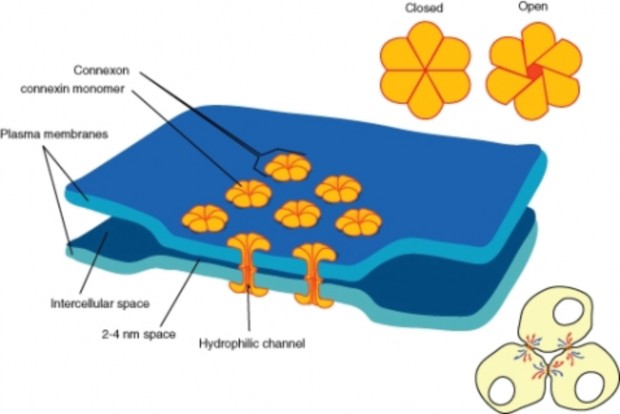
Figure 20.11: Electrical synapses. Electrical synapses are more common in the nervous system than was once thought. Cell signaling at electrical synapses is much faster than signaling at chemical synapses. The image at the bottom left of the figure shows the location of gap junctions between cells. (50)
Each gap junction has many channels which cross the plasma membranes of both cells, as is shown in Figure 20.11. Gap junction channels are wide enough to allow ions and even medium sized molecules like signaling molecules to flow from one cell to the next. For example, when positive ions move through the channel into the next cell, the extra positive charges depolarize the postsynaptic cell.
Signaling at electrical synapses is faster than the chemical signaling that occurs across chem- ical synapses. Ions directly depolarize the cell without the need for receptors to recognize
1009 www.ck12.org
chemical messengers, which occurs at chemical synapses. Such fast communication between neurons may indicate that in some parts of the brain large groups of neurons can work as a single unit to process information. Electrical synapses are numerous in the retina and cerebral cortex.
In addition to neurons, glial cells are an important part of the nervous system. The word glia means ”glue” in Greek. Glial cells can be thought of as partners to neurons by aiding in the maintenance of homeostasis, signal transduction, formation of myelin and providing support and nutrition. The importance of neurons as the conductive cells of the nervous system, known as the neuron doctrine, has been questioned by recent research. The role of glial cells in processing neural information has begun to be appreciated more. There are far more glial cells than neurons, it has been estimated that glial cells outnumber neurons by as many as 50:1.
Central Nervous System
The central nervous system (CNS), which includes the brain and the spinal cord, shown in Figure 20.12, represents the largest part of the nervous system. The brain is the central control of the nervous system. The spinal cord carries nerve impulses from the brain to the body and from the body to the brain. Together with the peripheral nervous system (PNS), which includes all nervous tissue outside of the central nervous system, it controls virtually every activity in the body. The brain is protected by the skull and the spinal cord is protected by the vertebrae. An overview of the CNS can be viewed at http://vimeo.com/2024719.
The Brain
The brain is the most complex organ in the body. The brain contains about 100 billion neurons each of which can be connected to tens of thousands of other neurons within the brain. The brain is the source of what makes us human; the conscious mind. The mind is the set of cognitive processes related to perception, interpretation, imagination, memories, and language. Beyond cognitive functions, the brain regulates processes related to homeostasis such as respiration and heartbeat. An average adult human brain weighs between 1 and 1.5 kg (3 lb). An adult brain uses about 20-25% of the total energy used by the body, while the developing brain of an infant consumes around 60% of total energy used by the body.
The brain can be classified by the processes its different parts control. The cerebrum gener- ally controls conscious functions such as problem-solving and speech, while the midbrain and the brain stem are more involved with unconscious (autonomic) functions such as breath- ing, heartbeat, and temperature regulation. The cerebellum is involved in coordination and control of body movement. For a video of ”Brain Basics,” see http://www.teachers.tv/ video/13838.
www.ck12.org 1010

Figure 20.12: The components of the central nervous system (CNS). (28)
1011 www.ck12.org
Cerebrum
The cerebrum is what most people would think of as the ”brain.” The cerebrum lies on top of the brainstem. It is made up of two cerebral hemispheres, which are shown in Figure
20.13. The two cerebral hemispheres are connected to each other at the corpus callosum, the light-colored X-shaped structure in the center of the image. The corpus callosum is a wide, flat bundle of axons found deep inside the brain. Mammals (including humans), have the largest and most well-developed cerebrum among all species.

Figure 20.13: A magnetic resonance image (MRI) of the human brain in which the two hemispheres of the cerebrum can be seen. (24)
Each hemisphere of the cerebrum can be divided into four parts, or lobes. These are: the frontal lobe, the parietal lobe, the temporal lobe, and occipital lobe. Researchers have identified a number of functional areas within each lobe, some of which are listed in Table
Both hemispheres look identical, but there are functional differences between them. For example, there are differences between the centers of function for spatial awareness between right and left-handed people. Each cerebral hemisphere receives sensory information and controls muscle movements of the opposite side of the body. The right hemisphere controls the left side of the body, and the left hemisphere controls the right side of the body.
Table 20.2: Functions Controlled by the Cerebral Lobes

Lobe Functions

Frontal Speech, intellectual function (reasoning, ab- stract thought), touch
Parietal Speech, taste, reading
www.ck12.org 1012
Table 20.2: (continued)

Lobe Functions

Temporal Hearing, smell
Occipital Vision

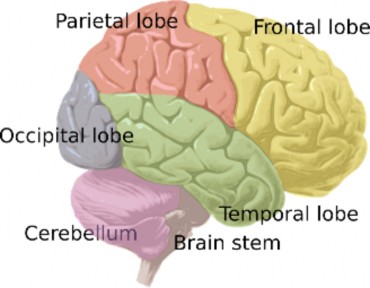
Figure 20.14: The lobes of the cerebral cortex-frontal, temporal, occipital, and parietal. The cerebellum (purple) and brain stem (gray) are not part of the hindbrain. In vertebrates, a gross division into three major parts is used. (32)
The cerebral cortex is the highly-folded outer layer of the cerebrum that is between 2 mm and 4 mm thick. The lobes that make up the cerebral cortex, shown in Figure 20.14, are named after the skull bones that cover those areas of the brain. The many folds in the cortex allow for the large surface area of the brain to fit inside the skull. The cerebral cortex controls higher functions, such as consciousness, reasoning, emotions, and language. It also controls sensory functions such as touch, taste, smell, and responses to external stimuli. In the cerebrum, and found below the cerebral cortex, is the white matter. White matter is made up of myelinated axons that act as “cables” that link up certain parts of the right and left hemispheres.
1013 www.ck12.org
Diencephalon
The diencephalon is the region of the brain that includes structures such as the thala- mus, the hypothalamus, and a portion of the pituitary gland. The thalamus is believed to “translate” sensory signals for the cerebral cortex. The thalamus also plays an important role in regulating states of sleep and wakefulness. The hypothalamus gland controls cer- tain metabolic processes and other autonomic activities such as body temperature, hunger, thirst, and circadian cycles. The hypothalamus also makes and releases neurotransmitters that control the action of the pituitary gland. The thalamus, hypothalamus, and hippocam- pus together are considered part of a set of structures called the limbic system. The limbic system is considered the “emotional center” of the brain.
Brain Stem
Sometimes called the “lower brain,” the brain stem is the lower part of the brain that is joined to the spinal cord. There are three parts to the brainstem: the midbrain, the pons, and the medulla oblongata, shown in Figure 15. The midbrain is more involved with unconscious, autonomic functions. The midbrain deals with several types of sensory information including sound and sight. It also “translates” sensory information to be sent to the forebrain. The brainstem also helps coordinate large body movements such as walking and running. The pons relays messages to different parts of the brain (the cerebrum and cerebellum), and helps regulate breathing. Some researchers propose that it has a role in dreaming. The medulla oblongata, also called the medulla, shares some of the function of the pons. It controls several homeostatic functions that you are usually unaware of, such as breathing, heart and blood vessel activity, swallowing, and digestion.
One of the brain stem’s most important roles is that of an “information highway.” That is, all of the information coming from the body to the brain (sensory) and the information from the cerebrum to the body (motor) go through the brain stem. Sensory pathways for such things as pain, temperature, touch, and pressure sensation go upward to the cerebrum, and motor pathways for movement and other body processes go downward to the spinal cord. Most of the axons in the motor pathway cross from one side of the CNS to the other as they pass through the medulla oblongata. As a result, the right side of the brain controls much of the movement in the left side of the body, and the left side of the brain controls much of the movement in the right side of the body.
Cerebellum
The cerebellum is found just below the occipital lobe of the cerebrum. It plays an important role in coordination and the control of body movements. Many nerve pathways link the cerebellum with motor neurons, which are neurons that send information to the muscles causing them to move, and a group of nerves that provides information on the position of
www.ck12.org 1014

Figure 20.15: The locations of the brainstem and cerebellum. The brainstem is in the center of this image. It is made up of the pons, medulla oblongata, and the midbrain. The cerebellum is the red structure to the right of the brainstem. (43)
1015 www.ck12.org
the body in space. The cerebellum processes information from both these pathways, and uses the feedback on body position to fine-tune body movements. Hand-eye coordination is an example of such a function. If the cerebellum is damaged, there will not be paralysis, but the fine movement of the body (such as hand-eye coordination), balance, posture, and the ability to learn new motor skills will be negatively affected. The cerebellum is the purple structure in Figure 20.14. A section of the cerebellum is shown in Figure 20.15.
Spinal Cord
The spinal cord is a thin, tubular bundle of nervous tissue that extends from the medulla oblongata and continues to the lower back, where it ends in a group of fibrous extensions. It is protected by the spinal vertebrae. The main function of the spinal cord is as an information superhighway that links the sensory messages from the body to the brain. The outer cortex of the cord contains white matter (myelinated sensory and motor neurons). The central region, the grey matter, is made up of unmyelinated neurons. A cross section of the spinal cord is shown in Figure 20.16.
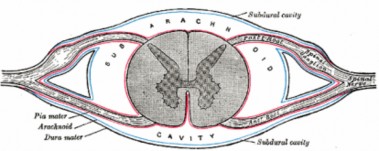
Figure 20.16: A cross section of the spinal cord. The central butterfly-shaped area is the gray matter and the area that surrounds it is the outer cortex (made up of white matter). Instructions go to the body’s muscles and other areas through the motor neurons that leave the spinal cord in the spinal nerves. Sensory information from the body enters the spinal cord through sensory neurons. (25)
Peripheral Nervous System
The peripheral nervous system (PNS) consists of the nervous tissue that lies outside the central nervous system, shown in Figure 20.17. The nervous tissue of the peripheral nervous system serves the limbs and organs. The central nervous system interacts with the peripheral nervous system through twelve pairs of cranial nerves that connect the brain to areas of the head and neck and 31 pairs of spinal nerves that connect the spinal cord (and CNS) to the rest of the body, such as the internal organs, arms, and legs. A nerve is an enclosed,
www.ck12.org 1016
cable-like bundle of axons. Unlike the central nervous system, the peripheral nervous system is not protected by bone, making it more vulnerable to toxins and injuries.
Spinal nerves originate from the spinal cord. They control functions of the rest of the body. Each spinal nerve has a dorsal root and a ventral root, which are shown in Figure 20.18. The dorsal root is the “nerve highway” that carries sensory information from sensory receptors in the body to the CNS. The ventral root contains axons of motor neurons which carry information away from the CNS to the muscles and glands of the body.
These two nerve “highways” are actually parts of two subdivisions of the PNS. The sensory division, also known as the afferent division, carries sensory information from sensory re- ceptors in the body to the CNS. The sensory division keeps the CNS constantly updated on events happening inside and outside the body. The motor division, or efferent division, carries nerve impulses from the CNS to the muscles, glands and organs of the body. The nerve impulses of the motor division cause muscles to contract and cause glands to secrete chemical signals.
Somatic and Autonomic Nervous Systems
The motor division of the peripheral nervous system is divided into the somatic nervous system and the autonomic nervous system:
The somatic nervous system is the part of the PNS that is associated with the conscious (voluntary) control of the body through the movement of skeletal muscles and the perception of external stimuli through senses such as touch, hearing, and sight. The system includes all the neurons connected with muscles, skin and sense organs. The somatic nervous system is made up of sensory nerves that receive sensory information from the external environment, and motor nerves responsible for muscle contraction.
Together with interneurons, the sensory and motor neurons are found in a reflex arc. A reflex is an automatic (involuntary) action caused by a defined stimulus and carried out through a reflex arc. For example, a person stepping on a sharp object would start the reflex action through the creation of a stimulus, (pain) within specialized pain receptors located in the skin tissue of the foot. The resulting stimulus would be passed along sensory neurons to the spinal cord. This stimulus is usually processed by an interneuron to create an immediate response to pain by initiating a motor response in the muscles of the leg which pull the foot away from the object. This reflexive action would occur as the pain sensation is arriving in the brain. A reflex arc is shown in Figure 20.19.
The autonomic nervous system (ANS) is the part of the peripheral nervous system that maintains homeostasis in the body. Your body carries out most of these maintenance activities without your conscious control, which is why the autonomic nervous system is also called the involuntary nervous system. The ANS has far reaching effects, such as the control of heart rate, digestion, respiration rate, salivation, and perspiration. Some autonomic
1017 www.ck12.org

Figure 20.17: The peripheral nervous system (PNS). The peripheral nervous system extends from the CNS and reaches out to all parts of the body, from the cranial nerves found in the head to the plantar nerves in the tips of the toes. (22)
www.ck12.org 1018

Figure 20.18: A cross section of the spinal cord. The central butterfly-shaped area (1, 2, 3) is the gray matter, the outer cortex is the white matter. Instructions going to the body’s muscles and other areas go through the motor neurons that leave the spinal cord in the ventral roots (11). Sensory information from the body enters the spinal cord through sensory neurons in the dorsal roots (12). Dorsal and ventral roots occur on both sides of the spinal cord, only one side is shown in this diagram. (3)
1019 www.ck12.org
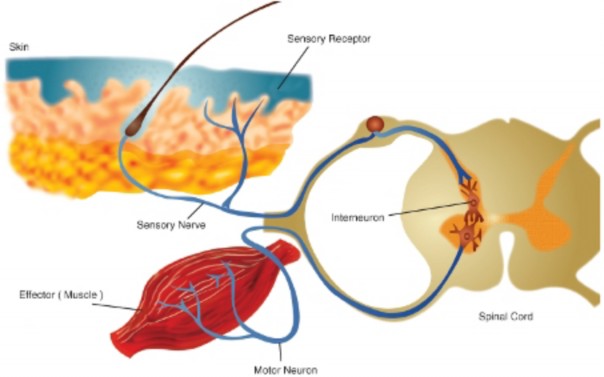
Figure 20.19: The components of a reflex. A sensory receptor that detects a stimulus and sends nerve signals to the spinal cord. These signals activate motor neurons that lead back to the effector (muscle). (33)
www.ck12.org 1020
nervous system functions work in line with the conscious mind, such as breathing.
The ANS is also made up of the sensory and motor neurons that send messages to and from the internal organs. These neurons form reflex arcs that pass through the medulla oblongata. This explains why even a person’s cerebrum may experience trauma, yet their cardiovascular, digestive and respiratory functions will continue even if higher level functions such as awareness and consciousness, are lost. Such a low level of brain functioning is referred to as a vegetative state.
The ANS has two subdivisions: the sympathetic division and parasympathetic division. The sympathetic division generally stimulates body systems during emergency situations. It gets the body ready for ”fight or flight,” which would probably be required by the situa- tion shown in Figure 20.20, while the parasympathetic division controls non-emergency functions such as digestion. The relationship between the divisions of the nervous system is illustrated in Figure 20.21.
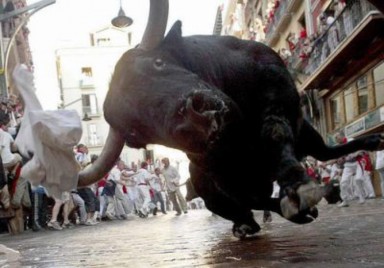
Figure 20.20: Watch out! A situation in which your sympathetic nervous system (and hopefully your somatic nervous system), would be firing at full speed. (21)
Sense Organs and Sensory Perception
Your senses are your body’s means of making sense of the information your nervous system receives from inside your body and from the outside world. Your senses enable you to adapt to change in your environment and survive. The sensory division of the peripheral nervous system is organized into highly developed sense organs, which are groups of tissues that work together in responding to a specific kind of physical stimulus, such as the stimulus in Figure 20.22. The sense organs correspond to a defined region (or group of regions) within the brain where the nerve signals are received and interpreted. Your sense organs include
1021 www.ck12.org
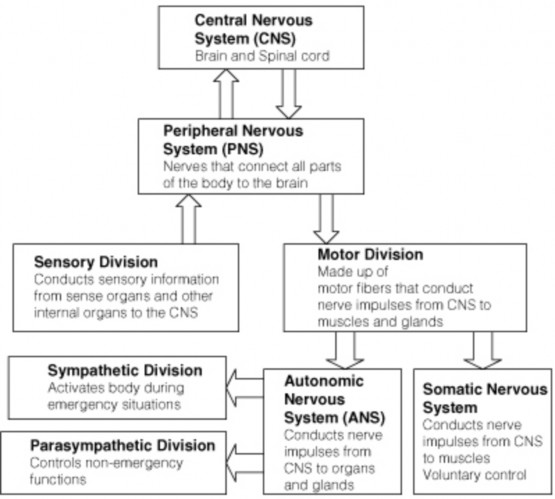
Figure 20.21: Levels of Organization of the Nervous System. (13)
www.ck12.org 1022
your eyes, ears, nose, mouth, and skin. They all have sensory receptors that are specific for certain stimuli. For example, the nose has sensory receptors for odors (smells). Sensory neurons send nerve impulses from sensory receptors to the central nervous system. The brain then interprets the nerve impulses to form a response.
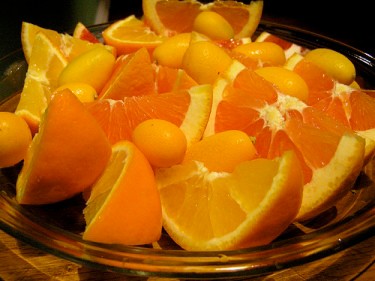
Figure 20.22: Can you smell these fresh, juicy oranges and kumquats? Your senses of smell, taste and sight are also important in developing an appetite. Just think of how appetizing these fruits would be if they were blue, crunchy, and smelled like burned toast. (53)
A sensory receptor is a cell, or a group of cells that detect stimuli. Sensory receptors can be classified based on the type of stimuli to which they respond.
Chemoreceptors respond to chemical stimuli.
Mechanoreceptors respond to mechanical stress or strain (movement).
Thermoreceptors respond to temperature changes.
Photoreceptors respond to variations in light.
Baroreceptors respond to pressure.
Specific areas of the brain interpret information from each sense organ. For example, regions of the occipital lobe interpret nerve impulses that come from the sensory receptors of the eyes, and regions of the temporal lobe interpret sensory information from the ears through the nerves that enter the brain in these areas, as shown in Figure 20.23. It is generally agreed that there are at least seven different senses in humans. These are sight, sound, taste, smell, touch, balance, and body awareness (the sense of knowing where the regions of your body are located at any one time). At least two other senses that humans do not have are observed in other organisms. Examples include electroreception, the ability to detect electric fields, and magnetoreception, the ability to detect magnetic fields.
1023 www.ck12.org
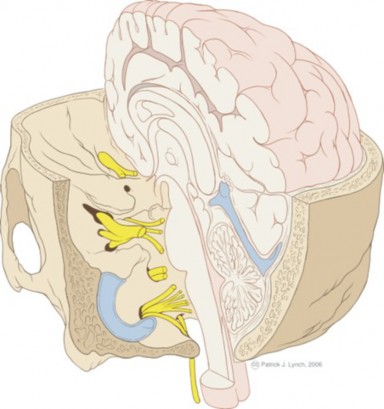
Figure 20.23: The entry of sensory nerves into the brain. Among other nerves, the sensory nerves for smell, sight, hearing, and taste (yellow structures) can be seen entering the skull. You can also see how the cerebrum, thalamus, cerebellum, and brain stem are nested within the skull. (19)
www.ck12.org 1024
Sight
Sight or vision describes the ability of the brain and eye to detect certain wavelengths of electromagnetic radiation (light), and interpret the image as ”sight.” Different receptors are responsible for the perception of color (the frequency of photons of light) and perception of brightness (number of photons of light). Photoreceptors are found in the retina, shown in Figure 20.24.

Figure 20.24: The structure of the eye. The macula is a spot near the center of the retina that has a diameter of about 1.5 mm. Near its center is the fovea, a small pit that contains the largest concentration of cone cells in the eye and is responsible for central vision. The macula is the point of sharpest vision. A video of the human eye is available at http:
//www.youtube.com/watch?v=JunCyiGfreo. (8)

Figure 20.25: Focusing light in the retina. This diagram shows how light from a distant source is bent by the stretched lens to strike the retina, and how light from a closer source is bent even more sharply by the relaxed lens to strike the retina. (6)
The structure of the eye owes itself completely to the task of focusing light onto the retina, the light-sensitive inner layer of the eye. First, light passes through a clear protective layer
1025 www.ck12.org
called the cornea, shown in Figure 20.24. Light then passes through the pupil, which is the opening in the iris, and into the interior of the eye. After passing through the pupil, the light then travels through the lens, a transparent, biconvex structure that, along with the cornea, helps to focus light on the retina. Muscles attached to the lens change the shape of the lens to bend the light rays so that they focus on the retina, as shown in Figure 20.25. Light hitting the retina causes chemical changes in the photosensitive cells of the retina, the products of which trigger nerve impulses which travel to the brain along the optic nerve.
The retina has two forms of photosensitive cells important to vision—rods and cones. Rod cells are highly sensitive to light which allows them to respond in dim light and dark con- ditions, but, they cannot detect color. These are the cells which allow humans and other animals to see by moonlight, or in a dimly-lit room. This is why the darker conditions become, the less color objects seem to have. Cone cells respond to different wavelengths of bright light to initiate a nerve impulse. They are also responsible for the sharpness of images. Cones do not respond well in poor light conditions, which is the reason why you see things in dim light as fuzzy shades of gray.
Humans have three different types of cone cells that respond to different wavelengths of light. These cone cells contain a pigment that absorbs the energy from different wavelengths of light to initiate a nerve impulse. Activation of the visual pigments by certain wavelengths of light opens ion channels on the membrane of the cone or rod cell. This leads to an action potential that is carried by the millions of neuron axons that make up the optic nerve to the visual centers of the brain. The brain integrates the nerve impulses from the cone cells and perceives the world in all the colors of the visual spectrum. A person who is colorblind has damaged or missing cones, and is unable to perceive certain colors.
Hearing
Hearing is the sense of sound perception that results from the movement of tiny hair fibers in the inner ear. These hairs detect the motion of a membrane which vibrates in response to changes in air pressure. Sound can also be detected as vibrations that are conducted through the body. Sound wave frequencies that are too low or too high to be heard by the ear can be detected this way. Audible sound is sensed by the ear.
The folds of cartilage surrounding the outer ear canal are called the pinna. Sound waves are gathered by the pinna, and channeled down the auditory canal, a tube-shaped opening of the ear which ends at the tympanic membrane, or eardrum.
Sound waves traveling through the ear canal hit the eardrum and cause it to vibrate. This wave information travels across the air-filled middle ear cavity through a group of three tiny, delicate bones: the hammer, the anvil, and the stirrup, shown in Figure 20.26. This group of bones transfers the eardrum vibrations to another membrane called the oval window. The oval window separates the middle ear from the inner ear. The inner ear contains the cochlea.
www.ck12.org 1026
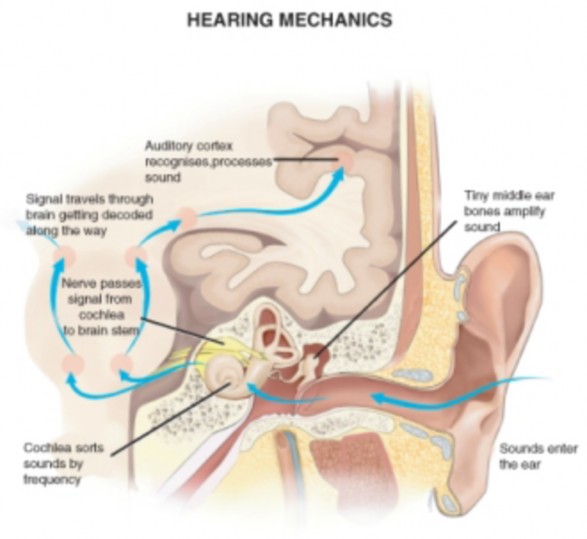
Figure 20.26: The detection of sound by your ear. (23)
1027 www.ck12.org
The cochlea is a coiled tube that is filled with a watery liquid, which moves in response to the vibrations coming from the middle ear through the oval window. As the fluid moves, thousands of mechanoreceptors called hair cells bend, releasing a neurotransmitter. The neurotransmitter causes an action potential in the neurons of the auditory nerve. The action potential travels along the auditory nerve to structures in the brainstem, then to the thalamus, and then to the auditory centers of the brain in the temporal lobe of the cerebral cortex.
A very strong movement of the fluid within the cochlea, caused by very loud noise, can kill hair cells. This is a common cause of partial hearing loss and is the reason why users of firearms or heavy machinery should wear earmuffs or earplugs. Destruction of the hair cells usually leads to permanent hearing loss because once destroyed, the hairs do not generally grow back.
Balance and the Ears
It might be hard to believe, but your ears are also in charge of your sense of balance! The semicircular canals are three fluid-filled interconnected tubes found inside each ear. They can be seen in Figure 20.26, directly above the cochlea. The canals are positioned at angles between 95 to 115 degrees relative to one another. The angles between the canals are not perpendicular, so movements of the head cause movement of fluid in two canals at the same time.
Each canal is filled with fluid called endolymph and motion sensors with little hairs, called cilia, line each canal. Movement of the head and body cause the endolymph in the canals to move about. The hair cells sense the strength and direction of the fluid’s movement and send electrical signals to the cerebellum which interprets the information and responds to help keep the body’s sense of balance. The interaction of the semicircular canals and the cerebellum allow the performer in Figure 20.27 to do his act.
When the sense of balance is interrupted it causes dizziness and nausea. Balance can be upset by an inner ear infection, a bad head cold or a sinus infection, or a number of other medical conditions. It can also be temporarily disturbed by rapid and repetitive movement, for example riding on a merry-go-round or spinning around in a circle.
Taste and Smell
Taste is one of the two main chemical senses, the other being smell. There are at least four types of taste receptors on the tongue. Taste stimuli from each receptor type send information to a different region of the brain. The four well-known receptors detect sweet, salt, sour, and bitter. The existence of a fifth receptor, for a sensation called umami, was confirmed in 2000. The umami receptor detects the amino acid glutamate, which causes a savory, “meaty” flavor in foods.
www.ck12.org 1028

Figure 20.27: Good balance required! This performer’s sense of balance is dependent on communication between his semicircular canals and his cerebellum. (34)
1029 www.ck12.org
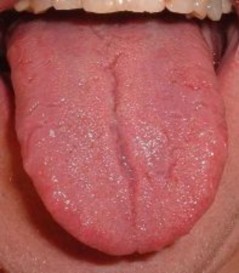
Figure 20.28: The location of taste buds. Most of the taste buds in the mouth are embedded in the papillae, the little bumps that cover the tongue. The deep groove (fissure) that runs down the center of the tongue in this photo is a common and perfectly normal condition. (48)
The chemoreceptors of the mouth are the taste cells that are found in bundles called taste buds. Most of the taste buds are embedded within the tiny papillae or “bumps” that cover the tongue, shown in Figure 20.28. Each receptor has a different way of detecting certain compounds and starting an action potential which alerts the brain. The compounds bind to receptors in the taste cells and stimulate neurons in the taste buds. The action potential moves along the facial nerves to the thalamus and then to the taste center of cerebral cortex for interpretation by the brain. The tongue can also feel sensations that are not generally called tastes. These include: temperature (hot or cold), coolness (as in “minty” or “fresh”), spiciness or hotness (peppery), and fattiness (greasy).
Smell is the other ”chemical” sense. The chemoreceptors of smell are called olfactory receptors. About 40 million olfactory receptor neurons line the nasal passages. Different odor molecules bind to and excite specific olfactory receptors. The combination of excitatory signals from different receptors makes up what we identify as “smell.” Signals from the olfactory receptors travel along nerves to the olfactory bulb in the brain where they then move to the smell center in the frontal lobe of the cerebral cortex. Olfactory receptor neurons in the nose differ from most other neurons in that they die and regenerate on a regular basis. A dog’s keen sense of smell is due to the large area of its nasal passages that are covered by olfactory receptors, and the large number of nerves that bring nerve impulses from the receptors to its brain. For example, the area in which olfactory receptors are located inside the human nose (called the olfactory epithelium), which is shown in Figure 20.29, measures about 12 cm2. The olfactory epithelium of some dogs’ noses can measure about 150 cm2!
www.ck12.org 1030
Have you ever noticed that you cannot taste anything when your nose is stuffed up? That is because your senses of smell and taste are closely linked. This is due to the fact that your nasal cavity, located behind the nostrils, connects to your mouth at the back of your throat, as shown in Figure 20.29. Your olfactory receptors and taste receptors both contribute to the flavor of food. Your tongue can only tell among a few different types of taste, while your nose can distinguish among hundreds of smells, even if only in tiny amounts.

Figure 20.29: The location of olfactory nerves. Olfactory receptors and their associated nerves (yellow) line the top of the nasal passages. Nerve messages from the receptors are sent to the brain to be interpreted as certain smells. (46)
Touch, Pressure, and Pain
Touch is the sense of pressure perception, which is generally felt in the skin. There are a variety of pressure receptors that respond to variations in pressure and tension. Mechanore- ceptors are most numerous on the tongue, lips, face, palms (including fingertips), and soles of the feet.
1031 www.ck12.org
There are several types of pain receptors, called nociceptors, which respond to potentially damaging stimuli. They are mostly found in the external parts of the body such as the skin, cornea, and mucous membranes, but are also found in muscles, joints, and some internal organs. Nociceptors are classified according to the stimuli to which they respond: thermal, mechanical or chemical. But some receptors respond to many different damaging stimuli of a chemical, thermal, or mechanical nature. Thermal receptors are activated by potentially harmful heat or cold, temperatures above 45°C and below 5°C. Mechanical receptors respond to excess pressure, squeezing, or bending, the type of painful stimuli that a cactus such as the one in Figure 20.30 would cause. Together these nociceptors allow the organism to feel pain in response to damaging pressure, excessive heat, excessive cold and a range of chemicals, the majority of which are damaging to the tissue surrounding the nociceptor.
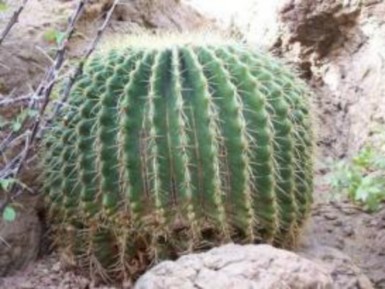
Figure 20.30: Mechanical pain receptors in your skin would warn you if you got too close to this prickly cactus. (1)
Drugs and the Nervous System
A drug is any chemical or biological substance that affects the body’s structure or functions. Drugs in the form of medicines are used to treat many illnesses and disorders. A medicine (or medication), is a drug that is taken to cure or reduce the symptoms of an illness. However, drugs, whether they are medicines, legal or illegal drugs, can be abused for the effects they have on the central nervous system (CNS). In fact many medical uses of drugs depend on the powerful effect they have on brain function. For example, anti-depression medicines are used to treat depression and anxiety disorders, and antipsychotic medicines are used to treat schizophrenia and bipolar disorder.
www.ck12.org 1032
A psychoactive drug is a substance that affects the central nervous system by altering cognitive function. Change in cognitive function results in changes in how a person feels, thinks, perceives, and acts. Almost everyone has used a psychoactive drug at some time in their life, and many people take such drugs daily. For example, the coffee or tea that you may have drank to waken yourself up this morning, or the cola, energy drink, or chocolate that you had as a snack contain the psychoactive drug caffeine. Caffeine is a CNS stimulant that makes you feel less drowsy and more alert. Coffee beans, the most common source of caffeine, are shown in Figure 20.31.
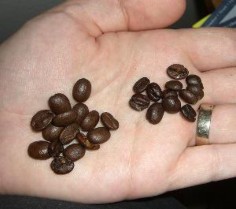
Figure 20.31: Roasted coffee beans. Coffee beans are a common source of the stimulant caffeine. Other plant sources include the leaves of tea, cocoa, yerba mate, and guarana plants. These plants use caffeine as a means of protection against being eaten. The caffeine in the leaves of these plants can paralyze and kill the insects that feed upon them. (37)
Drugs and the Brain: How Psychoactive Drugs Work
How we perceive stimuli, feel, think, and do is a result of neurons sending action potentials and neurotransmitters to each other and to other cells in the body. Psychoactive drugs affect how neurons communicate with each other. These drug molecules can alter neuro- transmission, by blocking receptor proteins, mimicking neurotransmitters, or changing the amount of neurotransmitter in the synapse, shown in Figure 20.32, by blocking reuptake. In this way a psychoactive drug can change how we feel, think, and interact with the world. Sometimes such effects are beneficial, such as taking a prescribed painkiller (hydrocodone, for example), to ease the pain of a broken bone. Sometimes the effects are harmful, which could happen if the person continued to take the powerful painkiller long after their broken bone had healed. Some examples of psychoactive medicines are listed in Table 20.3.
1033 www.ck12.org
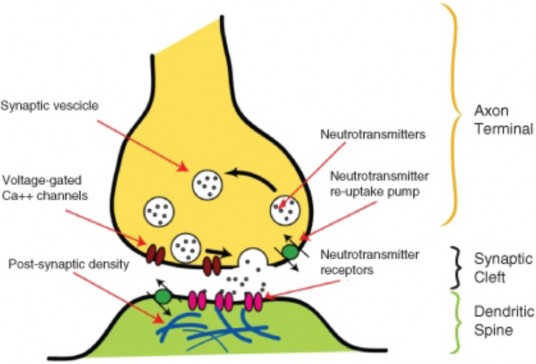
Figure 20.32: The release of neurotransmitter into the synaptic cleft. Depending on its method of action, a psychoactive substance may block the receptors on the post-synaptic neuron, or block reuptake or affect neurotransmitter synthesis in the pre-synaptic neuron. (20)
www.ck12.org 1034
Table 20.3: Some Psychoactive Medicines and Their Uses

Type Uses Example Action

Anesthetics Block pain and other sensations. Often induce unconscious- ness, which allows patients to undergo medical procedures.
Lidocaine, nitrous oxide
Mimic the inhibitory neurotransmitter GABA, or in- crease the amount of GABA in the synapse which pre- vents an action potential.
Painkillers (anal- gesics)
Reduce the sen- sation of pain. Includes narcotics and non-steroidal anti-inflammatory drugs (NSAIDS)
Narcotics: mor-
phine and codeine
NSAIDS: as-
pirin and ac- etaminophen (paracetamol).
Drug molecules mimic endogenous opioids “natural painkillers,” such as endorphins, by binding to opioid receptors.
Antidepressants Antidepressants are
used to treat disor- ders such as clinical depression, anxiety, and eating disorders
Selective Sero- tonin Reuptake Inhibitors (SSRIs); Monoamine oxidase inhibitors (MAOIs)
SSRIs: Block the uptake of the neurotransmit-
ter serotonin by presynaptic neuron MAOIs: Prevent an enzyme from break- ing down serotonin in the synapse. Both actions result in an increase of serotonin in the synapse.
Stimulants Used to treat disor- ders such as atten- tion deficit disorder and to suppress the appetite
Amphetamine salts Increases extra-
cellular levels of dopamine, nore-
pinephrine and serotonin by various means
1035 www.ck12.org
Table 20.3: (continued)

Type Uses Example Action

Antipsychotics Used to treat psy-
choses such as schizophrenia and mania.
Chlorpromazine Blocks dopamine
receptors in post synaptic neurons
Cough medicines (antitussives)
Used to treat persis- tent coughing.
Dextromethorphan (DXM) and codeine
Inhibit the action of, the NMDA receptor in the post synaptic cell. Reduces action potential, similar in action to anesthetics

Drug Abuse
Psychoactive drugs bring about changes in mood and feelings that a user may find desirable, therefore many psychoactive substances are abused. Drug abuse is the repeated use of a drug without advice or guidance of a medical professional, and use for reasons other than for what the drug was originally intended. With continued use of a drug, a person might find that they cannot function normally without the drug, a state called physical dependence. However, note that physical dependence is not in itself bad, for example, a person who has diabetes is physically dependent on insulin injections. Their body cannot work properly without it. Emotionally or mentally needing a drug to be able to function normally is called psychological dependence. When a person continues to take a psychoactive drug, they eventually need to take larger doses of the drug to get the desired effect; this process is known as building a tolerance to the drug. Drug tolerance can involve both psychological and physical factors.
A person who is abusing a drug may eventually lose control of their drug-taking behavior, partly due to the changes the drug has caused in their brain, and partly due to learned drug-abuse behaviors (such as stealing and lying to get money or drugs). In the state of addiction, a drug addict’s life and activities revolve around getting more of the drug to feed their habit, even if it leads to severe consequences such as getting arrested, dropping out of school, or isolation from friends and family. In a person who is addicted to a drug, the pattern of increasing dose due to tolerance can lead to a drug overdose, also known as an OD. A drug overdose is generally considered harmful and may lead to death. Drug dependence and addiction are caused by changes in the way neurons in the CNS send and receive neurotransmitters. It is for this reason dependency and addiction are treated as brain disorders by medical professionals.
Several classes of psychoactive drugs are commonly abused. Stimulants such as cocaine, www.ck12.org 1036
nicotine, and amphetamine increase the activity of the sympathetic nervous system, the central nervous system, or both. Stimulants generally increase heart rate, blood pressure, and increase the sense of alertness. Some stimulants, such as caffeine, are used medicinally to increase or maintain alertness, and to counteract fatigue. High doses of stimulants can be fatal. A common source of nicotine is cigarette tobacco, shown in Figure 20.33.
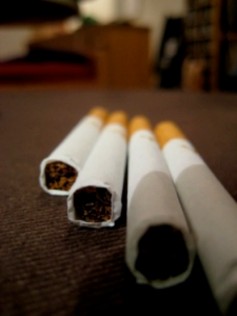
Figure 20.33: Cigarettes are a common source of nicotine. Nicotine is a compound that is found in the leaves of the tobacco plant. It is a potent neurotoxin for insects, and was once used as an insecticide. In addition to the addictive nature of nicotine, long-term to- bacco use carries significant risks of developing various cancers as well as strokes and severe cardiovascular and respiratory diseases. (49)
Hypnotics, also known as depressants, such as alcohol, codeine, barbiturates, and benzo- diazepines generally decrease the activity of the central nervous system. Depressants slow down brain function and give a drowsy or calm feeling. However, taking too much of a de- pressant drug can cause dangerously slow breathing and heart rates, and may result in death. Many depressants acting on the CNS do so by increasing the activity of the inhibitory neu- rotransmitter gamma-aminobutyric acid (GABA), although there are many receptors that are affected by different depressants. GABA calms the activity of the CNS and promotes sleep. Drugs that stimulate the activity of this amino acid slow down brain function and cause a drowsy or calm feeling, so depressants are generally prescribed to relieve symptoms of anxiety or insomnia.
Hallucinogens, also known as psychedelic drugs, such as lysergic acid diethylamide (LSD), phencyclidine (PCP), and ketamine, are psychoactive drugs that do not increase or decrease a certain feeling or emotion, but rather they induce experiences, such as sensory distortions
1037 www.ck12.org
and “out-of-body experiences,” that are very different from those of ordinary consciousness. These experiences are often called trance-like states. The use of psychedelic drugs has been linked to a potential for brain damage.
There are many ways in which psychoactive drugs can affect the CNS. Each drug has a specific action on one or more neurotransmitters or receptors. Drugs that increase activity in particular neurotransmitter systems are called agonists. They act by increasing the synthesis of one or more neurotransmitters or reducing its reuptake from the synapses. Drugs that reduce neurotransmitter activity are called antagonists, and work by interfering with synthesis or blocking postsynaptic receptors so that neurotransmitters cannot bind to them. The drug ketamine, which is used as an anesthetic and a painkiller, blocks the action of the neurotransmitter glutamate. Diacetylmorphine (heroin) enhances the action of endorphins in the brain. Different drugs also affect different parts of the brain. For example, drugs that affect breathing, such as cough suppressants, affect the brainstem to stop the coughing reflex. Painkillers (analgesics) block pain messages coming through the spinal cord from the body. In Figure 20.34 the brainstem region is blue, and the spinal cord is yellow.
How Addiction Happens
The neurobiological theory of addiction proposes that certain chemical pathways are greatly changed in the brain of an addicted person. Almost all drugs that are abused affect a certain set of brain structures in the limbic system called the ”brain reward system,” shown in Figure 20.27. The neurotransmitter dopamine is commonly associated with the brain reward system. The system providing feelings of pleasure (the “reward”), that motivates a person to perform certain activities over and over again. Dopamine is released at synapses by neurons when a person has a pleasurable experience such as eating a favorite food, or eating when very hungry. Such mechanisms have evolved to ensure the survival of organisms.
Some drugs, such as cocaine, nicotine, amphetamines, and alcohol directly or indirectly increase the amount of dopamine in the limbic structures. The pleasurable feelings that these drugs produce trick the body into thinking that the drug is good,important for survival, and needs to be taken repeatedly. Drugs that directly affect the brain reward system are highly addictive. The stimulant nicotine, which is found in tobacco, is highly addictive.
Cocaine is an example of a psychoactive drug that is both used as a medicine, and abused as a drug. Cocaine is highly addictive. It is a dopamine transporter blocker—it blocks the reuptake of dopamine by the presynaptic neuron. This action increases the amount of dopamine left in the synaptic cleft, so dopamine has a stronger effect on the postsynaptic neuron. Continued cocaine use causes a reduction in the number of dopamine receptors on the postsynaptic neuron. Eventually, the post synaptic neuron becomes understimulated because there are fewer dopamine receptors on it to respond to dopamine. At this point, more cocaine must be taken to stimulate the postsynaptic neuron into an action potential. If a person becomes dependent on the drug, they need cocaine for their body to act normally.
www.ck12.org 1038
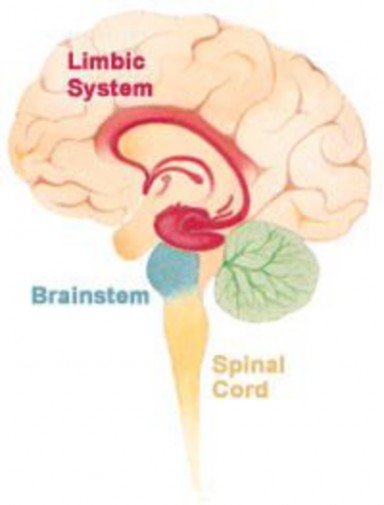
Figure 20.34: The limbic system (in red) includes structures in the human brain that have been linked to emotion, motivation, and emotional association with memory. The action of neurotransmitters in the limbic system is altered by addictive drugs. (57)
1039 www.ck12.org
If a person were to stop taking the drug at this point, their body would not be able to act normally, and they would experience a range of uncomfortable and painful symptoms called withdrawal. Symptoms of withdrawal include vomiting, diarrhea, and depression.
Many psychoactive substances are used or abused for their mood and perception altering effects, including those with accepted uses in medicine and psychiatry. Classes of drugs that are frequently abused include some of the drugs listed in Table 20.4. Drugs that are deemed by to have no medical uses and a high potential for abuse are usually illegal.
Not all drugs are physically addictive, but any activity that stimulates the brain reward system can lead to psychological addiction. Drugs that are most likely to cause addic- tion are drugs that directly stimulate the dopaminergic system, like cocaine, nicotine, and amphetamines. Drugs that only indirectly stimulate the dopaminergic system, such as psychedelics, are not as likely to be addictive.
Table 20.4: Some Common Drugs of Abuse

Psychoactive Drugs Effects Examples Some Common
Forms or Names

Stimulants Elevate the central nervous system and raise level of alert- ness and wakefulness
Hallucinogens Induce percep- tual and cognitive distortions
Hypnotics Depress the CNS, and induce sleep
Analgesics Induce euphoria, reduce sensation of pain
Caffeine, cocaine, amphetamine, methamphetamine
LSD, psilocybin, mescaline, PCP
Barbiturates, opi- oids (e.g. codeine, morphine, oxy- codone), benzodi- azepines, ethanol Codeine, morphine, ketamine, heroin, phencyclidine (PCP), tetrahydro- cannabinol (THC)
Coffee, coke, meth, ecstasy (X)
Acid, magic mush- rooms, peyote, angel dust
Diazapam, alcohol
Horse, angel dust, cannabis, marijuana

Lesson Summary
Neurons are typically made up of a cell body, dendrites, and an axon. The cell body contains the nucleus and other organelles similar to other body cells. The dendrites extend from the cell body and receive a nerve impulse from another cell. The cell body
www.ck12.org 1040
collects information from the dendrites and passes it along to the axon. The axon is a long, membrane-bound extension of the cell body that passes the nerve impulse onto the next cell.
Voltage is electrical potential energy that is caused by a separation of opposite charges across the membrane. The voltage across a membrane is called membrane potential. Membrane potential is the basis for the conduction of nerve impulses along the cell membrane. In an action potential, the cell membrane potential changes quickly from negative to positive as sodium ions flow into and potassium ions flow out of the cell through ion channels.
A neurotransmitter is a chemical message that is used to relay electrical signals between a neuron and another cell. Neurotransmitter molecules are made inside the presynaptic neuron and stored in vesicles at the axon terminal.
The central nervous system represents the largest part of the nervous system, and includes the brain and the spinal cord. The brain is the central control of the nervous system, and the spinal cord carries nerve impulses between the brain and the body, and from the body to the brain.
The sense organs include the eyes, ears, nose, mouth, and skin. They all have sensory receptors that are specific for certain stimuli. The eyes have photoreceptors for sight. The ears have mechanoreceptors that interpret stimuli as sound and also endolymph that aids in body balance. The nose has chemoreceptors for odors. The mouth has chemoreceptors for taste. The skin has a variety of mechanoreceptors and baroreceptors for touch.
Psychoactive drugs affect how neurons in the CNS communicate with each other. In this way a psychoactive drug changes how we feel, think, and interact with the world. Medicinal uses of psychoactive drugs include their use as anesthetics, painkillers, and antidepressants.
For an animation of the neuromuscular junction see http://www.youtube.com/watch? v=ZscXOvDgCmQ.
Review Questions
How does the body transmit electrical signals?
Describe the structure of a neuron.
Distinguish between a neuron and a glial cell.
Use 20.35 of an action potential to answer the following questions.
What is the membrane potential at the peak (after 2 milliseconds)? Is it positive or negative?
What happens to the membrane potential after 5 ms?
At the peak point when the membrane potential is 40mV, does the cell have an overall negative charge or positive charge?
Hyperpolarization, which means the cell becomes more negatively charged than it is at resting potential (more negative than -70 mV),can happen as a result of the binding of
1041 www.ck12.org

Figure 20.35: (44)
an inhibitory neurotransmitter to its receptor. Propose what happens to sodium and potassium ions during hyperpolarization.
How does voltage relate to the membrane potential?
What would happen to a cell if its sodium and potassium pumps failed to work at the end of an action potential?
The backflow of a nerve impulse is prevented by the fact that at a chemical synapse, the axon terminal does not have neurotransmitter receptors and dendrites cannot secrete neurotransmitter chemicals. What does this statement tell you about the direction of nerve impulses in neurons?
Identify two types of synapses in the nervous system.
What is the purpose of the digestive enzymes found in the synaptic cleft?
Distinguish a neurotransmitter from a hormone.
What is the major function of the central nervous system?
Outline the major functions of the cerebral cortex.
Use 20.36 of the lobes of the brain to answer the following questions. What is the name of the blue structure?
Identify a sense that is interpreted in the yellow-colored lobe (center left), and name that lobe.
Identify the two main divisions of the peripheral nervous system, and describe their roles in the body.
What are the two divisions of the autonomic nervous system?
Distinguish between the sympathetic and parasympathetic nervous systems.
What type of sensory receptors are found in the eyes?
Distinguish between rods and cones.
Why are taste and smell called the “two chemical senses”? www.ck12.org 1042
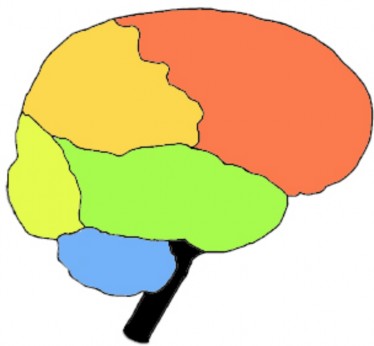
Figure 20.36: (7)
Outline how the ear is important to the sense of body balance.
What role does skin have in detecting external stimuli?
What kind of effects should a drug have for it to be called psychoactive?
Identify the main effect of psychoactive drugs on the CNS.
How do the effects of a stimulant differ from the effects of a depressant?
What is the brain reward system and how is it affected by an addictive drug?
How does cocaine affect the brain reward system?
Use 20.37 that shows the differences in blood concentration of nicotine over time to answer the following questions.
Review the graph that illustrates the increases in blood-nicotine concentrations from four different forms of tobacco; Cigarettes, oral snuff, chewing tobacco, and nicotine gum. Which of the four forms of nicotine increases blood-nicotine concentration the fastest?
Which of the four forms of nicotine increases blood-nicotine concentration the least?
Can you tell from this graph whether one form of tobacco is safer than another?
Further Reading / Supplemental Links
http://training.seer.cancer.gov/module_anatomy/unit5_2_nerve_tissue.html
http://brainmaps.org/
1043 www.ck12.org
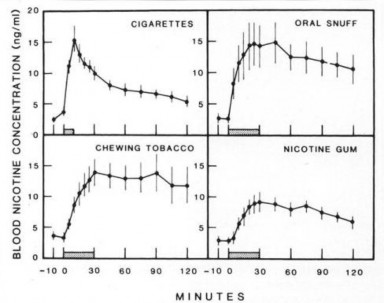
Figure 20.37: (15)
http://teens.drugabuse.gov/index.asp
http://www.nida.nih.gov/scienceofaddiction
Vocabulary
action potential An electrical charge that travels along the membrane of a neuron.
agonists Drugs that increase activity in particular neurotransmitter systems; act by in- creasing the synthesis of one or more neurotransmitters or reducing its reuptake from the synapses.
antagonists Drugs that reduce neurotransmitter activity; work by interfering with syn- thesis or blocking postsynaptic receptors so that neurotransmitters cannot bind to them.
astrocytes A type of glial cell in the brain; important for the maturation of neurons and may be involved in repairing damaged nervous tissue.
autonomic nervous system (ANS) The part of the peripheral nervous system that maintains homeostasis in the body; controls such actions as heart rate, digestion, respiration rate, salivation, and perspiration; also called the involuntary nervous sys- tem.
www.ck12.org 1044
axon A long, membrane-bound extension of the cell body that passes the nerve impulse onto the next cell.
axon terminal The end of the axon; the point at which the neuron communicates with the next cell.
brain stem Part of the brain involved with unconscious (autonomic) functions such as breathing, heartbeat, and temperature regulation; contains the midbrain, the pons, and the medulla oblongata.
cerebellum The part of the brain that is involved in coordination and control of body movement.
cerebral cortex The highly-folded outer layer of the cerebrum; controls higher functions, such as consciousness, reasoning, emotions, and language; also controls sensory func- tions such as touch, taste, smell, and responses to external stimuli.
cerebrum The part of the brain that generally controls conscious functions such as problem- solving and speech.
central nervous system (CNS) Made up of the brain and spinal cord; the brain is the central control of the CNS; the spinal cord carries nerve impulses from the brain to the body and from the body to the brain.
chemical synapse A synapse that uses chemical signaling molecules as messengers.
cochlea A coiled tube within the ear; filled with a watery liquid which moves in response to the vibrations coming from the middle ear through the oval window; as the fluid moves, thousands of mechanoreceptors called hair cells bend, releasing a neurotransmitter.
cone cells Photosensitive cells important to vision; located in the retina; respond to dif- ferent wavelengths of bright light to initiate a nerve impulse; also responsible for the sharpness of images.
dendrites Extend from the cell body and receive a nerve impulse from another cell.
diencephalons The region of the brain that includes structures such as the thalamus, the hypothalamus, and a portion of the pituitary gland.
1045 www.ck12.org
dorsal root The “nerve highway;” carries sensory information from sensory receptors in the body to the CNS.
drug Any chemical or biological substance that affects the body’s structure or functions.
drug abuse The repeated use of a drug without advice or guidance of a medical profes- sional, and use for reasons other than for what the drug was originally intended.
electrical synapse Synapse that uses ions as messengers.
endocrine system A system of glands around the body that release chemical signal molecules into the bloodstream.
glial cell Cell that provides a support system for the neurons; also involved in synapse formation.
hallucinogens Psychedelic drugs, such as lysergic acid diethylamide (LSD), phencyclidine (PCP), and ketamine; psychoactive drugs that do not increase or decrease a certain feeling or emotion, but rather they induce experiences, such as sensory distortions and “out-of-body experiences,” that are very different from those of ordinary consciousness.
hearing The sense of sound perception that results from the movement of tiny hair fibers in the inner ear.
hypnotics (depressants) Drug that decreases the activity of the central nervous system; slows down brain function and give a drowsy or calm feeling; includes alcohol, codeine, barbiturates, and benzodiazepines.
interneurons Neurons that connect sensory and motor neurons in neural pathways that go through the CNS; also called association or relay neurons.
medicine (or medication) A drug that is taken to cure or reduce the symptoms of an illness.
membrane potential The voltage across a membrane; the basis for the conduction of nerve impulses along the cell membrane of neurons.
midbrain Part of the brain involved with unconscious (autonomic) functions such as breathing, heartbeat, and temperature regulation.
www.ck12.org 1046
motor division Subdivision of the PNS; carries nerve impulses from the CNS to the mus- cles, glands and organs of the body; also called the efferent division.
motor neurons Neurons that carry signals from the central nervous system to muscles and glands; sometimes called efferent neurons.
myelin sheath An electrically insulating phospholipid layer; covers the axon; speeds up the transmission of a nerve impulse along the axon.
nerve An enclosed, cable-like bundle of axons.
nervous system A complex network of nervous tissue that sends electrical and chemical signals; includes the central nervous system (CNS) and the peripheral nervous system (PNS) together.
neuromuscular junction A synapse between a neuron and a muscle cell.
neuron The ”conducting” cell that transmits electrical signals; the structural unit of the nervous system.
neurotransmitter Chemical messages which are released at the synapse and pass the “message” onto the next neuron or other type of cell.
nociceptor A type of pain receptor which responds to potentially damaging stimuli.
Nodes of Ranvier Regularly spaced gaps between the myelin; the only points at which ions can move across the axon membrane, through ion channels.
olfactory receptors The chemoreceptors of smell.
oligodendrocytes Glial cells that supply myelin to neurons of the brain and spinal cord.
parasympathetic division Subdivision of the ANS; controls non-emergency functions such as digestion.
peripheral nervous system (PNS) Made up of the nervous tissue that lies outside the CNS, such as the nerves in the legs, arms, hands, feet and organs of the body.
1047 www.ck12.org
pinna The folds of cartilage surrounding the outer ear canal; gathers sound waves which are channeled down the auditory canal, a tube-shaped opening of the ear which ends at the tympanic membrane, or eardrum.
psychoactive drug A substance that affects the central nervous system by altering cog- nitive function.
reflex An automatic (involuntary) action caused by a defined stimulus and carried out through a reflex arc.
resting potential The resting state of the neuron, during which the neuron has an overall negative charge.
reuptake The removal of a neurotransmitter from the synapse by the pre-synaptic neuron; a way of controlling the effect the neurotransmitter has on the post-synaptic cell.
rod cells Photosensitive cells important to vision; located in the retina; highly sensitive to light which allows them to respond in dim light and dark conditions, but, they cannot detect color.
Schwann cells Cells that supply the myelin for neurons that are not part of the brain or spinal cord.
sensory division Subdivision of the PNS; carries sensory information from sensory recep- tors in the body to the CNS; also known as the afferent division.
sensory neurons Neurons that carry signals from tissues and organs to the central nervous system; sometimes called afferent neurons.
sight (vision) Describes the ability of the brain and eye to detect certain wavelengths of electromagnetic radiation (light), and interpret the image.
sodium-potassium pump Transport protein that removes Na+ ions from the cell by ac- tive transport; also brings K+ ions into the cell.
somatic nervous system The part of the PNS that is associated with the conscious (vol- untary) control of the body through the movement of skeletal muscles and the percep- tion of external stimuli through senses such as touch, hearing, and sight.
www.ck12.org 1048
spinal cord A thin, tubular bundle of nervous tissue that extends from the medulla oblon- gata and continues to the lower back; functions as an information superhighway that links the sensory messages from the body to the brain.
stimulant Psychoactive drug, such as cocaine, nicotine, and amphetamine, that increases the activity of the sympathetic nervous system, the central nervous system, or both; generally increase heart rate, blood pressure, and increase the sense of alertness.
sympathetic division Subdivision of the ANS; generally stimulates body systems during emergency situations.
synapse A specialized junction at which neurons communicate with each other.
synaptic cleft Gap between the axon terminal of the presynaptic neuron and the receiving cell.
threshold Level of depolarization the membrane potential has to surpass for the action potential to start.
touch The sense of pressure perception, which is generally felt in the skin.
ventral root Contains axons of motor neurons which carry information away from the CNS to the muscles and glands of the body.
voltage Electrical potential energy that is caused by a separation of opposite charges.
Points to Consider
The electrical signals of the nervous system move very rapidly along nervous tissue, while the chemical signals of the endocrine system act much more slowly and over a longer period of time. Identify some of advantages to having two different speeds for communications in the body.
Identify ways that psychoactive drug abuse may negatively affect organ systems other than the nervous system.
The cerebral cortex controls functions such as consciousness, reasoning, emotions, and language. The brain stem is the lower part of the brain that is involved with un- conscious, autonomic functions. Consider why consciousness and reasoning are called “higher functions” in relation to the “lower functions” of breathing and heartbeat.
1049 www.ck12.org
Lesson 20.2: The Endocrine System
Lesson Objectives
Identify the main functions of the endocrine system.
Identify the structures that produce hormones.
Outline how hormones affect certain cells and not others.
Describe two ways that hormones influence the function of cells.
Identify the two glands that serve as the major control centers of the endocrine system.
Identify the effects of adrenal hormones on the body.
Examine the importance of the islets of Langerhans.
Outline the role of the sex hormones in reproduction.
Identify non-endocrine organs that secrete hormones.
Examine how feedback mechanisms control hormone levels and body functions.
Identify the role of hormone antagonists in the control of substances in the body.
Identify two medical uses of hormones.
Introduction
The endocrine system is a system of organs that releases chemical message molecules, called hormones, into the blood. Unlike the nervous system whose action helps the body react immediately to change, such as quickly jumping out of the way of an oncoming cyclist, the endocrine system controls changes that happen to the body over a long period of time; from minutes, hours, to years of change. The two systems work closely together to help us respond to our environment, such as the rollercoaster ride shown in Figure 20.38. The endocrine system is important in controlling metabolism, growth and development, reproduction, and salt, water and nutrient balance of blood and other tissues (osmoregulation).
Function of the Endocrine System
The nervous system uses nerves to conduct electrical and chemical information around the body, while the endocrine system uses blood vessels to carry chemical information. You can think of the nervous system as being similar to the electrical system in a house. Flicking on a light switch is similar to initiating an action potential in a nerve, and it has an almost immediate result: the light bulb illuminates. The endocrine system on the other hand is more like starting up an oil or gas powered water-heating system. You flick on the switch to heat water up for a bath, but it takes a certain length of time for the result to occur: hot water.
www.ck12.org 1050

Figure 20.38: What an adrenaline rush! The excitement that the people on this rollercoaster are feeling is a good example of how the nervous and endocrine systems work together. Nerve impulses from the sympathetic nervous system cause the adrenal medulla to release the hormone adrenaline into the bloodstream. Adrenaline causes the racing heart, sweaty palms, and feeling of alertness that together are called the ”fight or flight” response. (14)
Organs of the Endocrine System
The endocrine system is made up of many glands that are located in different areas of the body. Hormones are chemical messenger molecules that are made by cells in one part of the body and cause changes in cells in another part of the body. Hormones regulate the many and varied functions that keep you alive.
Hormones are made and secreted by cells in endocrine glands. Endocrine glands are ductless organs that secrete hormones directly into the blood or the fluid surrounding a cell rather than through a duct. The primary function of an endocrine gland is to make and secrete hormones. The endocrine glands collectively make up the endocrine system. The major glands of the endocrine system and their functions are shown in Figure 20.39. Many other organs, such as the stomach, heart, and kidneys secrete hormones and are considered to be part of the endocrine system.
Exocrine glands are organs that secrete their products into ducts (they are duct glands). They are similar to endocrine glands in that they secrete substances, but they do not secrete hormones. Instead they secrete products such as water, mucus, enzymes, and other proteins through ducts to specific locations inside and outside the body. For example, sweat glands secrete sweat onto the skin and salivary glands secrete saliva into the mouth. The reason we are discussing exocrine glands in a chapter about hormones is because some endocrine glands, such as the pancreas, are also exocrine glands. Ducts in the pancreas secrete fat- digesting enzymes into the intestines. The secretion of the enzymes from the pancreas is
1051 www.ck12.org

Figure 20.39: The major organs of the endocrine system. (5)
www.ck12.org 1052
controlled by hormones that are made by certain stomach cells.
Hormones
The body produces many different hormones, but each hormone is very specific for its target cells. A target cell is the cell on which a hormone has an effect. Target cells are affected by hormones because they have receptor proteins that are specific to the hormone. Hormones will travel through the bloodstream until they find a target cell with the specific receptors to which they can bind. When a hormone binds to a receptor, it causes a change within the cell.
There are two main types of hormones, and a group of hormone-like substances:
Amino Acid-Based Hormones
Amino acid-based hormones are made of amino acids. Some amino acid-based hormones are made of a few amino acids and are simple in structure while others are made of hundreds of amino acids and are very large. These hormones are not fat-soluble and therefore cannot diffuse through the plasma membrane of their target cell. They usually bind to receptors that are found on the cell membrane.
Cholesterol-Based Hormones
Cholesterol-based hormones are made of lipids such as phospholipids and cholesterol. Hor- mones from this group are also called steroid hormones. Steroid hormones are fat soluble and are able to diffuse through the plasma membrane. Steroid hormone receptors are found within the cell cytosol and nucleus.
Hormone-like Substances
The term hormone-like substances refers to a group of signaling molecules that are de- rived from certain types of fatty acids and proteins. Two examples of these substances are prostaglandins and neuropeptides. These substances do not travel around the body in blood as hormones do and tend to be broken down quickly. As a result, the effects of hormone- like substances are localized in the tissue in which it they are produced. For example, prostaglandins, which are made from essential fatty acids, are produced by most cells in the body. Prostaglandins have many different effects such as causing constriction or dilation of blood vessels but they are all are localized within the target cells and tissues. Neuropep- tides are signaling peptides found in nervous tissue. Neuropeptides have many effects on nerve cells. For example, they can affect gene expression, local blood flow, and the shape of glial cells. Some neuropeptides such as endorphins and oxytocin have effects on non-nerve cells and are called hormones. Both signaling molecules have an effect on behavior. Among
1053 www.ck12.org
other things, endorphins are involved in pain perception and oxytocin is involved in social bonding and maternal behavior.
The cells that make hormones are usually specialized for the job, and are found within a par- ticular endocrine gland, for example the thyroid gland, the ovaries, or the testes. Hormones may exit their cell of origin by exocytosis or another type of membrane transport. Typically cells that respond to a particular hormone may be one of several cell types that are found in different tissues throughout the body. Such is the case for insulin, which triggers a great number of physical effects. Different tissue types may also respond differently to the same hormonal signal. Because of this, hormonal signaling is a very complex process.
Hormone Receptors
Cells that respond to hormones have two properties in common: they have receptors that are very specific for certain hormones, and those receptors are joined with processes that control the metabolism of the target cells. There are two main ways that receptor-bound hormones activate processes within cells, depending on whether the hormone can pass across the membrane (steroid hormones are fat-soluble), or cannot pass through the membrane (most amino acid based hormones are water soluble).
Second Messenger System
A water-soluble hormone molecule does not enter the cell, instead it binds to the membrane- bound receptor molecule, which triggers changes within the cell. These changes are activated by second messenger molecules.
Direct Gene Activation
A fat-soluble hormone diffuses across the membrane and binds to the receptor within the cytosol or nucleus. The hormone-receptor complex then acts as a transcription factor that affects gene expression.
The two different ways that hormones can activate cells are discussed here, using the amino- acid based hormone glucagon and the steroid hormone cortisol as examples.
Action of Glucagon: A Second Messenger System
The majority of amino-acid based hormones, such as glucagon, bind to membrane-bound receptors. The binding of the hormone triggers a signal transduction pathway, a pro- cess of molecular changes that turns the hormone’s extracellular signal into an intracellular response. Activation of these receptors by hormones (the first messengers) leads to the in- tracellular production of second messengers as part of the signal transduction pathway. A
www.ck12.org 1054
second messenger is a small molecule that starts a change inside a cell in response to the binding of a specific signal to a receptor protein. Some second messenger molecules include small molecules such as cyclic AMP (cAMP), cyclic GMP (cGMP), and calcium ions (Ca2+).
Glucagon is an important hormone involved in carbohydrate metabolism. It is released when the glucose level in the blood is low which causes the liver to change stored glycogen into glucose and release it into the bloodstream. Glucagon is released by the pancreas and circulates in the blood until it binds to a glucagon receptor, a G protein-linked receptor, found in the plasma membrane of liver cells. The binding of glucagon (first messenger) changes the shape of the receptor, which then activates a G protein. The G-protein is an enzyme that in turn activates the next enzyme in the cascade, the second messenger; adenylate cyclase. Adenylate cyclase produces cAMP which activates another enzyme, which in turn activates another enzyme, and so on. The end result is an enzyme that breaks apart the glycogen molecule in the liver cell to release glucose molecules into the blood. The signal transduction pathway, a type of enzyme “domino-effect” inside the cell, allows a small amount of hormone to have a large effect on the cell or tissue. To learn more about second messenger systems, refer to the Cell Structure and Function chapter.
Action of Cortisol: A Direct Gene Activation
Steroid hormones diffuse through cell membrane and bind to receptors in the cytosol or the nucleus of the cell. The receptor-hormone complex acts as a transcription factor that affects gene expression.
Cortisol is a steroid hormone produced by the adrenal glands. It is often called the ”stress hormone” as it is involved in the body’s response to stress. It increases blood pressure, blood sugar levels and has an immunosuppressive action. Cortisol crosses the cell membrane and binds to a steroid receptor in the cytoplasm. The cortisol-receptor complex then enters the nucleus of the cell and binds to DNA, where it activates or deactivates gene transcription. The gene that is activated or deactivated depends on the cell type.
Effects of Hormones
The effects of hormones vary widely, and certain hormones, called tropic hormones (or tropins), regulate the production and release of other hormones. Many of the responses to hormones regulate the metabolic activity of an organ or tissue.
Other effects of hormones can include:
Stimulation or inhibition of growth
Induction or suppression of programmed cell death (apoptosis)
Activation or inhibition of the immune system
Regulation of metabolism
1055 www.ck12.org
Preparation for a new activity (e.g., fighting, fleeing, mating)
Preparation for a new phase of life, for example puberty, caring for offspring, or menopause
Control of the reproductive cycle
You will learn more about the effects of certain hormones as we examine some of the endocrine glands individually.
Hypothalamus and Pituitary Gland
The hypothalamus links the nervous system to the endocrine system by the pituitary gland. The hypothalamus is located below the thalamus, just above the brain stem. It is found in all mammalian brains, including humans. The human hypothalamus is about the size of an almond; its position in the brain is shown in Figure 20.40.

Figure 20.40: The hypothalamus is here. The red arrow shows the position of the hypotha- lamus in the brain. (18)
The hypothalamus is a very complex area of the brain, and even small numbers of nerve cells within it are involved in many different functions. The hypothalamus coordinates many sea-
www.ck12.org 1056
sonal and circadian rhythms, complex homeostatic mechanisms, and the autonomic nervous system (ANS). A circadian rhythm is a roughly-24-hour cycle in the biological processes carried out within organisms, including plants, animals, fungi and certain bacteria. The ANS controls activities such as body temperature, hunger, and thirst. The hypothalamus must therefore respond to many different signals, some of which are from outside and some from inside the body. Thus, the hypothalamus is connected with many parts of the CNS, including the brainstem, the olfactory bulbs, and the cerebral cortex.
The hypothalamus produces hormones that are stored in the pituitary gland. For example, oxytocin and antidiuretic hormone (ADH) are made by nerve cells in the hypothalamus, and are stored in the pituitary prior to their release into the blood. In addition to influencing ma- ternal behavior, oxytocin is involved in controlling circadian homeostasis, such as a person’s body temperature, activity level, and wakefulness at different times of the day. Antidiuretic hormone (ADH) is released when the body is low on water; it causes the kidneys to conserve water by concentrating the urine and reducing urine volume. It also raises blood pressure by causing blood vessels to constrict.
Pituitary Gland
The pituitary gland is about the size of a pea and is attached the hypothalamus by a thin stalk at the base of the brain, shown in Figure 20.41. The pituitary gland secretes hormones that regulate homeostasis. It also secretes hormones that stimulate other endocrine glands, called tropic hormones.

Figure 20.41: The position of the pituitary in the brain. A close-up of the anterior and posterior pituitary gland can be seen at right. The orange vessels are the capillary system that comes from the hypothalamus and carries hormones to the anterior pituitary (red) for storage. The blue vessels on the posterior pituitary come from the neurosecretory cells in the hypothalamus. (41)
The anterior pituitary, or front lobe, makes many important hormones, which are listed
1057 www.ck12.org
in Table 20.5. The posterior pituitary, or rear lobe, releases two hormones, oxytocin and antidiuretic hormone (ADH) that are made by nerve cells in the hypothalamus. These hormones are transported down the nerve cell’s axons to the posterior pituitary where they are stored until needed.
Table 20.5: Pituitary Hormones

Location Hormone Target Function

Anterior Pituitary Adrenocorticotropic
hormone (ACTH) Thyroid-stimulating hormone (TSH)
Growth hormone (GH)
Follicle stimulating hormone (FSH) Leutinizing hormone (LH) Prolactin (PRL)
Posterior Pituitary Anti diuretic hor-
mone (vasopressin) Oxytocin
Adrenal Gland Thy- roid Gland
Body cells
Ovaries, Testes (Go- nads)
Ovaries, Testes Ovaries, mammary glands
Kidneys or Arteri- oles uterus, mam- mary glands
Stimulates adrenal cortex Stimulates thyroid
Growth hormone Stimulates pro- duction of ovarian follicles in females, sperm production in males Causes ovulation in fe- males Causes milk secretion
Promotes water reabsorption in kidneys, raises blood pressure Causes uterus to con- tract in childbirth, stimulates milk flow

Most of these hormones are released from the anterior pituitary under the influence of hor- mones from the hypothalamus. The hypothalamus hormones travel to the anterior lobe down a special capillary system that surrounds the pituitary.
Oxytocin is the only pituitary hormone to create a positive feedback loop. For example, during the labor and delivery process, when the cervix dilates the uterus contracts. Uterine contractions stimulate the release of oxytocin from the posterior pituitary, which in turn increases uterine contractions. This positive feedback loop continues until the baby is born.
www.ck12.org 1058
Other Endocrine Glands
Thyroid and Parathyroid Glands
The thyroid is one of the largest endocrine glands in the body. This butterfly-shaped gland is found in the neck, wrapped around the trachea, as shown in Figure 20.42. The hormones released by the thyroid control how quickly the body uses energy, makes proteins, and how sensitive the body should be to other hormones. The thyroid is controlled by the hypothalamus and pituitary. Thyroid hormone generally controls the pace of all of the processes in the body. This pace is related to your metabolism. If there is too much thyroid hormone, every function of the body tends to speed up. The thyroid gland regulates the body temperature by secreting two hormones that control how quickly the body burns calories. Hyperthyroidism (overactive thyroid) and hypothyroidism (under active thyroid) are the most common problems of the thyroid gland.
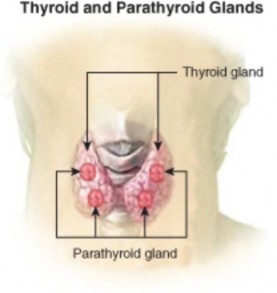
Figure 20.42: The position of the thyroid and parathyroid glands. A person can have more than four parathyroid glands. (36)
The thyroid hormones thyroxine (T4) and triiodothyronine (T3) regulate the rate of metabolism and affect the growth and rate of function of many other systems in the body. As a result, problems with the under secretion or over secretion of thyroid hormones affect many body systems.
The element iodine is very important for making both T3 and T4. If a person’s diet does not have enough iodine, their thyroid cannot work properly and the person develops an iodine
1059 www.ck12.org
deficiency disease called goiter. Low amounts of T3 and T4 in the blood, due to lack of iodine to make them, causes the pituitary to secrete large amounts of thyroid stimulating hormone (TSH), which causes abnormal growth of the thyroid gland. The addition of small amounts of iodine to mass produced foods, such as table salt, has helped reduce the occurrence of iodine-deficiency in developed countries. The thyroid also produces the hormone calcitonin, which plays a role in calcium homeostasis. The hormones secreted by the thyroid are listed in Table 20.6.
Table 20.6: Hormones Secreted by the Thyroid and Parathyroid Glands

Location Hormone Target Function

Thyroid Triiodothyroine (T3) Thyroxine (T4)
Calcitonin
Parathyroid Parathyroid hor- mone (PTH)
Body Cells Bone cells
Cells of the bone, kidney, and in- testines
Increase metabolic rate, stimulates mental and physical growth Increases calcium absorption by bones, lowers blood calcium level
Regulates blood cal- cium levels

Parathyroid Glands
The parathyroid glands are usually located behind the thyroid gland, but they are visible in Figure 20.42. Parathyroid hormone (PTH), maintains blood calcium levels within a narrow range, so that the nervous and muscular systems can work properly. When blood calcium levels drop below a certain point, calcium-sensing receptors in the parathyroid gland release the hormone parathyroid hormone (PTH) into the blood. PTH has effects that are opposite to the action of calcitonin. It increases blood calcium levels by stimulating certain bone cells to break down bone and release calcium. It also increases gastrointestinal calcium absorption by activating vitamin D, and promotes calcium uptake by the kidneys. The hormones secreted by the parathyroid glands are listed in Table 20.6.
Pineal Gland
The hormone melatonin is made in the pea-sized pineal gland, which is located at the base of the brain. Production of melatonin by the pineal gland is under the control of the hy- pothalamus which receives information from the retina about the daily pattern of light and darkness. Very little is currently known about the functions of melatonin, but scientists have
www.ck12.org 1060
found that it is involved in sleep cycles (circadian cycles), the onset of puberty, and immune function. Melatonin secretion also responds to seasonal changes in light, which could be a reason why getting out of bed on a dull, rainy morning can be so difficult, as the boy in Figure 20.43 probably knows.

Figure 20.43: Very little is currently known about the role of melatonin, but scientists do know that it is involved in sleep cycles. It is produced by the pineal gland, the retina and the intestines. Production of melatonin by the pineal gland is influenced of by the hypothalamus which receives information from the retina about the daily pattern of light and darkness. (55)
1061 www.ck12.org
Pancreas
The pancreas is both an exocrine gland as it secretes pancreatic juice containing digestive enzymes, and an endocrine gland as it produces several important hormones. It is located just below and behind the stomach, as shown in Figure 20.44. The endocrine cells of the pancreas are grouped together in areas called islets of Langerhans, shown in Figure 20.45. The islets produce the amino acid-based hormones insulin, glucagon, and somatostatin. Insulin and glucagon are both involved in controlling blood glucose levels. Insulin is produced by beta cells and causes excess blood glucose to be taken up by liver and muscle cells, where it is stored as glycogen, a polysaccharide. Glucagon is produced by alpha cells and stimulates liver cells to break down stores of glycogen into glucose which is then released into the blood. An alpha cell is another type of endocrine cell that is found within the islets of Langerhans. The hormones secreted by the pancreas are listed in Table 20.7.

Figure 20.44: The location of the pancreas in relation to the stomach and gall bladder. The hormone-producing Islet cells a found in groups throughout the pancreas. (51)
www.ck12.org 1062

Figure 20.45: Micrograph of an islet of Langerhans isolated from a rat pancreas. Each islet in a human pancreas contains approximately 1000 cells and is 50 to 500 micrometers in diameter. Cell nuclei are stained blue, insulin-producing beta cells are green, and glucagon- producing alpha cells are red. (11)
1063 www.ck12.org
Table 20.7: Hormones Secreted by the Pancreas

Hormone Effects

Insulin Glucagon Amylin
Somatostatin (inhibitory hormone)
Ghrelin
Reduces blood glucose con- centration Raises blood glu- cose concentration Suppresses glucagons secre- tion
Suppress the release of in- sulin, glucagon, and pancre- atic enzymes
Stimulates appetite

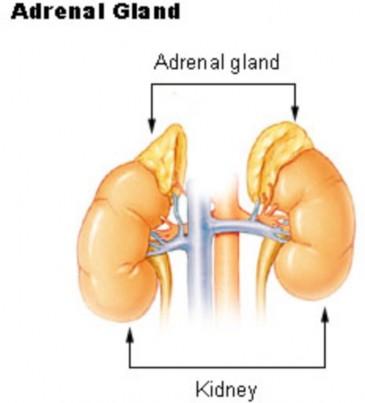
Figure 20.46: The location of the adrenal glands, above the kidneys. (17)
www.ck12.org 1064
Adrenal Glands
An adrenal gland is located above each of the kidneys, as shown in Figure 20.46. Each adrenal gland is separated into two structures, the adrenal medulla, which is the center of the gland, and the adrenal cortex, which is the outer layer. The medulla and the cortex work as two separate endocrine glands.
The adrenal medulla is the core of the adrenal gland, and is surrounded by the adrenal cortex. Secretion of hormones from the medulla is controlled by the sympathetic nervous system. The cells of the medulla are the body’s main source of the hormones adrenaline (epinephrine) and noradrenaline (norepinephrine). These hormones are part of the fight-or- flight response initiated by the sympathetic nervous system. The hormone boosts the supply of oxygen and glucose to the brain and muscles, while suppressing other non-emergency bodily processes, such as digestion.
The adrenal cortex is the site of steroid hormone synthesis. Some cells make cortisol, while other cells make androgens such as testosterone. Other cells of the cortex regulate water and electrolyte concentrations by secreting aldosterone, which helps to regulate blood pressure. In contrast to the medulla that is controlled directly by the nervous system, the cortex is regulated by hormones secreted by the pituitary gland and hypothalamus.
Cortisol is an important steroid hormone that is often called the ”stress hormone” as it is involved in the response to stress, and is involved in restoring homeostasis after a stressful event, such as the (good) stress caused by running around a soccer field [football pitch (for non-American-English speakers)], shown in Figure 20.47. Cortisol increases blood pressure, blood sugar levels and has an immunosuppressive action. Long-term stress causes prolonged cortisol secretion, hyperglycemia, and weakening of the immune system. Excess levels of cortisol in the blood result in Cushing’s syndrome, symptoms of which include rapid weight gain, a round face, excess sweating, and thinning of the skin and mucous membranes.
1065 www.ck12.org
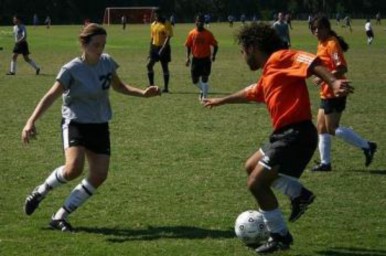
Figure 20.47: Regular activity through sport is a good way of allowing your body to respond naturally to its stress hormones, which prepare the body for quick movements or prolonged activity. (2)
Table 20.8: Hormones of the Adrenal Glands


Location Hormone Function Adrenal cortex
Mineralcorticoids (such as aldosterone)
Glucocortocoids (such as cortisol)
Gonadotropins
Regulate sodium reabsorp- tion and potassium elimination in the kid- neys
Depress immune response, provide stress resis- tance, helps in fat, protein and carbohy- drate metabolism
Stimulates releases of sex hormones that develop sexual characteristics of males and females
www.ck12.org 1066
Table 20.8: (continued)


Location Hormone Function Adrenal medulla
Epinephrine (adrenaline) Norepinephrine (nora-
drenaline)
”Fight or flight” hormone, plays central role in short-term response to stress, increases heart rate and supply of blood and oxygen to the brain
Increases alertness, phys- ical effect similar to epinephrine

Epinephrine, also called adrenaline, is a “fight or flight” hormone which is released from the adrenal medulla when stimulated by the sympathetic nervous system. Epinephrine plays a central role in the short-term stress reaction—the body’s response to threatening, exciting, or environmental stressors such as high noise levels or bright light. When secreted into the bloodstream, it binds to multiple receptors and has many effects throughout the body. Epinephrine increases heart rate, dilates the pupils, and constricts blood vessels in the skin and gut while dilating arterioles in leg muscles. It increases the blood sugar level, and at the same time begins the breakdown of lipids in fat cells. It also “turns down” non-emergency bodily processes such as digestion. Similar to other stress hormones, such as cortisol, epinephrine depresses the immune system.
Stress also releases norepinephrine in the brain. Norepinephrine has similar actions in the body as adrenaline, such as increasing blood pressure. Norepinephrine is also psychoactive because it affects alertness, which would be helpful for studying as shown in Figure 20.48. The hormones secreted by the adrenal cortex and medulla are listed in Table 20.8.
Gonads
The ovaries of females and the testes of males are the gamete producing organs, or gonads. Ovaries in females are homologous to testes in males. In addition to producing gametes, an exocrine action, the gonads are endocrine glands that produce steroid sex hormones. Sex hormones are responsible for the secondary sex characteristics that develop at puberty. Puberty is the process of physical changes during which the sex organs mature and a person become capable of reproducing. During puberty, among other changes, males begin producing sperm and females begin menstrual cycles.
1067 www.ck12.org

Figure 20.48: Thinking about an upcoming exam can cause your adrenal glands to produce adrenaline (epinephrine). Your body’s stress response can cause you to feel “stressed out,” but can also motivate you to study. (58)
Luteinizing hormone (LH) and follicle stimulating hormone (FSH), which are both secreted by the pituitary gland, are called gonadotropes because they are tropic hormones of the gonads. Recall that tropic hormones trigger the production of hormones in other endocrine glands. The secretion of LH and FSH are, in turn, controlled by gonadotropin-releasing hormone for the hypothalamus. Those pulses, in turn, are subject to the estrogen feedback from the gonads.
In males LH triggers the production of sex hormones called androgens in the testes. The main androgen produced by the testes is testosterone. Testosterone causes an increase in skeletal muscle mass and bone density and is also responsible for the secondary sex charac- teristics of males such as facial hair, shown in Figure 20.49. The testes also produce small amounts of estrogen in the form of estradiol, which is believed to be important for sperm formation. On average, the human adult male body produces about eight to ten times more testosterone than an adult female body.
Table 20.9: Hormones Produced by Gonads

Organ Hormone Target Function

Ovaries Estrogen Bone cells, cells of sex organs
Promotes growth and development of female sex organs Maintains Uterine lining
www.ck12.org 1068
Table 20.9: (continued)

Organ Hormone Target Function

Testes Progesterone Testosterone
Bone cells, muscle cells, cells of sex or- gan
Stimulates growth and development of male sex organs and sex drive


Figure 20.49: The male hormone testosterone stimulates the growth of facial hair. Many men develop facial hair in the later years of puberty, usually between the ages of 15 to 18 years. The amount of facial hair on a man’s face varies between individuals, and also between ethnic groups. For example, men from many East Asian or West African backgrounds typically have much less facial hair than those of Western European, Middle Eastern, or South Asian descent. (26)
1069 www.ck12.org
In females a rise in LH concentration triggers the production of estrogen and progesterone by the ovaries. Estrogen causes the release of an egg from the ovaries and progesterone prepares the uterus for a possible implantation by a fertilized egg. The placenta is an endocrine gland of pregnancy because it secretes the hormones estrogen, human chorionic gonadatropin, and progesterone which are important for maintaining a pregnancy, shown in Figure 20.50. The hormones secreted by the male and female gonads are listed in Table 20.9.

Figure 20.50: Maintaining correct hormone levels (especially progesterone), throughout preg- nancy is important for carrying a pregnancy to full term. (45)
Other Hormone-Producing Tissues and Organs
Several organs that are generally nonendocrine in function, such as the stomach, the small intestine, the kidneys, and the heart have cells that secrete hormones. For example, the kidneys secrete erythropoietin (EPO), a hormone that regulates red blood cell production, and the heart secretes atriopeptin, a hormone that reduces water and sodium levels in the blood, which decreases blood pressure. Ghrelin is a hormone that stimulates appetite and is produced by certain cells that line the stomach. Certain cancer cells secrete hormones that can interfere with homeostasis.
Regulation: Feedback Mechanisms
Hormones regulate many cell activities and so are important to homeostatic regulation. The rate of hormone production and secretion is often controlled by homeostatic feedback control
www.ck12.org 1070
mechanisms, and the effect of hormones is also controlled by hormone antagonists. In these ways, the concentration of hormones and their products is kept within a narrow range so as to maintain homeostasis.
A feedback control mechanism, or a feedback loop, is a signaling system in which a product or effect of the system controls an earlier part of the system, either by shutting the process down or speeding it up. Most feedback mechanisms of the body are negative, only a few are positive. Hormone antagonists and hormone receptor antagonists are hormones or other molecules that block the action of hormones, and are also used by the body to control the action of hormones.
Negative Feedback
Negative feedback is a reaction in which the system responds in such a way as to reverse the direction of change. Since this tends to keep things constant, it allows for a process to return from a state of imbalance back to a homeostatic equilibrium.
A common, non-biological example of negative feedback happens in a home heating system. When you are home, you set your thermostat to 21˚C (about 70˚F), which is the set point. The thermometer in the thermostat monitors the room temperature and will sense when the temperature drops below the 21˚C set point (the stimulus). The thermometer will then send a message to the thermostat (control center), which in turn sends a message to the furnace to switch on and heat up the room. When the room temperature returns to the set temperature, the thermostat shuts the furnace off. In this home-heating example, the increase in air temperature is the negative feedback that results in the furnace being shut off. In this way a set room temperature of 21˚C (within a degree or two) is maintained.
An example of negative feedback in the body is the control of blood-glucose concentrations by insulin. A higher amount of glucose in the blood (the stimulus), signals the beta cells of the pancreas to release insulin into the blood. Hormone concentration alone cannot trigger a negative feedback mechanism, negative feedback is instead triggered by an overproduction of the effect of the hormone, such as the lowering of blood glucose concentration (the effect), which causes a decrease in the secretion of insulin by the pancreas.
Negative Feedback: Regulation of Thyroid Hormones
The thyroid hormones thyroxine (T4) and triiodothyronine (T3) regulate the rate of metabolism. The production of T4 and T3 is regulated by a thyroid-stimulating hormone (TSH), which is released by the anterior pituitary. The thyroid and the TSH-producing cells of the anterior pituitary form a negative feedback loop, as shown in Figure 20.51.
Thyroid-stimulating hormone production is decreased when the T4 levels are high, and when TSH levels are high, T4 production is decreased. The production and secretion of
1071 www.ck12.org
TSH is in turn controlled by thyrotropin-releasing hormone (TRH), which is produced by the hypothalamus. The rate of TRH secretion is increased in situations such as cold temperature because increasing the metabolic rate would generate more heat. Increased levels of T4 and T3 in the blood cause a reduction in TRH secretion. Among other things, TSH secretion is reduced by high levels of thyroid hormones, as well as the antagonistic hormone somatostatin. These feedback loops keep the concentration of thyroid hormones within a narrow range of concentrations.
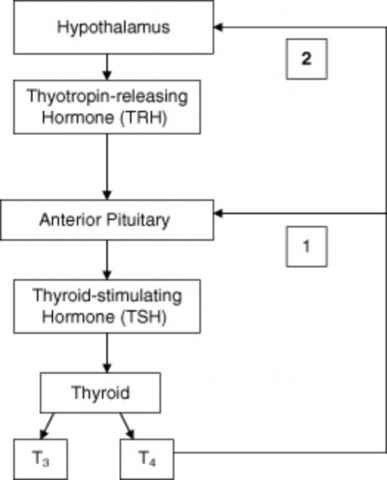
Figure 20.51: Two negative feedback loops exist in the control of thyroid hormone secretion.
(1) shows the loop between the TSH-producing cells of the anterior pituitary and the thyroid. Increased levels of T4 and T3 in the blood cause a reduction in TSH secretion. (2) shows that increased levels of T4 and T3 in the blood cause a reduction in TRH secretion. (16)
www.ck12.org 1072
Positive Feedback
Positive feedback is a reaction in which the system responds in such a way as to speed up the direction of change. Positive feedback mechanisms are not as common as negative feedback mechanisms because they cause an increase in the initial signal, which would tend to knock many systems out of balance. Take for example, the analogy of the home heating system. If this system were to work on a positive feedback loop, the furnace would not switch off when the temperature reached the set point of 21˚C. Instead, it would keep going and heat the room indefinitely.
An example of a positive feedback mechanism is milk production by a mother for her baby, as shown in Figure 20.52. As the baby suckles, nerve messages from the mammary glands cause the hormone prolactin, to be secreted by the mother’s pituitary gland. The more the baby suckles, the more prolactin is released, which stimulates further milk production by the mother’s mammary glands. In this case, a negative feedback loop would be unhelpful because the more the baby nursed, the less milk would be produced. Another example of a positive feedback loop is the blood-clotting cascade that happens after a blood vessel is cut.

Figure 20.52: Production of breast milk is controlled by a positive feedback mechanism. (42)
Hormone Antagonists
Many hormones work with hormone antagonists to control the concentrations of substances in the body. The hormones have opposite actions on the body and so are called antagonistic.
Insulin and glucagon make up an antagonistic hormone pair. The action of insulin is opposite that of glucagon. For example, your blood glucose concentration rises sharply after you eat
1073 www.ck12.org
food that contains simple carbohydrates, such as the blueberry muffins shown in Figure
The increase in blood glucose level stimulates beta cells in the pancreas to release insulin into blood. In response to signals by insulin most body cells take up glucose, which removes it from the blood, and the blood glucose concentration returns to the set point. Later, you have missed eating lunch, you are hungry and feel a little light-headed. Your blood glucose concentration has dropped below the set point, which causes the release of glucagon from the pancreas. Glucagon causes the release of glucose from liver cells, which increases your blood-glucose concentration. If glucagon did not do its job correctly, your blood glucose concentration would continue to drop, and you would develop hypoglycemia (low blood sugar). This antagonistic relationship between the two hormones helps to maintain the narrow range of blood glucose concentration.
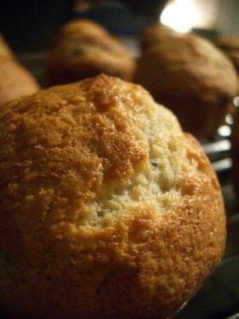
Figure 20.53: Insulin and glucagon work as an antagonistic pair to keep your blood glucose concentration within a narrow range even after you eat food containing carbohydrates, such as a muffin. (10)
The actions of growth hormone releasing hormone (GHRH) are opposed by another hypotha- lamic hormone, somatostatin, also known as ”growth-hormone-inhibiting hormone” (GHIH). Somatostatin and GHRH are secreted alternatively by the hypothalamus, which causes an increase and decrease in the secretion of growth hormone (GH) by the pituitary.
Many endocrine glands also work together as a group to control body processes. The major endocrine glands coordinate the control of various regulatory systems, such as metabolism, osmoregulation, and reproduction. Many individual glands are directly controlled by the nervous system, and all are in some way controlled by the pituitary and hypothalamus. Some of these glands and their hormone products are listed in Table 20.10.
www.ck12.org 1074
Table 20.10: Coordination of the Endocrine Glands in the Control of Body Sys- tems

Function Organ or Glands Hormones Nervous System
Control

Control of the En- docrine System
Hypothalamus Pitu-
itary Gland TSH, FSH, LH, GH, prolactin (PRL)
ANS (sympathetic and parasympa- thetic nervous system)
Regulation of
Adrenocorticotropic hormone
(ACTH)
ANS (sympathetic
Metabolism Thyroid Gland Parathyroid
Glands Pancreas Pineal Gland Liver
Response to Stress Adrenal Glands
Reproduction Gonads (ovaries,
T3 and T4 Parathyroid hor-
mone Insulin Glucagon Melatonin
Epinepherine, norepinepherine, cortisol
and parasympa- thetic nervous system)
ANS (sympathetic nervous system)
ANS (parasym-
Osmoregulation
testes) Androgens (testos- terone), estro- gens,
progestins (proges- terone)
pathetic nervous system)
ANS (sympathetic
Adrenal Glands Kidneys
Liver
Aldosterone ADH
Angiotensin
and parasympa- thetic nervous system)
1075 www.ck12.org
Table 20.10: (continued)

Function Organ or Glands Hormones Nervous System
Control


Homeostatic Imbalance: Endocrine System Disorders
Diseases of the endocrine system are common, and include diseases such as diabetes, thyroid disease, and obesity. An endocrine disease is usually characterized by hyposecretion or hypersecretion of hormones and an inappropriate response to hormone signaling by cells.
Cancer can occur in endocrine glands, such as the thyroid, and some hormones are involved in signaling distant cancer cells to multiply. For example, the estrogen receptor has been shown to be involved in certain types of breast cancers.
Hyposecretion
Hyposecretion is the production no hormone or too little of a hormone. It can be caused by the destruction of hormone-secreting cells, such as in Type 1 diabetes, or by a deficiency in a nutrient that is important for hormone synthesis. Hyposecretion can be treated with hormone-replacement therapies. Type 1 diabetes is an autoimmune disease that results in the destruction of the insulin-producing beta cells of the pancreas. A person with Type 1 diabetes needs insulin replacement therapy, usually by injection or insulin pump, in order to stay alive. An insulin pump is shown in Figure 20.54.
Diabetes insipidus is characterized by excretion of large amounts of very dilute urine, even if liquid intake is reduced. It is caused by an inability of the kidney to concentrate urine due to a lack of antidiuretic hormone (ADH) also called vasopressin, or by an insensitivity of the kidneys to that hormone. Blood glucose levels are not affected in diabetes insipidus.
Growth hormone deficiency is caused by a lack of GH production by the pituitary. GH deficiency affects bone growth development, and people with growth hormone deficiency tend to have, among other things, low bone density and small stature, a condition called pituitary dwarfism. GH deficiency is treated by growth hormone replacement.
Hypothyroidism is the state in which not enough thyroid hormones are made. Thyroiditis is an autoimmune disease where the body’s own antibodies attack the cells of the thyroid and destroy it. Thyroid hormones play an important role in brain development during fetal growth. Cells of the brain are a major target for the T3 and T4 hormones. As a result, hypothyroidism in children, either due to a thyroid problem from birth or a lack of iodine in the diet, is a major cause of physical and mental growth impairment in developing countries. In fact, iodine deficiency disorders are the single most common cause of preventable mental retardation and brain damage in the world.
www.ck12.org 1076
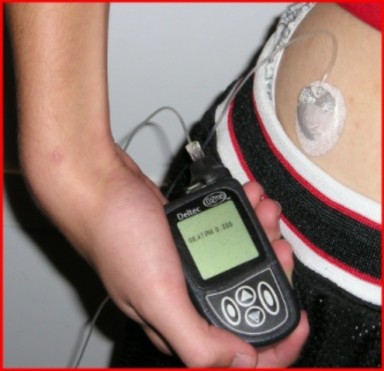
Figure 20.54: In the treatment of Type 1 diabetes, an insulin pump is an alternative to multiple daily injections of insulin. The pump is usually used along with the monitoring of blood glucose concentration and carbohydrate intake. (9)
1077 www.ck12.org
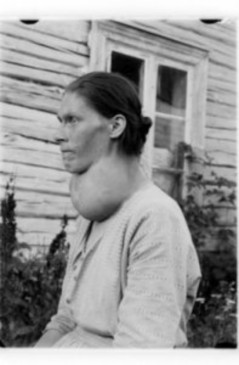
Figure 20.55: There are many causes of goiter, but the most common is the world is iodine deficiency. Today, iodine deficiency remains mostly a problem in poorer countries which lack the means to add iodine to foods. Iodized salt has helped reduce the amount of iodine deficiency in the developed world. Governments of some countries add iodine to cattle feed to ensure that dairy foods will contain iodine. (30)
www.ck12.org 1078
Hypersecretion
Hypersecretion of a hormone happens when the body produces too much of a hormone. A hormone can be hypersecreted if the gland develops a tumor and grows out of control, or if the gland is signaled to produce too much of a hormone.
Hyperthyroidism is the result of excess thyroid hormone production, which causes an over- active metabolism and increased speed of all the body’s processes. Hyperthyroidism is the most common cause of goiter in the developed world, shown in Figure 20.55.
Hypersecretion of growth hormone causes acromegaly. A common cause of acromegaly is a benign tumor of the pituitary glands that releases too much GH. In some cases, acromegaly is also caused by overproduction of the hypothalamus hormone growth hormone release hormone (GHRH). Acromegaly most commonly affects middle-aged adults and can result in serious illness and premature death. Symptoms include enlarged hands and feet, protruding brow and chin, and enlarged internal organs. However, the disease is hard to diagnose in the early stages and is frequently missed for many years due to its slow progression. If the pituitary produced too much GH during childhood, the person will be taller than normal, a condition called pituitary gigantism. Pituitary gigantism is very rare, and some of the tallest people on record had this condition.
Hormone Insensitivity: Type 2 Diabetes
In some cases, the body makes enough hormones, but body cells do not respond. This can be due to missing or defective hormone receptors, or the body cells become resistant to normal concentration of the hormone, and do not respond to it.
Type 2 diabetes is characterized by hyperglycemia (high blood glucose concentrations), body cells that do not respond to normal amounts of insulin (insulin resistance), and the resulting inability of the pancreas to produce enough insulin. Insulin resistance in cells results in high amounts of free fatty acids and glucose in the blood. High plasma levels of insulin and glucose due to insulin resistance often lead to metabolic syndrome and Type 2 diabetes. Type 2 diabetes can be controlled by improving the diet, increasing levels of activity, and sometimes medication.
Gestational diabetes is a form of diabetes that affects pregnant women. There is no known single cause, but it’s believed that the hormones produced during pregnancy reduce the ability of the cells in the pregnant woman’s body to respond to insulin, which results in high blood glucose concentrations.
1079 www.ck12.org
Hormones as Medicines
Many hormones and molecules like them are used as medicines. The most common type of therapy is called hormone-replacement therapy. The most commonly-prescribed hor- mones are estrogens and synthetic progesterone (as methods of hormonal contraception and as HRT therapy for post-menopausal women), thyroxine (as levothyroxine, for hypothy- roidism) and corticosteroids (for autoimmune diseases and several respiratory disorders). Progestin, a synthetic progesterone, is also used to prolong pregnancy in women who have experienced a miscarriage due to a premature drop in progesterone levels. Hydrocortisone is a synthetic form of cortisol that is used to treat allergies and inflammation as well as cortisol production deficiencies. Hydrocortisone cream is a common over-the-counter medication for the topical treatment of rash. Insulin is used by many people with diabetes.
Epinephrine
Because of its anti inflammatory effect on the immune system, epinephrine is used to treat anaphylaxis. Anaphylaxis is a sudden and severe allergic reaction that involves the entire body. After an initial exposure to a substance like a certain food (such as peanuts), or bee sting, a person’s immune system can becomes sensitized to that substance, which is called an allergen. Upon second exposure, an allergic reaction occurs.

Figure 20.56: An EpiPen® epinephrine autoinjector. Auto injectors like this one can help save a person’s life during an anaphylactic reaction. (4)
Histamine and other substances that are released by body cells cause the blood vessels to dilate, which lowers blood pressure, and fluid to leak from the bloodstream into the tissues, which lowers the blood volume. The release of histamine causes the face and tongue to swell. Swelling of the lining of the throat can lead to breathing difficulties. The hormone epinephrine causes blood vessels to constrict which reduces swelling and causes blood pressure to increase. Epinephrine is used as a medicine in auto-injectors, shown in Figure 20.56, which a person can use themselves should they have an anaphylactic reaction.
Anabolic Androgenic Steroids
Synthetic androgens, in the form of anabolic androgenic steroids (anabolic steroids), have many medical uses. It is used to stimulate bone growth and appetite, induce puberty in boys,
www.ck12.org 1080
and treat muscle-wasting conditions in patients that have diseases such as cancer and AIDS. In general, androgens, including testosterone, promote protein synthesis and the growth of muscle tissue and other tissues that have androgen receptors. Androgens also block the effects of the stress hormone cortisol on muscle tissue, so the breakdown of muscle is greatly reduced.

Figure 20.57: Athletes involved in sports that emphasize strength, weight, and shape may feel pressure to take anabolic steroids, however, the majority of school athletes do not take them. (40)
Anabolic Steroid Abuse
As a result of their muscle-building action, anabolic steroids are used in sport and bodybuild- ing to increase muscle size and strength, to gain a competitive edge or to assist in recovery from injury. Steroids used to gain competitive advantage are forbidden by the rules of the governing bodies of many sports. Serious health risks can be produced by long-term use or excessive doses of anabolic steroids. Most of these side effects are dose dependent, the most common being an increase in low density lipoprotein (bad cholesterol), and a decrease in good high density lipoprotein (good cholesterol). Anabolic steroids also increase the risk of cardiovascular disease in men with high risk of bad cholesterol. Acne is fairly common among anabolic steroid users, mostly due to increases in testosterone which stimulates the sebaceous glands to produce more oil. High doses of anabolic steroids have been linked to liver damage.
Teenagers, particularly boys, who take anabolic steroids, are more likely to be involved in sports that emphasize weight and shape, (such as football or wrestling, which is shown in Figure 20.57). Such teens also have higher rates of disordered eating, drug abuse, and generally have poorer attitudes towards health. Severe side effects can occur if a teenager
1081 www.ck12.org
uses anabolic steroids. For example, the steroids may prematurely stop the lengthening of bones, resulting in stunted growth. Other effects include, but are not limited to, accelerated bone maturation, increased acne outbreaks, and premature sexual development.
In addition to dangerous side effects of the steroids themselves, dangerous drug-taking habits that have been reported by abusers include: unsafe injection practices such as reusing needles, sharing needles, and sharing multidose vials. A common practice among anabolic steroid abusers is self–medicating with other hormones such as growth hormone and insulin, which in itself can lead to serious health consequences. Testosterone and other anabolic steroids are classified as a controlled substance in the United States (US), Canada, the United Kingdom (UK), Australia, Argentina, and Brazil.
Lesson Summary
The endocrine system is a system of organs that release hormones into the blood. Unlike the nervous system whose action helps the body react immediately to change, the endocrine system controls changes that happen to the body over a long period of time.
Hormones are made and secreted by cells in endocrine glands. The body produces many different hormones, but each hormone is very specific for its target cells.
The hypothalamus links the nervous system to the endocrine system by the pituitary gland. The pituitary gland secretes hormones that regulate homeostasis and also se- cretes hormones that stimulate other endocrine glands. Together the two glands serve as the major control centers of the endocrine system.
The ovaries of females and the testes of males are the gamete producing organs, or gonads. In addition to producing gametes, an exocrine action, the gonads are endocrine glands that produce steroid sex hormones.
The rate of hormone production and secretion is often regulated by homeostatic feed- back control mechanisms, and the effect of hormones is controlled by hormone antag- onists. In these ways, the concentration of hormones and their products is kept within a narrow range so as to maintain life.
A feedback control mechanism, or a feedback loop, is a signaling system in which a product or effect of the system controls an earlier part of the system, either by shutting the process down or speeding it up.
Diseases of the endocrine system are common, and include diseases such as diabetes, thyroid disease, and obesity. Many hormones and hormone-like molecules are used as medicines. The most common type of therapy is called hormone-replacement therapy.
Review Questions
How does a hormone initially activate a target cell?
What is the main difference between the locations of the receptors for amino acid-based www.ck12.org 1082
hormones and steroid-based hormones?
List five main endocrine glands, and identify their locations.
Name the two glands that control the nervous system.
Name three hormones that are involved in the stress response and identify their func- tion.
Outline the role of the parathyroid glands in regulation of blood calcium levels.
What hormone is secreted by the pineal gland, and what is the function of the hormone?
How do feedback mechanisms help maintain homeostasis?
How does negative feedback differ from positive feedback?
Identify an antagonistic pair of hormones and describe their action.
Why do you think the pituitary has two lobes?
What is the purpose of hormone replacement therapy?
Why might a problem with the pituitary gland affect many different parts of the body?
Your friend says that he’s pretty sure that the adrenal medulla is controlled by hor- mones from the pituitary. Do you agree? Explain your answer.
Outline the feedback mechanism involved in glucose metabolism. Is this feedback mechanism positive or negative?
Positive feedback mechanisms are harmful to the body. Do you agree with this state- ment? Explain your answer.
Goiter is a swelling of the thyroid gland, which is commonly caused by a lack of iodine in the diet. Why do you think a lack of iodine causes the thyroid to swell?
Use the image of the feedback mechanisms to answer the two questions that follow.
Identify four hormones involved in these feedback mechanisms.
Further Reading / Supplemental Links
Anatomy and Physiology © 2002. Published by Benjamin Cummings, a part of Pearson Education Inc. Elaine N. Marieb.
Human Anatomy ©2003 by Fredric H. Martini, Inc. and Michael J.Timmons. Pub- lished by Pearson Education, Inc.
Biology © 2002 6th Edn. Authors: Campbell and Reese. Published by Benjamin Cummings.
Adapted from abstract: Anabolic Androgenic Steroids: A Survey of 500 Users Andrew
B. Parkinson; Nick A. Evans (Medicine and Science in Sports and Exercise) at
http://www.medscape.com/viewarticle/533461
Adapted from:
http://www.ncbi.nlm.nih.gov/sites/entrez?cmd=Retrieve&db=pubmed&# 38;amp;dopt=AbstractPlus&list_uids=11927236
http://www.lcsc.edu/healthocc/enable03/glands/03072_3.htm
http://web.indstate.edu/thcme/mwking/peptide-hormones.html#receptors
http://web.indstate.edu/thcme/mwking/steroid-hormones.html
http://www.ncbi.nlm.nih.gov/sites/entrez?cmd=Retrieve&db=pubmed&#
1083 www.ck12.org
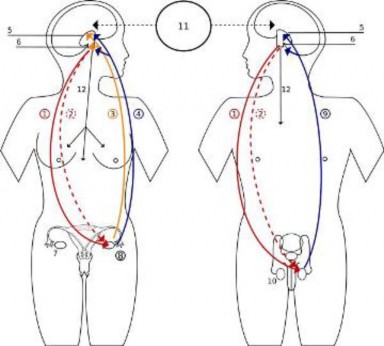
Figure 20.58: Identify three endocrine glands are involved in the feedback mechanisms shown in the figure. (12)
38;amp;dopt=AbstractPlus&list_uids=15589268
http://www.nlm.nih.gov/medlineplus/ency/article/000844.htm#Definition
http://www.hormone.org/
http://www.hormone.org/
http://www.nlm.nih.gov/medlineplus/endocrinesystem
http://health.nih.gov/search.asp/24
http://www.askabiologist.org.uk/
http://en.wikipedia.org
Vocabulary
amino acid-based hormones Hormones made of amino acids; not fat-soluble and there- fore cannot diffuse through the plasma membrane of their target cell; usually bind to receptors that are found on the cell membrane.
antagonistic Hormones that have opposite actions on the body, such as insulin and glucagons.
cholesterol-based hormones Hormones made of lipids such as phospholipids and choles- terol; also called steroid hormones; are fat soluble and are able to diffuse through the
www.ck12.org 1084
plasma membrane; bind to receptors that are found within the cell cytosol and nucleus.
circadian rhythm A roughly-24-hour cycle in the biological processes carried out within organisms, including plants, animals, fungi and certain bacteria.
cortisol A steroid hormone produced by the adrenal glands; often called the ”stress hor- mone” as it is involved in the body’s response to stress; increases blood pressure, blood sugar levels and has an immunosuppressive action.
direct gene activation A system in which a fat-soluble hormone diffuses across the mem- brane and binds to the receptor within the cytosol or nucleus. The hormone-receptor complex then acts as a transcription factor that affects gene expression.
endocrine glands Ductless organs that make and secrete hormones directly into the blood or the fluid surrounding a cell rather than through a duct.
endocrine system A system of organs that releases chemical message molecules, called hormones, into the blood.
exocrine glands Organs that secrete their products into ducts (they are duct glands); do not secrete hormones; secrete products such as water, mucus, enzymes, and other proteins through ducts to specific locations inside and outside the body.
feedback control mechanism A signaling system in which a product or effect of the system controls an earlier part of the system, either by shutting the process down or speeding it up; also known as a feedback loop.
glucagon An important hormone involved in carbohydrate metabolism; released when the glucose level in the blood is low which causes the liver to change stored glycogen into glucose and release it into the bloodstream.
gonads The gamete producing organs; the ovaries of females and the testes of males.
hormone-like substances Refers to a group of signaling molecules that are derived from certain types of fatty acids and proteins.
hormones Chemical messenger molecules that are made by cells in one part of the body and cause changes in cells in another part of the body.
hypersecretion The production of too much of a hormone.
1085 www.ck12.org
hyposecretion The production of no hormone or too little of a hormone.
hypothalamus Area of the brain that coordinates many seasonal and circadian rhythms, complex homeostatic mechanisms, and the autonomic nervous system (ANS).
islets of Langerhans Areas of the pancreas with groupings of endocrine cells; produce the amino acid-based hormones insulin, glucagon, and somatostatin.
negative feedback A reaction in which the system responds in such a way as to reverse the direction of change.
neuropeptides Hormone-like substance; signaling peptides found in nervous tissue.
positive feedback A reaction in which the system responds in such a way as to speed up the direction of change.
prostaglandins Hormone-like substance made from essential fatty acids; produced by most cells in the body; have many different effects such as causing constriction or dilation of blood vessels but they are all are localized within the target cells and tis- sues.
puberty The process of physical changes during which the sex organs mature and a person become capable of reproducing.
second messenger system A system in which a water-soluble hormone molecule does not enter the cell, instead it binds to the membrane-bound receptor molecule, which triggers changes within the cell. These changes are activated by second messenger molecules.
sex hormones Hormones that are responsible for the secondary sex characteristics that develop at puberty.
signal transduction pathway Process initiated by the binding of a hormone to its re- ceptor; a process of molecular changes that turns the hormone’s extracellular signal into an intracellular response.
target cell The cell on which a hormone has an effect; has receptor proteins that are specific to the hormone.
www.ck12.org 1086
Points to Consider
Think about some of the problems people may have to their muscular systems if their nervous system is not functioning correctly.
Propose what would happen if the hypothalamus did not produce ADH.
Why are negative feedback loops more common than positive feedback loops?
Image Sources
http://www.flickr.com/photos/valeriebb/295872714/. CC-BY 2.0.
adobemac. http://www.flickr.com/photos/adobemac/257761265/in/photostream/. CC-BY-SA 2.0.
http://en.wikipedia.org/wiki/Image: Medulla_spinalis_-_Section_-_English.svg. CC-BY-SA.
Sean William. http://commons.wikimedia.org/wiki/Image:Epipen.jpg. GNU-FDL.
The major organs of the endocrine system.. Public Domain.
http://en.wikipedia.org/wiki/Image:Focus_in_an_eye.svg. CC-BY-SA 2.5.
http://commons.wikimedia.org/wiki/Image:Brainlobes.png. Public Domain.
http://en.wikipedia.org/wiki/Image:
Human_eye_cross-sectional_view_grayscale.png. Public Domain.
M. Bradford. http://en.wikipedia.org/wiki/Image:Insulin_pump_with_infusion_set.jpg. Public Domain.
Pansonaut. http://www.flickr.com/photos/pansonaut/208125336/. CC-BY- SA-2.0.
http://commons.wikimedia.org/wiki/Image:Pancreaticislet.jpg. CC-BY-SA.
http://commons.wikimedia.org/wiki/Image:
Hormons_feedback_-_Sprz%C4%99%C5%BCenie_zwrotne_hormonow.svg. GNU-FDL.
Niamh Gray-Wilson. . CC-BY-SA.
http://www.flickr.com/photos/sfllaw/509150616/. CC-BY-SA 2.0.
1087 www.ck12.org
Smoke: A Global History of Smoking.
Niamh Gray-Wilson. . CC-BY-SA.
http://training.seer.cancer.gov/anatomy/endocrine/glands/adrenal.html. Public Domain.
http://commons.wikimedia.org/wiki/Image:Hypothalamus.jpg. Public Domain.
http://commons.wikimedia.org/wiki/Image: Skull_and_brainstem_inner_ear.svg. CC-BY 2.5.
http://en.wikipedia.org/wiki/Image:SynapseIllustration2.png. CC-BY-SA.
http://www.flickr.com/photos/pete/13059185/. CC-BY-SA-2.0.
http://commons.wikimedia.org/wiki/Image:Nervous_system_diagram.png. Public Domain.
The detection of sound by your ear.. Public Domain.
http://en.wikipedia.org/wiki/Image:User-FastFission-brain-frame44.png. GNU-FDL.
http://commons.wikimedia.org/wiki/Image:Gray770.png. Public Domain.
http://www.flickr.com/photos/marklarson/418292246/. CC-BY-SA 2.0.
http://commons.wikimedia.org/wiki/File: Complete_neuron_cell_diagram_en.svg. Public Domain.
http://en.wikipedia.org/wiki/Image:Central_nervous_system.svg#en. Public Domain.
http://commons.wikimedia.org/wiki/Image:Synapse_diag3.png. CC-BY-SA.
Martin Finborud. http://en.wikipedia.org/wiki/Image:Kone_med_stor_struma.jpg. Public Domain.
http://commons.wikimedia.org/wiki/Image:Neuron.svg. GNU-FDL 1.2.
http://en.wikipedia.org/wiki/Image:Brain_lateral_view.svg. CC-BY-SA-2.5.
CK-12 Foundation. . CC-BY-SA.
http://www.flickr.com/photos/hourann/454064419/. CC-BY-SA.
http://www.flickr.com/photos/bike/248030261/. CC-BY-SA 2.0. www.ck12.org 1088
USFG. http://en.wikipedia.org/wiki/Image:Illu_thyroid_parathyroid.jpg. Public Domain.
http://www.flickr.com/photos/abdelazer/528578931/. CC-BY-SA 2.0.
CK12 Foundation. . CC-BY-SA.
http://commons.wikimedia.org/wiki/Image:IonChannels.jpg. Public Domain.
washer_dreier. http://www.flickr.com/photos/washer/314535942/. CC-BY-SA-2.0.
Pituitary gland: http:
//training.seer.cancer.gov/module_anatomy/unit6_1_endo_intro.html. Public Domain.
Nabeel H. http://www.flickr.com/photos/nabeel/16876576/. CC-BY-SA 2.0.
Gray’s Anatomy. http://en.wikipedia.org/wiki/Image:Gray720.png. Public Domain.
http://en.wikipedia.org/wiki/Image:Action_potential_vert.png. GNU-FDL.
http://www.flickr.com/photos/mahalie/144905384/. CC-BY-SA-2.0.
http://commons.wikimedia.org/wiki/Image:Head_olfactory_nerve.jpg. CC-BY 2.5.
http://commons.wikimedia.org/wiki/Image:Synapse_diag4.png. GNU-FDL.
http://en.wikipedia.org/wiki/Image:Tongue.agr.jpg. GNU-FDL.
http://www.flickr.com/photos/crucifixioncruise/1195949382/. CC-SA-BY.
LadyofHats. http://en.wikipedia.org/wiki/File:Gap_cell_junction_en.svg. Public Domain.
http://training.seer.cancer.gov/anatomy/endocrine/glands/pancreas.html. Public Domain.
http://en.wikipedia.org/wiki/Image:Action_potential_vert.png. GNU-FDL.
http://www.flickr.com/photos/laurelfan/765440395/. CC-BY-SA.
http://en.wikipedia.org/wiki/Image:Reuptake_both.png. Public Domain.
http://www.flickr.com/photos/cliche/120050450/. CC-BY-SA-2.0.
1089 www.ck12.org
http://commons.wikimedia.org/wiki/File: Complete_neuron_cell_diagram_en.svg. CC-BY-SA.
http://en.wikipedia.org/wiki/Image:Brain_limbicsystem.jpg. Public Domain.
Aaron Jacobs. http://www.flickr.com/photos/aaronjacobs/64657662/. CC- By-SA 2.0.
www.ck12.org 1090
Skeletal, Muscular, and Integumentary Systems
Lesson 21.1: Skeletal System
Lesson Objectives
Identify the functions and structure of bones.
Differentiate between the axial skeleton and appendicular skeleton.
Distinguish between spongy bone and compact bone.
Outline the process of osteogenesis (bone formation), and how bones grow.
Classify bones based on their shape.
Identify three types of joints that are in the body, and give an example of each.
Identify three disorders that result from homeostatic imbalances of bones or the skele- ton.
Introduction
How important is your skeleton? Can you imagine what you would look like without it?
You would be a wobbly pile of muscle and internal organs, maybe a little similar to the slug in Figure 21.1. Not that you would really be able to see yourself anyway, due to the folds of skin that would droop over your eyes because of your lack of skull bones. You could push the skin out of the way, if you could only move your arms!
1091 www.ck12.org
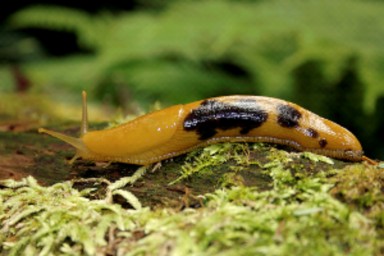
Figure 21.1: Banana slugs (Ariolimax spp.), unlike you, can live just fine without a bony skeleton. They can do so because they are relatively small and their food source (vegetation) is plentiful and tends not to run away from them. Slugs move by causing a wave-like motion in their foot, (the ventral (bottom) area of the slug that is in contact with the ground). Slugs and other gastropods also live in environments very different to humans’ environments. Just think of how a bony skeleton would be of limited use to a slug whose lifetime is spent under a log munching on rotting leaf litter. (6)
www.ck12.org 1092
The Skeleton
Humans are vertebrates, which are animals that have a vertebral column, or backbone. Invertebrates, like the banana slug in Figure 21.1, do not have a vertebral column, and use a different mechanism than vertebrates to move about. The sturdy internal framework of bones and cartilage that is found inside vertebrates, including humans, is called an endoskeleton. The adult human skeleton consists of approximately 206 bones, some of which are named in Figure 21.2. Cartilage, another component of the skeleton can also be seen in Figure 21.2. Cartilage is a type of dense connective tissue that is made of tough protein fibers. The function of cartilage in the adult skeleton is to provide smooth surfaces for the movement of bones at a joint. A ligament is a band of tough, fibrous tissue that connects bones together. Ligaments are not very elastic and some even prevent the movement of certain bones.
The skeletons of babies and children have many more bones and more cartilage than adults have. As a child grows, these “extra” bones, such as the bones of the skull (cranium), and the sacrum (tailbone) fuse together, and cartilage gradually hardens to become bone tissue.
The bones of the skeleton can be grouped in two divisions: the axial skeleton and appen- dicular skeleton. The axial skeleton includes the bones of the head, vertebral column, ribs and sternum, in the left portion of Figure 21.3. There are 80 bones in the axial skeleton. The appendicular skeleton includes the bones of the limbs (arms and legs) along with the scapula and the pelvis, and is shown at right in Figure 21.3. There are approximately 126 bones in the appendicular skeleton. Limbs are connected to the rest of the skeleton by collections of bones called girdles. The pectoral girdle consists of the clavicle (collar bone) and scapula (shoulder blade). The pelvic girdle consists of two pelvic bones (hipbones) that form the pelvic girdle. The vertebral column attaches to the top of the pelvis; the femur of each leg attaches to the bottom. The humerus is joined to the pectoral girdle at a joint and is held in place by muscles and ligaments.
Function and Structure of Bones
Many people think of bones as dry, dead, and brittle, which is what you might think if you saw a preserved skeleton in a museum. The association of bones with death is illustrated by the sweets shown in Figure 21.4. This is a common association because the calcium-rich bone tissue of a vertebrate is the last to decompose after the organism dies. However, the bones in your body are very much alive. They contain many tough protein fibers, are crisscrossed by blood vessels, and certain parts of your bones are metabolically active. Preserved laboratory skeletons are cleaned with chemicals that remove all organic matter from the bones, which leaves only the calcium-rich mineralized (hardened) bone tissue behind.
1093 www.ck12.org
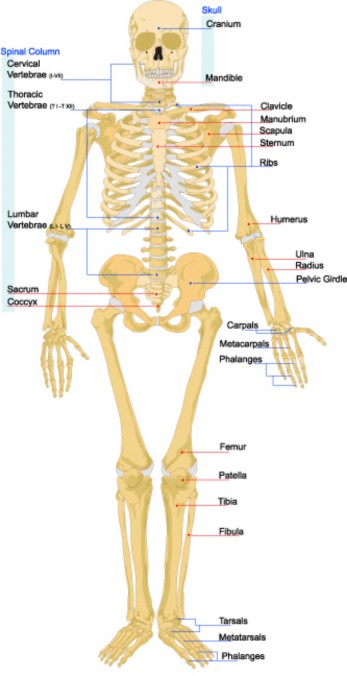
Figure 21.2: The skeleton is the bone and cartilage scaffolding that supports the body, and allows it to move. Bones act as attachment points for the muscles and tendons that move the body. Bones are also important for protection. For example, your skull bones (cranium) protect your brain, and your ribcage protects your heart and lungs. Cartilage is the light- gray material that is found between some of the bones and also between the ribcage and sternum. (35)
www.ck12.org 1094

Figure 21.3: The two divisions of the human skeleton. The bones of the axial skeleton are blue, and the bones of the appendicular skeleton are pink. (27)
1095 www.ck12.org
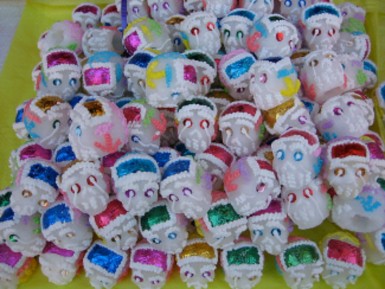
Figure 21.4: Sugar skulls made to celebrate Dia de Los Muertos (Day of the Dead), a time (the 1st and 2nd of November) during which the people of Mexico and some Latin American countries celebrate and honor the lives of the deceased, and celebrate the continuation of life. (11)
Functions of Bones
As you read earlier in this lesson, your skeletal system is important for the proper functioning of your body. In addition to giving shape and form to the body, bones have many important functions.
The main functions of bones are:
Structural Support of the Body: The skeleton supports the body against the pull of gravity. The large bones of the lower limbs support the trunk when standing.
Protection of Internal Organs: The skeleton provides a rigid frame work that supports and protects the soft organs of the body. The fused bones of the cranium surround the brain to make it less vulnerable to injury. Vertebrae surround and protect the spinal cord and bones of the rib cage help protect the heart and lungs.
Attachment of the Muscles: The skeleton provides attachment surfaces for muscles and tendons which together enable movement of the body.
Movement of the Body: Bones work together with muscles as simple mechanical lever systems to produce body movement.
Production of Blood Cells: The formation of blood cells takes place mostly in the interior (marrow) of certain types of bones.
Storage of Minerals: Bones contain more calcium than any other organ in the form of calcium salts such as calcium phosphate. Calcium is released by the bones when blood
www.ck12.org 1096
levels of calcium drop too low. Phosphorus is also stored in bones.
Structure of Bones
Although bones vary greatly in size and shape, they all have certain structural similarities. Bones are organs.Recall that organs are made up of two or more types of tissues. The two main types of bone tissue are compact bone and spongy bone. Compact bone makes up the dense outer layer of bones. Spongy bone is lighter and less dense than compact bone, and is found toward the center of the bone. Periosteum (from peri = around, osteo = bone),is the tough, shiny, white membrane that covers all surfaces of bones except at the joint surfaces. Periosteum is composed of a layer of fibrous connective tissue and a layer of bone forming cells. These structures can be seen in Figure 21.5.
Compact Bone
Just below the periosteum is the hard layer of compact bone tissue. It is so called due to its high density, and it accounts for about 80% of the total bone mass of an adult skeleton. Compact bone is extremely hard, and is made up of many cylinder-shaped units called osteons, or Haversian systems. Osteons act like strong pillars within the bone to give the bone strength and allow it to bear the weight of the attached muscles and withstand the stresses of movement. As you can see in Figure 21.6, osteons are made up of rings of calcium salts and collagen fibers, called bone matrix. Bone matrix is a mixture of calcium salts, such as calcium phosphate and calcium hydroxide, and collagen fibers (a type of protein) which form hollow tubes that look similar to the rings on a tree. Each of these matrix tubes is a lamella, which means “thin plate” (plural: lamellae). The calcium salts form crystals that give bones great strength, but the crystals do not bend easily, and tend to shatter if stressed. Collagen fibers are tough and flexible. All collagen fibers within a single lamella are lined up in the same direction, which gives each lamella great strength. Overall, the protein-calcium crystal combination in the matrix allows bones to bend and twist without breaking easily. The collagen fibers also act as a scaffold for the laying down of new calcium salts.
In the center of each osteon is a Haversian canal. The canal serves as a passageway for blood vessels and nerves. Within each osteon, many bone cells called osteocytes are located. Osteocytes are found in little pockets called lacunae that are sandwiched between layers of bone matrix. You can see lamellae and osteocytes in their lacunae in Figure 7b. Osteocytes are responsible for monitoring the protein and mineral content of the bone and they direct the release of calcium into the blood and the uptake up of calcium salts into the bone. Other bone cells, called osteoblasts secrete the organic content of matrix, and are responsible for the growth of new bone. Osteoblasts are found near the surface of bones. Osteoclasts are bone cells that remove calcium salts from bone matrix. These bone cells will be discussed in further detail later in this lesson. In the meantime, Table 21.1 describes
1097 www.ck12.org
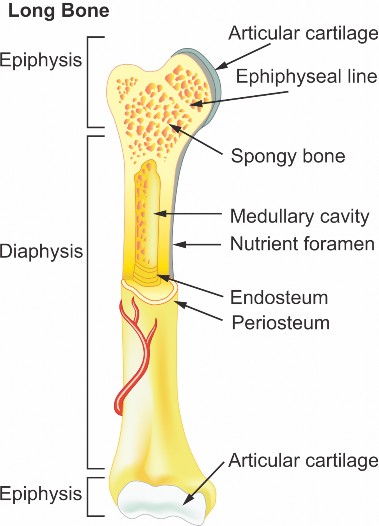
Figure 21.5: Structure of a typical bone. The components that make up bones can be seen here. Compact bone is the dense material that makes up the outer ring of the bone. Most bones of the limbs are long bones, including the bones of the fingers. The classification of “long bone” refers to the shape of the bone rather than to the size. (7)
www.ck12.org 1098
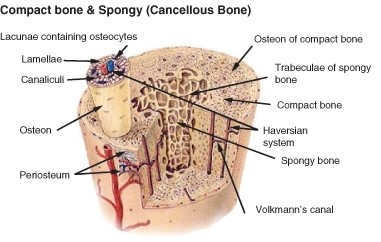
Figure 21.6: The internal structure of a bone. Both compact and spongy bone can be seen. (22)
some of the different structures and functions of bones.
Table 21.1: The Structure of Bones

Function Location

Osteons (also known as Haversian systems)
Act like pillars to give bone strength
Compact bone
Bone matrix A mixture of calcium salts
and collagen fibers which form hollow tubes that look similar to the rings on a tree
Lamella Layers of bone matrix in
which collagen fibers point in the opposite direction to the fibers of the lamellae to each side, offers great strength and flexibility
Compact bone, spongy bone
Are the “tree rings” of os- teons
Lacunae Location of osteocytes Between lamellae of bone
matrix
Osteocytes Monitor the protein and mineral content of bone and direct the release of calcium into the blood; control the uptake up of calcium salts into the bone
Within lacunae of osteons
1099 www.ck12.org
Table 21.1: (continued)

Function Location

Osteoblasts Bone-forming cell; secretes organic part of matrix (col- lagen)
Osteoclasts Responsible for the break- down of matrix and release of calcium salts into the blood.
Chondrocyte Cartilage-forming cell
Periosteum Contains pain receptors and is sensitive to pressure or stress; provides nourishment through a good the blood supply; provides an attach- ment for muscles and ten- dons
Collagen fibers Tough protein fibers that give bones flexibility and prevent shattering.
Calcium salts Form crystals that give bones great strength.
Found near the surface of bones
Bone surfaces

Spongy Bone
Spongy bone occurs at the ends of long bones and is less dense than compact bone. The term “spongy” refers only to the appearance of the bone, as spongy bone is quite strong. The lamellae of spongy bone form an open, porous network of bony branches, or beams called trabiculae, that give the bone strength and make the bone lighter. It also allows room for blood vessels and bone marrow. Spongy bone does not have osteons, instead nutrients reach the osteocytes of spongy bone by diffusion through tiny openings in the surface of the spongy bone. Spongy bone makes up the bulk of the interior of most bones, including the vertebrae.
Bone Marrow
Many bones also contain a soft connective tissue called bone marrow. There are two types of bone marrow: red marrow and yellow marrow. Red marrow produces red blood cells, platelets, and most of the white blood cells for the body. Yellow marrow produces white
www.ck12.org 1100
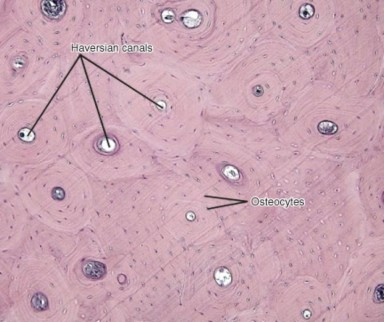
Figure 21.7: The location of Haversian canals and osteocytes in osteons of compact bone. (42)
blood cells. The color of yellow marrow is due to the high number of fat cells it contains. Both types of bone marrow contain numerous blood vessels and capillaries. In newborns, bones contain only red marrow. As the child ages, red marrow is mostly replaced by yellow marrow. In adults, red marrow is mostly found in the flat bones of the skull, the ribs, the vertebrae and pelvic bones. It is also found between the spongy bone at the very top of the femur and the humerus.
Periosteum
The outer surfaces of bones—except where they make contact with other bones at joints—are covered by periosteum. Periosteum has a tough, external fibrous layer, and an internal layer that contains osteoblasts (the bone-growing cells). The periosteum is richly supplied with blood, lymph and nociceptors, which make it very sensitive to manipulation (recall that nociceptors are pain receptors that are also found in the skin and skeletal muscle). Periosteum provides nourishment to the bone through a rich blood supply. The periosteum is connected to the bone by strong collagen fibers called Sharpey’s fibres, which extend into the outer lamellae of the compact bone.
1101 www.ck12.org
Bone Shapes
The four main types of bones are long, short, flat, and irregular. The classification of a bone as being long, short, flat, or irregular is based on the shape of the bone rather than the size of the bone. For example, both small and large bones can be classified as long bones. There are also some bones that are embedded in tendons, these bones tend to be oval-shaped and are called sesamoid bones.
Long Bones: Bones that are longer than they are wide are called long bones. They consist of a long shaft with two bulky ends. Long bones are primarily made up of compact bone but may also have a large amount of spongy bone at both ends. Long bones include bones of the thigh (femur), leg (tibia and fibula), arm (humerus), forearm (ulna and radius), and fingers (phalanges). The classification refers to shape rather than the size.
Short Bones: Short bones are roughly cube-shaped, and have only a thin layer of
compact bone surrounding a spongy interior. The bones of the wrist (carpals) and ankle (tarsals) are short bones, as are the sesamoid bones (see below).
Sesamoid Bones: Sesamoid bones are embedded in tendons. Since they act to hold
the tendon further away from the joint, the angle of the tendon is increased and thus the force of the muscle is increased. An example of a sesamoid bone is the patella (kneecap).
Flat Bones: Flat bones are thin and generally curved, with two parallel layers of
compact bones sandwiching a layer of spongy bone. Most of the bones of the skull (cranium) are flat bones, as is the sternum (breastbone).
Irregular Bones: Irregular bones are bones that do not fit into the above categories.
They consist of thin layers of compact bone surrounding a spongy interior. As implied by the name, their shapes are irregular and complicated. The vertebrae and pelvis are irregular bones.
All bones have surface markings and characteristics that make a specific bone unique. There are holes, depressions, smooth facets, lines, projections and other markings. These usually represent passageways for vessels and nerves, points of articulation with other bones or points of attachment for tendons and ligaments.
Cellular Structure of Bone
When blood calcium levels decrease below normal, calcium is released from the bones so that there will be an adequate supply for metabolic needs. When blood calcium levels are increased, the excess calcium is stored in the bone matrix. The dynamic process of releasing and storing calcium goes on almost continuously, and is carried out by different bone cells.
There are several types of bone cells. www.ck12.org 1102
Osteoblasts are bone-forming cells which are located on the inner and outer surfaces of bones. They make a collagen-rich protein mixture (called osteoid), which mineralizes to become bone matrix. Osteoblasts are immature bone cells. Osteoblasts that become trapped in the bone matrix differentiate into osteocytes. The osteocytes stop making osteoid and instead direct the release of calcium from the bones and the uptake of calcium from the blood.
Osteocytes originate from osteoblasts which have migrated into and become trapped
and surrounded by bone matrix which they themselves produce. The spaces which they occupy are known as lacunae. Osteocytes are star-shaped, and they have many processes which reach out to meet osteoblasts probably for the purposes of communi- cation. Their functions include matrix maintenance and calcium homeostasis. They are mature bone cells. Refer to Figure 21.7 for the location of osteocytes.
Osteoclasts are the cells responsible for bone resorption, which is the remodeling of
bone to reduce its volume (see below). Osteoclasts are large cells with many nuclei, and are located on bone surfaces. They secrete acids which dissolve the calcium salts of the matrix, releasing them into the blood stream. This causes the calcium and phosphate concentration of the blood to increase. Osteoclasts constantly remove minerals from the bone, and osteoblasts constantly produce matrix that binds minerals into the bone, so both of these cells are important in calcium homeostasis.
Bone Cells and Calcium Homeostasis
Remodeling or bone turnover is the process of resorption of minerals followed by replacement by bone matrix which causes little overall change in the shape of the bone. This process occurs throughout a person’s life. Osteoblasts and osteoclasts communicate with each other for this purpose. The purpose of remodeling is to regulate calcium homeostasis, repair micro-damaged bones (from everyday stress), and also to shape the skeleton during skeletal growth.
The process of bone resorption by the osteoclasts releases stored calcium into the systemic circulation and is an important process in regulating calcium balance. As bone formation actively fixes circulating calcium in its mineral form, removing it from the bloodstream, resorption actively unfixes it thereby increasing circulating calcium levels. These processes occur in tandem at site-specific locations.
Development of Bones
The terms osteogenesis and ossification are often used to indicate the process of bone forma- tion. The skeleton begins to form early in fetal development. By the end of the eighth week after conception, the skeletal pattern is formed by cartilage and connective tissue membranes. At this point, ossification begins.
1103 www.ck12.org
Early in fetal development, the skeleton is made of cartilage. Cartilage is a type of dense connective tissue that is composed of collagen fibers and/or elastin fibers, and cells called chondrocytes which are all set in a gel-like substance called matrix. Cartilage does not con- tain any blood vessels so nutrients diffuse through the matrix to the chondrocytes. Cartilage serves several functions, including providing a framework upon which bone deposition can begin and supplying smooth surfaces for the movement of bones at a joint, such as the cartilage shown in Figure 21.8.
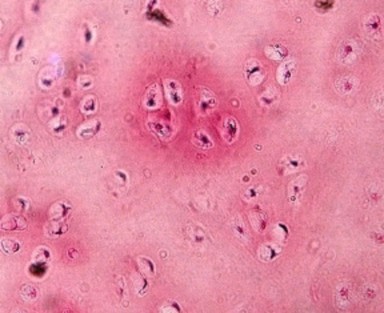
Figure 21.8: A micrograph of the structure of hyaline cartilage, the type of cartilage that is found in the fetal skeleton and at the ends of mature bones. (32)
The bones of the body gradually form and harden throughout the remaining gestation period and for years after birth in a process called endochondrial ossification. However, not all parts of the fetal cartilage are replaced by bone, cartilage remains in many places in the body including the joints, the rib cage, the ear, the tip of the nose, the bronchial tubes and the little discs between the vertebrae.
Endochondral Ossification
Endochondral ossification is the process of replacing cartilage with bony tissue, as shown in Figure 21.9. Most of the bones of the skeleton are formed in this way. During the third month after conception, blood vessels form and grow into the cartilage, and transport osteoblasts and stem cells into the interior which change the cartilage into bone tissue. The osteoblasts form a bone collar of compact bone around the central shaft (diaphysis) of the bone. Osteoclasts remove material from the center of the bone, and form the central cavity
www.ck12.org 1104
of the long bones. Ossification continues from the center of the bone toward the ends of the bones.
The cartilage at the ends of long bones (the epiphyses) continues to grow so the developing bone increases in length. Later, usually after birth, secondary ossification centers form in the epiphyses, as shown in Figure 21.9. Ossification in the epiphyses is similar to that in the center of the bone except that the spongy bone is kept instead of being broken down to form a cavity. When secondary ossification is complete, the cartilage is totally replaced by bone except in two areas. A region of cartilage remains over the surface of the epiphysis as articular cartilage and another area of cartilage remains inside the bone at either end. This area is called the epiphyseal plate or growth region.
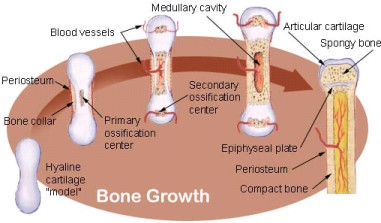
Figure 21.9: The process of endochondrial ossification which happens when the skeleton is developing during fetal development, and in childhood. (46)
When a bone develops from a fibrous membrane, the process is called intramembranous ossification. Intramembranous ossification usually happens in flat bones such as the cranial bones and the clavicles. During intramembranous ossification in the developing fetus, the future bones are first formed as connective tissue membranes. Osteoblasts migrate to the membranes and secrete osteoid, which becomes mineralized and forms bony matrix. When the osteoblasts are surrounded by matrix they are called osteocytes. Eventually, a bone collar of compact bone develops and marrow develops inside the bone.
Bone Elongation
An infant is born with zones of cartilage, called epiphyseal plates, shown in Figure 21.10, between segments of bone to allow further growth of the bone. When the child reaches skeletal maturity (between the ages of 18 and 25 years), all of the cartilage in the plate is replaced by bone, which stops further growth.
1105 www.ck12.org
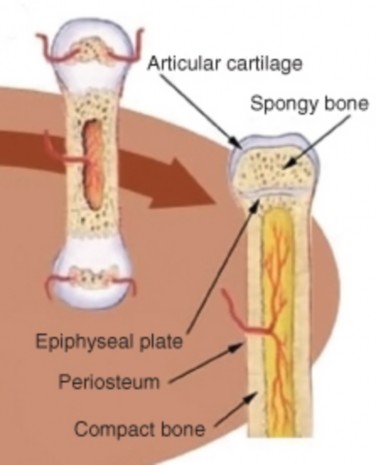
Figure 21.10: Location of the epiphyseal plate in an immature long bone. The chondrocytes in the epiphyseal plate are very metabolically active, as they constantly reproduce by mitosis. As the older chondrocytes move away from the plate they are replaced by osteoblasts that mineralize this new area, and the bone lengthens. (52)
www.ck12.org 1106
Bones grow in length at the epiphyseal plate by a process that is similar to endochondral ossification. The chondrocytes (cartilage cells) in the region of the epiphyseal plate grow by mitosis and push older chondrocytes down toward the bone shaft (diaphysis). Even- tually these chondrocytes age and die. Osteoblasts move into this region and replace the chondrocytes with bone matrix. This process lengthens the bone and continues throughout childhood and the adolescent years until the cartilage growth slows down and finally stops. When cartilage growth stops, usually in the early twenties, the epiphyseal plate completely ossifies so that only a thin epiphyseal line remains and the bones can no longer grow in length. Bone growth is under the influence of growth hormone from the anterior pituitary gland and sex hormones from the ovaries and testes.
Even though bones stop growing in length in early adulthood, they can continue to increase in thickness or diameter throughout life in response to stress from increased muscle activity or to weight-bearing exercise.
Joints
A joint (also called an articulation), is a point at which two or more bones make contact. They are constructed to allow movement and provide mechanical support for the body. Joints are a type of lever, which is a rigid object that is used to increase the mechanical force that can be applied to another object. This reduces the amount of energy that need to be spent in moving the body around. The articular surfaces of bones, which are the surfaces that meet at joints, are covered with a smooth layer of articular cartilage.
There are three types of joints: immovable, partly movable, and synovial. See http:// www.youtube.com/watch?v=SOMFX_83sqk&feature=related for a brief overview of the types of joints.
Immovable Joint: At an immovable joint (or a fixed joint), bones are connected by dense connective tissue, which is usually collagen. Immovable joints, like those connecting the cranial bones, have edges that tightly interlock, and do not allow move- ment. The connective tissue at immovable joints serves to absorb shock that might otherwise break the bone.
Partly Movable Joints: At partly movable joints (or cartilaginous joints), bones are connected entirely by cartilage. Cartilaginous joints allow more movement between bones than a fibrous joint does, but much less than the highly mobile synovial joint. Examples of partly-movable joint include the ribs, the sternum and the vertebrae, shown in Figure 21.11. Partly-movable joints also form the growth regions of immature long bones.
Synovial joints: Synovial joints, also known as movable joints, are the most mobile joints of all. They are also the most common type of joint in the body. Synovial joints
1107 www.ck12.org

Figure 21.11: Illustration of an synovial disk, a cartilaginous joint. These partly-movable joints are found between the vertebrae. An X ray of the cervical (neck) vertebrae is at right. (9)
contain a space between the bones of the joint (the articulating bones), which is filled with synovial fluid. Synovial fluid is a thick, stringy fluid that has the consistency of egg albumin. The word ”synovial” comes from the Latin word for ”egg”. The fluid reduces friction between the articular cartilage and other tissues in joints and lubricates and cushions them during movement. There are many different types of synovial joints, and many different examples. A synovial joint is shown in Figure 21.12.
The outer surface of the synovial joint contains ligaments that strengthen joints and holds bones in position. The inner surface (the synovial membrane) has cells producing synovial fluid that lubricates the joint and prevents the two cartilage caps on the bones from rubbing together. Some joints also have tendons which are bands of connective tissue that link muscles to bones. Bursae are small sacs filled with synovial fluid that reduce friction in the joint. The knee joint contains 13 bursae. Synovial joints can be classified by the degree of mobility they allow, as shown in Figure 21.13.
In a ball and socket joint the ball-shaped surface of one bone fits into the cuplike depression of another. The ball-and-socket joint consists of one bone that is rounded and that fits within a cuplike bone. Examples of a ball and socket joint include the hip (Figure 21.15) and shoulder.
In an ellipsoidal joint an ovoid articular surface, fits into an elliptical cavity in such a way as to permit of some back and forth movement, but not side-to-side motion. The wrist-joint and knee (Figure 21.14), are examples of this type of joint.
In a saddle joint the opposing bone surfaces are fit together like a person sitting in a saddle. The movements at a saddle joint are the same as in an ellipsoid joint. The best example of this form is the joint between the carpals and metacarpals of the thumb.
In the hinge joint, the articular surfaces fit together in such a way as to permit motion only in one plane, forward and backward, the extent of motion at the same time being considerable. An example of a hinge joint is the elbow.
The pivot joint is formed by a process that rotates within a ring, the ring being formed www.ck12.org 1108
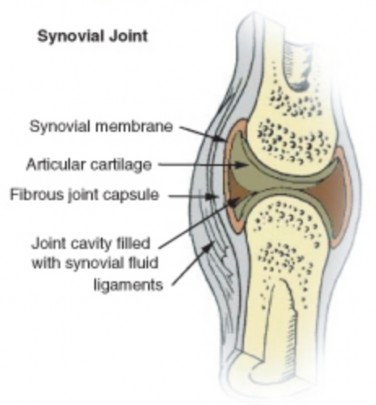
Figure 21.12: Diagram of a synovial joint. Sinovial joints are the most common type of joint in the body, and allow a wide range of motions. Think of how difficult walking would be if your knees and hips were only partly movable, like your spine. (34)
1109 www.ck12.org

Figure 21.13: Types of Synovial joints. These fully-movable joints between bones allow a wide range of motions by the body. They also help reduce the amount of energy that needs to move the body. (47)
partly of bone, and partly of ligament. An example of a pivot joint is the joint between the radius and ulna that allows you to turn the palm of your hand up and down.
A gliding joint, also known as a plane joint, is a joint which allows one bone to slide over another, such as between the carpels of the fingers. Gliding joints are also found in your wrists and ankles.
Not all bones are interconnected directly: There are 6 bones in the middle ear called the ossicles (three on each side) that articulate only with each other. The hyoid bone which is located in the neck and serves as the point of attachment for the tongue, does not articulate with any other bones in the body, being supported by muscles and ligaments. The longest and heaviest bone in the body is the femur and the smallest is the stapes bone in the middle ear. In an adult, the skeleton makes up around 20% of the total body weight.
Homeostatic Imbalances of Bone
Despite their great strength, bones can fracture, or break. Fractures can occur at different places on a bone, and are usually due to excessive bending stress on the bone. Fractures can be complete in which the bone is completely broken, or incomplete in which the bone is cracked or chipped, but not broken all the way, as shown in Figure 21.16. Immediately after a fracture, blood vessels that were torn leak blood into surrounding tissues and a mass of clotted blood, called a hematoma, forms. The area becomes swollen and sore. Within a few days capillaries begin to grow into the hematoma and white blood cells clean up the dead and
www.ck12.org 1110
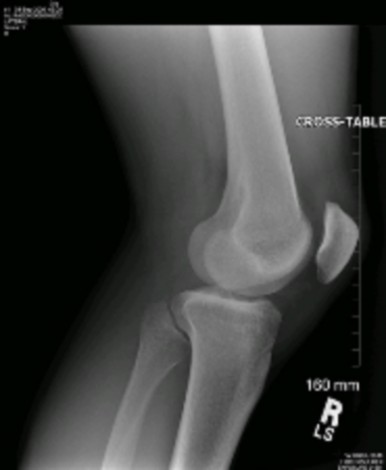
Figure 21.14: Knee joint, an ellipsoid joint. (40)
1111 www.ck12.org
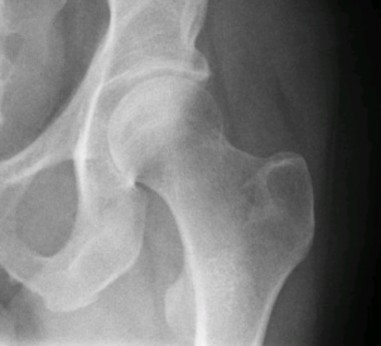
Figure 21.15: The hip joint is a ball-and-socket joint. (43)
dying cells. Fibroblasts and osteoblasts arrive and begin to rebuild the bone. Fibroblasts produce collagen fibers which span the area of the break and connect the ends of the broken bone together. Osteoblasts begin to form spongy bone, and chondroblasts form cartilage matrix. Later, the cartilage and spongy bone are replaced by a bony growth called a callus which forms about 3 to 4 weeks after the fracture, and continues until the break is firmly sealed 2 to 3 months later. Eventually the bony callus is replaced by spongy and compact bone, similar to the rest of the bone.
Rickets is a softening of the bones in children which potentially leads to fractures and deformity; bowing of the leg bones is shown in Figure 21.17. Rickets is among the most frequent childhood diseases in many developing countries. The most common cause is a vitamin D deficiency. Vitamin D is needed by the body to absorb calcium from foods and to form bones. However, lack of calcium in the diet may also cause rickets. Although it can occur in adults, most cases of rickets occur in children who suffer from severe malnutrition, which usually results from starvation during early childhood. Osteomalacia is the term used to describe a similar condition occurring in adults, generally due to a deficiency of vitamin D. Osteomalacia can result in bone pain, difficulty in putting weight on bones, and sometimes fractures.
Some studies show most people get enough Vitamin D through their food and exposure to ultraviolet (UV) radiation in sunlight. Vitamin D is produced by certain skin cells from a compound found inside the cells. The skin cells need UV light for this reaction to happen.
www.ck12.org 1112
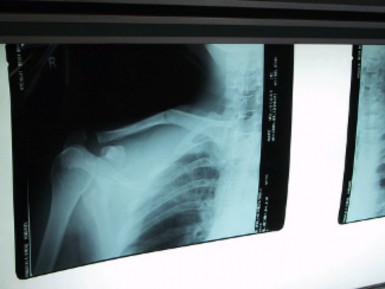
Figure 21.16: (21)
However, eating foods to which vitamin D has been added or taking a dietary supplement pill is usually preferred to UV exposure, due to the increased risk of sun burn and skin cancer. Many countries have fortified certain foods such as milk, bread, and breakfast cereals with Vitamin D to help prevent deficiency.
Osteoporosis is a disease in which the breakdown of bone matrix by osteoclasts is greater than the building of bone matrix by osteoblasts. This results in bone mass that is greatly decreased, causing bones to become lighter and more porous. Bones are then more prone to breakage, especially the vertebrae and femurs. Compression fractures of the vertebrae and hip breaks, in which the top (or head) of the femur breaks are common, and can lead to further immobility, making the disease worse. Osteoporosis mostly occurs in older women and is linked to the decrease in production of sex hormones. However, poor nutrition, especially diets that are low in calcium and vitamin D, increase the risk of osteoporosis in later life. One of the easiest ways to prevent osteoporosis is to eat a healthful diet that has adequate calcium and vitamin D. For a brief animation of osteoporosis, see http:
//www.youtube.com/watch?v=5uAXX5GvGrI.
Osteoarthritis is a condition in which wearing and breakdown of the cartilage that covers the ends of the bones leads to pain and stiffness in the joint. Decreased movement of the joint because of the pain may lead to muscles that are attached to the joint to become weaker, and ligaments may become looser. Osteoarthritis is the most common form of arthritis. Some of the most common causes include old age, sport injuries to the joint, bone fractures, and overweight and obesity. Total hip replacement is a common treatment for osteoarthritis. An X ray image of a replacement hip joint is shown in Figure 21.18. For a brief animation of osteoarthritis, see http://www.youtube.com/watch?v=0dUSmaev5b0.
1113 www.ck12.org
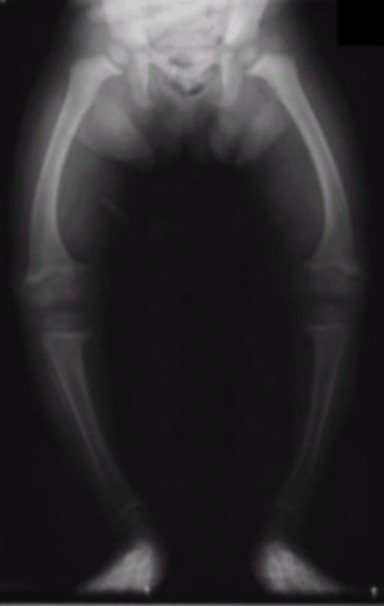
Figure 21.17: An X ray image of a 2-year-old who shows the typical bowing of the femurs that occurs in rickets. Rickets causes poor bone mineralization, which results in the bones bending under the weight of the body. (30)
www.ck12.org 1114

Figure 21.18: Total replacement of hip joint. One of the leading reasons for hip replacement is osteoarthritis of the joint in which the cartilage around the top of the femur bone deteriorates over time, and causes the bones of the joint to grind painfully against each other. This can result in a narrowing of the space in the ball-and-socket joint structure, causing limited movement of the hip and constant pain in the hip joint. (16)
1115 www.ck12.org
Lesson Summary
The human skeleton is well adapted for the functions it must perform. Functions of bones include support, protection, movement, mineral storage, and formation of blood cells.
The adult human skeleton usually consists of 206 named bones and these bones can be grouped in two divisions: axial skeleton and appendicular skeleton.
There are two types of bone tissue: compact and spongy. Compact bone consists of closely packed osteons, or Haversian systems. Spongy bone consists of plates of bone, called trabeculae, around irregular spaces that contain red bone marrow.
Osteogenesis is the process of bone formation. Three types of cells, osteoblasts, osteo- cytes, and osteoclasts, are involved in bone formation and remodeling.
In intramembranous ossification, connective tissue membranes are replaced by bone. This process occurs in the flat bones of the skull. In endochondral ossification, bone tissue replaces hyaline cartilage models. Most bones are formed in this manner.
Bones grow in length at the epiphyseal plate between the diaphysis and the epiphysis. When the epiphyseal plate completely ossifies, bones no longer increase in length.
Bones may be classified as long, short, flat, or irregular. The diaphysis of a long bone is the central shaft. There is an epiphysis at each end of the diaphysis.
There are three types of joints in terms of the amount of movement they allow: im- movable, partly movable, and synovial joints (which are freely movable).
Review Questions
Identify an example of a cell, a tissue, and an organ of the skeletal system.
Identify the main bones of the axial skeleton.
Identify the main bones of the appendicular skeleton.
List four functions of bones and the skeleton.
What is endochondrial ossification, and when does it occur?
Name the three main types of joints, and identify a location in the body that is an example of that type of joint.
Outline how a bone fracture is repaired.
What is the purpose of Haversian canals?
Leukemia is a type of cancer that affects bone. It is a disease in which there is an overproduction of immature white blood cells. Identify the area of bone that is affected by leukemia.
Further Reading / Supplemental Links
Anatomy and Physiology © 2002 Elaine Marieb. Published by Pearson Education Inc. as Benjamin Cummings.
www.ck12.org 1116
Biology 6th Edn. © 2002 Campbell and Reece. Published by Pearson Education Inc. as Benjamin Cummings.
http://training.seer.cancer.gov/module_anatomy/unit3_5_skeleton_divisions
http://training.seer.cancer.gov/module_anatomy/unit3_1_bone_functions
http://yucky.discovery.com/noflash/body/pg000124
http://www.estrellamountain.edu/faculty/farabee/biobk/BioBookMUSSKEL
http://en.wikipedia.org
Vocabulary
appendicular skeleton The portion of the human skeleton that includes the bones of the limbs, scapula and the pelvis.
axial skeleton The portion of the human skeleton that includes the bones of the head, vertebral column, ribs and sternum.
bone marrow A soft, connective tissue found in the interior bones. Red bone marrow produces red blood cells and white blood cells are produced by yellow bone marrow.
bone matrix A mixture of calcium salts, such as calcium phosphate and calcium hydrox- ide, and collagen fibers (a type of protein), which form hollow tubes that look similar to the rings on a tree.
cartilage Dense connective tissue that is made of tough protein fibers. The function of cartilage in the adult skeleton is to provide smooth surfaces for the movement of bones at a joint.
compact bone A type of tissue that makes up the dense outer layer of bones.
endochondrial ossification The process of replacing cartilage with bony tissue, occurs during the gestation period and for years after birth.
endoskeleton The sturdy internal framework of bones and cartilage that is found inside vertebrates.
epiphyseal plate Also known as the growth plate, the area of cartilage at the end of long bones, responsible for elongation of the bone.
fracture A break in a bone.
1117 www.ck12.org
haversian canal Located in the center of each osteon, serves as a passageway for blood vessels and nerves.
intramembranous ossification The process of bone tissue developing from a fibrous membrane, usually occurs in flat bones, such as the clavicle.
joint A point at which two or more bones make contact; also called an articulation. ligament A band of tough, fibrous tissue that connects a bone to another bone. osteoarthritis A condition in which wearing and breakdown of the cartilage that covers
the ends of the bones leads to pain and stiffness in the joint.
osteoblast A type of bone cell that secretes the organic content of bone matrix, and is responsible for the growth of new bone.
osteoclast A type of bone cell that removes calcium salts from bone matrix.
osteocyte A type of bone cell that is responsible for monitoring the protein and mineral content of the bone, directing the release of calcium into the blood, and directing the uptake up of calcium salts into the bone.
osteons Cylinder-shaped units that act like strong pillars within compact bone to give strength, allow the bone to bear the weight of the attached muscles, and withstand the stresses of movement.
osteoporosis A disease in which the breakdown of bone matrix by osteoclasts is greater than the building of bone matrix by osteoblasts.
periosteum The tough, shiny, white membrane that covers all surfaces of bones except at the joint surfaces.
rickets A common disease among children in developing countries; symptoms include soft bones that are prone to fractures.
spongy bone A type of tissue that is less dense than compact bone, and is found toward the center of the bone.
synovial fluid A thick fluid that reduces friction between the articular cartilage and other tissues in synovial (moveable) joints and lubricates and cushions them during move- ment.
www.ck12.org 1118
Points to Consider
Consider how what you eat today can influence your chance of developing osteoporosis later in life.
Forensic pathologists can estimate the age of a deceased person even if only their skeleton remains. Consider how this is possible.
Lesson 21.2: Muscular System
Lesson Objectives
Outline the major role of the muscular system.
Relate muscle fibers, fascicles, and muscles to the muscular system.
Explain how muscle fibers contract.
Examine the role of ATP and calcium in muscle contraction.
Outline how muscles move bones.
Explain how muscles respond to aerobic and anaerobic exercise.
Introduction
The muscular system is the biological system of humans that allows them to move. The mus- cular system, in vertebrates, is controlled through the nervous system. Much of your muscle movement occurs without your conscious control and is necessary for your survival. The contraction of your heart and peristalsis, the intestinal movements that pushes food through your digestive system, are examples of involuntary muscle movements. Involuntary muscle movement is controlled by the autonomic nervous system. Voluntary muscle contraction is used to move the body and can be finely controlled, such as the pincer-type movement of the fingers that is needed to pick up chess pieces, or the gross movements of legs arm, and the torso that are needed in skating, shown in Figure 21.19. Voluntary muscle movement is controlled by the somatic nervous system.
Muscle Tissues
Each muscle in the body is composed of specialized structures called muscle fibers. Muscle fibers are long, thin cells that have a special talent that other cells do not have—they are able to contract. Muscles, where attached to bones or internal organs and blood vessels, are responsible for movement. Nearly all movement in the body is the result of muscle contraction. Exceptions to this are the action of cilia, the flagellum on sperm cells, and the amoeboid movement of some white blood cells.
1119 www.ck12.org
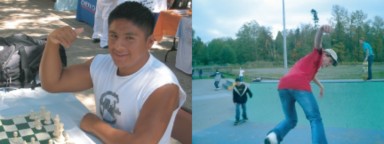
Figure 21.19: You need muscles to play chess. Playing chess requires fine motor movement, but not a lot of gross muscle movements. Skating on the other hand, requires a lot of gross muscle movement of the limbs and the entire body. (39)
Three types of muscle tissue are in the body: skeletal, smooth, and cardiac.
Skeletal muscle is usually attached to the skeleton. Skeletal muscles are used to move the body. They generally contract voluntarily (controlled by the somatic nervous system), although they can also contract involuntarily through reflexes.
Smooth muscle is found within the walls of organs and structures such as the esoph- agus, stomach, intestines, bronchi, uterus, urethra, bladder, and blood vessels. Unlike skeletal muscle, smooth muscle is involuntary muscle which means it not under your conscious control.
Cardiac muscle is also an involuntary muscle but is a specialized kind of muscle found only within the heart.
Cardiac and skeletal muscles are striated, in that they contain highly-regular arrangements of bundles of protein fibers that give them a “striped” appearance. Smooth muscle does not have such bundles of fibers, and is non-striated. While skeletal muscles are arranged in regular, parallel bundles, cardiac muscle fibers connect at branching, irregular angles. Skele- tal muscle contracts and relaxes in short, intense bursts, whereas cardiac muscle contracts constantly for 70 to 80 years (an average life span), or even longer.
Skeletal Muscle
Skeletal muscle, which is attached to bone, is responsible for body movements and body posture. There are approximately 639 skeletal muscles in the human body, some of which are shown in Figure 21.20. These muscles are under conscious, or voluntary, control. The basic units of skeletal muscle are muscle cells that have many nuclei. These muscle cells also contain light and dark stripes called striations, which are shown in Figure 21.21. The striations are a result of the orientation of the contractile proteins inside the cells. Skeletal muscle is therefore called striated muscle. Each muscle cell acts independently of its neighboring
www.ck12.org 1120

Figure 21.20: Frontal view of the major skeletal muscles. You would not see smooth and cardiac muscles included in diagrams of the muscular system because such diagrams usually show only the muscles that move the body (skeletal muscles). (19)
1121 www.ck12.org
muscle cells. On average, adult males are made up of 40 to 50 percent skeletal muscle tissue and an adult female is made up of 30 to 40 percent skeletal muscle tissue.
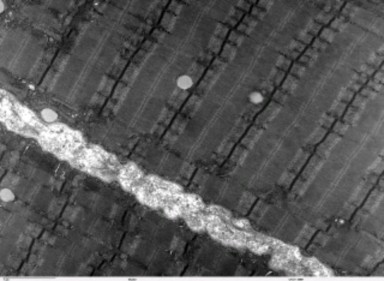
Figure 21.21: Micrograph of skeletal muscle. The stripy appearance of skeletal muscle tissue is due to long protein filaments that run the length of the fibers. (18)
Smooth Muscle
Smooth muscle is found in the walls of the hollow internal organs such as blood vessels, the intestinal tract, urinary bladder, and uterus. It is under control of the autonomic nervous system. This means that smooth muscle cannot be controlled consciously, so it is also called involuntarily muscle. Smooth muscle cells do not have striations, and so smooth muscle is also called non-striated muscle. Smooth muscle cells are spindle-shaped and have one central nucleus. The cells are generally arranged in sheets or bundles, rather than the regular grouping that skeletal muscle cells form, and they are connected by gap junctions. Gap junctions are little pores or gaps in the cell membrane that link adjoining cells and they allowing quick passage of chemical messages between cells. Smooth muscle is very different from skeletal muscle and cardiac muscle in terms of structure and function, as shown in Figure 21.22. Smooth muscle contracts slowly and rhythmically.
Cardiac Muscle
Cardiac muscle, which is found in the walls of the heart, is under control of the autonomic nervous system, and so it is an involuntary muscle. A cardiac muscle cell has characteristics of both a smooth muscle and skeletal muscle cell. It has one central nucleus, similar to smooth
www.ck12.org 1122
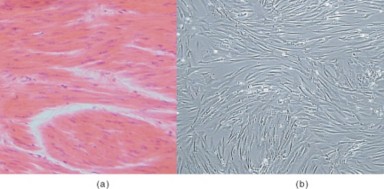
Figure 21.22: Smooth muscle. The appearance of smooth muscle is very different from skeletal and cardiac muscle. The muscle protein fibers within smooth muscle are arranged very differently to the protein fibers of skeletal or cardiac fibers, shown in (a). The spindly shape of smooth muscle cells can be seen in (b). (2)
muscle, but it striated, similar to skeletal muscle. The cardiac muscle cell is rectangular in shape, as can been seen in Figure 21.23. The contraction of cardiac muscle is involuntary, strong, and rhythmical. Cardiac muscle has many adaptations that makes it highly resistant to fatigue. For example, it has the largest number of mitochondria per cell of any muscle type. The mitochondria supply the cardiac cells with energy for constant movement. Cardiac cells also contain myoglobins (oxygen-storing pigments), and are provided with a large amount of nutrients and oxygen by a rich blood supply.
Cardiac muscle is similar to skeletal muscle in chemical composition and action. However, the structure of cardiac muscle is different in that the muscle fibers are typically branched like a tree branch, and connect to other cardiac muscle fibers through intercalcated discs, which are a type of gap junction. A close-up of an intercalated disc is shown in Figure
Cardiac muscle fibers have only one nucleus.
Structure of Muscle Tissue
A whole skeletal muscle is an organ of the muscular system. Each skeletal muscle consists of skeletal muscle tissue, connective tissue, nerve tissue, and vascular tissue. Skeletal muscles vary considerably in size, shape, and arrangement of fibers. They range from extremely tiny strands such as the tiny muscles of the middle ear to large masses such as the quadriceps muscles of the thigh.
Each skeletal muscle fiber is a single large, cylindrical muscle cell. Skeletal muscle fibers differ from “regular” body cells. They are multinucleated, which means they have many nuclei in a single cell; during development many stem cells called myoblasts fuse together to form muscle fibers. Each nucleus in a fiber originated from a single myoblast. Smooth and cardiac muscle fibers do not develop in this way.
1123 www.ck12.org
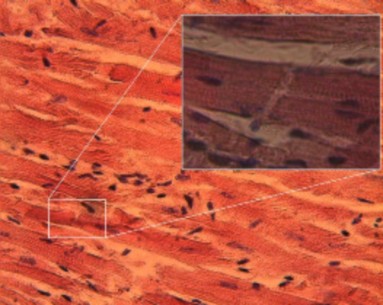
Figure 21.23: Cardiac muscle. Cardiac muscle fibers are connected together through inter- calated discs. (44)
An individual skeletal muscle may be made up of hundreds, or even thousands, of muscle fibers that are bundled together and wrapped in a connective tissue covering called epimy- sium. Fascia, connective tissue outside the epimysium, surrounds and separates the skeletal muscles. Portions of the epimysium fold inward to divide the muscle into compartments called fascicles. Each fascicle compartment contains a bundle of muscle fibers, as shown in Figure 21.24.
Skeletal muscle fibers, like body cells, are soft and fragile. The connective tissue covering give support and protection for the delicate cells and allow them to withstand the forces of contraction. The coverings also provide pathways for the passage of blood vessels and nerves. Active skeletal muscle needs efficient delivery of nutrients and oxygen, and removal of waste products, both of which are carried out by a rich supply of blood vessels.
Muscles and Bones
Muscles move the body by contracting against the skeleton. Muscles can only actively contract, they extend (or relax) passively. The ability of muscles to move parts of the body in opposite directions requires that they be attached to bones in pairs which work against each other (called antagonistic pairs). Generally, muscles are attached to one end of a bone, span a joint, and are attached to a point on the other bone of the joint. Commonly, the connective tissue that covers the muscle extends beyond the muscle to form a thick ropelike structure called a tendon, as shown in Figure 21.24. One attachment of the muscle, the
www.ck12.org 1124

Figure 21.24: Individual bundles of muscle fibers are called fascicles. The cell membrane surrounding each muscle fiber is called the sarcolemma, and beneath the sarcolemma lies the sarcoplasm, which contains the cellular proteins, organelles, and myofibrils. The myofibrils are composed of two major types of protein filaments: the thinner actin filament, and the thicker myosin filament. The arrangement of these two protein filaments gives skeletal muscle its striated appearance. (31)
1125 www.ck12.org
origin, is on a bone that does not move when the muscle contracts. The other attachment point, the insertion, is on the bone that moves. Tendons and muscles work together and exert only a pulling force on joints.

Figure 21.25: Movement of the elbow joint involves muscles and bones. The contraction of the biceps brachii muscle pulls on the radius, its point of insertion, which causes the arm to bend. To straighten the arm, the triceps brachii muscle contracts and pulls on the ulna, this causes the arm to straighten. (13)
For example, when you contract your biceps brachii muscles, shown in Figure 21.25, the force from the muscles pulls on the radius bone (its point of insertion) causing the arm to move up. This action decreases the angle at the elbow joint (flexion). Flexion of the elbow joint is shown in Figure B 21.26. A muscle that causes the angle of a joint to become smaller is called a flexor. To extend, or straighten the arm, the biceps brachii relaxes and the triceps on the opposite side of the elbow joint contracts. This action is called extension, and a muscle that causes a joint to straighten out is called an extensor. In this way the joints of your body act like levers that reduce the amount of effort you have to expend to cause large movements of the body.
Muscle Contraction
A muscle contraction occurs when a muscle fiber generates tension through the movement of actin and myosin. Although you might think the term contraction means only ”shorten- ing,” the overall length of a contracted muscle may stay the same, or increase, depending on the force working against the muscle.
www.ck12.org 1126
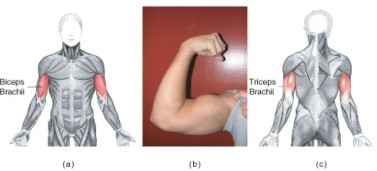
Figure 21.26: (a) The position of the biceps brachii. (b) The biceps brachii and triceps brachii act as an atagonistic pair of muscles that move the arm at the elbow joint. The biceps muscle is the flexor, and the triceps, at the back of the arm, is the extensor (c). (10)
Each muscle fiber contains cellular proteins and hundreds or thousands of myofibrils. Each myofibril is a long, cylindrical organelle that is made up of two types of protein filaments: actin and myosin. The actin filament is thin and threadlike, the myosin filament is thicker. Myosin has a “head” region that uses energy from ATP to “walk” along the actin thin filament (Figure 21.31). The overlapping arrangement of actin and myosin filaments gives skeletal muscle its striated appearance. The actin and myosin filaments are organized into repeating units called sarcomeres, which can be seen in Figure 21.27. The thin actin filaments are anchored to structures called Z lines. The region from one Z line to the next makes up one sacromere. When each end of the myosin thick filament moves along the actin filament, the two actin filaments at opposite sides of the sacromere are drawn closer together and the sarcomere shortens, as shown in Figure 21.28. When a muscle fiber contracts, all sarcomeres contract at the same time, which pulls on the fiber ends.
The Neuromuscular Junction
For skeletal (voluntary) muscles, contraction occurs as a result of conscious effort that comes from the brain. The brain sends nerve signals, in the form of action potentials to the motor neuron that innervates the muscle fiber, such as the motor neuron in Figure 21.29. In the case of some reflexes, the signal to contract can originate in the spinal cord through a reflex arc. Involuntary muscles such as the heart or smooth muscles in the gut and vascular system contract as a result of non-conscious brain activity or stimuli endogenous to the muscle itself. Other actions such as body motion, breathing, and chewing have a reflex aspect to them; the contractions can be initiated consciously or unconsciously, but are continued through unconscious reflexes. You can learn more about action potentials and reflex arcs in the Nervous and Endocrine Systems chapter.
1127 www.ck12.org

Figure 21.27: The components of muscle contraction. The sacromere is the functional unit of muscle contraction; it reaches from one Z-line to the next (also shown in Figure 21.28). In a relaxed muscle, the actin (thin filament) and myosin (thick filament) overlap. In a muscle contraction, the filaments slide past each other, shortening the sacromere. This model of contraction is called the sliding filament mechanism. (12)
www.ck12.org 1128
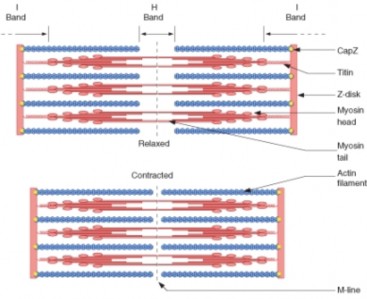
Figure 21.28: When each end of the myosin thick filament moves along the actin filament, the two actin filaments at opposite sides of the sacromere are drawn closer together and the sarcomere shortens. (14)

Figure 21.29: (a) A simplified diagram of the relationship between a skeletal muscle fiber and a motor neuron at a neuromuscular junction. 1. Axon; 2. Synaptical junc- tion; 3. Muscle fiber; 4. Myofibril. (b) A close-up view of a neuromuscular junction. The neurotransmitter acetylcholine is released into the synapse and binds to receptors on the muscle cell membrane. The acetylcholine is then broken down by enzymes in the synapse. 1. presynaptic terminal; 2. sarcolemma; 3. synaptic vesicles; 4. Acetyl- choline receptors; 5. mitochondrion. For an animation of the neuromuscular junction see http://www.youtube.com/watch?v=ZscXOvDgCmQ. (8)
1129 www.ck12.org
The Sliding Filament Theory
The widely accepted theory of how muscles contract is called the sliding-filament model (also known as the sliding filament theory), which is shown in Figure 21.30. The presence of calcium ions (Ca2+) allows for the interaction of actin and myosin. In the resting state, these proteins are prevented from coming into contact. Two other proteins, troponin and tropomyosin, act as a barrier between the actin and myosin, preventing contact between them. When Ca2+ binds to the actin filament, the shape of the troponin-tropomyosin com- plex changes, allowing actin and myosin to come into contact with each other. Below is an outline of the sliding filament theory.
An action potential (see the Nervous and Endocrine Systems chapter) arrives at the axon terminal of a motor neuron.
The arrival of the action potential activates voltage-dependent calcium channels at the axon terminal, and calcium rushes into the neuron.
Calcium causes vesicles containing the neurotransmitter acetylcholine to fuse with the plasma membrane, which releases acetylcholine into the synaptic cleft between the axon terminal and the motor end plate of the skeletal muscle fiber.
Activation of the acetylcholine receptors on the muscle fiber membrane opens its sodium/potassium channel, which triggers an action potential in the muscle fiber.
The action potential spreads through the muscle fiber’s network, depolarizing the inner portion of the muscle fiber.
The depolarization activates specialized storage sites throughout the muscle, called the sarcoplasmic reticulum, to release calcium ions (Ca++). The sarcoplasmic reticulum is a special type of smooth endoplasmic reticulum found in smooth and skeletal muscle that contains large amounts of Ca++, which it stores and then releases when the cell is depolarized.
The calcium ions bind to actin filaments of the myofibrils and activate the actin for attachment by the myosin heads filaments.
Activated myosin binds strongly to the actin filament. Upon strong binding, myosin rotates at the myosin-actin interface which bends a region in the “neck” of the myosin “head,” as shown in Figure 10.
Shortening of the muscle fiber occurs when the bending neck of the myosin region pulls the actin and myosin filaments across each other. Meanwhile, the myosin heads remain attached to the actin filament, as shown in Figure 21.30.
The binding of adenosine triphosphate (ATP) allows the myosin heads to detach from actin. While detached, ATP breaks down to adenosine diphosphate and an inorganic phosphate (ADP + Pi). The breaking of the chemical bond in ATP gives energy to the myosin head, allowing it to bind to actin again.
Steps 9 and 10 repeat as long as ATP is available and Ca++ is present on the actin
filament. The collective bending of numerous myosin heads (all in the same direction) moves the actin filament relative to the myosin filament which causes a shortening of the sacromere. Overall, this process results in muscle contraction. The sarcoplasmic
www.ck12.org 1130
reticulum actively pumps Ca++ back into itself. Muscle contraction stops when Ca++ is removed from the immediate environment of the myofilaments.

Figure 21.30: The process of actin and myosin sliding past one another is called crossbridge cycling, and it occurs in all muscle types. Myosin is a molecular motor that moves along the passive actin. Each thick myosin filament has little extensions or “heads,” that “walk” along the thin actin filaments during contraction. In this way the thick filament slides over thin filament. The actin filaments transmit the force generated by myosin to the ends of the muscle, which causes the muscle to shorten. (33)
Motor Units
It is important to remember that the sliding filament theory applies to groups of individual muscle fibers which, along with their motor neuron, are called motor units. A single, momentary contraction is called a muscle twitch. A twitch is the response to a single stimulus that can involve a number of motor units. As a stimulus increases, more motor units are stimulated to contract until a maximum level is reached at which point the muscle cannot exert any more force.
Each muscle fiber contracts on an ”all or nothing” principle, a muscle fiber either contracts fully, or not at all, and all the fibers in a single motor unit contract at the same time. When a muscle is required to contract during exercise not all motor units are contracted at the same time. Most movements require only a small amount of the total force possible by the contraction of an entire muscle. As a result, our nervous system grades the intensity of muscle contraction by using different numbers of motor units at a time.
Cardiac Muscle Contractions
Cardiac muscle is adapted to be highly resistant to fatigue: it has a large number of mito- chondria which allow continuous aerobic respiration; numerous myoglobins (oxygen storing pigment); and a good blood supply, which provides nutrients and oxygen. The heart is so tuned to aerobic metabolism that it is unable to pump well when there is a lack of blood to the heart muscle tissue, which can lead to a heart attack.
Unlike skeletal muscle, which contracts in response to nerve stimulation, and like certain types of smooth muscle, cardiac muscle is able to initiate contraction by itself. As a result, the heart can still beat properly even if its connections to the central nervous system are
1131 www.ck12.org
completely severed. A single cardiac muscle cell, if left without input, will contract rhyth- mically at a steady rate; if two cardiac muscle cells are in contact, whichever one contracts first will stimulate the other to contract, and so on. This inherent ability to contract is controlled by the autonomic nervous system.
If the rhythm of cardiac muscle contractions is disrupted for any reason (for example, in a heart attack or a cardiac arrest), erratic contractions called fibrillation can result. Fib- rillation, which is life threatening, can be stopped by use of a device called a defibrillator. Defibrillation consists of delivering a therapeutic dose of electrical energy to the heart which depolarizes part of the heart muscle. The depolarization stops the fibrillation, and allows a normal heartbeat to start up again. Most types of defibrillators are operated by medical per- sonnel only. However, you may be familiar with an automated external defibrillator (AED) which is shown in Figure 21.31.
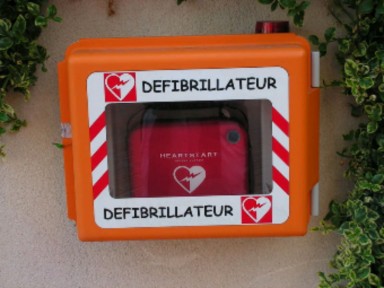
Figure 21.31: A wall-mounted automated external defibrillator (AED). Defibrillators are used to “shock” fibrillating cardiac muscle back into the correct rhythm. AEDs are designed to be able to diagnose fibrillation in a person who has collapsed, meaning that a bystander can use them successfully with little or no training. They are usually found in areas where large groups of people may gather, such as train stations, airports, or at sports events. (17)
Smooth Muscle Contraction
Smooth muscle-containing tissue, such as the stomach or urinary bladder often must be stretched, so elasticity is an important characteristic of smooth muscle. Smooth muscle (like cardiac muscle) does not depend on motor neurons to be stimulated. However, motor neurons of the autonomic nervous system do reach smooth muscle, causing it to contract or
www.ck12.org 1132
relax, depending on the type of neurotransmitter that is released. Smooth muscle is also affected by hormones. For example, the hormone oxytocin causes contraction of the uterus during childbirth.
Similar to the other muscle types, smooth muscle contraction is caused by the sliding of myosin and actin filaments over each other. However, calcium initiates contractions in a different way in smooth muscle than in skeletal muscle. Smooth muscle may contract phasi- cally with rapid contraction and relaxation, or tonically with slow and sustained contraction. The reproductive, digestive, respiratory, and urinary tracts, skin, eye, and vasculature all contain smooth muscle. For example, the ability of vascular smooth muscle (veins and ar- teries) to contract and dilate is critical to the regulation of blood pressure. Smooth muscle contracts slowly and may maintain the contraction (tonically) for prolonged periods in blood vessels, bronchioles, and some sphincters. In the digestive tract, smooth muscle contracts in a rhythmic peristaltic fashion. It rhythmically massages products through the digestive tract, shown in Figure 21.32, as the result of phasic contraction.
Energy Supply for Muscle Contraction
Energy for the release and movement of the myosin head along the actin filament comes from ATP. The role of ATP in muscle contraction can be observed in the action of muscles after death, at which point ATP production stops. Without ATP, myosin heads are unable to release from the actin filaments, and remain tightly bound to it (a protein complex called actomyosin). As a result, all the muscles in the body become rigid and are unable to move, a state known as rigor mortis. Eventually, enzymes stored in cells are released, and break down the actomyosin complex and the muscles become ”soft” again.
Cellular respiration is the process by which cells make ATP by breaking down organic com- pounds from food. Muscle cells are able to produce ATP with oxygen which is called aerobic respiration, or without oxygen, an anaerobic process called anaerobic glycolysis or fermen- tation. The process in which ATP is made is dependent on the availability of oxygen (see Cellular Respiration chapter).
Aerobic ATP Production
During everyday activities and light exercise, the mitochondria of muscle fibers produce ATP in a process called aerobic respiration. Aerobic respiration requires the presence of oxygen to break down food energy (usually glucose and fat) to generate ATP for muscle contraction. Aerobic respiration produces large amounts of ATP, and is an efficient means of making ATP. Up to 38 ATP molecules can be made for every glucose molecule that is broken down. It is the preferred method of ATP production by body cells. Aerobic respiration requires large amount of oxygen, and can be carried out over long periods of time. As activity levels increase, breathing rate increases to supply more oxygen for increased ATP production.
1133 www.ck12.org
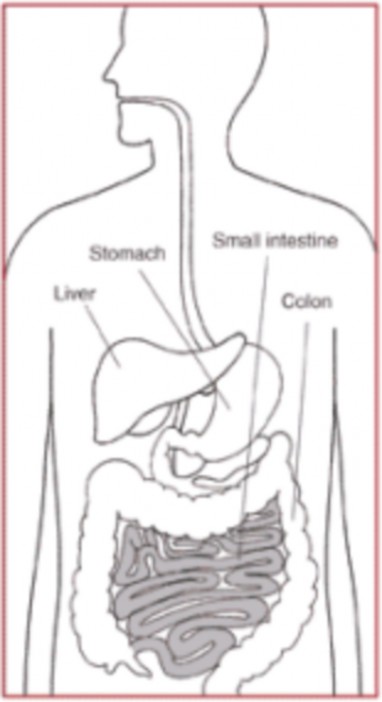
Figure 21.32: The intestinal tract contains smooth muscle which moves food along by con- tracting and relaxing in a process called peristalsis. An animation of peristalsis can be viewed at http://en.wikipedia.org/wiki/File:Peristalsis.gif. (15)
www.ck12.org 1134
Anaerobic ATP Production
When muscles are contracting very quickly, which happens during vigorous exercise, oxygen cannot travel to the muscle cells fast enough to keep up with the muscles’ need for ATP. At this point, muscle fibers can switch to a breakdown process that does not require oxygen. The process, called anaerobic gylcolysis (sometimes called anaerobic respiration) breaks down energy stores in the absence of oxygen to produce ATP.
Anaerobic glycolysis produces only two molecules of ATP for every molecule of glucose, so it a less efficient process than aerobic metabolism. However, anaerobic glycolysis produces ATP about 2.5 times faster than aerobic respiration does. When large amounts of ATP are needed for short periods of vigorous activity, glycolysis can provide most of the ATP that is needed. Anaerobic glycolysis also uses up a large amount of glucose to make relatively small amounts of ATP. In addition to ATP, large amounts of lactic acid are also produced by glycolysis. When lactic acid builds up faster than it can be removed from the muscle, it can lead to muscle fatigue. Anaerobic glycolysis can be carried out for only about 30 to 60 seconds. Some recent studies have found evidence that mitochondria inside the muscle fibers are able to break down lactic acid (or lactate) to produce ATP, and that endurance training results in more lactate being is taken up by mitochondria to produce ATP.
Functions of Skeletal Muscle Contraction
In addition to movement, skeletal muscle contraction also fulfills three other important func- tions in the body: posture, joint stability, and heat production.
Joint stability refers to the support offered by various muscles and related tissues that surround a joint.
Heat production by muscle tissue makes them an important part of the thermoreg- ulatory mechanism of the body. Only about 40 percent of energy input from ATP converts into muscular work, the rest of the energy is converted to thermal energy (heat). For example, you shiver when you are cold because the moving (shivering) skeletal muscles generate heat that warms you up.
Posture, which is the arrangement of your body while sitting or standing, is maintained as a result of muscle contraction.
Types of Muscle Contractions
Skeletal muscle contractions can be categorized as isometric or isotonic.
An isometric contraction occurs when the muscle remains the same length despite building tension. Isometric exercises typically involve maximum contractions of a muscle by using:
the body’s own muscle (e.g., pressing the palms together in front of the body)
1135 www.ck12.org
structural items (e.g., pushing against a door frame)
contracting a muscle against an opposing force such as a resistance band, or gravity, as shown in Figure 21.33

Figure 21.33: Pushing a heavy object involves isometric contractions of muscles in the arms and in the abdomen. This man’s grip on the trolley involves isometric contractions of the hand muscles. The muscles in his legs are contracting isotonically. (23)
An isotonic contraction occurs when tension in the muscle remains constant despite a change in muscle length. Lifting an object off a desk, walking, and running involve isotonic contractions. There are two types of isotonic contractions: concentric and eccentric. In a concentric contraction, the muscle shortens while generating force, such as the shortening of the biceps brachii in your arm when you lift a glass to your mouth to take a drink, or a set of dumbbells, as shown in Figure 21.34.
www.ck12.org 1136
During an eccentric contraction, the force opposing the contraction of the muscle is greater than the force that is produced by the muscle. Rather than working to pull a joint in the direction of the muscle contraction, the muscle acts to slow the movement at the joint. Eccentric contractions normally occur as a braking force in opposition to a concentric con- traction to protect joints from damage. The muscle lengthens while generating force. Part of training for rapid movements such as pitching during baseball involves reducing eccentric braking which allows greater power to be developed throughout the movement.
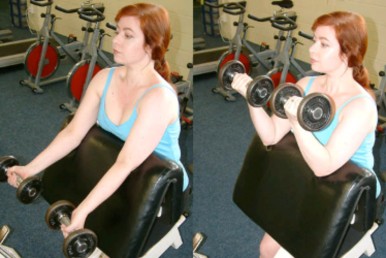
Figure 21.34: An example of an isotonic contraction. The biceps brachii contract concentri- cally, raising the dumbbells. (5)
Muscles and Exercise
As we learned earlier in this lesson, your muscles are important for carrying out everyday activities, whether you are picking up a glass of orange juice, walking your dog, or snow wrestling (Figure 21.35). The ability of your body to carry out your daily activities without getting out of breath, sore, or overly tired is referred to as physical fitness. For example, a person who becomes breathless and tired after climbing a flight of stairs is not physically fit.
We cannot discuss the effect of exercise on your muscles without first clarifying the confusion between some common terms. It is easy to get confused with the relationship between “physical fitness,” “physical activity,” and “physical exercise.” Some people may think they cannot fit physical activity into their lives because they are unable to afford to join a gym, they do not have the time be involved in an organized sport, or they do not want to lift weights. However, physical activity encompasses so much more than just “working out.” Physical activity is any movement of the body that causes your muscles to contract and your heart rate to increase. Everyday activities such as carrying groceries, vacuuming, walking to class, or climbing a flight of stairs are physical activities.
1137 www.ck12.org
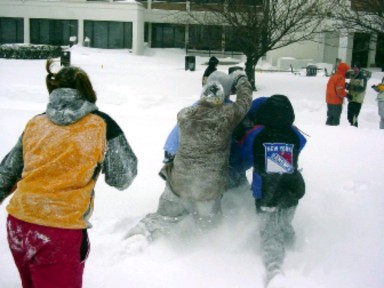
Figure 21.35: You don’t have to be super fit to play in snow, but it might help! (48)
Being physically active for 60 minutes a day for at least five days a week helps a person to maintain a good level of physical fitness and also helps him or her to decrease their chance of developing diseases such as cardiovascular disease, Type 2 diabetes, and certain forms of cancer. Varying levels of physical activity exist: from a sedentary lifestyle in which there is very little or no physical activity, to high-level athletic training. Most people will find themselves somewhere in the middle of this wide spectrum.
Physical exercise is any activity that maintains or improves physical fitness and overall health. Exercise is often practiced to improve athletic ability or skill. Frequent and regular physical exercise is an important component in the prevention of some lifestyle diseases such as heart disease, cardiovascular disease, Type 2 diabetes and obesity. Regular exercise is also helpful with reduction in, or avoidance of symptoms of depression. Regular exercise improves both muscular strength and endurance. Muscular strength is the ability of the muscle to exert force during a contraction. Muscular endurance is the ability of the muscle to continue to contract over a period of time without getting fatigued. Regular stretching improves flexibility of the joints and helps avoid activity-related injuries.
Effect of Exercise on Muscles
Exercises are generally grouped into three types depending on the overall effect they have on the human body:
Aerobic, or endurance, exercises, such as cycling, walking, and running, shown in
Figure 21.36, increase muscular endurance. www.ck12.org 1138
Anaerobic exercises, such as weight training, shown in Figure 21.37, or sprinting increase muscle strength.
Flexibility exercises, such as stretching, improve the range of motion of muscles and joints.
Aerobic exercise causes several changes in skeletal muscle: mitochondria increase in number, the fibers make more myoglobin, and more capillaries surround the fibers. These changes result in greater resistance to fatigue and more efficient metabolism. Aerobic exercise also benefits cardiac muscle. It results in the heart being able to pump a larger volume of blood with each beat due to an increase in the size of the heart’s ventricles.

Figure 21.36: Running is a form of aerobic exercise. (49)
Anaerobic, or resistance, exercises cause an increase in muscle mass. Muscles that are trained under anaerobic conditions develop differently giving them greater performance in short duration-high intensity activities. As a result of repeated muscle contractions, muscle fibers develop a larger number of mitochondria and larger energy reserves.
During anaerobic exercise, muscles break down stored creatine phosphate to generate ATP. Creatine phosphate is an important energy store in skeletal muscle. It is broken down to form creatine for the 2 to 7 seconds following intense contractions. After several seconds, further ATP energy is made available to muscles by breaking down the storage molecule glycogen into pyruvate through glycolysis, as it normally does through the aerobic cycle. What differs is that pyruvate, rather than be broken down through the slower but more energy efficient aerobic process, is fermented to lactic acid. Muscle glycogen is restored from blood sugar, which comes from the liver, from digested carbohydrates, or from amino acids which have been turned into glucose.
Two types of muscle fibers make up skeletal muscle:
1139 www.ck12.org
Slow twitch muscle fibers, or ”red” muscle, is dense with capillaries and is rich in mitochondria and myoglobin, giving the muscle tissue its characteristic red color. It can carry more oxygen and sustain aerobic activity. The endurance of slow twitch muscles is increased by aerobic training.
Fast twitch muscle fibers are the fastest type of muscle fibers in humans. These fibers tend to have fewer mitochondria than slow twitch fibers do, but they have larger energy stores. They can contract more quickly and with a greater amount of force than slow- twitch fibers can. Fast twitch fibers can sustain only short, anaerobic bursts of activity before muscle contraction becomes painful. Fast twitch muscle fibers become faster and stronger in response to short, intense activities such as weight training.
Both aerobic and anaerobic exercise also work to increase the mechanical efficiency of the heart by increasing cardiac volume (aerobic exercise), or myocardial thickness (strength training). Anaerobic training results in the thickening of the heart wall to push blood through arteries that are squeezed by increased muscular contractions.

Figure 21.37: This weightlifter shows muscular hypertrophy which he has gained through anaerobic exercise. (3)
Muscular Hypertrophy
Hypertrophy is the growth in size of muscle fibers and muscles, as shown in Figure 21.37. Aerobic exercise does not tend to cause hypertrophy even though the activity may go on for several hours. That is why long-distance runners tend to be slim, especially in the upper body. Hypertrophy is instead caused by high-intensity anaerobic exercises such as weight lifting or other exercises that cause the muscles to contract strongly against a resisting force. As a result of repeated muscle contractions, muscle fibers develop a larger number
www.ck12.org 1140
of mitochondria and larger energy reserves. The muscle fibers also develop more myofibrils, and each myofibril contains more actin and myosin filaments. The effect of this activity is hypertrophy of the stimulated muscle.
Factors such as age and sex can also affect muscle hypertrophy. During puberty in males, hypertrophy occurs at an increased rate. In general, males are also able to develop larger muscles because the male body produces far more testosterone than the female body does. On average, an adult human male body produces about eight to ten times more testosterone than an adult female body. Testosterone is an anabolic steroid, which means it increases protein synthesis within muscle fibers, resulting in the buildup of more myosin and actin filaments, and myofibrils. More myofibrils means an increase in strength.
Athletic heart syndrome is hypertrophy of cardiac muscle in response to exercise. A larger heart is able to pump more blood with a single beat, resulting in a lower resting pulse rate than average. The average resting heart rate for a healthy adult is between 60 and 100 beats per minute, but an athlete can have a resting pulse rate of 40 beats per minute or less! These changes would indicate heart-disease if observed in a person who is not active, but in an athlete a large heart with a slow resting pulse is the result of normal and healthy muscle growth, and indicates a high level of fitness.
Proper rest and recovery are also as important to health as exercise, otherwise the body is in a permanently injured state and will not improve or adapt well to the exercise. Therefore, it is important to remember to allow adequate recovery time of muscles between exercise sessions. This type of rest is called active rest.
Muscle Atrophy
To remain healthy, muscles must be used. The condition in which muscle mass is lost is called atrophy. Atrophy can occur if muscles do not get enough exercise, or if an injury such as bone fracture causes immobility. Atrophy is the reverse of hypertrophy, muscle fibers become smaller, which causes the muscle to become smaller. Atrophy can also result from a spinal injury (CNS damage) leading to muscle paralysis, which the athlete in Figure 21.38 experiences. Diseases such as muscular dystrophy, amyotrophic lateral sclerosis (ALS, or Lou Gehrig’s disease), and polio also cause muscle atrophy.
Homeostatic Imbalances of the Muscular System
Hypertrophy of internal organs can sometimes be harmful. For example, hypertrophic car- diomyopathy, or HCM, is a disease of the heart muscle in which a portion of the cardiac muscle (usually the left ventricle) is enlarged without any obvious cause. HCM has been re- lated to the sudden death of young athletes, but it is also of significance as a cause of sudden unexpected cardiac death in any age group and as a cause of disabling cardiac symptoms. Most patients’ symptoms may be managed medically without needing surgery. HCM is not
1141 www.ck12.org
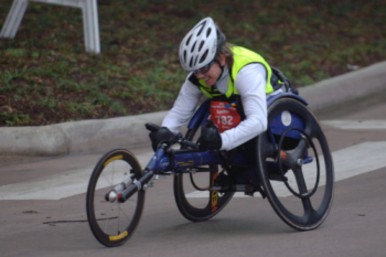
Figure 21.38: Muscular paralysis and the resulting atrophy of the leg muscles, as this marathon racer with paraplegia has experienced, does not have to prevent a person from developing aerobic fitness. (36)
to be confused with athletic heart syndrome which is hypertrophy of the heart muscle in response to exercise.
Delayed Onset Muscle Soreness (DOMS) is the pain or discomfort often felt 24 to 72 hours after exercising and generally goes away within 2 to 3 days. Once thought to be caused by lactic acid buildup, a more recent hypothesis is that it is caused by tiny tears in the muscle fibers caused by eccentric contraction, or an increased level of training. Since lactic acid is quickly taken away by in the blood, it cannot explain the pain experienced days after exercise. Delayed onset muscle soreness can occur after any kind of exercise, particularly if the body is unconditioned for that exercise.
Tendinitis is a painful disorder of a tendon. Generally tendinitis is referred to by the body part involved, such as Achilles tendinitis which affects the Achilles tendon, shown in Figure 21.39, or patellar tendinitis (jumper’s knee, which affects the patellar tendon). It was believed that tendinitis was due to inflammation of a tendon, although this is now being questioned. Chronic overuse of tendons leads to microscopic tears within the collagen matrix, which gradually weakens the tissue. Eccentric muscle contractions are being researched for their ability to speed rehab of weak or injured tendons. Achilles tendinitis has been shown to benefit from high load eccentric contractions.
Neuromuscular diseases are those that affect the muscles and/or their nervous control. In general, problems with nervous control can cause spasticity or paralysis, depending on the location and nature of the problem. A large number of neurological disorders leads to problems with movement, ranging from strokes and Parkinson’s disease, to the very rare and incurable degenerative disorder, Creutzfeldt-Jakob disease.
www.ck12.org 1142

Figure 21.39: The Achilles tendon is a large tendon connecting the heel to the muscles of the calf. (26)
1143 www.ck12.org
Diseases of the motor end plate include myasthenia gravis, a form of muscle weakness due to antibodies to the acetylcholine receptor. Tetanus and botulism are bacterial intoxica- tions in which bacterial toxins cause muscular spasms by blocking the action of inhibitory neurotransmitters (tetanus) or decreased muscle tone (botulism).
Myopathies are diseases affecting the muscle itself, rather than its nervous control. Muscular dystrophy is a large group of diseases which leads to progressive loss of muscle strength and decreased life span.
Smooth muscle plays a role in a large number of diseases affecting blood vessels, the res- piratory tract (asthma), the digestive system (irritable bowel syndrome), and the urinary tract (urinary incontinence). However, these diseases are not usually confined just to the muscular tissue, and affect other tissues too.
Lesson Summary
The human body has three types of muscle tissue: skeletal, smooth, and cardiac.
One of the main characteristics of skeletal muscle tissue is its ability to contract. Nearly all movement in the body is the result of muscle contraction.
Cardiac and skeletal muscles contain highly-regular arrangements of bundles of protein fibers that give them a striped appearance. Smooth muscle does not have such bundles of fibers, and so is not striated.
In addition to movement, muscle contraction also fulfills some other important func- tions in the body, such as posture, joint stability, and heat production.
Skeletal muscle fibers respond to the neurotransmitter acetylcholine.
The thick myosin filament has small extensions or “heads,” that “walk” along the thin actin filaments during a muscle contraction. In this way the thick filament slides over thin filament, and the muscle fiber shortens.
Muscle fibers need ATP to contract and to relax.
Muscle tissue is built up in the process of hypertrophy, and is lost in the process of atrophy.
Review Questions
Distinguish between striated and non-striated muscle.
Distinguish between voluntary and involuntary muscle.
Identify the three types of muscle in the body, and give an example of where each type is found.
Which type of muscle cell is multinucleated?
Is the quadriceps muscles in the leg an example of a smooth muscle? Explain your answer.
Which type of muscle cell metabolism results in the greater production of ATP, aerobic www.ck12.org 1144
or anaerobic? Give a reason for your answer.
Describe the components of a sacromere.
Distinguish between fast twitch and slow twitch muscle fibers.
After an athlete has completed a 100 meter sprint, his or her breathing rate will be greatly increased, and they need time to “catch their breath.” Can you identify the process that leads to a person needing to catch their breath?
Further Reading / Supplemental Links
Anatomy and Physiology © 2002 Elaine Marieb. Published by Pearson Education Inc. as Benjamin Cummings.
Biology 6th Edn. © 2002 Campbell and Reece. Published by Pearson Education Inc. as Benjamin Cummings.
Zierath JR, Hawley JA (2004) Skeletal Muscle Fiber Type: Influence on Contractile and Metabolic Properties. PLoS Biol 2(10): e348 doi:10.1371/journal.pbio.0020348; Available online at:
http://biology.plosjournals.org/perlserv/?request=getdocument&doi= 10.1371/journal.pbio.0020348
Published: October 12, 2004.
http://training.seer.cancer.gov/module_anatomy/unit4_1_muscle_functions
http://www.nismat.org/physcor/muscle
http://www.berkeley.edu/news/media/releases/2006/04/19_lactate
http://www.cdc.gov/nccdphp/dnpa/physical/components/index
http://www.cdc.gov/nccdphp/dnpa/physical/terms/index
http://muscle.ucsd.edu/musintro/hypertrophy
http://www.physsportsmed.com/issues/2002/07_02/puffer
http://www.nlm.nih.gov/medlineplus/ency/article/000688
http://www.imcpl.org/kids/guides/health/muscularsystem
http://training.seer.cancer.gov/module_anatomy/unit4_1_muscle_functions
http://en.wikipedia.org
Vocabulary
actin A thread-like protein filament that is involved in muscle contraction.
aerobic respiration The breakdown of food energy to generate ATP, occurs in the pres- ence of oxygen.
anaerobic glycolysis (anaerobic respiration) The breakdown of stored energy in the absence of oxygen to produce ATP.
1145 www.ck12.org
atrophy The loss of muscle mass.
cardiac muscle Involuntary muscle that makes up the heart.
delayed onset muscle soreness (DOMS) The pain or discomfort often felt 24 to 72 hours after exercising and generally goes away within 2 to 3 days, caused by tiny tears in muscle fibers.
extensor A muscle that causes the angle of a joint to become larger. flexor A muscle that causes the angle of a joint to become smaller. hypertrophy The growth in size of muscle fibers and muscles.
isometric contraction Occurs when the muscle remains the same length despite building tension.
isotonic contraction Occurs when tension in the muscle remains constant despite a change in muscle length.
muscle contraction The generation of tension in a muscle fiber by the movement of actin and myosin.
motor unit A group of individual muscle fibers along with their motor neuron.
muscle fiber Long thin cell, composed of actin and myosin, that is able to contract.
myofibril Long cylindrical organelle that is made up of two types of protein filaments: actin and myosin.
myosin A protein filament that uses ATP to move along an actin filament, causing muscle contraction.
sarcomeres Repeating units of actin and myosin filaments.
skeletal muscle Used to move the body, usually attached to the skeleton, controlled vol- untarily by the somatic nervous system and involuntarily through reflexes.
smooth muscle Found within the walls of organs and structures such as the esophagus, under involuntary control.
tendinitis A painful disorder of a tendon. www.ck12.org 1146
Points to Consider
Identify ways in which damage to the integumentary system (for example, in a person with a severe burn) may affect the muscular and skeletal systems.
Consider how the daily exercise routine and diet of an Olympic weightlifter would differ from that of a professional marathon runner.
Lesson 21.3: Integumentary System
Lesson Objectives
Identify the structures that make up the integumentary system.
Outline the role of the skin in providing a physical barrier to the external environment.
Distinguish between the two layers that make up the skin.
Identify two types of glands that are found in the skin.
Outline the function of melanin.
Outline the structure of hair.
Examine the structure of nails, and compare them to the structure of nails.
Introduction
Your integumentary system is the external covering of your body. It is made up of your skin, hair, and nails. The integumentary system of other animals such as birds and reptiles includes their feathers and scales. The name comes from the Latin term integumentum, which means “a covering.”
The integumentary system has multiple roles in homeostasis, including protection, temper- ature regulation, sensory reception, biochemical synthesis, and absorption. Keeping water out of the body is an important role for your integumentary system, as is shown by Figure
21.40. Your body systems all work together to maintain relatively stable internal conditions. Each of the parts that make up your integumentary system has a special role in maintain- ing homeostasis which we will explore a little later. An introduction to the Integumentary System can be viewed at http://www.youtube.com/watch?v=no_XRnoNGfE.
Structure and Function of Your Skin
The skin is a vital organ that covers the entire outside of the body, forming a protective barrier against pathogens and injuries from the environment. The skin is the body’s largest organ, covering the entire outside of the body, and it is only about 2 mm thick. It shields the body against heat, light, injury, and infection. The skin also helps regulate body tem-
1147 www.ck12.org
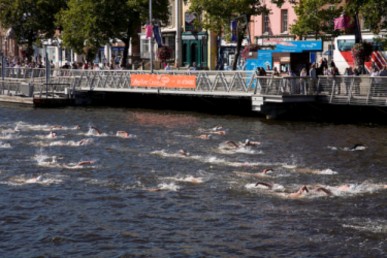
Figure 21.40: Your skin acts like a waterproof barrier so that you can swim without water leaking into your body. (41)
perature, gathers sensory information from the environment, stores water, fat, and vitamin D, and acts as a physical barrier in protecting us from disease.
Your skin is constantly in contact with your external environment so it gets cut, scratched, and exposed to radiation, such as ultraviolet (UV) light. You also naturally shed many skin cells every day. Your body replaces damaged or missing skin cells by growing more of them, through the process of mitosis. Two distinct layers make up the skin: the epidermis and the dermis. A fatty layer, called subcutaneous tissue, or hypodermis (below skin), lies under the dermis, but it is not considered to be part of your skin. The layers that make up your skin are shown in Figure 21.41.
The color, thickness and texture of skin vary over the body. There are two general types of skin; thin and hairy, which is the most common type on the body, and thick and hairless, which is found on parts of the body that are used heavily and experience a lot of friction, such as the palms of the hands or the soles of the feet.
Epidermis
Epidermis is the outermost layer of the skin. It forms the waterproof, protective wrap over the body’s surface and is made up of many layers of epithelial cells, shown in Figure 21.42.
The epidermis is divided into several layers where epithelial cells are formed through mitosis in the lowest layer. The epithelial cells move up through the layers of the epidermis, changing shape and composition as they differentiate and become filled with a tough, fibrous protein called keratin. At this point the cells are called keratinocytes. Keratinocytes at the surface of the epidermis form a thin layer of flattened, dead cells, (the stratum corneum in Figure
www.ck12.org 1148

Figure 21.41: Structure of the skin. The structures of the epidermis, dermis, and the subcu- taneous tissue (called the subcutis in this diagram). Note how there are no blood vessels in the epidermis. (45)
1149 www.ck12.org
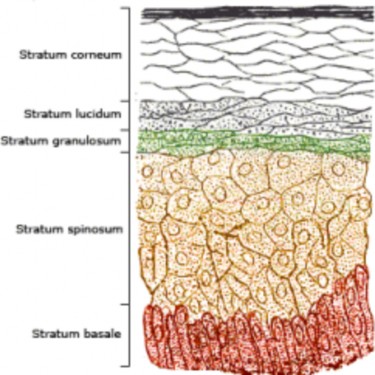
Figure 21.42: The epidermis is made up of many layers of epithelial cells. The uppermost layer is made up of many flat, dead, keratin-filled cells called keratinocytes. Every day, thousands of keratinocytes get scraped off the surface of your skin, and are replaced by cells that move up from lower layers. (53)
www.ck12.org 1150
21.42). Although the top layer of epidermis is only about as thick as a sheet of paper, it is made up of 25 to 30 layers of keratinocytes. Keratinocytes get scraped off through everyday activities, and are usually shed about a month after they reach the surface of the epidermis.
The epidermis also contains cells called melanocytes that produce the pigment melanin. Melanin is the brownish pigment that gives skin and hair their color. Melanocytes are located in the bottom layer of the epidermis, the stratum basale, shown in Figure 21.42. The difference in skin color between light-skinned people and dark-skinned people is not due to the number of melanocytes in their skin, but to the melanocytes’ level of activity. The amount of melanin produced in a person’s skin is dependent on his or her genetics and the amount of ultraviolet (UV) light exposure. Melanin absorbs UV rays from the sun or other sources of UV light, such as a tanning bed. When UV light penetrates the skin and damages DNA; the damaged DNA triggers the synthesis of more melanin. The skin also makes vitamin D by absorbing energy from UV light. Melanin acts like a UV filter, so the more melanin in a person’s skin, the more time the person has to spend in sunlight to produce the same amount of vitamin D as a person with less melanin in their skin.
The epidermis also contains cells that take up and process certain marker proteins (called antigens) from microbes that enter through the skin. This helps the immune system recognize the microbe as an intruder, and to mount an attack on it. The epidermis contains no blood vessels, so the lower portion of the epidermis is nourished by diffusion from the blood vessels of the dermis.
Structure and Function of Dermis
The dermis is the layer of skin directly under the epidermis and is made of a tough elastic connective tissue. The dermis is tightly connected to the epidermis by a membrane made of collagen fibers. The dermis contains the hair follicles, sweat glands, sebaceous glands, and blood vessels. It also holds many nerve endings that provide the sense of touch, pressure, heat, and pain. Tiny muscles, called arrector pili, contract and pull on hair follicles which cause hair to stand up. This can happen when you are cold or afraid, and the resulting little “bumps” in the skin are commonly called goose bumps.
The dermis has two layers, each of which contains different structures:
Papillary region (upper layer): The papillary region is made up of loose connective tissue and contains touch receptors which communicate with the central nervous system. It is named for its finger-like projections called papillae, which extend toward the epidermis, and help secure the dermis to the epidermis. The papillae can be seen in Figure 21.41. The papillae provide the dermis with a ”bumpy” surface that causes distinctive friction ridges. They are called friction ridges, because they help the hand or foot to grasp things by increasing friction. Friction ridges, as shown in Figure 21.43, occur in patterns that are unique to the individual, making it possible to use fingerprints or footprints as a means of identification.
1151 www.ck12.org
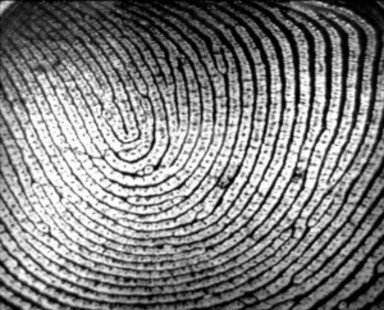
Figure 21.43: Close-up image of a toe print. The friction ridges that originate in the dermis and make up the whorls and lines of finger and toe prints are clearly visible. Both fingers and toes have these distinctive ridges. (24)
Reticular region (lower layer): The reticular region is made of dense elastic fibers (col- lagen), which contains the hair follicles and roots, nerves, and glands. It gets its name from the dense concentration of protein fibers that weave throughout it. These protein fibers give the dermis its properties of strength, extensibility, and elasticity. Heat, cold and pressure receptors, nails, and blood vessels are also located in this region. Tattoo ink is injected into the dermis. Stretch marks are also located in the dermis.
Glands and Follicles
Glands and follicles open out into the epidermis, but they originate within the dermis. A sebaceous gland, also known as an oil gland, secretes an oily substance, called sebum, into the hair follicle. Sebum is made of lipids and the debris of dead lipid-producing cells. The word sebum comes from the Latin word for fat, or tallow. It “waterproofs” hair and the skin surface to prevent them from drying out. It can also inhibit the growth of microorganisms on the skin. Sebum is the cause of the oily appearance of skin and hair. It is odorless, but the breakdown of sebum by bacteria can cause odors. A sebaceous gland is shown in Figure
If a sebaceous gland becomes plugged and infected, it develops into a pimple, also called acne.
Sweat glands open to the epidermal surface through the skin pores. They occur all over the body and are controlled by the sympathetic nervous system. Evaporation of sweat from
www.ck12.org 1152

Figure 21.44: A sebaceous gland an associated hair follicle. Sebum acts to protect and waterproof hair and skin, and keep them from becoming dry, brittle and cracked. (4)
the skin surface helps to lower the skin temperature, which in turn helps to control body temperature. The skin also functions as an excretory organ because it releases excess water, salts, and other wastes in sweat. A sweat gland is shown in Figure 21.45. There are two types of sweat glands, eccrine glands and apocrine glands. Eccrine glands are the “regular” sweat glands that release sweat to cool the body. Apocrine glands are larger than eccrine glands and are located in the armpits and groin areas. They effectively act as scent glands because they produce a solution that bacteria break down which produces ”body odor.”
Mammary glands are the organs that, in the female mammal, produce milk to feed their young. Mammary glands are enlarged and modified sweat glands and are a major charac- teristic of mammals.
Subcutaneous Tissue
The subcutaneous tissue (also called the hypodermis), lies below the dermis and contains fat and loose connective tissue that holds larger blood vessels and nerves. Its purpose is to attach the skin to underlying bone and muscle as well as to supply the skin with blood vessels and nerves. This layer is important is the regulation of body temperature. It is mostly made up of adipose tissue (which is made up of fat cells or adipocytes); the subcutaneous tissue contains about 50 percent of the body’s fat. The functions of subcutaneous tissue include
1153 www.ck12.org

Figure 21.45: Location of sweat glands in the dermis. Note that the sweat glands are called sudoriferous glands in this image. (51)
www.ck12.org 1154
insulation and the storage of nutrients. The size of this layer varies throughout the body and from person to person.
Functions of Skin: Skin and Homeostasis
The skin has multiple roles in homeostasis, including protection, control of body temperature, sensory reception, water balance, synthesis of vitamins and hormones, and absorption of materials. The skin’s main functions are to serve as a barrier to the entry of microbes and viruses, and to prevent water and extracellular fluid loss. Acidic secretions from skin glands also stop the growth of fungi on the skin. Melanocytes form a second barrier: protection from the damaging effects of UV radiation. When a microbe gets into the skin (or when the skin is cut) an immune system reaction occurs.
Heat and cold receptors are located in the skin. When the body temperature rises, the hypothalamus sends a nerve signal to the sweat-producing skin glands, causing them to release sweat onto the skin surface. The evaporation of sweat helps reduce the temperature of the skin surface which cools the body. The hypothalamus also causes dilation of the blood vessels of the skin, allowing more blood to flow into those areas, causing heat to be released from the skin surface. When body temperature falls, the sweat glands constrict and sweat production decreases. If the body temperature continues to fall, the body will start to generate heat by raising the body’s metabolic rate and by causing the muscles to shiver.
The homeostatic functions of the skin include:
Protection of the body’s internal tissues and organs.
Protection against invasion by infectious organisms.
Protection of the body from dehydration.
Protection of the body against large changes in temperature.
Excretion of wastes through sweat.
Acts as a receptor for the senses of touch, pressure, pain, heat, and cold.
Makes vitamin D through exposure to UV radiation.
Stores water, fat, and vitamin D.
Homeostatic Imbalances of the Skin
Many wavelengths of electromagnetic radiation are emitted by the sun, some we can see, and others we cannot. The range of wavelengths of radiation we can see is called visible light. However, visible light makes up only a small portion of the total radiation that comes from the sun. Two other types of radiation that you have probably heard about before include infrared and ultraviolet radiation. Infrared light is the thermal energy, or the “heat rays” that you feel when the sun shines on you. The other, ultraviolet (UV), which we have discussed a little already, helps the body produce vitamin D, but it can also damage DNA in skin cells. Our main source of UV radiation, the sun, is shown in Figure 21.46.
1155 www.ck12.org

Figure 21.46: Ultraviolet radiation emitted by the sun. Prolonged exposure to UV radiation can lead to skin cancer and premature wrinkling of the skin. (37)
www.ck12.org 1156
Beneficial Effects of UV Radiation
A positive effect of ultraviolet radiation (UV) exposure is that it causes the production of vitamin D in the skin. It has been estimated that tens of thousands of premature deaths occur in the United States annually from a range of cancers due to vitamin D deficiency.
Ultraviolet radiation has other medical applications, in the treatment of skin conditions such as psoriasis, a disorder in which red, scaly patches form due to an overproduction of epithelial cells, and vitiligo, a condition that causes loss of pigment, which results in irregular pale patches of skin, as shown in Figure 21.47.
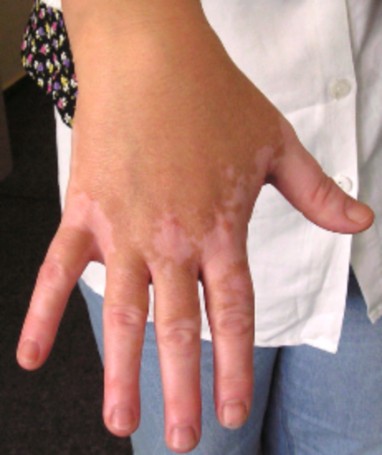
Figure 21.47: Vitiligo is chronic skin condition that causes loss of pigment, resulting in ir- regular pale patches of skin. The cause of vitiligo is not fully understood. There is some evidence suggesting it is caused by a combination of auto-immune, genetic, and environmen- tal factors. Phototherapy in which the patient is exposed to long-wave ultraviolet (UVA) light from the sun or from UVA lamps, together with certain medicines, can help in many cases. (20)
1157 www.ck12.org
Harmful Effects of UV Radiation
In humans, prolonged exposure to solar UV radiation may result in acute and chronic health effects on the skin, eye, and immune system. While some sunlight is good for health, skin cancer caused by excessive exposure to sunlight is not among the sun’s benefits. Because some types of skin cancer are easy to cure, the danger posed by too much sunlight is perhaps not taken seriously enough. It is important to remember that a more serious form of skin cancer, called melanoma, is also associated with excessive sun exposure. Melanomas are potentially lethal tumors.
The UV radiation excites DNA molecules in skin cells, causing bonds to form between neighboring thymine bases, producing a thymine dimer that changes the shape of the DNA helix. These dimers can lead to mutations. Mutations are changes to the base pair sequence of DNA or RNA. Mutations can result in cancerous growths.
Skin cancer is an increasingly common condition. This is due in part to peoples’ increased exposure to UV radiation, because of the increased popularity of sun bathing. Because melanin protects the skin from the effects of UV radiation, lighter-skinned people are at more risk of developing skin cancer than darker skinned people are. However, the risk of developing skin cancer is related to the amount of sunburn and overall length of time a person has been exposed to UV light. The three most common types of skin cancers are shown in Figure 21.48.

Figure 21.48: The three most common forms of skin cancer. Basal cell carcinoma (left), squamous cell carcinoma (center), and melanoma (right). All three types arise from cells in the epithelium. (1)
As a defense against UV radiation, the body tans when exposed to moderate levels of ra- diation by releasing the brown pigment melanin. This helps to block UV penetration and prevent damage to the vulnerable skin tissues deeper down. Suntan lotion, often referred to as ”sun block” or ”sunscreen”, partly blocks UV and is widely available. Most of these prod- ucts contain a sun protection factor (SPF) rating that describes the amount of protection given. This protection, however, applies only to a type of UV radiation called UVB rays, the type of radiation that is responsible for sunburn. UVA rays, another type of UV radiation, penetrates more deeply into the skin and may be responsible for causing cancer and wrinkles. Some sunscreen lotion now includes compounds such as titanium dioxide which helps protect against UVA rays. Other UVA blocking compounds found in sunscreen include zinc oxide and avobenzone. Another means to block UV is sun protective clothing, shown in Figure
www.ck12.org 1158
This is clothing that has an ultraviolet protection factor (UPF) rating that describes the protection given against both UVA and UVB radiation.

Figure 21.49: Some good advice from the National Cancer Institute. The risk of melanoma and other forms of skin cancer can be significantly reduced by avoiding excessive exposure to the sun, using sunscreen lotions, and wearing protective clothing to shield the skin from ultraviolet radiation. (29)
Acne
The most common form of acne is known as acne vulgaris, which means ”common acne.” Many teenagers get this type of acne. Acne is a highly complicated and variable form of skin infection. It affects more than 85% of teenagers, but frequently also continues into adulthood. For most people, acne tends to decrease or disappear after one reaches his or her early twenties. Excessive secretion of sebum from the sebaceous glands leads to the plugging of the hair follicle with dead skin cells (corneocytes). This blockage is caused by a failure of the normal process in which skin cells that line the pores are usually shed. Within these blocked pores bacteria and yeast begin to multiply. In response to the bacterial and yeast populations, the skin inflames, which produces a red bump.
Nails and Hair
Nails are made up of specialized epidermal cells. Fingernails and toenails contain a tough protein called keratin and are actually a type of modified hair. The nail grows from the nail bed, which is thickened to form a lunula (or little moon), shown in Figure 21.50. Cells
1159 www.ck12.org
forming the nail bed are linked together to form the nail. There are no nerve endings in the nail.
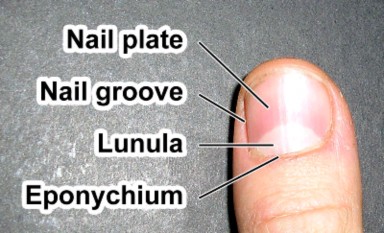
Figure 21.50: The parts of the nail. The lunula is also called the little moon, the eponychium is also called the cuticle. (38)
The fingernail generally serves two purposes. It serves as a protective plate and enhances sensation of the fingertip. The protection function of the fingernail is commonly known, but the sensation function is equally important. The fingertip has many nerve endings in it allowing us to receive volumes of information about objects we touch. The nail acts as a counterforce to the fingertip providing even more sensory input when an object is touched.
Nails are made up of many different parts, as shown in Figure 21.50:
The free edge is the part of the nail that extends past the finger, beyond the nail plate.
The nail plate is what we think of when we say “nail,” the hard and translucent portion, composed of keratin.
The lunula is the crescent shaped whitish area of the nail bed (when visible).
The eponychium or cuticle, is the fold of skin at the end of the nail.
Nails grow at a rate about 1 cm every 100 days. Fingernails require 4 to 6 months to regrow completely and toenails require 12 to 18 months. Actual growth rate is dependent upon age, season, exercise level, and hereditary factors. This growth record can show the history of recent health and physiological imbalances, and has been used as a diagnostic tool since ancient times.
Major illness will cause a deep horizontal groove to form in the nails. Discoloration, thinning, thickening, brittleness, splitting, grooves, spots, lines, receded lunula, or changes in the shape of the nail can indicate illness in other areas of the body, nutrient deficiencies, drug reaction or poisoning, or a physical injury to the nail or nail bed.
www.ck12.org 1160
Hair
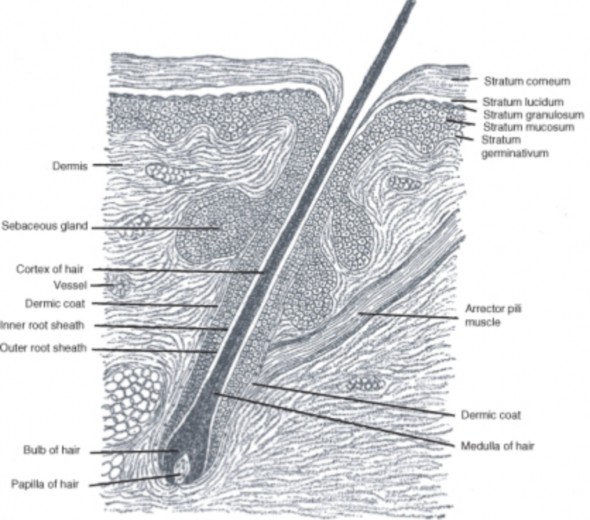
Figure 21.51: A hair follicle and hair. (25)
Hair is a filamentous fiber that is found only on mammals. The main component of hair is the tough protein keratin. Hair emerges from the epidermis, although it grows from hair follicles deep in the dermis, shown in Figure 21.51. The hair of non-human mammal species is commonly called fur.
Humans have three different types of hair:
Lanugo is the fine hair that covers nearly the entire body of fetuses.
Vellus hair is the short, fine, ”peach fuzz” body hair that grows in most places on the human body except for the palms of the hands and the soles of the feet.
1161 www.ck12.org
Terminal hair is the fully developed hair which is generally longer, coarser, thicker, and darker than vellus hair.
Different parts of the human body have different types of hair. From childhood onward, vellus hair covers the entire human body except on the lips, the palms of hands, the soles of feet, the navel, and scar tissue. The density of the hairs (in hair follicles per square centimeter) varies from one person to another.

Figure 21.52: Magnification of a human hair. The hair shaft is composed of dead, keratin- filled (keratinized) skin cells that overlap each other like the shingles, or tiles on a roof. You can see the overlapping cells in this image. (50)
What is the function of hair? In people, hair serves to insulate, to protect, and to sense the immediate surroundings. Insulation serves to conserve heat. The hair on your head insulates your body from heat loss. Eyelashes and eyebrows protect the eyes from water, dirt, and other irritants. Nose hairs act as a physical barrier to any particles or microorganisms that might be in the air we breathe.
Curly hair has a different biological structure than straight hair, shown in Figure 21.52. It tends to be much drier than straight hair because the oils secreted into the hair shaft by the sebaceous glands can more easily travel down the shaft of straight hair. People with very curly hair may find that this hair type can be dry, hard to manage, and often frizzy.
Individual hairs have periods of growth and dormancy. During the growth portion of the cycle, hair follicles are long and bulbous, and the hair grows out at about a third of a millimeter per day. After three to six months, body hair growth stops (the pubic and armpit
www.ck12.org 1162
areas having the longest growth period). The follicle shrinks and the root of the hair grows rigid. Following a period of dormancy, another growth cycle starts, and eventually a new hair pushes the old one out of the follicle from beneath. Head hair, by comparison, grows for a long duration and to a great length before being shed. Terminal hair is genetically programmed to be straight, curly or wavy, and it tends to change over time.
Hair color is the result of pigmentation due to the presence of different forms of melanin. In general, the more melanin present, the darker the hair color; the less melanin, the lighter the hair color. A person’s hair color may also change over time and may be more than one color at a time.
Lesson Summary
The integumentary system consists of the skin, hair, and nails.
The skin is the covering of the body. It acts as a physical barrier to the external environment.
The outermost layer, of the skin, the epidermis, consists of many layers of dead kera- tinized skill cells. The epidermis is waterproof and prevents fluids from leaking out of the body and into the body.
The dermis is the layer of skin directly under the epidermis and is made of a tough elas- tic connective tissue. The dermis is tightly connected to the epidermis by a membrane made of collagen fibers.
Glands and follicles open out into the epidermis, but they originate within the dermis. A sebaceous gland or oil gland secretes an oily substance, called sebum, into the hair follicle. Sweat glands open to the epidermal surface through the skin pores. They occur all over the body and are controlled by the sympathetic nervous system.
Melanin is the brownish pigment that gives skin and hair their color. It is found in melanocytes are located in the bottom layer of the epidermis. Melanin acts as a UV filter, it absorbs UV rays from the sun or other sources of UV light, such as a tanning bed.
The main component of hair and nails is the tough protein keratin.
Review Questions
Name all of the parts of the integumentary system.
Name the two layers that make up the skin, and identify a function for each layer.
Why is subcutaneous tissue also called subdermal tissue?
Why is the epidermis considered the dead part of the skin?
Name the cells that produce melanin and describe where they are found.
Explain how sweating helps regulate body temperature. Use Figure 21.53 of part of the integumentary system to answer questions 7 and 8.
In what layer of the skin would you find this tissue?
1163 www.ck12.org

Figure 21.53: (28)
Name the substance that is found in the uppermost layer of this tissue.
Describe one function of hair.
Identify the substance that prevents skin and hair from drying out.
Further Reading / Supplemental Links
Anatomy and Physiology © 2002 Elaine Marieb. Published by Pearson Education Inc. as Benjamin Cummings.
http://training.seer.cancer.gov/ss_module14_melanoma/unit02_sec01_anatomy
http://www.estrellamountain.edu/faculty/farabee/biobk/BioBookINTEGUSYS
http://www.cancer.gov/cancertopics/understandingcancer/environment
http://www.cancer.gov/cancertopics/understandingcancer/cancer/Slide54
http://animaldiversity.ummz.umich.edu/site/topics/mammal_anatomy/hair
http://www.cancer.gov/cancertopics/understandingcancer/cancer
http://www.cdc.gov/excite/skincancer/index
http://www.niams.nih.gov/hi/topics/acne/acne
http://en.wikipedia.org
Vocabulary
dermis The layer of skin directly under the epidermis, contains the hair follicles, sweat glands, sebaceous glands, and blood vessels.
epidermis The outermost layer of the skin. www.ck12.org 1164
integumentary system The organ system consisting of your skin, hair and nails. melanin The brown pigment that gives skin, hair and eyes their color. melanocytes Cells that produce melanin, found in the skin, hair and eyes. mutation A change to the nucleotide sequence of DNA or RNA.
papillary region Part of the dermis that contains touch receptors, which communicate with the central nervous system.
reticular region Part of the dermis that contains the hair follicles and roots, nerves, and glands.
sebaceous gland Secretes an oily substance, called sebum, into the hair follicle.
sebum An oily substance secreted by sebaceous glands that is composed of lipids and debris of dead lipid-producing cells, responsible for protecting the skin and hair against drying out, and infection by microorganisms.
subcutaneous tissue (hypodermis) Lies below the dermis and contains fat and loose connective tissue that holds larger blood vessels and nerves, attaches the skin to un- derlying bone and muscle.
Points to Consider
Identify reasons why you should wear sunblock with an SPF value of at least 15 ev- eryday.
Consider what might happen if hair, fingernails and toenails contained sensory recep- tors.
Image Sources
http://commons.wikimedia.org/wiki/File:Squamous_Cell_Carcinoma.jpg http://upload.wikimedia.org/wikipedia/commons/8/83/Melanoma2.jpg. Public Domain, Public Domain.
http://en.wikipedia.org/wiki/Image:Human_Aortic_SMC.jpg. CC-BY-SA, CC-BY-SA.
1165 www.ck12.org
Cpl. Benjamin Cossel. http://en.wikipedia.org/wiki/Image:Weightlifting.jpg. Public Domain.
USFG. http://en.wikipedia.org/wiki/Image:HairFollicle.png. Public Domain.
George Stepanek. http://commons.wikimedia.org/wiki/File:PreacherBenchBicepsCurl.JPG. CC-BY-SA.
http://www.flickr.com/photos/acaben/516493964/. CC-BY-SA.
http://training.seer.cancer.gov/anatomy/skeletal/classification.html. Public Domain.
Utilisateur:Dake.
http://commons.wikimedia.org/wiki/Image:Synapse_diag3.png,http:
//commons.wikimedia.org/wiki/Image:Synapse_diag4.png. CC-BY-SA, GNU-FDL.
http://www.flickr.com/photos/ciscel/382453477/. Public Domain, CC-BY-SA.
http://commons.wikimedia.org/wiki/Image:Arm_flex_supinate.jpg http://commons.wikimedia.org/wiki/Image:Triceps_brachii.png. GNU-FDL, CC-BY-SA.
Telethon. http://www.flickr.com/photos/ryanjunell/290767026/. CC-BY-SA.
http://commons.wikimedia.org/wiki/Image:Skeletal_muscle.jpg. CC-BY-SA.
USFG. http://commons.wikimedia.org/wiki/File:Illu_upper_extremity.jpg. Public Domain.
Slashme. http://en.wikipedia.org/wiki/File:Sarcomere.svg. GNU-FDL.
http://commons.wikimedia.org/wiki/Image: Small-Intestine-highlighted.gif. Public Domain.
Scuba-limp.
http://commons.wikimedia.org/wiki/Image:Hueftgelenk-Endoprothese.jpg. GFDL 1.2, CC-BY-SA 2.5, 2.0, and 1.0.
Snowdog.
http://commons.wikimedia.org/wiki/Image:Street-defibrillator.jpg. Public Domain.
Louisa Howard. http://commons.wikimedia.org/wiki/Image: Human_skeletal_muscle_tissue_1_-_TEM.jpg. Public Domain.
www.ck12.org 1166
CK-12 Foundation. . CC-BY-SA.
Produnis. http://en.wikipedia.org/wiki/Image:Vitiligo03.jpg. GNU-FDL.
mexican 2000. http://www.flickr.com/photos/mexican/113765165/. CC-BY-SA.
http://training.seer.cancer.gov/anatomy/skeletal/tissue.html. Public Domain.
Zoom Zoom. http://www.flickr.com/photos/zoomzoom/304130574/. CC-BY-SA.
http://www.flickr.com/photos/chadmiller/98014022/. CC-BY-SA-2.0.
20th U.S. edition, Gray’s Anatomy. A hair follicle and hair.. Public Domain.
http://commons.wikimedia.org/wiki/File:Achilles-tendon.jpg. Public Domain.
Mariana Ruiz Villarreal. . Public Domain.
USFG. [Modified from:
http://en.wikipedia.org/wiki/Image:Illu_epithelium.jpg ]. Public Domain.
http://www.cancer.gov/cancertopics/understandingcancer/cancer/Slide54. Public Domain.
Michael L. Richardson, M.D.. http://commons.wikimedia.org/wiki/Image:XrayRicketsLegssmall.jpg. CC-BY-SA 1.0.
http://commons.wikimedia.org/wiki/Image:
Skeletal_muscle_-_longitudinal_section.jpg. Public Domain, GFDL.
http:
//upload.wikimedia.org/wikipedia/commons/0/0f/Hyaline_cartilage.jpg. GNU-FDL.
http://en.wikipedia.org/wiki/Image:Querbr%C3%BCckenzyklus_2.png http://en.wikipedia.org/wiki/Image:Querbr%C3%BCckenzyklus_3.png http://en.wikipedia.org/wiki/Image:Querbr%C3%BCckenzyklus_4.png http://commons.wikimedia.org/wiki/Image:ATP_symbol.svg. CC-BY-SA.
http://en.wikipedia.org/wiki/Image:Illu_synovial_joint.jpg. Public Domain.
Mariana Ruiz Villarreal. http://commons.wikimedia.org/wiki/File:Human_skeleton_front_en.svg. Public Domain.
1167 www.ck12.org
Euthman. http://www.flickr.com/photos/euthman/357322273/. CC-BY-SA- 2.0.
http://en.wikipedia.org/wiki/Image: SOHO_EIT_ultraviolet_corona_image.gif. Public Domain.
Kipton. http://en.wikipedia.org/wiki/Image:Fingernail_label.jpg. Public Domain.
http://www.flickr.com/photos/bjornb/60128667/. CC-BY-SA, CC-BY-SA.
Knee joint, an ellipsoid joint.. CC-BY-SA.
http://www.flickr.com/photos/infomatique/1388375080/. CC-BY-SA.
http://commons.wikimedia.org/wiki/Image:
Compact_bone_-_decalcified_cross_section.jpg. GNU-FDL.
The hip joint is a ball-and-socket joint.. CC-BY-SA.
Dr. S. Girod. http://en.wikipedia.org/wiki/Image:Glanzstreifen.jpg. CC-BY-SA.
USFG. . Public Domain.
USFG. http://training.seer.cancer.gov/anatomy/skeletal/growth.html. Public Domain.
http://en.wikipedia.org/wiki/Image:Gelenke_Zeichnung01.jpg. GNU-FDL.
ZeWrestler.
http://commons.wikimedia.org/wiki/Image:Snowball_fight_MSU.jpg. Public Domain.
Aarmono. Running is a form of aerobic exercise.. CC-BY-SA.
http://en.wikipedia.org/wiki/Image:Menschenhaar_200_fach.jpg. Public Domain.
http://en.wikipedia.org/wiki/Image:Gray940.png. Public Domain.
USFG. [Adapted from http://training.seer.cancer.gov/anatomy/skeletal/growth.html ]. Public Domain.
http://en.wikipedia.org/wiki/Image:Gray941.png. Public Domain.
www.ck12.org 1168
Circulatory and Respiratory Systems
Lesson 22.1: Circulatory System
Lesson Objectives
Identify the functions and components of the cardiovascular system.
Describe the structure of the heart.
Outline the flow of blood through the heart.
Compare the structures of arteries, veins, and capillaries.
Compare pulmonary circulation and systemic circulation.
Outline the functions of the lymphatic system.
Describe the importance of the coronary arteries.
Outline the process of atherosclerosis.
Describe ways of preventing cardiovascular diseases.
Introduction
The cardiovascular system shown in Figure 22.1 is an organ system that moves nutri- ents, hormones, gases and wastes to and from body cells, and distributes heat to maintain homeostasis. The main components of the cardiovascular system are the heart, the blood vessels, and the blood.
The Heart
The heart is the muscular organ that pumps blood through the blood vessels by repeated, rhythmic contractions. The term cardiac means ”related to the heart” and comes from the Greek word kardia, for ”heart.” The heart is made up mostly of cardiac muscle tissue, (shown
1169 www.ck12.org
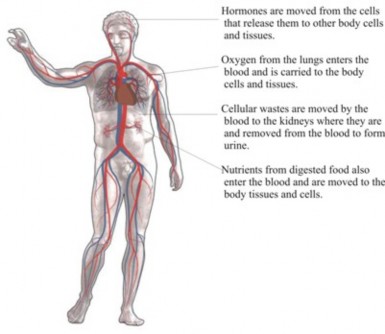
Figure 22.1: The main organs of the circulatory system. Blood acts as the transporter in the body, while blood vessels act like little (one way) roads. The figure is Michelangelo’s marble sculpture David, which does not actually have a circulatory system. (20)
www.ck12.org 1170
in Figure 22.2) which contracts to pump blood around the body. In adults, the normal mass of the heart is 250-350 grams (9-12 oz), or about three quarters the size of a clenched fist, but badly diseased hearts can be up to 1000 g (2 lb) in mass due to enlargement of the cardiac muscle. For an animation of the heart’s anatomy, see http://www.byrnehealthcare.com/ animations/SutterAnatomy.htm.

Figure 22.2: External and internal views of the human heart. The aorta in the photo cannot be seen clearly because it is covered by a layer of adipose tissue (fat). (15)
The heart is usually found in the left to middle of the chest with the largest part of the heart slightly to the left. The heart is usually felt to be on the left side because the left ventricle is stronger (it pumps to all the body parts). The heart is surrounded by the lungs. The left lung is smaller than the right lung because the heart takes up more room in the left side of the chest. The position of the heart within the chest is shown in Figure 22.3.
Blood Flow Through the Heart
Blood flows through the heart in two separate loops; you could think of them as a “left side loop” and a “right side loop.” The right side and left side of the heart refer to your heart as it sits within your chest. Its left side is your left side and, its right side is your right side.
The right side of the heart collects deoxygenated blood from the body and pumps it into the lungs where it releases carbon dioxide and picks up oxygen. The left-side carries the
1171 www.ck12.org

Figure 22.3: Position of the heart in relation to the lungs. The heart can be seen in the lower middle area of the figure, behind the lungs. (39)
www.ck12.org 1172
oxygenated blood back from the lungs, into the left side of the heart which then pumps the oxygenated blood throughout the rest of the body.
The heart has four chambers, the two upper atria and the two lower ventricles. Atria (singular, atrium) are the thin-walled blood collection chambers of the heart. Atria pump the blood into the ventricles. Ventricles are the heart chambers which collect blood from the atria and pump it out of the heart. On the right side of the heart, deoxygenated blood from the body enters the right atrium from the superior vena cava and the inferior vena cava, shown in Figure 22.4. Blood enters the right ventricle which then pumps the blood through the pulmonary arteries and into the lungs. In the lungs, carbon dioxide is released from the blood and oxygen is picked up.
Pulmonary veins bring the oxygenated blood back to the heart and into the left atrium. From the left atrium the blood moves to the left ventricle which pumps it out to the body through the aorta. On both sides, the lower ventricles are thicker and stronger than the upper atria. The muscle wall surrounding the left ventricle is thicker and stronger than the wall surrounding the right ventricle because the left ventricle needs to exert enough force to pump the blood through the body. The right ventricle only needs to pump the blood as far as the lungs, which does not require as much contractile force.
Valves in the heart maintain the flow of blood by opening and closing in one direction only. Blood can move only forward through the heart, and is prevented from flowing backward by the valves. Such movement of the blood is called unidirectional flow. There are four valves of the heart:
The two atrioventricular (AV) valves ensure blood flows from the atria to the ventricles, and not the other way. The AV valve on the right side of the heart is called the tricuspid valve, and the one on the left of the heart is called the mitral, or bicuspid valve.
The two semilunar (SL) valves are present in the arteries leaving the heart, and they prevent blood flowing back from the arteries into the ventricles. The SL valve on the right side of the heart is called the pulmonary valve, because it is leads to the pulmonary arteries, and the SL valve on the left is called aortic valve because it leads to the aorta. The valves of the heart are shown in Figure 22.4.
The Heartbeat
The heart is a meshwork of cardiac muscle cells that are interconnected by little channels called gap junctions. This interconnection allows the electrical stimulation of one cell to spread quickly to its neighboring cells. Cardiac muscle is self-exciting. This is in contrast to skeletal muscle, which needs nervous stimulation to contract. The heart’s rhythmic con- tractions occur spontaneously, although the frequency of the contractions, called the heart
1173 www.ck12.org
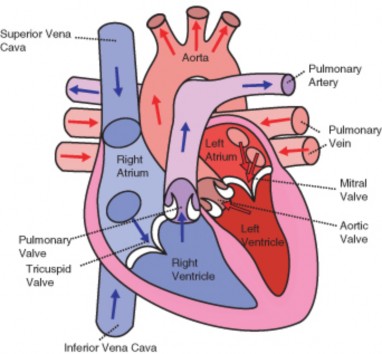
Figure 22.4: The direction of blood flow through the heart. (19)
rate, can be changed by nervous or hormonal signals such as exercise or the perception of danger.
Control of the Heartbeat
The rhythmic sequence of contractions of the heart is coordinated by two small groups of cardiac muscle cells called the sinoatrial (SA) and atrioventricular (AV) nodes. The sinoatrial node (SA node), often known as the ”cardiac pacemaker”, is found in the upper wall of the right atrium and is responsible for the wave of electrical stimulation that starts atrial contraction by creating an action potential. The action potential causes the cardiac cells to contract. This wave of contraction then spreads across the cells of the atrium, reaching the atrioventricular node (AV node) which is found in the lower right atrium, shown in Figure 22.5. The AV node conducts the electrical impulses that come from the SA node through the atria to the ventricles. The impulse is delayed there before being conducted through special bundles of heart muscle cells called the bundle of His and the Purkinje fibers, which leads to a contraction of the ventricles. This delay allows for the ventricles to fill with blood before the ventricles contract. Heartbeat is also controlled by nerve messages originating from the autonomic nervous system.
There are important physiological differences between cardiac cells found in the nodes and www.ck12.org 1174
cardiac cells found in the ventricles. Differences in ion channels and mechanisms of polar- ization give rise to unique properties of SA node cells, most importantly the spontaneous depolarizations necessary for the SA node’s pacemaker activity.
The Bundle of His is a collection of heart muscle cells (fibers) specialized for electrical conduction that transmits the electrical impulses from the AV node. The bundle of His branches into Purkinje fibers. Purkinje fibers, shown in Figure 22.6, are specialized cardiac muscle cells that conduct action potentials into the ventricles, causing the cardiac muscle of the ventricles to contract in a controlled way.

Figure 22.5: Schematic representation of the atrioventricular Bundle of His. The SA node is blue, and the AV node is red and visible in the right atrium. The AV node forms the Bundle of His. Sometimes the left and right Bundles of His are called Purkinje fibers. (9)
The heartbeat is made up of two parts; muscle contraction and relaxation. Systole is the contraction of the heart chambers, which drives blood out of the chambers. Diastole is the period of time when the heart relaxes after contraction. All four chambers of the heart undergo systole and diastole in a timed fashion so that blood is moved forward through the
1175 www.ck12.org

Figure 22.6: The larger round cells on the right are Purkinje fibers. Because of their spe- cializations to rapidly conduct impulses (numerous sodium ion channels and mitochondria, fewer myofibrils than the surrounding muscle tissue), Purkinje fibers take up stain differently than the surrounding muscles cells, and on a slide, they often appear lighter and larger than their neighbors. (34)
cardiovascular system. For example, ventricular systole is the point at which the ventricles are contracting, and atrial systole is the point at which the atria are contracting. Likewise, ventricular diastole is the period during which the ventricles are relaxing, while atrial diastole is the period during which the atria are relaxing. In general, when referring to systole and diastole, the chambers being referred to are the ventricles, which is shown in Figure 22.7.
Heart Sounds
In healthy adults, there are two normal heart sounds often described as a ”lub” and a ”dub” that occur with each heart beat (lub-dub, lub-dub). In addition to these normal sounds, a variety of other sounds may be heard including heart murmurs or clicks. A medical practitioner uses a stethoscope to listen for these sounds, which gives him or her important information about the condition of the heart.
The sound of the heart valves shutting causes the heart sounds, or a heartbeat. The closing of the mitral and tricuspid valves (known together as the atrioventricular valves) at the beginning of ventricular systole cause the first part of the ”lub-dub” sound made by the heart as it beats. The second part of the ”lub-dub” is caused by the closure of the aortic and pulmonic valves at the end of ventricular systole. As the left ventricle empties, its pressure falls below the pressure in the aorta, and the aortic valve closes. Similarly, as the pressure
www.ck12.org 1176

Figure 22.7: When the atria contract, the blood gets pushed into the ventricles which are in diastole. When the ventricles contract (ventricular systole), the blood gets pushed out of the heart. (31)
in the right ventricle falls below the pressure in the pulmonary artery, the pulmonic valve closes.
Blood Vessels
The blood vessels are part of the cardiovascular system and function to transport blood throughout the body. The two most important types are arteries and veins. Arteries carry blood away from the heart, while veins return blood to the heart.
There are various kinds of blood vessels, the main types are:
Arteries are the large, muscular vessels that carry blood away from the heart.
An arteriole is a small diameter blood vessel that extends and branches out from an artery and leads to capillaries.
Veins are vessels that carry blood toward the heart. The majority of veins in the body carry low-oxygen blood from the tissues back to the heart.
A venule is a small vessel that allows deoxygenated blood to return from the capillaries to veins.
Capillaries are the smallest of the body’s blood vessels, that connect arterioles and venules, and are important for the interchange of gases and other substances between blood and body cells.
1177 www.ck12.org
The blood vessels have a similar basic structure. The endothelium is a thin layer of cells that creates a smooth lining on the inside surface of blood vessels. Endothelial tissue is a specialized type of epithelium, one of the four types of tissue found in the body. Endothelial cells have an important structural role in blood vessels; they line the entire circulatory system, from the heart to the smallest capillary. Around the endothelium there is a layer of smooth muscle, which is well developed in arteries. Finally, there is a further layer of connective tissue that surrounds the smooth muscle. This connective tissue, which is mostly made up of collagen, contains nerves that supply the smooth muscular layer. The connective tissue surrounding larger vessels also contains capillaries to bring nutrients to the tissue. Capillaries, the smallest blood vessels, are made up of a single layer of endothelium and a small amount of connective tissue.
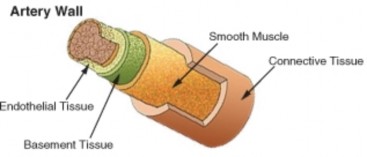
Figure 22.8: The structure of an artery wall. (16)
Arteries and Arterioles
The arteries carry blood away from the heart. As shown in Figure 22.8, arteries have thick walls that have three major layers; an inner endothelial layer, a middle layer of smooth mus- cle, and an outer layer of stretchy connective tissue (mostly collagen). The elastic qualities of artery walls allow them to carry pressurized blood from the heart while maintaining blood pressure.
The aorta is the largest artery in the body. It receives blood directly from the left ventricle of the heart through the aortic valve. The aorta branches, into smaller arteries and these arteries branch in turn, becoming smaller in diameter, down to arterioles. The arterioles supply the capillaries that carry nutrients to the body’s cells and tissues. The aorta is an elastic artery. When the left ventricle contracts to force blood into the aorta, it expands. This stretching gives the potential energy that will help maintain blood pressure during diastole when the aorta contracts passively.
An arteriole is a small-diameter blood vessel that branches out from an artery and leads to capillaries. Arterioles have thin muscular walls, composed of one or two layers of smooth muscle, and are the primary site of vascular resistance. Vascular resistance is the resistance
www.ck12.org 1178
to flow that blood must overcome to be pumped through your circulatory system. Increasing vascular resistance is one way your body can increase blood pressure.
Veins and Venuoles

Figure 22.9: Internal structure of a vein. (8)
Veins return deoxygenated blood to the heart. The thick, outer layer of a vein is made up of collagen-containing connective tissue, shown in Figure 22.9. The connective tissue is wrapped around bands of smooth muscle while the interior is lined with endothelium. Most veins have one-way flaps called valves, shown in in Figure 22.10, that prevent blood from flowing backward and pooling in the legs, feet, arms or hands due to the pull of gravity. The location of veins can vary from person to person.
A venule is a small blood vessel that allows deoxygenated blood to return from the capillary beds to the larger blood vessels called veins. Venules have three layers: an inner endothelium composed of squamous epithelial cells that act as a membrane, a middle layer of muscle and elastic tissue, and an outer layer of fibrous connective tissue. The middle layer is poorly developed so that venules have thinner walls than arterioles.
Capillaries
Capillaries are the smallest of a body’s blood vessels, measuring 5-10 m in diameter. Their size is shown in relation to body cells in Figure 22.11. Capillaries connect arterioles and venules, and they are important for the exchange of oxygen, carbon dioxide, and other substances between blood and body cells.
The walls of capillaries are made of only a single layer of endothelial cells. This layer is so thin that molecules such as oxygen, water and lipids can pass through them by diffusion and enter the body tissues. Waste products such as carbon dioxide and urea can diffuse back into the blood to be carried away for removal from the body. Capillaries are so small the blood cells need to pass through it in a single file line. A capillary bed is the network of capillaries supplying an organ. The more metabolically active a tissue or organ is, the more capillaries it needs to get nutrients and oxygen.
1179 www.ck12.org

Figure 22.10: Valves found in veins prevent the blood from flowing backward and pooling in the lowest parts of the body, such as the legs and feet. (28)

Figure 22.11: The structure of capillaries. Note their size in comparison to the cells around them. (36)
www.ck12.org 1180
Blood vessels are roughly grouped as arterial and venous. This grouping is determined by whether the blood in the vessel is flowing away from (arterial) or toward (venous) the heart. In general the term arterial blood is used to describe blood high in oxygen, although the pulmonary arteries carry deoxygenated blood and blood flowing in the pulmonary vein is rich in oxygen.
Roles of Blood Vessels
Blood vessels are not involved in regulating the transport of blood, the endocrine and nervous systems do that. However, arteries and veins can regulate their inner diameter by contraction of the smooth muscle layer. This widening or narrowing of the blood vessels changes the blood flow to the organs of the body. This process is controlled by the autonomic nervous system; it is not controlled consciously.
Vasodilation is a process by which blood vessels in the body become wider due to the relaxation of the smooth muscle in the vessel wall. This reduces blood pressure since there is more room for the blood to move through the vessel. Endothelium of blood vessels uses nitric oxide to signal the surrounding smooth muscle to relax, which dilates the artery and increasing blood flow. Nitric dioxide is a vasodilator.
Vasoconstriction is the constriction of blood vessels (narrowing, becoming smaller in cross- sectional area) by contracting the vascular smooth muscle in the vessel walls. Vasoconstric- tion is controlled by substances such as some hormones and neurotransmitters, which are called vasoconstrictors. For example, the “fight or flight” hormone epinephrine is a vasocon- strictor that is released by the adrenal glands.
Permeability of the endothelium is important for the release of nutrients to the tissue. Permeability is the ability of a membrane to allow certain molecules and ions to pass through it by diffusion. Permeability of the endothelium increases during an immune response, which allows white blood cells and other substances to get to the site of injury or irritation.
Oxygen, which is bound to hemoglobin in red blood cells for transport through the body, is the most critical nutrient carried by the blood. In all arteries apart from the pulmonary artery, hemoglobin is highly saturated (95-100%) with oxygen. In all veins apart from the pulmonary vein, the hemoglobin is desaturated at about 70%. (The values are reversed in the pulmonary circulation.)
Blood Vessels and Blood Pressure
Blood pressure refers to the force exerted by circulating blood on the walls of blood vessels. The pressure of the circulating blood gradually decreases as blood moves from the arteries, arterioles, capillaries, and veins. The term ”blood pressure” generally refers to arterial pressure, which is the pressure in the larger arteries that take blood away from the heart.
1181 www.ck12.org
Arterial pressure results from the force that is applied to blood by the contracting heart, where the blood “presses” against the walls of the arteries.
The systolic arterial pressure is defined as the peak pressure in the arteries, which occurs near the beginning of the cardiac cycle; the diastolic arterial pressure is the lowest pressure (at the resting phase of the cardiac cycle).
Arterial pressure is most commonly measured by a sphygmomanometer, shown in Fig- ure 22.12. The height of a column of mercury indicates the pressure of the circulating blood. Although many modern blood pressure devices no longer use mercury, values are still universally reported in millimeters of mercury (mmHg).
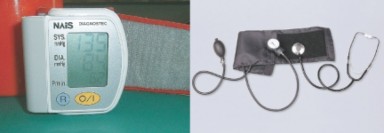
Figure 22.12: The new and the “classic” ways to measure blood pressure. A digital sphyg- momanometer, shown on the left, runs on electricity or batteries and measure blood pressure automatically. The cuff, which you can see behind the digital readout, is wrapped around the upper arm, just like the cuff of the older devices. The cuff then inflates automatically and measures blood pressure as the cuff deflates. The older, mechanical sphygmomanometer with a cuff and pressure reader and stethoscope is shown at right. The cuff is inflated and deflated manually while a medical technician listens for related changes in the sound of blood moving through arteries in the arm. (11)
Blood Pressure Ranges
In the U.S., the healthy ranges for arterial pressure are:
Systolic: less than 120 mm Hg
Diastolic: less than 80 mm Hg
Blood pressure is usually written as systolic/diastolic mm Hg; for example, a reading of 120/80 mm Hg, is said as ”one twenty over eighty.” These measures of arterial pressure are not static, but go through natural variations from one heartbeat to another and throughout the day (in a circadian rhythm). Factors such as age, gender and race influence blood pressure values. Pressure also varies with exercise, emotional reactions, sleep, stress, nutritional factors, drugs, or disease.
www.ck12.org 1182
Studies have shown that people whose systolic pressure is around 115 mm Hg rather than 120 mmHg have fewer health problems. Clinical trials have shown that people who have arterial pressures at the low end of these ranges have much better long term cardiovascular health for this reason some researchers say that 115/75 mm Hg should be the ideal measurement.
Hypertension is a condition in which a person’s blood pressure is chronically high. Hyper- tension is said to be present when a person’s systolic blood pressure is always 140 mm Hg or higher, and/or their diastolic blood pressure is always 90 mm Hg or higher. Blood pressure readings between 120/80 mmHg and 139/89 mmHg are called prehypertension. Prehyper- tension is not a disease category; rather, it is a way to identify people who are at high risk of developing hypertension.
Arterioles and Blood Pressure
Arterioles have the greatest collective influence on both local blood flow and on overall blood pressure. They are the primary ”adjustable nozzles” in the blood system, across which the greatest pressure drop occurs. The combination of heart output (cardiac output) and systemic vascular resistance, which refers to the collective resistance of all of the body’s arterioles, are the principal determinants of arterial blood pressure at any given moment.
Pulmonary and Systemic Circulations
The double circulatory system of blood flow refers to the separate systems of pulmonary cir- culation and the systemic circulation in amphibians, birds and mammals, including humans. The adult human heart consists of two separated pumps, the right side which pumps de- oxygenated blood into the pulmonary circulation, and the left side which pumps oxygenated blood into the systemic circulation. Blood in one circuit has to go through the heart to enter the other circuit, as shown in Figure 22.13.
Pulmonary Circulation
The pulmonary circulation is the portion of the cardiovascular system which carries oxygen-poor (deoxygenated) blood away from the heart, to the lungs, and returns oxygenated blood back to the heart. As shown in Figure 22.14, deoxygenated blood from the body leaves the right ventricle through the pulmonary arteries, which carry the blood to each lung. The pulmonary arteries are the only arteries that carry deoxygenated blood. In the lungs, red blood cells release carbon dioxide and pick up oxygen during respiration. The oxygenated blood then leaves the lungs through the pulmonary veins, which return it to the left side of the heart, and complete the pulmonary cycle. The oxygenated blood is then distributed to the body through the systemic circulation before returning again to the pulmonary circulation.
The pulmonary circulation was first discovered by a Syrian physician, Ibn al-Nafis, in 1242.
1183 www.ck12.org
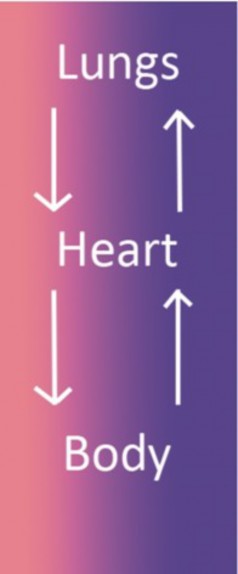
Figure 22.13: The double circulatory system. Blood in one circuit has to go through the heart to enter the other circuit. The heart-to-lungs-to heart portion is the pulmonary circulation, and the heart-to-body-to-heart portion is the systemic circulation. (33)
www.ck12.org 1184
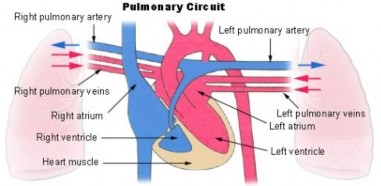
Figure 22.14: Pulmonary circulation. The pulmonary arteries carry oxygen-poor blood from the right ventricle to the lungs, and the pulmonary veins return oxygenated blood to the left side of the heart. This “loop” is called the pulmonary cycle. (37)
However, credit for the first description of blood circulation is given to an English medi- cal doctor William Harvey, who in 1616 described in detail the pulmonary and systemic circulation systems.
Systemic Circulation
The systemic circulation is the portion of the cardiovascular system which carries oxy- genated blood away from the heart, to the body, and returns deoxygenated blood back to the heart. Oxygenated blood from the lungs leaves the left ventricle through the aorta, from where it is distributed to the body’s organs and tissues, which absorb the oxygen, through a complex network of arteries, arterioles, and capillaries. The deoxygenated blood is then collected by venules, from where it flows first into veins, and then into the inferior and su- perior venae cavae, which return it to the right heart, completing the systemic cycle, shown in Figure 22.15. The blood is then re-oxygenated through the pulmonary circulation before returning again to the systemic circulation.
Just like every other organ in the body, the heart needs its own blood supply, which it gets through the coronary circulation. Although blood fills the chambers of the heart, the heart muscle tissue is so thick that it needs blood vessels to deliver oxygen and nutrients deep within it. The vessels that deliver oxygen-rich blood to the heart muscle are called coronary arteries, they branch directly from the aorta, just above the heart, shown in Figure 22.16. The vessels that remove the deoxygenated blood from the heart muscle are known as cardiac veins.
1185 www.ck12.org
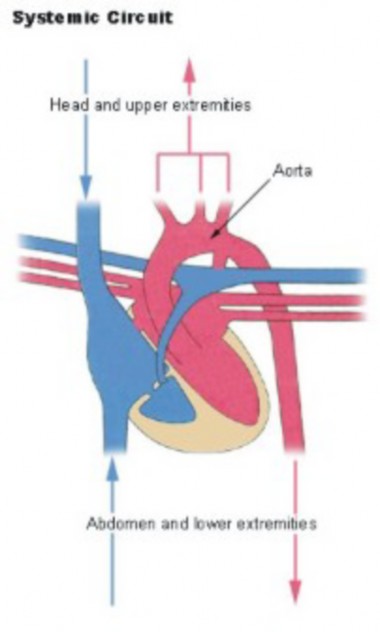
Figure 22.15: The systemic circulation. The systemic circulation brings oxygenated blood to the body cells and tissues and transports cellular wastes. It is also responsible for tem- perature regulation and transport of hormones and other substances around the body. (18)
www.ck12.org 1186
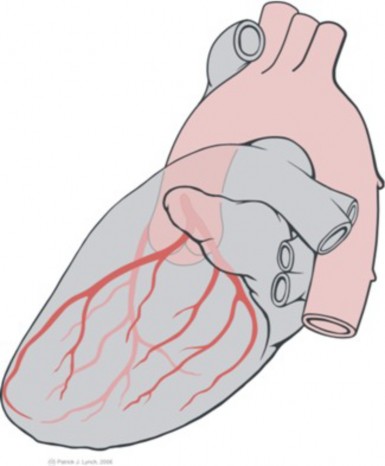
Figure 22.16: This side view (lateral view), of the heart shows how the coronary arteries (in red) branch directly from the aorta to bring oxygen and nutrients into the heart muscle. (5)
1187 www.ck12.org
Portal Venous System
A portal venous system occurs when a capillary bed drains into another capillary bed through veins. They are relatively uncommon as the majority of capillary beds drain into the heart, not into another capillary bed. Portal venous systems are considered venous because the blood vessels that join the two capillary beds are either veins or venules.
An example of a portal venous system is the blood vessel network between the digestive tract and the liver. The hepatic portal system is responsible for directing blood from parts of the gastrointestinal tract to the liver. Nutrients that have been absorbed into the blood from the small intestine are taken to the liver for processing before being sent to the heart. The term, ”portal venous system” often refers to the hepatic portal system.
Lymphatic System
The lymphatic system, shown in Figure 22.17, is a complex network of lymph nodes, lymph ducts, lymphatic tissues, lymph capillaries and lymph vessels that extend the length of the body. It serves as a conduit for a fluid called lymph. The lymphatic system is often called the secondary circulatory system.
The lymphatic system has three related functions:
The removal of excess fluids from body tissues.
The absorption of fats, also known as fatty acids or lipids, and transport of fats to the cardiovascular system.
The production of certain types of white blood cells, which aid in the body’s immune response.
Lymph originates as blood plasma that leaks from the capillaries of the cardiovascular system. This blood plasma fills the space between individual cells of tissue where it becomes part of the interstitial fluid. Plasma is forced out of the capillaries and forced back in due to interactions of hydrostatic pressure. While out of the blood capillaries, the plasma increases the volume of the interstitial fluid. Most of the interstitial fluid is returned to the capillaries by osmosis. The excess interstitial fluid is collected by the lymphatic system by diffusion into lymph capillaries, and is processed by lymph nodes before to being returned to the circulatory system. Once within the lymphatic system the fluid is called lymph, and has almost the same composition as the original interstitial fluid.
Fatty acids, also known as fats or lipids, are transported through the cardiovascular system differently than other nutrients, such as proteins and sugars. Lipids are absorbed by cells in the villi of the small intestine where they form a complex with protein molecules. These lipo-proteins are called chylomicrons. The chylomicrons are transported via the lymphatic system and eventually rejoin the bloodstream to be processed by the liver.
www.ck12.org 1188
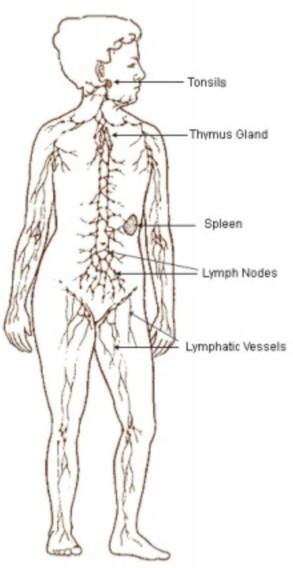
Figure 22.17: Lymphatic system (23)
1189 www.ck12.org
The lymphatic system is a major component of the immune system. The lymphatic system has many lymph nodes. Lymph nodes are filters or traps for foreign particles and contain white blood cells. Human lymph nodes are bean-shaped and range in size from a few mil- limeters to about 1 to 2 cm. White blood cells are located within honeycomb structures of the lymph nodes. Lymph that moves through the lymph nodes is filtered so that microor- ganisms and tissue debris are removed. Lymph nodes swell and feel sore when the body is infected due to the increased production of white blood cells.
The spleen and tonsils are large lymphoid organs that serve similar functions to lymph nodes, though the spleen filters blood cells rather than bacteria or viruses.
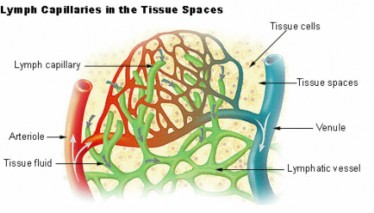
Figure 22.18: The movement of lymph from the interstitial fluid into the lymphatic vessels. Lymph moves in only one direction through the blood vessels. (6)
Lymphatic Circulation
Unlike the blood system, the lymphatic system is not closed and has no central pump. Lymph movement occurs slowly with low pressure due to peristalsis, valves, and the squeezing action of skeletal muscles. Lymph travels through lymph vessels that are similar to capillaries and veins. Lymph moves in one direction only, due to valves in lymph vessels that are similar to the valves found in veins, shown in Figure 22.18. The movement of lymph depends on the movement of skeletal muscles to squeezing the lymph through them, especially near the joints. Rhythmic contraction of the vessel walls through movements may also help draw fluid into the small lymphatic capillaries. The lymph is then transported to progressively larger lymphatic vessels that drain into the circulatory system at the right and left subclavian veins.
www.ck12.org 1190
Homeostatic Imbalance of the Lymphatic System
In the disease known as elephantiasis, shown in Figure 22.19, infection of the lymphatic vessels cause a thickening of the skin and enlargement of the underlying tissues, especially in the legs and genitals. It is most commonly caused by infection by parasitic roundworms.
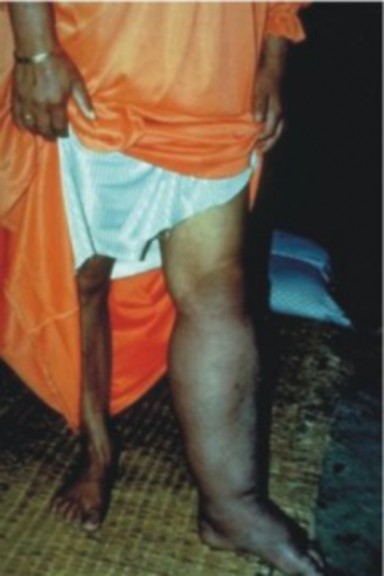
Figure 22.19: Over a billion people are at risk for infection by filarial nematodes, the parasites that cause elephantiasis. (35)
Lymphedema also causes abnormal swelling, especially in the arms and legs (though the face, neck, and abdomen can also be affected). It occurs if the lymphatic system is damaged, or underdeveloped in some way. An estimated 170 million suffer with the disorder.
1191 www.ck12.org
Lymphoma, or lymphatic cancer, is cancer of the lymphatic system. According to the American Cancer Society, in 2007, lymphoma accounted for 4 percent of new cancer cases amongst men and women in the United States. In lymphoma, cells of the lymphatic system grow abnormally. They divide too rapidly and grow without any order or control. Because lymphatic tissue is present in many parts of the body, lymphoma can start almost anywhere. Lymphoma may occur in a single lymph node, a group of lymph nodes, or, sometimes, in other parts of the lymphatic system such as the bone marrow and spleen.
Homeostatic Imbalances of the Cardiovascular System
Cardiovascular disease (CVD) refers to any disease that affects the cardiovascular sys- tem, but it is usually used to refer to diseases related to atherosclerosis, which is a chronic inflammatory response in the walls of arteries that causes a swelling and buildup of materials called plaque. Plaque is made of cell debris, cholesterol, fatty acids, calcium, and fibrous connective tissue that build up around an area of inflammation. As a plaque grows it stiffens and narrows the artery, which reduces the flow of blood through the artery, shown in Figure 22.20.

Figure 22.20: Atherosclerosis is sometimes referred to as hardening of the arteries. (21)
www.ck12.org 1192
Atherosclerosis
Atherosclerosis normally begins in later childhood, and is usually found in most major arter- ies. It does not usually have any early symptoms. Causes of atherosclerosis include a high-fat diet, high cholesterol, smoking, obesity, and diabetes. Atherosclerosis becomes a threat to health when the plaque buildup interferes with the blood circulation in the heart (coronary circulation) or the brain (cerebral circulation). A blockage in the coronary circulation, can lead to a heart attack, and blockage of the cerebral circulation (leading to, or within the brain) can lead to a stroke. According to the American Heart Association, atherosclerosis is a leading cause of CVD.
Coronary Heart Disease
Cardiac muscle cells are fed by the coronary arteries. Blocked flow in a coronary artery can result in oxygen starvation and death of heart muscle. Coronary heart disease is the end result of the buildup of plaques within the walls of the coronary arteries, shown in Figure
Most individuals with coronary heart disease have no symptoms for many years until the first sign, often a heart attack, happens.
A symptom of coronary heart disease is chest pain. Occasional chest pain, called angina pectoralis (or angina) can happen during times of stress or physical exertion. The pain of angina means the heart muscle fibers need more oxygen than they are getting.
A heart attack, also called a myocardial infarction (MI), occurs when the blood supply to a part of the heart is blocked, as shown in Figure 22.22. A heart attack can occur from the buildup and blockage of a coronary artery by plaque, or it can be caused by a small piece of plaque that breaks away when a larger plaque breaks apart. This piece of free-floating plaque, called an embolus, can get stuck in a coronary blood vessel, causing a blockage or embolism. Cardiac muscle fibers that are starved of oxygen for more than five minutes will die, and because they do not divide, dead cardiac muscle cells cannot be replaced. Coronary heart disease is the leading causes of death of adults in the United States. For an animation depicting a heart attack, see http://www.byrnehealthcare.com/animations/ SutterHeartAttack.htm.
Stroke
Since atherosclerosis is a body wide process, similar events can also occur in the arteries to other parts of the body, including the brain. A stroke is a loss of brain function due to a stoppage of the blood supply to the brain. It can be caused by a blot clot (thrombosis), a free- floating object that gets caught in a blood vessel (embolism), or by bleeding (hemorrhage). For an animation depicting a stroke, see http://www.byrnehealthcare.com/animations/ SutterStroke.htm.
1193 www.ck12.org
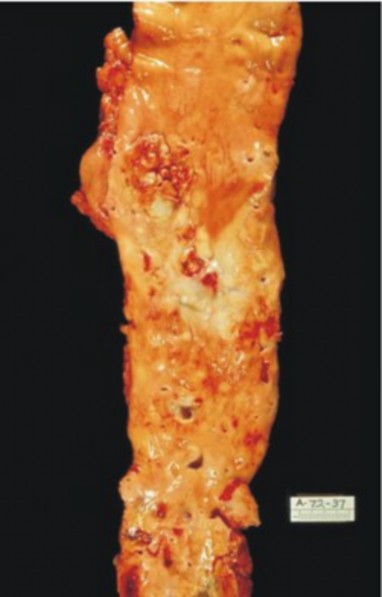
Figure 22.21: Autopsy specimen of an artery has been opened lengthwise to show the inside (lumen) which is completely blocked by many plaques. For a video depicting atherosclero- sis, see www.youtube.com/watch?v=qRK7-DCDKEA. For an atherosclerosis animation, see http://www.byrnehealthcare.com/animations/SutterAtherosclerosis.htm. (24)
www.ck12.org 1194
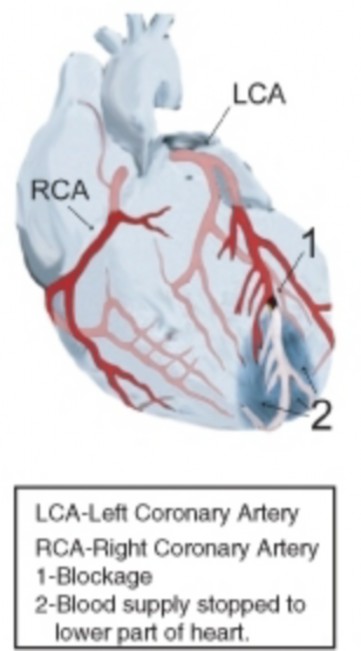
Figure 22.22: Diagram of a heart attack (myocardial infarction). The blood supply to the lower part of the heart is stopped after a blockage of the lower portion of the left coronary artery (LCA). For an animation depicting coronary artery disease, see http://health. howstuffworks.com/adam-200082.htm. (13)
1195 www.ck12.org
Risk factors for stroke include advanced age, high blood pressure, previous stroke, diabetes, high cholesterol, and cigarette smoking. Reduction of blood pressure is the most important modifiable risk factor of stroke; however many other risk factors, such as quitting tobacco smoking, are also important.
Preventing Cardiovascular Diseases
There are many risk factors which are associated with various forms of cardiovascular disease, some of these you cannot control, but many you can control.
Non-controllable risk factors include:
Age: The older a person is, the greater their chance of developing a cardiovascular disease.
Gender: Men under age 64 are much more likely to die of coronary heart disease than women, although the gender difference declines with age.
Genetics: Family history of cardiovascular disease affects a person’s chance of devel- oping heart disease.
Controllable risk factors include:
Tobacco Smoking: Giving up smoking is the single most effective way of reducing risk of heart disease.
Diabetes: Having diabetes can cause metabolic changes (such as high cholesterol levels) which in themselves are risk factors.
High cholesterol levels: High amounts of low density lipids (LDLs) in the blood, also called ”bad cholesterol”, are a significant risk factor.
Obesity: Being obese, especially if the fat is deposited mostly in the torso, rather than the hips and thighs, increases risk significantly.
High blood pressure: Hypertension can cause atherosclerosis.
Lack of physical activity: Aerobic activities, including walking and vacuuming, that are done for 60 minutes a day, five days a week, help keep the heart healthy.
Poor eating habits: Eating mostly foods that are nutrient poor (do not have many nutrients other than fat or carbohydrate) leads to high cholesterol levels and weight gain, among other things.
Although there are uncontrollable risk factors involved in CVD, a person whose family has a history of CVD is not destined to develop heart disease. There are many things such a person can do to help prevent CVD, even when predisposed to a disease. A person who is physically active every day, eats healthfully, and avoids tobacco can lower their chances of developing the disease.
www.ck12.org 1196
Although men have a higher rate of cardiovascular disease than women, it is also the number one health problem for women in industrialized countries. After menopause, the risk for women is almost equal to that of men.
Cardiovascular Disease Awareness
Cardiovascular diseases are called ”lifestyle diseases” because they are caused mostly by everyday choices that people make, such as what to eat for dinner, or what to do during their free time. For example, watching TV with your dog does not involve much moving around so it does not exercise the body, whereas bringing the dog for a walk outside exercises both of you. Decisions that you make today and everyday will affect your cardiovascular health many years from now, such as those shown in Figure 22.23.
Many studies have shown that plaque buildup starts in early adolescence. However, teens are more concerned about risks such as HIV, accidents, and cancer than cardiovascular disease. One in three people will die from complications due to atherosclerosis. For this reason there is an emphasis on the prevention of CVD through risk reduction. For example, healthy eating, regular physical activity, and avoidance of smoking can greatly decrease a person’s chance of developing a CVD.
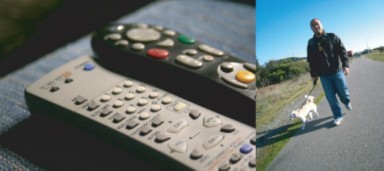
Figure 22.23: Limiting sedentary activities such as watching TV, and making more time for walking, hiking, cycling, or running will help develop a healthy heart. (12)
Congenital Heart Defects
A congenital heart defect is a problem with the structure of the heart that is present at birth. Such heart defects are the most common type of major birth defect. Most heart defects either obstruct blood flow in the heart or vessels near it, or cause blood to flow through the heart in an abnormal pattern, although other defects affecting heart rhythm can also occur.
Treatment for a defect can include medicines, surgery, and other medical procedures and
1197 www.ck12.org
heart transplants. The treatment depends on the type and severity of the defect and the child’s age, size and general health. Also, certain mild defects that some children are born with are repaired over time by the body.
Lesson Summary
The main components of the cardiovascular system are the heart, the blood vessels, and the blood. It moves nutrients, hormones, gases and wastes to and from body cells, and distributes heat to maintain homeostasis.
Deoxygenated blood enters the right atrium from the body through the vena cava; oxygenated blood coming from the lungs through the pulmonary vein enters the left atrium. The atria then contract, pushing the blood into the ventricles. After a short delay, the ventricles contract, the oxygenated blood gets pushed through the aorta to the rest of the body, and the deoxygenated blood gets pushed to the lungs through the pulmonary arteries.
Arteries have thick walls that have three major layers; an inner endothelial layer, a middle layer of smooth muscle, and an outer layer of stretchy connective tissue (mostly collagen). The thick, outer layer of a vein is made up of collagen-containing connective tissue. The connective tissue is wrapped around bands of smooth muscle while the interior is lined with endothelium. Most veins have one-way flaps called valves that prevent blood from flowing backward and pooling in the legs, feet, arms or hands due to the pull of gravity. The walls of capillaries are made of only a single layer of endothelial cells.
The lymphatic system has three related functions; the removal of excess fluids from body tissues, the absorption of fats and transport of fat to the cardiovascular system, and the production of certain types of white blood cells.
Atherosclerosis, which may lead to a heart attack, is a chronic inflammatory response in the walls of arteries that leads to a buildup of plaque. Plaque is made of cell debris, cholesterol, fatty acids, calcium, and fibrous connective tissue that build up around an area of inflammation. As a plaque grows it stiffens and narrows the artery, which reduces the flow of blood through the artery.
Eating nutritious food, being physically active for 60 minutes on most days of the week, and avoiding smoking are three of the most effective things a person can do to avoid cardiovascular disease.
Summary Animation
http://www.hostos.cuny.edu/oaa/heart/heart.html
www.ck12.org 1198
Review Questions
Why is the left ventricle generally thicker than the right ventricle?
At what point do the pulmonary and systemic circulation systems meet up?
Why do veins have valves? Use the heart Figure 22.24 to answer the following four questions:
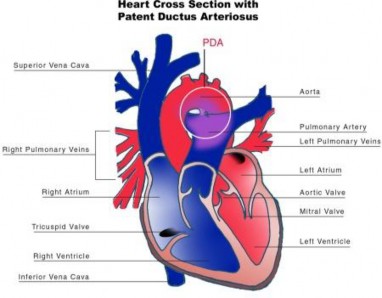
Figure 22.24: (27)
What two structures are involved in the patent ductus arteriosus shown in this diagram. (Hint: The patent ductus arteriosus is the structure found inside the white circle at top center).
Propose what might happen to blood flow around the site of the PDA.
Would a PDA be considered a heart defect? Explain your answer.
How might the PDA affect the body? Use Figure 22.25 of the estimated prevalence of cardiovascular disease (CVD) in the U.S. population to answer the following three questions.
What is the overall trend in the prevalence of CVD in the U.S. population?
In what age group does the prevalence of CVD in the female population equal that of the male population?
At what point does 50 percent of the male and female population have CVD?
Further Reading / Supplemental Links
Vanhecke et al. Awareness, knowledge, and perception of heart disease among adoles- cents. EJCPR 2006;13:718-723.
1199 www.ck12.org

Figure 22.25: (10)
Strong, J.P., et al. Prevalence and Extent of Atherosclerosis in Adolescents and Young Adults JAMA. 1999;281:727-735. Available online at:
http://jama.ama-assn.org/cgi/content/full/281/8/727
http://www.estrellamountain.edu/faculty/farabee/biobk/BioBookcircSYS.html
http://training.seer.cancer.gov/ss_module08_lymph_leuk/lymph_unit01_sec01_ intro.html
http://www.nlm.nih.gov/medlineplus/ency/article/000171.htm#Causes,%20incidence,
%20and%20risk%20factors
http://www.nlm.nih.gov/medlineplus/congenitalheartdefects.html
http://www.americanheart.org
http://www.accessexcellence.org/
http://whyfiles.org/090doping_sport/3.html
http://whyfiles.org/
http://en.wikipedia.org
Vocabulary
arteriole Small diameter blood vessel that extends and branches out from an artery and leads to capillaries.
artery Large, muscular vessels that carry blood away from the heart.
atria Thin-walled blood collection chambers of the heart, pump blood into the ventricles (singular, atrium).
atrioventricular node Conducts the electrical impulses that come from the SA node through the atria to the ventricles.
www.ck12.org 1200
atrioventricular valves Ensure blood flows from the atria to the ventricles.
blood pressure The force exerted by circulating blood on the walls of blood vessels.
Bundle of His A collection of heart muscle cells (fibers) specialized for electrical conduc- tion that transmits the electrical impulses from the AV node.
cardiovascular system An organ system that moves nutrients, hormones, gases and wastes to and from body cells, and distributes heat to maintain homeostasis.
capillary Smallest of the body’s blood vessels, connects arterioles and venules, and are important for the interchange of gases and other substances between blood and body cells.
coronary circulation Supplies the heart tissue with blood.
diastole Period of time when the heart relaxes after contraction.
heart The muscular organ that pumps blood through the blood vessels by repeated, rhyth- mic contractions.
hypertension Condition in which a person’s blood pressure is chronically high.
pulmonary circulation Portion of the cardiovascular system which carries deoxygenated blood away from the heart, to the lungs, and returns oxygenated blood back to the heart.
Purkinje fibers Specialized cardiac muscle cells that conduct action potentials into the ventricles, causing the cardiac muscle of the ventricles to contract in a controlled fash- ion.
semilunar valves Present in the arteries leaving the heart, prevent blood flowing back from the arteries into the ventricles.
sinoatrial node Known as the ”cardiac pacemaker,” found in the upper wall of the right atrium, is responsible for the wave of electrical stimulation that starts atrial contraction by creating an action potential.
sphygmomanometer Measures arterial pressure.
1201 www.ck12.org
systemic circulation Portion of the cardiovascular system which carries oxygenated blood away from the heart, to the body, and returns deoxygenated blood back to the heart.
systole Contraction of the heart chambers, which drives blood out of the chambers.
vascular resistance Resistance to flow that blood must overcome to be pumped through your circulatory system.
vasoconstriction Constriction of blood vessels by contracting the vascular smooth muscle in the vessel walls.
vasodilatation Process by which blood vessels in the body become wider due to the re- laxation of the smooth muscle in the vessel wall.
vein Vessel that carries blood toward the heart.
ventricles Heart chambers which collect blood from the atria and pump it out of the heart.
venule Small vessel that allows deoxygenated blood to return from the capillaries to veins.
Points to Consider
How may factors such as the region of the world in which you live or your type of employment contribute to your risk of developing cardiovascular disease?
Hypothesize about the role of blood in your excretory system.
Lesson 22.2: Blood
Lesson Objectives
List three functions of blood.
Describe the composition of blood.
Outline the process of blood clotting.
Identify two major blood group systems.
Outline the significance of blood type in transfusions.
Describe two diseases of the blood. www.ck12.org 1202
Introduction
Blood is a fluid connective tissue. It circulates around the body through the blood vessels by the pumping action of the heart. Arterial blood carries oxygen and nutrient to all the body’s cells, and venous blood carries carbon dioxide and other metabolic wastes away from the cells.
In addition to the transport of gases, nutrients, and wastes, blood has many other functions that include:
The removal of waste such as carbon dioxide, urea and lactic acid from the body tissues.
The defense of the body against infection by microorganisms or parasites.
The repair of damage to the body tissues.
The transport of chemical messages, such as hormones and hormone-like substances.
The control of body pH (the normal pH of blood is in the range of 7.35 - 7.45).
The control of body temperature.
The Composition of Blood
Blood is a colloidal solution, it is made up of particles suspended in a fluid. It accounts for about 7% of the human body weight. The average adult has a blood volume of roughly 5 liters, composed of a fluid called plasma, and several kinds of cells. Within the blood plasma, are erythrocytes (red blood cells), leukocytes (white blood cells), thrombocytes (platelets) and other substances. The cells that make up the blood can be seen in Figure 22.26.
Plasma
Plasma is the golden-yellow liquid part of the blood. Plasma is 90% water and 10% dis- solved materials including proteins, glucose, ions, hormones, and gases. It acts as a buffer, maintaining pH near 7.4. Plasma is about 54% the volume of blood; cells and fragments make up about 46% of the volume.
Red Blood Cells
Red blood cells, also known as erythrocytes, are flattened, doubly concave cells that carry oxygen. There are about 4 to 6 million cells per cubic millimeter of blood. Red blood cells make up about 45% of blood volume, as shown in Figure 22.27. Each red blood cell has 200 million hemoglobin molecules. Humans have a total of 25 trillion red blood cells (about 1/3 of all the cells in the body). Red blood cells are continuously made in the red marrow of long bones, ribs, skull, and vertebrae. Each red blood cell lives for only 120 days, after which they are destroyed in liver and spleen.
1203 www.ck12.org
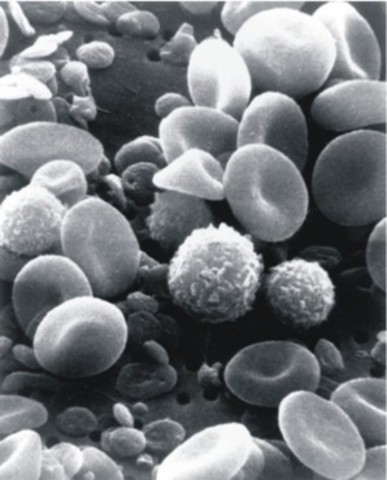
Figure 22.26: A scanning electron microscope (SEM) image of normal circulating human blood. One can see red blood cells, several white blood cells including knobby lymphocytes, a monocyte, a neutrophil, and many small disc-shaped platelets. (3)
www.ck12.org 1204
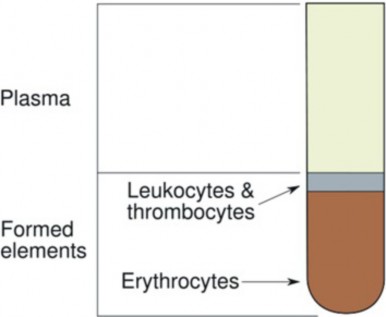
Figure 22.27: The components of blood. Red blood cells make up about 45% of the blood volume, white blood cells, about one percent, and platelets less than one percent. Plasma makes up the rest of the blood. (22)
Mature red blood cells do not have a nucleus or other organelles. They contain the protein hemoglobin which gives blood its red color. The iron-containing heme portion of hemoglobin enables the protein to carry oxygen to cells. Heme binds to molecules of oxygen, which increases the ability of the blood to carry the gas.
Iron from hemoglobin is recovered and reused by red marrow. The liver degrades the heme units and secretes them as pigment in the bile, responsible for the color of feces. Each second two million red blood cells are produced to replace those thus taken out of circulation.
White Blood Cells
White blood cells, also known as leukocytes, are generally larger than red blood cells, as shown in Figure 22.28. They have a nucleus, but do not have hemoglobin. White blood cells make up less than one percent of the blood’s volume. They are made from stem cells in bone marrow. They function in the cellular immune response. There are five types of white blood cells. Neutrophils enter the tissue fluid by squeezing through capillary walls and phagocytizing (swallowing) foreign bodies. Macrophages also swallow and destroy cell debris and bacteria or viruses. In Figure 22.29, a macrophage is shown phagocytizing two particles, possibly pathogens. Macrophages also release substances that cause the numbers of white blood cells to increase. Antigen-antibody complexes are swallowed by macrophages.
1205 www.ck12.org
Lymphocytes fight infection. T-cells attack cells containing viruses. B-cells produce anti- bodies. To learn more about the role of white blood cells in fighting infection, refer to the Immune System and Disease chapter.
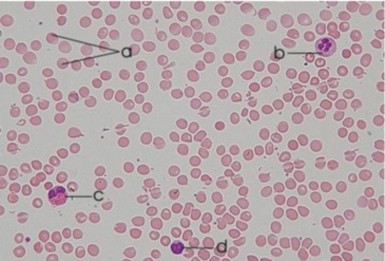
Figure 22.28: Relative sizes of red and white blood cells. a - red blood cells; b – neutrophil; c - eosinophil; d – lymphocyte. b, c, and d are different types of white blood cells. (38)
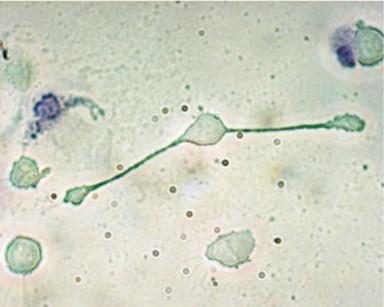
Figure 22.29: Macrophage showing cytoplasmic extensions that allow it to “swallow” parti- cles or pathogens. In the image here, a mouse macrophage stretches its arms to engulf two particles at once. (7)
www.ck12.org 1206
Platelets
Platelets, also known as thrombocytes, are important in blood clotting. Platelets are cell fragments that bud off bone marrow cells called megakaryocytes. A platelet is shown in Figure 22.30. They make up less than one percent of blood volume. Platelets carry chemicals essential to blood clotting. They change fibrinogen into fibrin, a protein that creates a mesh onto which red blood cells collect, forming a clot. This clot stops more blood from leaving the body and also helps to prevent bacteria from entering the body. Platelets survive for 10 days before being removed by the liver and spleen. There are 150,000 to 300,000 platelets in each milliliter of blood. Platelets stick to tears in blood vessels and they release clotting factors.

Figure 22.30: Cells of the blood. From left to right: Red blood cell, platelet, white blood cell. The concave side of red blood cells can be seen. Both sides of red blood cells are concave. The biconcave shape gives the red blood cells a smaller surface to volume ratio, which allows them to pick up large amounts of oxygen. (14)
Other Blood Components
Blood plasma also contains other substances other than water. Some important components of blood include:
Serum albumin: a plasma protein that acts as a transporter of hormones and other molecules.
Antibodies: proteins that are used by the immune system to identify and destroy foreign objects such as bacteria and viruses.
Hormones: chemical messengers that are produced by one cell and carried to another.
Electrolytes such as sodium (Na+) and chloride (Cl-) ions.
1207 www.ck12.org
Production and Breakdown of Blood Cells
Blood cells are produced in the red and yellow bone marrow in a process called hematopoiesis. Blood cells are broken down by the spleen and certain cells in the liver. The liver also clears some proteins, lipids and amino acids from the blood. The kidney actively secretes waste products of the blood into the urine.
Functions of Blood
Transport of Oxygen
The hemoglobin molecule is the major transporter of oxygen in mammals, including humans and many other species. About 98.5 percent of the oxygen in a sample of arterial blood in a healthy human is bonded with hemoglobin. Only 1.5 percent of the oxygen in blood is not carried by hemoglobin, instead it is dissolved in the plasma.
Under normal conditions in humans at rest, the hemoglobin in the red blood cells that are leaving the lungs is about 98 to 99 percent saturated with oxygen, and the blood is referred to as oxygenated. In a healthy adult at rest, deoxygenated blood returning to the lungs is still 75 percent saturated with oxygen. Oxygen saturation of arterial blood at or below 95 percent is considered dangerous in an individual at rest (for instance, during surgery under anesthesia)
Substances other than oxygen can bind to the hemoglobin; in some cases this can cause irreversible damage to the body. The gas carbon monoxide, for example, is very dangerous when absorbed into the blood. It bonds irreversibly with hemoglobin, which reduces the volume of oxygen that can be carried in the blood. Carbon monoxide poisoning can very quickly cause suffocation and death. Carbon monoxide is released during combustion (fire). It is released by cigarettes, barbeque grills, combustion of petrol products in cars and trucks, or anything else that can be burned.
Transport of Carbon Dioxide
When systemic arterial blood flows through capillaries, carbon dioxide diffuses from the tissues into the blood. Some carbon dioxide is dissolved in the blood. The remaining carbon dioxide is converted to bicarbonate and hydrogen ion which is then carried in the blood to the lungs, where it is converted back to carbon dioxide and released into the lungs.
Thermoregulation
Blood circulation transports heat through the body, and adjustments to this flow are an important part of thermoregulation. Increasing blood flow to the surface (e.g. during warm
www.ck12.org 1208
weather or strenuous exercise) causes warmer skin, resulting in greater heat loss. Decreasing surface blood flow conserves heat.
Blood Clotting
Coagulation, or blood clotting, is a complex process by which blood forms solid clots. Coagulation is important to stop bleeding and begin repair of damaged blood vessels. Blood clotting disorders can lead to an increased risk of bleeding or clotting inside a blood vessel. Platelets are important for the proper coagulation of blood.
Clotting is started almost immediately when an injury damages the endothelium of a blood vessel. Platelets clump together, forming a plug at the site of injury. Then, proteins in the plasma called coagulation factors, respond in a series of chemical reactions that form a tough protein called fibrin. The fibrin strands form a web across the platelet plug, trapping red blood cells before they can leave through the wound site. This mass of platelets, fibrin, and red blood cells forms a clot that hardens into a scab.
Certain nutrients are needed for the proper functioning of the clotting mechanism. Two of these are calcium and vitamin K. Luckily for you, bacteria that live in your intestines make enough vitamin K so you do not need to have extra in your food.
Blood Types
Blood type (also called a blood group), is determined by the presence or absence of certain molecules, called antigens, on the surface of red blood cells. An antigen is a molecule or substance that causes an immune response. Blood type antigens may be proteins, or carbohydrates, depending on the blood group system. The antigens on a person’s own body cells are recognized by their immune system as “self” antigens, and their immune system does not attack them. However, if a person is exposed to a blood group antigen that is different from their own blood group, the person’s immune system will produce antibodies against the donor blood antigens. These antibodies can bind to antigens on the surface of transfused red blood cells (or other tissue cells) often leading to destruction of the cells by the immune system.
The erythrocyte surface antigens that have one allele, or a group of very closely linked genes, are collectively called a ”blood group system”. There are 29 known blood group systems in humans, but the ABO blood group system and the Rhesus (Rh) blood group system are the most important for blood transfusions.
1209 www.ck12.org
ABO Blood Group System
In 1875, a German physiologist, Leonard Landois reported that the blood cells of a human and an animal would clump together when mixed. In the early 1900s, Austrian biologist and physician Karl Landsteiner pointed out that a similar clumping reaction occurred when the blood of one person was transfused with another. He determined that this might be the cause of shock, jaundice, and release of hemoglobin that had followed some earlier attempts at person-to-person blood transfusions.
In 1909, Landsteiner classified blood into the A, B, AB, and O groups. He also showed that transfusions between of the same blood group did not result in the destruction of blood cells and that clumping occurred only when a person was transfused with the blood of a person belonging to a different blood group.
The ”A” and ”B” of the ABO blood group refer to two carbohydrate antigens found on the surface of red blood cells. There is not an O antigen. Type O red blood cells do not have either type A or B antigens on their surface, as listed in Table 22.1. Antibodies are found in the blood plasma. The blood type of a person can be determined by using antibodies that bind to the A or B antigens of red blood cells.
Table 22.1: Blood Types, Antigen Types, and Antibody Types

Blood Type Antigen Type Serum (Plasma)
Antibodies
Can Receive
Blood from Types
Can Donate Blood to Types

A anti-B A, O A, AB
B anti-A B, O B, AB
AB A and B none AB, A, B, O AB
O none anti-A, anti-B O AB, A, B, O

(Source: CK12 Foundation, License: CC-BY-SA)
Agglutination is the clumping of red blood cells that occurs when different blood types are mixed together, shown in Figure 22.31. It involves a reaction between antigens on the surface of red blood cells and protein antibodies in the blood plasma. Mixing different blood types together can cause agglutination, a process that has been used as a way of determining a person’s blood type.
Rhesus Blood Group System
The Rhesus system is the second most significant blood group system in human blood transfusion. The most significant Rhesus antigen is called the RhD antigen, also called Rhesus factor. A person either has, or does not have the RhD antigen on the surface of their
www.ck12.org 1210

Figure 22.31: Antigens on the red blood cell surface. Antibodies attach to the antigens on the red blood cell, causing the blood cells to clump together. This leads to agglutination of the blood. (4)
red blood cells. This is usually indicated by ”RhD positive” (does have the RhD antigen) or ”RhD negative” (does not have the antigen) suffix to the ABO blood group (see blood agglutination test in Figure 22.32).
The Rhesus system is named after the Rhesus monkey, in which the antigen was first dis- covered by Karl Landsteiner and Alexander S. Wiener in 1937. The importance of the Rh factor was realized soon after. Dr. Phillip Levine, a pathologist who worked at a New York hospital, made the connection between the Rh factor and the incidence of a blood disease in newborn babies. The disease, called hemolytic disease of the newborn is a condition that develops while the fetus is in the womb. If a mother is RhD negative, and the father is RhD positive, the fetus may inherit the dominant RhD positive trait from the father. The RhD negative mother can make antibodies against the RhD antigens of her developing baby. This can happen if some of the fetus’ blood cells pass into the mother’s blood circulation, or if the mother has received an RhD positive blood transfusion.
The fetus’ red cells are broken down and the fetus can develop anemia. This disease ranges from mild to very severe, and fetal death from heart failure can occur. Most RhD disease can be prevented by treating the mother during pregnancy or soon after childbirth. The mother is injected with anti-RhD antibodies, so that the baby’s red blood cells are destroyed before her body can produce antibodies against them. If a pregnant woman is known to have anti-RhD antibodies, the RhD blood type of a fetus can be tested by analysis of fetal DNA in maternal plasma to assess the risk to the fetus of Rh disease.
The presence or absence of the ABO group antigens and the RhD antigens are always determined for all recipient and donor blood. Figure 22.32 shows a routine way in which a person’s ABO blood group is determined.
Blood Products
In order to provide maximum benefit from each blood donation and to extend shelf-life, blood banks separate some whole blood into several different products. Some of the most common
1211 www.ck12.org
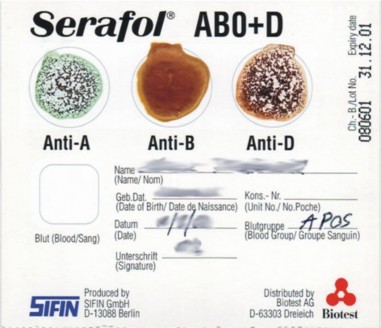
Figure 22.32: A bedside blood grouping card showing the agglutination of the blood with anti-A and anti-Rh(D), but not with anti-B. Therefore the blood group is A positive. This method of blood grouping relies on seeing an agglutination reaction to determine a person’s blood group. The card has dried blood group antibody reagents fixed onto its surface. A drop of the person’s blood is placed on each area on the card. The presence or absence of visual agglutination allows a quick method of determining the ABO and Rhesus group of the person. (17)
www.ck12.org 1212
of these products are packed red blood cells, plasma, platelets, and fresh frozen plasma. Units of packed red blood cells are made by removing as much of the plasma as possible from whole blood units. Clotting factors made by genetic engineering are now routinely used for the treatment of the clotting disorder hemophilia, so the risk of possible infection from donated blood products is avoided.
Universal Donors and Universal Recipients
Regarding the donation of packed red blood cells, individuals with type O negative blood are often called universal donors, and those with type AB positive blood are called universal recipients. Type O red blood cells do not have the A or B antigens, and can be given to people with a different ABO blood group. The blood plasma of an AB person does not contain any anti-A or anti-B antibodies, so they can receive any ABO blood type. The possible reactions of anti-A and anti-B antibodies in the donor blood to the recipient’s red blood cells are usually not a problem because only a small volume of plasma that containing antibodies is given to the recipient. Refer to Table 22.1 for a complete listing of ABO antigens and antibodies that are involved in the ABO system.
In April 2007 researchers discovered a way to convert blood types A, B, and AB to O; the method used enzymes that removed the antigens on the surface of the red blood cells.
Other Blood Group Systems
You probably have heard a lot about the ABO and Rhesus (RhD) blood group systems by now, but you have probably not heard much about the other 27 other systems. Many other antigens are found on the cell membrane of red blood cells. For example, an individual can be AB RhD positive, and at the same time M and N positive (MNS system), K positive (Kell system), Lea or Leb negative (Lewis system), Duffy positive, or Duffy negative (Duffy system), and so on, being positive or negative for each blood group system antigen. Many of the blood group systems were named after the patients in whom the antibodies were first found.
Some blood group systems are associated with a disease, for example, the Kell antigen is associated with McLeod syndrome, a genetic disorder in which the red blood cells are spiky shaped. Certain other blood group systems may affect resistance to infections, an example being the resistance to specific malaria species seen in individuals who lack the Duffy antigen. The Duffy antigen is less common in ethnic groups from areas with a high incidence of malaria.
Rare blood types can cause supply problems for blood banks and hospitals. For example Duffy-negative blood occurs much more frequently in people of African origin, and the rarity of this blood type in the rest of the population can result in a shortage of Duffy-negative blood. Similarly, for RhD negative people, there is a risk associated with traveling to parts
1213 www.ck12.org
of the world where supplies of RhD negative blood are rare, particularly East Asia.
Homeostatic Imbalances of the Blood
Problems can occur with red blood cells, white blood cells, platelets, and other components of the blood. Many blood disorders are genetic, they are inherited from a parent, some are a result of nutrient deficiency, while others are cancers of the blood.
Sickle-cell disease is a group of genetic disorders caused by abnormally shaped hemoglobin, called sickle hemoglobin. In many forms of the disease, the red blood cells change shape because the abnormal hemoglobin proteins stick to each other, causing the cell to get a rigid surface and sickle shape, shown in Figure 22.33. This process damages the membrane of the red blood cell, and can cause the cells to get stuck in blood vessels. This clotting causes oxygen starvation in tissues, which may cause organ damage such as stroke or heart attack. The disease is chronic and lifelong. Individuals are most often well, but their lives are punctuated by periodic painful attacks. Sickle-cell disease occurs more commonly in people (or their descendants) from parts of the world such as sub-Saharan Africa, where malaria is or was common. It also occurs in people of other ethnicities. As a result, those with sickle cell disease are resistant to malaria since the red blood cells are not favored by the malaria parasites. The mutated hemoglobin allele is recessive, meaning it must be inherited from each parent for the individual to have the disease.
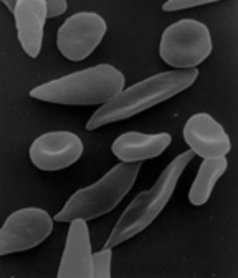
Figure 22.33: Sickle-cell disease. The abnormal shape of the red blood cells damages the red blood cells which causes them to get stuck in blood vessels. The blocked capillaries reduce the blood flow to an organ, and can result in pain and organ damage. (1)
Iron deficiency anemia is the most common type of anemia. It occurs when the dietary www.ck12.org 1214
intake or absorption of iron is less than what is needed by the body. As a result, hemoglobin, which contains iron, cannot be made. In the United States, 20 percent of all women of childbearing age have iron deficiency anemia, compared with only 2 percent of adult men. The principal cause of iron deficiency anemia in premenopausal women is blood lost during menstruation.
Leukemia is a cancer that originates in the bone marrow and is characterized by an ab- normal production of white blood cells (rarely red blood cells) that are released into the bloodstream. Lymphoma is a cancer of the lymphatic system, which helps to filter blood. Lymphoma can be categorized as either Hodgkin’s lymphoma or non-Hodgkin’s lymphoma.
Hemophilia is the name of a group of hereditary genetic diseases that affect the body’s ability to control blood clotting. Hemophilia is characterized by a lack of clotting factors in the blood. Clotting factors are needed for a normal clotting process. When a blood vessel is injured, a temporary scab does form, but the missing coagulation factors prevent the formation of fibrin which is needed to maintain the blood clot. Therefore, a person who has hemophilia is initially able to make a clot to stop the bleeding, but because fibrin is not produced, the body is unable to maintain a clot for long. The risks of the re-bleeding of an injury and internal bleeding are increased in hemophilia, especially into muscles, joints, or bleeding into closed spaces.
Haemochromatosis is a hereditary disease that is characterized by a buildup of iron in the body. Iron accumulation can eventually cause end organ damage, most importantly in the liver and pancreas, manifesting as liver failure and diabetes mellitus respectively. It is estimated that roughly one in every 300-400 people is affected by the disease, primarily of Northern European and especially people of Irish, Scottish, Welsh and English descent.
Lesson Summary
The functions of blood include the removal of wastes such as carbon dioxide, urea and lactic acid from the body tissues; defense of the body against infection by microorgan- isms or parasites; repair of damage to the body tissues; transport of chemical messages, such as hormones and hormone-like substances; control of body pH; control of body temperature.
Within the blood plasma are the red blood cells, white blood cells, platelets, and other substances. Red blood cells are the most common types of cells in the blood, they make up about 45 percent of blood volume.
Blood clotting begins when the endothelium of a blood vessel is torn. Platelets clump together, forming a plug at the site of injury. Then, the coagulation factors cause a series of chemical reactions that form fibrin. The fibrin strands form a web across the platelet plug, trapping red blood cells before they can leave through the wound site. This mass of platelets, fibrin, and red blood cells forms a clot that hardens into a scab.
There are 29 blood group systems, but the two major ones are the ABO and Rhesus
1215 www.ck12.org
systems.
The ABO system is of great importance in blood transfusions. Individuals with type O negative blood are called universal donors, and those with type AB positive blood are called universal recipients. Type O red blood cells do not have the A or B antigens, and can be given to people with a different ABO blood group. The blood plasma of an AB person does not contain any anti-A or anti-B antibodies, so they can receive any ABO blood type.
Iron deficiency anemia is the most common type of anemia. It occurs when the dietary intake or absorption of iron is less than what is needed by the body. As a result, hemoglobin, which contains iron, cannot be made. Hemophilia is the name of a group of hereditary genetic diseases that affect the body’s ability to control blood clotting. Hemophilia is characterized by a lack of clotting factors in the blood.
Review Questions
Name the four main components of blood.
How does the structure of a red blood cell relate to its function?
Name one other gas that can bind to hemoglobin, and identify an affect that such binding can have on homeostasis.
Why might iron-deficiency anemia cause a person to feel tired?
Identify two different types of human blood systems.
Identify the processes involved in blood clotting.
A sample of blood taken from a patient has elevated (higher than normal) levels of leucocytes. What could this mean?
Identify where in the body red blood cells and white blood cells are made.
Explain why taking erythropoietin (EPO), which stimulates the production of more red blood cells, is considered a form of cheating in sports.
Further Reading / Supplemental Links
http://www.estrellamountain.edu/faculty/farabee/biobk
http://waynesword.palomar.edu/aniblood.htm
http://en.wikipedia.org
Vocabulary
agglutination The clumping of red blood cells that occurs when different blood types are mixed together.
antibodies Proteins that are used by the immune system to identify and destroy foreign objects such as bacteria and viruses.
www.ck12.org 1216
blood A fluid connective tissue; arterial blood carries oxygen and nutrient to all the body’s cells, and venous blood carries carbon dioxide and other metabolic wastes away from the cells.
blood type (blood group) Determined by the presence or absence of certain molecules, called antigens, on the surface of red blood cells.
coagulation Blood clotting, a complex process by which blood forms solid clots.
coagulation factors Proteins in the plasma which respond damage to a blood vessel; response includes a series of chemical reactions that form a tough protein called fibrin.
erythrocytes Red blood cells; flattened, doubly concave cells that carry oxygen.
haemochromatosis A hereditary disease that is characterized by a buildup of iron in the body; can eventually cause end organ damage, most importantly in the liver and pancreas, manifesting as liver failure and diabetes mellitus respectively.
hematopoiesis The production of blood cells in the red and yellow bone marrow.
heme The iron-containing portion of hemoglobin; enables the protein to carry oxygen to cells.
hemoglobin Protein in red blood cells that carries oxygen.
hemophilia The name of a group of hereditary genetic diseases that affect the body’s ability to control blood clotting.
hormones Chemical messengers that are produced by one cell and carried to another.
leukemia A cancer that originates in the bone marrow and is characterized by an abnormal production of white blood cells.
leukocytes White blood cells; function in the cellular immune response; includes neu- trophils, eosinophils, and macrophages.
lymphoma A cancer of the lymphatic system, which helps to filter blood; can be catego- rized as either Hodgkin’s lymphoma or non-Hodgkin’s lymphoma.
1217 www.ck12.org
plasma The golden-yellow liquid part of the blood; 90% water and 10% dissolved materials including proteins, glucose, ions, hormones, and gases.
serum albumin A plasma protein that acts as a transporter of hormones and other molecules.
sickle-cell disease A group of genetic disorders caused by abnormally shaped hemoglobin, called sickle hemoglobin.
thrombocytes Platelets; important in blood clotting; cell fragments that bud off bone marrow cells called megakaryocytes.
universal donors Individuals with type O negative blood.
universal recipients Individuals with type AB positive blood.
Points to Consider
How might the composition of your blood change during a 24-hour period?
What do you think is the relationship between the cardiovascular system, blood, and the respiratory system?
Lesson 22.3: Respiratory System
Lesson Objectives
Distinguish between external and internal respiration.
Identify the structures of the respiratory system.
Outline the process of inhalation.
Describe how carbon dioxide is carried in the blood.
Compare the causes of emphysema and asthma.
Introduction
Have you ever wondered what it would be like to have gills? You would breathe and look very different from the rest of us, but they would be great for swimming and diving! Despite such differences, the main functions of lungs and gills are the same: to obtain oxygen, and to release carbon dioxide.
www.ck12.org 1218
The human respiratory system brings oxygen, O2, into the body and releases carbon dioxide, CO2, into the atmosphere. Oxygen is drawn in through the respiratory tract, which is shown in Figure 22.34, and is then delivered to the blood. This process is called external respiration. The exchange of gases between the blood and the cells of the body is called internal respiration.
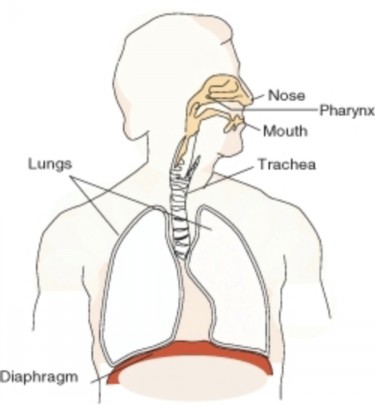
Figure 22.34: The respiratory system. Air moves down the trachea, a long straight tube in the chest. The diaphragm pulls air in and pushes it out. Respiratory systems of various types are found in a wide variety of organisms. (26)
Comparing ”Cellular Respiration” and ”Respiration”
Respiration is the transport of oxygen from the outside air to the cells of the body, and the transport of carbon dioxide in the opposite direction. This is in contrast to the biochemical definition of respiration, which refers to cellular respiration. Cellular respiration is the metabolic process by which an organism obtains energy by reacting oxygen with glucose to give water, carbon dioxide and ATP (energy). Although respiration is necessary to sustain cellular respiration and thus life in animals, the processes are very different. Cellular respi-
1219 www.ck12.org
ration takes place in individual cells of the animal, while respiration involves the transport of metabolites between the organism and external environment.
Structures of the Respiratory System
The nose and nasal cavity filter, warm, and moisten the inhaled air. The nose hairs and mucus produced by the epithelial cells in the nose catch airborne particles and prevent them from reaching the lungs.
Behind the nasal cavity, air next passes through the pharynx, a long tube that is shared with the digestive system. Both food and air pass through the pharynx. A flap of connective tissue called the epiglottis closes over the trachea when food is swallowed to prevent choking or inhaling food. In humans the pharynx is important in vocalization
The larynx, also called the voicebox, is found just below the point at which the pharynx splits into the trachea and the esophagus, shown in Figure 22.35. The voice is generated in the larynx. Air from the lungs is needed for the vocal folds to produce speech.
The trachea, or wind pipe, is a long tube that leads down to the chest where it divides into the right and left bronchi in the lungs. The bronchi branch out into smaller bronchioles, which are the first airway passages that do not contain cartilage. The bronchioles lead into the alveoli, which are the multi-lobed sacs in which most of the gas exchange occurs.
The Journey of a Breath of Air
In air-breathing vertebrates such as humans, respiration of oxygen includes four stages:
Ventilation from the atmosphere into the alveoli of the lungs.
Pulmonary gas exchange from the alveoli into the pulmonary capillaries.
Gas transport from the pulmonary capillaries through the circulation to the peripheral capillaries in the organs.
Peripheral gas exchange from the tissue capillaries into the cells and mitochondria.
Ventilation: From the Air to the Alveoli
Air enters the body through the nose, is warmed, filtered, and passed through the nasal cavity. Air passes the pharynx (which has the epiglottis that prevents food from entering the trachea). The upper part of the trachea contains the larynx. The vocal cords are two bands of tissue that extend across the opening of the larynx. After passing the larynx, the air moves into the trachea. The trachea is a long tube that divides into two smaller tubes called bronchi which lead into each lung, shown in Figure 22.35. Bronchi are reinforced to prevent their collapse and are lined with ciliated epithelium and mucus-producing cells.
www.ck12.org 1220
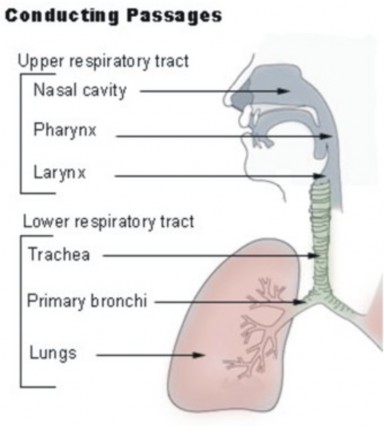
Figure 22.35: The structures of the respiratory system include the nasal cavity, the pharynx, larynx, which together are the upper respiratory tract. The trachea, bronchi, bronchioles and alveoli are part of up the lower respiratory tract. (30)
1221 www.ck12.org
Bronchi branch into smaller and smaller tubes called bronchioles. Bronchioles end in grape- like clusters called alveoli. Alveoli are surrounded by a network of thin-walled capillaries, shown in Figure 22.36.
Breathing in, or inhaling, is usually an active movement, contraction of the diaphragm muscles uses ATP. The diaphragm is a muscle that is found below the lungs (shown in Figure 22.34). Contraction of the diaphragm causes the volume of the chest cavity to increase, and the air pressure within the lungs to decrease. The pressure difference causes air to rush into the lungs. Relaxation of the diaphragm causes the lungs to recoil and air is pushed out of the lungs. Breathing out, or exhaling, is normally a passive process powered by the elastic recoil of the chest, similar to letting the air out of a balloon.
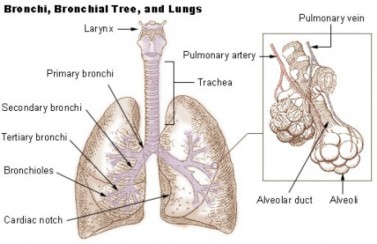
Figure 22.36: The alveoli are the tiny grape-like structures within the lungs, and are the site of pulmonary gas exchange. (25)
Pulmonary Gas Exchange: From the Alveoli into the Pulmonary Capillaries
Breathing is only part of the process of delivering oxygen to where it is needed in the body. The process of gas exchange occurs in the alveoli by diffusion of gases between the alveoli and the blood passing in the lung capillaries, as shown in Figure 22.37. Recall that diffusion is the movement of substances from an area of higher concentration to an area of lower concentration. The difference between the high concentration of O2 in the alveoli and the low O2 concentration of the blood in the capillaries is enough to cause O2 molecules to diffuse across the thin walls of the alveoli and capillaries and into the blood. CO2 moves out of the blood and into the alveoli in a similar way. The greater the concentration difference, the greater the rate of diffusion.
Breathing also results in loss of water from the body. Exhaled air has a relative humidity www.ck12.org 1222
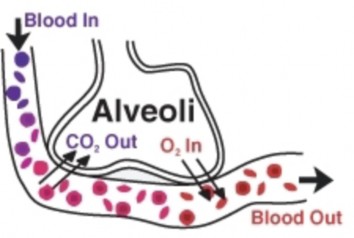
Figure 22.37: Gas exchange happens in the lungs through diffusion. Deoxygenated blood has a high concentration of CO2 and a low O2 concentration. CO2 moves out of the blood and into the alveoli, where the concentration of CO2 is lower. Likewise, O2 moves from an area of higher concentration (the alveoli), to an area of lower concentration (the blood). (29)
of 100 percent because of the diffusion of water that from the moist surface of the breathing passages and the alveoli into the warm exhaled air.
In the lungs, oxygen is transported across the thin membranes of the alveoli and the border of the capillary and attracted to the hemoglobin molecule within the red blood cell.
After leaving the lungs, the oxygenated blood returns to the heart to be pumped through the aorta and around the body. The oxygenated blood travels through the aorta, to the smaller arteries, arterioles, and finally to the peripheral capillaries where gas exchange occurs.
Peripheral Gas Exchange: From Capillaries into Cells, and from Cells into Capillaries
The oxygen concentration in body cells is low, while the blood that leaves the lungs is 97 percent saturated with oxygen. So, oxygen diffuses from the blood into the body cells when it reaches the peripheral capillaries (the capillaries in the systemic circulation).
Carbon dioxide concentration in metabolically active cells is much greater than in capillaries, so carbon dioxide diffuses from the cells into the capillaries. Most of the carbon dioxide (about 70 percent) in the blood is in the form of bicarbonate (HCO3-). A small amount of carbon dioxide dissolves in the water in the plasma to form carbonic acid (H2CO3). Carbonic acid and bicarbonate play an important role in regulating the pH of the body.
In order to remove CO2 from the body, the bicarbonate is picked up by a red blood cell, and is again turned in to carbonic acid. A water molecule (H2O) is then taken away from the
1223 www.ck12.org
carbonic acid, and the remaining CO2 molecule is expelled from the red blood cells and into the alveoli where it is exhaled. The following equation shows this process:
HCO3- + H+ H2CO3 CO2 + H2O
Gas exchange between your body and the environment occurs in the alveoli. The alveoli are lined with pulmonary capillaries, the walls of which are thin enough to permit the diffusion of gases. Inhaled oxygen diffuses into the pulmonary capillaries, where it binds to hemoglobin in the blood. Carbon dioxide diffuses in the opposite direction, from capillary blood to alveolar air. At this point, the pulmonary blood is oxygen-rich, and the lungs are primarily holding carbon dioxide. Exhalation follows, thereby ridding the body of the carbon dioxide and completing the cycle of respiration.
Gas Exchange and Homeostasis
The equilibrium between carbon dioxide and carbonic acid is very important for controlling the acidity of body fluids. As gas exchange occurs, the pH balance of the body is maintained as part of homeostasis. If proper respiration is interrupted two things can occur:
Respiratory acidosis, in which arterial blood contains too much carbon dioxide, causing a drop in blood pH.
Respiratory alkalosis results from increased respiration (or hyperventilation) which causes a drop in the amount of carbon dioxide in the blood plasma. The drop in carbon dioxide concentration causes the blood pH to rise.
Control of Breathing by the Nervous System
Breathing is one of the few bodily functions which, within limits, can be controlled both consciously and unconsciously. Conscious attention to breathing is common in activities such as yoga, swimming, and karate. In speech or vocal training, a person learns to discipline his or her breathing for purposes other than life support.
Muscular contraction and relaxation controls the rate of expansion and constriction of the lungs. These muscles are controlled by the autonomic nervous system from the parts of the brainstem that control breathing: the medulla and the pons. This area of the brainstem forms the respiration regulatory center. When carbon dioxide levels increase in the blood (in the form of carbonic acid), such as during exercise, the pH level of the blood drops. This causes the medulla to send nerve impulses to the diaphragm and the muscles between the ribs, causing them to contract and increase the rate of breathing. This automatic control of respiration can be impaired in premature babies, or by drugs or disease.
Without breathing, the body’s oxygen levels drop dangerously low within minutes, leading to permanent brain damage followed by death. It is not possible for a healthy person to
www.ck12.org 1224
voluntarily stop breathing indefinitely. If we do not inhale, the level of carbon dioxide builds up in our blood and we experience great air hunger. Eventually, not breathing leads to a loss of consciousness at which time the autonomic nervous system takes control and initiates breathing.
Inhalation
Inhalation is started by the diaphragm and supported by the external intercostal muscles (the muscles that are between the ribs). It is an active process that needs ATP. When the diaphragm contracts, the ribcage expands and the contents of the abdomen are moved downward. This results in a larger thoracic (chest) volume, which in turn causes a decrease in air pressure inside the lungs. As the pressure in the chest falls, air from outside the body moves into the respiratory system. Normal resting respirations are 10 to 18 breaths per minute. During an average breath, an adult will exchange from 500 ml to 700 ml of air. The average breath capacity of a person is called lung volume, or tidal volume.
Exhalation
Exhalation is generally a passive process, however active, or forced, exhalation is carried out by the abdominal and the internal intercostal muscles. The lungs have a natural elasticity and as they recoil from the stretch of inhalation, air flows out of the lungs until the pressures in the chest and the atmosphere reach equilibrium. During forced exhalation, as when blowing out a candle, expiratory muscles including the abdominal muscles and internal intercostal muscles generate pressure in the chest and abdomen, which forces air out of the lungs.
Homeostatic Imbalances of the Respiratory System: Dis- eases and Disorders
Respiratory disease is the term for diseases of the lung, bronchial tubes, trachea and throat. These diseases range from mild, such as a cold, to being possibly life-threatening, such as bacterial pneumonia.
Respiratory diseases can be grouped as either obstructive (conditions which lower the rate of the airflow into and out of the lungs, such as in asthma) or restrictive (conditions that cause a reduction in the functional volume of the lungs, such as emphysema.)
Emphysema is a chronic lung disease caused by loss of elasticity of the lung tissue. The destruction of elastic structures that support the alveoli and the capillaries that feed the alveoli cause them to become hard and stiff. Eventually the walls of the alveoli break down and the alveoli become larger. The amount of oxygen that can enter the blood with each breath is reduced because the large alveoli cannot function efficiently; much of the oxygen that gets into the large alveoli cannot be absorbed into the blood so the oxygen is unused.
1225 www.ck12.org
Symptoms include shortness of breath on exertion (usually when climbing stairs or a hill, and later at rest), and an expanded chest. Damage to the alveoli, which can be seen in Figure 22.38, is irreversible. Smoking is a leading cause of emphysema.

Figure 22.38: The inside of a lung showing the characteristics of emphysema due to smok- ing. Instead of alveoli, the cut surface shows multiple cavities lined by heavy black carbon deposits. (32)
Bronchitis is an inflammation of the bronchi. Acute bronchitis is usually caused by viruses or bacteria and may last several days or weeks. Acute bronchitis is characterized by cough and phlegm (mucus) production. Symptoms are related to the inflammation of the airways and phlegm production, and include shortness of breath and wheezing. Chronic bronchitis is not necessarily caused by infection and is generally part of a syndrome called chronic ob- structive pulmonary disease (COPD). Chronic bronchitis is defined clinically as a persistent cough that produces phlegm and mucus, for at least three months in two consecutive years.
Asthma is a chronic illness in which the airways narrow and becomes inflamed, as shown in Figure 22.39. Excessive amounts of mucus are also made by the lungs. Asthma often happens in response to one or more triggers. It may be triggered by exposure to an allergen such as mold, dust, or pet hair. It can also be caused by cold air, warm air, moist air, exercise, or emotional stress. In children, the most common triggers are viral illnesses such as those that cause the common cold. This airway narrowing causes symptoms such as wheezing, shortness of breath, chest tightness, and coughing. Some people with asthma, especially children, can become very frightened by the symptoms, which may cause even more breathing distress. Between asthma attacks, most patients feel well but can have mild symptoms and may remain short of breath after exercise for longer periods of time than a person who does not have asthma. The symptoms of asthma, which can range from mild to life threatening, can usually be controlled with a combination of medicines and environmental changes.
www.ck12.org 1226
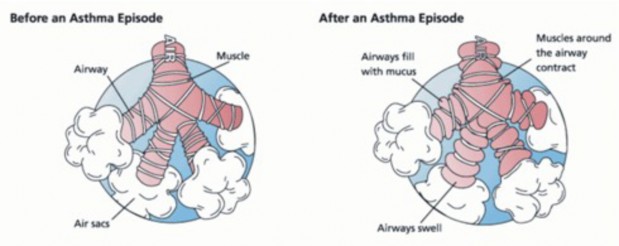
Figure 22.39: Asthma narrows the airways by causing allergy-induced spasms of surrounding muscles, narrowing of the airway, and excessive production of phlegm (mucus), which clogs the airways. The airway constriction responds to medicines called bronchodilators which relax the muscles. The feeling of breathlessness is somewhat like being able to breath only through a straw while walking. (2)
Public attention in the developed world has recently focused on asthma because of the increasing numbers of cases, affecting up to one in four children who live in cities.
Pneumonia is an illness in which the alveoli become inflamed and flooded with fluid. Ef- fective gas exchange cannot happen across the alveoli membranes. Pneumonia can result from a variety of causes, including infection with bacteria, viruses, fungi, or parasites, and chemical or physical injury to the lungs. Symptoms of pneumonia include cough, chest pain, fever, and difficulty in breathing. Treatment depends on the cause of pneumonia; bacterial pneumonia is treated with antibiotics.
Pneumonia is a common illness which occurs in all age groups, and is a leading cause of death among the elderly and people who are chronically and terminally ill. Vaccines to prevent certain types of pneumonia are available.
Tuberculosis (TB) is a common and deadly infectious disease caused by a type of bacteria called Mycobacterium tuberculosis. TB most commonly attacks the lungs (as pulmonary TB) but can also affect the central nervous system, the lymphatic system, the circulatory system, the genitourinary system, bones, joints and even the skin.
Over one-third of the world’s population has been exposed to the TB bacterium. Not ev- eryone infected develops the disease, so TB infection without symptoms (called a latent infection) is most common. However, one in ten latent infections will progress to active TB disease, which, if left untreated, kills more than half of its victims.
The rise in HIV infections and the neglect of TB control programs have led to an increase
1227 www.ck12.org
in cases of tuberculosis. The development of drug-resistant strains has also contributed to this new epidemic. For example, between 2000 and 2004, about 20 percent of TB cases were resistant to standard antibiotic treatments. TB incidence varies widely, even in neighboring countries, apparently because of differences in health care system standards. A TB vaccine, called Bacille Calmette-Guérin (BCG), is available to people in some countries. The BCG is prepared from a strain of weakened live mycobacterium, which has lost its virulence in humans. The effectiveness of the BCG is a matter of debate among researchers, and the governments in some countries, including the United States, do not require people to get the BCG vaccination.
Lung cancer is a disease where epithelial (internal lining) tissue in the lung grows out of control. This leads to invasion of nearby tissue and growth of the tumor beyond the lungs. Lung cancer, which is the most common cause of cancer-related death in men and the second most common in women, is responsible for 1.3 million deaths worldwide every year The most common symptoms are shortness of breath, coughing (including coughing up blood), and weight loss.
The most common cause of lung cancer is exposure to tobacco smoke. The occurrence of lung cancer in non-smokers, who account for less than 10 percent of cases, appears to be due to a combination of genetic factors. Radon gas, asbestos, and air pollution may also contribute to lung cancer.
Asbestos is a mineral that was once used as a fire retardant in buildings and electrical wiring. The inhalation of asbestos fibers can cause a variety of lung diseases, including lung cancer. Tobacco smoking and exposure to asbestos greatly increase a person’s chance of developing lung cancer.
Lesson Summary
The main functions of lungs are to obtain oxygen, and to release carbon dioxide. Oxygen is drawn in through the respiratory tract and is then delivered to the blood in a process called external respiration. The exchange of gases between the blood and the cells of the body is celled internal respiration.
The structures of the respiratory systems include the nose and nasal cavity, the phar- ynx, the larynx, ( also called the voicebox), the trachea (also called the wind pipe), the right and left bronchi in the lungs, and the bronchioles that end in the alveoli.
During inhalation, the diaphragm contracts, causing the volume of the chest cavity to increase. As a result, the air pressure within the lungs decreases. The pressure difference causes air to rush into the lungs. Relaxation of the diaphragm causes the lungs to recoil and air is pushed out of the lungs, which causes exhalation.
Most of the carbon dioxide (about 70 percent) in the blood is in the form of bicarbonate (HCO3-). A small amount of carbon dioxide dissolves in the water in the plasma to form carbonic acid (H2CO3). When CO2 enters the blood from body cells, it combines
www.ck12.org 1228
with water in the plasma to produce carbonic acid (H2CO3), which is then turned into bicarbonate (HCO3-). The bicarbonate is then picked up by a red blood cell and turned back in to carbonic acid. A water molecule (H2O) is then taken away from the carbonic acid, and the remaining CO2 molecule is expelled from the red blood cells and into the lungs.
Emphysema is a chronic lung disease caused by loss of elasticity of the lung tissue. The destruction of elastic structures that support the alveoli and the capillaries that feed the alveoli cause them to become hard and stiff. It is often caused by smoking. Asthma is also a chronic condition, which is often triggered by such things as exposure to an allergen, cold air, warm air, moist air, exercise, or emotional stress. The airways can constrict and become inflamed, and an excessive amount of mucus is produced. Airway narrowing causes symptoms such as wheezing, shortness of breath, chest tightness, and coughing.
Review Questions
Identify the respiratory structures through which air flows.
How is the diaphragm involved in breathing?
Compare respiration and cellular respiration.
Outline how most carbon dioxide is carried in the blood.
Why is it important for a pregnant woman to know her Rhesus blood type, and the Rh blood type of the father of her baby?
What is the difference between internal and external respiration?
What happens during an asthma attack?
Outline how emphysema affects the absorption of oxygen.
Where does the exchange of oxygen occur in the lungs?
What factors regulate breathing rate?
Further Reading / Supplemental Links
http://www.estrellamountain.edu/faculty/farabee/biobk/BioBookRESPSYS.html
http://en.wikipedia.org
Vocabulary
alveoli Multi-lobed sacs in which most of the gas exchange occurs.
asthma A chronic illness in which the airways narrow and becomes inflamed.
bronchitis An inflammation of the bronchi.
1229 www.ck12.org
diaphragm A muscle that is found below the lungs; contraction of the diaphragm causes the volume of the chest cavity to increase, and the air pressure within the lungs to decrease.
emphysema A chronic lung disease caused by loss of elasticity of the lung tissue.
external respiration Process in which oxygen is drawn in through the respiratory tract and is then delivered to the blood.
gas exchange The diffusion of gases between the alveoli and the blood passing in the lung capillaries; also the diffusion of gases from capillaries into cells, and from cells into capillaries throughout the body (peripheral gas exchange).
internal respiration The exchange of gases between the blood and the cells of the body.
larynx Found just below the point at which the pharynx splits into the trachea and the esophagus; also called the voice box.
lung cancer A disease where epithelial (internal lining) tissue in the lung grows out of control; leads to invasion of nearby tissue and growth of the tumor beyond the lungs.
lung volume (tidal volume) The average breath capacity of a person.
obstructive Conditions which lower the rate of the airflow into and out of the lungs, such as in asthma.
pharynx A long tube that is shared with the digestive system; both food and air pass through the pharynx.
pneumonia An illness in which the alveoli become inflamed and flooded with fluid.
respiration The transport of oxygen from the outside air to the cells of the body, and the transport of carbon dioxide in the opposite direction.
respiratory acidosis Condition in which arterial blood contains too much carbon dioxide, causing a drop in blood pH.
respiratory alkalosis Condition which results from increased respiration (or hyperventi- lation) which causes a drop in the amount of carbon dioxide in the blood plasma; the drop in carbon dioxide concentration causes the blood pH to rise.
www.ck12.org 1230
respiratory disease The term for diseases of the lung, bronchial tubes, trachea and throat.
restrictive Conditions that cause a reduction in the functional volume of the lungs, such as emphysema.
trachea A long tube that leads down to the chest where it divides into the right and left bronchi in the lungs; also called the windpipe.
tuberculosis (TB) A common and deadly infectious disease caused by a type of bacteria called Mycobacterium tuberculosis; most commonly attacks the lungs, but can also affect the central nervous system, the lymphatic system, the circulatory system, the genitourinary system, bones, joints and even the skin.
Points to Consider
How might the amount of oxygen in the air affect your respiratory and circulatory systems?
Can you identify any structures that are part of both the respiratory and digestive systems?
Image Sources
Drs. Noguchi, Rodgers, and Schechter of NIDDK.
http://en.wikipedia.org/wiki/Image:Sicklecells.jpg. Public Domain.
USFG. http://commons.wikimedia.org/wiki/Image:Asthma_before-after.png. Public Domain.
http://visualsonline.cancer.gov/details.cfm?imageid=2129. Public Domain.
A. Rad. http://commons.wikimedia.org/wiki/File:Coombs_test_schematic.png. CC-BY-SA.
http://commons.wikimedia.org/wiki/Image: Heart_left_lateral_coronaries_diagram.svg. CC-BY-2.5.
USFG. http://commons.wikimedia.org/wiki/Image:Illu_lymph_capillary.png. Public Domain.
http://commons.wikimedia.org/wiki/Image:Macrophage.jpg. CC-BY-SA-2.0.
USFG. Internal structure of a vein.. Public Domain.
1231 www.ck12.org
http://en.wikipedia.org/wiki/Image:Bundleofhis.png. Public Domain.
Data from Braunwald’s Heart Disease: A Textbook of Cardiovascular Medicine. 7th ed.. W.B. Saunders Company; Philadelphia 2004.. http://commons.wikimedia.org/wiki/Image:CVD_Praevalenz_US.png.
CC-BY-SA.
http://commons.wikimedia.org/wiki/Image:Sphygmomanometer.jpg. GNU-FDL, Public Domain.
http://www.flickr.com/photos/johnjoh/349825408/. CC-BY-SA, CC-BY-SA.
J. Heuser. http://en.wikipedia.org/wiki/Image:AMI_scheme.png.
http://commons.wikimedia.org/wiki/Image:Red_White_Blood_cells.jpg. Public Domain.
http://training.seer.cancer.gov/anatomy/cardiovascular/heart/ structure.html. Public Domain.
The structure of an artery wall.. Public Domain.
Apers0n. http://en.wikipedia.org/wiki/Image:Bedside_card.jpg. CC-BY.
http:
//training.seer.cancer.gov/anatomy/cardiovascular/blood/pathways.html. Public Domain.
The direction of blood flow through the heart.. GNU-FDL.
Sansculotte.
http://commons.wikimedia.org/wiki/Image:Grafik_blutkreislauf.jpg. CC-BY-SA-2.5.
http://commons.wikimedia.org/wiki/Image: Heart_coronary_artery_lesion.jpg. CC-BY-2.5.
MesserWoland. http://commons.wikimedia.org/wiki/Image:Illu_blood_components.svg. CC-BY-SA.
USFG. Lymphatic system. Public Domain.
Center for Disease Control. Public Domain.
USFG. http:
//training.seer.cancer.gov/anatomy/respiratory/passages/bronchi.html. Public Domain.
www.ck12.org 1232
Theresa Knott. http://commons.wikimedia.org/wiki/Image:Respiratory_system.svg. CC-BY-SA-2.5.
(27) .
http://en.wikipedia.org/wiki/Image:Veincrosssection.png. Public Domain, GNU-FDL.
Mr TS88 Duel. http://en.wikipedia.org/wiki/Image:Alveoli.jpg. GFDL/CC-BY-2.5.
USFG. http://en.wikipedia.org/wiki/Image:Illu_conducting_passages.jpg. Public Domain.
http://en.wikipedia.org/wiki/Image:Heart_diastole.png. GNU-FDL.
CDC/Dr. Edwin P. Ewing, Jr. http://commons.wikimedia.org/wiki/Image: Centrilobular_emphysema_865_lores.jpg. Public Domain.
http://en.wikipedia.org/wiki/Image:Double_circulatory_system.jpg. Public Domain.
http://en.wikipedia.org/wiki/Image:Purkinje_fibers.jpg. CC-BY-SA.
Dr. Steven A. Williams.
http://commons.wikimedia.org/wiki/Image:Elephantiasis.png. CC-BY-2.5.
http://en.wikipedia.org/wiki/Image:Illu_capillary.jpg. Public Domain.
http://en.wikipedia.org/wiki/Image:Illu_pulmonary_circuit.jpg. Public Domain.
http://commons.wikimedia.org/wiki/Image:Blood_smear.jpg. GNU-FDL.
http://commons.wikimedia.org/wiki/Image:Mediastinum_anatomy.jpg. CC-BY-2.5.
1233 www.ck12.org
www.ck12.org 1234
Digestive and Excretory Systems
Lesson 23.1: Food and Nutrients
Lesson Objectives
Identify classes of macronutrients and describe their roles in the body.
Describe balanced eating and explain how it helps prevent obesity.
State functions and food sources of vitamins and minerals.
Describe eating disorders, their causes, and treatment.
Introduction
Did you ever hear the saying, “You are what you eat”? It’s not just a saying. It’s actually true. What you eat plays an important role in your health. Eating a variety of healthful foods promotes good physical health and provides energy for growth and activity. Many common diseases and their symptoms can be prevented or helped with healthful eating. Knowing what your body needs can help you choose foods to meet those needs.
Nutrients, Energy, and Building Materials
Nutrients are chemical elements or compounds that the body needs for normal functioning and good health. There are six main classes of nutrients: carbohydrates, proteins, lipids, water, vitamins, and minerals. The body needs these nutrients for three basic purposes: energy, building materials, and control of body processes.
A steady supply of energy is needed by cells for all body functions. Carbohydrates, proteins, and lipids provide this energy. Chemical bonds in molecules of these nutrients contain
1235 www.ck12.org
energy. When the bonds are broken during digestion to form simpler molecules, the energy is released. Energy is measured in units called kilocalories (kcal), commonly referred to as Calories.
Molecules that make up the body are continuously broken down or used up, so they must be replaced. Some nutrients, particularly proteins, provide the building materials for this purpose. Other nutrients—including proteins, vitamins, and minerals—are needed to regu- late body processes. One way is by helping to form enzymes. Enzymes are compounds that control the rate of chemical reactions in the body.
Nutrients can be classified in two groups based on how much of them the body needs:
Macronutrients are nutrients that the body needs in relatively large amounts. They include carbohydrates, proteins, lipids, and water.
Micronutrients are nutrients the body needs in relatively small amounts. They include vitamins and minerals.
The exact amount of a macronutrient an individual needs depends on many factors, including gender and age. Recommended daily intakes of three macronutrients for young people of both genders are shown in Table 23.1.
Table 23.1: Recommended Daily Intakes of Carbohydrates, Proteins, and Water

GenderAnd Age Carbohydrates(grams/dParyo)teins(grams/day) Water*(liters/day)
Males 9–13 years | 130 | 34 | 2.4 |
14–18 years | 130 | 52 | 3.3 |
Females 9–13 years | 130 | 34 | 2.1 |
14–18 years | 130 | 46 | 2.3 |
Includes water in foods as well as beverages
Carbohydrates
Carbohydrates are organic (or carbon-containing) compounds consisting of the elements carbon, hydrogen, and oxygen. The elements are arranged in small molecules called sac- charides. Carbohydrates are classified as either simple or complex, based on the number of saccharides they contain.
Simple carbohydrates contain just one or two saccharides. They are all sugars. Examples of sugars in the diet include fructose, which is found in fruit, and lactose, which is found in milk. The main function of simple carbohydrates is to provide the body with energy. One gram of carbohydrate provides four kilocalories of energy. Glucose is the sugar that
www.ck12.org 1236
is used most easily by cells for energy. It circulates in the blood, providing energy to cells throughout the body. Glucose is the only source of energy used by the brain.
Complex carbohydrates, called polysaccharides, generally contain many saccharides. They include starches and fiber. Starches are found in plant foods such as vegetables and grains. They are broken down during digestion to form sugars that provide energy. Fiber consists of indigestible starches and other materials such as cellulose. It is present in all plant foods.
Fiber may be soluble or insoluble.
Soluble fiber dissolves in water as it passes through the large intestine. It helps form substances that keep blood levels of glucose stable and blood levels of harmful lipids low (see below).
Insoluble fiber does not dissolve but attracts water as it passes through the large intestine. This helps keep waste moist and moving easily through the intestine.
Proteins
Proteins are relatively large organic compounds containing carbon, hydrogen, oxygen, and nitrogen. The elements are arranged in small molecules called amino acids. Amino acids are the building blocks of proteins. They bond together to form long chains, called polypeptides. Proteins consist of one or more polypeptides.
Proteins play many vital roles in the body, including:
Making up the majority of muscle tissue.
Regulating many body processes.
Forming antibodies that destroy bacteria and other “foreign invaders.”
Regulating the salt-water and acid-base balance in body fluids.
Transporting nutrients and other vital substances in the blood.
Dietary proteins are broken down during digestion to provide the amino acids that cells need to make proteins for the body. Twenty different amino acids are needed for this purpose. Ten of these amino acids can be synthesized by cells from simple components. The other ten cannot be synthesized and must be obtained from foods. They are called essential amino acids because they are essential in the diet.
Proteins that contain all ten essential amino acids are referred to as complete proteins. They are found in animal foods such as milk and meat. Proteins that are missing one or more essential amino acids are referred to as incomplete proteins. They are found in plant foods such as legumes and rice. By eating a variety of different plant foods containing incomplete proteins, you can include all ten essential amino acids in your diet.
1237 www.ck12.org
If you eat more protein than needed for the synthesis of new proteins by cells, the excess is used for energy or stored as fat. One gram of protein provides four kilocalories of energy. This is the same amount of energy that one gram of carbohydrate provides.
Lipids
Lipids, or fatty acids, are organic compounds that consist of repeating units of carbon, hydrogen, and oxygen. They provide the body with energy. The heart and skeletal muscles rely mainly on lipids for fuel. One gram of lipids provides nine kilocalories of energy, more than twice the amount provided by carbohydrates or proteins. Lipids have several other functions as well. Lipids form an insulating sheath around nerve cells that helps nerve messages travel more quickly. Lipids also help form substances that regulate blood pressure, blood clotting, and blood lipid levels. In addition, lipids make up the membranes that surround cells.
The term fat is often used interchangeably with the term lipid, but fats are actually a particular type of lipid, called triglycerides, in which three fatty acids are bound to a compound called glycerol. Fats are important in the body. They are the main form in which the body stores energy. Stored body fat is called adipose tissue. Stored fat not only provides an energy reserve but also cushions and protects internal organs. In addition, stored fat insulates the body and helps prevent heat loss in cold weather.
Although lipids and fats are necessary for life, they may be harmful if they are present in the blood at high levels. Both triglycerides and the lipid called cholesterol are known to damage blood vessels if their concentrations in the blood are too high. By damaging blood vessels, triglycerides and cholesterol also increase the risk of heart disease.
Lipids are classified as either saturated fatty acids or unsaturated fatty acids. This classifi- cation is based on the number of chemical bonds between carbon atoms in lipid molecules.
Saturated fatty acids have only single bonds between carbon atoms. This gives them properties that make them unhealthful. Their amount in the diet should be kept as low as possible. If consumed in excess, they contribute to high blood levels of cholesterol and triglycerides. Saturated fatty acids are found in animal foods, such as meat, whole milk, and eggs.
Unsaturated fatty acids have at least one double bond between carbon atoms. This
gives them properties that make them more healthful. Eaten in appropriate amounts, they may help lower blood levels of cholesterol and triglycerides and decrease the risk of cardiovascular disease. They are found mainly in plant foods.
The human body can synthesize all but two of the fatty acids it needs: omega-3 fatty acids and omega-6 fatty acids. Both are unsaturated fatty acids. They are called essential fatty acids because they must be present in the diet. They are found in salmon, vegetable oil,
www.ck12.org 1238
flaxseed, eggs, and whole grains. Small amounts of these two fatty acids may help lower blood pressure as well as blood levels of harmful lipids.
Unsaturated fatty acids known as trans fatty acids (or trans fats), are manufactured from plant oils and do not occur naturally. They are added to foods to extend their shelf life. Trans fats have properties like saturated fats and may increase risk of cardiovascular disease. They should be avoided in balanced eating. Many manufacturers no longer add trans fats to food products, and their use in restaurants has been banned in some cities.
Water
You may not think of water as a food, but it is a nutrient. Water is essential to life because it is the substance within which all the chemical reactions of life take place. An adult can survive only a few days without water. Table 1, above, shows water requirements for young people.
Water is lost from the body in exhaled air, sweat, and urine. Dehydration occurs when a person does not take in enough water to replace the water that is lost. Symptoms of dehydration include headaches, low blood pressure, and dizziness. If dehydration continues, it can quickly lead to unconsciousness and even death. When you are very active, particularly in the heat, you can lose a great deal of water in sweat. To avoid dehydration, you should drink extra fluids before, during, and after exercise.
Taking in too much water—especially without consuming extra salts—can lead to a condition called hyponatremia. In this condition, the brain swells with water, causing symptoms such as nausea, vomiting, headache, and coma. Hyponatremia can be fatal, so it requires emergency medical care.
Balanced Eating
Balanced eating is a way of eating that promotes good health. It includes eating several medium-sized meals regularly throughout the day. It also includes eating the right balance of different foods to provide the body with all the nutrients it needs. Table 1, above, lists macronutrient needs for young people, and you just read about foods that provide each of these macronutrients. How much of these foods should you eat to get the right balance of nutrients? Two tools for choosing foods that provide balanced nutrition are MyPyramid and nutrition labels on food packages.
MyPyramid
MyPyramid was developed by the U.S. Food and Drug Administration. It shows how much you should eat each day of foods in different food groups. MyPyramid is shown in Figure
1239 www.ck12.org
23.1. You can visit the MyPyramid.gov website for more details or to customize MyPyramid for your gender, age, activity level, and other factors.

Figure 23.1: MyPyramid is visual representation of how much you should eat each day of foods in different food groups. (4)
Guidelines for Using MyPyramid
The six colored bands represent six food groups:
Brown = Grains—At least half should be whole grains.
Green = Vegetables—Choose a variety of vegetables, including dark green and orange vegetables, dry beans and peas.
Red = Fruits—Include a variety of fruits, and consume whole fruits instead of fruit juices.
Yellow = Oils—Choose mainly unsaturated nut and vegetable oils.
Blue = Milk—Dairy products should be low-fat or fat-free choices.
Purple = Meat and Beans—Choose fish and low-fat meats, as well as beans, peas, nuts, and seeds.
The width of each colored band shows the proportion of food that should come from each food group.
The figure climbing stairs reminds you to balance food with exercise: 30–60 min/day of moderate-to-vigorous activity is recommended for most people.
www.ck12.org 1240
Each food group represented by a colored band in MyPyramid is a good source of nutrients. The wider the band, the more you should eat from that food group. For example, the brown band is widest, so the largest proportion of foods should come from the grains group. The white tip of MyPyramid represents foods that should be eaten only in very small amounts or very infrequently. They include foods such as ice cream and potato chips that contain few nutrients and may contribute excess kilocalories to the diet.
The figure “walking” up the side of MyPyramid in Figure 23.1 represents the role of exercise in balanced eating. Daily exercise helps you burn any extra energy that you consume in foods. The more active you are, the more energy you use. Light activities, such as golfing, typically use only a few hundred kilocalories per hour. Strenuous activities, such as running, may use over 900 kilocalories per hour.
Harvard University recently developed an alternative healthy eating pyramid, which is shown in Figure 23.2. It differs from MyPyramid in placing more emphasis on exercise and a greater focus on eating fruits, vegetables, and healthy plant oils. It moves red meats and starchy, low-nutrient foods, such as white bread and white rice, to the category of foods to eat in very limited amounts. Some experts think that the Harvard pyramid is less confusing than MyPyramid and represents an even healthier way of eating.
Food Labels
Packaged foods are required by law to carry a nutrition facts label, like the one in Figure
23.3, showing the nutrient content and ingredients in the food.
Reading nutrition facts labels can help you choose foods that are high in nutrients such as protein and low in nutrients such as fat. Nutrition facts labels can also help you choose foods that are nutrient dense. Nutrient density is the ratio of nutrient content, measured in grams, to total energy content in kilocalories.
Table 23.2: Consider the following two foods:

Food A
Protein: 15 g
Energy: 300 kcal Nutrient Density:
15g/300 kcal = 0.05 g/kcal
Food B
Protein: 10 g
Energy: 120 kcal Nutrient Density:
10g/120 kcal = 0.08 g/kcal


1241 www.ck12.org

Figure 23.2: Healthy eating pyramid. (3)
www.ck12.org 1242

Figure 23.3: Nutrition facts label. (5)
1243 www.ck12.org
In terms of protein, Food B is more nutrient dense than Food A, because it provides more protein per kilocalorie. Eating nutrient-dense foods helps you to get enough of each nutrient without taking in too many kilocalories.
Reading the ingredients list on food labels can also help you choose healthful foods for balanced eating. At the top of the list, look for ingredients such as whole grains, vegetables, and fruits. These are foods you need the most of in a balanced diet. Avoid foods that contain processed ingredients, such as white flour or white rice. Processing removes nutrients. As a result, processed foods generally supply fewer nutrients than whole foods, even when they have been enriched or fortified with added nutrients.
Weight Gain and Obesity
Any unneeded energy in food, whether it comes from carbohydrates, proteins, or lipids, is stored in the body as fat. An extra 3,500 kilocalories of energy results in the storage of one pound (0.45 kg) of fat. People who consistently consume more food energy then they need gain weight. People who continue to store fat and gain weight may eventually become obese.
Obesity occurs when the body mass index is 30.0 kg/m2 or greater. Body mass index (BMI) is a simple way to estimate the percentage of fat in the body. It is calculated by dividing an individual’s weight (in kilograms) by the square of the individual’s height (in meters). For example, a man who weighs 88 kilograms and is 1.7 meters tall has a BMI of:
88 kg ÷ (1.7 m)2 = 30.4 kg/m2.
Compare this BMI with the BMI values in Table 23.3. The man’s BMI is greater than 29.9 kg/m2, so he would be considered obese.
Table 23.3: Body Mass Index and Weight Status

BMI Value (kg/m2) Weight Status

<18.5 Underweight
18.5–24.9 Normal weight
–29.9 Overweight
>29.9 Obese

People who are obese are at greater risk of many serious health problems, including metabolic syndrome. Metabolic syndrome is a cluster of conditions that together greatly increase the risk of cardiovascular disease. The conditions include type 2 diabetes, high blood pressure, and high blood levels of LDL cholesterol and triglycerides. A wide range of other disorders may also be related to obesity, including menstrual disorders in females, certain types of cancer, osteoarthritis, and depression. In addition, people who are obese have a lower life expectancy.
www.ck12.org 1244
From 1980 to 2002, the number of obese adults in the U.S. doubled. By 2004, almost one- third of U.S. adults aged 20 years or older were obese. The prevalence of obesity in the U.S. is the highest in the developed world. Given its prevalence and serious health risks, obesity is now a leading public health problem in this country.
The combination of eating too much and moving too little generally causes obesity. The best way to lose weight and avoid obesity is to eat less and exercise more. However, many factors may play a role in obesity, making it difficult for most people to eat wisely and lose weight. These factors may be genetic or environmental.
Several genes have been identified that control appetite and may contribute to some cases of obesity. An important environmental factor that contributes to obesity is the availability of high-fat, high-Calorie fast foods. Other environmental factors that may influence eating habits and contribute to obesity include stress, cultural traditions, and food advertisements. Some people who are obese have an eating disorder called binge eating. Eating disorders are discussed below.
Vitamins and Minerals
Unlike the major macronutrients, micronutrients—including vitamins and minerals—do not provide energy. Nonetheless, adequate amounts of micronutrients are essential for good health. The needed amounts generally can be met with balanced eating. However, many people do not eat enough of the right foods to meet their requirements. They may need vitamin or mineral supplements to increase their intake of micronutrients.
Vitamins
Vitamins are organic compounds that are needed by the body to function properly. There are 13 vitamins that humans need. They are described in Table 23.4, which also includes recommended daily vitamin intakes for teens.
Vitamins play many roles in good health, ranging from helping maintain vision to helping form red blood cells. Many vitamins are components of enzymes. For example, vitamin K is a component of enzymes involved in blood clotting. Several vitamins, including vitamins C and E, act as antioxidants. An antioxidant is a compound that neutralizes chemicals called free radicals. Free radicals are produced naturally during cellular activities and may cause some types of cancer. Neutralizing free radicals makes them harmless.
Some vitamins, including vitamin B6, are produced by bacteria that normally live in the intestines, where they help digest food. Vitamin D is synthesized in the skin when it is exposed to UV radiation in sunlight. Most other vitamins must be obtained from foods because the body is unable to synthesize them. Good food sources of vitamins are listed in the table below. They include whole grains, vegetables, fruits, milk, and nuts.
1245 www.ck12.org
Consuming inadequate amounts of vitamins can cause deficiency diseases. For example, consuming inadequate amounts of vitamin D causes soft bones. In children this is called rickets. It can cause permanent bone deformities. Consuming too much of some vitamins can also be dangerous. Overdoses of vitamins can cause problems ranging from diarrhea to birth defects and even death.
Vitamins are either fat-soluble or water-soluble. This determines whether they can accumu- late in the body and lead to overdoses.
Vitamins A, D, E, and K are fat soluble. Excess intakes of these vitamins are stored in fatty tissues of the body. Because they are stored in the body, they can build up to toxic levels, especially if they are taken improperly in supplements.
Vitamin C and all the B vitamins are water soluble. Excess amounts of these vitamins are excreted in the urine, so they are unlikely to reach toxic levels in the body.
Table 23.4: Vitamins

Vitamin (Chemical Name)
Functions in the Body
Good Food Sources Recommended Daily
Intakes f or Ages 14–18 yr
Vitamin A (Retinoids)
Needed for good vi- sion, reproduction, and fetal develop- ment

Helps break down
Carrots, spinach,
milk, eggs Males: 900 g Females: 700 g
Whole wheat, peas,
Vitamin B1 (Thiamine)
Vitamin B2 (Riboflavin)
Vitamin B3 (Niacin)
macronutrients; es- sential for proper functioning of nerves
Helps the body pro- cess amino acids and fats; acts as antioxi- dant
Helps release energy from macronutri- ents; needed for healthy skin and nerves
beans, fish, peanuts, meats
Milk, liver, green leafy vegetables, al- monds, soybeans
Beets, beef liver, pork, turkey, fish, sunflower seeds, peanuts
Males: 1.2 mg
Females: 1.0 mg
Males: 1.3 mg
Females: 1.0 mg
Males: 16 mg
Females: 14 mg
www.ck12.org 1246
Table 23.4: (continued)

Vitamin (Chemical Name)
Functions in the Body
Good Food Sources Recommended Daily
Intakes f or Ages 14–18 yr
Vitamin B5, (Pantothenic Acid)
Helps form critical enzymes for synthe- sis of macronutrients

Forms enzymes
Whole grains,
legumes, eggs, meat Males: 5 mg*
Females: 5mg*
Cereals, yeast, liver,
Vitamin B6 (Pyridoxine)
Vitamin B7 (Biotin)
Vitamin B9 (Folate)
needed for amino acid synthesis and energy storage
Enables synthesis of fatty acids; helps store energy; keeps level of blood sugar stable
Needed to make red blood cells
Needed for normal
fish, avocadoes, nuts, green beans
None
Liver, green leafy vegetables, dried beans and peas
Meat, liver, milk,
Males: 1.3 mg
Females: 1.2 mg
Males: 25 g*
Females: 25 g*
Males: 400 g
Females: 400 g
Vitamin B12 (Cyanocobalamin)
functioning of ner- vous system and for- mation of blood
Needed to make
shellfish, eggs Males: 2.4 g Females: 2.4 g
Citrus fruits such as
Vitamin C (Ascorbic Acid)
many biological chemicals; acts as antioxidant
Helps maintain
oranges, red pep- pers, broccoli, kiwi
Salmon, tuna, eggs,
Males: 75 mg
Females: 65 mg
Vitamin D (Ergocalciferol and
Cholecalcif- erol)
blood levels of cal- cium; needed for healthy bones and teeth
mushrooms Males: 5 g Females: 5 g
1247 www.ck12.org
Table 23.4: (continued)

Vitamin (Chemical Name)
Functions in the Body
Good Food Sources Recommended Daily
Intakes f or Ages 14–18 yr
Vitamin E (Tocopherol)
Vitamin K (Naphthoquinone)
Acts as antioxidant; protects cell mem- branes from LDL cholesterol damage

Helps transport cal- cium; helps blood clot
Vegetable oils, nuts, green leafy vegeta- bles, whole grains, fish
Kale, spinach, Brus- sels sprouts, milk, eggs, soy products
Males: 15 mg
Females: 15 mg
Males: 75 g*
Females: 75 g*

Recommended daily intakes not established; figures given are adequate daily intakes.
Minerals
Dietary minerals are chemical elements that are essential for body processes. Minerals are inorganic, meaning they do not contain carbon. Minerals needed by humans in relatively large amounts (greater than 200 mg/day) are listed in Table 23.5. Minerals not listed in the table are called trace minerals because they are needed in very small amounts. Trace minerals include chromium, iodine, iron, molybdenum, selenium, and zinc.
Table 23.5: Minerals

Mineral Name (Sym- bol)
Functions in the Body
Good Food Sources Recommended Daily
Intakes (mg) for Ages 14–18 yr
Calcium (Ca)
Needed for nerve and muscle action; builds bone and teeth; helps blood clot

Helps maintain wa-
Milk, soy milk, green leafy vegetables, sar- dines
Table salt, most pro-
Males: 1300* Females: 1300*
Chloride (Cl)
ter and pH balance; helps form stomach acid
cessed foods Males: 2300* Females: 2300*
www.ck12.org 1248
Table 23.5: (continued)

Mineral Name (Sym- bol)
Functions in the Body
Good Food Sources Recommended Daily
Intakes (mg) for Ages 14–18 yr
Magnesium (Mg)
Needed to form sev- eral enzymes

Component of
Whole grains, green leafy vegetables, nuts, seeds
Meat, poultry, whole
Males: 410
Females: 360
Phosphorus (P)
bones, teeth, lipids, and other important molecules in the body
Needed for muscle
grains Males: 1250
Females: 1250
Meats, grains, or-
Potassium (K)
and nerve function; helps maintain salt- water balance in body fluids
Needed for muscle
ange juice, potatoes, bananas
Table salt, most pro-
Males: 4700* Females: 4700*
Sodium (Na)
Sulfur (S)
and nerve function; helps maintain salt- water balance in body fluids Necessary com- ponent of many proteins
cessed foods Males: 1500* Females: 1500*
Whole grains,
meats, seafood, eggs Males: 1300*
Females: 1300*

Recommended daily intakes not established; figures given are adequate daily intakes.
Minerals play many important roles in the body. Most are found in the blood and cytoplasm of cells, where they control basic functions. For example, calcium and potassium regulate nerve and muscle activity. Several minerals, including zinc, are components of enzymes. Other minerals, including calcium, form the bulk of teeth and bones.
Minerals cannot be synthesized by the body. Good food sources of minerals are listed in Table 23.5. They include dairy products, green leafy vegetables, and legumes. Mineral deficiencies are uncommon, but inadequate intakes of a few minerals may lead to health problems. For example, an inadequate intake of calcium may contribute to osteoporosis, a disease in which bones become brittle and break easily.
1249 www.ck12.org
Some minerals may be toxic in excess, but overdoses of most minerals are uncommon. Over- doses are more likely when mineral supplements are taken. Salt (sodium chloride) is added to many foods, so the intake of sodium may be too high in many people. Too much sodium in the diet can cause high blood pressure in some individuals.
Other Micronutrients
Recently, new micronutrients called phytochemicals have been found in plants. They occur primarily in colorful fruits and vegetables, like those shown in Figure 23.4. Thousands of phytochemicals have been discovered, and some have already been shown to lower the risk of certain diseases. For example, the phytochemical lutein helps reduce the risk of macular degeneration, an eye disease that leads to blindness. Lutein is found in many yellow and orange fruits and vegetables. Several phytochemicals, including some found in berries, have proven to be powerful antioxidants.
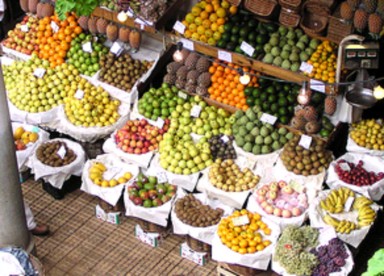
Figure 23.4: Good sources of phytochemicals. (9)
Eating Disorders
Eating disorders are psychiatric illnesses that involve abnormal patterns of eating. A person with an eating disorder has a compulsion to eat in a way that causes physical, mental, and emotional health problems. Typically, the person has an obsession with food and weight. Eating disorders are more common in females. One reason may be society’s focus on female appearance. The most common eating disorders are binge eating disorder, anorexia nervosa, and bulimia nervosa.
www.ck12.org 1250
Binge Eating Disorder
Binge eating disorder is characterized by compulsive overeating. People with the disorder typically eat very large quantities of food in a short period of time. They may use food as a way to deal with painful emotions or stress. Many people with the disorder are overweight or obese. The disorder is rapidly increasing in prevalence and is now the most common eating disorder in the U.S. The rise in binge eating disorder is one reason for the dramatic increase in obesity in this country
Anorexia Nervosa
Anorexia nervosa is characterized by greatly restricted food intake and low body weight (BMI less than 17.5 kg/m2). People with anorexia nervosa usually have a distorted body image. They think they are too fat when they are actually too thin. They have an obsessive fear of gaining weight and voluntarily starve themselves. They may also exercise excessively to help keep their weight low. Females with anorexia nervosa usually stop having menstrual periods. The disorder mainly affects teenage girls and is extremely serious. At least 10 percent of people with anorexia nervosa die from factors related to the disorder.
Bulimia Nervosa
Bulimia nervosa is characterized by cycles of binge eating followed by purging to eliminate the food from the body. Purging may be achieved through intentional vomiting or excessive use of laxatives. People with this disorder typically have normal weight or weight slightly greater than normal. Repeated purging can lead to dehydration. Excessive vomiting can damage the teeth and organs of the digestive system. Bulimia nervosa occurs most often in teenage girls and young women.
Causes and Treatment
People with eating disorders usually have other mental health problems as well, most com- monly depression. Both depression and eating disorders may have the same underlying physiological cause: low levels of the brain chemical serotonin. The process of eating causes serotonin to be released and may lead to a temporary “high.” The process of purging may also have this effect in people with bulimia nervosa.
Environmental factors play a role in most cases of eating disorders, as they do with depression and other mental health problems. Childhood abuse may be one of these environmental factors. Many people with eating disorders report having been abused as children.
Eating disorders can be treated with psychiatric therapy or psychological counseling. Medi- cations may also be prescribed. Treatment usually includes resolving underlying emotional
1251 www.ck12.org
problems, as well as treating depression or other mental health disorders that are also present. In patients with anorexia nervosa, weight gain is also an important goal of treatment.
Lesson Summary
Macronutrients include carbohydrates, proteins, and lipids. They are needed in rela- tively large amounts to supply the body with energy and building materials.
Balanced eating can provide the body with the nutrients it needs without causing weight gain. Balanced eating includes eating a wide variety of healthful foods.
Vitamins and minerals are micronutrients. They are needed in relatively small amounts to control many body processes.
Eating disorders are serious but treatable psychiatric illnesses. They involve abnormal eating patterns and an obsession with food and weight.
Review Questions
Which classes of nutrients provide the body with energy?
How is obesity diagnosed?
Identify the two main classes of micronutrients and give an example of each.
What is an eating disorder?
If Jera is a 15-year-old female, how many grams of carbohydrates and proteins should she eat each day?
How can MyPyramid help you have a balanced diet?
Why is it more dangerous to consume too much of a fat-soluble vitamin than a water- soluble vitamin?
Compare and contrast anorexia nervosa and bulimia nervosa.
Further Reading / Supplemental Links
Sizer, Frances and Whitney, Ellie, Nutrition: Concepts and Controversies (10th edi- tion). Brooks Cole, 2005.
Whitney, Eleanor Noss and Rolfes, Sharon Rady, Understanding Nutrition (11th edi- tion). Wadsworth Publishing, 2007.
Willett, Walter, M.D. and Skerrett, P.J., Eat, Drink, and Be Healthy: The Harvard Medical School Guide to Healthy Eating. Free Press, 2005.
National Academy of Sciences, Dietary Reference Intakes for Calcium, Phosphorous, Magnesium, Vitamin D, and Fluoride. NAS, Institute of Medicine, Food and Nutrition Board, 1997. Available on the Web at
http://www.nap.edu
National Academy of Sciences, Dietary Reference Intakes for Energy, Carbohydrate,
Fiber, Fat, Fatty Acids, Cholesterol, Protein, and Amino Acids. NAS, Institute of
www.ck12.org 1252
Medicine, Food and Nutrition Board, 2002. Available online at:
National Academy of Sciences, Dietary Reference Intakes for Thiamin, Riboflavin, Niacin, Vitamin B6, Folate, Vitamin B12, Pantothenic Acid, Biotin, and Choline. NAS, Institute of Medicine, Food and Nutrition Board, 1998. Available online at:
National Academy of Sciences, Dietary Reference Intakes for Vitamin A, Vitamin K, Arsenic, Boron, Chromium, Copper, Iodine, Iron, Manganese, Molybdenum, Nickel, Silicon, Vanadium, and Zinc. NAS, Institute of Medicine, Food and Nutrition Board, 2001. Available online at:
National Academy of Sciences, Dietary Reference Intakes for Vitamin C, Vitamin E, Selenium, and Carotenoids. NAS, Institute of Medicine, Food and Nutrition Board, 2000. Available online at:
Duyff, Roberta Larson, American Dietetic Association Complete Food and Nutrition Guide (3rd revised edition). Wiley, 2006.
Haas, Elson M. and Levin, Buck, Staying Healthy with Nutrition, 21st Century Edition: The Complete Guide to Diet and Nutritional Medicine. Celestial Arts, 2006.
Kotz, Deborah, “Eating Disorders: Binge Eating More Common than Anorexia and Bulimia.” U.S. News & World Report, 2007. Available online at:
http://health.usnews.com/usnews/health/articles/070205/5health.binge.htm.
Leitzell, Katherine, “‘Good Carbs’ Yield Newfound Benefits.” U.S. News & World Report, 2007. Available online at:
http://health.usnews.com/usnews/health/articles/070719/19glycemia.htm.
Meadows, Michelle, “Nutrition: Healthy Eating.” MedicineNet, Inc., 2006. Available online at:
http://www.medicinenet.com/nutrition/article.htm.
www.cdc.gov/nccdphp/dnpa/nutrition.htm
http://www.medicinenet.com/script/main/art.asp?articlekey=10289
http://www.keepkidshealthy.com/adolescent/adolescentnutrition.html
www.kidshealth.org/teen/nutrition
www.mypyramid.gov/
www.nlm.nih.gov/medlineplus/nutrition.html
www.nutrition.gov/
www.pamf.org/teen/health/nutrition/veggieteens.html
www.sciencedaily.com/news/health_medicine/nutrition
http://en.wikipedia.org
Vocabulary
anorexia nervosa Eating disorder characterized by greatly restricted food intake and low body weight.
bulimia nervosa Eating disorder characterized by cycles of binge eating followed by purg- ing to eliminate the food from the body.
1253 www.ck12.org
binge eating disorder Eating disorder characterized by compulsive overeating. People with the disorder typically eat very large quantities of food in a short period of time.
carbohydrates Organic (or carbon-containing) compounds consisting of the elements car- bon, hydrogen, and oxygen; provides the body with energy.
complete proteins Contain all ten essential amino acids; found in animal foods such as milk and meat.
eating disorder Psychiatric illnesses that involve abnormal patterns of eating.
essential amino acids Amino acids that cannot be synthesized and must be obtained from the diet.
hyponatremia A condition in which the brain swells with water, causing symptoms such as nausea, vomiting, headache, and coma.
incomplete proteins Proteins that are missing one or more essential amino acids; found in plant foods such as legumes and rice.
lipids (fatty acids) Organic compounds that consist of repeating units of carbon, hydro- gen, and oxygen; provide the body with energy.
macronutrients Nutrients that the body needs in relatively large amounts; include car- bohydrates, proteins, lipids, and water.
metabolic syndrome A cluster of conditions that together greatly increase the risk of cardiovascular disease; include type 2 diabetes, high blood pressure, and high blood levels of LDL cholesterol and triglycerides.
micronutrients Nutrients the body needs in relatively small amounts; include vitamins and minerals.
minerals Inorganic chemical elements that are essential for body processes.
MyPyramid A visual representation of how much you should eat each day of foods in different food groups.
nutrients Chemical elements or compounds that the body needs for normal functioning and good health.
www.ck12.org 1254
obesity Occurs when the body mass index is 30.0 kg/m2 or greater.
proteins Relatively large organic compounds containing carbon, hydrogen, oxygen, and nitrogen; made of amino acids.
saturated fatty acids Fatty acids with only single bonds between carbon atoms.
triglyceride Fat; a particular type of lipid in which three fatty acids are bound to a compound called glycerol.
unsaturated fatty acids Fatty acids with at least one double bond between carbon atoms.
vitamins Organic compounds that are needed by the body to function properly. There are 13 vitamins that humans need.
Points to Consider
You need nutrients for energy and building materials. Balanced eating provides you with foods that contain the nutrients you need. How does your body obtain the nutrients from food?
What processes break down food and make nutrients available to the body? What organs carry out the processes?
Lesson 23.2: Digestive System
Lesson Objectives
Describe the organs and major functions of the digestive system.
Explain how the mouth, esophagus, and stomach start the digestion of food.
Explain how the small intestine completes digestion and absorbs nutrients.
State the functions of the large intestine and the roles of intestinal bacteria.
Identify and describe diseases of the digestive system.
Introduction
Suppose you are studying and having trouble concentrating. You decide to eat an apple for energy. How does energy stored in the apple get into your cells? What organs and processes break down the apple into nutrients that the body can use for fuel? What organs and processes let the nutrients enter your bloodstream so they can travel to the cells where they are needed? The basic processes involved are digestion and absorption. The organs involved are the organs of the digestive system.
1255 www.ck12.org
Organs and Functions of the Digestive System
Organs that make up the digestive system are shown in Figure 23.5. Most of the organs form the gastrointestinal tract. Other digestive organs are called accessory organs. As you read about the organs below, refer to Figure 23.5 for reference.
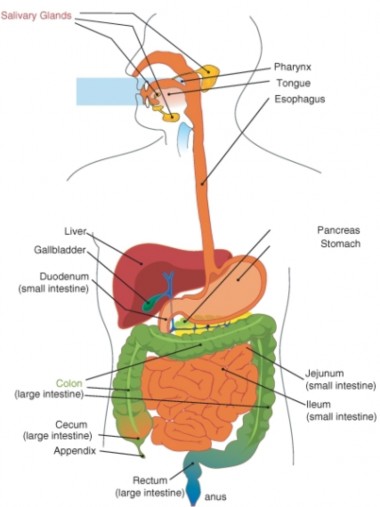
Figure 23.5: Organs of the digestive system. (13)
Gastrointestinal Tract
The gastrointestinal (GI) tract is a long tube that connects the mouth with the anus. It is more than 9 meters long in adults. The GI tract can be divided into an upper and lower part. The upper GI tract includes the mouth, esophagus, and stomach. The lower GI tract
www.ck12.org 1256
includes the small and large intestines. Food enters the mouth, passes through the upper and lower GI tracts, and then exits the body as feces through the anus.
The organs of the GI tract are covered by two layers of muscles that enable peristalsis. Peristalsis is a rapid, involuntary, wave-like contraction of muscles. It pushes food through the GI tract. The inside of GI tract is lined with mucous membranes. Mucous membranes are moist tissues that can secrete and absorb substances. The ability to secrete and absorb substances is necessary for the functions of the digestive system. See http://en.wikipedia. org/wiki/File:Peristalsis.gif for an animation of peristalsis.
Accessory Organs of the Digestive System
In the lower GI tract, additional organs play important roles in digestion. They are called accessory organs. Food does not pass through them, but they make or store substances needed for digestion. The accessory organs are the liver, gall bladder, and pancreas.
The liver is a large organ next to the stomach. It produces digestive substances that are carried by ducts, or tubes, to the small intestine and gall bladder.
The gall bladder is a small, pear-shaped structure below the liver. It stores substances from the liver until they are needed by the small intestine.
The pancreas is a gland below the stomach. It produces digestive substances that are carried by a duct to the small intestine.
The Liver
The liver is a vital organ that has many functions, including detoxification of blood, protein synthesis, and production of biochemicals necessary for digestion. The liver is also involved in glucose balance. The liver produces bile which breaks down lipids.
The liver performs several roles in carbohydrate metabolism, which help in the balance of blood glucose levels:
Gluconeogenesis: the synthesis of glucose from certain amino acids, lactate or glycerol
Glycogenolysis: the breakdown of glycogen into glucose
Glycogenesis: the formation of glycogen from glucose.
The liver is one of the most important organs in the body when it comes to blood filtering and detoxification. The liver is involved in getting rid of foreign substances and toxins, especially from the gut. The toxins are usually excreted in bile or urine. Breaking down toxins is referred to as drug metabolism, and is usually done using specialized enzymes produced in the liver. Most of the blood being filtered by the liver is from the portal vein, which carries blood from the intestines. The liver can remove a broad range of microorganisms such as
1257 www.ck12.org
bacteria, fungi, viruses and parasites from the blood. Infections and parasites can come from contaminated water and food, and then find their way into your gut and blood stream. Luckily the blood then goes to the liver for filtering.
The liver also performs several roles in lipid metabolism including cholesterol synthesis and the production of triglycerides (fats). The liver produces coagulation factors I (fibrinogen), II (prothrombin), V, VII, IX, X and XI, as well as protein C, protein S and antithrombin.
Functions of the Digestive System
The digestive system has three main functions: digestion of food, absorption of nutrients, and elimination of solid waste. Digestion is the process of breaking down food into components the body can absorb. There are two types of digestion: mechanical and chemical.
Mechanical digestion is the physical breakdown of chunks of food into smaller pieces. It takes place mainly in the mouth and stomach.
Chemical digestion is the chemical breakdown of large, complex food molecules into smaller, simpler nutrient molecules that can be absorbed by the blood. It takes place mainly in the small intestine.
Chemical digestion could not take place without the help of digestive enzymes. Enzymes are substances that speed up chemical reactions. Digestive enzymes speed up the reactions of chemical digestion. Digestive enzymes are secreted by glands in the mucous membranes of the mouth, stomach, small intestine, and pancreas. Different digestive enzymes help break down different types of food molecules, including carbohydrates, proteins, and lipids.
The name of a digestive enzyme typically ends with the suffix -ase, which means “enzyme”. The rest of the name refers to the type of food molecules the enzyme helps digest. For example, the enzyme lipase helps digest lipid molecules, and the enzyme lactase helps digest molecules of the sugar lactose.
After food is digested, the resulting nutrients are absorbed. Absorption is the process in which substances pass into the blood stream, where they can circulate throughout the body. Absorption occurs mainly in the small intestine. Any remaining indigestible matter that cannot be absorbed passes into the large intestine as waste. The waste later passes out of the body through the anus in the process of elimination.
The Start of Digestion: The Mouth to the Stomach
The upper GI tract is the primary site of mechanical digestion. The chemical digestion of carbohydrates and proteins also begins in the upper GI tract.
www.ck12.org 1258
The Mouth
The mouth is the first organ in the digestive tract, but digestion may start even before you put the first bite of food in your mouth. Why? The sight or aroma of an appetizing dish can stimulate the release of digestive enzymes by salivary glands inside your mouth. The major salivary enzyme is amylase. Once you start eating, amylase begins the chemical digestion of carbohydrates in the food. It helps break down complex starch molecules into simpler sugar molecules.
The mouth also plays an important role in mechanical digestion. The teeth help to digest food mechanically by breaking it into smaller pieces. Human teeth have different shapes and functions. As you can see in Figure 23.6, the incisors and canines at the front of the mouth are relatively thin and sharp. They shear and tear food when you bite into it. The premolars and molars at the back of the mouth are larger and broader. They grind food into smaller pieces as you chew.
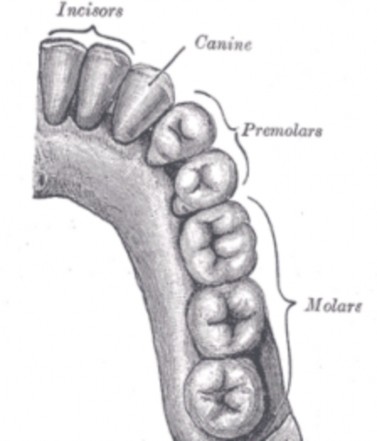
Figure 23.6: Types of human teeth. (12)
Saliva from the salivary glands moistens the food and makes it easier to chew. The muscular
1259 www.ck12.org
tongue helps mix the food with saliva and the enzymes it contains. When you swallow, the lump of chewed food, now called a bolus, passes into the pharynx.
The pharynx connects the mouth to the rest of the digestive tract. It also connects the mouth and nose to the rest of the respiratory system. As food is pushed to the back of the mouth by the tongue, it sets off an automatic response that closes the pharynx off from the respiratory system. This prevents you from accidentally inhaling food when you swallow.
Esophagus
From the pharynx, the bolus moves into the esophagus. The esophagus is a narrow tube about 20 centimeters long in adults. It begins at the pharynx, passes through the chest, and ends at the opening to the stomach. The function of the esophagus is to pass food from the mouth to the stomach. This takes only a few seconds. The esophagus does not produce digestive enzymes and does not have any other digestive functions.
Food moves through the esophagus due to peristalsis. At the end of the esophagus, a muscle called a sphincter controls the entrance to the stomach. The sphincter opens to let food into the stomach and then closes again to prevent the food from passing back into the esophagus.
Stomach
The stomach is a saclike organ located between the end of the esophagus and the beginning of the small intestine. In the stomach, food is further digested both mechanically and chemically. Churning movements of the stomach’s thick muscular walls break down food mechanically. The churning movements also mix the food with fluids secreted by the stomach. These fluids include hydrochloric acid and digestive enzymes.
Hydrochloric acid gives the stomach a very acidic environment. This helps destroy any bacteria that have entered the stomach in foods or beverages. An acidic environment is also needed for the stomach’s digestive enzymes to work.
Digestive enzymes secreted in the stomach help break down proteins into smaller molecules called peptides. The main digestive enzyme in the stomach is pepsin.
Water, alcohol, salt, and simple sugars can be absorbed through the lining of the stomach. Most other substances need further digestion in the small intestine before they can be ab- sorbed. The stomach stores the food until the small intestine is ready to receive it. It may hold up to four liters of food when fully expanded. When the small intestine is empty, a sphincter opens between the stomach and small intestine. This allows the partially digested food, now called chyme, to enter the small intestine.
www.ck12.org 1260
Digestion and Absorption: The Small Intestine
The small intestine is narrow tube about seven meters long in adults. It is the site of most chemical digestion and virtually all absorption. As you can see from Figure 1, the small intestine is much longer than the large intestine. It is called “small” because it is smaller in diameter than the large intestine. Like the rest of the GI tract, the small intestine pushes food along with peristalsis. The small intestine is made up of three parts: the duodenum, jejunum, and ileum. Each part has a different function.
Digestion in the Small Intestine
The duodenum is the first part of the small intestine. It is only about 25 cm long, but most chemical digestion occurs here. Many enzymes are active in the duodenum, and several are listed in Table 23.6. Some of the enzymes are produced by the duodenum. The rest are produced by the pancreas and secreted into the duodenum.
Table 23.6: Digestive Enzymes Active in the Duodenum
Name of Enzyme | Nutrient It Digests | Site of Production |
Amylase | carbohydrates | pancreas |
Trypsin | proteins | pancreas |
Lipase | lipids | pancreas |
Maltase | carbohydrates | small intestine |
Peptidase | proteins | small intestine |
Lipase | lipids | small intestine |
How does the pancreas “know” when to secrete enzymes into the small intestine? The pancreas is controlled by compounds called hormones. Hormones are chemical messengers in the body. They regulate many body functions, including secretion of digestive enzymes. When food enters the stomach, a hormone called gastrin is secreted by the stomach. Gastrin, in turn, stimulates the pancreas to secrete its digestive enzymes.
The liver produces fluid called bile, which is secreted into the duodenum. Some bile goes to the gall bladder, where it is stored and becomes more concentrated. In the duodenum, bile breaks up large globules of lipids into smaller globules that are easier for lipase enzymes to break down chemically.
Bile also reduces the acidity of the chyme entering from the highly acidic stomach. This is important for digestion, because digestive enzymes in the duodenum require a neutral environment in order to work. The pancreas also contributes to the neutral environment of the duodenum by secreting bicarbonate, a basic substance that neutralizes acid.
1261 www.ck12.org
Absorption in the Small Intestine
The jejunum is the second part of the small intestine. It is about 2.5 meters long. This is where most nutrients are absorbed into the blood.
As shown in Figure 23.7, the mucous membrane lining the jejunum is covered with micro- scopic, fingerlike projections called villi (singular: villus). Each villus, in turn, has thousands of even smaller projections called microvilli (singular: microvillus). The villi contain cap- illaries, which are tiny blood vessels. Nutrients are absorbed into these capillaries across the surface of the villi and microvilli. Because there are millions of these tiny projections, they greatly increase the surface area for absorption. In fact, villi and microvilli increase the absorptive surface of the small intestine to the size of a tennis court! This allows far greater absorption of nutrients.
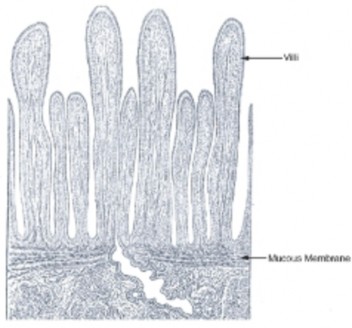
Figure 23.7: Magnified image of villi lining the jejunum (small intestine). (2)
The ileum is the third part of the small intestine. It is about 3.5 meters long. A few remaining nutrients are absorbed in the ileum. Salts that form from liver bile are also absorbed there. Like the jejunum, the ileum is covered with villi and microvilli that increase the area for absorption.
The Large Intestine and Its Functions
From the small intestine, any remaining food waste passes into the large intestine. The large intestine is a relatively wide tube that connects the small intestine with the anus. It is about
www.ck12.org 1262
meters long. The large intestine consists of three parts: the cecum, colon, and rectum.
Absorption of Water and Elimination of Wastes
The cecum is the first part of the large intestine, where waste enters from the small intestine. The waste is in a liquid state. As the waste passes through the colon, which is the second part of the large intestine, excess water is absorbed. After the excess water is absorbed, the remaining solid waste is called feces. Feces contain indigestible food substances such as fiber.
Feces accumulate in the rectum, which is the third part of the large intestine. As the rectum fills, the feces become compacted. The feces are stored in the rectum until they are eliminated from the body. A sphincter controls the anus and opens to let feces through to the outside. It normally takes from 12 to 24 hours for wastes to enter the cecum, move through colon, accumulate in the rectum, and pass from the body as feces.
Bacteria in the Large Intestine
Other functions of the large intestine are to provide a home for intestinal bacteria and to absorb the vitamins they produce. Trillions of bacteria normally live in the large intestine. Some of these bacteria are harmful to the body if they grow out of control. However, most of the bacteria are helpful. They produce several vitamins, including vitamins B12 and K. Intestinal bacteria play other helpful roles, as well. For example, they:
control the growth of harmful bacteria.
break down toxins before they can poison the body.
break down indigestible food components.
produce substances that help prevent colon cancer.
Diseases of the Digestive System
A number of diseases can affect the entire gastrointestinal tract. Other diseases affect par- ticular organs of the GI tract. Still others affect accessory organs of the digestive system.
Diseases of the Gastrointestinal Tract
A group of diseases that affect the GI tract is called inflammatory bowel disease. Inflamma- tory bowel disease is inflammation of the large intestine and, in some cases, other parts of the GI tract. Inflammation is a normal reaction of the immune system to injury or infection that causes swelling, redness, and pain.
1263 www.ck12.org
The two main forms of inflammatory bowel disease are Crohn’s disease and ulcerative colitis. Both have similar symptoms, including abdominal pain, diarrhea, and weight loss. Crohn’s disease is caused by the immune system reacting to the body’s own tissues, but the cause of ulcerative colitis is not known. A tendency to develop the diseases may be inherited. Ulcerative colitis is confined to the colon and sometimes can be cured with surgery. Crohn’s disease may occur anywhere in the GI tract and has no known cure, although treatment can control the symptoms.
Food allergies can also affect the entire GI tract. Food allergies are disorders that occur when the immune system reacts to substances in food as though they were harmful “foreign invaders.” Foods that are most likely to cause allergies are nuts, eggs, milk, fish, and shellfish. Symptoms of food allergies may include tingling in the mouth, vomiting, and diarrhea. Food allergies can also cause skin rashes and difficulty breathing. An estimated eight percent of children and two percent of adults have food allergies.
Diseases of the Stomach and Esophagus
A layer of mucus normally protects the lining of the stomach from damage by hydrochloric acid. An infection by bacteria of the species Helicobacter pylori can weaken this mucus layer, allowing acid to get through to the delicate mucous membranes underneath. The acid may cause gastritis or stomach ulcers, both of which can be treated with medication.
Gastritis is inflammation of the lining of the stomach. It causes abdominal pain.
A stomach ulcer is a sore in the lining of the stomach. It causes severe abdominal pain and bleeding.
Stomach acid may also damage the lining of the esophagus. This can occur when the sphincter between the stomach and esophagus does not close properly. This lets acid from the stomach enter the esophagus. The acid may cause esophagitis, or inflammation of the esophagus. A common symptom of esophagitis is heartburn, which is a painful, burning sensation in the throat or chest. Esophagitis can be treated with medication and changes in diet. It is important to treat the condition because it sometimes leads to cancer of the esophagus if not treated.
Diseases of the Small Intestine
Diseases that affect the small intestine include ulcers, infections, and celiac disease. Ulcers of the small intestine occur mainly in the duodenum, because stomach acid enters the duodenum during digestion. If an infection by Helicobacter pylori weakens the mucous layer in the duodenum, the stomach acid can damage the mucous membranes underneath. Symptoms and treatment of duodenal ulcers are similar to those of stomach ulcers.
www.ck12.org 1264
Other bacteria may also cause infections in the small intestine, including Salmonella and
E. coli. The bacteria can enter the body in contaminated foods or beverages. Symptoms of bacterial infections include abdominal pain, cramping, vomiting, and diarrhea. Such infections typically clear up on their own without medical treatment.
Celiac disease is an immune reaction to a food protein called gluten, which is found in grains. A tendency to have celiac disease can be inherited. Symptoms of the disease include abdominal pain, diarrhea, and bloating. The symptoms can be prevented by eating a gluten- free diet, but there is no cure for the disease.
Diseases of the Large Intestine
Diseases that affect the large intestine include irritable bowel syndrome, colitis, and appen- dicitis. Irritable bowel syndrome (IBS) is a disorder in which the large intestine is easily irritated. It is one of the most common gastrointestinal disorders. The cause of IBS is unknown, but may be due to excessive bacteria in the intestine. Symptoms of the disorder include abdominal pain, cramping, constipation, and diarrhea. Symptoms can often be con- trolled with medication, stress management, and changes in diet. However, there is no cure for IBS.
Colitis is inflammation of the colon. It has many possible causes, ranging from bacterial infections to immune reactions against the body’s own tissues. Symptoms of colitis include pain and tenderness in the abdomen. Treatment of colitis may include medication, surgery, and changes in diet.
Appendicitis is inflammation of the appendix. It is most common in children and teens. The appendix is a small, fingerlike pouch that extends from the cecum (see Figure 23.5). Inflammation of the appendix is usually caused by a bacterial infection. Symptoms include abdominal pain, loss of appetite, fever, and vomiting. Appendicitis is most often treated with surgery to remove the infected appendix. Without treatment, an infected appendix can be fatal.
Diseases of the Accessory Organs
Accessory organs of digestion can also be affected by disease, and this may interfere with normal digestion. A disease that affects the pancreas is cystic fibrosis. Cystic fibrosis (CF) is an inherited disease in which the body produces abnormally thick and sticky mucous. In the pancreas, the mucus blocks the duct to the duodenum, preventing pancreatic enzymes from reaching it. As a result, proteins and lipids cannot be digested properly. People with CF may take digestive enzymes by mouth to improve their digestion. However, the disease has no known cure. (For more information on CF, see chapter titled Human Genetics.)
Hepatitis is inflammation of the liver. It is usually caused by a viral infection. Several
1265 www.ck12.org
different viruses can cause hepatitis. Some of the viruses spread through contaminated foods or beverages, others through sexual contact. Symptoms of hepatitis include fever, headache, vomiting, and abdominal pain. Another symptom is jaundice, which is yellowing of the skin and eyes. If the symptoms are mild, the disease may clear up without treatment. If the symptoms are more severe, the disease may damage the liver so it can no longer produce bile. This interferes with the digestion of lipids. Medications are available to treat hepatitis. Some types of hepatitis can also be prevented with vaccines.
Gall bladder problems occur mainly in adults. They are often caused by gall stones (Figure 23.8). Gall stones are crystals that form in the bile in the gall bladder. There are many possible reasons why gall stones form, including abnormal body chemistry and too much fat in the diet. Gall stones start out as small as a grain of sand but may grow to the size of a golf ball. There may be one large stone or many small ones. If gall stones block the duct that carries bile to the duodenum, they may cause inflammation of the gall bladder and severe abdominal pain. Generally, the only way to treat these problems is to surgically remove the gall stones or the entire gall bladder.
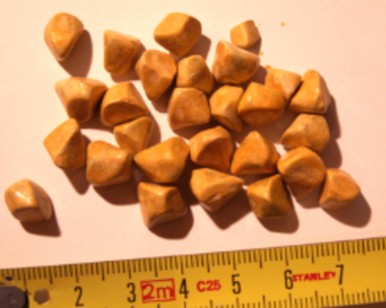
Figure 23.8: Gall stones. (1)
Lesson Summary
The digestive system includes the gastrointestinal tract and accessory organs such as the pancreas. The major functions of the digestive system are to digest food, absorb nutrients, and eliminate solid waste.
Both mechanical and chemical digestion of food start in the mouth. The esophagus www.ck12.org 1266
carries the food to the stomach, and the stomach continues mechanical and chemical digestion.
Most chemical digestion takes place in the small intestine with the help of several digestive enzymes. Virtually all absorption of nutrients also takes place in the small intestine.
The large intestine removes excess water from waste and eliminates waste from the body. It also provides a home for helpful intestinal bacteria.
Many diseases affect the digestive system and may interfere with digestion. They include food allergies, infections, and inherited conditions.
Review Questions
Name, in sequence, the digestive organs that food passes through in the gastrointestinal tract, from the mouth to the anus.
Describe two ways that the mouth helps digest food.
How do villi and microvilli help the small intestine absorb nutrients?
What are two functions of helpful bacteria in the large intestine?
Describe what happens to carbohydrates as they pass through the organs of the GI tract.
Antibiotics are medications that destroy bacteria. Explain how antibiotics might help treat stomach ulcers.
Why is it important for digestive system functions that mucous membranes can secrete and absorb substances?
Compare and contrast two digestive enzymes that work in the duodenum.
Further Reading / Supplemental Links
Brynie, Faith Hickman, 101 Questions about Food and Digestion that Have Been Eating at You Until Now. Lerner Publishing Group, 2002.
Dowshen, Stephen, M.D., “Digestive System.” Nemours Foundation, 2007. Available online at: www.kidshealth.org/teen/your_body/body_basics/digestive_system.html.
Johnson, Rebecca L., The Digestive System. Lerner Publications, 2004.
Minocha, Anil and Adamec, Christine A., The Encyclopedia of the Digestive System and Digestive Disorders. Facts on File, 2004.
Nagel, Rob, Body by Design: From the Digestive System to the Skeleton. UXL, 2000.
http://en.wikibooks.org/wiki/Human_Physiology/The_gastrointestinal_system
http://library.thinkquest.org/12090/
http://www.biology-online.org/7/6_food.htm
http://www.vivo.colostate.edu/hbooks/pathphys/digestion/
http://digestive.niddk.nih.gov/ddiseases/pubs/yrdd/
http://en.wikipedia.org
1267 www.ck12.org
Vocabulary
absorption The process in which substances pass into the blood stream, where they can circulate throughout the body; occurs mainly in the small intestine.
amylase The major salivary enzyme is amylase; begins the chemical digestion of carbo- hydrates in the food; helps break down complex starch molecules into simpler sugar molecules.
cecum The first part of the large intestine, where waste enters from the small intestine.
celiac disease An immune reaction to a food protein called gluten, which is found in grains.
chemical digestion The chemical breakdown of large, complex food molecules into smaller, simpler nutrient molecules that can be absorbed by the blood; takes place mainly in the small intestine.
colon The second part of the large intestine, where excess water is absorbed. After the excess water is absorbed, the remaining solid waste is called feces.
duodenum The first part of the small intestine; site where most chemical digestion occurs.
esophagus A narrow tube - begins at the pharynx, passes through the chest, and ends at the opening to the stomach. The function of the esophagus is to pass food from the mouth to the stomach.
gall bladder A small, pear-shaped structure below the liver; stores substances from the liver until they are needed by the small intestine.
gastritis Inflammation of the lining of the stomach.
gastrointestinal (GI) tract Organ of the digestive system; a long tube that connects the mouth with the anus.
ileum The third part of the small intestine. A few remaining nutrients are absorbed in the ileum, as are salts that form from liver bile.
inflammatory bowel disease Inflammation of the large intestine and, in some cases, other parts of the GI tract; includes Crohn’s disease and ulcerative colitis.
www.ck12.org 1268
irritable bowel syndrome (IBS) A disorder in which the large intestine is easily irri- tated.
jejunum The second part of the small intestine; where most nutrients are absorbed into the blood.
large intestine A relatively wide tube that connects the small intestine with the anus; consists of three parts: the cecum, colon, and rectum.
liver A large organ next to the stomach; produces digestive substances that are carried by ducts, or tubes, to the small intestine and gall bladder.
lower GI tract Segment of the GI tract that includes the small and large intestines.
mechanical digestion The physical breakdown of chunks of food into smaller pieces; takes place mainly in the mouth and stomach.
mucous membranes Moist tissues that can secrete and absorb substances.
pancreas A gland below the stomach; produces digestive substances that are carried by a duct to the small intestine.
peristalsis A rapid, involuntary, wave-like contraction of muscles; pushes food through the GI tract.
pharynx Connects the mouth to the rest of the digestive tract; also connects the mouth and nose to the rest of the respiratory system.
rectum The third part of the large intestine; where feces accumulates. As the rectum fills, the feces become compacted. The feces are stored in the rectum until they are eliminated from the body.
small intestine A narrow tube leading away from the stomach; made up of three parts: the duodenum, jejunum, and ileum; the site of most chemical digestion and virtually all absorption.
stomach A saclike organ located between the end of the esophagus and the beginning of the small intestine. In the stomach, food is further digested both mechanically and chemically.
stomach ulcer A sore in the lining of the stomach.
upper GI tract Segment of the GI tract that includes the mouth, esophagus, and stom- ach.
1269 www.ck12.org
Points to Consider
The large intestine eliminates the waste that remains after food is digested. More waste is produced when cells break down nutrients for energy and building materials. How is this waste removed from the body? Is it eliminated by the large intestine? Is it removed in some other way?
Lesson 23.3: Excretory System
Lesson Objectives
Define homeostasis and excretion, and explain why they are necessary for life.
Describe the urinary system, kidneys, and nephrons; summarize the processes involved in excretion.
Identify roles of the kidneys in homeostasis.
Name diseases of the urinary system, and explain how dialysis helps treat kidney failure.
Introduction
If you exercise on a hot day, you are likely to lose a lot of water in sweat. Then, for the next several hours, you may notice that you do not pass urine as often as normal and that your urine is darker than usual. Do you know why this happens? Your body is low on water and trying to reduce the amount of water lost in urine. How does the body know when it is low on water? How does it control the amount of water lost in urine? The answers to both questions are the kidneys and the glands that control them.
Homeostasis and Excretion
The kidneys are the body’s main organs of homeostasis and excretion. Homeostasis is the body’s attempt to maintain a constant internal environment. One of the major ways the body achieves homeostasis is through excretion. Excretion is the process of removing wastes and excess water from the body.
Homeostasis
Homeostasis is a fundamental characteristic of all living things. Internal body conditions must be kept within certain limits for the normal functioning of cells. Homeostasis involves keeping many internal factors at more or less constant levels. The factors include body
www.ck12.org 1270
temperature and properties of the blood. For example, the blood must have certain levels of acidity, salts, and nutrients in order for cells to function normally.
A variety of homeostatic mechanisms help maintain stability of the internal environment. Each mechanism involves the interaction of at last three components: a receptor, a control center, and an effector.
The receptor senses changes in the internal environment and sends the information to the control center.
The control center processes the information, determines the appropriate action, and sends a command to the effector.
The effector responds to the command and changes conditions in the internal environ- ment.
An example of a homeostatic mechanism in humans is the regulation of body temperature. This is represented by the diagram in Figure 23.9. Temperature receptors in the skin send information about skin temperature to the brain. The brain is the control center. It determines whether the temperature is too high or too low and sends appropriate commands to effectors that control body temperature. Effectors include blood vessels near the surface of the body. If the temperature is too high, the brain commands the blood vessels to dilate, which helps the body lose heat. If the temperature is too low, the brain commands the blood vessels to constrict, which helps the body retain heat. These actions help return body temperature to normal.
Negative Feedback and Body Temperature
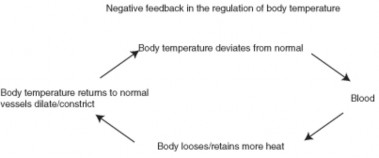
Figure 23.9: Regulation of body temperature is an example of negative feedback. When body temperature deviates from normal, this information feeds back to the brain and sets in motion changes that return body temperature to normal. (8)
The regulation of body temperature is an example of negative feedback. Negative feedback is a type of homeostatic mechanism in which change in one direction results in a counteractive
1271 www.ck12.org
change in the opposite direction. Negative feedback reverses the direction of change to bring conditions back to normal. Most of the mechanisms that control homeostasis in the human body involve negative feedback.
Positive feedback mechanisms also exist, but they are not common in the human body. Positive feedback accelerates or amplifies a change and pushes levels farther away from normal. One example of a positive feedback mechanism in the body is blood clotting, which is described in the chapter titled Circulatory and Respiratory Systems.
If homeostasis is disturbed, a homeostatic imbalance results. This may result in cells getting too much or not enough of certain substances. Many diseases are caused by homeostatic imbalances. For example, diabetes mellitus is a disease in which the blood contains too much glucose. This can have serious consequences for cells throughout the body. It may lead to damaged blood vessels, heart disease, blindness, and kidney failure.
Excretion
Excretion is an essential process in all forms of life. When cells metabolize—or break down—nutrients, waste products are produced. For example, when cells metabolize pro- teins and nucleic acids, nitrogen wastes such as ammonia, urea and uric acid are produced. Ammonia is a toxic substance and must be removed from the blood and excreted from the body. Urea is removed through urine, which is produced in the kidney. Excretion is also necessary to remove excess water, salts, and many other substances from the body.
Although the kidneys are the main organs of excretion of wastes from the blood, several other organs are also involved in excretion, including the large intestine, liver, skin, and lungs.
The large intestine eliminates solid wastes that remain after the digestion of food in the gastrointestinal tract (as discussed in Lesson 23.2: Digestive System).
The liver breaks down excess amino acids in the blood to form ammonia, and then converts the ammonia to urea, a less toxic substance. The liver also breaks down other toxic substances in the blood, including alcohol and drugs.
The skin eliminates water and salts in sweat.
The lungs exhale water vapor and carbon dioxide.
Kidneys and Excretion
The kidneys are part of the urinary system. The kidneys work together with other urinary system organs in the function of excretion. The urinary system is shown in Figure 23.10.
www.ck12.org 1272
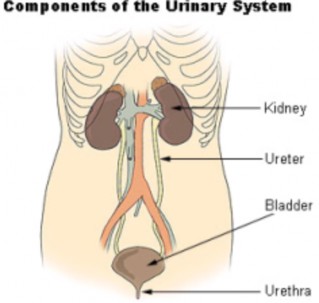
Figure 23.10: The urinary system. (10)
Urinary System
In addition to the kidneys, the urinary system includes the ureters, bladder, and urethra. The main function of the urinary system is to filter waste products and excess water from the blood and remove them from the body. The two kidneys, which are described in detail below, filter the blood and form urine. Urine is the liquid waste product of the body that is excreted by the urinary system.
From the kidneys, urine enters the ureters, which carry it to the bladder. Each ureter is a muscular tube about 25 centimeters long. Peristaltic movements of the muscles of the ureter send urine to the bladder in small spurts.
The bladder is a hollow organ that stores urine. It can stretch to hold up to 500 milliliters. When the bladder is about half full, the stretching of the bladder sends a nerve impulse to the sphincter that controls the opening to the urethra. In response to the impulse, the sphincter relaxes and lets urine flow into the urethra.
The urethra is a muscular tube that carries urine out of the body. Urine leaves the body through another sphincter in the process of urination. This sphincter and the process of urination are normally under conscious control.
1273 www.ck12.org
Kidneys
The kidneys participate in whole-body homeostasis. As mentioned above, one of the promary roles of the kidney is to remove nitrogenous wastes. The kidneys are a pair of bean-shaped, reddish brown organs about the size of a fist. They are located just above the waist at the back of the abdominal cavity, on either side of the spine. As shown in Figure 23.10, the kidneys are protected by the ribcage. They are also protected by a covering of tough connective tissues and two layers of fat, which help cushion them.
Located on top of each kidney is an adrenal gland, also shown in Figure 23.10. The two adrenal glands secrete several hormones. Hormones are chemical messengers in the body that regulate many body functions. The adrenal hormone aldosterone helps regulate kidney functions.

Figure 23.11: The human kidney. (14)
In Figure 23.11, you can see that the kidney has three layers. The outer layer is the renal cortex, and the middle layer is the renal medulla. The inner layer, the renal pelvis, is where the renal artery enters the kidney and the renal vein exits the kidney. The renal artery
www.ck12.org 1274
carries blood to the kidney to be filtered, and the renal vein carries the filtered blood away from the kidney. Structures in the kidney called nephrons are also seen in Figure 23.11. Each nephron extends from the cortex down into the medulla.
Nephrons
Nephrons are the structural and functional units of the kidneys. A single kidney may have more than a million nephrons. The diagram in Figure 23.12 represents an individual nephron and shows its main structures and functions. The structures include the glomerulus, Bow- man’s capsule, and renal tubule.

Figure 23.12: Nephron structures and functions. (6)
The glomerulus is a cluster of arteries that filters substances out of the blood.
Bowman’s capsule is a cup-shaped structure around the glomerulus that collects the filtered substances.
The renal tubule is a long, narrow tube surrounded by capillaries that reabsorbs many of the filtered substances and secretes other substances.
Filtration, Reabsorption, and Secretion
The renal arteries, which carry blood into the kidneys, branch into the capillaries of the glomerulus of each nephron. The pressure of blood moving through these capillaries forces some of the water and dissolved substances in the blood through the capillary walls and into
1275 www.ck12.org
Bowman’s capsule. Bowman’s capsule is composed of layers. The space between the layers, called Bowman’s space, fills with the filtered substances.
The process of filtering substances from blood in the glomerulus is called filtration. The fluid that collects in Bowman’s space is called filtrate. It is composed of water, salts, glucose, amino acids, and urea. Larger structures in the blood—including protein molecules, blood cells, and platelets—do not pass into Bowman’s space. Instead, they return to the main circulation.
From Bowman’s space, the filtrate passes into the renal tubule. The main function of the renal tubule is reabsorption. Reabsorption is the return of needed substances in the filtrate back to the bloodstream. It is necessary because some of the substances removed from the blood by filtration—including water, salts, glucose, and amino acids—are needed by the body. About 75 percent of these substances are reabsorbed in the renal tubule.
As shown in Figure 23.13, the renal tubule is divided into three parts: the proximal tubule, the Loop of Henle, and the distal tubule.

Figure 23.13: Parts of the renal tubule and other nephron structures. (11)
Filtrate first enters the proximal tubule. This is where that most reabsorption takes place. Tiny projections called microvilli line the proximal tubule and increase the surface area for reabsorption. From the proximal tubule, the filtrate passes through the loop of Henle.
The loop of Henle carries the filtrate from the cortex down into the medulla and then back up to the cortex again. Its primary purpose is to reabsorb water and salt from the fluid. The remaining fluid enters the distal tubule.
www.ck12.org 1276
The distal tubule carries the fluid, now called tubular fluid, from the loop of Henle to a collecting duct. As it transports the fluid, the distal tubule also reabsorbs or secretes substances such as calcium and sodium. The process of secreting substances into the tubular fluid is called secretion.
Urine Formation
The collecting ducts are the site of urine formation. This process is crucial for water con- servation in the body. The collecting ducts reabsorb water from tubular fluid and return it to the blood. The remaining fluid, called urine, has a smaller volume and a greater concen- tration than tubular fluid. From the collecting ducts, urine enters a ureter and is eventually excreted from the body.
The reabsorption of water by the collecting ducts is controlled by a negative feedback mecha- nism. The mechanism involves a hormone secreted by the pituitary gland, called antidiuretic hormone (ADH). ADH makes the collecting ducts more permeable to water, allowing more water to be reabsorbed from tubular fluid. When there is not enough water in the blood, more ADH is secreted, more water is reabsorbed from tubular fluid, and less water is excreted in urine. The opposite happens when there is too much water in the blood.
Kidneys and Homeostasis
The kidneys play many vital roles in homeostasis. As you have already read, the kidneys filter blood and excrete liquid waste. In fact, the kidneys filter all the blood in the body about 16 times a day, producing approximately 180 liters of filtrate and about 1.5 liters of urine. The kidneys also control the amount of water in the blood by excreting more or less water in urine.
Balancing the Blood
The kidneys are responsible for maintaining balance in the blood in other ways, as well. For example, they control the acid-base balance in the blood, mainly by secreting hydrogen ions into tubular fluid and reabsorbing bicarbonate ions from tubular fluid as needed. The kidneys also regulate blood concentrations of many other ions—including sodium, potassium, calcium, and magnesium—by the controlling the amounts that are excreted in urine.
Secreting Hormones
The kidneys also secrete various hormones to help maintain homeostasis. Hormones secreted by the kidneys include erythropoietin and rennin.
1277 www.ck12.org
Erythropoietin is secreted when the blood does not have enough red blood cells to carry adequate oxygen. The hormone stimulates the production of red blood cells by the bone marrow.
Rennin is secreted when blood pressure falls. The hormone stimulates the secretion of aldosterone by the adrenal gland. Aldosterone, in turn, stimulates the kidneys to reabsorb more sodium ions and water. This increases the volume of the blood, which causes an increase in blood pressure.
Kidney Disease and Dialysis
A person can live a normal, healthy life with just one kidney. However, at least one kidney must function properly to maintain life. Diseases that threaten the health and functioning of the kidneys include kidney stones, infections, and diabetes.
Kidney Stones
Kidney stones are crystals of dissolved minerals that form in urine inside the kidneys. They may start out as small as a grain of salt and grow to be as large as a grapefruit. There may be one large stone or many small ones. Small kidney stones often pass undetected through the urinary tract and out of the body in urine. However, kidney stones may grow large enough before passing to block a ureter. This can cause a buildup of urine above the blockage and severe pain. Large kidney stones can sometimes be broken into smaller pieces that wash out of the urinary tract in urine. The stones are shattered by high-intensity sound waves focused on them from outside the body. Another alternative is to remove kidney stones surgically.
Infections
Bacterial infections of the urinary tract are very common. In fact, urinary tract infections (UTI) are the second most common type of bacterial infections seen by health care providers. Typical organisms that cause UTIs include Escherichia coli and Staphylococcus saprophyti- cus. The organisms may infect any part of the urinary tract.
The most common type of UTIs are bladder infections. They can be treated with antibiotics prescribed by a doctor. However, if a bladder infection is not treated, it may spread to the kidney and cause a kidney infection, or pyelonephritis. This is the most serious type of UTI. It can damage the kidney and interfere with normal kidney function. Kidney infections can also be treated with antibiotics but may require other treatments as well.
www.ck12.org 1278
Diabetes
Two different types of diabetes can involve the kidneys: diabetes insipidus and diabetes mellitus. Diabetes insipidus is a disease characterized by the inability to concentrate urine. A person with this disease typically produces many liters of very dilute urine each day. Diabetes insipidus can be caused by a deficiency of ADH (antidiuretic hormone) or by the kidneys failing to respond to ADH. If the cause of diabetes insipidus can be treated, it may cure the disease.
In diabetes mellitus, the kidneys try to reduce the high glucose level in the blood by excreting more glucose in urine. This causes frequent urination and increased thirst. If blood glucose levels are not controlled by medication or diet, they may damage capillaries of the glomerulus and interfere with the kidney’s ability to filter blood. Eventually, high glucose levels may lead to kidney failure, in which kidney function is greatly reduced. Kidney failure leads to high levels of urea and other wastes in the blood and may require treatment with dialysis.
Dialysis and Transplantation
Dialysis is a medical procedure in which blood is filtered with the help of a machine. One type of dialysis treatment is shown in Figure 23.14. Blood from the patient’s vein enters the dialysis machine through a tube. Inside the machine, excess water, wastes, and other unneeded substances are filtered from the blood. The filtered blood is then returned to the patient’s vein through another tube. A dialysis treatment usually lasts three to four hours and must be repeated three times a week. Dialysis is generally performed on patients who have kidney failure. Dialysis helps them stay alive, but does not cure their failing kidneys.
The only cure for most people with kidney failure is a kidney transplant. To be suitable for transplantation, the donated kidney must come from a donor who has the same blood and tissue types as the recipient. Even then, the recipient must take medication to suppress the immune system so it does not reject the new kidney.
Lesson Summary
Homeostasis is the body’s attempt to maintain a constant internal environment. Excre- tion helps achieve homeostasis by removing wastes, excess water, and other unneeded substances from the body. Both processes are essential for life.
The urinary system includes the kidneys and other structures that excrete liquid waste. The kidneys are the main organs of excretion of wastes in the blood, and nephrons are structural and functional units of the kidneys. The kidneys filter blood, reabsorb and secrete substances, and form urine.
The kidneys are the main organs of homeostasis. In addition to excretion, they regulate acid-base balance and ion concentrations in the blood. They also secrete hormones that
1279 www.ck12.org

Figure 23.14: Patient receiving dialysis treatment. (7)
www.ck12.org 1280
control other body processes.
Diseases of the urinary system include kidney stones, infections, and diabetes, which may lead to kidney failure. Kidney failure can be treated with dialysis, in which a machine filters the blood.
Review Questions
What are homeostasis and excretion?
Identify three organs of excretion and one substance that each organ excretes.
Why do the kidneys reabsorb some of the substances they filter from the blood?
Describe how urine forms in the collecting ducts of the kidneys.
How does ADH control the amount of water in urine? How is this an example of negative feedback?
Does an otherwise healthy person with just one kidney need dialysis? Why or why not?
Summarize the processes and structures involved in excretion by the kidneys.
Contrast the effects on the kidneys of diabetes insipidus and diabetes mellitus.
Further Reading / Supplemental Links
Gold, Susan Dudley, The Digestive and Excretory Systems. Enslow Publishers, 2004.
O’Callaghan, Christopher A. and Caplan, Louis, The Renal System at a Glance. (2nd edition) Blackwell Publishing, 2006.
Tuso, Philip J., Who Stole My Kidneys? AuthorHouse, 2004.
Watson, Stephanie, The Urinary System. Greenwood Press, 2004.
http://www.estrellamountain.edu/faculty/farabee/biobk/BioBookEXCRET.html
http://www.ishib.org/journal/16-2s2/ethn-16-2s2-40ab.pdf
http://en.wikibooks.org/wiki/Human_Physiology/Homeostasis
http://en.wikibooks.org/wiki/Human_Physiology/The_Urinary_System
http://health.howstuffworks.com/kidney.htm
http://kidney.niddk.nih.gov/kudiseases/pubs/yourkidneys/
http://kidney.niddk.nih.gov/kudiseases/pubs/yoururinary/
http://library.thinkquest.org/22016/excretion/index.html
http://www.kidshealth.org/parent/general/body_basics/kidneys_urinary.html
http://en.wikipedia.org
Vocabulary
bladder A hollow organ that stores urine.
Bowman’s capsule A cup-shaped structure around the glomerulus that collects the fil-
1281 www.ck12.org
tered substances; part of the nephron.
control center Involved in maintaining homeostasis; processes the information, deter- mines the appropriate action, and sends a command to the effector.
dialysis A medical procedure in which blood is filtered with the help of a machine.
effector Involved in maintaining homeostasis; responds to the command and changes con- ditions in the internal environment.
erythropoietin Hormone secreted by the kidney when the blood does not have enough red blood cells to carry adequate oxygen; stimulates the production of red blood cells by the bone marrow.
excretion The process of removing wastes and excess water from the body.
filtration The process of filtering substances from blood in the glomerulus.
glomerulus Part of the nephron; a cluster of arteries that filters substances out of the blood.
homeostasis The body’s attempt to maintain a constant internal environment.
kidney Organ that filters the blood and forms urine.
kidney stones Crystals of dissolved minerals that form in urine inside the kidneys.
loop of Henle Carries the filtrate from the cortex down into the medulla and then back up to the cortex again; primary purpose is to reabsorb water and salt from the fluid.
negative feedback A type of homeostatic mechanism in which change in one direction results in a counteractive change in the opposite direction; reverses the direction of change to bring conditions back to normal.
nephrons The structural and functional units of the kidneys; includes the glomerulus, Bowman’s capsule, and renal tubule.
positive feedback Accelerates or amplifies a change and pushes levels farther away from normal; not common in the human body.
www.ck12.org 1282
reabsorption The return of needed substances in the filtrate back to the bloodstream.
receptor Involved in maintaining homeostasis; senses changes in the internal environment and sends the information to the control center.
renal tubule A long, narrow tube surrounded by capillaries that reabsorbs many of the filtered substances and secretes other substances; part of the nephron.
rennin Hormone secreted by kidney when blood pressure falls; stimulates the secretion of aldosterone by the adrenal gland. Aldosterone, in turn, stimulates the kidneys to reabsorb more sodium ions and water.
urethra A muscular tube that carries urine out of the body.
urinary system System in which the main function is to filter waste products and excess water from the blood and remove them from the body.
urine The liquid waste product of the body that is excreted by the urinary system.
Points to Consider
A transplanted kidney may be rejected unless medication is taken to suppress the immune system. Why does the immune system reject transplanted organs?
How does the immune system recognize transplanted organs as foreign to the body?
What happens when the immune system “attacks” a transplanted organ?
Image Sources
Gall stones.. GFDL.
http://commons.wikimedia.org/wiki/File:Gray1058.png. CC-BY.
CK-12 Foundation. Healthy eating pyramid.. CC-BY-SA.
USDA. [www.MyPyramid.gov ]. Public Domain.
CK-12 Foundation. Nutrition facts label.. CC-BY-SA.
Nephron structures and functions.. Public Domain.
Patient receiving dialysis treatment.. Public Domain.
1283 www.ck12.org
CK12 Foundation. . CC-BY-SA.
Good sources of phytochemicals.. CC-BY-SA.
The urinary system.. GFDL.
http:
//www.estrellamountain.edu/faculty/farabee/biobk/BioBookEXCRET.html. Public Domain.
Types of human teeth.. GFDL.
Mariana Ruiz. Organs of the digestive system.. Public Domain.
The human kidney.. Public Domain.
www.ck12.org 1284
Immune System and Disease
Lesson 24.1: Nonspecific Defenses
Lesson Objectives
Describe mechanical, chemical, and biological barriers that keep most pathogens out of the human body.
Explain how the inflammatory response and white blood cells help fight pathogens that enter the body.
Introduction
The immune system protects the body from ”germs” and other harmful substances. The immune system is like a medieval castle. The outside of a medieval castle was protected by a moat and high stone walls. Inside the castle, soldiers were ready to defend the castle against any invaders that got through the outer defenses. Like a medieval castle, the immune system has a series of defenses. Only pathogens that are able to get through all the defenses can cause harm to the body.
First Line of Defense
The immune system has three lines of defense. The first line of defense includes a variety of barriers against pathogens that keep most pathogens out of the body. Pathogens are disease-causing agents, such as bacteria and viruses. Defenses in the first line are the same regardless of the type of pathogen. This is why they are called nonspecific defenses. Several types of pathogens that are common causes of human disease can be seen in the Figure 24.1.
1285 www.ck12.org

Figure 24.1: Common Human Pathogens (1)
Mechanical Barriers
Mechanical barriers physically block pathogens from entering the body. The skin is the most important mechanical barrier. In fact, it is the single most important defense of the body against pathogens. It forms a physical barrier between the body and the outside world. The outer layer of the skin is a tough, nearly water-proof coating that is very difficult for pathogens to penetrate.
At body openings, such as the mouth and nose, the body has a different mechanical barrier. Instead of skin, mucous membranes line these and other organs that are exposed to the out- side environment. They include the organs of the respiratory, gastrointestinal, and urinary tracts. Mucous membranes secrete mucus, a slimy substance that coats the membranes and traps pathogens. Mucous membranes also have cilia, which are tiny projections that have wavelike motions. The movements of cilia sweep mucus and trapped pathogens toward body openings to be removed from the body.
Pathogens are removed from the respiratory tract when you sneeze or cough. In addition, tears wash pathogens from the eyes, and urine flushes pathogens out of the urinary tract.
Chemical Barriers
Chemical barriers are proteins that destroy pathogens at the body’s surface. The skin and mucous membranes secrete proteins that kill many of the pathogens with which they come into contact. For example, enzymes called lysozymes—which are found in sweat, mucus, tears, and saliva—kill pathogens by breaking open their cell walls. Urine and vaginal secretions are too acidic for many pathogens, and semen contains zinc, which most pathogens cannot tolerate. Hydrochloric acid secreted by mucous membranes lining the stomach kills pathogens that enter the stomach in food or water.
www.ck12.org 1286
Biological Barriers
Biological barriers involve living organisms that compete with pathogens. Human skin is covered by millions of bacteria. Millions more colonize the gastrointestinal, urinary, and genital tracts. Most of these bacteria are helpful or at least not harmful. They are important in defense because they help prevent harmful bacteria from becoming established in or on the body. They do this by competing with harmful bacterial for food and space. Helpful bacteria may also change pH or other factors and make conditions less suitable for harmful bacteria.
Second Line of Defense
If you have a cut on your hand, the break in the skin provides a way for pathogens to enter your body. Assume bacteria enter through the cut and infect the wound. These bacteria would then encounter the second line of defense.
Inflammatory Response
The cut on your hand is likely to become red, warm, swollen, and painful. These are all signs that an inflammatory response has occurred. An inflammatory response is a complex biological reaction to tissue damage. It is one of the first responses of the immune system to infection or injury. Inflammation is triggered by chemicals called cytokines and histamines, which are released when tissues are damaged.
Cytokines are chemical signals used to communicate between cells.
Histamines are chemicals that cause inflammation and allergies.
The cytokines and histamines released when tissue is damaged cause many changes in the damaged tissue. The changes help remove the cause of the damage and start the healing process. For example, the chemicals cause local blood vessels to dilate, which increases blood flow to the area. They also cause other changes in blood vessels that allow blood components to leak into the damaged tissue.
White Blood Cells
Another role of cytokines is to attract white blood cells, or leukocytes, to the site of inflam- mation. Leukocytes are immune system cells that are specialized to fight infections. They are the primary cells of the immune system and found throughout the body. The general function of leukocytes is to identify and eliminate pathogens, debris, and abnormal body cells. Figure 24.2 shows several different types of leukocytes. Each type plays a different role in the removal of pathogens and other unwanted substances from the body.
1287 www.ck12.org
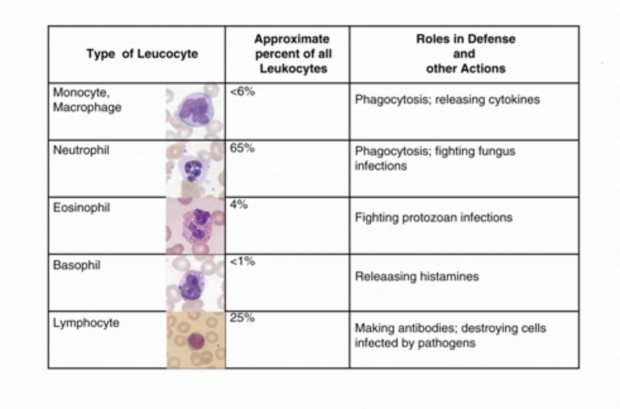
Figure 24.2: Types of Leukocytes (3)
www.ck12.org 1288
Some leukocytes are nonspecific and respond in the same way to most pathogens. Nonspecific leukocytes include monocytes, macrophages, neutrophils, eosinophils, and basophils. These leukocytes are part of the second line of defense. A magnified image of an actual macrophage is shown in Figure 24.3.
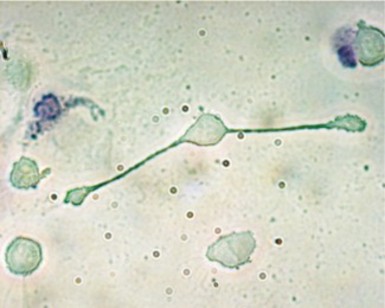
Figure 24.3: Magnified image of a macrophage. (12)
Monocytes, macrophages, and neutrophils destroy pathogens in the blood and tissues by phagocytosis. Phagocytosis is the process of engulfing and breaking down pathogens and other unwanted substances. Phagocytosis of a pathogen by a macrophage is illustrated in Figure 24.4. Once a pathogen has been engulfed, it is broken down within the macrophage. Macrophages are found in tissues, and monocytes and neutrophils are found in the blood.
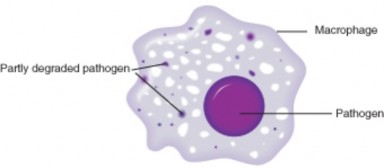
Figure 24.4: Phagocytosis by a macrophage. (2)
Both monocytes and neutrophils migrate through the bloodstream to sites of inflammation.
1289 www.ck12.org
Neutrophils are the most common leukocytes and usually the first leukocytes to arrive at the scene of infection. Neutrophils and dead pathogens are the main components of pus.
In addition to phagocytosis, both monocytes and phagocytes produce chemicals such as cytokines that cause inflammation and fever. A fever is a higher-than-normal body temper- ature that may help fight infection. Monocytes or macrophages may also trigger the third line of defense, which you will read about in Lesson 24.2: Immune Response.
Eosinophils and basophils are responsible for allergies, which are discussed in Lesson 24.3: Immune System Diseases. Eosinophils also help fight infections by combating parasites such as protozoa. Basophils release cytokines, histamines, and other chemicals that contribute to inflammation as well as allergies.
Lymphocytes are different from these nonspecific leukocytes. Lymphocytes launch an attack that is tailored to a particular pathogen. For example, some lymphocytes attack only herpes viruses, others only flu viruses. This is called a specific defense. This type of defense is the topic of the next lesson.
Lesson Summary
Mechanical, chemical, and biological barriers are the body’s first line of defense against pathogens.
The inflammatory response and phagocytosis by white blood cells are major compo- nents of the body’s second line of defense.
Review Questions
Identify two defenses in the body’s first line of defense.
Describe the process of phagocytosis.
How does the inflammatory response help fight infections?
Describe the roles of leukocytes in the body’s second line of defense.
Further Reading / Supplemental Links
Farrell, Jeanette, Invisible Enemies: Stories of Infectious Disease. Farrar, Straus and Giroux, 2005.
http://en.wikibooks.org/wiki/Human_Physiology/The_Immune_System
http://www.clevelandclinic.org/health/health-info/docs/0200/0217.asp?index= 4857
http://library.thinkquest.org/C0115080/?c=wbc
http://www.sciencedaily.com/releases/2007/07/070711135623.htm
http://en.wikipedia.org
www.ck12.org 1290
Vocabulary
biological barriers Living organisms that compete with pathogens; help prevent harmful bacteria from becoming established in or on the body.
chemical barriers Proteins that destroy pathogens at the body’s surface.
cytokines Chemical signals used to communicate between cells.
fever A higher-than-normal body temperature that may help fight infection.
histamines Chemicals that cause inflammation and allergies.
inflammatory response A complex biological reaction to tissue damage; one of the first responses of the immune system to infection or injury; triggered by chemicals called cytokines and histamines.
lysozymes Enzymes that kill pathogens by breaking open their cell walls; found in sweat, mucus, tears, and saliva.
mechanical barriers Physically blocks pathogens from entering the body; the skin is the most important mechanical barrier.
mucus A slimy substance secreted by mucus membranes; coats the membranes and traps pathogens.
nonspecific defenses Defenses that are the same regardless of the type of pathogen; found in the first and second line of defense.
pathogens Disease-causing agents, such as bacteria and viruses.
phagocytosis The process of engulfing and breaking down pathogens and other unwanted substances.
white blood cells Leukocytes; immune system cells that are specialized to fight infections; they identify and eliminate pathogens, debris, and abnormal body cells; leukocytes includes monocytes, macrophages, neutrophils, eosinophils, and basophils.
1291 www.ck12.org
Points to Consider
The body’s first and second lines of defense are the same regardless of the particular pathogen involved. The body’s third line of defense is different. It defends the body against specific pathogens.
Think about how the immune system could identify a particular pathogen.
Can you develop possible mechanisms for how these pathogens could be destroyed?
What roles do you think various cell types (such as lymphocytes) play in the specific defenses of the immune system?
Lesson 24.2: Immune Response
Lesson Objectives
Describe the lymphatic system and state its general functions in the immune response.
Explain the role of antigens in the immune response.
List the steps that occur in a humoral immune response.
Identify roles of different types of T cells in a cell-mediated immune response.
Define immunity and distinguish between active and passive immunity.
Introduction
If pathogens manage to get through the body’s first two lines of defense, a third line of defense takes over. This third line of defense is often referred to as the immune response. This defense is specific to a particular pathogen, and it allows the immune system to “remember” the pathogen after the infection is over. If the pathogen tries to invade the body again, the immune system can launch a much faster, stronger attack. This lets the immune system destroy the pathogen before it can cause harm. The immune response mainly involves the lymphatic system.
Lymphatic System
The lymphatic system is a major component of the immune system. Because of its impor- tant role in the immune system, the terms ”immune system” and ”lymphatic system” are sometimes used interchangeably. However, as you read in Lesson 24.1, nonspecific defenses of the body include organs such as the skin, which is not part of the lymphatic system. In addition, the lymphatic system has another function not directly related to defense.
www.ck12.org 1292
Functions of the Lymphatic System
The lymphatic system has three basic functions. The first function is related to digestion. The other functions are involved in the immune response.
The lymphatic system absorbs fatty acids after the digestion of lipids in the small intestine. It then transports the fatty acids to the bloodstream, where they circulate throughout the body.
The lymphatic system removes excess fluid from body tissues and returns the fluid to the blood. The fluid is filtered as it passes through the lymphatic system, and any pathogens it contains are destroyed before the fluid enters the bloodstream.
The lymphatic system produces lymphocytes. Lymphocytes are the type of white blood cells, or leukocytes, primarily involved in the immune response. They recognize and help destroy specific foreign invaders in body fluids and cells.
Parts of the Lymphatic System
The lymphatic system, which is shown in Figure 24.5, consists of lymphatic organs, lym- phatic vessels, lymph, and lymph nodes. Organs of the lymphatic system include the red bone marrow, thymus, spleen, and tonsils.
Red bone marrow is found inside many bones, including the hip, breast, and skull bones. It produces leukocytes.
The thymus is a gland located in the upper chest behind the breast bone. It stores and matures lymphocytes.
The spleen is a gland in the upper abdomen. It filters blood and destroys worn-out red blood cells. Lymphocytes in the spleen destroy any pathogens filtered out of the blood.
Tonsils are glands on either side of the pharynx in the throat. They trap pathogens, which are then destroyed by lymphocytes in the tonsils.
Lymphatic vessels make up a body-wide circulatory system, similar to the arteries and veins of the cardiovascular system. However, lymphatic vessels circulate lymph instead of blood. Lymph is fluid that leaks out of tiny blood vessels, called capillaries, into spaces between cells in tissues. At sites of inflammation, there is usually more lymph around cells, and it is likely to contain many pathogens.
Unlike the cardiovascular system, the lymphatic system does not have a pump to force lymph through its vessels. Lymph circulates due to peristalsis of lymphatic vessels and rhythmic contractions of the skeletal muscles that surround the vessels. Valves in the lymphatic vessels prevent lymph from flowing backwards through the system.
1293 www.ck12.org

Figure 24.5: Human lymphatic system. (7)
www.ck12.org 1294
As lymph accumulates between cells, it diffuses into tiny lymphatic vessels. The lymph then moves through the lymphatic system, from smaller to larger vessels, until it reaches the main lymphatic ducts in the chest. Here, the lymph drains into the bloodstream.
Before lymph reaches the bloodstream, pathogens are filtered out of it at lymph nodes. Lymph nodes are small, oval structures located along the lymphatic vessels that act like filters. Any pathogens filtered out of the lymph at lymph nodes are destroyed by lymphocytes in the nodes.
Lymphocytes
Lymphocytes are the key cells involved in the immune response. There are an estimated two trillion lymphocytes in the human body, and they make up about 25 percent of all leukocytes. Usually, fewer than half the body’s lymphocytes are found in the blood. The rest are found in the lymphatic system, where they are most likely to encounter pathogens.
The immune response depends on two types of lymphocytes: B lymphocytes, or B cells, and T lymphocytes, or T cells. Both types of lymphocytes are produced in the red bone marrow. The two types are named for the sites where they mature. B cells mature in the red bone marrow, and T cells mature in the thymus. Both B and T cells can recognize and respond to specific pathogens. B or T cells that respond to the body’s own molecules as though they were foreign, or “nonself,” receive a signal that causes them to die. Only those B and T cells that have shown they are unlikely to react to “self” molecules are released into the circulation.
Antigen Recognition
B and T cells do not actually recognize and respond to pathogens but to the antigens they carry. Antigens are protein molecules that the immune system recognizes as nonself. Any protein that can trigger an immune response because it is foreign to the body is called an antigen. Antigens include proteins on pathogens, cancer cells, and the cells of transplanted organs.
Antigen Receptors
Both B and T cells can “recognize” specific antigens because they have receptor molecules on their surface that bind to particular antigen molecules or pieces of antigen molecules. As shown in Figure 24.6, the fit between a receptor molecule and a specific antigen is like a lock and key. Receptors on each B or T cell recognize and bind to just one type of antigen. The human body makes lymphocytes with receptor sites for a huge number of possible antigens that may be encountered throughout a person’s life.
1295 www.ck12.org
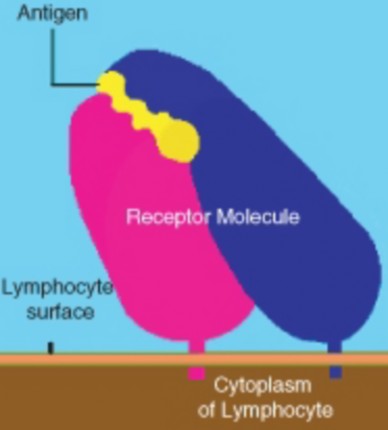
Figure 24.6: A receptor molecule on the surface of a lymphocyte binds to a particular antigen like a lock and key. (15)
www.ck12.org 1296
Activation of Lymphocytes
Before lymphocytes can function, they must be activated. Activation occurs the first time the cells encounter their specific antigens after leaving the red bone marrow or thymus. Until these circulating B and T cells have been activated, they are called “naïve” cells.
Humoral Immune Response
B cells are responsible for the humoral immune response. The humoral immune response takes place in blood and lymph and involves the production of antibodies. Antibodies are large, Y-shaped proteins called immunoglobulins (Ig) that recognize and bind to antigens. In humans (and other mammals) there are five types of immunoglobulins: IgA, IgD, IgE, IgG, and IgM. Antibodies are produced by activated B cells.
B Cell Activation
Naïve B cells are activated by an antigen in the sequence of events shown in Figure 24.7. A B cell encounters its matching antigen and engulfs it. The B cell then displays fragments of the antigen on its surface. This attracts a helper T cell (which you will read about below). The helper T cell binds to the B cell at the antigen site and releases cytokines. As you read in Lesson 24.1, cytokines are chemical signals used to communicate between cells. Cytokines from the helper T cell stimulate the B cell to develop into plasma cells or memory cells.
Plasma Cells and Antibody Production
Plasma cells are activated B cells that secrete antibodies. They are specialized to act like antibody factories. Antibodies produced by plasma cells circulate in the blood and lymph. Each antibody recognizes and binds to a specific antigen, depending on the plasma cell that produced it and other factors. The binding of an antibody to its matching antigen forms an antigen-antibody complex, as shown in Figure 24.8. An antigen-antibody complex flags a pathogen or foreign cell for destruction by phagocytosis. The liver removes antigen-antibody complexes from the blood and the spleen removes them from the lymph.
Memory Cells
Whereas most plasma cells live just a few days, memory cells live much longer. They may even survive for the lifetime of the individual. Memory cells are activated B (or T) cells that retain a “memory” of a specific pathogen long after an infection is over. They help launch a rapid response against the pathogen if it invades the body in the future. Memory B cells
1297 www.ck12.org
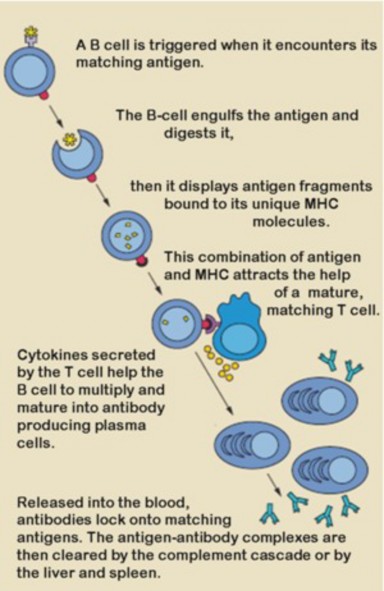
Figure 24.7: After engulfing an antigen, a naïve B cell presents the antigen to a mature T cell. The T cell, in turn, releases cytokines that activate the B cell. Once activated, the B cell can produce antibodies to that particular pathogen. (8)
www.ck12.org 1298
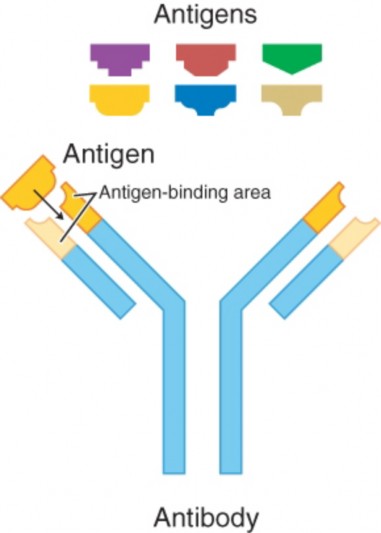
Figure 24.8: An antibody molecule has an area that “fits” one particular antigen. This area is where the antigen binds to the antibody, creating an antigen-antibody complex. (9)
1299 www.ck12.org
remain in the lymph, ready to produce specific antibodies against the same pathogen if it shows up in body fluids again.
Cell-Mediated Immune Response
There are several different types of T cells, including helper, cytotoxic, memory, and regu- latory T cells. T cells are responsible for cell-mediated immunity. Cell-mediated immunity involves the destruction of body cells that are infected with pathogens or have become dam- aged or cancerous.
T Cell Activation
The different types of naïve T cells are activated in the same general way. The mechanism is shown in Figure 24.9. It involves B cells or leukocytes such as macrophages. These other cells engulf pathogens in phagocytosis and display parts of the pathogens’ antigens on their surface. The cells are then called antigen-presenting cells. When a naïve T cell encounters one of these cells with an antigen matching its own, it begins the activation process. After T cells are activated, the various types of T cells play different roles in the immune response.
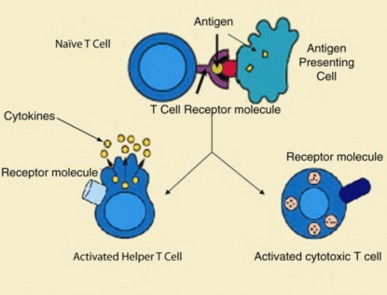
Figure 24.9: A naïve T cell is activated when it encounters a B cell or macrophage that has engulfed a pathogen and presents the pathogen’s antigen on its surface. (6)
www.ck12.org 1300
Helper T Cells
Activated helper T cells do not kill pathogens or destroy infected cells, but they are still necessary for the immune response. In fact, they are considered to be the “managers” of the immune response. After activation, helper T cells divide rapidly and secrete cytokines. These chemical signals control the activity of other lymphocytes. As mentioned above, cytokines from helper T cells activate B cells. They also activate other T cells.
Most activated helper T cells die out once a pathogen has been cleared from the body. However, some helper T cells remain in the lymph as memory cells. These memory cells are ready to produce large numbers of antigen-specific helper T cells if they are exposed to the same antigen again in the future.
Cytotoxic T Cells
Helper cells are needed to activate cytotoxic T cells. Activated cytotoxic T cells destroy tumor cells, damaged cells, and cells infected with viruses. They are also involved in the rejection of transplanted organs. Once activated, a cytotoxic T cell divides rapidly and pro- duces an “army” of cells identical to itself. These cells travel throughout the body “searching” for more cells carrying their specific antigen. Whenever they encounter the cells, they destroy them. Illustrated in Figure 24.10 is how a cytotoxic T cell destroys a body cell infected with viruses. The cytotoxic T cell releases toxins that form pores, or holes, in the infected cell’s membrane. This causes the cell to burst, destroying both the cell and the viruses inside it.
After cytotoxic T cells bring a viral infection under control, most of the cytotoxic T cells die off. However, some of them remain as memory cells. If the same pathogen tries to infect the body again, the memory cells mount an effective immune response by producing a new army of antigen-specific cytotoxic T cells.
Regulatory T Cells
Regulatory T cells shut down cell-mediated immunity toward the end of an immune response. They also try to suppress any T cells that react against self antigens as though they were foreign. This occurs in automimmune diseases, which you will read about in Lesson 24.3.
Immunity
Memory B and T cells help protect you from re-infection by pathogens that have infected you in the past. Being able to resist a pathogen in this way is called immunity. Immunity can be active or passive.
1301 www.ck12.org
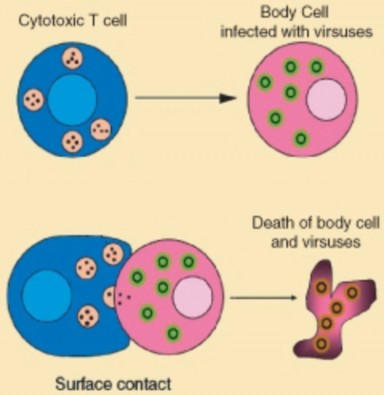
Figure 24.10: A cytotoxic T cell releases toxins that destroy an infected body cell and the viruses it contains. (5)
www.ck12.org 1302
Active Immunity
Active immunity is immunity that results from a pathogen stimulating an immune response and leaving you with memory cells for the specific pathogen. This happens when a pathogen infects your body and makes you sick. As long as the memory cells survive, the pathogen will be unlikely to re-infect you and make you sick again. In the case of some pathogens, memory cells and active immunity last for the life of the individual.
Active immunity can also occur through immunization. Immunization is deliberate exposure of a person to a pathogen in order to provoke an immune response. The purpose of immu- nization is to prevent actual infections by the pathogen. The pathogen is typically injected. However, only part of a pathogen, a weakened form of the pathogen, or a dead pathogen is used. This provokes an immune response without making you sick. Diseases you have likely been immunized against include measles, mumps, rubella, whooping cough, and chicken pox.
Passive Immunity
Passive immunity is humoral immunity that results when antibodies to a specific pathogen are transferred to an individual who has never been exposed to the pathogen before. Passive immunity lasts only as long as the antibodies survive in body fluids, generally between a few days and several months.
Passive immunity is acquired by a fetus when it receives antibodies from the mother’s blood. It is acquired by an infant when it receives antibodies from the mother’s milk. Older children and adults can acquire passive immunity through injection of antibodies into the blood. Injection of antibodies is sometimes used as treatment for a disease, such as measles, when people have not been immunized against the disease.
Lesson Summary
The lymphatic system is a major component of the immune system. It filters pathogens from lymph and produces lymphocytes, which are the key cells in an immune response.
Antigens are proteins that the immune system recognizes as foreign to the body. They trigger the activation of lymphocytes.
Activated B cells produce antibodies against a pathogen’s antigens. Long-lasting mem- ory B cells remain in the body to provide immunity to the specific pathogen.
Activated T cells destroy tumor cells and cells infected with viruses. Memory T cells remain after an infection to provide antigen-specific immunity.
Immunity is the ability to resist infection by a pathogen. It can occur by having an immune response to a pathogen or receiving antibodies to a pathogen.
1303 www.ck12.org
Review Questions
List three parts of the lymphatic system and their functions.
What are antigens and how do lymphocytes “recognize” them?
How do plasma cells form and help fight pathogens?
Describe how cytotoxic T cells destroy cells infected with viruses.
What type of immune response would occur if bacteria invaded your lymph? Explain your answer.
Explain how immunization prevents a disease such as measles.
If a disease destroyed a person’s helper T cells, how might this affect the immune response?
Compare and contrast humoral and cell-mediated immune responses.
Further Reading / Supplemental Links
Panno, Joseph, Ph.D., Immune System. Facts on File, 2008.
http://en.wikibooks.org/wiki/Human_Physiology/The_Immune_System
http://www.acm.uiuc.edu/sigbio/project/lymphatic/index.html
http://www.cancer.gov/cancertopics/understandingcancer/immunesystem
http://www.howstuffworks.com/immune-system.htm
http://www.kidshealth.org/parent/general/body_basics/immune.html
http://www.kidshealth.org/parent/general/body_basics/spleen_lymphatic.html
http://www.lymphomation.org/lymphatic.htm
http://www.niaid.nih.gov/final/immun/immun.htm
http://www.niaid.nih.gov/publications/immune/the_immune_system.pdf
http://www.sciencedaily.com/releases/2007/08/070802181939.htm
http://www.thebody.com/content/art1788.html
http://en.wikipedia.org
Vocabulary
active immunity Immunity that results from a pathogen stimulating an immune response and leaving you with memory cells for the specific pathogen.
antibody Large, Y-shaped proteins called immunoglobulins (Ig) that recognize and bind to antigens; produced by activated B cells. In humans (and other mammals) there are five types of immunoglobulins: IgA, IgD, IgE, IgG, and IgM.
antigen Any protein that can trigger an immune response because it is foreign to the body; includes proteins on pathogens, cancer cells, and the cells of transplanted organs.
www.ck12.org 1304
antigen receptor A receptor molecule on the surface of a lymphocyte that binds to a particular antigen like a lock and key.
B lymphocytes (B cells) Lymphocytes that are produced in the red bone marrow and mature in the red bone marrow; can recognize and respond to specific pathogens.
cell-mediated immunity Involves the destruction of body cells that are infected with pathogens or have become damaged or cancerous.
cytotoxic T cells Cells that destroy tumor cells, damaged cells, and cells infected with viruses.
helper T cells Considered to be the “managers” of the immune response. After activation, helper T cells divide rapidly and secrete cytokines. These chemical signals control the activity of other lymphocytes.
immunity Protection from re-infection by pathogens that have infected you in the past. immune response The third line of defense; specific to a particular pathogen. immunization The deliberate exposure of a person to a pathogen in order to provoke an
immune response.
lymph Fluid that leaks out of tiny blood vessels, called capillaries, into spaces between cells in tissues.
lymph nodes Small, oval structures located along the lymphatic vessels that act like fil- ters; pathogens filtered out of the lymph at lymph nodes are destroyed by lymphocytes in the nodes.
lymphatic system System that makes lymphocytes; consists of lymphatic organs, lym- phatic vessels, lymph, and lymph nodes. Organs of the lymphatic system include the red bone marrow, thymus, spleen, and tonsils.
lymphatic vessels Form a body-wide circulatory system, similar to the arteries and veins of the cardiovascular system; circulate lymph instead of blood.
lymphocytes Type of white blood cells, or leukocytes, primarily involved in the immune response; recognize and help destroy specific foreign invaders in body fluids and cells.
1305 www.ck12.org
memory cells Memory cells are activated B (or T) cells that retain a “memory” of a specific pathogen long after an infection is over; help launch a rapid response against the pathogen if it invades the body in the future.
passive immunity A humoral immunity that results when antibodies to a specific pathogen are transferred to an individual who has never been exposed to the pathogen before.
phagocytosis The process of engulfing and breaking down pathogens and other unwanted substances.
plasma cells Activated B cells that secrete antibodies.
red bone marrow Found inside many bones, including the hip, breast, and skull bones; produces leukocytes.
regulatory T cells T cells that shut down cell-mediated immunity toward the end of an immune response; also try to suppress any T cells that react against self antigens as though they were foreign.
spleen A gland in the upper abdomen; filters blood and destroys worn-out red blood cells.
Lymphocytes in the spleen destroy any pathogens filtered out of the blood.
T lymphocytes (T cells) Lymphocytes that are produced in the red bone marrow and mature in the thymus; can recognize and respond to specific pathogens; includes helper, cytotoxic, memory, and regulatory T cells.
thymus A gland located in the upper chest behind the breast bone; stores and matures lymphocytes.
tonsils Glands on either side of the pharynx in the throat; traps pathogens, which are then destroyed by lymphocytes in the tonsils.
Points to Consider
Sometimes the immune system makes mistakes and things go wrong. What if the immune system responded to a harmless allergen as though it were a deadly pathogen?
What if the immune system responded to normal body cells as though they were foreign invaders?
What if pathogens attacked and destroyed cells of the immune system itself? Would it still be able to function?
www.ck12.org 1306
Lesson 24.3: Immune System Diseases
Lesson Objectives
Explain how allergies occur and list common allergens.
Describe how autoimmune diseases affect the body.
Define immunodeficiency and identify ways it can be acquired.
Explain how HIV is transmitted and how it causes AIDS.
Introduction
The immune system usually protects you from pathogens and keeps you well. However, like any other body system, the immune system can malfunction or become diseased. Sometimes the immune system responds to harmless foreign substances as though they were pathogens. Sometimes it mistakes self for nonself and launches an attack against the body’s own cells. Certain diseases can also attack and damage the immune system so it loses the ability to defend the body.
Allergies
An allergy is a disease in which the immune system makes an inflammatory response to a harmless antigen. Any antigen that causes an allergic reaction is called an allergen. You can be exposed to allergens by inhaling or ingesting them or by having direct skin contact with them.
Allergies can vary greatly from person to person. Some people are allergic to many allergens, others to few or none. A tendency to develop allergies can be inherited, so if your mom or dad has allergies, you are more likely to have them as well. Allergy symptoms may be mild or severe. They may develop immediately after exposure to an allergen or not until several days after exposure.
Severity of Allergies
Allergy symptoms are caused by the release of histamines, the chemicals that also stimulate inflammation. The symptoms range from scarcely noticeable to potentially fatal. Typical symptoms of mild allergies include itchy eyes, sneezing, and skin rashes. These symptoms may be uncomfortable, but they are not life threatening. Mild allergy symptoms are often treated with antihistamines. Antihistamines are drugs that reduce or eliminate the effects of histamines.
Immunotherapy, commonly called “allergy shots,” is sometimes recommended for more se-
1307 www.ck12.org
vere allergies. A person with an allergy is injected with larger and larger amounts of the offending allergen over a period of months or years. This gradually desensitizes the person’s immune system to the allergen. Rather than just treating the symptoms of the allergy, immunotherapy reduces the severity of the allergy or eliminates the allergy altogether.
The most severe allergic reaction is anaphylaxis. Anaphylaxis is an allergic response in which there is a sudden, massive release of histamines throughout the body. This causes collapse of the circulatory system and severe constriction of the breathing passages. Without emergency treatment, anaphylaxis is likely to be fatal. Treatment is usually injection of epinephrine. Epinephrine is the “fight-or-flight” hormone that your adrenal glands normally produce when you are in danger. The hormone suppresses non-emergency body processes, including the immune response.
Immediate Hypersensitivity Reaction
When exposure to an antigen causes immediate allergy symptoms, the response is called an immediate hypersensitivity reaction. This is a humoral immune response. Examples of aller- gens that cause this type of reaction include pollens, bee stings, and peanuts. Anaphylaxis may occur if the allergy is severe.
Allergic rhinitis is a common immediate hypersensitivity reaction. It affects mainly mucous membranes lining the nose. Typical symptoms include runny nose and nasal congestion. Pollens are the most common cause of allergic rhinitis. Tiny pollens of wind-pollinated plants like ragweed (Figure 24.11) are the usual culprits. Other causes of allergic rhinitis include mold, animal dander, and dust. Allergic rhinitis may occur seasonally or year-round, depending on its cause.
Allergic rhinitis is often called hay fever, although pollen—not hay—is the most likely cause. It is called hay fever because it is most common during the time of year when hay is cut. This is also the time of year when plant pollens are most concentrated in outdoor air.
Delayed Hypersensitivity Reaction
When an antigen causes allergy symptoms hours or days after exposure, the response is called a delayed hypersensitivity reaction. This is a cell-mediated immune response. Examples of allergens that cause delayed hypersensitivity reactions include poison ivy, poison oak, and poison sumac. If you have skin contact with these plants and are allergic to them, a rash, like the one in Figure 24.12, may develop.
www.ck12.org 1308
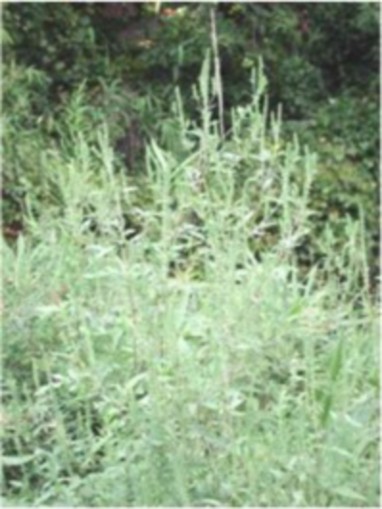
Figure 24.11: Ragweed, a common cause of allergic rhinitis. (11)
1309 www.ck12.org
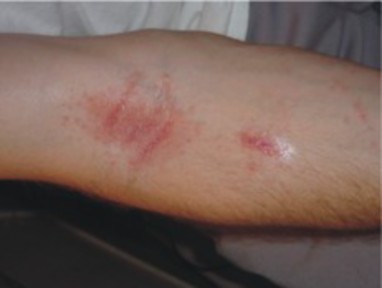
Figure 24.12: Allergic rash caused by contact with poison ivy. (4)
Autoimmune Diseases
Autoimmune diseases occur when the immune system fails to recognize the body’s own molecules as self and attacks the body’s cells as though they were foreign invaders. Rela- tively common autoimmune diseases include rheumatoid arthritis, type 1 diabetes mellitus, multiple sclerosis, and systemic lupus erythematosus (Table 24.1). These four diseases are described in the table below. They are currently incurable, but treatment can help relieve the symptoms and prevent some of the long-term damage.
Table 24.1: Common Autoimmune Diseases

Autoimmune Dis- ease
Object of Immune Attack
Results of Immune Attack
Treatment(s)

Rheumatoid arthri- tis
Tissues inside joints Inflammation of
joints, causing joint pain and damage and possible loss of mobility
Anti-inflammatory drugs; drugs that suppress the im- mune system
Type 1 diabetes Insulin-producing
cells of the pancreas
Loss of ability to produce insulin, causing too much sugar in the blood and tissue and organ damage
Insulin injections
www.ck12.org 1310
Table 24.1: (continued)

Autoimmune Dis- ease
Object of Immune Attack
Results of Immune Attack
Treatment(s)

Multiple sclerosis Myelin in the brain
and spinal cord
Loss of nerve func- tion, causing muscle weakness, fatigue, visual problems, pain, and other symptoms
Corticosteroid drugs; hormones that control the immune system
Systemic lupus ery- thematosus
Joints, heart, lungs, or other organs
Inflammation of joints or organs, causing serious joint or organ damage and pain
Corticosteroid drugs; drugs that suppress the im- mune system

The causes of autoimmune diseases are not known for certain. One way autoimmunity may develop is through “molecular mimicry.” This occurs when a person is infected with pathogens bearing antigens similar to the person’s own molecules. When the immune system mounts an attack against the pathogens, it also attacks body cells with the similar molecules. Some people inherit genes that increase their risk for an autoimmune disease. Female sex hormones may also increase the risk. This may explain why autoimmune diseases are more common in females than males and why they usually begin after puberty.
Immunodeficiency Diseases
Immunodeficiency occurs when one or more components of the immune system are not work- ing normally. As a result, the ability of the immune system to respond to pathogens and other threats is decreased. A person with immunodeficiency may suffer from frequent, life- threatening infections. In other words, an individual with a compromised immune system (for example, a person with AIDS) may be unable to fight off and survive infections by mi- croorganisms that are usually benign. Immunodeficiency can be present at birth or acquired after birth.
Congenital Immunodeficiency
Congenital immunodeficiency is present at birth and usually caused by a genetic disorder. Such disorders are relatively rare. For example, thymic aplasia—a genetic disorder charac- terized by an absent or abnormal thymus—occurs in about 1 out of 4,000 births. People with thymic aplasia are unable to produce normal T cells. They have frequent infections and increased risk of autoimmune diseases.
1311 www.ck12.org
Acquired Immunodeficiency
Acquired immunodeficiency occurs when immune function declines in a person who was born with a normal immune system. There are many possible causes for declining immune function. Age is one cause. The immune system naturally becomes less effective as we get older, starting in middle adulthood. This helps explain why older people are more susceptible to disease. Other possible causes of declining immune function include obesity, alcoholism, and illegal drug abuse. In developing countries, malnutrition is a common cause.
Many medications can interfere with normal immune function and cause immunodeficiency. Immune suppressive drugs are deliberately given to people with autoimmune diseases and transplanted organs. Many other drugs have immune suppression as a side effect. Chemother- apy drugs for cancer are especially likely to suppress the immune system.
Several kinds of cancer attack cells of the immune system and cause immunodeficiency. For example, in chronic lymphatic leukemia, abnormal B cells that can’t fight infection grow out of control and crowd out healthy B cells. Certain pathogens can also attack cells of the immune system. In fact, the virus known as HIV is the most common cause of immunodeficiency in the world today.
HIV and AIDS
HIV, or human immunodeficiency virus, is the virus that causes AIDS. AIDS stands for ac- quired immune deficiency syndrome. It is a late stage in the progression of an HIV infection.
HIV Transmission
HIV is transmitted, or spread, through direct contact of mucous membranes or the blood- stream with a body fluid containing HIV. Body fluids that can contain HIV include blood, semen, vaginal fluid, preseminal fluid, and breast milk. Transmission of the virus can oc- cur through sexual contact or use of contaminated hypodermic needles. HIV can also be transmitted through a mother’s blood to her baby during late pregnancy or birth or through breast milk after birth. In the past, HIV was transmitted through blood transfusions. Be- cause donated blood is now screened for HIV, the virus is no longer transmitted this way.
HIV and the Immune System
HIV destroys helper T cells. Recall that helper T cells are needed for normal humoral and cell-mediated immunity. When HIV enters a person’s bloodstream, proteins on the coat of the virus allow it to fuse with the host’s helper T cells. The virus injects its own DNA into the host’s helper T cells and uses the T cells’ “machinery” to make copies of itself. The
www.ck12.org 1312
copies of the virus bud off from the host’s cells, destroying the cells in the process. Copies of the virus go on to infect other helper T cells throughout the body.
During the first several weeks after HIV infection, the immune system tries to fight off the virus. As shown in Figure 24.13, the initial immune response temporarily reduces the number of virus copies in the blood. However, the immune system is unable to destroy the virus, and it continues to multiply in the lymphatic system. How is HIV able to evade the immune system? There are at least two ways:
The virus undergoes frequent mutations that keep changing the antigens on its coat. This prevents antigen-specific lymphocytes from developing that could destroy the virus.
The virus uses the host’s cell membranes to form is own coat. This covers up viral antigens so they cannot be detected by the host’s immune system.
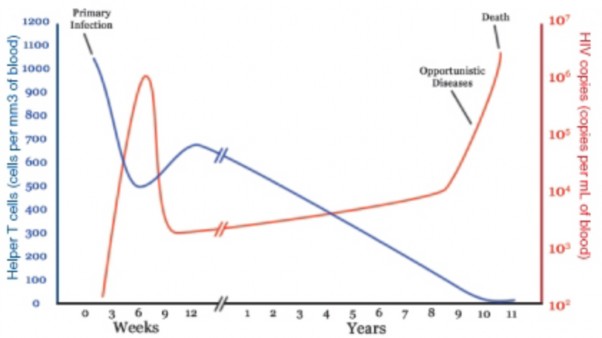
Figure 24.13: Average numbers of helper T cells and HIV copies in untreated HIV infections. (14)
Over the next several years, helper T cells continuously decline in the blood, while copies of the virus keep increasing. As the number of helper T cells declines, so does the ability of the immune system to make an immune response. The HIV-infected person starts showing symptoms of a failing immune system, such as frequent infections.
1313 www.ck12.org
Treatment with antiviral medications can slow down the increase in virus copies, although they do not eliminate the virus altogether. The medications usually lengthen the time between infection with HIV and the development of symptoms. However, currently there is no cure for HIV infection or AIDS and no vaccine to prevent infection, although this is a field of intense study by biomedical scientists.
AIDS
AIDS is not a single disease but a collection of symptoms and diseases. It is the result of years of damage to the immune system by HIV. AIDS is diagnosed when helper T cells fall to a very low level and the infected person develops one or more opportunistic diseases.
Opportunistic diseases are infections and tumors that are rare in people with a healthy immune system but common in immunodeficient people. Opportunistic diseases include pneumocystis pneumonia and Kaposi’s sarcoma, a type of cancer. The diseases are called opportunistic because they take advantage of the “opportunity” to infect a person with a damaged immune system that can’t fight back. Opportunistic diseases are often the direct cause of death of people with AIDS.
AIDS was first identified in 1981. Since then it has killed more than 25 million people world- wide, many of them children. The hardest hit region is sub-Saharan Africa, where antiviral medications are least available. The worldwide economic toll of AIDS is also enormous.
Lesson Summary
Allergies occur when the immune system makes an inflammatory response to a harmless antigen, called an allergen.
Autoimmune diseases occur when the immune system fails to distinguish self from nonself and attacks the body’s own cells.
In an immunodeficiency disease, the immune system does not work normally and can- not defend the body.
HIV is a virus that attacks cells of the immune system and eventually causes AIDS. It is the chief cause of immunodeficiency in the world today.
Review Questions
Describe anaphylaxis.
What is an autoimmune disease?
List three possible causes of acquired immunodeficiency.
Name two ways HIV can be transmitted.
Assume that you touch poison sumac and still have not developed a rash 12 hours later. Can you safely assume you are not allergic to the plant? Why or why not?
www.ck12.org 1314
Rheumatic fever is caused by a virus that has antigens similar to molecules in human heart tissues. When the immune system attacks the virus, it also attacks the heart. What type of immune system disease is rheumatic fever? Explain your answer.
Draw a timeline to show the progression of an untreated HIV infection. Show how the numbers of HIV copies and helper T cells change through time.
Why are opportunistic infections a sign of immunodeficiency?
Further Reading / Supplemental Links
Bellenir, Karen, Ed., Allergy Information for Teens: Health Tips About Allergic Reac- tions Such As Anaphylaxis, Respiratory Problems, And Rashes. Omnigraphics, 2006.
Johanson, Paula, HIV and AIDS (Coping in a Changing World). Rosen Publishing Group, 2007.
http://en.wikibooks.org/wiki/Human_Physiology/The_Immune_System
http://www.cancer.gov/cancertopics/understandingcancer/immunesystem
http://www.kidshealth.org/teen/infections/stds/std_hiv.html
http://www.mayoclinic.com/health/allergy/AA99999
http://www.niaid.nih.gov/publications/immune/the_immune_system.pdf
http://www.nichd.nih.gov/health/topics/Primary_Immunodeficiency.cfm
http://www.4women.gov/FAQ/autoimmune.htm
http://en.wikipedia.org
Vocabulary
acquired immunodeficiency Immunodeficiency that occurs when immune function de- clines in a person who was born with a normal immune system.
AIDS Acquired immune deficiency syndrome; a late stage in the progression of an HIV infection.
allergen Any antigen that causes an allergic reaction.
allergic rhinitis A common immediate hypersensitivity reaction; affects mainly mucous membranes lining the nose; often called hay fever.
allergy A disease in which the immune system makes an inflammatory response to a harm- less antigen.
anaphylaxis An allergic response in which there is a sudden, massive release of histamines throughout the body. This causes collapse of the circulatory system and severe con- striction of the breathing passages. Without emergency treatment, anaphylaxis is likely to be fatal.
1315 www.ck12.org
antihistamines Drugs that reduce or eliminate the effects of histamines.
autoimmune diseases Diseases that occur when the immune system fails to recognize the body’s own molecules as self and attacks the body’s cells as though they were foreign invaders.
delayed hypersensitivity reaction When an antigen causes allergy symptoms hours or days after exposure.
epinephrine The “fight-or-flight” hormone that your adrenal glands normally produce when you are in danger; suppresses non-emergency body processes, including the im- mune response.
HIV The human immunodeficiency virus, the virus that causes AIDS.
immediate hypersensitivity reaction When exposure to an antigen causes immediate allergy symptoms.
immunodeficiency Occurs when one or more components of the immune system are not working normally; as a result, the ability of the immune system to respond to pathogens and other threats is decreased.
molecular mimicry Occurs when a person is infected with pathogens bearing antigens similar to the person’s own molecules; when the immune system mounts an attack against the pathogens, it also attacks body cells with the similar.
opportunistic diseases Infections and tumors that are rare in people with a healthy immune system but common in immunodeficient people; includes pneumocystis pneu- monia and Kaposi’s sarcoma, a type of cancer.
Points to Consider
You read in this lesson that some types of cancer attack cells of the immune system and cause immunodeficiency. Cancer has previously been described as resulting from a loss of regulation of the cell cycle.
Why do you think immunodeficiency may lead to some cancers?
Can you think of a relationship between pathogens, the immune system, and the de- velopment of cancer?
www.ck12.org 1316
Lesson 24.4: Environmental Problems and Hu- man Health
Lesson Objectives
Explain how carcinogens cause cancer and list ways that cancer can be treated or prevented.
Identify causes of air pollution and describe how air pollution affects human health.
Define bioterrorism and explain how bioterrorism threatens human health.
Introduction
Cancer is one of many human diseases that can be caused by environmental problems. For example, air pollution may increase the risk of lung cancer. It can also cause or worsen asthma, cardiovascular diseases, and other health problems. Bioterrorism is another poten- tial threat to human health. It may lead to severe environmental problems that have the potential to poison large numbers of people or cause epidemics of deadly diseases.
Carcinogens and Cancer
A carcinogen is anything that can cause cancer. Cancer is a disease in which abnormal body cells divide of control. Most carcinogens cause cancer by inducing mutations.
Carcinogens
Carcinogens may be pathogens, chemical substances, or radiation. Carcinogens often occur in nature. For example, some viruses are important carcinogens, causing as many as 15 percent of all human cancers. Different viruses cause different cancers. The human papilloma virus (HPV) is the main cause of cancer of the cervix in females. The hepatitis B virus can cause liver cancer, and the Epstein-Barr virus can cause cancer of the lymph nodes.
Other natural carcinogens include ultraviolet (UV) radiation from the sun. UV radiation is the leading cause of skin cancer. Radon is a natural radioactive gas that seeps into buildings from the ground. Exposure to radon can cause lung cancer. Asbestos can also cause lung cancer. Asbestos is a mineral previously used for insulation and many other purposes. Today, it is largely banned because of its link to cancer.
Humans are exposed to many artificial carcinogens in the environment, including those in tobacco smoke. In fact, tobacco smoke may be the key source of human carcinogen exposure. It contains dozens of carcinogens including nicotine and formaldehyde, which is used to
1317 www.ck12.org
preserve dead bodies. As you will read below, other pollutants in the air can cause cancer as well.
Other artificial carcinogens are or were found in foods. Some food additives, such as certain food dyes, have proven to be carcinogens. Cooking foods at very high temperatures also causes carcinogens to form. For example, a carcinogen called acrylamide forms when carbo- hydrates are cooked at very high temperatures. It is found in foods such as French fries and potato chips. Barbecued or broiled meats also contain several carcinogens.
How Cancer Occurs
Carcinogens generally cause cancer by inducing mutations in genes that control cell division or other aspects of the cell cycle. The mutations typically occur in two types of genes: tumor- suppressor genes and proto-oncogenes (see chapter titled Molecular Genetics). Briefly:
Tumor-suppressor genes are genes that normally repair damaged DNA or prevent cells with badly damaged DNA from dividing (Figure A 24.14). If mutations occur in these genes, they may no longer be able to prevent cells with damaged DNA from dividing (Figure B 24.14).
Proto-oncogenes are genes that normally help regulate cell division. Mutations can turn them into oncogenes. Oncogenes are abnormal genes that stimulate the division of cells with damaged DNA.
Cells that divide uncontrollably form a tumor. A tumor is an abnormal mass of tissue. Tumors may be benign or malignant. Benign tumors remain localized and generally do not harm health. Malignant tumors are cancer. There are no limits on their growth, so they can invade and damage neighboring tissues. Cells from malignant tumors can also break away from the tumor, enter the circulation, and start growing in another part of the body. This is called metastasis.
Types of Cancer
Cancer is usually classified according to the type of tissue where the cancer begins. Common types of cancer include:
Carcinoma: tumor of epithelial tissues, such as lung tissue.
Sarcoma: tumor of connective tissues, such as bone.
Lymphoma: tumor of lymphatic cells, such as T cells.
Specific cancers are generally named for the organs where the cancers begin. Relatively common cancers include lung, prostate, bladder, and breast cancers. These and several
www.ck12.org 1318

Figure 24.14: A cell with damaged DNA normally is not allowed to divide, so the damage is not passed on to other cells. Figure B: If a cell with damaged DNA is allowed to divide, it results in many more damaged cells. (10)
1319 www.ck12.org
other cancers are listed in the Table 24.2. The figure shows which cancers are most common and which cause the most deaths in U.S. adults.
www.ck12.org 1320
Table 24.2: Common Cancers among Adult Males and Females in the United States

Adult Males Adult Females

Most Common Can- cers (percent of all cancers)
Most Common Causes of Cancer Deaths (percent of all cancer deaths)
Most Common Can- cers (percent of all cancers)
Most Common Causes of Cancer Deaths (percent of all cancer deaths)
Prostate can- cer(33%)
Lung cancer(31%) Breast cancer(32%) Lung cancer(27%)
Lung cancer(13%) Prostate can-
cer(10%)
Lung cancer(12%) Breast cancer(15%)
Colorectal can- cer(10%)
Colorectal can- cer(10%)
Colorectal can- cer(11%)
Colorectal can- cer(10%)
Bladder cancer(7%) Pancreatic can-
cer(5%)
Endometrial can- cer(6%)
Ovarian cancer(6%)

(Source: http://en.wikipedia.org/wiki/Cancer, License: Creative Commons)
Cancer can also occur in children and teens, but it is rare. Most childhood cancers occur during the first year of life. The most common type of infant cancer is leukemia. It makes up about 30 percent of cancers at this age. With prompt treatment, there is a good chance that an infant with cancer will survive.
Cancer Treatment and Prevention
Most cancers can be treated and some can be cured. The general goal of treatment is to remove the tumor without damaging the rest of the body. Cancer may be treated with a combination of surgery, chemotherapy, and/or radiation. In the past, chemotherapy drugs caused serious side effects. Many of today’s chemotherapy drugs target specific molecules in tumors. This reduces damage to normal body cells and causes fewer side effects.
The outcome of cancer treatment depends on factors such as the type of cancer and its stage. The stage of cancer refers to the extent to which the cancer has developed. Generally, early diagnosis and treatment lead to the best chances of survival. That’s why it’s important for people to be aware of the following warning signs of cancer:
A change in bowel or bladder habits
A sore that does not heal
Unusual bleeding or discharge from any place
A lump in the breast or other parts of the body
Chronic indigestion or difficulty in swallowing
1321 www.ck12.org
Obvious changes in a wart or mole
Persistent coughing or hoarseness
Having warning signs of cancer does not mean that you have cancer, but you should see a doctor to be sure. Getting recommended tests for particular cancers, such as colonoscopies for colon cancer, can also help detect cancers early, when chances of a cure are greatest.
Many cancers can be prevented, or at least their risk can be reduced. You can help re- duce your risk of cancer by avoiding specific carcinogens and maintaining a healthy lifestyle. Carcinogens you can avoid or limit your exposure to include tobacco smoke, sexually trans- mitted viruses, improperly cooked foods, and UV radiation. Other lifestyle choices you can make to reduce your risk of cancer include being physically active, eating a low-fat diet, and maintaining a normal weight.
Air Pollution and Illness
An estimated 4.6 million people die each year because of air pollution. Worldwide, air pollution causes more deaths than traffic accidents do. Air pollution harms the respiratory and cardiovascular systems. Both outdoor and indoor air can be polluted and contribute to illness and death.
Outdoor Air Pollution
The concentration of pollutants in outdoor air is indicated by the Air Quality Index. The Air Quality Index (AQI) is a measure of certain pollutants in the air in a given location. The health risks associated with different values of the AQI are shown in the Table 24.3 . When the AQI is high, you should limit the time you spend outdoors, especially the time you spend exercising. Avoiding exposure to air pollution can help limit its impact on your health. As you can see from Table 24.3, people with certain health problems, including asthma, need to be even more careful about limiting their exposure to air pollution.
Table 24.3: Air Quality and Health Risk

Air Quality Index(AQI) Quality of Air in Terms of Human Health

0–50 Good
51–100 Moderate
101–150 Unhealthy for sensitive groups1
151–200 Unhealthy for everyone
201–300 Very unhealthy

301–500 Hazardous
www.ck12.org 1322
1 Sensitive groups include people with asthma, heart disease, or other diseases worsened by air pollution.
(Source: http://en.wikipedia.org/wiki/Air_Quality_Index, License: Creative Com- mons)
AQI reports to the public generally refer to levels of ground-level ozone and particulates. Ozone is a gas that forms close to the ground when high concentrations of air pollutants are heated by sunlight. Ozone damages both respiratory and cardiovascular systems. For example, it can cause asthma and decrease lung function. It can also convert cholesterol in arteries to plaque, causing cardiovascular disease. In addition, ozone may increase inflam- mation, which is a symptom of many diseases.
Particulates are tiny particles of solids or liquids suspended in the air. The most concentrated particulate pollution tends to be in the air over densely populated metropolitan areas in developing countries. The primary cause is the burning of fossil fuels by motor vehicles and factories. Particulates settle in airways and lungs and damage the respiratory tract. They can cause asthma and lung cancer. Extremely small particulates may pass through the lungs to the bloodstream and contribute to plaque formation in arteries.
Indoor Air Pollution
Indoor air quality refers to pollutants in the air inside buildings. Indoor air may be more polluted than outdoor air, although with different pollutants. Typical pollutants in indoor air include allergens, mold, bacteria, carbon monoxide, and radon.
Mold and bacteria can be allergens and also cause respiratory system infections. For example, a type of pneumonia, known as Legionnaire’s disease, is caused by bacteria that can spread through air conditioning systems. The disease is not common, but it kills many of the people who contract it.
Carbon monoxide is a gas produced by cars, furnaces, and other devices that burn fuel. It replaces oxygen in the blood and quickly leads to death. Initial symptoms of carbon monoxide poisoning include headache, listlessness, and other flu-like symptoms. Loss of consciousness and death can occur within hours. An estimated 40,000 Americans annually seek medical attention for carbon monoxide poisoning. It is also the most common type of fatal poisoning in the U.S. Carbon monoxide is colorless and odorless, but it can be detected with carbon monoxide detectors like the one in Figure 24.15.
Sick building syndrome (SBS) is a combination of symptoms associated with working in a particular building, typically an office building. It is most common in new and remodeled buildings. It is usually caused by inadequate ventilation. Chemicals released by new building materials may also contribute to the poor air quality. Generally, conditions improve by increasing ventilation. Symptoms of SBS vary widely. They may include headaches, eye irritation, dry cough, dizziness, and asthma.
1323 www.ck12.org

Figure 24.15: Home carbon monoxide detector (13)
www.ck12.org 1324
Bioterrorism
Bioterrorism is terrorism by intentional release or spread of pathogens. As shown in Tables 24.4, 24.5, and 24.6, pathogens used in bioterrorism may include bacteria, viruses, or toxins. Toxins are poisons produced by organisms such as bacteria. The agents may be naturally occurring pathogens or pathogens that have been modified by humans to make them more effective agents of bioterrorism. The agents can spread in a variety of ways, including through air, food, water, direct contact, or cuts in the skin. They have the potential to cause epidemics of deadly human diseases.
Table 24.4: Classification of Category A Bioterrorism Agents Based Upon Threat to Public Health
Agent | Type of Pathogen | Mode of Transmission |
Anthrax Smallpox Botulinum | Bacteria Virus Toxin | Air, food, cuts in skin Air, direct contact Food, cuts in skin |
Table 24.5: Classification of Category B Bioterrorism Agents Based Upon Threat to Public Health
Agent | Type of Pathogen | Mode of Transmission |
Brucellosis | Bacteria | Milk, direct contact |
Ricin | Toxin | Air, food, water |
Cholera | Bacteria | Food, water |
Table 24.6: Classification of Category C Bioterrorism Agents Based Upon Threat to Public Health
Agent | Type of Pathogen | Mode of Transmission |
Hantavirus | Virus | Air |
Tuberculosis | Bacteria | Air |
Agents of Bioterrorism
Bioterrorism agents are classified on the basis of their threat to public health, as shown in the tables above. Category A agents (Table 24.4) include anthrax and smallpox. Agents in this category pose the greatest threat. They spread easily and cause serious illness or death. Category B agents (Table 24.5) are considered less of a threat. They do not spread as easily
1325 www.ck12.org
and are less likely to cause death. Category C agents (Table 24.6) are pathogens that are likely to be engineered for bioterrorism in the future. They are easy to produce and have the potential to cause serious illness or death.
Recent Bioterrorism Incidents
Two recent bioterrorism incidents in the U.S. received a great deal of media attention. They heightened public awareness of the threat of bioterrorism. In 2001, letters containing anthrax spores were mailed to several news media offices and two U.S. Senate offices. A total of 22 people were infected, and 5 of them died of anthrax. In 2003, deadly ricin toxin was detected in a letter intended for the White House. The letter was intercepted at a mail-handling facility off White House grounds. Fortunately, the ricin did not cause illness or death.
Lesson Summary
Carcinogens cause cancer by inducing mutations in genes that normally control cell division or other aspects of the cell cycle.
Both indoor and outdoor air may contain pollutants that can cause human illness and death.
In bioterrorism, pathogens are intentionally released or spread and have the potential to cause disease epidemics.
Review Questions
What is a carcinogen?
How do carcinogens cause cancer?
Identify three ways cancer can be treated.
List four warning signs of cancer.
How can you use the Air Quality Index to protect your health from air pollution?
The bacterium that causes plague is classified as a Category A bioterrorism agent. What can you conclude about the bacterium from this classification?
Explain why ozone is usually a worse problem in the summer than in the winter in North America.
Compare and contrast pollutants in indoor and outdoor air, including their effects on human health.
Further Reading / Supplemental Links
Bozzone, Donna M., Cancer Genetics. Chelsea House Publications, 2007. www.ck12.org 1326
Panno, Joseph, Ph.D., Cancer: The Role of Genes, Lifestyle, and Environment. Facts on File, 2004.
http://www.uihealthcare.com/topics/cancer/canc4280.html
http://www.bt.cdc.gov/
http://www.cancer.gov/cancertopics/understandingcancer/immunesystem
http://www.cdc.gov/cancer/az/
http://www.cdc.gov/health/airquality.html
http://www.emedicine.com/emerg/topic853.htm
http://www.niaid.nih.gov/publications/immune/the_immune_system.pdf
http://www.sciencedaily.com/releases/2007/08/070801161426.htm
http://www.sciencedaily.com/releases/2007/08/070807101114.htm
http://en.wikipedia.org
Vocabulary
air quality index (AQI) A measure of certain pollutants in the air in a given location.
bioterrorism Terrorism by intentional release or spread of pathogens.
cancer A disease in which abnormal body cells divide of control.
carbon monoxide A gas produced by cars, furnaces, and other devices that burn fuel; replaces oxygen in the blood and quickly leads to death.
carcinogen Anything that can cause cancer; may be pathogens, chemical substances, or radiation.
carcinoma A tumor of epithelial tissues, such as lung tissue.
lymphoma A tumor of lymphatic cells, such as T cells.
oncogenes Abnormal genes that stimulate the division of cells with damaged DNA.
ozone A gas that forms close to the ground when high concentrations of air pollutants are heated by sunlight.
particulates Tiny particles of solids or liquids suspended in the air; primarily formed by the burning of fossil fuels by motor vehicles and factories.
1327 www.ck12.org
proto-oncogenes Genes that normally help regulate cell division.
sarcoma A tumor of connective tissues, such as bone.
sick building syndrome (SBS) A combination of symptoms associated with working in a particular building, typically an office building.
tumor An abnormal mass of tissue.
tumor-suppressor genes Genes that normally repair damaged DNA or prevent cells with badly damaged DNA from dividing.
Points to Consider
High levels of certain hormones can increase the risk of some types of cancer. For example, high levels of estrogen can increase the risk of breast cancer. Estrogen is a female sex hormone.
What are sex hormones?
How do sex hormones normally affect the body?
How are male and female sex hormones different?
Image Sources
http://en.wikipedia.org/wiki/Image:Herpes_simpex_virus.jpg http://en.wikipedia.org/wiki/Image:Amanita_phalloides_1.jpg http://upload.wikimedia.org/wikipedia/commons/0/08/Giardia_lamblia_ SEM_8698_lores.jpg. Creative Commons.
Phagocytosis by a macrophage.. Creative Commons.
http://en.wikipedia.org/wiki/Image:PBNeutrophil.jpg http://upload.wikimedia.org/wikipedia/en/1/1b/Eosinophil.jpg http://en.wikipedia.org/wiki/Image:PBBasophil.jpg http://en.wikipedia.org/wiki/Image:Lymphocyte2.jpg. Creative Commons.
http://commons.wikimedia.org/wiki/File:Poisonivyrash.jpg. Public Domain.
CK-12 Foundation. http://commons.wikimedia.org/wiki/File:Cytotoxic_T_cell.jpg. Public Domain.
www.ck12.org 1328
CK-12 Foundation. http://commons.wikimedia.org/wiki/File:Antigen_presentation.jpg. Public Domain.
Human lymphatic system.. Creative Commons.
http://en.wikipedia.org/wiki/Image:B_cell_activation.png. Creative Commons.
http://en.wikipedia.org/wiki/Image:Antibody.svg. Public Domain.
http://commons.wikimedia.org/wiki/File: Normal_cancer_cell_division_from_NIH.png. Public Domain.
http://upload.wikimedia.org/wikipedia/en/d/d2/Ambrosia_5977.jpg. Creative Commons.
Magnified image of a macrophage.. CC-BY-SA.
Home carbon monoxide detector. Creative Commons.
http://commons.wikimedia.org/wiki/File:Hiv-timecourse.png. GNU-FDL.
http://upload.wikimedia.org/wikipedia/en/d/d2/DQ_Illustration.PNG. Creative Commons.
1329 www.ck12.org
www.ck12.org 1330
Reproductive System and Human De- velopment
Lesson 25.1: Male Reproductive System
Lesson Objectives
Explain how the male reproductive system develops before birth and matures during puberty.
Identify structures of the male reproductive system and their functions.
Describe how sperm are produced and how they leave the body.
Introduction
The male reproductive system is a collection of organs and other structures in the pelvic region. Most of the structures are located outside the body. The male reproductive system has two major functions: producing sperm and secreting male sex hormones. Sperm are male gametes, or sex cells, which are necessary for reproduction. During puberty, a boy develops into a sexually mature male, capable of producing sperm and reproducing.
Sexual Development in Males
The main visible differences between boys and girls at birth are their reproductive organs. Of course, there are other differences between boys and girls at birth, but in this chapter, the focus is on their reproductive systems. As different as the male and female reproductive systems are at birth, they start out relatively similar. Before birth, the expression of genes on the male Y-chromosome brings about the differences.
1331 www.ck12.org
Development Before Birth
In the first few weeks of life, male and female embryos are essentially the same, except for their chromosomes. Females have two X chromosomes, and males have an X and a Y chromosome. In male embryos, genes on the Y chromosome lead to the synthesis of testosterone. This begins around the sixth week of life.
Testosterone is a masculinizing hormone and the chief sex hormone in males. Testosterone stimulates the embryo’s reproductive organs to develop into male organs. For example, because of testosterone, the embryo develops testes instead of ovaries, which are female organs you will read about in Lesson 25.2.
All the reproductive organs are present by birth. However, they are immature and unable to function. The reproductive organs grow very little during childhood and do not mature until puberty.
Puberty and Its Changes
Puberty is the period during which humans become sexually mature. In the United States, boys generally begin puberty at about age 12 years. Puberty starts when the hypothalamus, a gland in the brain, stimulates the nearby pituitary gland to secrete hormones that target the testes. The main pituitary hormone responsible for puberty in males is luteinizing hormone (LH). It stimulates the testes to produce testosterone. Testosterone promotes protein synthesis and growth. It brings about most of the physical changes of puberty, including the changes outlined in Table 25.1.
Table 25.1: Changes in Males During Puberty

Changes in Reproductive Organs

Testes grow larger Penis grows longer
Other reproductive structures grow Sperm production begins
Other Physical Changes
Pubic hair grows Facial and body hair grow
Bone density increases Long bones grow Muscle mass and strength increase Bones in face grow
Adam’s apple grows Apocrine sweat glands develop
Shoulders widen Voice deepens

Cells that are targeted by testosterone are those that have testosterone receptors. Receptors are molecules in or on cells that bind to specific hormones. Testosterone receptors are on the nucleus of cells. After binding to testosterone, they enter the nucleus, where they bind to specific DNA sequences and regulate gene transcription.
www.ck12.org 1332
Some of the changes in Table 25.1 involve maturation of the reproductive organs, including the penis. Traits such as adult penis size are called primary sex characteristics. Other changes, such as growth of pubic hair, are not directly related to reproduction. Character- istics of mature males such as pubic hair are called secondary sex characteristics.
Adolescent Growth Spurt
Another obvious change that occurs during puberty is rapid growth in height. This is called the adolescent growth spurt. In males, the rate of growth usually starts to increase relatively early in puberty. At its peak rate, growth in height is typically about 10 centimeters per year. Growth generally remains rapid for several years. Growth and development of muscles occur toward the end of the growth spurt in height. Muscles may continue to develop and gain strength after growth in height is finished.
Timing of Puberty
The ages at which particular changes of puberty occur differ from one person to another. However, the changes generally occur in the same sequence for most males. The sequence in which some of the more obvious changes occur is represented by the following stages:
Stage 1—The scrotum and testes grow larger.
Stage 2—The penis becomes longer; pubic hair appears.
Stage 3—Facial and underarm hair appear; the voice deepens.
In the U.S., the average boy begins Stage 1 of puberty at age 11.5 years. He begins the growth spurt in height by the second year of puberty, develops the ability to produce sperm a few years later, and continues to grow in height until age 17.5 years. Overall, he spends about six years going through puberty.
Depending on the genes he inherits, his diet, and many other factors, a boy may go through puberty a couple of years earlier or later than the average. This is usually normal, and early and late maturers generally have nothing to worry about. Nonetheless, a boy who is concerned that he is not developing normally should talk with his doctor.
Male Reproductive Organs
Penis, Testes, and Epididymis
The penis is an external genital organ with a long shaft and enlarged tip. It contains tissues that can fill with blood and cause an erection, which is stiffening and enlarging of the penis.
1333 www.ck12.org
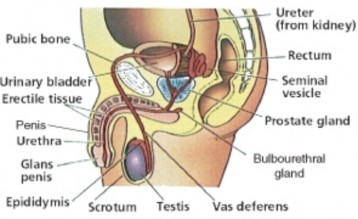
Figure 25.1: shows the male reproductive system. The main organs are the penis, testes, and epididymis. Several ducts and glands are also parts of the male reproductive system. (7)
A duct called the urethra passes through the penis. Sperm pass out of the body through the urethra. (During urination, the urethra carries urine from the bladder.)
The testes (singular, testis) are located in the scrotum, which is a sac of skin between the upper thighs. By hanging away from the body, the testes keep sperm at a temperature lower than normal body temperature. The lower temperature is needed for sperm production.
Each testis contains more than 90 meters of tiny, tightly-packed tubes called seminiferous tubules. They are the functional units of the testes, where sperm are produced and testos- terone is secreted. A cross-section of a seminiferous tubule is shown in Figure 25.2. The tubule is lined with spermatogonia and Sertoli cells. Spermatogonia are sperm-producing cells that you will read more about below. Sertoli cells help protect and nourish developing sperm.
In between the seminiferous tubules in the testes are interstitial cells, also called Cells of Leydig. These cells secrete testosterone. A high concentration of testosterone is necessary for sperm production. Testosterone is also needed throughout a man’s life to maintain his secondary sex characteristics.
The seminiferous tubules join together to form the epididymis. The epididymis is a coiled tube about 6 meters long lying atop the testes inside the scrotum (Figure 25.1). Its functions are to help sperm mature and to store mature sperm until they leave the body.
www.ck12.org 1334
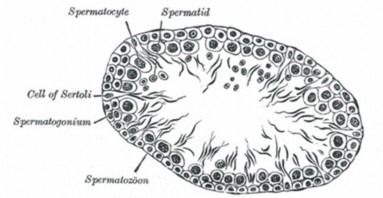
Figure 25.2: This drawing shows a cross-section of a seminiferous tubule. Spermatogonia line the inside of the tubule, interrupted here and there by Sertoli cells. Spermatocytes, which are produced by spermatogonia, form the next layer of cells. Spermatids, which are produced by spermatocytes, form a third layer of cells. (16)
Ducts and Glands
In addition to these organs, the male reproductive system consists of a series of ducts and glands. These are also shown in Figure 25.1.
Ducts include the vas deferens and ejaculatory ducts. They transport sperm from the epididymis to the urethra in the penis.
Glands include the seminal vesicles, prostate gland, and bulbourethral glands. They secrete substances that become part of semen.
Semen is the fluid that is ejaculated from the urethra. Semen contains secretions from the glands as well as sperm. The secretions control pH and provide the sperm with nutrients for energy.
Production and Delivery of Sperm
A sexually mature male typically produces several hundred million sperm per day. Sperm production usually continues uninterrupted until death, although the number and quality of sperm decline during later adulthood.
Spermatogenesis
Spermatogenesis is the process of producing mature sperm. Sperm are haploid cells, mean- ing they have half the number of chromosomes as other cells of the body, which are diploid
1335 www.ck12.org
cells. Sperm must be haploid in order for normal sexual reproduction to occur. During reproduction, a sperm unites with another cell, called an egg. This is called fertilization. Unless both sperm and egg are haploid, the resulting offspring will not have the diploid number of chromosomes (see chapter titled Cell Division and Reproduction).
Sperm are produced in the seminiferous tubules of the testes and finish maturing in the epididymis. The entire process takes about 9 to 10 weeks. As shown in Table 25.2, the production of sperm occurs in several steps, each involving a different type of cell and process.
Spermatogenesis begins when a spermatogonium with the diploid number of chromosomes undergoes mitosis to form primary spermatocytes, also with the diploid number. It proceeds as a primary spermatocyte undergoes the first cell division of meiosis to form secondary sper- matocytes with the haploid number of chromosomes. A secondary spermatocyte undergoes the second meiotic cell division to form haploid spermatids. Spermatids mature into sperm, which are also haploid.
Table 25.2: Spermatogenesis and Cell Division
Type of Cell | Number of Chromosomes | Process |
Spermatogonium | Diploid | Mitosis |
Primary Spermatocyte | Diploid | Meiosis 1 |
Secondary Spermatocyte | Haploid | Meiosis 2 |
Spermatid | Haploid | Maturation |
Spermatozoon (sperm) | Haploid | Fertilization |
Spermatogonia, which line the seminiferous tubules in the testes, are diploid cells. They begin the process of spermatogenesis when they divide by mitosis to produce cells called primary spermatocytes, which are also diploid cells. Some spermatogonia divide just to produce copies of themselves. This ensures a constant supply of spermatogonia for future sperm production.
Primary spermatocytes go through the first cell division of meiosis to produce secondary spermatocytes. These are haploid cells. Secondary spermatocytes then quickly complete the meiotic division to become spermatids, which are also haploid cells.
Spermatids slowly mature into sperm, like the one shown in Figure 25.3. Among other changes, they lose excess cytoplasm from the head and grow a tail. The tail is a flagellum that lets them move by rotating like a propeller. The acrosome that covers part of the head produces digestive enzymes that help the head penetrate an egg. The mitochondria in the connecting piece produce energy that the sperm needs to “swim” through the female reproductive tract to reach an egg. However, sperm do not develop the ability to move until they complete their maturation in the epididymis. It takes sperm four to six weeks to travel through the epididymis and become fully mature. After they mature, they remain in the
www.ck12.org 1336
epididymis until they leave the body.

Figure 25.3: A mature sperm cell has several structures that help it reach and penetrate an egg. These structures include the acrosome, mitochondria, and tail. The nucleus, which makes up most of the head, carries copies of the father’s chromosomes. (10)
Ejaculation
In order for reproduction to take place, sperm must leave the reproductive system. Sperm are released from the body during ejaculation. About 200 to 500 million sperm are released with each ejaculation. Ejaculation occurs when rhythmic muscular movements of the vas deferens propel sperm from the epididymis. The sperm are forced through the vas deferens and ejaculatory ducts and out of the body through the urethra. As sperm travel through the ducts, they mix with fluids from the seminal vesicles, prostate gland, and bulbourethral glands to form semen.
Lesson Summary
The male reproductive system forms before birth but does not become capable of reproduction until it matures during puberty.
The male reproductive system includes organs and other structures that produce sperm and deliver sperm and secrete testosterone.
Sperm are produced in the testes in the process of spermatogenesis and leave the body through the penis during ejaculation.
Review Questions
What are the two major functions of the male reproductive system?
List four physical changes that occur in males during puberty.
Name two male reproductive organs and identify their functions.
Describe how sperm leave the body.
1337 www.ck12.org
Sexual dimorphism refers to differences between males and females of the same species. Based on what you read in this lesson, how does human sexual dimorphism change from birth to adulthood?
If a man did not have an epididymis, how would this affect his ability to produce mature sperm?
Make a flow chart showing the steps of spermatogenesis. Indicate the cells and process involved at each step.
What are the roles of testosterone in the male reproductive system, from the embryo to old age?
Further Reading / Supplemental Links
Stanley, Deborah, Sexual Health Information for Teens. Omnigraphics, 2003.
Walker, Pam and Wood, Elaine, Understanding the Human Body: The Reproductive System. Lucent Books, 2002.
http://en.wikibooks.org/wiki/Human_Physiology/The_male_reproductive_system
http://www.kidshealth.org/parent/general/body_basics/male_reproductive.html
http://www.kidshealth.org/teen/sexual_health/changing_body/male_repro.html
http://www.medicalook.com/human_anatomy/systems/Male_Reproductive_System. html
http://en.wikipedia.org
Vocabulary
acrosome Covers part of the sperm cell head; produces digestive enzymes that help the sperm head penetrate an egg.
adolescent growth spurt Rapid growth in height seen during puberty.
Cells of Leydig Cells that secrete testosterone, located in between the seminiferous tubules in the testes; are also known as interstitial cells.
epididymis A coiled tube about 6 meters long lying atop the testes inside the scrotum; helps sperm mature and stores mature sperm until they leave the body.
fertilization The uniting of a haploid sperm with a haploid egg.
luteinizing hormone The main pituitary hormone responsible for puberty in males; stim- ulates the testes to produce testosterone.
www.ck12.org 1338
male reproductive system System with two major functions: producing sperm and se- creting testosterone.
primary sex characteristics Traits of reproductive organs seen in mature adults that are directly related to reproduction.
puberty The period during which humans become sexually mature.
secondary sex characteristics Physical traits of mature adults which are not directly related to reproduction.
semen The fluid that is ejaculated from the urethra; contains sperm and secretions from the seminal vesicles, prostate gland, and bulbourethral glands.
seminiferous tubules The functional units of the testes, where sperm are produced and testosterone is secreted.
sertoli cells Help protect and nourish developing sperm, located in the seminiferous tubules. sperm Male gametes, or sex cells, which are necessary for reproduction; haploid. spermatogonia Sperm-producing cells, located in the seminiferous tubules; diploid. spermatogenesis The process of producing mature sperm.
testosterone A masculinizing hormone and the chief sex hormone in males.
Points to Consider
By the time they finish puberty, males have developed the traits of mature adults of their own sex. They differ from mature females in many ways. How do these differences between sexually mature males and females come about?
What causes female to develop differently during puberty?
When do girls begin puberty, what changes do they go through, and what hormones control the changes?
1339 www.ck12.org
Lesson 25.2: Female Reproductive System
Lesson Objectives
Explain how the female reproductive system develops before birth and matures during puberty.
Identify structures of the female reproductive system and their functions.
Describe how eggs are produced and how they are released from the ovaries.
Sequence the events of the menstrual cycle, and explain how hormones control the cycle.
Introduction
The female reproductive system is a collection of organs and other structures located primar- ily in the pelvic region. Most of the structures are inside the body. The female reproductive system has several functions:
producing eggs, which are female gametes
secreting female sex hormones
receiving sperm during sexual intercourse
supporting the development of a fetus
delivering a baby during birth
breastfeeding a baby after birth
During puberty, a girl develops into a sexually mature woman, capable of producing eggs and reproducing.
Sexual Development in Females
As you read in Lesson 25.1, the main differences between boys and girls at birth are their re- productive organs. Unlike males, females are not influenced by the male sex hormone testos- terone during embryonic and fetal development. This is because they lack a Y-chromosome. As a result, females do not develop male reproductive organs.
Development Before Birth
Unless an embryo is stimulated by testosterone, the reproductive organs develop into female organs, such as the ovaries and uterus. By the third month of fetal development, most of the internal female organs have formed. Immature ova, or eggs, also form in the ovary before
www.ck12.org 1340
birth. Whereas a male produces sperm throughout his lifetime (after puberty), a female produces all the eggs she will ever make before birth.
Like baby boys, baby girls are born with all their reproductive organs present but immature and unable to function. Female reproductive organs grow very little during childhood. They begin to grow rapidly and to mature during puberty.
Changes of Puberty
From Lesson 25.1, you know that puberty is the period during which humans become sexually mature. Puberty in girls differs from puberty in boys in several ways, including when it begins, how long it lasts, and the hormones involved. Girls begin puberty a year or two earlier than boys, and they complete puberty in about four years instead of six. In females, the major sex hormone is estrogen rather than testosterone.
Puberty in girls starts when the hypothalamus in the brain stimulates the pituitary gland to secrete hormones that target the ovaries. The pituitary hormones are luteinizing hormone, or LH, and follicle-stimulating hormone, or FSH. These hormones stimulate the ovary to produce estrogen.
Estrogen has many functions that you will read more about below. During puberty, estrogen promotes growth and other physical changes in females. For example, estrogen stimulates growth of the breasts and uterus. It also stimulates development of bones and contributes to the adolescent growth spurt in height. These and several other changes in females during puberty are listed in Table 25.3:
Table 25.3: Physical Changes in Females During Puberty

Changes in Reproductive Organs

Ovaries and follicles grow Uterus grows and endometrium thickens Other reproductive structures grow Menstrual cycle begins
Other Physical Changes
Breasts develop Long bones grow and mature
Pubic hair grows Underarm hair grows
Body fat increases Apocrine sweat glands develop Pelvis widens

Some of the changes involve the maturation of organs, such as ovaries, that are necessary for reproduction. Mature reproductive organs are primary sex characteristics. Other changes, such as growth of pubic hair, lead to traits that are secondary sex characteristics. One of the most significant changes in females during puberty is menarche. Menarche is the beginning of menstruation, or monthly periods, which will be discussed later.
1341 www.ck12.org
Adolescent Growth Spurt
Females go through an adolescent growth spurt in height as boys do. However, the growth spurt in girls starts a year or two earlier and ends about three years sooner. Girls also do not grow as rapidly during their peak growth rate. Although females start the growth spurt only 2 centimeters shorter than males, on average, by the time they stop growing females are an average of 10 centimeters shorter.
Timing of Puberty
The changes of puberty usually happen in the same order for most females. The first observ- able change is typically the beginning of breast development. This happens by age 10 years in the majority of girls in the U.S. The appearance of pubic hair usually occurs next, at age
10.5 years, on average. The growth spurt in height also usually begins during the first year of puberty. During the first two years of puberty, the ovaries and uterus gradually increase in size. Menarche occurs relatively late in puberty, typically between the ages of 12 and 13 years in U.S. girls. After menarche, a female generally keeps growing for another year or two and attains her adult height by an average age of 14.5 years.
As in males, there is a wide range of ages at which particular changes of female puberty normally occur. For example, menarche may occur as early as age 8 years or as late as age
Differences in age at menarche and other changes of puberty are due to both genetic factors and environmental factors, such as diet. A female who goes through puberty earlier or later than her peers may worry that she is not developing normally. Although such variation is usually normal, she should talk with her health care provider if she has concerns.
Female Reproductive Organs
The female reproductive system is shown in Figure 25.4. Only a few of the structures are external to the body. All the main reproductive organs are internal.

Figure 25.4: The female reproductive system. (15)
www.ck12.org 1342
External Organs
The external female reproductive structures are referred to collectively as the vulva. They include the labia and mons pubis. The labia are the “lips” of the vulva. They protect the vagina and urethra, both of which have openings in the vulva. The mons pubis consists of fatty tissue covering the pubic bone. It protects the pubic bone and vulva from injury.
Internal Organs
The internal female reproductive organs include the vagina, uterus, fallopian tubes, and ovaries. These organs are shown from the front, without any other structures blocking them, in Figure 25.5. This makes it easier to see the shape and size of the organs and where they are located relative to one another.
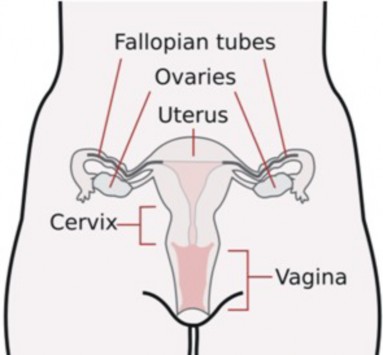
Figure 25.5: Internal female reproductive organs. (13)
The vagina is a tube-like structure about 8 to 10 centimeters long. It begins at the vulva and extends to the uterus. It has muscular walls lined with mucous membranes. The vagina has two major reproductive functions. It receives sperm during sexual intercourse, and it provides a passageway for a baby to leave the mother’s body during birth.
The uterus is a muscular organ about 7.5 centimeters long and 5 centimeters wide. It has a thick lining of tissues known as the endometrium. The lower, narrower end of the uterus
1343 www.ck12.org
is called the cervix. The uterus is where a fetus grows and develops until birth. During pregnancy, the uterus can expand dramatically to accommodate the growing baby. Muscular contractions of the uterus push the baby through the cervix during childbirth.
Extending from the upper corners of the uterus are the two Fallopian tubes. The tubes are about 7 to 14 centimeters long. Each tube reaches (but is not attached to) one of the ovaries. The ovary end of the tube has a fringelike structure (Figure 25.8) that moves with a wavelike motion.
The two ovaries are small, oval-shaped organs that lie on either side of the uterus. They are the egg-producing organs of the female reproductive system, and they contain hundreds of thousands of immature eggs. Each egg is located within a structure called a follicle. A follicle consists of the egg surrounded by special cells that protect the egg until puberty and then help the egg mature.
The Breasts
The breasts are considered secondary sex characteristics, rather than organs of reproduction. They are described here because of their role in nurturing an infant after birth. As shown in Figure 25.6, each breast contains mammary glands. The cells of mammary glands secrete milk, which drains into ducts leading to the nipple. A suckling baby squeezes the milk out of the ducts and through the nipple.
Egg Production
At birth, a female’s ovaries contain all the eggs she will ever produce. However, the eggs do not start to mature until she enters puberty. After menarche, one egg typically matures each month throughout a female’s adult years until she reaches middle adulthood.
Oogenesis
Oogenesis is the process of producing eggs in the ovary. Eggs are haploid cells, having half the number of chromosomes of other cells in the body, which are diploid cells. Like sperm, eggs must be haploid in order for sexual reproduction to result in diploid offspring. Like spermatogenesis, oogenesis occurs in several steps that involve different types of cells. The steps of oogenesis are listed in Table 25.4.
Oogenesis begins when an oogonium with the diploid number of chromosomes undergoes mitosis to form primary oocytes, also with the diploid number. It proceeds as a primary oocyte undergoes the first cell division of meiosis to form secondary oocytes with the haploid number of chromosomes. A secondary oocyte undergoes the second meiotic cell division to form a haploid ovum if it is fertilized by a sperm.
www.ck12.org 1344
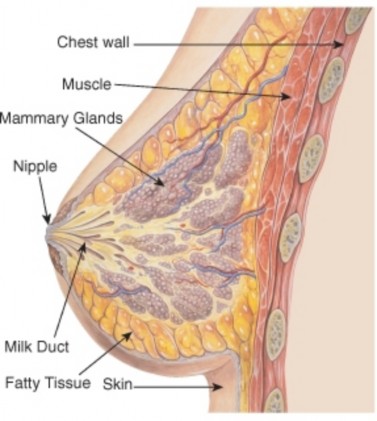
Figure 25.6: Cross-section of a human breast. (14)
1345 www.ck12.org
Table 25.4: Oogenesis and Cell Division
Type of Cell | Number of Chromosomes | Process |
Oogonium | Diploid | Mitosis |
Primary oocyte | Diploid | Meiosis 1 |
Secondary oocyte | Haploid | Meiosis 2 |
Ovum (mature egg) | Haploid | Fertilization |
Oogenesis begins with oogonia (singular, oogonium), which are the immature eggs that form in the ovaries before birth. Oogonia are diploid cells and equivalent to spermatogonia in males. By about the fifth month of fetal development, the ovaries contain about seven million oogonia.
Over the next few months, oogonia undergo mitosis, forming cells called primary oocytes. Primary oocytes are also diploid cells. Before birth, primary oocytes begin the first division of meiosis, but they do not complete it until long after birth. At birth, the average female has about two million primary oocytes in her ovaries. Throughout childhood, the number of oocytes falls as they deteriorate and disappear. By puberty, there are only about 300,000 to 400,000 primary oocytes left in the average girl’s ovaries.
Maturation of a Follicle
Beginning in puberty, each month one of the follicles starts to mature (Figure 25.7). The primary oocyte in the follicle resumes meiosis and divides to form a secondary oocyte and a smaller cell, called a polar body. Both the secondary oocyte and polar body are haploid cells. The secondary oocyte has most of the cytoplasm from the original cell and is much larger than the polar body. The polar body disintegrates and disappears from the ovary.
Ovulation
Ovulation is the release of a secondary oocyte by the ovary. Ovulation occurs every 28 days, on average, in a sexually mature female, but may range normally from 24 to 36 days. As shown in Figure 25.7, during ovulation a secondary oocyte bursts out of its follicle and through the ovary wall to enter the abdominal cavity.
Each month only one of the ovaries matures a follicle and releases an egg. Which ovary matures a follicle in a given month? Scientists say that it appears to be random.
After the secondary oocyte leaves the ovary, it is swept into the Fallopian tube by the waving, fringelike end. This is illustrated in Figure 25.8. Tiny hairlike projections, called cilia, line the tube and help move the oocyte through to the uterus. If the secondary oocyte is fertilized by a sperm as it is passing through the Fallopian tube, it divides to form a mature egg and
www.ck12.org 1346
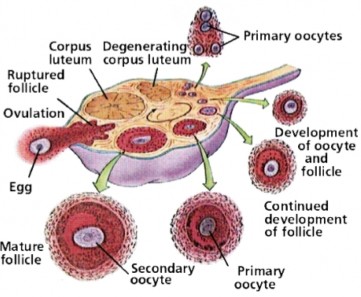
Figure 25.7: This diagram shows the monthly cycle the ovary goes through in a post-pubertal female. First, an oocyte and its surrounding follicle starts to mature. When the secondary oocyte is mature, it bursts from the follicle and ovary. Then the ruptured follicle develops into a corpus luteum, which produces progesterone. If the egg is not fertilized by a sperm, the corpus luteum degenerates and virtually disappears from the ovary. (1)
1347 www.ck12.org
a polar body, finishing meiosis. (As before, the polar body contains very little cytoplasm and disintegrates.) If the secondary oocyte is not fertilized, it passes into the uterus as an immature egg.

Figure 25.8: This diagram also shows the events of the menstrual cycle that occur in the ovary. After a secondary oocyte bursts from the ovary, it usually is swept into a Fallopian tube. The waving, fringelike ends of the tube help capture the egg. (8)
www.ck12.org 1348
Menstrual Cycle and Menstruation
Ovulation is part of the menstrual cycle, which occurs each month in a sexually mature female. Another part of the cycle is menstruation. Menstruation is the process in which blood and other tissues are shed from the uterus and leave the body through the vagina. It is also called a menstrual period, or menses. The menstrual cycle is sometimes divided into two cycles, called the ovarian cycle and the uterine cycle. The ovarian cycle includes the events that occur in the ovary. The uterine cycle refer to the events that occur in the uterus. The two cycles are closely related, so here they are described together and referred to jointly as the menstrual cycle.
Phases of the Menstrual Cycle
The phases of the menstrual cycle are summarized in Table 25.5. The cycle begins with the menstrual phase, which typically lasts from one to four days. This is when menstruation occurs. During the menstrual phase, arteries that supply the endometrium of the uterus constrict and break. Gradually, blood and endometrial tissues detach from the inside of the uterus and pass from the uterus to the vagina and then out of the body. If there is an immature egg in the uterus, it passes out of the body with the menstrual flow.
The menstrual cycle (as shown in Table 25.5) includes an ovarian and a uterine cycle. Events in the ovarian cycle include maturation of a follicle, release of an egg, and formation of the corpus luteum. Events in the uterine cycle include menstruation, development of the endometrium, and thickening of the endometrium in preparation for an egg.
Table 25.5: The Phases of the Menstrual Cycle

Name of Phase Days Events

Menstrual Phase 1–4 Menstruation occurs
Follicular Phase 5–13 Follicle matures En- dometrium develops
Ovulation 14 Ovary releases egg
Luteal Phase 15–28 Follicle becomes corpus luteum Endometrium prepares for egg

The next phase of the cycle is called the follicular phase. After menstruation, the en- dometrium in the uterus begins to build up again. At the same time, several follicles start maturing in the ovary. Only one of these maturing follicles will complete maturation. The rest will eventually deteriorate and disappear. By the middle of the menstrual cycle, around day 14, the remaining mature follicle releases its oocyte from the ovary in the process of ovulation.
1349 www.ck12.org
Following ovulation, the luteal phase begins. During the luteal phase, the endometrium of the uterus continues to prepare for a fertilized egg. For example, it becomes thicker and develops more blood vessels. At the same time, the mature follicle that just released its egg develops into a structure called a corpus luteum (Figure 25.8).
If the egg is fertilized and implants, or embeds itself, in the endometrium of the uterus, the endometrium will be maintained and help nourish it. If the egg is not fertilized, the endometrium will break down, leading to menstruation. This begins a new cycle.
The events of the menstrual cycle always occur in the same sequence, but their timing may vary considerably. There is a great deal of normal variation in the length of the overall cycle and of the individual phases. Variation may occur from one female to another and also from one cycle to the next for a given female.
Some females have symptoms—such as bloating, abdominal cramps, and mood swings—for several days before or during menstruation each month. If the symptoms are severe enough to interfere with daily life, the condition is called premenstrual syndrome, or PMS. Symptoms of PMS often can be helped with medications or lifestyle changes.
Role of Hormones
The same hormones that control female puberty and oogenesis also control the menstrual cycle: estrogen, LH, and FSH. Estrogen controls the secretion of the two pituitary hormones by acting on the hypothalamus, which controls the pituitary gland. This is shown in Fig- ure 25.9. When the estrogen level rises in the blood, it stimulates the pituitary (via the hypothalamus) to secrete more or less LH and FSH.
In negative feedback, rising levels of hormones feedback to the hypothalamus and pituitary gland to decrease production of the hormones. In positive feedback, rising levels of hormones feedback to increase hormone production. During most of the menstrual cycle, estrogen and progesterone provide negative feedback to the hypothalamus and pituitary gland. This keeps their levels more or less constant. During days 12–14, however, estrogen provides positive feedback to the hypothalamus and pituitary gland. This causes a rapid rise in the production of estrogen by the ovary and leads to ovulation.
Another hormone involved in the menstrual cycle is progesterone. The word ”progesterone” literally means “pro-gestational hormone.” Progesterone is a hormone that promotes ges- tation, or the carrying of a fetus. The function of progesterone in the menstrual cycle is to maintain the endometrium of the uterus.
Change in the levels of these four hormones (estrogen, LH, FSH, and progesterone) occur during the menstrual cycle (Figure 25.10). After menstruation occurs, estrogen secreted by the ovaries increases. This causes the endometrium of the uterus to thicken. FSH from the pituitary stimulates follicles in the ovary to mature. The maturing follicles produce estrogen, and the level of estrogen in the blood rises. When estrogen reaches a high level in the blood,
www.ck12.org 1350
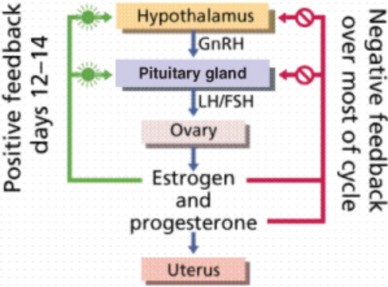
Figure 25.9: This diagram shows how hormones control the menstrual cycle with negative and positive feedback. (12)
it stimulates the pituitary gland to release a surge of LH. The spike in LH stimulates the one remaining mature follicle to burst open and release its oocyte.
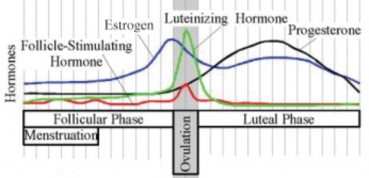
Figure 25.10: This graph shows how hormone levels change during the menstrual cycle. (5)
During the first half of the cycle, negative feedback keeps levels of FSH, LH, estrogen, and progesterone relatively stable. During ovulation, positive feedback causes a burst of FSH, LH, and estrogen. During the second half of the cycle, progesterone rises as the corpus luteum in the ovary matures and produces this hormone. Negative feedback helps keep levels of the other three hormones fairly constant
After the oocyte is released, LH stimulates the mature follicle to develop into a corpus luteum. The corpus luteum then starts secreting progesterone, which maintains the endometrium of the uterus. What happens next depends on whether the egg has been fertilized.
1351 www.ck12.org
If the egg has been fertilized, it will soon start producing a hormone that helps maintain the corpus luteum. As a result, the corpus luteum will continue producing progesterone and maintain the endometrium.
If the egg has not been fertilized, the corpus luteum will disintegrate and stop producing progesterone. Without progesterone, the endometrium will break down, detach from the uterus, and pass out of the body during menstruation.
Menopause
For most women in the U.S., the menstrual cycle continues into their forties. Then it gradually becomes more and more irregular until it finally stops altogether, generally by their early fifties. Menopause occurs when a woman has gone through 12 consecutive months without a menstrual period. She can no longer reproduce because her ovaries no longer produce eggs.
The cause of menopause is a natural decline in estrogen secretion by the ovaries as a woman ages. It may take from several months to a few years for her body to adjust to the drop in estrogen. During this time, she may experience hot flashes, mood swings, and other symptoms.
Lesson Summary
The female reproductive system forms before birth but does not become capable of reproduction until it matures during puberty.
The female reproductive system includes organs and other structures that produce and release eggs, secrete female sex hormones, and enable the development and birth of a fetus.
Immature eggs form in the ovaries before birth. Each month, starting in puberty, one egg matures and is released from the ovary.
The menstrual cycle includes events that take place in the ovary, such as ovulation, and changes in the uterus, including menstruation. The menstrual cycle controlled by the hormones estrogen, progesterone, LH, and FSH.
Review Questions
List three functions of the female reproductive system.
State two ways that puberty differs in girls and boys.
Describe the uterus and its functions in reproduction.
What is ovulation and when does it occur?
Tara is 13 and worried that she may not be developing normally. She began developing breasts about six months ago but still has not had her first menstrual period. Should
www.ck12.org 1352
she be concerned? Explain your answer.
Explain how blockage of both Fallopian tubes would affect a woman’s ability to repro- duce naturally.
Create a timeline showing the steps in which an oogonium develops into a mature egg.
Explain the roles of estrogen, LH, and FSH in the menstrual cycle.
Further Reading / Supplemental Links
Stanley, Deborah, Sexual Health Information for Teens. Omnigraphics, 2003.
Walker, Pam and Wood, Elaine, Understanding the Human Body: The Reproductive System. Lucent Books, 2002.
http://en.wikibooks.org/wiki/Human_Physiology/The_female_reproductive_system
http://www.kidshealth.org/parent/general/body_basics/female_reproductive_ system.html
http://www.kidshealth.org/teen/sexual_health/changing_body/female_repro.
html
http://www.medicalook.com/human_anatomy/systems/Female_reproductive_system. html
http://www.merck.com/mmhe/sec22/ch241/ch241a.html
http://en.wikipedia.org
Vocabulary
adolescent growth spurt Rapid growth in height seen during puberty.
corpus luteum Formed in the ovary from the ruptured follicle after ovulation; if the egg is not fertilized by a sperm, the corpus luteum degenerates and virtually disappears from the ovary; produces progesterone.
egg (ova) Female gamete, or sex cell, which is necessary for reproduction; haploid.
estrogen Major female sex hormone.
Fallopian tube Tube which accepts oocyte after ovulation; site of fertilization; attached to uterus.
female reproductive system System with several major functions: producing eggs, se- creting female sex hormones, receiving sperm during sexual intercourse, supporting the development of a fetus, delivering a baby during birth, and breastfeeding a baby after birth.
1353 www.ck12.org
follicle Structure in which each egg is located; consists of the egg surrounded by special cells that protect the egg until puberty and then help the egg mature.
follicle-stimulating hormone (FSH) Hormone that stimulates the ovary to produce es- trogen.
luteinizing hormone (LH) The main pituitary hormone responsible for puberty in fe- males; stimulates the ovary to produce estrogen.
menarche The beginning of menstruation, or monthly periods.
menopause When a woman has gone through 12 consecutive months without a menstrual period; she can no longer reproduce because her ovaries no longer produce eggs.
menstruation The process in which blood and other tissues are shed from the uterus and leave the body through the vagina; also called a menstrual period, or menses.
oogenesis The process of producing eggs in the ovary.
ovary Small, oval-shaped organs that lie on either side of the uterus; the egg-producing organs of the female reproductive system; contain hundreds of thousands of immature eggs.
ovulation The release of a secondary oocyte by the ovary; occurs every 28 days, on average.
progesterone A hormone that promotes gestation, or the carrying of a fetus; also main- tains the endometrium of the uterus.
uterus A muscular organ where a fetus grows and develops until birth; has a thick lining of tissues known as the endometrium; the lower, narrower end of the uterus is called the cervix.
vulva The external female reproductive structures; includes the labia and mons pubis.
Points to Consider
If an egg is fertilized by a sperm and implants in the uterus, the endometrium helps support and nourish it. However, the new organism soon needs more nutrients than the endometrium can provide. It needs to obtain nutrients from the mother’s blood. How does this happen?
What structures are involved with pregnancy? When do they develop? www.ck12.org 1354
Lesson 25.3: Fertilization, Gestation, and Devel- opment
Lesson Objectives
Explain how fertilization, cleavage, and implantation lead to the formation of an em- bryo.
Describe how the embryo forms specialized cells and organs through the processes of gastrulation, differentiation, and organogenesis.
Identify major events in the growth and development of the fetus.
Explain how the placenta provides the fetus with oxygen and nutrients and eliminates fetal wastes.
Describe how an expectant mother can help her fetus grow and develop normally, and summarize the events of childbirth.
Sequence milestones in growth and development from infancy through adolescence.
Describe the life stages of early and middle adulthood and old age, and explain why aging occurs.
Introduction
Sexual reproduction begins when an egg is fertilized by a sperm and implants in the uterus. Following these events, the remainder of growth and development before birth is divided into two main stages. The first stage is the embryonic stage, which lasts about two months. This is followed by the fetal stage, which lasts for another seven months until birth.
Fertilization, Cleavage, and Implantation
A day or two after an ovary releases an egg, the egg may unite with a sperm. However, before it becomes an embryo, it must go through other processes. These processes include cleavage and implantation.
Fertilization
Fertilization is the union of a sperm and an egg. Recall that a sperm is a male gamete and an egg is a female gamete. Each gamete is a haploid cell. When the two cells unite during fertilization, they form a diploid cell, called a zygote.
Fertilization generally occurs in a Fallopian tube. After sperm are deposited in the vagina during sexual intercourse, they “swim” through the cervix and uterus and into a Fallopian tube. Although millions of sperm are deposited, only a few hundred are likely to reach the
1355 www.ck12.org
egg. A sperm about to penetrate an egg is shown in Figure 25.11. When a sperm finally breaks through the egg’s cell membrane, it sets off a reaction that prevents other sperm from entering. The entry of the sperm also triggers the egg to complete the second meiotic division that began before ovulation.

Figure 25.11: Human sperm and egg. (19)
After the sperm penetrates the egg, its tail falls off, and its nucleus fuses with the nucleus of the egg. The resulting zygote contains all the chromosomes needed for a new individual. Half the chromosomes are from the egg, and half are from the sperm.
Cleavage
The zygote spends the next few days traveling down the Fallopian tube. As it travels, it divides by mitosis several times to form a ball of cells called a morula. The cell divisions, which are called cleavage, increase the number of cells but not their overall size. More cell divisions occur, and soon a fluid-filled cavity forms inside the ball of cells. At this stage, the ball of cells is called a blastocyst. The process of blastocyst formation is shown in Figure 25.12.
The cells of the blastocyst form an inner and an outer cell layer. This is apparent in Figure
The inner layer of cells is called the embryoblast. This layer of cells will soon develop into an embryo. The outer layer of cells is called the trophoblast. This layer will develop into other structures, including the placenta, which you will read more about below.
www.ck12.org 1356
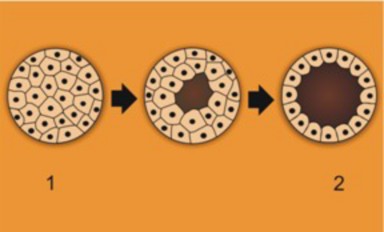
Figure 25.12: The morula (1) continues to undergo cell divisions. As it does, cells start to migrate into separate layers, and a cavity starts to develop inside the ball of cells. When cells have migrated into distinct layers, the organism is called a blastocyst (2). (3)
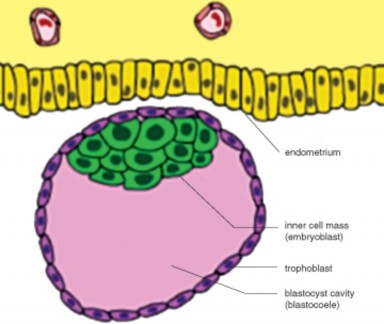
Figure 25.13: The blastocyst consists of an outer layer of cells called the trophoblast, a fluid-filled cavity, and an inner cell mass called the embryoblast. (4)
1357 www.ck12.org
Implantation
The blastocyst continues the trip down the Fallopian tube and reaches the uterus about four or five days after fertilization. When the outer cells of the blastocyst contact cells lining the uterus, the blastocyst embeds in the lining. The process of embedding is called implantation. It generally occurs about a week after fertilization. Once implantation occurs, the blastocyst is called an embryo.
Growth and Development of the Embryo
An embryo is a developing human being from the time of implantation through the first eight weeks after fertilization. During this time, the embryo grows in size and undergoes three processes: gastrulation, differentiation, and organogenesis.
Gastrulation
Gastrulation is the development of different layers of cells in the embryo. It generally occurs during the second week after fertilization. During gastrulation, cells of the embryo migrate to form three distinct cell layers: the ectoderm, mesoderm, and endoderm. These layers are shown in Figure 25.14. Each layer will eventually develop into certain types of tissues and cells in the body.
Ectoderm—Forms tissues that cover the outer body; develops into cells such as nerves, skin, hair, and nails.
Mesoderm—Forms tissues that provide movement and support; develops into cells such as muscles, bones, teeth, and blood.
Endoderm—Forms tissues involved in digestion and breathing; develops into cells such as lungs, liver, pancreas, and gall bladder.
Differentiation and Organogenesis
During the third week after fertilization, the embryo begins to undergo cellular differenti- ation. Differentiation is the process by which unspecialized cells become specialized into one of the many different types of cells that make up the body. During differentiation, certain genes are turned on, or activated, while other genes are switched off, or inactivated. As a result of this process, cells develop specific structures and abilities that suit them for their specialized roles in the body. Several examples of specialized cells are shown in Figure 25.14, along with the cell layers from which they develop.
Differentiation of cells leads to the development of specific organs within the three cell layers. This is called organogenesis. All the major organs begin to form during the remaining
www.ck12.org 1358
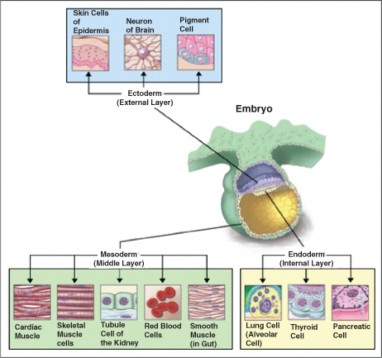
Figure 25.14: The three cell layers of the embryo develop into different types of cells. For example, the ectoderm develops into skin cells, the mesoderm into muscle cells, and the endoderm into lung cells. (20)
1359 www.ck12.org
weeks of embryonic development. A few of the developments that occur in weeks 4 through 8 are listed below.
Embryonic Development During Weeks 4-8
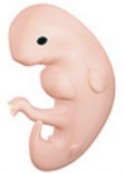
Pictured above is a 4-week-old embryo.
At Week 4
Heart begins to beat.
Arm buds appear.
Liver, pancreas, and gall bladder start to form.
Spleen appears.
At Week 5
Eyes start to form.
Leg buds appear.
Hands appear as paddles.
Blood begins to circulate.
Facial features start to develop.
At Week 6
Lungs start to form.
Fingers and toes form.
At Week 7
Hair follicles start to form.
www.ck12.org 1360
Elbows and toes are visible.
At Week 8
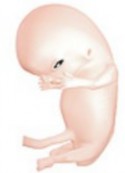
Facial features look more human.
External ear begins to take shape.
As the embryo develops, it also grows in size. By the eighth week of development, the embryo is about 30 millimeters long. It may also have begun to move.
Growth and Development of the Fetus
From week 8 until birth, the developing individual is referred to as a fetus. In humans, birth typically occurs 38 weeks after fertilization, so the fetal period lasts about 30 weeks. During this time, the organs that formed during the embryonic period go through further develop- ment. The fetus also grows in overall body size. For a detailed animation of the growth and development of the fetus see http://www.youtube.com/watch?v=aR-Qa_LD2m4& feature=related.
Weeks 8 to 15
During the fetus’s early weeks, reproductive organs develop along either male or female lines. The liver starts producing red blood cells, and tooth buds appear. The fetus becomes more human in appearance, with well-formed facial features. The eyelids form but remain closed until later in fetal development. The muscles and bones develop, and the fetus is very active. It can make a fist and move its arms and legs. It also hiccups, stretches, and yawns. The first measurable brain activity occurs around the 12th week. By the end of the 15th week, the fetus is about 15 centimeters long.
1361 www.ck12.org
Weeks 16 to 26
A fetus at 18-weeks after fertilization is shown in Figure ??. At this stage, the brain is developing rapidly, and it starts to take control of some body functions. The alveoli (air sacs) in the lungs also develop, making gas exchange possible, although the lungs are still immature. Most of the internal components of the eyes and ears form and develop at this time. There is more muscle development, as well, and the fetus is more active than ever. The mother usually starts to feel fetal movement during this stage.

Fine hair called lanugo grows and covers the fetus’s body by the end of this stage. Eyebrows, eyelashes, and nails also appear, and the eyelids begin to open and close. By the end of week 26, the fetus is about 38 centimeters long and weighs about 1.2 kilograms.
Weeks 27 to 38
During the final weeks of growth and development, the amount of body fat rapidly increases. Bones develop fully, although they are still soft and pliable. Most of the lanugo disappears, and head hair becomes coarser and thicker. Fingernails grow beyond the end of the fingertips. In the brain, connections form that allow the input of sensations. Starting around week 30, the brain is continuously active. By the 38th week, the fetus is fully developed and ready to be born. A 38-week fetus normally ranges from 36 to 51 centimeters in length and weighs between 2.7 and 4.6 kilograms. A 38-week-old fetus is shown in Figure ??.
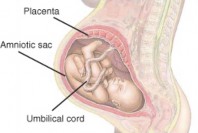
Sometimes fetuses are born earlier than 38 weeks. After 35 weeks, the fetus is considered “full-term,” which means that it is developed enough for life outside the mother. Fetuses
www.ck12.org 1362
born before 35 weeks are likely to have health problems due to their immaturity, although many are able to survive with medical help. The less time a fetus spends developing in the uterus before it is born, the less likely it is to survive after birth. Fetuses born before 25 weeks rarely survive.
Placenta and Related Structures
The placenta is a temporary organ in which nutrients and wastes are exchanged between the mother and the embryo or fetus. The placenta begins to form in the second week after fertilization. It continues to develop and grow to meet the needs of the growing fetus. A fully developed placenta, like the one in Figure ??, is made up of a large mass of blood vessels from both the mother and fetus. The maternal and fetal vessels are close together but separated by empty space. This allows the mother’s and fetus’s blood to exchange substances without actually mixing.
How the Placenta Works
Blood from the mother enters the maternal blood vessels of the placenta under pressure, forcing the blood into the empty spaces. When the mother’s blood contacts the fetal blood vessels, gases are exchanged. Oxygen from the mother’s blood is exchanged with carbon dioxide from the fetus’s blood. A release of pressure brings the mother’s blood back from the placenta and into her veins.
The fetus is connected to the placenta through the umbilical cord, a tube that contains two arteries and a vein. Blood from the fetus enters the placenta through the umbilical arteries, exchanges gases with the mother’s blood, and travels back to the fetus through the umbilical vein.
In addition to gas exchange, the placenta transfers nutrients, hormones, and other needed substances from the mother’s blood to the fetus’s blood. The placenta also filters many harmful substances out of the mother’s blood so they are not transferred to the fetus. In addition, the placenta secretes hormones that maintain the corpus luteum in the mother’s ovary. Recall that the corpus luteum secretes progesterone, which is needed to keep the endometrium of the uterus from breaking down.
Amniotic Sac and Fluid
Attached to the placenta is the amniotic sac, which surrounds and protects the embryo or fetus. It begins to form in the second week after fertilization. It soon fills with water and dissolved substances to form amniotic fluid. The fluid allows the fetus to move freely until the fetus grows to fill most of the available space. The fluid also cushions the fetus and helps protect it from injury.
1363 www.ck12.org
Pregnancy and Childbirth
Pregnancy is the carrying of one or more offspring from fertilization until birth. It is the development of a fetus from the expectant mother’s point of view. A woman is likely to first suspect she is pregnant when she misses a menstrual period. As you just read, hormones secreted by the placenta maintain the endometrium of the uterus. This prevents menstruation from occurring once pregnancy begins.
The pregnant mother plays a critical role throughout the embryonic and fetal periods. She must provide all the nutrients and other substances needed for normal growth and develop- ment. Therefore, it is important for the expectant mother to take good care of her health during pregnancy for the sake of her baby as well as herself. Most importantly, the mother needs to avoid toxic substances and take in adequate nutrients.
Avoiding Toxins
Unfortunately the placenta cannot protect the developing embryo or fetus from all harmful substances in the mother’s blood. Some harmful substances can cross the placenta from the mother’s blood and damage the embryo or fetus, including:
Alcohol
Chemicals in tobacco smoke
Aspirin
Thalidomide (a prescription drug)
Heroin
Cocaine
These and other substances can cause birth defects. For example, if a pregnant woman drinks alcohol, it can cause variety of birth defects that are collectively called fetal alcohol syndrome. A baby with fetal alcohol syndrome is shown in Figure 25.15. The defects include facial abnormalities, stunted growth, and mental retardation.
Alcohol and some other toxins can damage the developing brain at any time before birth because the brain continues to develop and grow rapidly throughout pregnancy. However, in general, birth defects are likely to be more severe when exposure to toxins occurs during the embryonic period. This is because the embryo is undergoing organogenesis. Any disruption of normal development during this early period is likely to have a greater impact on the organism than later in pregnancy, when the organs are already formed. Although exposure to toxins at later stages of development may do less damage, an expectant mother should try to avoid toxins throughout her pregnancy.
www.ck12.org 1364
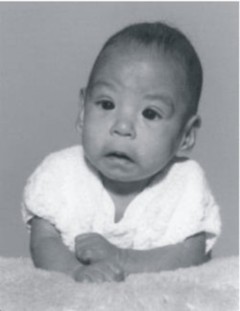
Figure 25.15: Baby with fetal alcohol syndrome. (11)
Taking in Nutrients
The fetus depends completely on the mother for its nutrient needs. As a result, most nutrients are needed in greater amounts by a pregnant woman than a woman who is not pregnant. Some nutrients are especially important for embryonic or fetal development.
Folic acid (vitamin B9) is needed for normal development of the spinal cord. Inadequate folic acid intake can lead to spina bifida, a serious birth defect.
Calcium is needed for normal development of bones and teeth.
Iron is needed for the proper formation of red blood cells.
Omega-3 fatty acids are important for normal development of nerve cells.
If an expectant mother eats a balance of foods from the different food groups, this diet will help ensure adequate nutrients for the fetus. Because needs for some nutrients are so high, nutrient supplements are usually recommended during pregnancy. Supplements formulated for pregnant women help supply adequate amounts of folic acid and other nutrients needed for normal growth and development of the fetus.
Childbirth
Near the time of birth, the amniotic sac breaks in a gush of fluid. Within 24 hours of the amniotic sac breaking, labor usually begins. Labor involves contractions of the muscular
1365 www.ck12.org
walls of the uterus. The contractions are stimulated by the release of the pituitary hormone oxytocin. The contractions cause the cervix to widen and the passage through the cervix to dilate, or open. The contractions become closer and stronger, and the cervix gradually becomes more dilated. This may take hours or even days. When the cervix is dilated to about 10 centimeters, the baby begins to move through cervix and into the vagina.
At this point, the mother begins pushing to aid in the birth of the baby. This part of labor is generally shorter. The fetus usually emerges head first. Within seconds of birth, the umbilical cord is cut. Without this connection to the placenta, the baby cannot exchange carbon dioxide, which quickly builds up in the baby’s blood. This stimulates the brain to trigger breathing and the newborn takes its first breath. Generally within half an hour or less of the birth of the baby, contractions of the uterus force the placenta and any remaining amniotic tissues from the mother’s body.
By birth, a fetus has a large head relative to its body size, because the brain is more developed than any other organ. Some areas of the skull have not yet been converted to hard bone, allowing the fetus’s head to change shape somewhat to fit through the cervix during birth. The head returns to its normal shape shortly after birth.
Infancy, Childhood, and Adolescence
For the first year after birth, a baby is called an infant. Early childhood begins at age two, when a child may be referred to as a toddler. Childhood continues until adolescence, which generally coincides with the teen years. Adolescence is the period of transition into adulthood.
Infancy
Infancy is defined as the first year of life after birth. For the first month after birth, an infant is called a newborn. A newborn has a distinctive appearance. The head is very large, and the arms and legs are relatively short. The shoulders and hips are narrow, and the abdomen protrudes slightly. Many newborns still have lanugo on some areas of their body, but this usually disappears within a few weeks after birth. Head hair can vary from almost no hair to a full head of hair. The stub of the umbilical cord remains for a few weeks, until it dries up and falls off, forming the navel.
Infants are born with certain abilities already developed. For example, they have a well developed sense of smell. They can also communicate their needs by crying when they are hungry, uncomfortable, bored, or lonely. During their first year, they develop many other abilities:
By 6 weeks after birth, babies typically start smiling (Figure 25.16) and making vocal sounds.
www.ck12.org 1366
By 6 months, they spend a lot of time babbling. They have also learned to sit and are starting to crawl.
By 12 months, they are saying their first words. They can stand with help and may have started to walk.

Figure 25.16: Six-week-old baby’s first smile. (6)
Infancy is the period of most rapid growth after birth. Growth during infancy is even faster than growth during puberty. By the end of the first year, the average baby is twice the length it was at birth and three times its birth weight. Infancy is also the period when most of the deciduous, or “baby,” teeth erupt. The front teeth erupt first, usually starting around six months after birth. There are 20 deciduous teeth altogether, and they continue to erupt until about three years of age.
Newborns need about 18 hours of sleep each day. They usually sleep in long naps throughout the day and night. As infants get older, they need less sleep. They also start to sleep through the night and just take short naps during the day. When newborns aren’t sleeping, they are usually feeding. Breastfeeding is the recommended method of feeding infants. Breast milk is generally supplemented by other foods by the end of the first year.
Childhood
A toddler is a young child who is learning to walk, or “toddle.” This is the second stage of development after infancy. It generally refers to children between the ages of 1 and 3 years. During this stage, children not only learn to walk steadily but also develop other motor skills. By the end of the third year, most children can run, walk up steps, and climb onto chairs. They can feed and dress themselves with help. They can also manipulate small objects and hold a crayon and scribble with it. They have learned dozens of words and are speaking in simple sentences. Most children are also toilet trained by the end of the third year.
Growth is still relatively rapid during the toddler years but slowing down. By the time children are five years old, their height is increasing by only about 5 percent per year,
1367 www.ck12.org
compared with 100 percent per year in the first year of life. By age five, children are able to carry on conversations, recognize letters and words, and tie their shoe laces. Five-year olds can use a pencil to trace letters and other shapes (Figure 25.17). They also may be learning to ride a bicycle, swim, swing a bat, or kick a ball.

Figure 25.17: A five-year old using a pencil to trace shapes. (9)
By age six, most children begin losing their deciduous teeth, and their permanent teeth erupt to replace them. This continues until about age 12. Other important changes of older childhood include the transition from home to school. At school, children not only acquire academic skills such as reading, but also interact more with their peers. They form friendships and are likely to have “best” friends. Older children continue to grow slowly until they start the adolescent growth spurt during puberty.
Adolescence
Adolescence is the period of life between the beginning of puberty and adulthood. You learned about the physical changes of puberty earlier in this chapter. Adolescence is also a time of significant mental, emotional, and social changes. For example, during adolescence, teens develop more advanced mental abilities, including the ability to think abstractly. They also try to establish an identity, or sense of self. In the process, they may try to become more independent from their parents. They may also challenge authority and push limits.
www.ck12.org 1368
Emotionally, adolescence may be a time of upheaval. Shifting hormone levels may cause mood swings at a time when many adolescents are still learning how to manage their emo- tions. One of the most important social changes of adolescence is the increased importance of peers. Teens spend much more time with their friends and other peers than younger children do, and they are generally greatly influenced by them. Young people may also start to develop intimate relationships during adolescence.
Adulthood and Old Age
The development of intimacy is considered to be a major goal of the stage of life referred to as young adulthood. Other stages of adulthood include middle adulthood and old age. Each stage is associated with particular goals and health concerns.
When Does Adulthood Start?
The age at which adulthood starts may vary from about age 17 to 21 years, depending on how adulthood is defined. A person may be physically mature by age 17 but not considered legally mature until an older age. For example, in the U.S., individuals cannot assume adult responsibilities, such as voting and joining the armed forces, until they are 18 years old. They cannot exercise certain adult rights, such as buying and using alcohol, until they are 21.
Early and Middle Adulthood
Early adulthood may be defined as the stage of life from the start of adulthood through age 34 years. During early adulthood, people generally learn how to form intimate relationships, both in friendship and love. Many people become engaged or marry during this time. Young adults may also be involved in completing their education and becoming established in a career or the workforce. Health problems in most young adults are minor. The most common causes of death are due to violence: homicides, car crashes, and suicides.
Middle adulthood may be defined as the stage of life from age 35 through 64 years. During this stage, most people raise a family (if they are going to) and strive to attain career goals. They are more likely to become involved in their community.
During middle adulthood, people start showing physical signs of aging, such as wrinkled skin and gray hair. Vision, strength, reaction time, and overall fitness also typically decline during middle adulthood. At the same time, health problems tend to increase. Diseases such as type 2 diabetes, cardiovascular disease, and many types of cancer are often diagnosed during this stage of life, especially in people who are overweight or obese. The risk of being diagnosed with diseases such as these increases throughout middle adulthood. These diseases are also the chief causes of death of middle adults.
1369 www.ck12.org
Old Age
Old age may be defined as the stage from age 65 until death. During this stage, most people retire from work and no longer have the major responsibility of caring for others. Physically, older adults tend to have a decline in stamina, strength, reflex time, and the senses.
Other physical changes that occur in old age include a decrease in:
heart output
kidney function
lung capacity
number of brain cells
Because the immune system also becomes less efficient with age, older adults are increas- ingly susceptible to serious illnesses such as cancer, cardiovascular disease, and pneumonia. Osteoporosis, or loss of bone density, is also common in older adults, particularly in females. Mental deterioration may occur, as well, especially in people with Alzheimer’s disease and certain other diseases. Otherwise, intelligence tends to remain stable throughout adulthood and into old age.
Why does aging occur? Why does the body decline in function as people grow old? There are at least two reasons. One reason is that cells are programmed to divide a set number of times. After that, they can no longer divide, so they die out. Another reason is that DNA becomes increasingly damaged through time due to mutagens in the environment. Eventually, the damage accumulates to a point where cells can no longer divide. Most physical changes associated with aging may be due to a combination of both processes.
Lesson Summary
Fertilization is the union of a sperm cell and an egg cell that forms a zygote. The zygote undergoes many cell divisions before it implants in the lining of the uterus.
The embryonic stage begins with implantation. An embryo forms three distinct cell layers, and each layer develops into different types of cells and organs.
The fetal stage begins about two months after fertilization and continues until birth. During this stage, the organs grow and develop and the fetus grows in size.
The placenta allows nutrients and wastes to be exchanged between the mother and fetus. The fetus is connected to the placenta through the umbilical cord.
A pregnant woman should avoid toxins and take in adequate nutrients for normal fetal growth and development. During childbirth, the fetus is pushed through the cervix and out of the body through the vagina.
Growth and development are most rapid during infancy and slower throughout the rest of childhood until adolescence. Adolescence involves mental, emotional, and social changes in addition to the physical changes of puberty.
www.ck12.org 1370
During early adulthood, people form intimate relationships and start careers. Serious health problems start showing up in middle adulthood and old age. Aging occurs as cells lose their ability to divide.
Review Questions
Describe what happens during fertilization.
How does gastrulation change an embryo?
Identify three events that occur as a fetus grows and develops.
Explain the role of the placenta in fetal development.
Why is an embryo generally more susceptible than a fetus to damage by toxins in the mother’s blood?
Why is the umbilical cord cut before a newborn has started to breathe on its own?
Create a timeline of growth and development from infancy through adolescence.
Explain why aging occurs.
Further Reading / Supplemental Links
Brynie, Faith Hickman, 101 Questions About Reproduction. 21st Century, 2004.
Stanley, Deborah, Sexual Health Information for Teens. Omnigraphics, 2003.
http://estrellamountain.edu/faculty/farabee/biobk/BioBookREPROD.html
http://www.cdc.gov/nchs/fastats/deaths.htm
http://www.keepkidshealthy.com/growthcharts/
http://en.wikibooks.org/wiki/Human_Physiology/Development:_birth_through_ death
http://www.merck.com/mmhe/sec22/ch257/ch257a.html
http://www.merck.com/mmhe/sec22/ch260/ch260a.html
http://www.visembryo.com/baby/index.html
http://en.wikipedia.org
Vocabulary
adolescence The period of life between the beginning of puberty and adulthood.
amniotic fluid Fluid that allows the fetus to move freely within the amniotic sac; also cushions the fetus and helps protect it from injury.
blastocyst The ball of cells that contains a fluid filled cavity and distinct layers; forms from the morula.
1371 www.ck12.org
cleavage The initial cell divisions which increase the number of cells but not their overall size.
differentiation The process by which unspecialized cells become specialized into one of the many different types of cells that make up the body.
ectoderm Cell layer of the embryo that forms tissues that cover the outer body; develops into cells such as nerves, skin, hair, and nails.
embryo A developing human being from the time of implantation through the first eight weeks after fertilization.
embryoblast Inner layer of cells of the blastocyst; develops into an embryo.
endoderm Cell layer of the embryo that forms tissues involved in digestion and breathing; develops into cells such as lungs, liver, pancreas, and gall bladder.
fertilization The union of a sperm and an egg. When the two cells unite during fertiliza- tion, they form a diploid cell, called a zygote.
fetus The developing individual from week 8 until birth.
gastrulation The development of different layers of cells in the embryo; generally occurs during the second week after fertilization.
implantation The embedding of the blastocyst in the lining of the uterus; occurs about a week after fertilization. Once implantation occurs, the blastocyst is called an embryo.
infancy The first year of life after birth.
mesoderm Cell layer of the embryo that forms tissues that provide movement and support; develops into cells such as muscles, bones, teeth, and blood.
morula Initial ball of cells formed the first few days after fertilization; formed within a fallopian tube.
organogenesis The development of specific organs within the three cell layers.
placenta A temporary organ in which nutrients and wastes are exchanged between the mother and the embryo or fetus.
pregnancy The carrying of one or more offspring from fertilization until birth.
trophoblast Outer layer of cells within the blastocyst; will develop into structures which includes the placenta.
www.ck12.org 1372
Points to Consider
Many diseases become more common as people age, but some diseases are more com- mon in adolescents and young adults, including sexually transmitted diseases (STDs). What are examples of STDs?
How common are STDs in teens and young adults?
Why are STDs more common during these two stages of life?
Lesson 25.4: Sexually Transmitted Diseases
Lesson Objectives
Explain how STDs are transmitted and how they can be prevented.
Identify and describe three common bacterial STDs.
Identify and describe three common viral STDs.
Introduction
A sexually transmitted disease (STD) is an illness caused by a pathogen that is trans- mitted from one person to another mainly through sexual contact. Worldwide, as many as one million people a day become infected with STDs. The majority of these infections occur in people under the age of 25.
Sexually Transmitted Diseases
Common STDs include chlamydia, gonorrhea, syphilis, human immunodeficiency virus (HIV) infection, genital herpes, hepatitis B, and genital warts. To be considered an STD, a disease must have only a small chance of spreading naturally in ways other than sexual contact. Many diseases that can spread through sexual contact spread more commonly by other means. These diseases are not considered STDs.
Pathogens that Cause STDs
STDs may be caused by several different types of pathogens, including protozoa, insects, bacteria, and viruses.
The protozoa Trichomonas vaginalis causes an STD called trichomoniasis. This is an infection of the vagina in females and the urethra in males.
1373 www.ck12.org
Pubic lice, like the one in Figure 25.18, are insect parasites that can be transmitted sexually. They suck the blood of their host and irritate the skin in the pubic area.
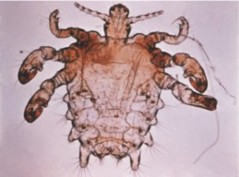
Figure 25.18: A magnified pubic louse (Phthirius pubis). (18)
Although these STDs are common, the majority of STDs are caused by bacteria or viruses. Several bacterial and viral STDs are described below. It is important to note that most bacterial STDs can be cured with antibiotics, whereas viral STDs do not have cures, although some can be prevented with vaccines.
How STDs Spread
Most of the pathogens that cause STDs enter the body through mucous membranes of the reproductive organs. All sexual behaviors that involve contact between mucous membranes put a person at risk for infection. This includes vaginal, anal, and oral sexual behaviors.
Many STDs can also be transmitted through body fluids such as blood, semen, and breast milk. For example, in the past, HIV and hepatitis B were transmitted through blood trans- fusions. This no longer occurs because donated blood is now screened for the pathogens. Use of shared injection or tattoo needles is another way in which blood and pathogens can be transferred from one person to another. A number of STDs can also be transmitted from a mother to her baby through her blood during childbirth or through her breast milk after birth.
STDs are much more common in young adults and teens than in older people. One reason is that young people are more likely to take risks and to think “It can’t happen to me.” They also may not know how STDs are spread. In addition, younger people may be more sexually active than older people.
www.ck12.org 1374
Preventing STDs
The only completely effective way to prevent infection with STDs is to avoid sexual activity and other known risk behaviors, such as using contaminated needles. Using condoms can decrease the risk of contracting STDs during some types of sexual activity. However, using condoms is not a foolproof method. Pathogens may be present on areas of the body not covered by condoms. Condoms can also break or be used incorrectly.
Bacterial STDs
Many STDs are caused by bacteria. Some of the most common bacterial STDs are chlamydia, gonorrhea, and syphilis.
Chlamydia
Chlamydia is an STD caused by the bacterium Chlamydia trachomatis. It is the most common STD in the U.S. Each year, about four million new chlamydia infections occur in Americans. As shown in Figure 25.19, females are much more likely to develop chlamydia than males. This figure also shows how common this STD is in teens and young adults compared with older people. This is typical of most STDs.
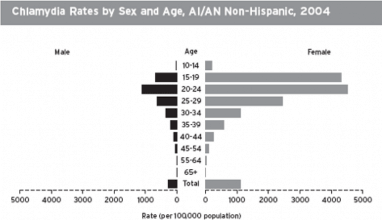
Figure 25.19: This bar graph shows the number of cases of chlamydia per 100,000 people in the United States in 2004, by age and sex. Chlamydia rates were greatest from both sexes between the ages of 15 and 34 years. The rates in females at all ages were much greater than the rates in same-aged males. (2)
Symptoms of chlamydia may include a burning sensation during urination and a discharge
1375 www.ck12.org
from the vagina or penis. Chlamydia can be cured with antibiotics. However, in the majority of cases, there are no symptoms. As a result, many people are not aware they are infected and do not seek treatment.
It is important to detect and treat chlamydia infections even when they do not cause symp- toms. Untreated chlamydia can lead to more serious problems, especially in females. Almost half of all women with untreated chlamydia develop pelvic inflammatory disease (PID), which is an infection of the uterus, Fallopian tubes, and/or ovaries. PID can lead to scar- ring of the reproductive organs, which may cause pain and difficulty becoming pregnant. Chlamydia causes an estimated half million cases of PID in the U.S. each year.
In addition to sexual transmission, chlamydia can be passed from a woman to her baby before or during birth. Before birth, chlamydia infection of the fetus may cause the fetus to be born too soon. During birth, a baby’s eyes can become infected with the bacteria. If the eye infection is not treated, it can lead to blindness. Because chlamydia is common and often symptomless, newborns are treated routinely with eye drops to prevent chlamydia eye infections from developing.
Gonorrhea
Gonorrhea is an STD caused by the bacterium Neisseria gonorrheae. Gonorrhea is also a common STD. In the U.S., an estimated 700,000 people are infected with gonorrhea each year.
Symptoms of gonorrhea may include painful urination and discharge from the vagina or penis. Gonorrhea usually can be cured with antibiotics, although the bacteria have developed resistance to the most commonly used antibiotics. Gonorrhea infections may not cause symptoms, especially in females, so they often go untreated. Untreated gonorrhea can lead to PID in females. In males, it can lead to inflammation of the epididymis, prostate, and urethra.
Gonorrhea can be passed from an infected woman to her baby during childbirth. This may cause an eye infection. The infection must be treated promptly to prevent blindness.
Syphilis
Syphilis is an STD caused by the bacterium Treponema pallidum. In the U.S., about 70,000 new cases of syphilis occur each year. Syphilis is less common than either chlamydia or gonorrhea, but it is more serious if it is not treated. Untreated syphilis can even cause death.
Early symptoms of infection with syphilis include the development of a small sore on or near the genitals. The sore is painless and heals on its own, so it may go unnoticed. Many people do not realize they have become infected until much later, so they do not seek treatment. If
www.ck12.org 1376
diagnosed and treated early, most cases of syphilis can be cured with antibiotics. However, if syphilis goes untreated, the disease may progress through the stages shown in Table 25.6. Untreated syphilis can eventually cause serious damage to the heart, brain, and other organs.
Table 25.6: Stages of Syphilis Infection

Stage Time After Initial Infection Signs and Symptoms

Primary 2 days Small sore on genitals
Secondary 1–6 months Rash, fever, sore throat, headache
Latent 6–12 months None
Tertiary 1–10 years Chronic inflammation, dam- age to aorta and heart, nar- rowing of arteries, stroke, meningitis, muscle weakness

Viral STDs
STDs caused by viruses include genital herpes, hepatitis B, genital warts, and cancer of the cervix. Another common viral STD is HIV infection, which causes acquired immune deficiency syndrome, or AIDS. HIV and AIDS are described in the chapter titled Immune System and Disease.
Genital Herpes
Genital herpes is an STD caused by herpes simplex virus type 2 (HSV-2). In the U.S., as many as 20% of males and 25% of females may be infected with HSV-2. The virus is closely related to herpes simplex virus type 1 (HSV-1), which causes cold sores on the lips. Both viruses are transmitted by direct contact. Both also cause similar symptoms, except HSV-2 infects the genitals instead of the mouth.
Symptoms of genital herpes include painful, fluid-filled blisters on the penis, vulva, or nearby membranes (Figure 25.20). The initial infection soon clears up on its own. However, herpes virus particles travel to local nerves, where they evade the immune system and remain for the life of the infected person. Periodically, some of the virus particles travel back to the skin and cause new outbreaks of blisters. Outbreaks may be triggered by stress or other factors. A person with genital herpes is most likely to transmit the virus during an outbreak.
There is no known cure for genital herpes. Once a person becomes infected, there is no way to eradicate the virus from the body. However, antiviral drugs can prevent outbreaks or reduce their length and severity. The drugs also reduce the risk of transmitting the virus. A vaccine to prevent infections with HSV-2 may soon be available.
1377 www.ck12.org
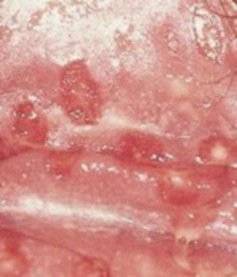
Figure 25.20: Genital herpes causes outbreaks of fluid-filled blisters, like ones shown here, on the membranes of reproductive organs. (17)
Genital herpes may cause emotional problems because it affects intimate relationships through- out a person’s life. However, it is not considered to be a serious disease from the standpoint of physical health. On the other hand, herpes is very serious for newborns if they are in- fected with the virus during childbirth. It can lead to blindness, mental retardation, and even death.
Hepatitis B
Hepatitis B is inflammation of the liver caused by infection with the hepatitis B virus. In the U.S., there are about 200,000 new cases of hepatitis B diagnosed each year. In addition, as many as 5,000 Americans die each year from hepatitis B infections.
Early symptoms of hepatitis B include vomiting and jaundice, which is yellowing of the skin and eyes. Hepatitis B often gets better on its own after a few weeks or months and causes no long-lasting effects. However, in a small percentage of people it develops into a chronic, or long-term, disease. In some people, chronic hepatitis B causes few if any symptoms, although people infected with the virus can still spread it to others. In other people, chronic hepatitis B causes continuous inflammation of the liver. This eventually damages the liver. It also increases the risk of liver cancer, which is usually fatal.
Hepatitis B cannot be cured. Antiviral drugs can help prevent liver damage in people with chronic hepatitis B, but they cannot eradicate the virus from the body. However, vaccines have been developed to prevent hepatitis B infection.
www.ck12.org 1378
In addition to sexual transmission, hepatitis B is commonly transmitted through contami- nated needles and from mother to child during childbirth. Newborns are much more likely than older people to develop chronic hepatitis B. This is because their immune system is immature and unable to fight off the virus.
Genital Warts and Cervical Cancer
Both genital warts and cancer of the cervix are caused by the human papillomavirus (HPV). There are more than 100 types of HPV. Some types of HPV cause common warts, which are small, rough growths on the hands, knees, or feet. These HBV viruses are transmitted by casual skin-to-skin contact. Other types of HPV cause genital warts or cervical cancer. These HPV viruses are transmitted through sexual contact. Genital HPV infections are very common. In the U.S., more than six million people become infected each year.
Many types of HPV that are transmitted sexually do not cause any noticeable symptoms. However, several types cause genital warts or cervical cancer. Cervical cancer is easily detected with a Pap test, which involves examining a sample of cervical cells for cancerous changes. If detected early, cervical cancer can be cured with surgery. Since 2006, a vaccine has been available to prevent transmission of the most common types of HPV that cause genital warts and cervical cancer. The vaccine is recommended for females from aged 11 to 26 years.
Lesson Summary
STDs are diseases caused by pathogens that spread through sexual contact. Abstinence from sexual activity is the only completely effective way to prevent the spread of STDs.
Bacterial STDs include chlamydia, gonorrhea, and syphilis. These diseases can be cured with antibiotics.
Viral STDs include genital herpes, hepatitis B, genital warts, and cervical cancer. These diseases cannot be cured, but some of them can be prevented with vaccines.
Review Questions
Describe how STDs spread.
What is the only completely effective way to prevent infection from STDs?
Identify three common STDs that are caused by bacteria.
Name and describe an STD caused by a virus.
Why is it important to treat STDs even when they do not cause symptoms?
How does lack of symptoms contribute to the spread of STDs?
1379 www.ck12.org
Further Reading / Supplemental Links
Jeyendran, Rajasingam S., Sex, Sperm, & STDs: What Every Teenage Boy Needs to Know. iUniverse, Inc., 2006.
Stanley, Deborah, Sexual Health Information for Teens. Omnigraphics, 2003.
http://www.cdc.gov/STD/stats04/trends2004.htm
http://www.wrongdiagnosis.com/c/chlamydia/prevalence.htm
http://www.wrongdiagnosis.com/h/hepatitis_b/prevalence.htm
http://www.wrongdiagnosis.com/s/syphilis/prevalence.htm
http://www.avert.org/std.htm
http://www.cdc.gov/nchstp/dstd/disease_info.htm
http://www.kidshealth.org/teen/sexual_health/stds/std.html
http://www.4woman.org/faq/stdsgen.htm
http://en.wikipedia.org
Vocabulary
chlamydia A STD caused by the bacterium Chlamydia trachomatis; the most common STD in the U.S. Each year, about four million new chlamydia infections occur in Americans.
genital herpes An STD caused by herpes simplex virus type 2 (HSV-2). In the U.S., as many as 20% of males and 25% of females may be infected with HSV-2.
gonorrhea An STD caused by the bacterium Neisseria gonorrheae. In the U.S., an esti- mated 700,000 people are infected with gonorrhea each year.
hepatitis B An inflammation of the liver caused by infection with the hepatitis B virus.
pelvic inflammatory disease (PID) An infection of the uterus, Fallopian tubes, and/or ovaries.
sexually transmitted disease (STD) A illness caused by a pathogen that is transmitted from one person to another mainly through sexual contact.
syphilis An STD caused by the bacterium Treponema pallidum. In the U.S., about 70,000 new cases of syphilis occur each year.
www.ck12.org 1380
Points to Consider
From fertilization to old age, the human body is like a fantastic machine. It controls its own growth and development, protects itself from dangers in the outside world and has amazing abilities to act, think, and feel. Like other living things, human beings are marvels of nature.
What have you learned about human beings and other organisms by reading this book?
Image Sources
http://estrellamountain.edu/faculty/farabee/biobk/BioBookREPROD.html. Creative Commons.
http://www.cdc.gov/std/stats-ihs-2004/graphs/chlamydia-natl.htm. Public Domain.
http://en.wikipedia.org/wiki/Image:Blastulation.png. Public Domain.
http://en.wikipedia.org/wiki/Image:Blastocyst.png. GNU-FDL.
http://commons.wikimedia.org/wiki/File:Estradiol.Cycle.jpg. GNU-FDL.
Six-week-old baby’s first smile.. Creative Commons.
http://estrellamountain.edu/faculty/farabee/biobk/BioBookREPROD.html. Public Domain.
http://commons.wikimedia.org/wiki/Image:Order_of_changes_in_ovary.svg. GNU-FDL.
[Wikimedia.org ]. Creative Commons.
Mariana Ruiz. http://en.wikipedia.org/wiki/Image:Simplified_spermatozoon_diagram.svg. Public Domain.
Baby with fetal alcohol syndrome.. Creative Commons.
http://estrellamountain.edu/faculty/farabee/biobk/BioBookREPROD.html. Creative Commons.
CDC. Internal female reproductive organs.. Public Domain.
CK-12 Foundation. Cross-section of a human breast.. CC-BY.
The female reproductive system.. GNU-FDL.
1381 www.ck12.org
http://commons.wikimedia.org/wiki/File:Gray1150.png. Public Domain.
CK-12 Foundation.
http://commons.wikimedia.org/wiki/File:SOA-Herpes-genitalis-female.jpg. GNU-FDL.
Centers for Disease Control and Prevention. http://commons.wikimedia.org/wiki/File:Pthius_pubis_-_crab_louse.jpg. Public Domain.
Human sperm and egg.. Public Domain.
http://commons.wikimedia.org/wiki/File:Cell_differentiation.gif. Public Domain.
www.ck12.org 1382
26.1 Investigation and Experimentation Activities
The following activities are based on information provided within this FlexBook or taken directly from the Teacher Edition.
Collecting and Analyzing Data
In this activity students will select and use appropriate tools and technology to perform tests, collect data, analyze relationships, and display data.
Students build skills in interpreting data and measuring through a simple activity. Have students measure a certain volume of water into a number of cups, such as 4 - 10 cups. Then have them first look online for what the threshold amount is for detecting sugar in water (see:http://www.skidmore.edu/~hfoley/Perc2.htm#ch2demo1).
Have one cup with water only (the control), and then have students add increasing amounts of sugar to each of the remaining cups. Keep track of the amount of sugar added. Have a person record for each student the threshold when that student detects the sugar (by taste) in the solution. The results are then tabulated and a graph made showing the number of students detecting the sugar solution at each concentration.
Experimental Error and Inconsistent Results
Students will identify and communicate sources of unavoidable experimental error and de- termine possible reasons for inconsistent results, such as sources of error or uncontrolled conditions.
1383 www.ck12.org
As an extension to the above activity, have students conduct an experiment with the same amount of sugar and water in each cup. Use an amount in which the sugar is detectable. Ask students to determine if there is the same or different amounts of sugar. Some students will determine that there are different amounts of sugar in the cups. Discuss the possible reasons for these results and how inconsistent results can influence collected data. You may choose to have one group of students set up the experiment for you (these students will not participate in the collection of data), with another group blind to the experimental conditions.
Experimental Error
An error is a boundary on the precision and accuracy of the result of a measurement. Some errors are caused by unpredictable changes in the measuring devices (such as balances, rulers, or calipers), but other errors can be caused by reading a measuring device incorrectly or by using broken or malfunctioning equipment. Such errors can have an impact on the reliability of the experiment’s results; they affect the accuracy of measurements. For example, you use a balance to obtain the mass of a 100 gram block. Three measurements that you get are:
g, 92.0 g, and 91.8 g. The measurements are precise, as they are close together, but they are not accurate.
If the cause of the error can be identified, then it can usually be eliminated or minimized. Reducing the number of possible errors by careful measurement and using a large enough sample size to reduce the effect of errors will improve the reliability of your results.
Have students discuss potential opportunities for experimental error in the above activity, and have them describe how they could have affected the experimental results. Have the class discuss controls they could have added to this test to reduce experimental error.
Scientific Models
During this activity, students should realize that appropriate tools and technology (such as computer-linked probes, spreadsheets, and graphing calculators) are used to perform tests, collect data, analyze relationships, and display data. Throughout this activity, students should also recognize both the usefulness and limitations of scientific models, and that models are a scientific representations of reality.
Have the students look at the figure below and discuss: 1. What kind of model this is (computer). 2. What this model is used for (to forecast wind speeds and directions). 3. How this model might be useful (for example, weather forecasts; airline routes). 4. What is the main advantage of this visual model to the public (much easier to understand than a large table of numbers)? 5. Also ask the students how this model (and models in general) are of use to scientists (for example, reflecting reality, predicting future observations, ease of use and how it looks [for example, the colors used]).
www.ck12.org 1384
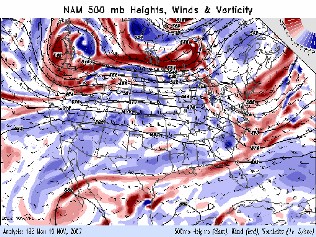
A computer model of wind patterns across the continental United States for 19 November, 2007. This model is used to forecast wind speeds and directions. Data on wind speed, direction, and related data are entered into a computer which then produces this simulation. This visual model is much easier for a person to understand than a large table of numbers.
Another model that might be worth researching and discussing is one for water flow in the Everglades (Florida). Some scientists are investigating how an increase in freshwa- ter flow will affect patterns of organic matter as it is carried by the water and deposited downstream. If water flow is increased, this organic matter will be deposited in greater amounts in the estuarine ecotone and could lead to even higher rates of productivity in these areas. http://evergladesplan.org/images/water_flow_to_everglades.jpg
Scientific Logic
During this activity students will formulate explanations by using logic and evidence. They will also use appropriate tools and technology to display data.
Have students come up with data online or do their own activity to generate data. Have the activity illustrate the area of biological study known as physiology. Have students work in pairs. Have the students take turns taking their pulses after sitting (pulse at resting), and then after jumping up and down after a time period, perhaps one to two minutes. Take pulses at varying times after the activity; immediately after, one minute after, two minutes after, etc. Data could be examined in a number of ways; how resting pulse compares to pulse right after the activity, at varying times after the activity, how long it might take to get back to a resting pulse, the differences in pulses between boys and girls, how pulse rate increases with how much time a person jumps (one minute vs. two minutes, etc.). Data could be presented in either graph or table form, or both. Have students come to a conclusion based on their results. The conclusion should be based on their evidence and scientific logic.
1385 www.ck12.org
Science and Math
During this activity students need to understand the relationship between science and math.
Using a hypothetical rabbit population at Hardy-Weinberg equilibrium, have students de- termine both the allele frequencies and the genotype frequencies. This rabbit population has 9 albino rabbits and 91 brown rabbits (42 homozygous and 49 heterozygous rabbits).
Solution
Instructors: Sample answers to these questions will be provided upon request. Please send an email to [email protected] to request sample answers.
Statistical Variability
Students will recognize the importance of statistical variability.
Biodiversity
Use activity 1 at the web site below to introduce the concept of biodiversity and how it is measured. In the activity, students calculate a diversity index for each of several different “habitats,” represented by plastic bottles that contain a variety of different dried beans, seeds, or other small items. Then, based on its diversity index, students decide what type of real-world habitat each bottle “habitat” best represents.
http://www.accessexcellence.org/AE/ATG/data/released/0534-KathyParis/index. php
In this activity students use math to calculate the diversity index of a selected habitat. The closer to 1 the diversity index is, the more diverse and healthy the habitat is.
Hypothesis vs. Theory
Ask students to develop a scientific hypothesis. They may use the activity below.
During this activity students should discuss the difference between their hypothesis and a scientific theory, describing why their hypothesis is not a theory. They should also appreciate the usefulness and limitations of theories as scientific representations of reality.
www.ck12.org 1386
Formulating a Hypothesis
Have students who go to school in a city make observations of pigeons, as to feeding behavior, interactions between birds, etc. Based on the observations, have them come up with a testable research hypothesis. Ask them to describe data that would support or disprove the hypothesis. For students in a rural area, have them do something similar with ants (observable behavior here might be the ants’ tracks). http://www.birds.cornell.edu/ pigeonwatch
Scientific Theory
Scientific theories are hypotheses which have stood up to repeated attempts at falsification and are thus supported by a great deal of data and evidence. Some well known biological theories include the theory of evolution by natural selection, the cell theory (the idea that all organisms are made of cells), and the germ theory of disease (the idea that certain microbes cause certain diseases). The scientific community holds that a greater amount of evidence supports these ideas than contradicts them, and so they are referred to as theories.
In every day use, people often use the word theory to describe a guess or an opinion. For example, “I have a theory as to why the light bulb is not working.” When used in this common way, “theory” does not have to be based on facts, it does not have to be based on a true description of reality. This usage of the word theory often leads to a misconception that can be best summed up by the phrase ”It’s not a fact, it’s only a theory.” In such everyday usage, the word is most similar to the term hypothesis.
Scientific theories are the equivalent of what in everyday speech we would refer to as facts. In principle, scientific theories are always subject to corrections or inclusion in another, wider theory. As a general rule for use of the term, theories tend to deal with broader sets of phenomena than do hypotheses, which usually deal with much more specific sets of phenomena or specific applications of a theory.
When Data Does Not Fit
Students will understand that some observations may be wrong or fraudulent, and that some- times a theory can be wrong.
Refer students to the proposals of Jean-Baptiste Lamarck. He proposed that acquired char- acteristics could be inherited. Evidence did not support his mechanism for change, but Darwin shared his ideas of change in species.
A few websites are provided for additional information about Lamarck.
http://www.ucmp.berkeley.edu/history/lamarck.html
http://www.mnsu.edu/emuseum/information/biography/klmno/lemarck_jean.html
1387 www.ck12.org
Maps
In this activity, students will learn the relationship between science and maps. Students should examine the maps below and determine what the data depicts.
Stabilizing Selection and Sickle-Cell Anemia
Stabilizing selection can lead to the preservation of harmful alleles. A famous example is sickle-cell anemia. The gene for Beta-hemoglobin - half of the oxygen-carrying protein in our blood - has two alleles, which we will call Hgb-A and Hgb-S. Individuals having two copies of the Hgb-S allele suffer from sickle-cell anemia, a potentially lethal disease in which sickled cells clog capillaries and cannot carry oxygen efficiently. In equatorial regions, individuals with two copies of Hgb-A become infected with Plasmodium parasites and often die from malaria. However, individuals with one copy of each allele (the heterozygous genotype) escape both causes of death; although they may experience slight sickling at high altitudes, they do not suffer from full-blown anemia, and malaria parasites cannot infect their red blood cells. Stabilizing selection has maintained the frequencies of both alleles, even though each is potentially lethal in the homozygous state.
Solution
Instructors: Sample answers to these questions will be provided upon request. Please send an email to [email protected] to request sample answers.
Analysis of Natural Phenomena
Through a series of activities, students will understand that the analysis of locations, se- quences, or time intervals have played a significant role in the analysis of scientific data.
Virtual Age Dating
Assign the animated activity Virtual Age Dating at the web site below. Students will learn more about radioactive decay and radiometric dating of fossils and then simulate the collection and analysis of radiometric data. The activity includes questions for students to check their understanding as they proceed.
http://www.indiana.edu/~ensiweb/virt.age.html
www.ck12.org 1388
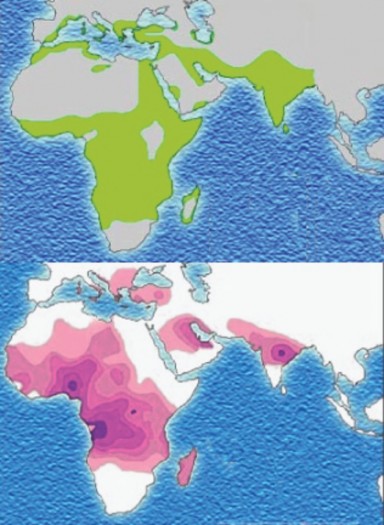
Figure 26.1: The distribution of malaria (top) and the distribution of the sickle-cell allele (bottom).? )
1389 www.ck12.org
Geologic Timestring
Construct a geologic timestring (see URL below) that students can refer to as they read about evolution in this and subsequent lessons. The timestring is a physical representation of the geologic time scale. It is a simple tool that will help students comprehend the immensity of Earth’s history and how recently life evolved.
http://www.accessexcellence.org/AE/AEPC/WWC/1995/geo_time.php
Macroevolution: Patterns, Trends, and Rates of Change
After you discuss gradualism and punctuated equilibrium, ask students to complete the activity Macroevolution: Patterns, Trends, and Rates of Change (see URL below). In the activity, students will examine and graph patterns of fossil sequences and will decide whether the patterns support a gradualism or punctuated equilibrium model of evolution.
http://www.indiana.edu/~ensiweb/lessons/macroev.html
An Accumulation of Evidence
Students will understand the cumulative nature of scientific evidence.
Evidence of Evolution
Refer students to Lesson 12.2: Evidence for Evolution.
Have them create an outline of the lesson content or write an essay discussing the different types of evidence of evolution. All students should include a conclusion tying the evidence together, and discussion why this accumulation of evidence is a scientific theory.
Additional Scientific Disciplines
In this discussion and research project, students will analyze situations and solve problems that require combining and applying concepts from biology, ecology, chemistry and atmo- spheric sciences. Students will further investigate this extremely important issue.
Global Warming
Make sure students understand the greenhouse effect by working through the diagram in this Figure with the class.
www.ck12.org 1390
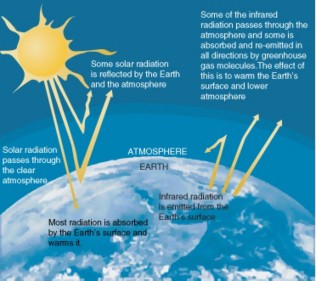
Discuss how the greenhouse effect is related to global warming. Specifically, discuss the following points:
What is the greenhouse effect?
The greenhouse effect is a natural consequence of Earth’s atmosphere. Why?
Without the greenhouse effect, Earth’s average temperature would be much lower. Why?
Changes in Earth’s atmosphere (especially increased CO2) have increased the green- house effect and Earth’s average temperature. How?
Have students continue this analysis with further research on this or a related topic. Students should research the literature, analyzing data that they find and communicate their findings to the class. Aspects of the greenhouse effect that may be further investigated include:
potential issues for plants and animals associated with this effect
any relationship between the greenhouse effect and global warming
potential effects of global warming.
1391 www.ck12.org





























































































































































































































































































































































































